35th bienal de são paulo
choreographies of the impossible
(eds.)
diane lima
grada kilomba
hélio menezes
manuel borja-villel
catalogue
35th bienal de são paulo choreographies of the impossible
The Ministry of Culture, São Paulo State Government, through the Secretary of Culture, Creative Economy and Industry, the Municipal Secretary of Culture, Fundação Bienal de São Paulo and Itaú present
35th bienal de são paulo choreographies of the impossible
ahlam shibli → 52
aida harika yanomami, edmar tokorino yanomami and roseane yariana yanomami → 54
aline motta → 56
amador e jr. segurança patrimonial ltda. → 58
amos gitaï → 60
ana pi and taata kwa nkisi mutá imê → 62
anna boghiguian → 64
anne-marie schneider → 66
archivo de la memoria trans (amt) → 68
arthur bispo do rosário → 70
aurora cursino dos santos → 72
ayrson heráclito and tiganá santana → 74 benvenuto chavajay → 76 bouchra ouizguen → 78
cabello/carceller → 80
carlos bunga → 82
carmézia emiliano → 84
castiel vitorino brasileiro → 86
ceija stojka → 88
charles white → 286
citra sasmita → 90
colectivo ayllu → 92
cozinha ocupação 9 de julho – mstc → 94
edgar calel → 118
elda cerrato → 120
elena asins → 122
elizabeth catlett → 285
ellen gallagher and edgar cleijne → 124
emanoel araujo → 126
eustáquio neves → 128
gabriel gentil tukano → 136
george herriman → 138
geraldine javier → 140
gloria anzaldúa → 142
grupo de investigación en arte y política (giap) → 144
guadalupe maravilla → 146
ibrahim mahama → 154
igshaan adams → 156
ilze wolff → 158
inaicyra falcão → 160
januário jano → 162
jesús ruiz durand → 164
john woodrow wilson → 287
jorge ribalta → 166
josé guadalupe posada → 168
juan van der hamen y león → 170
judith scott → 172
julien creuzet → 174
daniel lie →
daniel lind-ramos → 102 davi pontes and wallace ferreira → 104 dayanita singh → 106 deborah anzinger → 108 denilson baniwa → 110 denise ferreira da silva → 112 diego araúja and laís machado → 114 duane linklater → 116
100
flo6x8
francisco toledo
frente
→ 130
→ 132
3 de fevereiro → 134
kamal aljafari → 176
kapwani kiwanga → 178
katherine dunham → 180
kidlat tahimik → 182
leilah weinraub → 184
leopoldo méndez → 289
luana vitra → 186
luiz de abreu → 188
m'barek bouhchichi → 190
mahku → 192
malinche → 194
manuel chavajay → 196
margaret taylor goss burroughs → 288
marilyn boror bor → 198
marlon riggs → 200
maya deren → 202
melchor maría mercado → 204
min tanaka and françois pain → 206
morzaniel ɨramari → 208
mounira al solh → 210
nadal walcot → 220
nadir bouhmouch and soumeya ait ahmed → 222 nikau hindin → 224
niño de elche → 226
nontsikelelo mutiti → 228
patricia gómez and maría jesús gonzález → 230
pauline boudry / renate lorenz → 232
philip rizk → 234
raquel lima → 238
ricardo aleixo → 240
rolando castellón → 242
rommulo vieira conceição → 244
rosa gauditano → 246
rosana paulino → 248
rubem valentim → 250
quilombo cafundó → 236
rubiane maia → 252 sammy baloji → 260
santu mofokeng → 262
sarah maldoror → 264
sauna lésbica by malu avelar with ana paula mathias, anna turra, bárbara esmenia and marta supernova → 266
senga nengudi → 268 sidney amaral → 270
simone leigh and madeleine hunt-ehrlich → 272 sonia gomes → 274
stanley brouwn → 276
stella do patrocínio → 278
tadáskía → 280
taller 4 rojo → 282
taller de gráfica popular → 284
taller nn → 290
tejal shah → 292
the living and the dead ensemble → 294
torkwase dyson → 296
trinh t. minh-ha → 298
ubirajara ferreira braga → 300
ventura profana → 302
xica manicongo → 308
zumví arquivo afro fotográfico → 312
wifredo lam → 304 will rawls → 306
yto barrada → 310
grada kilomba → 12
hélio menezes → 14
manuel borja-villel → 20
diane lima → 28
hagar kotef → 42
gladys tzul tzul → 96
rizvana bradley and denise ferreira da silva → 148
tiganá santana → 212
ilenia caleo → 254
leda maria martins → 314
auá mendes
juliana dos santos
mario lopes
natali mamani
queen gloria "mama g" simms
xadalu tupã jekupé
ëntun fey azkin (mapuche territory) nls / new local space (jamaica) sertão negro (brazil)
artist's residency
essays
networks
abigail campos leal
ana longoni
barbara copque
beatriz martínez hijazo
carles guerra
cíntia guedes
claudinei roberto
david pérez
déba tacana
emanuel monteiro
fernanda carvajal
getsemaní guevara
heitor augusto
horrana de kássia santos
igor de albuquerque
isabel tejeda
josé antonio sánchez
juliana de arruda sampaio
kaira cabañas
kênia freitas
kike españa
luciana brito
luciane ramos silva
marco baravalle
maria luiza meneses
mario gooden
miro spinelli
natalia arcos salvo
nicole smythe-johnson
oluremi onabanjo
omar berrada
pérola mathias
phillipe cyroulnik
rafael garcía
renato menezes
rocío robles tardío
rossina cazali
sara ramos
sol henaro
sylvia monasterios
tarcisio almeida
tatiana nascimento
thiago de paula souza
josé olympio da veiga pereira → 336
margareth menezes → 337
itaú cultural → 338
instituto cultural vale → 338
bloomberg → 339
sesc são paulo → 339
biographies → 330
credits → 340
acknowledgements → 344
partners → 346
image credits → 348
publication credits → 352
collaborations institutional letters +
choreographies of the impossible takes shape from a conceptual exercise that is reflected in our own curatorial training and practice. We came together to create a horizontal group, without the hierarchy of a chief curator or the homogeneity of a collective. It is a way of choreographing that considers our different backgrounds, education, areas of activity and, above all, seeks to create strategies that allow us to face the institutional and curatorial challenges inherent to a project of this magnitude.
Broadening collaborative processes and our perspectives was what motivated us to conceive a set of dialogues, ranging from the list of participants and groups and spaces – which offered us examples of alternative management to current approaches – to researchers and learning practices not necessarily linked to conventional fields of knowledge. There was also a lot of dialogue with the pair of curatorial assistants, composed of Sylvia Monasterios and Tarcisio Almeida, and with the curatorial council, formed by Omar Berrada, Sandra Benites, Sol Henaro and Thomas Lax.
As we will see in the various texts that make up this catalog, this spiral principle radiates through the selection of works and all the other structures that organize a biennial, such as the architectural and exhibition design, the education and mediation program, as well as the invitation to read this material.
Conceived as a weave of voices, or a “braid” of worlds – as the artist and educator Nontsikelelo Mutiti, who created the visual identity of the 35th Bienal de São Paulo, urges us to think – this editorial project brings together a large group of authors who have accepted the challenge of updating, rereading, translating or developing original thoughts and dialogues, and who expand the ways of conceiving choreographies of the impossible. This web, which takes place as a flux, consists of four essays written individually by the curatorial team, reference texts and a chorus of commissioned critical essays, which reflect the profile of the 121 participants.
In the exhibition space, a choreography of paths was created, as defined by Vão, the firm responsible for the architectural and exhibition design of choreographies of the impossible, which has no themes or chronological organization. It is a proposal capable of making us feel in our bodies what the shifts in flows and the interventions in the building produce, such as the inversion of the floors, an illusion created by the envelopment of the central span – one of the most emblematic architectural structures of Oscar Niemeyer’s original project – and a design that arranges a sequence of movements that accelerate, slow down, pause, and suggest different speeds, linking different rhythms and contrasts beyond the monumental scale of the Pavilion.
These choreographies of narratives place great importance on the formative work carried out by Fundação Bienal’s Education team, especially
9 8
choreographies of the impossible
diane lima grada kilomba
given the challenge of creating facilitation tools that help elucidate to visitors how such paths challenge, in practice, the relationships with time and space.
The way the team narrates its path in the three movements – the name given to the educational publications that complement each other and reveal themselves throughout the construction of choreographies of the impossible – is also a good example of the way the concept radiates. Through the creation of a broad educational program and invitations to different artists and researchers, the team understands that different educational procedures are devices of liberation and freedom, if not a calling in which artistic, intellectual, and political practices become fundamental in the construction of knowledge based on exchange, collaboration, and experimentation.
We have also developed a network of artist's residency programs, formed by New Local Space (Kingston, Jamaica), Sertão Negro (Goiânia, Brazil), and Ëntun Fey Azkin (Wallmapu, Ancestral Mapuche Territory). These independent spaces and initiatives are circuits that foster art, education, and new modes of organization, also providing training and redistributing access to the local scene, in view of the crises and social and economic impacts that these territories face. We believe in the role of platforms such as biennials in creating formative processes and research and in strengthening collective movements. We also believe that, together with the discussions that our project proposes, we can contribute to the maintenance and consolidation of solidarity networks such as Cozinha Ocupação 9 de Julho – MSTC, which is present at the 35th Bienal both as a participant and in charge of food service.
The choreographies of the impossible also have an extensive public program, composed of activations, performances, roundtables, talks, film screenings, workshops, and laboratories throughout the exhibition.
What can these practices, which choreograph the impossible in their original locations, generate when put in dialog here? What ruptures and encounters, consensuses and dissensuses, can this reunion create? For us, these questions play a central role. They make it possible to invent and discover new and unknown choreographies.
hélio menezes manuel borja-villel


2nd floor plan closed space open space 3rd floor plan closed space open space
image: Vão Arquitetura


what is choreography? what is a choreography? what are choreographies? and what are the choreographies of the impossible?
what is impossible? what is the impossible? and what about the impossibility?
can a choreography circumscribe the impossible?
how does one define choreography? is it an art? a drawing? an inscription? a movement? is it a dance?
is choreography the art of dancing? or the art of drawing a movement that is danced?
is it the art of inscribing a movement? of drawing a set of movements? their sequence? in all their parts and fractions?
the spelling of a movement?
the spelling of a movement that will compose a dance? the spelling describing how a dance will take place? foreseeing it?
time?
can we, thus, abstract the idea of choreography? slow time? fast time?
unhurried time? fragmented time? still time? can the same choreography vary according to the time it is danced?
allowing for many interpretations? creating multiple dances?
dances that were unimaginable before?
dances beyond the power of imagination? or beyond what was imagined? or beyond what was imagined for us?
can a choreography interrupt the impossible? and can a choreography occupy the impossible? space?
empty space? full space? horizontal space? vertical space? diagonal space?
13 12
c-h-o-r-e-o-g-r-a-p-h-i-e-s grada kilomba
how does one occupy the space for a choreography?
mindfully? absently? around? about?
can the choreography get across notions of space? the same way it gets across notions of time? creating infinite dances?
crossing the impossible? beyond impossibility?
and the body? who dances the choreography?
is choreography, then, the writing of the body? and is the body the center of the choreography?
the body?
the physical body? the body, not the object?
the possible body?
who is possible? who is impossible? and who becomes an impossibility?
what is impossible? the body?
the impossible body?
the denial of a body? or its desire?
the violence against a body? or the repressed desire? the refusal of a body? or the obsession over it?
can the choreography dismantle the impossible?
creating multiple dances? in multiple variations? in multiple forms? and in multiple bodies?
crossing manifold notions of time, space, presence, and body?
what are the choreographies of the impossible? and what is the 35th Bienal de São Paulo?
the revealing of impossibles? the affirming of possibilities before the impossible? or the revelation of what was always possible? revealing multiple possibilities?
Berlin, June 20, 2023
translated from Portuguese by bruna barros and jess oliveira
choreographies of the impossible, crossroads of time hélio menezes
I learned from an early age that Time is another name of the Kitembo nkisi, god of infinity, being that inhabits and crosses all beings and times. An entity that inhabits and takes on the body of a sacred tree. A Time that is fed. Its twinning with the indeterminable times of natural and more-than-human cycles, and the consequent collapse of sequentiality as an ontological dimension of time, embody, it seems to me, an interesting and radical possibility of altering the rigid time-space binomial. An inherent ability to de-narrate stories by the movement itself in/of time.
In a similar cadence, the thinker Leda Maria Martins has suggested that time can be experienced through the principle of movement: a curve that turns, goes back and forth, shuffles the chronology, conjugates remembering and becoming as Siamese verbs. The author reminds us that one can experience times outside linear mechanics, irreducible to the modern idea (i.e. the colonial idea) of a sequential or progressive chain. A time lived ontologically with and as a body. And which finds its translation in linguistic and thought systems for which the separation between ethics, aesthetics, body, time, and life lacks explanatory power.
As Leda teaches:
in Kicongo, one of the Bantu languages of the Congo, the same verb, tanga, designates the acts of writing and dancing, from whose root the noun ntangu is also derived, one of the designations of time, a plurisignificant correlation. Here, in a choreography of returns, to dance is to inscribe curvilinear temporalities in time and as time.1
Ntangu. — Tanga — Matanga — Tango — Matanza. To write, to dance (in) time.
These choreographies of returns, movements of the impossible, are understood in the context of the 35th Bienal de São Paulo as temporalities that are realized in episteme at each movement that seeks to escape the
rigidity of this world torn apart by the daily life of the rites and practices of total violence. And which make the idea of a full and just life an impossible occurrence. An unattainable horizon for at least five centuries, for the same and increasingly numerous wretched of the earth 2 A world against which, in the end, attempts are made, as unavoidable as they are improbable, to wriggle and escape, refuse, confront, reverse, and repair the consequences of those very contexts that make the lives of some more impossible than the lives of others.
These spiral understandings of time, which perceive it and conceive it as localized and embodied knowledge, the matrix of all motricity and therefore of all possibility, support and find an echo in the choreographies of the impossible. The desire to gather and propose relationships between a set of artistic and social practices that claim other cosmoperceptions of time, that try to choreograph other configurations of the world — despite dealing with impossibility as a condition — was the basis for the research that resulted in this 35th Bienal, as well as in the essays and images that make up this publication now available for your reading.
There are several, even infinite, times at play here: there is oneiric time, and its capacity for transmutation to access other planes and worlds, as told in Mãri Hi [The Dream Tree], directed by Morzaniel Ɨramari; the ancestral time of mulheres mangue [mangrove women] by Rosana Paulino, powerful figures in form of roots and anthropomorphic trees, in which life, mud and renovation are indistiguishable; the telluric time of ceramics, unearthing stories of exploration but also of healing, as Marilyn Boror Bor and Simone Leigh teach us, or even M’barek Bouhchichi, in suppressing the distance between Dave the Potter’s verses, M’barek Ben Zida’s lyrics and Conceição Evaristo’s writings. There is the time-without-time of those who live “in the time of capture,” as Stella do Patrocínio tells us in her
15 14
1/ Leda Maria Martins, Performances do tempo espiralar: poéticas do corpo-tela. Rio de Janeiro: Cobogó, 2021, p. 81.
2/ Frantz Fanon (1961), The Wretched of the Earth, trans. Richard Philcox. New York: Grove Press, 2004.
Falatórios;3 the time that dwells in the hinge of re/memory with delirium, as Aurora Cursino and Ubirajara Ferreira tell us; the time of horror and its incarnate effects, about which narrative is impossible (but is still spoken of), as Ceija Stojka did.
There is the time of a time that ends, as in the Silent March, organized by the Zapatista Army of National Liberation on December 21st, 2012 — the day the world ended, according to the Mayan calendar. The slow time of sowing and the uncertain time of harvesting, set by the criollo corn garden, and unsubjectable to monoculture, which Denilson Baniwa explores in this Bienal; the time of re/de/composition of fungi, plants, and other beings beyond humans, in long-lasting cycles where life and death are indistinguishable markers, as Daniel Lie suggests. There is the cumulative time of “found and unimportant objects,” collected throughout Rolando Castellón’s life in Nicaragua and Costa Rica; machinic time and dance, in its umbilical links with industrial colonialism-capitalism, which Warp Trance, by Senga Nengudi, Tales of the Copper Cross Garden: Episode I, by Sammy Baloji, and Sumidouro nº2 — diáspora fantasma [Sinkhole No. 2 — Ghost Diaspora], by Laís Machado and Diego Araúja, seize and decode. There is the time of mourning and the (impossible, though inevitable) reconstruction of inter/rupted kinship ties, as in A água é uma máquina do tempo [Water is a Time Machine], by Aline Motta, which shuffles Afro-Atlantic colonial histories and family stories of death and self-writing; or as in Palestine under the gaze of Ahlam Shibli, populated by images of martyrs and murdered youth, on the street as well as in domestic spaces, portrayed in Death series.
There is the time of walking feet, of body shapes that go back and forth between Senegal, France, and Brazil, as choreographer Ana Pi points out, in partnership with Taata Kwa Nkisi Mutá Imê, chief priest of the Casa dos Olhos do Tempo que Fala [House of the Eyes of the Time that Speaks] — a candomblé terreiro whose name is already a proclamation of a time that is anything but static.
Other artist-choreographers, such as Bouchra Ouizguen, Luiz de Abreu, Will Rawls, Inaicyra Falcão, and the duo of Davi Pontes and Wallace Ferreira, are taking part in the exhibition with propositions that also use the body as the primary vehicle of time, and vice versa, expanding the dialogues (which are ancient and always current) between the fields of dance, music, and visual arts. Whether in Maya Deren’s camera, who, when filming Chao-Li Chi in a dance-trance of rigor and accuracy, ends up dancing herself; or in Katherine Dunham’s rhythmic movements, between Africas, Caribbeans, and Americas, developing a choreographic vocabulary that is still influential today on several generations of artists, here, time and body are fully interchangeable instances.
●●●
From a curatorial perspective, thinking about these folds of time of/in artistic expressions also implies relocating the meaning of choreography — taking it in an expanded and poetic sense, beyond its disciplinary historicity. Thus, it consequently required contradicting the assumption of authenticity of its etymological meaning, freeing the gaze towards movements, performed in a world that seems irresolvable, through which improvisation and creativity develop new and unsuspected motions.
Choreography was an art, a practice of moving even when there was nowhere to go, no place left to run. It was an arrangement of the body to ellude capture, an effort to make the uninhabitable livable,4
says Saidiya Hartman about Mabel Hampton, a young black choir singer from Harlem in the 1920s, in a meaning that is coextensive with what this Bienal entails. “In its
3/ Stella do Patrocínio, Reino dos bichos e dos animais é o meu nome, ed. and introd. Viviane Mosé. Rio de Janeiro: Azougue, 2001.
4/ Saidiya Hartman, Wayward Lives, Beautiful Experiments: Intimate Histories of Social Upheaval. New York/London: W. W. Norton & Company, 2019.
broadest sense, choreography — this practice of bodies in motion — was a call for freedom.”5
In this sense, choreographing the impossible connotes the social technologies and artistic practices that seek to circumvent the grammar of violence, referring to poetic exercises of resilience, social, aesthetic, and curatorial strategies of evasion from the norm; a permanent invitation to the fabulation of a yet unknown future — despite all infeasibility. A half-moon tempo, as they say in capoeiragem: the dexterity of combining an elusive maneuver, at the very moment of its realization, with a reverse circular kick, in a game that is also a dance, a dance that is also a fight.6 “Alongside defeat and terror, there would also be this: the glimpse of beauty, the instant of possibility,”7 Saidiya reinforces.
What does it take to make these instants emerge? What impacts can defeat and terror have on language? How have artists been reading or circumventing the effects of these impossible contexts? What aesthetic propositions emerge from unsubmissive subjectivities and collective strategies of emancipation from, against, and in spite of ruin? Beyond combative reaction, figurative description, and the politics of representativity, what other expressive forms can the radical imagination awaken, beyond expectations of resistance through responsive frontality?
“What do we want, after all, from language? Everything, everything that allows us to be in the world without bending our backs,”8 in the words of Edimilson de Almeida Pereira.
From other perspectives, the term choreography also invites us to reflect on the risk, which always lurks, of the seizure of this same dancing freedom by devices
5/ Ibid., p. 322.
6/ Reference to the lyrics of the song “Capoeira de benguela”, by Paulo César Pinheiro, from the album Capoeira de besouro. Quitanda, 2010.
7/ Saidiya Hartman, “Vênus em dois atos”, trans. Fernanda Silva e Sousa
of body conduction (not any bodies, we all know) and the codification of disruptive movements, often converted into merchandise. Whether through interpersonal relationships hierarchized by social markers of difference (race, class, gender, sexuality, et al.), by the State, or by Capital and its derived institutions of surveillance and control (those of art, especially).
The illusion and irreality of the freedom to wander/ dance, to move in a truly free way, is a funereal characteristic of these times of extreme clarity in which we live. Of this modernity-coloniality engendered by the transatlantic trafficking of people and destinations, by forced displacements and containment barriers, regulatory ideas of borders and racialized divisions of space, concentration and refugee camps, policies of incarceration and asylumization of sexual and gender dissent, land grabbing and land disputes, the irreversible consequences of environmental racism — the aftermath, in short, of a world in agony. Or rather, of certain impossible worlds that cohabit (in) the world. Physical and symbolic places that have been seized as spaces of expropriation and destruction for much longer and more rapidly than others, and which are nevertheless places of resistance and fabulation. I am referring to Lake Atitlán, surrounded by three volcanoes and countless layers of time — Mayan time, colonial time (still so alive), the repressive time of the Guatemalan state and society, the time of extractivist neoliberalism — and which serves as setting and protagonist for Manuel Chavajay’s Oq Ximtali — a choreography of fishermen’s boats in synchronized movement, generating an unstable quasi-perfect circle. These impossible worlds are also found in the Raposa Serra do Sol Indigenous Land, whose Mount Roraima shines in multicolor on Carmézia Emiliano’s canvases, despite the illegal invasion and mining that threaten life in the region with pollution and lead poisoning; in the places of permanent exile, of which Mounira Al Solh tells us; in the bars of and for lesbian women running in downtown São Paulo, photographed by Rosa Gauditano in the 1970s, in the midst of the military dictatorship; it also refers to the architectural and abstract spaces of black compositional thought, as defined by Torkwase Dyson; to the spaces of
17 16
and Marcelo Ribeiro. ECO-Pós, Rio de Janeiro, v. 23, n. 3, pp. 12-33, 2020, p. 24.
8/ Edimilson de Almeida Pereira, Um corpo à deriva. Juiz de Fora: Macondo, 2020, p. 147.
surveillance and incarceration, metaphorized by Kapwani Kiwanga in pink-blue; to the somatizations arising from the trauma of patrolling and death that lurk along migratory crossing routes, which Guadalupe Maravilla reminds us of. Or Deborah Azinger’s abstract landscapes, composed of curly hair and the blues of a non-idyllic Caribbean; the sugar plantations of the Dominican Republic, reimagined by Nadal Walcot in drawings where train tracks meet workers, dances, and fantastic beings; to the cotton fields and their role in British colonial control over Egypt, to which Anna Boghiguian’s Woven Winds — The Making of an Economy — Costly Commodities refers.
This impossible cartography, where a good part of the artistic proposals that embody the 35th Bienal de São Paulo are located, is not the result of an expansive curatorial movement, nor of an encyclopedic search through the world’s eviction rooms.9 Nor is it a residence, although many of the participants in this Bienal come from this southern region of the world, the so-called Global South — a concept that, devoid of an analysis of raciality10 as the ordering principle of the inequities that underlie modernity, ends up concealing irreconcilable “internal” inequalities, making it too broad.
These impossible spaces to which we refer are located, rather, in the native, existential, spiritual, and ancestral territories that find ways to choreograph the impossible in which they live, conceiving their own instruments, movements, and languages. Territories that are located in street protests, on their corners and crossroads — and which take place at the encounter between written language and visual language in the most diverse ways and geographies: in the more than 30,000 images of the Zumví — Arquivo Afro Fotográfico, a collection that holds the work of Lázaro Roberto, Rogério Santos, Aldemar Marques,
9/ Carolina Maria de Jesus (1960), Quarto de despejo: diário de uma favelada. 10. ed. São Paulo: Ática, 2019.
10/ Sueli Carneiro, Dispositivo de racialidade: a construção do outro como não ser como fundamento do ser. São Paulo: Zahar, 2023; Denise Ferreira da Silva, Homo Modernus: Para uma ideia global de raça, trans. Jess Oliveira and Pedro Daher. Rio de Janeiro: Cobogó, 2022.
Jônatas Conceição, Geremias Mendes, Lúcio Guerreira, and Raimundo Monteiro, black photographers active in Bahia since 1980; in the posters of the Taller NN in Peru in the 1980s; in Taller 4 Rojo, in the midst of the Colombian armed conflict of the 1970s; in the visual activism of Taller de Gráfica Popular and its collective creative processes, in Mexico in the 1940s; in the fabrics and street actions of Colectivo Ayllu; in the banners and lambe-lambes of Cozinha Ocupação 9 de Julho — MSTC.
Impossible territories extend to the villages and their enunciations of florestania (or “forest citizenship”), a possibility of citizen life within the forest, as proposed by Ailton Krenak,11 and can be inferred from the fantastic and “erotic” drawings by Gabriel Gentil Tukano; the filmography of everyday practices made by Aida Harika Yanomami, Edmar Tokorino Yanomami, and Roseane Yariana Yanomami; as well as the Floresta de infinitos [Forest of Infinities], populated by Nkisi, orixás, caboclos, animals, and enchanted humans, as proposed by Ayrson Heráclito and Tiganá Santana. Territories that are consistent with the quilombo, simultaneously, ethical space and operation, “the continuity of life, the act of creating a happy moment, even when the enemy is powerful. A possibility in the days of destruction,”12 in Beatriz Nascimento’s apt definition — and one that resonates in the living archive of Quilombo Cafundó.
These choreographies of the impossible take place, themselves, in an impossible territory called Brazil. And in an equally impossible context — in the four years preceding the 35th Bienal, 570 Yanomami children were killed by mercury poisoning, malnutrition, and hunger in this country, according to data from the Ministry of Indigenous
12/ Maria Beatriz Nascimento, Beatriz Nascimento, quilombola e intelectual: possibilidade nos dias de destruição, ed. União dos Colectivos Pan-Africanistas (UCPA). São Paulo: Filhos da África, 2018, p. 190.
11/ Ailton Krenak, Futuro ancestral, ed. Rita Carelli. São Paulo: Companhia das Letras, 2022.
Peoples.13 This, among the many and innumerable impossibilities that occur on a daily basis in this place, is especially shocking due to the re-enactment of the 17th century European invasion — a loop of time that never passed. As Gilberto Gil sings: “here is the end of the world”.14
The urgency and persistence of these issues have led these choreographies of the impossible to highlight a series of artists, collectives, historical figures, collections, poets, and social organizations, driven by the radical possibility, as Denise Ferreira da Silva proposes, of “thinking the world Otherwise.”15 All of them are involved in movements of creation of between-spaces and between-times that, though ephemeral, are fertile to the practice of generation and transmutation of life. They meet “the ethical mandate to challenge our thinking, to free our imagination and to welcome the end of the world as we know it, that is, decolonization, which is the only adequate name for justice,”16 also in Denise’s terms.
●●●
As if in a choreography of returns, the works presented at this 35th Bienal were conceived between the 17th century and 2023 — although the propositions and provocations they allow, in dialogue and relationship, exceed and invalidate such dates. And they are expressed in multiple languages, moving between cinema, visual arts, music, ritual art, dance, and poetry, among others that barely fit into the more or less habitual categories.
13/ Ministry of Indigenous Peoples, “Presidente Lula convoca ação emergencial interministerial na TI Yanomami," Jan. 20, 2023. Available at: www.gov.br/povosindigenas/pt-br/assuntos/noticias/2023/01/presidente-lula-convoca-acao-emergencial-interministerial-na-ti-yanomami. Accessed: July 7, 2023.
14/ “Marginália II”, song by Gilberto Gil and Torquato Neto, from the album Gilberto Gil, 1968, São Paulo, Philips Records.
15/ Denise Ferreira da Silva, op. cit.
16/ Pensamento negro radical: antologia de ensaios. São Paulo: Crocodilo, 2021.
This ensemble makes it possible to highlight, I believe, the intense circulation between languages, emphasizing formal experimentations that mix up the boundaries, for example, between visual arts, archives, and practices of resistance. How can we fail to recall Marlon Riggs’s stage-cinema, which dared to recite love poems between queer black people and people living with hiv, in the 1980s? Or Kamal Aljafari’s “camera of the dispossessed,” expanding the possibility of filmmaking by using unlikely footage shot by security cameras, recorded by the Israeli army or commissioned by state advertising agencies? The expanded ways of dialoguing between different languages can also be found in Kidlat Tahimik’s “cinematographic” installations, where the stories of Igpupiara and Syokoy, beings from indigenous-Brazilian and Filipino mythologies, are told through assemblages that are very similar to a film script. Filmmakers such as Sarah Maldoror, Amos Gitaï, Leilah Weinraub, and Trinh T. Minh-ha; poets such as Gloria Anzaldúa, Ricardo Aleixo, and Raquel Lima — for whom the fields of the visual arts, the body, and writing go hand in hand — are other examples of practices that develop in circulation. Such diversity guided the curatorial proposal to arrange the works in expographic neighborhoods that privilege sensitive affinities, connections of a more properly poetic order, rather than guided by approximations in thematic nuclei, by language types, or formal or material properties. Nor by chronological orientation. They are arrangements that allow us to highlight other genealogies of the contemporary, braids that have not been incorporated or subsumed into the constitutive teleology of art history and that allow the encounter, for instance, of the bindings, twists and body-canvasses of Sonia Gomes’s sculptural vocabulary, the inextricable weaves of ropes and fabrics of Judith Scott’s dense compositions, with the lines, rods, poetry and dance amalgamated in Julien Creuzet’s installations. For this reason, they decline in the configuration of an exhibition space that is averse to linearity, composed in refrains, unforeseen reappearances; without a predetermined path or an ideal sense of direction.
“Time, in its spiral dynamics,” says Leda, “can only be conceived by space or in the spatiality of the gap that
19 18
the spinning body occupies. Time and space thus become mutually mirrored images”.17
The architectural design for the 35th Bienal, developed in partnership with Vão, therefore favored the construction of a dynamic between wide and delimited spaces, alternating movements of contraction and opening, systoles and diastoles. The architectural design is fundamentally inspired by the curvilinear forms of the building — the mezzanine and central void. The contours of these spaces, when summed, result in an architectural body that seeks to disobey the structuring orthogonality of the Pavilion, functioning in a reversed manner on each floor. On one floor, the periphery external to the hollow space is filled with closed rooms; on the other, the central space is occupied by closed galleries, while its surroundings open up into a wide, non-sectioned space.
We also seek to extend this concept to the places of coexistence and encounter that permeate the space of the choreographies of the impossible. Projects of a gregarious nature, which operate equally as an installation, an exhibition place, and a space that is open to encounters — such as Assay, proposed by the duo Nadir and Soumeya; the re/dis/assemblable tetrahedrons that make up Metaphysics of the Elements — The Studio, by Denise Ferreira da Silva; Parliament of Ghosts, by Ibrahim Mahama; and the Sauna lésbica [Lesbian Sauna], by Malu Avelar with Ana Paula Mathias, Anna Turra, Bárbara Esmenia, and Marta Supernova — are examples of these diastoles that spread between the exhibition floors.
The same can be said of the presence of the Cozinha Ocupação 9 de Julho — mstc [the Kitchen of the 9 de Julho Occupation — mstc], from its spiral forms and collective technologies of governance, gestated in the homonymous building occupied by the Movimento dos Sem Teto do Centro (mstc) housing movement, in São Paulo — which creates an in-between space in which food, street visual culture, the debate-in-practice of the right to the city and to quality food, resulting from a responsible production chain, are merged.
Such curatorial proposals stem from an understanding of our group — composed of my colleagues Diane Lima, Grada Kilomba, Manuel Borja-Villel, and myself — in dialogue with the curatorial assistants Sylvia Monasterios and Tarcisio Almeida, as an attempt to disarrange the vertical structures of power and their imperative modes of operation.
From this encounter is derived a conception of the choreographies of the impossible as a Bienal — in the form of exhibitions, publications, artistic residencies, public debate programs, performative actions, mediation and educational actions, collaborative networks with autonomous spaces for art and thought — that is also a platform for practices of redistribution, a laboratory open to experimentation, to collective governance exercises. A crossroads, in Leda Maria Martins’ terms, again:
the possibility of interpreting the systemic and epistemic circulation that emerges from interand transcultural processes, in which performative practices, conceptions and cosmovisions, philosophical and metaphysical principles, diverse types of knowledge, are confronted and intertwined — not always amicably.18
Not always amicably, the choreographies of the impossible can, I want to believe, shake the ground on which this collapsing world rests. By changing its rhythm, by reversing its cadence, these crossroads of time accomplish the impossible: they bring back to the dance the all-that-can-be of times not yet lived.
translated from Portuguese by philip somervell
17/ Leda Maria Martins, op. cit., p. 134.
18/ Id., ibid., p. 51.
six moments for another time manuel borja-villel
1. Cairo. 14 March 1932. At the request of King Fuad I of Egypt, an important international congress is organized with the aim of discussing and documenting the sound traditions of the Arab world. After gaining independence from the United Kingdom in 1922, the Egyptian government yearns to assert its identity by showing a history that differs from the English and serves as a modernizing example for its citizens. The convention was attended by scholars and musicians from the Maghreb and the Middle East, such as Muhammad Fathi, Ali Al-Darwish, Rauf Yekta Bey and Mohammed Cherif, as well as European composers such as Béla Bartók and Paul Hindemith.
One of the most important milestones of the meeting was the request to restrict improvisation and standardize the tuning system, which was not tempered. The government representative to the congress, Muhammad Fathi, recommended that musical groups in the area use Western instruments, which he believed possessed superior expressive qualities. If Egyptian vernacular music had produced what a British commentator described as “terrible sounds,” harmony was now guaranteed. The constant reinvention of rules was also limited, favoring standardization and state control. The narrative was changed, what was national was reclaimed, but the framework of Western thinking was maintained. This allowed participation on the condition that it was carried out within pre-established and supposedly scientific parameters of ordering and classification — and also of possession and destruction.1
We know that decolonial processes have not always been successful and can even lead to counter-revolutionary periods. Knowing why they failed, analyzing their causes and consequences, is essential. Hence the relevance of what the Moroccan thinker Abdelkebir Khatibi (1938-2009) called “double critique,” that is to say, the continuous questioning of colonial reason and our position in relation to it.
The overturning of mastership, subversion
itself, depends on this decisive act of turning infinitely against one's own foundations, one's origins, those origins undermined by the whole history of theology, charisma, and patriarchy, if one can characterize thus the structural and permanent givens of this Arab world. It is this abyss, this nonknowledge of our decadence and dependence that should be brought to light, named in its destruction and transformation beyond its possibilities somehow.2
In an article entitled “What it Means to Curate for My Native American Community”, Kiowa-Muscogee-Seminole curator and activist Tahnee Ahtone wonders about the way in which indigenous cultures have been introduced into American museums.3 She does not doubt the good intentions of her colleagues. However, she questions whether there was any real will to change the structures. Ahtone laments that indigenous curators are often forced to develop their careers in a system that is alien to the customs and ways of doing things in their communities. When the alternative or independent is used only as a style, it does not designate anything outside mainstream culture. A visit to a few art fairs, exhibitions, and museums confirms this. Racism is denounced, raciality is vindicated, but this critique tends to refer to established patterns, which do not merely question what makes racism possible, but revalidate it. However, this does not imply a paradigm shift, because domination remains intact. When certain approaches become fashionable, when a work of art becomes a product apart from the context in which it was created, when we fail to understand that we are all part of a shared ecosystem in which nothing is ours, and when the subject-object separation is ratified, the master-slave
2/ Abdelkebir Khatibi, Plural Maghreb: Writings on Postcolonialism (1974). London: Bloomsbury Academy, 2019, pp. 26-27.
3/ Tahnee Ahtone, “What it Means to Curate for My Native American Community,” Hyperallergic, Dec. 2021. Available at: hyperallergic. com/702775/what-it-means-to-curate-for-my-native-american-community/. Accessed: Jul. 2, 2023.
21 20
1/ I thank Philip Rizk for sharing his research on this conference with me.
relationship remains active, regardless of whether the images depicted are African-American or indigenous. This entails transforming history, not just remembering it, and requires the reformulation of institutional governance, and also understanding the role of the artist in each society while recognizing that we cannot talk about art from a modern perspective, that is, as if it were a universal and infinitely interchangeable object. We must not forget that in some indigenous languages, such as the Mayan, the word “art” does not even exist. To refer to artistic practice, they use other terms that have to do with healing, the biosphere, tradition, or with something that is done with the hands, and which apply to things that belong to everyone and are therefore inseparable from their community and territory. Likewise, for Yoruba cultures, aesthetic delight is not separated from the functionality of their songs or dances, their crafts, sculptures, symbolic representations, sciences, or music. As noted by Leda Maria Martins, while the triumph of the economic over the imaginative spirit made the terrible rupture between life and art possible in the West, for the Yoruba, aesthetic pleasure is added to and not disassociated from a fundamental ethical understanding, constitutive of all the qualities of doing/making.4 This involves a radical change with respect to Eurocentric ways of collecting, ordering, exhibiting, and explaining.
2. London. 1 May 1851. The Crystal Palace, the fantastic architecture of Joseph Paxton (1803-1865), is inaugurated in Hyde Park. One can argue that the phenomenon of the great exhibitions began with it, replacing local fairs and overcoming the chaos and the social disturbances they caused. Under the hypnotic gaze of the spectacle, these exhibitions served to regenerate cities and strengthen national pride, building a sense of deceptive unity between unequal classes and groups.
The great exhibitions arose shortly after what was apparently its opposite: the panopticon, which was imposed in the Western prison system from the 18th century onward. The Crystal Palace was an open space, based neither on confinement nor on a unidirectional vision. From the outside one could see what was going on inside; from the inside one could distinguish what was occurring outside. The gaze became omnipresent and external surveillance was no longer essential, since everything was available to everyone. As in prison, control was exercised by the individual over themself.
The spectator observed from a location that was intended to be neutral. Traversed by the single perspective, the bodies did not exist as such, they were transparent. However, this transparency concealed conflict and made it impossible to distinguish the mechanisms through which the propositions were produced, interpreted, and distributed. With modernity, experience ceased to be an irruption of the unknown and became captive to a totalizing general design that caused the loss of relational and performative spheres.
In the cognitive system of many peoples, words are invested with effectiveness and power. They express themselves through circumlocutions, the different sonorities of the voice and the movement of the body. Not only do they represent a thing, but they are also the thing itself. They contain what they evoke. Contrary to modern thought, knowledge is not only kept in libraries, museums, archives or official monuments; instead it is constantly revived and recreated through oral and bodily repertoires, gestures,
4/ Leda Maria Martins, Performances do tempo espiralar: poéticas do corpo-tela. Rio de Janeiro: Cobogó, 2021, pp. 70-71.
and habits.5 This performative aspect runs through the works exhibited in choreographies of the impossible In its etymological sense, the noun “choreography” means inscription in space. The Greeks, whose culture was not so much the origin of Western civilization as it was the continuity of a set of knowledges that already existed in Asia and Africa, used two different terms to refer to place: topos and chora. The former responds to an Aristotelian notion that is static and entails the dissociation between agent and space. One can move freely through space, but not leave it, since space is always identical. Chora, on the other hand, is a Platonic concept that entails a dynamic relationship between being and place; there is no separation between one and the other. Both form a dance of encounters and displacements, which teaches us how to relate to what we know and to what we ignore about ourselves and others.
The hegemony of writing over other modes of communication was absolute from the 16th century onwards. Let us mention a remarkable historical coincidence: the publication of Nebrija’s Grammar in Spain in 1492 — the same year the Spaniards arrived in America — was key to transforming language into an instrument of control and conquest. At that time, the newly introduced regulation avoided constant variations and was essential in the attempt to suppress knowledge considered heretical and undesirable by the Europeans.6
Spelling or graphing knowledge is synonymous with an experience that finds its place in the body in performance and not necessarily in an alphabetically-written language. Many of the participants in the 35th Bienal, such as Tejal Shah, El Niño de Elche, Pauline Baudry and Renate Lorenz, or Ellen Gallagher and Edgar Cleijne, have designed installations that go beyond the binomial white cube/black box. They are constantly transforming, they encourage the conscious mobility of the public and call for a break from the straitjacket of all modern devices, fleeing
5/ Ibid., p. 40.
6/ Ibid., p. 34.
from the transparency and optocentrism characteristic of the “Crystal Palaces.” There is no separation between subject and object. Thus, Gallagher and Cleijne’s “landscapes” in Highway Gothic (2017) are part of a common memory, not experiences external to the human being. Similarly, El Niño de Elche’s Auto Sacramental Invisible (2020), inspired by a 1949 composition by Spanish artist and inventor José Val del Omar (1904-1982), is both material and mystical. Such is the case with Tejal Shah’s Between the Waves (2021), a desiring machine, in which times and genres flow and the ancestral is current. It introduces poems and images that question the viewer, returning their gaze to themself, asking the audience to reflect on their capacity to perceive.
The voices, images, and objects in these and other pieces are fragments of a whole, always incomplete, which must be updated each time. They are not exhibited for the visitor to recognize themself in them, nor to explain a higher order, but to introduce elements of rupture in their way of being and acting, generating alternative political and epistemological reconfigurations, bringing together very different kinds of knowledge. Hence the Bienal is not organized according to thematic, formal or chronological affinities. A conceptual artist such as stanley brouwn, who worked in Europe in the second half of the last century, can make sense, for example, alongside an American comic book artist from the beginning of the century, like George Herriman (1880-1944). Or a space like Cozinha Ocupação 9 de Julho can approach the butoh dance of the film Meditation on Violence that Maya Deren (1917-1961) made in 1948. This choreography, which brings together scholarly and local artistic practices, proposes an insurrection of learning.
23 22
3. Bienal Pavilion, Ibirapuera. 6 September 2023
A woman dressed in traditional Mayan costume from San Juan Sacatepéquez stands on a cement base whose surface is still fresh. As the material dries, her ankles are also covered and she stands like a monument. Before the cement sets, the woman steps down from the pedestal. There is now no memorial figure. A plaque on its base seems to take her place. It reads: “Freedom for the rivers, the hills, the mountains, the flowers, and the lakes!” The action is a recreation of a piece entitled Monumento vivo [Live monument], that MayanKaqchiquel artist Marilyn Boror Bor represented in Guatemala City’s Central Plaza in 2021.
Memorials are fashionable, both in terms of their construction and their demolition. A natural and logical tendency of any repressed society is to try to take down the symbols of those who subjugate it. However, it is one thing to remove the monuments of repressors from public space, but quite another to amputate history. Such erasure is often the way in which an order of power is camouflaged and survives. After 1989 most of the countries that had constituted the Soviet bloc destroyed or hid almost all the memorial statues referring to the former regime. This does not mean that the oligarchy has ceased to exist in Russia and other countries. Large monopolies have replaced the Party apparatus.
Boror’s monument is not intended for a superior being who rises above all others. It is erected for those who apparently have no history and for non-humans. It proposes the idea of a society in which there is no separation between community and territory and in which our links with other species are reconfigured. The sustainability of our lives is rooted in a politics of care and affection, and opposes the notion of indefinite growth that has distinguished Western society for centuries.
The testimony offered by this Monument is neither at the center nor outside the conflicts. Its truth is based on the fact that it is a participant in the problem. The historical account is also history, not just a chronicle or description. On the pedestal remains the footprint of the feet, of the action,
the podium remains, but not the figure that oppresses because of the power it holds; it is not something that is transmitted or exercised, and it only exists in action.7 In this way, the Guatemalan artist questions both the language of oppression and the oppression of language. She proposes a kind of counter-history, which exposes the way in which power relations activate certain devices of knowledge and politics of truth. These devices consist in the ability to tell the story of other people and simultaneously make it the definitive one.8 To telling the history of the continent we know as America with the arrival of Christopher Columbus is not the same as using as a start point the communities that originally populated it, nor is it the same to begin telling the history of Africa with the failure of the African state as with its colonial creation.
Boror exposes the danger of a single history, because not being recognized by it or not accepting its recognition condemns one to non-existence. All the exclusions, oppressions, scorns, and despoilments derive from this eviction, but also all the heresies and dissidence, criticism and the creation of unsubmissive worlds. Those “without history” are both those who are expelled by it and those who resist its capture. So it happened with the civilizations that did not pass into what was considered the legitimate genealogy of Western culture. “How to endure nothingness? How to resist not being?” asks Marina Garcés in the epilogue of the Spanish edition of Chimamanda Ngozi Adichie’s book, The Danger of a Single History.9
8/
9/
7/ Michel Foucault, Genealogía del racismo. Madrid: Las Ediciones de la Piqueta, 1992, p. 28.
Chimamanda Ngozi Adichie, El peligro de la historia única. Barcelona: Penguin Random House, 2019, p.19.
Ibid., p. 43-44.
4. Chiapas. 21 December 2012. March of Silence.
Forty-five thousand Zapatistas peacefully and by surprise occupy some of the municipalities they took by force in 1994. The demonstration takes place without proclamations or chants. For a few hours, a crowd of hooded men and women march through the squares, their steps forming ephemeral spiral shapes. The date is revealing, as it marks the end of the world in the Mayan calendar and heralds the beginning of a new era for oppressed peoples
Modernity confused reality with vision and, in so doing, turned all epistemology into aesthetics. The modern world was not the result of the scrutiny or analysis of certain traces or vestiges, but a self-evident truth, because perception and representation were the same thing.10 This produced a false idea of space and time. The latter responded to a linear, progressive, and teleological conception of the universe. Space was imagined as an empty terrain to be conquered. An abstract and colonial non-place, incapable of admitting that, in the territories occupied by modern man, other human beings and forms of life already existed.11 All the ecological catastrophes, personal tragedies, and social fractures caused by the plundering of resources were erased at a stroke. In contrast, after a few years of little public activity, the Ejército Zapatista de Liberación Nacional (ezln) reappeared, announcing a time and a space of its own, that of the “Caracoles” (“snails”), which is the name given to the districts governed by the Zapatistas in Chiapas. There were no speeches because there is a language that is neither discursive nor narrative; it is the language of the living body. The time claimed by the Zapatistas is opposed to the idea of chronos of the Western calendar, in which time is just a succession of events. The time of the March of Silence is, as Leda Maria Martins says in another context, a spiral, a temporality that bends forwards and backwards simultaneously, always in the process of prospection and
retrospection, of remembrance and becoming.12 Time and memory are images that reflect each other. They constitute an enigmatic knowledge, which traps us even though their meaning escapes us, because trying to apprehend an enigma means grasping the ways in which that which cannot be seen manifests itself. Every memory can evoke an unexpected event that supposes an opening to unimagined futures. Past and future are not part of a continuum, but interruptions of it. This is cardinal for communities and races that have lived in bondage and have had to move between impossibilities, between what was expected of them and what they actually did.
Their epistemes and a whole complex body of knowledge and values were re-territorialized, re-implanted, re-founded, recycled, re-invented, re-interpreted, in the countless historical crossroads resulting from these journeys.13
25 24
10/ Rolando Vázquez, Vistas of Modernity. Decolonial Aesthesis and the End of the Contemporary. Amsterdam: Mondrian Fund, 2020, p. 26. 11/ Ibid. p 34.
12/ Leda Maria Martins, op. cit., p. 23. 13/ Ibid. p. 45.
5. United States. Late 19th century. “If I can’t dance, I’m not interested in your revolution.” This is the phrase attributed to feminist activist Emma Goldman when a male colleague reproached her for dancing.
An admirer of a “rebellious and innovative” Nietzsche, Goldman proclaimed that “revolution is but thought carried into action.”14 She thus revealed the nature of a history which, despite all the revolutionary ruptures it might contain, was still conceived as a continuous evolutionary process. She reclaimed a history told through the movement of dance. That is to say, a different history, with its paradoxical laws, irreducible singularities, unheard-of and incalculable sexual differences.15
Capitalism originated, among other causes, in the expropriation of communal lands. Once this was accomplished, at least partially, there was another object and form of expropriation, that of bodies, which began in the course of the s17th century. As Silvia Federici points out, this was facilitated by the reorganization of the State and the Church, by the philosophical criteria of René Descartes and Thomas Hobbes, as well as by the new sciences of anatomy and statistics,16 leading to a disciplining of the body that aimed to transform it into a mere working tool, an object that could be used, exchanged or even destroyed according to the will of its owner or master. In short, it was a matter of making bodies submissive and obedient to the capitalist work schedule, of turning the body into a machine, especially necessary at a stage of technological development that was still in its infancy.17 This subjection has only increased since then and is the very basis of today’s necropolitics on a planetary scale.
14/ Jacques Derrida and Christie McDonald,“Coreografías.” Lectora: revista de dones i textualitat, Barcelona, n. 14, 2008, p. 157.
15/ Ibid., p. 160.
16/ Silvia Federici, Caliban y la bruja: Mujeres, cuerpo y acumulación originaria. Madrid: Traficantes de Sueños, 2018, pp. 183-221.
17/ Victoria Pérez Royo, “Corporalidades disidentes en la celebración. Fiesta y política en la escena contemporánea", in Bárbara Hang; Agustina Muñoz (eds), El tiempo es lo único que tenemos. Buenos Aires: Caja Negra, 2019, pp. 138-140.
Dance is the place where ghosts repressed by history can appear. Bojana Kunst explains that, by not being attached to anything, always dwelling on the edge of the fixation of its own image, ready to disappear at any moment, the performing body interferes with the instituted modes of figuration. Excluded beings can emerge through this dancing body, discovering forgotten or repressed movements and gestures. The past revives in us through dance. That is why its movements and rhythms constitute a political praxis. The choreographies that Katherine Dunham (19092006) designed in the 1940s on the basis of her anthropological research in the Caribbean would be a clear example of this. They were guided by an impulse to denounce that hid in the seams and cracks of an established knowledge system. In her dances, the body shone without form, and the joyful tension between presence and disappearance acted freely.18
18/ Bojana Kunst, “Los cuerpos autónomos de la danza.", in Bárbara Hang and Agustina Muñoz, op. cit., pp. 58-59.
6. San Francisco, 1987. Aunt Lute Books publishes Gloria Anzaldúa’s book, Borderlands/La Frontera: The New Mestiza. This book is essayistic, autobiographical, combines poetry with prose, is written in several languages (Spanish, English, Nahuatl, Tex-Mex, Chicano, and Pachuco) and delves into the idea of the border, of boundaries and divisions. One of the poems in the book begins and ends with the following lines:
To live in the Borderlands means you are neither hispana india negra española ni gabacha, eres mestiza, mulata, half-breed caught in the crossfire between camps while carrying all five races on your back not knowing which side to turn to, run from […]
To survive the Borderlands you must live sin fronteras be a crossroads.19
Anzaldúa argues that it is necessary to draw a map that does justice to the territorial reality of the border, that trans-geographical and trans-historical place where the reconstruction of collective identities of the diaspora or of those located beyond coloniality takes place. To this end, it is essential to reduce the scale in order to assimilate the fact that the territory in conflict, by the simple fact of being shared, harbours more stories than those that make up the national narrative. These stories are nourished by what each denies of the other, and between the mutual denial a space is created, one in which the rumor of the narrative of the expelled population, which has been suppressed and which is established against the grain of the others, takes shape.
Can I belong by not belonging? To be a citizen, yes, but a second-class citizen. Is this belonging by not belonging, or rather belonging by pre-
tending to belong? These are still two positions in tension that should be mutually exclusive, and yet they are two positions whose overlapping shapes a social identity.20
Accustomed as we are to the fact that only those who inhabit a territory have a narrative of their own, we have not been able to construct a history in which narratives have more to do with relationships than with identities. Unlike the latter, relationships are not fixed. Beyond reductive categories such as “American art,” “Latin American, art” or even more recent concepts such as “Afro-American art,” we should talk about the flows and encounters that took place on both sides of the Atlantic. On the other hand, while Foucault understood the confinement of prisoners as a form of control, control today is exercised on the basis of mobility. Diaspora has become a state of permanent deportation, which is the condition of many people without a voice in history.
Forced migrations, planned relocations, and exiles are part of our condition. The silences of history are marked by it. The movement of authors who have worked on the border, who have constructed a hybrid language, which is nourished by the past while subverting it, which maintains roots that have disappeared in their regions of origin, is unstoppable. This language finds its space at the crossroads, which is “a sacred place of intermediation between diverse knowledge systems and instances.”21
In Yoruba cosmogony this crossroads is represented by Èsù, who is constitutive of everything, of the material and the superhuman, of the feminine and the masculine. Not in a binary sense, but in flux, because it cannot be classified into any category. Èsù represents the ontology of time in the Yoruba cosmogony, since it is the ontology itself, the time that curves forward and backward.The reinvention of new subjectivities, gazes that hinder the colonial domination that occurs against those who are rejected because of their race or sexual orientation, is inescapable. Resisting the discourse
20/ Martha Palacio Avendaño, Gloria Anzaldúa: poscolonialidad y feminismo. Barcelona: Gedisa Editorial, 2020, pp. 67-68.
21/ Leda Maria Martins, op. cit., p. 51.
27 26
19/ Gloria Anzaldúa, Borderlands/La Frontera: The New Mestiza. San Francisco: Aunt Lute Books, 1987, pp. 261-262.
of shame and seeking strategies to rewrite history are radical political acts, that break with many of the established epistemological divisions and unite with authors from different continents, generating unexpected cartographies. In his introduction to Stefano Harney and Fred Moten’s book, Jack Halberstam mention Maurice Sendak’s famous short story Where the Wild Things Are (1963).22 For Halberstam, the protagonist of Sendak’s narrative is on a journey to a world that is no longer the one he left, but also not the one he originally intended to return to. This is, according to Halberstam, the most important element of Harney and Moten’s text. We cannot really imagine a future when we set off from a reality that is intrinsically unjust, whose form of knowledge is imposed on us and does not allow us to see beyond its limits. It is impossible to put an end to colonialism if we fight it with its same tools, with its same truths. It is inescapable that we situate ourselves in a space that has been abandoned by the regulated and the normative. It is an indomitable, borderline space that exists beyond colonial reason, it is not an idyllic utopia, it already exists in many situations: in jazz, in the improvisation of performance, in noise, in the enigma of the poetic. This “other place” is already present in our desire. As Moten says, according to Halberstam:
The disordered sounds that we refer to as cacophony will always be cast as “extra-musical” […] precisely because we hear something in them that reminds us that our desire for harmony is arbitrary and, in another world, harmony would sound incomprehensible. Listening to cacophony and noise tells us that there is a wild beyond to the structures we inhabit and that inhabit us.23
22/ Jack Halberstam, “The Wild Beyond: With and for the Undercommons", in Stefano Harney and Fred Moten, The Undercommons: Fugitive Planning and Black Study. New York: Minor Compositions, 2013, p. 6. 23/ Ibid., p. 7.
Translated from Spanish by Ana Laura Borro
the impossible diane lima
“Beauty is not a luxury, rather it is a way of creating possibility in the space of enclosure, a radical act of subsistence, an embrace of our terribleness, a transfiguration of the given. It is a will to adorn, a proclivity for the baroque, and the love of too much.”1 saidiya hartman
When, the other day, you asked me why I said yes to the impossible, I remember answering almost without thinking that it was to survive: a way to find freedom or, simply, to make things more possible in life
The questions “what is the impossible” or “what is impossible” soon popped up, because if we consider the impossible to be the ontology of black women, we will always tend to face these questions with a certain intimacy and, above all, with an absolute sense of refusal, given that the revolt against the compulsory condition that makes the impossible more possible for some than for others is implicit in our daily lives.
Today, looking back on my days as curator of the 35th Bienal de São Paulo from the few that remain as such, I am left with the same feeling I had during a research trip to Jamaica, when I understood that, always journeying with the task of survival, it is to search for beauty that we defy the impossible.
“A beauty of life” were the words I began to repeat over and over until the moment I could no longer discern between what was sea water, tears, or raindrops. “A beauty of life” seemed to be the revelation of a commitment or a promise that, at some point, had been made, and which, until then, I didn’t even know about.
By this time, I was totally immersed by Christina Sharpe’s thought that beauty is a practice and a method. “What is beauty made of?”2 she asks. “Attentiveness when-
1/ Saidiya Hartman, Wayward Lives, Beautiful Experiments: Intimate Histories of Social Upheaval. New York/London: W. W. Norton & Company, 2019, p. 60.
2/ Christina Sharpe, “Beauty is a Method.” e-flux, n. 105, Dec. 2019.
Available at: www.e-flux.com/journal/105/303916/beauty-isa-method/.
Accessed: Jul. 12, 2023.
ever possible to a kind of aesthetic that escaped violence whenever possible — even if it is only the perfect arrangement of pins.”3
If the only way to find beauty is to refuse all impossibilities and escape violence whenever possible, perhaps that is a first free definition of what the choreographies of the impossible might be. A beautiful experiment, to also quote my rapture at the way Hartman sees beauty in the everydayness of rebellious lives, a gesture that refuses what has been given as destiny and the always scarce possible options. A life that refuses impossibility, but “demands the impossible — reparation.”4
I believe that being in Jamaica touched me deeply because it was a kind of encounter with some notions of what I consider beauty that I have long wanted to experience. In one of the conversations I had with the researcher and opera singer Inaicyra Falcão, who gifted me with thoughts like “dance is everyday life transformed” and “grandma was my new world,” she made me relive how the transits of the Black Atlantic are remade in Bahia, when telling me how, since she was a child, she nurtured a cosmopolitan impetus by having access to a whole Atlantic cultural repertoire that passed through Ilê Axé Opô Afonjá, in Salvador.
Afonjá is the terreiro where she learned from Mãe Senhora, Maria Bibiana do Espírito Santo, her paternal grandmother and a recognized Ialorixá, how to be an articulator of worlds. It made an impression on figures such as the French philosophers Jean-Paul Sartre and Simone de Beauvoir, as they learned through Mãe Senhora’s famous phrase “from the gate inwards, from the gate outwards” how the dynamics of knowledge production and transmission take place in the circular spaces of African heritage in Brazil. A knowledge that is learned in performance, that is made and remade in everyday life, in a participatory dynamic in which one learns with the whole body and not only through an ocularcentric,
3/ Ibid.
4/ Saidiya Hartman, “Extended Notes on the Riot.” e-flux, n. 105, Dec. 2019. Available at: www.e-flux.com/journal/105/302565/extended-noteson-the-riot/. Accessed: Jul. 12, 2023.
29 28
categorical, and binary dimension between body and mind. Which is dedicated to all those who inhabit the doorways 5 and which gains from the image of the gatekeeper the determination of what liturgical knowledge is, which must be preserved with its secrets in the community of initiates, and what can be transmitted and recreated as intellectual and artistic expression for society in general.
Teachings that Falcão incorporated when musicalizing the orikis, a memorial poetry that narrates the heritage of the knowledge of the Nagô-Yoruba tradition and that, even before becoming the Autos coreográficos: Mestre Didi, 90 anos, 6 or any other of the many books dedicated to Deoscoredes Maximiliano dos Santos, Alapini, supreme priest in the worship of the ancestral Egunguns, artist, playwright, writer, and her father, had already manifested the desire for a choreography of displacements.
With a sonorous timbre that is felt in one’s skin, the frequencies of this dramatic soprano’s voice reached its most plural modes of expression at the borders. From her long academic career retracing the flows of BrazilNigeria, we ended the day talking about how this trajectory had informed her “pluricultural proposal of dance-arteducation,”7 in which ancestral exercises and technologies, from the deepening of collective listening to the exercises of collectivization of choreographic processes through everyday movements, build an archeology of spinning that finds, in the voice, its own dance.
By the end of the day the only thing we hadn’t talked about was the title for the project we had commissioned, which concerned the recording of an album, the publication of a book, and a presentation of her lyrical performance. But as “every wheel of movement turns into a radiating center of force and vibratory energy that expands
5/ Dionne Brand, Um mapa para a porta do não retorno: notas sobre pertencimento, trans. Jess Oliveira and Floresta. Rio de Janeiro: Bolha, 2022.
6/ Deoscoredes Maximiliano dos Santos, Autos coreográficos: Mestre Didi, 90 anos. Salvador: Corrupio, 2007.
7/ Inaicyra Falcão dos Santos, Corpo e ancestralidade: uma proposta pluricultural de dança-arte-educação, 2. ed. São Paulo: Terceira Margem, 2006.
its borders,”8 two days later Falcão wrote to me saying that the project had been baptized. When I read it, I was surprised, for it was the same expression by which I had been called that night by a researcher passing through town, who explained to me the meaning of the word in Yoruba. I breathlessly replied to Falcão, who told me the reason for her choice: when she went to Nigeria, she was soon called TOKUNBÓ. And when she began to attend Ilê Axipá, the ancestors also gave her the title of TOKUNBÓ. “I am always hovering. I go to Nigeria and I come from abroad, then I’m here and I come from there.”
TOKUNBÓ: sounds between the seas. We have a title.
the Mona Lisa
I grew up in a town called Mundo Novo, in the state of Bahia,9 in a house with a beautiful view over two mountains, where the window was the stage for my imagination and my thirst for discovering what lay beyond the valley, or what I might see behind the mountain range. In that house, I grew up with abundance and prosperity, and by the late 1980s, my mother had been the first to realize and conquer much of what was not widely available in the city as a field of possibilities. And that was a lot for me. I don’t know if anyone else in my family saw it the same way, so I don’t speak of it as a fact, but as an impetus, a fire, a feeling. As I suppose the impossible makes its home in believing, the walls, as unbelievable as this story may sound, were taken over by reproductions of classical works of Western art history. In birthday photos, balloons on the walls contrast with duly framed characters, among them the Mona Lisa (1503), by Leonardo da Vinci; the work Bust of a Man (the Athlete) (1909), by Pablo Picasso; A Walk at Twilight (1889-90), by Vincent van Gogh; as well as two still lifes, a Virgin Mary with a child in her arms, a clown,
8/ Id., “Tramas criativas de corpo e ancestralidade,” in Fundação Bienal de São Paulo (ed.), aqui, numa coreografia de retornos, dançar é inscrever no tempo: publicação educativa da 35ª Bienal de São Paulo — coreografias do impossível. Movimento 1. São Paulo: Bienal, 2023. 9/ Mundo Novo literally translates as “new world”.
and a woman with a horse — for the last two, I always held less appreciation.
I grew up with them, talking to them, naming them, and literally creating my own stories for them. The Mona Lisa, of course, was the one that impressed us the most. At nightfall or when fear of being alone crept in, so did the fear of that eye that stalked us. And, in case of any disobedience or restlessness, it was enough to remember that the ghost was hanging and that, if I was not brave, at some point those eyes would catch me.
I don’t know what seems more impossible to me: to have met the Mona Lisa in that condition or to have managed to escape from her.
As I grew up in a house with a communist and trade unionist mother, and a great-grandmother who, having passed away at the age of almost 104, left us as a legacy, among many teachings, the proverb “tomorrow is dark,”10 I decided to tell this story, because I came back from Falcão’s house wondering if it was not from this episode that beauty became a synonym of escape for me. Also, to highlight how multiple are the ways in which the impossible constitutes us throughout life. What Hartman, when discussing the work of the artist Simone Leigh, calls the “monumentality of the everyday”:
Her work, like my own, is preoccupied with the question of scale: how to undo assumptions about the provincialism and narrowness of black women’s life and work, so that the dimensions of their existence in the world, their contribution, their way of making and doing might be recalibrated.11
This means that one can see the lives of black women not only as an “inventory of violence”12 but as an “architecture
10/ In Portuguese the sentence “o amanhã é escuro" concentrates a poetic and prophetic charge with two meanings: dark is also Black which means the future.
11/ Saidiya Hartman, “Extended Notes on the Riot", op. cit. 12/ Ibid.
of possibilities,”13 so that we can find a “critical language capable of conveying the epic scope of the black ordinary and the monumentality of the everyday.”14
It was as much this ordinary life of cosmopolitan Salvador that Falcão’s lyric singing transcended, as it was this ordinary re/cognition of Black women’s creative and intellectual output that materializes in the many images, sculptures, and encounters created by Simone Leigh, that readied me to respond, in the lecture we gave in collaboration with New Local Space (nls) in Kingston, Jamaica, to what had brought me there.
We were greeted by Deborah Anzinger, who, in addition to her work with painting, sculpture, video, and installation, is the founder of nls, an independent art space that originated in the garage of a music studio where big names of reggae music that Jamaica exported to the many bays of the Atlantic passed through. I had been familiar with Anzinger’s work for some years, but it was at Loophole of Retreat, a large seminar hosted by Leigh and organized by Rashida Bumbray as part of the artist’s exhibition at the US Pavilion of the Venice Biennale, that we met for the first time.
I think then, that two other events had brought me there: An Unlikely Birth (2018), a series by Anzinger selected for the choreographies of the impossible, in which the artist, combining synthetic and natural materials, through abstraction tensions geographical, ecological, and spatial paradigms “to develop a syntax that centers and shifts the ways that Black female embodiment is paralleled with the land.”15 And also an unlikely birth through music, which is what I actually managed to say in the opening lecture referring to the arrival of reggae music in Bahia and the reinvention, in recent decades, of its sonic cells through the creation of samba-reggae and soundsystem culture. Movements that I incorporated as knowledge from a very young age, even before I read A cena em sombras
13/ Ibid.
14/ Ibid.
15/ See the artist’s talk at Loophole of Retreat. Available at: www.youtube. com/watch?v=mH9oGYiBGNE. Accessed: Jul 19, 2023.
31 30
[The Scene in Shadows], Os dias anônimos [Anonymous Days], Afrografias da memória [Afrographies of Memory] and Performances do tempo espiralar [Performances of Spiral Time], all classics by the poet, essayist, playwright, and queen of Nossa Senhora das Mercês of the Irmandade de Nossa Senhora do Rosário do Jatobá, Leda Maria Martins, from whom I learned what I consider a proverb and continue to repeat with conviction: “that which in the voice and body is repeated is an episteme.”16
In the 1970s and 1980s, music became the primary form of expression of the politics of being Black in Salvador and, although there is no consensus on the origin of samba-reggae,17 what we do know is that, having been born in the context of carnival entities called blocos-afro, it is a rhythm that, together with ijexá, a beat from candomblé ceremonies, emerges as a precursor of the various conceptions of the organized Black movement. And it was the generative and performative force that underlies the idea of movement that contaminated me.
During the same program we developed with nls, which also included readings of young artists’ portfolios and an in-depth discussion with key players in Kingston’s art scene, we also met Queen Gloria “MaMa G” Simms, a multidisciplinary artist, cultural and spiritual Jamaican quilombola leader who created the Maroon Indigenous Women Circle. With a deep knowledge of the various Jamaican ritual and cultural traditions, such as kumina, rastafari, and revival, MaMa G also shares practices and knowledge developed in the Maroon towns, quilombola towns that have emerged in the mountains of Jamaica since the 17th century, in view of the intensification of Atlantic trafficking under British rule and forced labor on plantations. For her, improvisation is the root of choreography and, when she dances, she is choreographed by the spirits.
16/ Leda Maria Martins, “Performances do tempo espiralar,” in Graciela Ravetti and Márcia Arbex (eds.), Performance, exílio, fronteiras: errâncias territoriais e textuais. Belo Horizonte: FaLe/ufmg/PosLit, 2002.
17/ For a more in depth discussion, see Goli Guerreiro, “As trilhas do Samba-Reggae: a invenção de um ritmo.” Latin American Music Review, v. 20, n. 1, pp. 105-40, 1999.
Our trip to Jamaica fulfilled the goal we had from the beginning: to build the Bienal’s relationship networks through connections with independent spaces, autonomous communities, social movements, and collectives. From this event we built another bridge, this time between nls and Sertão Negro, a space run by artist Dalton Paula in Goiânia, in Midwest Brazil, where we commissioned a residency program that will feature artists Juliana dos Santos, Mário Lopes, and MaMa G. In the Bienal Pavilion, the list of movements grows: Cozinha Ocupação 9 de Julho — mstc, MAHKU, and Zumví, to name just a few.
As we will see below, in addition to a debate that goes beyond the regulation of bodies, nature, and geography; land disputes, migration, and forced displacements; the notions of home, shelter, and borders; survival strategies and the flows of communication and knowledge that are organized in the movement, what these practices have in common is the way they find diverse and often unimaginable solutions to perform their impossible contexts in terms of expression and language.
a history that takes place in language and through language
Living between an old and a new world, between physical and spiritual borders, between image and text, is how we can say that the self-described “Chicana, tejana, working class, sapatão feminist poet, writer and theorist” Gloria Anzaldúa also lived. In more than one of her many drawings presented at this Bienal, we observe how the author mobilizes the concept of nepantla — meaning “place in the middle” in the indigenous language of Nahuatl Mesoamerica — to articulate how the psyche resembles border towns. Describing the United States-Mexico border as a place where “the Third World opposes the First and bleeds” and how the life force of these two worlds merge “to form a third country — a border culture,”18 she presents how nepantla theory disrupts the way events are ordered in
18/ Gloria Anzaldúa (1987), Borderlands/La Frontera: The New Mestiza, 4. ed. San Francisco: Aunt Lute Books, 2012, p. 3.
time precisely by sustaining lived experiences that emerge between spaces.19
These notes, diagrams, and transparency drawings that, in the 1990s, were projected on the many walls where Anzaldúa presented her workshops and lectures as a teacher also highlight how the author understands the construction of her identity as performative, and how that same expression was performed through language. Writing in the first person articulating lived experience as episteme, she states: “When I studied painting and writing, I discovered that I could create concrete universes. Rather, I didn’t create them; I was the conductor for them, the channel.”20
Anzaldúa’s drawings relate to other radical spaces of imagination and help expand discussions between art and politics and the poetic and utilitarian dimensions of language. After all, what do these impossible contexts create in terms of language, and how has artistic production been more or less able to express them? The ways in which these ethical contexts directly affect the work/effort (labor) of creation, regulating, defining or (dis)enabling aesthetic choices, constituted an important element that drove the selection of artists and works for the exhibition.
As we will see in many works, the impossible refers to the political, legal, economic, and social contexts in which many of the artists are inserted, but also to the way in which such artistic and social practices find strategies to circumvent the effects of these same contexts in their modes of manifesting, expressing, and producing art. These are works that escape the theme-figure norm, the self-image of regulation, the systems of capture staged by the regimes of ultra-visibility, the encyclopedic history of Western art, and the representative literality commonly present in the convergences between art and politics. Poetics that are of the order of improvisation, but that
19/ Id., “Border Arte: Nepantla, el Lugar de la Frontera,” in AnaLouise Keating (ed.), The Gloria Anzaldúa Reader. Durham: Duke University Press, 2009, pp. 176-86.
20/ Id., “Creativity and Switching Modes of Consciousness,” in AnaLouise Keating, op. cit., pp. 103-10.
also refer to organized, disobedient, irregular, monstrous, or sufficiently fugitive movements that they cannot even be categorized. It is this impossibility of essentializing them, making them predictable, or containing them that also causes the feeling that we are building a Bienal that, although extremely political, mobilizes multiple systems of representation.
An exercise in abstraction and radical imagination that lies behind the provocation “imagine if there was a lesbian sauna,” from the Sauna lésbica [Lesbian Sauna] project, which encourages the public to break with stereotypes and what we could imagine, but that the installation space, due to its disruptive capacity, plays with, tensions, and subverts. Or what pink-blue (2017), an installation by artist Kapwani Kiwanga, tells us, in which pink and blue lights transcend their normative meanings and reveal sophisticated surveillance technologies. Also in the way Julien Creuzet finds beauty and spatializes his poetry in materials that could be considered ‘worthless’, creating sculptures animated by the singing of water mothers, from which sprout transgenic fish, boat sails planted by seeds and many other indecipherable images. Or in the way Otávio Caetano attracted, as he himself said, “lives of value” to the Quilombo Cafundó and made the community a feature in the newspapers, by making Cupópia, the ‘secret’ language spoken in the quilombo derived from Quibumbo, generate curiosity and visibility, mobilizing society against the violent land dispute they faced in the 1970s, by strategically performing it between one corner or another of the city. A strategy of self-defense and sound expression similar to that found by Stella do Patrocínio, a victim of eugenicist policies and psychiatric incarceration, who found in her voice and in what she herself called Falatórios [chatter] a form of rebellion against the cloistered space. As do Patrocínio said, according to an unsigned and of unrecognized date newspaper: “I came to stay. Here I will watch the end of the world.”21
33 32
21/ Stella do Patrocínio: a história que fala. Available at: www.youtube. com/watch?v=ev10K_1JEmg. Accessed : Jul. 19, 2023.
the impossible
The project of the 35th Bienal de São Paulo — choreographies of the impossible — arises in an important and decisive context of collective and social mobilization regarding debates on justice, power relations, institutional criticism, and representation in contemporary art. As someone who has worked and actively followed these discussions over the last ten years, and considering the international relevance of the Bienal de São Paulo, the absence of Black-Brazilian curators, which has marked its last 34 editions, at the very least indicates, with the choreographies of the impossible, the singularity of Brazil in the debate, especially considering the knowledge that the experience of the impossible, from here on, has produced.
Considering that almost 60% of the country’s self-declared population is Black and Indigenous,22 and that the Brazilian colonial system received the largest number of enslaved Africans in the world, what a sociological explanation based on the logic of exclusion does not reveal about this singularity is that it was racial difference, the most effective tool used in the 20th century to camouflage the ways in which the accumulation of capital occurred through the exploitation of enslaved bodies and Indigenous native lands, “transubstantiating the effects of colonial mechanisms of expropriation in natural defects (intellectual and moral) that are signaled by physical, practical, and institutional differences.”23
Denise Ferreira da Silva is the thinker and artist who, over decades of extensive intellectual production, has made it possible to name the impossible. Offering us analytical tools and modes of intervention through a Black feminist poetics, the concept of the “unpayable debt” has been essential for expanding thinking on reparations in the country. Through this concept, the author, instead of producing an institutional critique of specific cases in which the appli-
22/ According to 2022 census data, conducted by the Brazilian Institute of Geography and Statistics (IBGE).
23/ Denise Ferreira da Silva, A dívida impagável. São Paulo: Oficina de Imaginação Política e Living Commons, 2019, p. 35.
cation of the law proves unachievable, shows why justice always fails in the face of Black bodies and Indigenous territories: the debt is therefore unpayable
because the legal form of the title governing the master-slave economic relationship (property) authorizes the use of total violence in order to extract the full value created by slave labor, resulting in descendants of slaves living in scarcity or economic lag.24
Recognizing that racial grammar organizes global space, her Black feminist poetic proposal glimpses the im/possibility of justice, which, from the perspective of the subaltern racial subject, requires nothing less than the end of the world in which racial violence makes sense, that is, the Ordered World before which decolonization, or the restoration of the full expropriated value of native lands and slave bodies, is as improbable as it is incomprehensible.25
It is this negative accumulation that brought us here and that helps to formulate the following definition: the choreographies of the impossible present strategies and politics of movement, created by a set of artistic and social practices, both to imagine worlds and to accelerate the end of a world, where the ideas of freedom, justice, and equality are impossible achievements. Considering that the art system is also a field of contestation of the impossible, practices can be understood as a politics of movement where they: 1) challenge, resist, or refuse global systems of violence that shape our social imaginary and delimit the notions of the possible and the impossible. In doing so, they: 2) speculate and anticipate what is yet to come (may come to be) through improbable movements that intervene in the regulated flows
24/ Ibid., p. 153.
25/ Ibid., p. 37.
of movements and their representations, creating a discontinuum in time in which the enigmatic nature of artistic making is realized. This in-between place is the space in which imagination seeks to gain movement and where the output of the artists and agents that form the 35th Bienal de São Paulo is located
the difference
I remember that Ferreira da Silva was one of the first people to radically encourage me to reflect on why this curatorial formation was still necessary. Because it was still an impossible gesture. Or a percentage, a portion of what could be completely impossible. A risk, therefore, all around. A risk produced by its exceptional difference. And which carried a potential difference, capable of producing a value that was sufficiently ‘different’ and, so to speak, spectacular and innovative. The impossible, the more than impossible or the almost impossible had happened, and it was the condition of the possibility of signification — what the curatorial team meant (precisely our difference), that which was capable of producing the syntax of the oeuvre/manoeuvre of curatorial (art), making it a performance that deserved to be witnessed. And lived.
It is curious that whenever I am lost, I lose myself in the words of the thinker and poet Fred Moten, and then I find myself:
But this internal difference of the work of art is nothing other than the mirror through which the observer is absorbed into the dangerous whirlpool of his own different interiority, the place where they lose themselves in the very act of finding themselves, the place where loss constitutes the foundation of self-mastery. Therefore, the consciousness of art is nothing other than the consciousness of oneself.26
To be in performance, to be in gerund, considering all that is within, to “make of subsistence an art,”27 a tactic, an improvisation, is a poetic movement, a Black feminist practice, which, as a critical and creative gesture, “is always in reference to a way of existing as a condition of the world, and not as the condition of being in the world, thus producing that which is at once a feat, an action, a burden and an artifact.”28 Dancing the choreographies of the impossible means, then, the way I see curatorial practice as a performative utterance, in which the production of meaning is constituted through repeated acts or practices of a speaking that is doing, in which discourse constitutes reality.
The first agreement I made, then, when I managed to name the impossible, was to produce wellbeing. The second was to produce exits, to practice refusal: at which point I learned that “she would celebrate the fact that every day something tried to kill her and failed.”29 Getting in and out alive (I remember the advice) would be a success. In this work, a considerable part of the effort was to refuse the idea that, in the end, beauty had not been possible for me: “To act on the desire to oppose, the desire not to collaborate, is to object. How can such resistance suspend the process of subjection?”30 Moten asks and answers:
This is what objection is, what performance is — an internal complication of the object that is at the same time its withdrawal into the external world. Such withdrawal makes communication possible between seemingly unbridgeable spaces, times, and people.31
The escape from a salvationist, melancholic, and romantic position, which nevertheless sought to sustain practices
27/ Saidiya Hartman, Wayward Lives, Beautiful Experiments, op. cit., p. 250.
28/ Denise Ferreira da Silva, “How.” e-flux, n. 105, Dec. 2019.
29/ Saidiya Hartman, Wayward Lives, Beautiful Experiments, op. cit., p. 250.
30/ Fred Moten, op. cit., p. 341.
31/ Ibid., p. 356.
35 34
26/ Fred Moten, Na quebra: a estética da tradição radical negra, trans. Matheus Araujo dos Santos. São Paulo: n-1; Crocodilo, 2023, p. 340.
of solidarity, and a healthy pessimism, was the tone found to expose the limits and contradictions of the politics of representation that the market-of-difference arranges, as well as the idiosyncrasies that the project of the 35th Bienal reveals.
Considering that cultural difference is what delimits, in the modern text, the scope of the ethical notion of humanity, and that the critical tools available, precisely because they are also constructions of modern thought, “are not capable of effectively interrupting the employment of a total violence that in another context would be unacceptable against those who are on the ‘Other’ (cultural) side of humanity,”32 Ferreira da Silva leaves us with a proposition:
only the end of the world as we know it, I am convinced, will be able to dissolve the idea of human collectivities as ‘foreign’ with the fixed and irreconcilable moral attributes that cultural differences engender.33
It is this radical liberation of the creative capacity of the imagination that sustains Metaphysics of the elements — The Studio (2023), an installation in which the artist, through tools, practices, and texts, leads us to think: “What if the end of the world as we know it is just right there, anywhere, and everywhere, as a hidden dimension?” It is fire, an uncontrollable, incomprehensible, unpredictable, and disturbing matter, that the artist manipulates. Through a set of tetrahedrons made of equally manipulable iron structures, Ferreira da Silva reconfigures the geometric form of fire in classical Mediterranean philosophy to build a collective-collaborative-implicative space. In its inseparability, its iteration is boundless and only exists with and in combination with the exhibition as a whole. If at first the tetrahedron sculptures are loose around the pavilion,
32/ Denise Ferreira da Silva, “Sobre diferença sem separabilidade,” in Jochen Volz and Júlia Rebouças (ed.), Incerteza viva: 32a Bienal de São Paulo, catalog. São Paulo: Fundação Bienal de São Paulo, 2016, p. 58. 33/ Ibid.
when brought together they form The Studio, a space in which the end of the world is studied and practiced and which, hosting activities such as the Black Feminist Forum and the Echo Tarot Reading Room, is art making art.
the politics of movement
When we bring the term “choreography” closer to dance and performance studies, we observe that implicit in the West’s historical relationship with the choreographic is the creation of a disciplined body that moves according to the commands of a given script. In his precise reflection on the different ways in which the choreographic relates to the law, André Lepecki, in exhausting the history of Western dance, proposes a critical analysis by presenting the episode in which “Western dance merged its being with writing to create the neologism orchesographie (a writing, graphie, from orchesis, dance), the title of Thoinot Arbeau’s famous dance manual of 1589.” “Here is a powerful inaugural duet for us to consider choreography’s onto-historical relationship to the force of the law,”34 he says. “At the critical moment when dance meets its fate as choreography, we see the coordinated work of a lawyer and a priest.”35
This episode that inaugurates the inscription of the word and the meaning of choreography in Western history is important because it reveals how the modern production of knowledge maintains itself and acquires the force of law by inscribing itself in time and space through a “pedagogical homosociality”36 that remains even through absence. From a philosophical point of view, it also serves as an image to question the Cartesian project of the world and to help us reflect on the models of governance and the economies of law, which regulate the notions of movement and freedom.
Taken by these considerations, I met Saidiya Hartman at a restaurant near Columbia University while
34/ André
35/ Ibid.
36/ Ibid.
Lepecki, Exaurir a dança: performance e a política do movimento, trans. Pablo Assumpção Barros Costa. São Paulo: Annablume, 2017, p. 63.
on a research trip to New York. I was interested in further reading about the politics of movement when she brought up the name of the author Hagar Kotef, which I immediately began reading as soon as I arrived at Adam Clayton Powell Street and 137th Avenue.
The intersection between the two readings was key to articulating how “the creation of this being-for-movement”37 that is modern, rational, universal, of which Lepecki speaks is intimately connected to the ways in which for Kotef “the idea of moving freely remains at the heart of a liberal conception of freedom” in which “movement was constructed as a threat to, rather than an articulation of freedom.”38
Reflecting on the effects of colonization through an analysis that examines Israel’s mechanisms of control over the movements of Palestinians, Kotef shows how the foundation of these contemporary structures of global (im)mobility can be attributed to a liberal political thought that equated freedom and citizenship with movement, while regulating mobility according to a matrix of racial, class, and gender exclusions. Issues that, from the point of view of the politics of movement, lead us to consider that those who write and produce the choreography are the very impossible contexts in which each of us lives: they are the laws, the norms, the violence that regulate, restrict, and make impossible the freedom of movement. Both in the sense of the regulation and surveillance of bodies, and in the conformation of a social imaginary guided by a progressive sense of time.
However, if “the law is a cadence, a rhythm that circulates through bodies,”39 how do these impossible bodies, for which the law serves not to bring about a demand for rights but to frame as criminality, disobey and create their own choreographies to transform their impossible bodies into possible ones? By providing a reading of the various means by which movement is produced, whether as freedom or as a threat, we find in the multiple discursive, ideological, spatial, and temporal natures in which these
37/ Ibid.
38/ Hagar Kotef, Movement and the Ordering of Freedom: On Liberal Governances of Mobility. Durham: Duke University Press, 2015, p. 4.
39/ André Lepecki, op. cit., p. 62.
artistic practices, which make up the choreographies of the impossible, are located, symptoms common to disciplinary contexts and regimes in which total violence is applied as a model of governance.
If, on the one hand, there is an active effort to prevent this freedom and an impossibility to conceive the movements as a manifestation of freedom, on the other hand, when we give to the choreographies the impossible as their context space, when we broaden their perspective by poetically naming them as choreographies of the impossible, the title already produces a disobedient formulation, which disorganizes, escapes, and tensions the choreography of the modern subject and the etymological siege of the word. As Leda Maria Martins teaches us, as a third place, a crossroads is born here, “a place of intersections, where the lord of crossroads, doors, and borders reigns, a dynamic principle mediating all acts of creation and interpretation of knowledge.”40 As a semantic operator, Èsù Elegbara establishes the process of double speech, dialogical relations, and the crossroads of meanings and discourses. As I once heard from the quilombola thinker Antônio Bispo dos Santos, Nêgo Bispo, “those who have never been at the crossroads do not know how to choose paths.”
Considering that the history of Western humanism is intertwined with the Atlantic slave trade and colonialism, and that freedom of movement is what conditions the system of slavery, a considerable part of our project is dedicated to understanding the most diverse effects of the total expropriation of bodies and natural resources in the African diaspora and Indigenous territories. However, the quest to understand how the expansive force of Western thought became universal, through science and modern technologies, and the construction of a global axis of time in which European modernity becomes the metric of synchronization of all civilizations, takes on heightened attention in our discussions.
It is the effects of this imperative order of Western time in the most varied geographies that led us not only to
37 36
40/ Leda Maria Martins, A cena em sombras. São Paulo: Perspectiva, 1995.
look at certain territories, borders, and geopolitical contexts, but also to claim an epistemology of time capable of breaking with historical linearity and the choreographic textbook. Also, and above all, of offering us methodological strategies that would allow us to escape the totalitarian and encyclopedic complex immanent to the concepts of biennials as historical events — despite being aware that we cannot escape the effect of their historicity.
Tensions that help to understand how the term “choreography” has been broadened through its ability to incorporate and reflect the social context in which we live, because it considers that the knowledge practiced in everyday performances are the ones capable of offering a set of strategies, technologies, and multiple ways of doing.
This is what we are learning from artists and their practices, when, for example, those practices resonate the modes of governing populations within the framework of liberal democracies, ultra-nationalist, imperialist, authoritarian, and neo-fascist regimes, but also when they turn to the systems of governance that have enabled the accumulation of capital in its most remote origins through movements of expropriation, surveillance, control, eviction, displacement, imprisonment, erasure, dispossession, exclusion, extraction, and domestication. Therefore, I also like to begin from the understanding that the politics of movement in the choreographies of the impossible are those that negotiate the limits between the possible and the impossible, challenging the liberal concept of freedom and also of justice and equality. Practices that construct spaces and times of perception that challenge the rigidity of the linearity of Western time.
time
It was, therefore, through the book Performances do tempo espiralar: poéticas de um corpo-tela [Performances of Spiral Time: Poetics of a Body-Screen], the concept and title of the book by Leda Maria Martins, that we found the fundamental bases that shape what we call choreographies of the impossible
As the cover and title of the first movement, of our educational material reflects, “here, in a choreography of
returns, to dance is to inscribe in time.”41 And it is these poetics of the body-screen that radiate performatively crossing artistic languages, disciplines, media, and materialities that are gathered in the Bienal Pavilion. They are bodies moved by a spiral time, where to write knowledge is “synonymous with an embodied experience, of a full-bodied knowledge, which finds in this body in performance its place and environment of inscription.”42
I also believe that, as a methodological possibility for the exhibition, it was through these curvilinear temporalities that we refused the ambition of trying to close, exhaust, globally cover, thematize, and historically categorize all the possibilities of creation and escape which, over time, continue to take place in the most different regions of the planet. Just as every form of oppression and violence is unimaginable, so too are the generative, situated, and plural movements that are trying to create the possible despite the impossible. It is this spiral axis that made it possible to come and go, through a gesture that begins with and from the ways in which some global events, situations, and dynamics reflect and rebound in the Brazilian context, making it possible to incorporate, in the curatorial process, the lessons learned and encounters along the way.
Along this path, there are many artists who seek to destabilize how time is inscribed in space or its sequentiality and causality. Such is the example of stanley brouwn’s path towards the void; or the search to create movements that are outside of time, such as the self-defense exercises proposed by the duo of Davi Pontes and Wallace Ferreira; or the way Ana Pi and Taata Kwa Nkisi Mutá Imê propose an investigation that has the nkisi Tempo/Kitembo, a deity of the candomblé cults of the Angola nation, as its creative force. Or the many other paragraphs that I hope we will spend not in this text, but walking, living, feeling, and learning in space.
The construction of this exhibitive narrative, which is choreographed without themes or chronological catego-
41/ Id., Performances do tempo espiralar: poéticas do corpo-tela. Rio de Janeiro: Cobogó, 2021, p. 81.
42/ Ibid., p. 36.
ries, and which, in architecture, challenges the unavoidable modern geometry of the building, can generate feelings of frustration and sensations of lack and failure. I think, however, that these discontinuities, gaps, voids, breaks, and breaths serve another function. They are an invitation and a call to action, in which each visitor can, whether out of curiosity, provocation or empathy, reflect on past or everyday events based on their perspectives.
As well as finding moments of introspection and expansion, through the volumes, enclosures, and scales that the expographic experience offers in the choreographies of paths created by the architecture firm Vão.
An exhibitive narrative that makes the mediation and education work carried out by the Fundação Bienal’s educational team even more essential to the project. Both because it reaffirms the relevance of holding a Bienal, which is free and also supported through public funds, and because of the challenge of creating mediation tools that help to elaborate the complexity of some debates with the public. A good example is the mobilization that the proposal to work with the book The Lesbiana’s Guide to Catholic School43 by the writer Sonora Reyes provided, through a rapprochement of the team with the Gender and Diversity Center of the Municipal Secretary of Education of São Paulo to think about sexuality in the school environment. As the highlight of the second publication, the aim was to avoid reactions similar to mine or those of other readers, as well as of the Guarani thinker and psychologist Geni Núñez, from whom we commissioned a text about and based on the book, and who, in the very first lines, exclaims: “how I wish I had read this before!”
As I write this text, the third movement of the educational publication is under development. The reverberations of three months of exhibition will set the tone for this new content. Aware of the incompleteness of these
43/ Geni Núñez, “Desviar para se encontrar: reflexões com base no livro “The Lesbiana’s Guide to Catholic School,” in Fundação Bienal de São Paulo (ed.), Meu modo de pensar é um pensar coletivo / Antes de estar em mim já esteve nelas. Educational publication of the 35th Bienal de São Paulo — choreographies of the impossible. Movimento 2. São Paulo: Bienal, 2023, p.38.
movements, the desire remains that the choreographies of the impossible expand our capacities both to perceive and anticipate collective survival strategies of a world to come. Feelings shared intensely with Sylvia Monasterios and Tarcisio Almeida, curatorial assistants and people without whom this project would not be viable.
However, if these practices produce dissent in the spaces to which they belong, what would they create when gathered here? What kinds of consensus and dissent will the choreographies of the impossible, when in dialog in space, allow us to enter? The choreography of returns that Leda Maria Martins speaks of is the end and the beginning of an essay that is written by a literal desire for circulation.
the terrible beauty
Observing the fantasmagorical condition of the choreographic book, its force of law and its spectral becoming, I like to think of the ancestral haunting that those who dance with the impossible produce. And I have many reasons for that. They take me to those paintings hanging on the walls and to the walls of my memory — to return to the emblematic work of Rosana Paulino. If the Mona Lisa, at some point, was my ghost, I owe to sound the escape points I found to avoid her eyes: “sound gives us back the visuality that ocularcentrism has repressed,”44 says Fred Moten. In the abundance, wealth, and prosperity of the “oralituras” passed down through generations in my home, from which I had the chance to access almost two centuries of history, it was the ghostly quality of ancestry, its falsettos, overtones, moans, and cries that set the frames that separated me from the old world shaking. Advice, stories, tales, and proverbs disturbed the imperative frontier of the visual and brought me closer to artistic expressions, which regardless of language, were animated by this vital energy. Six generations where seeing was not the basis of respect and belief in what was being taught. Generations who blindly believed what they felt and, despite little mate-
39 38
44/ Fred Moten, op. cit., p. 337.
rial evidence, knew that “what is repeated in the voice and body is an episteme.”45 At home, it was the ancestry that spiraled, collapsed its gaze, made its guard, made its leaps. It’s hard to forget Luiz de Abreu, who although unable to see, transferred a samba, O samba do crioulo doido [The Samba of the Crazy Creole] (2004) — the most classic of all classic phenomena of Brazilian music and dance, becoming a doctor in the contemporary art of transmission. The angles of perspective into which the Mona Lisa’s gaze does not penetrate lead me to the spatial movement that I learned, some years ago, from Torkwase Dyson, from her black compositional thinking and her questioning both about the ocular experience of black people in emancipatory spaces and in enclosed spaces, producing through abstraction and her drawings and sculptures, unimaginable and unknown ways of seeing.
Finding these forms and their wonders, and refusing the impossible as an ontological destiny, has never been, from the beginning of this text, a naïve, deluded, and disingenuous expression of how the history of degradation and violation underpins the production of value speculation in the field of art. I believe that everyone here is aware of what “making an art out of living”46 means, a maneuver that Hartman called “terrible beauty.” The question that remains is: would it be possible not to re-enact the spectacle of subjection.47
To think the regimes of hypervisibility immanent to the idea of an exhibition, the limits between spectacle and terror, violence and pleasure, looking and being looked at, is undoubtedly one of the main challenges of the choreographies of the impossible. What available curatorial strategies can be mobilized to maintain the integrity of this terrible beauty? I cling to the intuition that this is a question of measure, dosage, energy, and sensations, rather than thinking about the tragedy of fetish and praise. I also think that perhaps it is less a question of trying to avoid the
45/ See note 15.
46/ Saidiya Hartman, 2022, op. cit., p. 12.
47/ Id., Scenes of Subjection: Terror, Slavery, and Self-Making in Nineteenth-Century America. New York: W.W. Norton & Company, Inc., 2022, p. xvi.
unavoidable reproducibility of the primary scene of originary violence that animates performances of the impossible, and to trust the conditions that disrupt language by making room for unimaginable forms of expression. Art does not pay for the impossible as much as “the blues isn’t worth the price of pain paid to produce it, but it is part of the condition of the possibility of the end of extortion.”48 Finding the measure between beauty and its terrible dimension: this is the choreography that pursues the character of the writer of a history that speaks.
translated from Portuguese by philip somervell
48/ Fred Moten, op. cit., p. 277.
 Sketch. Suggestion of visitation route, inversion of the second / third floor. Image: Vão Arquitetura
Sketch. Suggestion of visitation route, inversion of the second / third floor. Image: Vão Arquitetura

abbreviated introduction to movement and the ordering of freedom hagar kotef
“People have always moved — whether through desire or through violence. Scholars have also written about these movements for a long time and from diverse perspectives. What is interesting is that now particular theoretical shifts have arranged themselves into new conjunctures that give these phenomena greater analytic visibility than ever before. Thus we (…) have old questions, but also something very new.”
liisa malki
“OF ALL the specific liberties which may come into our minds when we hear the word ‘freedom,’”1 Hannah Arendt argued,
freedom of movement is historically the oldest and also the most elementary. Being able to depart for where we will is the prototypical gesture of being free, as limitation of freedom of movement has from time immemorial been the precondition for enslavement.2
Accordingly, Arendt claims that freedom of movement is “the substance and meaning of all things political. We live within political systems that have an increasing interest in physical movement, or perhaps just an increasingly effective control over it. These systems are, to a great degree, organized around both the desire and ability to determine who is permitted to enter what sorts of spaces: Who may enter a national state, a gated community, a particular street, a playground? Who is permitted to reside in such spaces and for how long? The “guest” worker, for example, may stay, but only on the condition that she will leave when no longer needed; the “undocumented” immigrant, however, is always already “illegal” by her very act of staying. These political systems also operate by determining who (or what) should be contained and constrained:
1/ Hannah Arendt, Men in Dark Times. London: Cape, 1970, p. 9. 2/ Ibid.
young African American men in prisons, asylum seekers in detention camps, demonstrations within tightly policed enclaves. They determine for which circulating good (or capital) a tax must be paid; the exportation of what sorts of goods (or capital, or people) should be hindered or promoted. They control which segments of borders, public spaces, and particular estates, should be entrenched and which segments should be left breached.
As Foucault demonstrates throughout his work, these systems are the substance through which the modern subject emerges. From their early establishment as systems of confinement, to more complex modes of distributing bodies in space that Foucault identifies as the essence of disciplinary power, and to a later attentiveness to circulation that eventually becomes according to him “the only political stake and the only real space of political struggle and contestation,”3 these systems have functioned as the transmission medium for the formation of modern subjectivity. In other words, both subjects and powers take form via movement and its regulation. Different technologies of regulating, limiting, producing or inciting movement are therefore different “technolog[ies] of citizenship,”4 as well as of colonization, gender-based domestication, expropriation, and exclusion.
If I have one argument on this book,5 it can be summarized — somewhat reductively — as follows: In a long tradition, that in political theory is often termed “liberal”, and within which we largely still live today, movement and freedom are often identified with each other. Movement, that is, is the material substance of a long-standing concept of freedom. Yet for movement to become so tightly interlaced with freedom, an entire array of mechanisms, technologies and practices had to be put in place so that this movement would become moderated enough (one
3/ Foucault, Security, Territory, Population: Lectures at the Collège De France, 1977-78.
4/ William Walters, “Deportation, Expulsion, and the International Police of Aliens,” Citizenship Studies 6, no. 3, 2002, p. 267.
5/ This text is a brief introduction edited by the author from her book Movement and the Ordering of Freedom: On Liberal Governances of Mobility Durham: Duke University Press, 2015.
43 42
could say: tamed, domesticated.) Movement became the order of freedom. Slightly more elaborately, I propose four main arguments.
First, I argue that subject positions (or identity categories) and the political orders within which they gain meaning cannot be divorced from movement. We cannot understand, for example, the formation of gender categories without understanding the history of separate spheres and the history of confining women of certain races and classes to the home. We cannot grasp poverty without thinking about a history of vagrancy, migratory work, or about homelessness (as a concrete situation or as a specter). We cannot account for racial relations in the US without considering, on the one hand, mass incarceration and, on the other, the history of slave trade and the middle passage. We cannot explain the current legal situation of Bedouins in Israel — the repeated acts of house-demolition, of expropriation, the systematic denial of tenure rights — without understanding the myth of nomadism. The history of movement, as well as its images; the practices of controlling it as well as the fear of it; the tradition of cherishing it as a right as well as the many exclusions that are embedded into this tradition — all are crucial in understanding social and political hierarchies, practices of rule, and identities.
Second, I examine this claim in regard to one, historically privileged, subject position: the liberal subject. The particular features of this subject have changed through history (including and excluding different groups), and there is very little agreement in the literature on where this subject — and the discourse of liberalism more broadly — begins and ends. I have no stakes in marking these changes and disagreements. For the current purpose, it is sufficient to say that we can nonetheless characterize this subject via endeavors to mark him as “universal,” and often as an abstract entity. In other words, it is a subject who is a mere anchor for rights and liberties, whose essence is rationality or “mind.” Through a reading of liberal freedom as pivoting around free movement, I argue — counter to this understanding of liberal subjectivity — that at least until the end of the 18th century, the liberal subject
was largely configured as corporeal. My point here is not merely to rehearse the well-established critique that this figure was in fact racialized, classed, or gendered. My point is rather that in the 17th and 18th centuries, even within the logic of liberalism, the subject at the core of liberal theory had a corporeal dimension: the capacity of locomotion. Moreover, even after the liberal subject underwent processes of abstractness, roughly at the turn of the 19th century, it nevertheless appears as an embodied entity whenever it could be imagined as a moving body. Indeed, whereas after the 18th century movement might no longer be explicitly proclaimed as one of the most important rights of liberal subjects, freedom of movement remains at the heart of the liberal conceptualization of freedom. Asking the question of the political meanings of movement is, perhaps above all, asking how our bodies affect, are affected by, become the vehicle of, or the addressees of political orders, ideologies, institutions, relations, or powers. Asking this question in regard to liberal discourses directs us away from the prevalent reading of this political tradition, contending that liberalism perceives and produces subjects as essentially reasoning judicial entities. My purpose, however, goes beyond proposing a more nuanced understanding of the liberal subject. Eliding the moving body from liberal subjectivity obscures major modalities of the exercise of liberal power. Accordingly, the aim of this analysis is to bring these forms of power to the surface. It is done here not merely in order to show their historic operations, but also to echo contemporary political orders; to point to a political rationale that still governs contemporary political trends.
For this purpose, I show how this liberal concept of freedom emerged in tandem with other configurations of movement, wherein movement was constructed as a threat rather than an articulation of liberty. Here we arrive at the third argument at the core of this book. The movement through which liberal subjectivity obtained material presence and through which “liberty” became a physical phenomenon was not unbound, unrestrained movement. Rather, this movement was given within many constraints and was secured by many anchors which provided it with
some stability. Beyond questions of volition and intention which themselves constrain movement, movement has been conceptualized and has materialized within sets of material, racial, geographic, and gendered conditions in a way that allowed only some subjects to appear as free when moving (and as oppressed when hindered.) The movement (or hindrance) of other subjects has been configured differently. Colonized subjects who were declared to be nomads, poor who were seen as vagabond or thrown into vagrancy as they lost access to lands, women whose presumed hysterical nature was attached to their inability to control bodily fluids — all were constituted (or rather deconstituted) as unruly subjects whose movement is a problem to be managed. This configuration was the grounds for justifying non-liberal moments — and spaces — within liberal regimes.
This argument has two opposite trajectories whose causal relation is not completely clear. On the one hand, we see an inability to conceive some movements as a manifestation of freedom, and on the other, an active effort to deny and thwart this freedom. There is a certain co-production between these two directions but its nature changes across different discursive fields, ideologies, and times. By providing a reading of several means through which movement is produced as freedom or as a threat, as an iconography of self-regulation or as a proof of undisciplinability, this third layer also offers a critique of the modes of governance that crystallize around these two main configurations of movement: surveillance, enclosure, eviction, imprisonment, siege.
The fourth layer of this book is an endeavor to show how this split in the configuration of movement, as well as the modes of governance that are formed alongside this split, are mapped into contemporary spaces. Within this mapping I focus on the regime currently in place in the occupied Palestinian territories (oPt). This regime’s focal point of interest (and major political technology) is maximizing the control over the movement of people and goods; in other words, it is a regime of movement. As one of the most perfected and elaborate systems of controlling a population via controlling its movement, this regime
offers a condensed laboratory for examining technologies of regulating movement and the subjects emerging through these technologies. Whilst abnormal in its radicality, this particular context is by no means privileged, but is rather one manifestation of a global trend — a trend that is far from being new, but that has been critically intensifying in recent years.6 Thinking on and from this particular context is a way of marking some of the contemporary stakes of my theoretical analysis. As the argument unfolds, this context supposes neither to circumscribe these stakes, nor to suggest we can see here a single political structure extending from 17th century England to 21st century Israel/Palestine, or even a certain continuum. This context aims, rather, at opening many other points of resonance, that eventually demonstrate how different configurations of motion partake in justifying different modes of governing populations within the frame of liberal democracies.7
regimes
Different forms and technologies of ordering movement have always been central to the formation of different political orders and ideologies. From the tethering of serfs to the land under feudalism to the modern territorial state and its demarcation of borders, political orders are in many ways regimes of movement. The modern state — to
6/ Nicholas De Genova and Nathalie Mae Peutz, The Deportation Regime: Sovereignty, Space, and the Freedom of Movement. Durham: Duke University Press, 2010; Liisa Malkki, “National Geographic: The Rooting of Peoples and the Territorialization of National Identity among Scholars and Refugees,” Cultural Anthropology 7, no. 1, 1992.
1/ 7/ It is important to stress here that it is highly problematic to call Israel “liberal” or “democratic,” given that roughly a third of the people under its rule are not citizens and are denied of basic rights and liberties. Nevertheless, if we look at the practice, rather than the mere ideal of democracy, this is their rule, rather than exception. Ever since the emergence of democracy in Athens, the institutional slavery in America, or the lack of voting rights to women in most liberal democracies until the middle of the 20th century, democratic regimes include (and some would say: are based upon) an exclusion of large groups of people from their egalitarian principles. To a lesser degree this is the case with most — if not all — democracies still today. It is therefore possible to say that Israel shares the logic of liberal democracies that were — many still are — colonial and imperial in nature.
45 44
take what is perhaps one of the most relevant examples — especially after the invention of the passport,8 and increasingly with the evolution of technologies of sealing and regulating borders, is to a great degree a system of regulating, ordering, and disciplining bodies (and other objects) in motion.9 Indeed, alongside these apparatuses of closure and controlling movement, an elaborated ideology and theory of the state was developed, which ties these modes of confinement to freedom. Enclosure, hindrance (or other modes of slowing things down), and hedges of various types, were seen as preconditioning freedom, rather than standing in an opposition to circulation, flow, and above all liberty. Most of the great thinkers of the state could not conceptualize freedom without the possibility of its management, without some form of closure that would render movement a principle of order rather than chaos. This understanding of the modern state is perhaps most explicit in John Torpey’s work. If Max Weber sees the formation of the modern state as a function of monopolizing the legitimate means of violence, Torpey follows this formulation to propose that the modern state consolidated also by monopolizing the “legitimate means of movement.” While Torpey presents his analysis as parallel to Weber’s, I propose these two processes or ideologies are inextricably linked, and seek to explore how they work in tandem. Did one of these processes of monopolization condition the other? Is one a means for the other? Does one serve to justify the other? Can one be thought of in terms of the other (violence as movement; movement as violence)? Was violence but another movement to be monopolized?
State violence, moreover, has its own movements: invasion, infiltration, conquest. J.S. Mill provides a lucid manifestation of how such movements further draw on myths or imaginaries of other movements. For Mill, Europe
8/ John C. Torpey, The Invention of the Passport: Surveillance, Citizenship, and the State. Cambridge; New York: Cambridge University Press, 2000.
9/ James C. Scott, Seeing Like a State: How Certain Schemes to Improve the Human Condition Have Failed, Yale Agrarian Studies. New Haven: Yale University Press, 1998; Tim Cresswell, On the Move: Mobility in the Modern Western World. New York: Routledge, 2006.
is a site of motion. It has a “remarkable diversity,” that constantly facilitates movement: “the people of Europe,” he writes,
have struck out a great variety of paths, each leading to something valuable; and although at every period those who traveled in different paths have been intolerant of one another, and each would have thought it an excellent thing if all the rest could have been compelled to travel his road, their attempts to thwart each other’s development have rarely had any permanent success.10
Mill’s Europe is a space in which people are in perpetual non-homogeneous movements (to varied locations, using myriad “roads” and “paths”) which facilitate (perhaps produce) one homogeneous movement of society as a whole: progress. This progress is precisely what justifies Europe’s expansion to the “greater part of the world” which has “become stationary.”11 “The tutorial and paradigmatic obsession of the empire and especially imperialists are all part of the effort to move societies along the ascending gradient of historical progress,” argues Uday Mehta. Accordingly, “the liberal justification of the empire” relies on the argument that since most of the world has lost its own capacity of movement, without Europe’s mobile (almost motorist) powers, the rest of the world would not be able to move (read: improve). Progress in its global articulation “is like having a stalled car towed by one that is more powerful and can therefore carry the burden of an ascendant gradient.”12
The combination of Europe’s movement and Asia’s stagnation stands at the foundation of Mill’s justification of the imperial project. Yet this stagnation threatens Europe
10/ John Stuart Mill, On Liberty, Cambridge Texts in the History of Political Thought. Cambridge England; New York: Cambridge University Press, 1989, p. 72 (my italics).
11/ Ibid, pp. 70; 72.
12/ Uday Singh Mehta, Liberalism and Empire: A Study in Nineteenth-Century British Liberal Thought. Chicago, Ill.: University of Chicago Press, 1999, pp. 81-82, 94.
itself: “unless individuality be able successfully to assert itself against this yoke, Europe, notwithstanding its noble antecedences and its professed Christianity, will tend to become another China.” Europe may, in other words, “become stationary.”13 To avoid this fate, Europe has to endure in its motion — an endurance Mill seems to simply assume. (And it is quite striking that this assumption is made concurrently with his terrified warning that this endurance is about to fail.) One may speculate, perhaps, that the motion into the East was one way to guarantee Europe’s freedom-as-movement.
Earlier in the 17th century, the portrayal of America as a site of excessive movement served to justify similar projects of expansion. The movements of armies, trading companies, private military powers, settlers, capital, and goods, constituted zones which were characterized by their own regimes of movement: the colonies. The colony — which Ann Stoler defines as a non-stable space for the management, re-taming, confinement, containment, disciplining, and re-forming of movement — came to address, but also demonstrate, and thereby construct, the presumably dangerous and wild movements of the colonized. As Stoler argues, this regime of movement was established in opposition to “the normative conventions of ‘free’ settlement, and [to] a normal population”.14 Hence, these oppositions embedded into movement were given within a wider regime of movement stretching at least from colonization to globalization. The latter, too should be seen as a “government of mobility,”15 rather than as a mere open-
ness of borders.16 What Didier Bigo observes in relation to Globalization — that “a differential freedom of movement (of different categories of people) creates new logics of control that for practical and institutional reasons are located elsewhere, at transnational sites” — has thus been characterizing the global movements of the world at least since the 17th century.17 “Mobility gaps” is Ronen Shamir’s apt term for the outcome of this logic.18
subjects
The above opposition, between settlement and unbound movement, operated on two levels. The first was the individual body itself. Within this level, this “opposition” emerges rather as a balance: a balance between movement and stability which is also a balance between freedom and security. At stake, for liberalism, has always been the reconciliation of its concept of freedom with social order. The idea of the autonomous individual who must not be controlled despotically (who no longer needed to be controlled despotically) rested upon the assumption that this individual can control and self-regulate herself. Foucault’s work is a notable venture point from which to study the articulations of this idea, but already in Hobbes, before the technologies of power explored by Foucault were put into effect or even systematically theorized, we find its kernel. The subject’s freedom in Hobbes is also a function of his
13/ John Stuart Mill, op. cit., p. 72.
14/ Ann Stoler, “Colony.” Political Concepts: A Critical Lexicon. Available at: www.politicalconcepts.org/colony-stoler/ Accessed March 2012.
15/ Serhat Karakayali and Enrica Rigo, The Deportation Regime, eds. Nicholas De Genova and Nathalie Peutz. Durham, NC: Duke University Press, 2010, p. 127; see also Saskia Sassen, Territory, Authority, Rights: From Medieval to Global Assemblages. Princeton, NJ: Princeton University Press, 2006.
16/ As William Walters puts it: we witness a conjunction of logics and schemas of governance which produces “a particular politics of mobility whose dream is not to arrest mobility but to tame it; not to build walls, but systems capable of utilizing mobilities, tapping their energies and in certain cases deploying them against the sedentary and ossified elements within society; not a generalized immobilization, but a strategic application of immobility to specific cases coupled with the production of (certain kinds of) mobility” (“Secure Borders, Safe Haven, Domopolitics.” Citizenship Studies 8, no. 3, 2004, p. 248.
17/ Didier Bigo, “Detention of Foreigners, States of Exception, and the Social Practices of Control of the Banopticon,” in Borderscapes: Hidden Geographies and Politics at Territory’s Edge, eds. Carl Grundy-Warr and Prem Kumar Rajaram (Minneapolis: University of Minnesota Press 2007), 9—10.
18/ Shamir, “Without Borders? Notes on Globalization as a Mobility Regime,” Sociological Theory 23, no. 2, 2005, pp. 197—217.
47 46
willingness to control and confine his movements: once he agrees “not to run away”19 and submits his actions to the will of the sovereign, the shackles imprisoning him can be removed, and this is precisely the meaning of his freedom. Given that Hobbes defines freedom as unimpeded movement, freedom emerges as the outcome of its very limitation, as long as this limitation is internal. Locke can be read as putting forth a different model, that nonetheless obeys a very similar principle: freedom — as movement — is possible only within a system of enclosures. Ultimately, this combination of stability and movement enabled liberalism to craft the idea of an ordered freedom. The liberal subject was carved within “a certain ‘epistemology of walking:’” it was a subject “walking on his two feet” in a stable, and firm manner;20 a subject whose stability came to define his body, as well as his social and material backdrop: a home, a homeland, an owned domain.
On the second level of the imagined balance between settlement and movement, we find that these notions are superimposed, time and again, on spatial divisions. “Home,” location, rootedness, and other factors that render movement desirable and “free” are in various ways preserved to very particular subjects. Notwithstanding varied models of localization, Africans, indigenous Americans, or Asians, as well as women and paupers keep appearing in the texts of liberal thinkers as either too stagnant or too mobile. Thus, the balance presumably achieved within the body of the liberal subject becomes a schism, a contrast, between those who can control their movements, and thus rule, and those whose movement is hindered or excessive, and thus cannot. This mapping bisects the freedom of the movement of white, male and propertied bodies, from the presumed threat carried by colonized (“savages”), poor (“vagrants”), or female (seen as either confined to the domestic sphere or as hysterical — or both).
19/ Hobbes, Leviathan. Cambridge: Cambridge University Press, 1996, p. 141.
20/ Andrew Hewitt, Social Choreography: Ideology as Performance in Dance and Everyday Movement, Post-Contemporary Interventions (Durham, NC: Duke University Press, 2005), 80, 81.
Tim Cresswell shows that this binary splitting movement stands at the core of liberal citizenship. Whereas the mobility of citizens is almost sanctified as a right, and is taken to construct “autonomous individual agents who, through their motion, [help] to produce the nation itself,” there are always “unspoken Others [who] are differently mobile”; others whose mobility is “constantly hindered”: “Arab Americans stopped at airport immigration, Hispanic-Americans in the fields of American agri-business or African Americans ‘driving while black,’”21 and we can add here Palestinians at checkpoints — a case which stands at the core of this book. Accordingly, as a matter of general rule, the subject who is most mobile is the (western) “citizen:” a subject-position which is often tied rather to stability and sedentarism.22
At stake are complementary processes through which a “sedentarist metaphysics of rootedness” and a “metaphysics of movement” meet in a single order: First, citizenship relies on a process of “taming mobility,”23 which serves to support the sedentarist ideology of the nation-state within a factuality wherein people are, and were, always mobile.24 Second, once this image of stability is established for particular categories of now-“rooted” people, it serves to facilitate their growing mobility. Movement and stability thus precondition each other. Finally, these particular categories are formed vis-à-vis other groups, which are simultaneously presumably-less-rooted and yet constantly hindered. The immigrant, the nomad, and certain modes of what we have come to term hybrid-subjectivity, all represent subject positions which are configured through their mobility, but which more often inhabit spaces of confinement: detention and deportation camps, modern incarnations of poor houses,
21/ Cresswell, On the Move: Mobility in the Modern Western World, 161.
22/ Ibid.; Malkki, “National Geographic: The Rooting of Peoples and the Territorialization of National Identity among Scholars and Refugees.”
23/ Serhat Karakayali and Enrica Rigo, “Mapping the European Space of Circulation.”
24/ Saskia Sassen, Guests and Aliens (New York: New Press, 1999).
“international” zones in airports.25 The flux that is frequently celebrated as subversive has repeatedly served to restrict movement-as-freedom, to facilitate non-free movements (expulsion, slave trade, denial of land tenure).
bodies
Disability studies have long called our attention to the relation between ability and citizenship; between particular assumptions regarding the “normal” manners of carrying our bodies in space, and the construction of democratic spaces, which are, ultimately, spaces of accessibility- of possible and impossible movements. Accordingly, the process of subject formation is, to a great degree, a project of “normalizing” movements. Indeed, a reading in political theory reveals almost an obsession with this need to educate the body in “proper” modes of movement.26 So strong is this obsession that, according to Andrew Hewitt, by the 19th century walking became what embodied “bourgeois self-consciousness.”27
“How subjects move or do not move tells us much about what counts as human, as culture, and as knowledge,” argues Caren Kaplan.28 Indeed. But this is only part of the story. How the movement of subjects is described or imagined tells us almost as much. Movement is a technology of citizenship or subjectivity, as I noted above. Through the production of patterns of movement (statelessness, deportability, enclosures, confinement,) different categories of subjectivity are produced. Regimes of movement are thus never simply a way to control, regulate, or incite movement. Regimes of movement are integral to the
25/ Zones which are defined as exterritorial, and in which asylum seekers or immigrants to Europe may find themselves detained. Council of Europe, Report by the Committee on Migration, Refugees and Demography (2000) Arrival of Asylum Seekers at European Airports, Doc. 8761, 8 June.
26/ See Barbara Arneil, “Disability, Self Image, and Modern Political Theory,” Political Theory 37, no. 2, 2009.
27/ Andrew Hewitt, Social Choreography: Ideology as Performance in Dance and Everyday Movement, 81.
28/ Caren Kaplan, “Transporting the Subject: Technologies of Mobility and Location in an Era of Globalization,” PMLA 117, no. 1, 2002, p. 32.
formation of different modes of being. But movement is also a perspective from which to think about subjectivity. In Erin Manning’s words: “A commitment to the ways in which bodies move,”29 is a commitment to thinking about the subject in particular ways. Manning, like many before her, proposes that such a commitment is a way to think against a stabilization of the body within “national imaginaries.”30 As I briefly suggested earlier, I think this claim is somewhat rushed. The tendency to celebrate the deterritorialization effects of movement often “overlook[s] the colonial power relations that produce such images in the first place.”31 Manning, however, makes another claim regarding this commitment that is worthy of further exploring: to think bodies through movement, she argues, is to think the subject against the nexus of identity, since “a moving body […] cannot be identified.”32 The question of movement is thus also the question of the contours and limits of subjects/bodies.
If movement is a way of thinking about a certain openness of these contours; if it is a movement that eventually comes to contain a plurality of people in which, as Arendt portrays it, “each man moves among his peers;”33 if it is a movement through which a plurality becomes a body (a social movement, an empire, a state as an orchestrated collective movement), then a commitment to thinking on and through movement is more than a commitment to thinking of the flexibility, if not impossibility, of identity. It is also (and the two are intimately connected) a commitment to thinking the possibility of non individual bodies and to be attuned to the moments in which the very impossibility of individual bodies is revealed. At times, movements injure us. Some movements open wounds in our bodies. Others open wounds in our wills. Melville’s Ishmael, the narrator of Moby
29/ Erin Manning, Politics of Touch: Sense, Movement, Sovereignty (Minneapolis: University of Minnesota Press, 2007), xv.
30/ Ibid.
31/ Tim Cresswell, op. cit. p. 54.
32/ Erin Manning, Politics of Touch: Sense, Movement, Sovereignty, xviii.
33/ Hannah Arendt, The Promise of Politics (New York: Schocken Books, 2005), 117, my italics.
49 48
Dick, probably describes it best. Situated on the deck of the ship, tied to Queequeg with a rope, he watches the motions of fellow crewman becoming his own: “my own individuality was now merged in a joint stock company of two . . . my free will had received a mortal wound,”34 he describs it. At this moment he understands that we are all tied to “a plurality of other mortals” in some “Siamese connexion” that renders one’s movements also the other’s; that breaks the ties between individual volition and action;35 but also: that opens up volition itself. At times movements fortify us. They enhance our own movements with a cohesive motion of other bodies, of a body larger than us. A collective movement of people — a march, a war, an occupation movement such as the ones we have seen recently from Tahrir Square to Occupy Wall Street — charges our individual movement with meaning and power it could not inhabit and produce on its own. Importantly, there is also a movement between these two poles: injury and fortification.
technologies
Let us take a particular test-case through which the logic I trace here can be examined: the “regime of movement” Israel employs in the oPt; an extensive bureaucratic system of permits, backed by a dense grid of physical and administrative obstacles, which fragments both the space and the social fabric, pervasively regulates the circulation of people and goods, and manages the Palestinian population by the means of this regulation. Since these many obstacles are situated also within Palestinian territories (and not only on some imaginary, non-existent “border” between the oPt and “Israel”), this system prevents — or at least severely hinders — what many see as mundane, daily life: going to work, attending a relative’s wedding, shopping at the market, or
34/ Herman Melville, Moby Dick. Oxford; New York: Oxford University Press, 1988, p. 287.
35/ Ibid. Or, in Arendt’s words, “no human life, not even the life of the hermit in nature’s wildness, is possible without a world which directly or indirectly testifies to the process of other human beings,” The Human Condition. 2nd edition. Chicago: University of Chicago Press, 1998, p. 22.
going to school. All are simple routines for most people, but they are denied to most Palestinians or are “purchased” with the cost of valuable time; time that is robbed, as Amira Hass put it, and “cannot ever be returned.”36
In other words, “scarcity of time disables space.”37 It narrows the land and disables the possibility of forming a political community. What thus emerges is a mode of controlling the space and the population inhabiting it by controlling the temporality and continuity of the movement within it. Halper has termed this system “the matrix of control”:
It is an interlocking series of mechanisms, only a few of which require physical occupation of territory, that allow Israel to control every aspect of Palestinian life in the Occupied Territories. The matrix works like the Japanese game of Go. Instead of defeating your opponent as in chess, in Go you win by immobilizing your opponent, by gaining control of key points of a matrix so that every time s/he moves s/he encounters an obstacle of some kind.38
Writing in 2000, Jeff Halper could have seen only the seeds of the dense grid of checkpoints that would become the predominant component within this matrix. One can see the checkpoints as valves wherein, first, individual moving bodies are inspected and allowed (or denied) passage, and second, the circulation of an entire population, as well as the goods it consumes and produces, is managed. Yet, I would like to propose that the regular operation of the checkpoints entails, in addition, particular and peculiar disciplinary practices: in one of their facets, the checkpoints are part of a
36/ Amira Hass, “The Natives’ Time Is Cheap,” Ha’aretz, February 23 2005.
37/ Ariel Handel, “Where, Where to and When in the Occupied Palestinian Territories: An Introduction to a Geography of Disaster,” in The Power of Inclusive Exclusion, ed. Adi Ophir et al. ( N.Y: Zone books, 2009).
38/ Jeff Halper, “The 94 Percent Solution: The Matrix of Control.” Middle East Report 216i 2000. Available at: http://www.merip.org/mer/ mer216/94-percent-solution. Accessed June 2014.
network of corrective technologies that are meant to fail. These quasi-disciplinary practices constitute the Palestinians moving through the checkpoint as the always-already failed products of a system that operates within a disciplinary logic, that has a disciplinary form, yet that is built to fail precisely because at stake is not the construction of normalized, self-governing subjects. What is at stake is, rather, the possibility of bridging non-democratic modes of governance (occupation) with a framework that insists on its democraticity. A genealogy of circulation and of the political technologies regulating it may become, accordingly, a genealogy of the regimes and powers circumscribing it.
Many scholars of militarized spaces have worked to show how state violence operates at the level of populations rather than individual bodies. William Walters’ argument regarding the camp is a good case in point. The camp, according to him, is no longer a disciplinary site, since states are no longer interested in producing a “positive kind of subjectivity” in regard to the populations inhabiting them: the deportable.39 Similar arguments can be found in many other contemporary analyses of different regimes of movement. I seek to to understand how a population which is controlled via movement is produced by technologies of subjectivation. In other words, I ask about the local and concrete apparatuses through which subjects become moving bodies that can be ruled primarily by managing their location and circulation.
The focus on checkpoints, closures, sieges, walls, deportations, and other measures regulating movement in the occupied Palestinian territories may be taken to be but one manifestation of my claim regarding the conjunction of freedom and movement. If movement is indeed the manifestation of liberty, and, moreover, is interlaced with notions of liberal subjecthood and thus citizenship, as this book sets out to argue, then it is almost trivial that a state of occupation — which is by definition an elimination of citizenship and a denial of most political rights — would incorporate a control over movement into its political
technologies. Yet this case enables us to see much more. While de-facto, the limitations upon movement in the West Bank are limitations upon the freedom(s) of Palestinians, free movement is given in this context primarily within the paradigm of security (as it is in contemporary assumptions regarding immigration and international traveling in general.) Put in the words of the Israeli human rights organization B’tselem, “Palestinian freedom of movement has turned from a fundamental human right to a privilege that Israel grants or withholds as it deems fit.”40 This book, then, can be seen as an inquiry into the constant coupling and de-coupling of freedom and security (or order), mediated by changing modalities of movement. The normalizing project through which disciplinary subjects appear; the technologies of movement through which such subjects are deconstituted; the maritime map through which both order and its disruptions are globalized.
40/ Bt’selem, “Ground to a Halt: Denial of Palestinian’s Freedom of Movement in the West Bank,” 2007, pp. 7-8. Available at: www.btselem.org/ publications/summaries/200708_ground_to_a_halt. Accessed 17 Jul. 2023
51 50
39/ Walters, “Deportation, Expulsion, and the International Police of Aliens,” op. cit., p. 95.
In a text about Ahlam Shibli’s work, critic and Art historian T.J. Demos recalls the philosopher Roland Barthes and points out: “Death is the eidos of photography, its ideal form and most distinguished expression. In fact, there can be no photograph that does not render absent what it represents.”1
In the 68 photographs of the Death series (2011-2012), Ahlam Shibli seems to confirm and at the same
Untitled (Death n. 48), Palestine, 2011-2012
Chromogenic print, 38 × 57 cm.
The Old City, al-Kasaba neighborhood, Nablus, February 5, 2012. In a vegetable shop, a poster showing the martyrs ‘Abd al-Rahman Shinnawi, ‘Amar al-‘Anabousi and Basim Abu Sariyah from the Faris al-Leil (Knight

53 52 ahlam shibli
of
time reverse this assumption. She confirms it insofar as the subject of the series is the regime of images and the visual culture of martyrdom in Palestine. Conversely, she questions it since, when death is the object, absence ceases to hover like a specter over the photographic image. Brought to light, detected, death challenges the statute of photography itself, threatening it with the loss of its absenting qualities.
In Shibli’s Death, the loss of human lives is echoed by the potential loss of Barthes’ photographic eidos. Posters, photographs, paintings and banners of Palestinian martyrs of the Second Intifada (2000-2005) populate Shibli’s images. The work is certainly a stark statement, a testimony to the violence exercised by the Israeli state on Palestinians, an act of rebellion against the political and physical elimination of Palestine

and its inhabitants. It is, moreover, a testimony to the ubiquity of death in Palestinian society. Indeed, images of martyrs populate public space as well as domestic space.
Looking at the composition of photographs that complete the series, one would be tempted to consider it as a single image and, to recall Barthes again, of an image we have learned to recognize the punctum, that is, that detail that breaks the relationship between the viewer and the intentionality of the photographer. There are at least two images/ details that punctuated my vision in this overview. The first portrays two young boys, seemingly serene, inside a Palestinian cemetery. The second captures two smiling women at home, under the image of a martyr, caring for an infant. The punctum is a rupture, a twinge, a wound; consequently, these two details in the series do not offer trivial consolation in the face of death’s pervasiveness, of its constant presence in the life a colonial regime such as that to which Palestine is subjected. On the other hand, they still flash life as a ripple in the status quo, a tear in a necropolitical present.
marco baravalle
1/ T. J. Demos, “Disappearance and precarity: On the photography of Ahlam Shibli,” in Ahlam Shibli: Phantom home Essays by T.J. Demos and Esmail Nashif. Exhibition Catalog. Barcelona/ Paris/ Porto/ Ostfildem: Museu d’Art Contemporani de Barcelona (macba) / Jeu de Paume / Museu de Arte Contemporânea de Serralves / Hatje Cantz, 2013, p. 16.
the Night) resistance groups which belong to al-Aqsa Martyrs’ Brigades. On the margins of the poster, a picture of Naif Abu Sharkh, the head of al-Aqsa Martyrs’ Brigades in Nablus. The poster carries a sticker showing a raised fist with the Palestinian colors and reading, “We want the occupation to lose. Boycott Tapuzina [an Israeli soft drink]. Palestinian National Initiative.”
aida harika yanomami, edmar tokorino yanomami and roseane yariana yanomami
In 2023, we witnessed open attacks and genocide against the Yanomami people. The threats from illegal mining and its socio-ecological consequences are not new, and the Yanomami have long sought to protect themselves through organizations, but also by reinforcing their culture and tradition. Yanomami indigenous cinema is recent, but it is powerful, dynamic, and assertive.
[A Woman Thinking] tell intimate stories about two of the Yanomami people’s rituals. The first deals with the custom of fishing with macerated vines placed in rafts in certain stretches of the river during drought times. The second follows the thoughts and views of an indigenous woman on the preparation of yãkoana for ritual
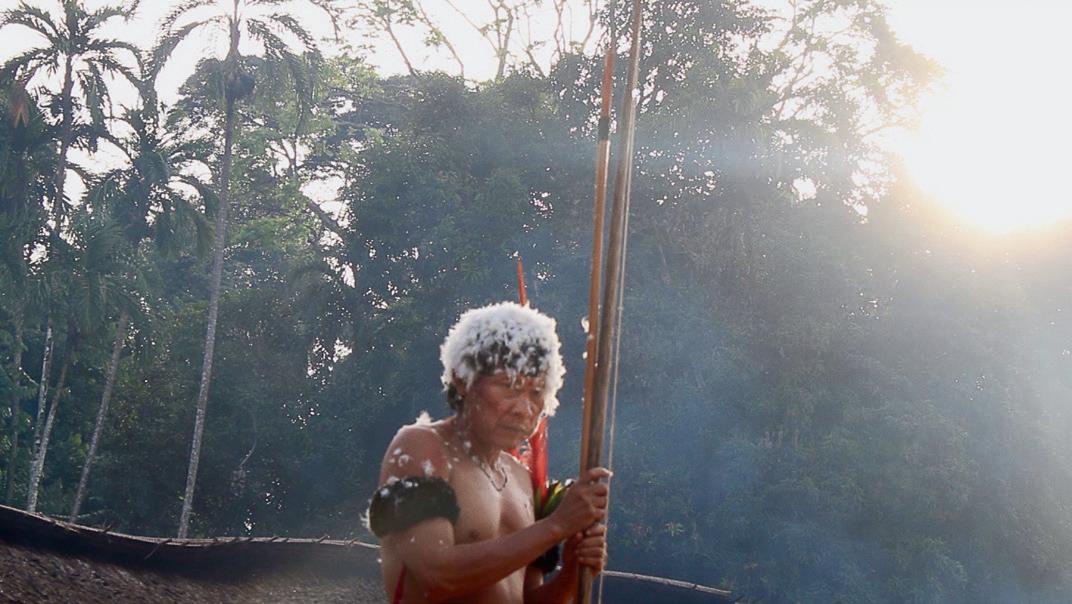
55 54
Yuri u xëatima thë [Fishing with Timbó] and Thuë pihi kuuwi
Thuë pihi kuuwi, 2023
A Woman Thinking. Directed by: Aida Harika Yanomami, Edmar Tokorino Yanomami and Roseane Yariana. Video, color, sound; 9’
use by shamans. Both are directed by Aida Harika Yanomami, Edmar
Tokorino Yanomami, and Roseane
Yariana Yanomami, members of the Hutukara organization, and were filmed in the Watorikɨ community.
Yuri u xëatima thë begins by placing us in a collective scenario and, after a turn in the script, follows a conflict involving a single character, blurring the boundary between reality and fiction. Thuë
pihi kuuwi, the narrator places us inside her mind, and we see what she sees over the course of an entire day in which she watches the preparation of the yãkoana. The ritual is one of the most important among the Yanomami: it is when the shamans come into contact with the xapiri spirits, calling them to dance and enter a trance and dream state. It is the shamans’ contact with the xapiri that protects
the entire community and, as Davi Kopenawa describes in A queda do céu [The Falling Sky], the oldest shamans teach the new generations to respond to the spirits’ call, because if they don’t, they will remain ignorant.
Rituals, traditions, the Yanomami people’s connection with dreams and their cosmologies have shaped a belief system about the preservation of worldly existence, and are powerful weapons through which life and our possibility of a future pulsate.
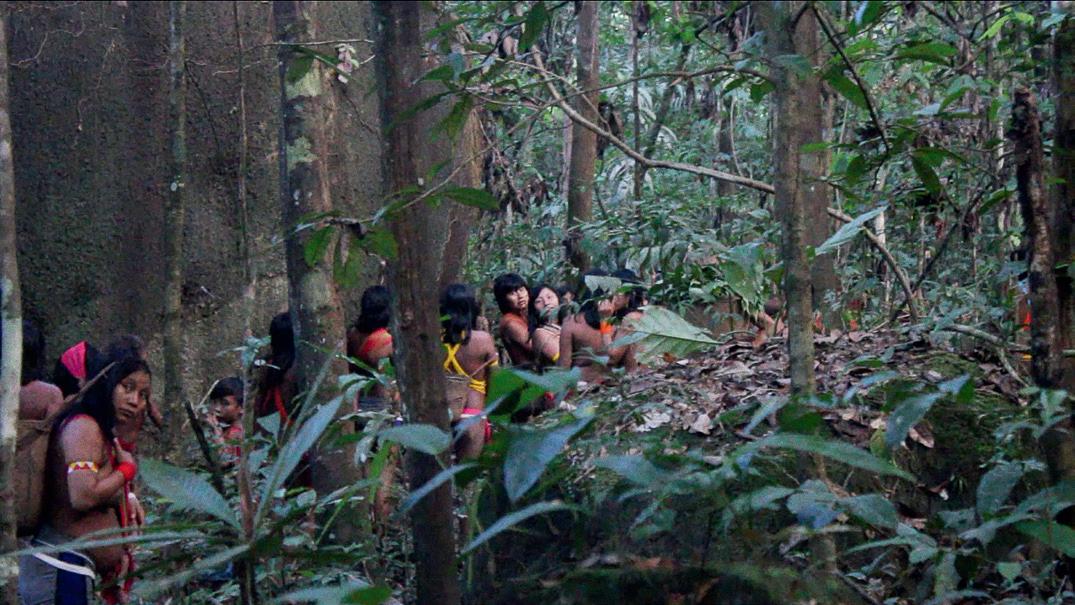
pérola mathias
translated from Portuguese by philip somervell
Yuri u xëatima thë, 2023
Fishing with Timbó. Video still. Video, color, sound; 10’
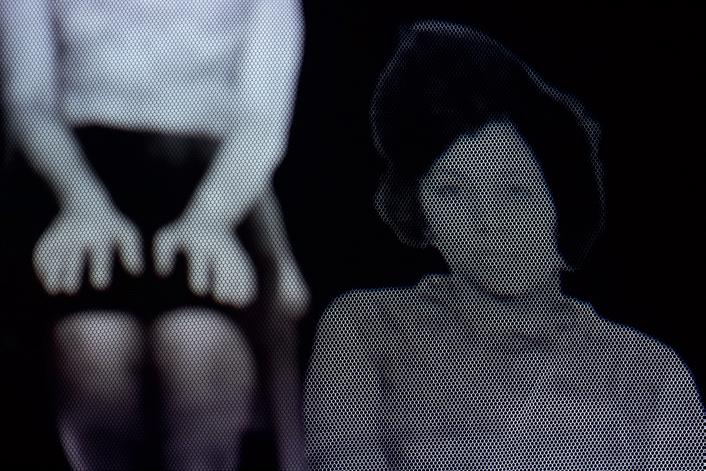

57 56 aline motta
Aline Motta marshals the material of history to make meaning. By turns poet and filmmaker, photographer and performance artist, hers is a speculative practice. Building and bending worlds through the process of annotation and redaction, she speaks into the silence of archival oblivion in order to make visible the unfamiliar and unknown. Beyond the frame of imperial fecundity, lie the intimate narratives she unravels. The
forging of Brazilian colonial history has fractured, bleached, burdened her familial lines, which she retraces – following the tug of an umbilical cord, which births her mother, then her grandmother. Across image and text, her epic work A água é uma máquina do tempo [Water is a Time Machine] asks, “might it be possible to fabulate new kinship ties, new lineages, and even new forms of filiation?1

From cradle to grave, womb to tomb,2 Motta moves meticulously through her own family’s traces. All the while, she examines the matriarchal force which makes all possible. Seas of pages, lines of ink, pools of blood – all are engulfed in the spiral of time, illuminated through the forms of care that Motta positions at the beating heart of her artistic practice. Yet these gestures are not easy, nor do they configure normative significations of love or femininity. Rather, they are bruised and battered, insistently blackened forms of support. Indeed, as theorist in African American studies Saidiya Hartman argues, these very “forms of care, intimacy, and sustenance exploited by racial capitalism, most importantly, are not reducible to or exhausted by it…This care, which is coerced and freely given, is the black heart of our social poiesis, of making and relation.”3
oluremi onabanjo
1/ Aline Motta. 2021. “A água é uma máquina do tempo.” eLyra: Poesia e Arquivo, n. 18, p. 333-337, 2021. (Depoimentos). Available at elyra.org. Accessed in 28 May 2023. Translation mine.
2/ Here I invoke Christina Sharpe, In the Wake: On Blackness and Being. Durham, NC: Duke University Press, 2016, p. 87.
3/ Saidiya Hartman, “The Belly of the World: A Note on Black Women’s Labors,” Souls: A Critical Journal of Black Politics, Culture, and Society, 2016, 18 (1): p. 171.
A água é uma máquina do tempo, 2023 Water is a Time Machine. Video still
Artificial intelligence will soon knock us off our feet, but for now we can still glimpse remnants of humanity in certain trades whose existence wavers between contradictions and resistance. Such is the situation of the art critic, and also of the security guard, a profession that is the source of artistic research for Antonio Gonzaga Amador and Jandir Jr. This is from where the Amador and Jr. Segurança Patrimonial Ltda. per-
formance company emerges. Duly uniformed – suit and tie always –they have been making their mark on the market over the years. The duo specializes in safeguarding art galleries, exhibitions, salons, biennials, and the like. Sometimes you will see them standing right in front of a work, stalling its appreciation (Sem título [Untitled], 2016); in others, you can find them immersed in books (Ler [Read], 2023), staring down-

59 58
amador e jr. segurança patrimonial ltda.
Untitled, 2016
Performance documentation, Museu Nacional de Belas Artes, Rio de Janeiro (2016)
wards (Chão [Floor], 2023) or even with eyes tightly closed during working hours (Vigilante [Watchman], 2016). All in order to serve you better, ladies and gentlemen.
In these performances, the weapons used to defend the heritage of others are mockery and irony, but the game is not restricted to the scope of humor. Antonio and Jandir use their own bodies to set up logic bombs through a tensioned
presence; they mine a field where the structures of our formation are exploding under our feet: institutional racism, the exploitation of workers, the precariat, the sinister persistence of slavery, in other words, the maintenance of the elites who consume art.
Formally, it is an overlap. Amador e Jr. Segurança Patrimonial Ltda. has the expertise to double the spaces where it performs; if the floor area
is 100 square meters, it can easily reach 200 square meters, or even more. However, it is worth remembering that this unusual phenomenon can only be achieved on the brain surface of the public, who, if not obtaining the additional terrain, will at least be able to leave having a good laugh, without having understood the joke.
translated from Portuguese by philip somervell
 igor de albuquerque
Nada! Artes aquáticas, 2019 Swim! Aquatic Arts. Performance documentation, Centro Esportivo e Educacional Golfinhos da Baixada, Queimados (2019)
igor de albuquerque
Nada! Artes aquáticas, 2019 Swim! Aquatic Arts. Performance documentation, Centro Esportivo e Educacional Golfinhos da Baixada, Queimados (2019)

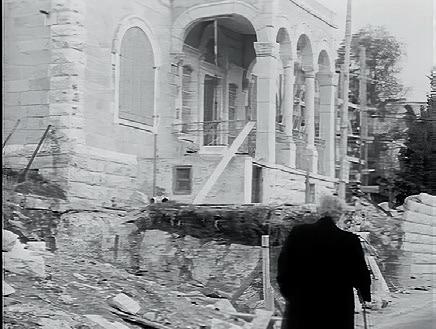
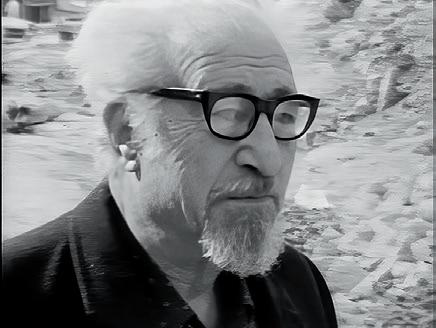


61 60 amos gitaï
51’
Bait, 1980 House. Film stills. 16 mm film transferred to video;
“Gitaï wants this house to become both something very symbolic and very concrete, to become a character. One of the most beautiful things that film can ever accomplish: people looking at the same thing and seeing different things. And being moved by this vision.”
– serge daney, Libération, March 1, 1982
Amos Gitaï has been documenting a single house in West Jerusalem for over four decades to narrate the history of a complex region through various artistic forms. His projects started with a documentary trilogy shot over 25 years: Bait [House] (1980), A House in Jerusalem (1998), and News from Home / News from House (2005). In these films the architectural space reveals a political state.
Bait is Amos Gitaï’s first film, shot in 1980 immediately after he returned from Berkeley where he had completed a Ph.D. in architecture. This black and white documentary shot on 16mm film traces the changing owners and occupants of a house starting with the original owner, a Palestinian doctor who fled the house in 1948. The Israeli government then confiscated the house and rented it under an “absentee” law to an Algerian Jewish immigrant couple. At the time of the filming an Israeli professor of economy bought the house. He decided to transform it from a single-story house to a three-story villa. But to achieve the construction he had to hire Palestinians from the refugee camp and use stones from the mountains of Hebron. The architectural site of the House, therefore, become at the same time a microcosm of the Israeli-Palestinian relationship as well as a metaphor for Jerusalem. The film becomes an open stage for different occupants, workers, and developers to share their biographies and visions. The broadcast of the 1980 film House was banned at the time by the Israeli television.
edited by juliana de arruda sampaio
"The unity is submarine..." − edward kamau brathwaite
EXERCÍCIOS DAS MARGENS DO TEMPO, 2023
Exercises for the Margins of Time. Photography and digital manipulation. Study for the work commissioned by Fundação Bienal de São Paulo for the 35th Bienal
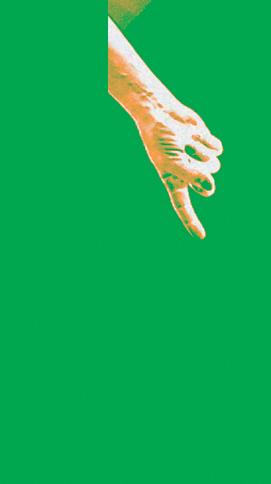

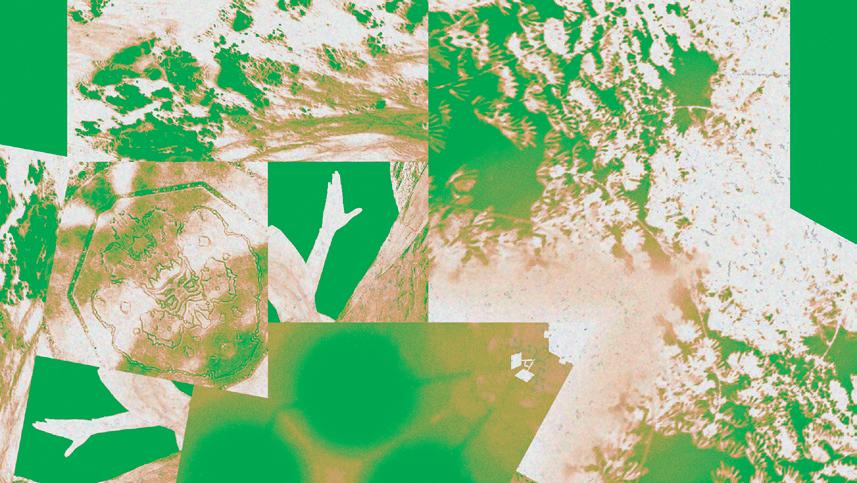
63 62 ana pi and taata kwa nkisi
imê
mutá
Ana Pi is a mover of body and spirit who integrates notions of transit and displacement through ordinary gestures, colors, and sounds. Taata Kwa Nkisi Mutá Imê is the head of Casa dos Olhos do Tempo que Fala da Nação Angolão Paketan Malembá–Nzo Mutá Lombô Ye Kayongo. Since the 1980s, she has shaped a methodology for teaching and researching sacred dance throughout the African Diaspora,

engaging nkisis, voduns, orixás, caboclos and encantados through movements that balance mental, physical and spiritual dimensions. Together, “these practitioners make use of spaces that cannot be seen.”1 In tandem, they write with their bodies, stitching together spaces and memories in order to move beyond the choreography of the stage into movements of everyday life.
Their collaboration has birthed a transnational expressive project that triangulates Brazil, France, and Senegal. In form, “the networks of these moving, intersecting writings compose a manifold story that has neither author nor spectator, shaped out of fragments of trajectories and alterations of spaces.”2 It is an embodied, poetic rumination on pathways across beaches and cobbled streets, entering and emitting from institutional collections at the Institut Fondemental d’Afrique Noire (IFAN), Dakar, Senegal, and Musée du Quai Branly, Paris, France. These makers share a commitment to the errant, which in reality is “the postulation of an unyielding and unfading sacred.”3 While they acknowledge a form of thinking inscribed through vision, they embrace knowledge that emanates from the body in the traces we leave, in the sighs we emit. Theirs is a collaboration committed to the peripheral — a mental space where the unsure can become a place of construction; a place where one goes looking for the image seared in the mind’s eye, but returns with seeds, ready to grow new worlds.
oluremi onabanjo
2/ Ibid, p. 93.
3/
1/ Michel de Certeau, “Walking in the City,” in The Practice of Everyday Life (1980), trad. Steven Rendall. Berkeley: University of California Press, 2010, p. 93.
Édouard Glissant, Poetics of Relation (1990), trad. Betsy Wing. Ann Arbor: University of Michigan Press. 1997, p. 21.
this participation is supported by: Institut français.
Anna Boghiguian’s work is a polyphonic narrative that unfolds through drawings, paintings, dioramas, installations and texts. It is, at the same time, an astonishing tool of historical investigation that, without yielding anything in terms of poetics, is able to analyze specific contexts, fragments of individual lives, and wide-ranging phenomena. The latter is the case in Woven Winds – The Making of
an Economy – Costly Commodities (2016-2022), in which, through drawings, texts, collages and self-supporting cutouts, the artist recounts the genesis and development of the cotton trade, an activity that both anticipates and prophesizes the contemporary globalization of the economy.
Malcolm Ferdinand, a scholar of political ecology, prefers to refer to our era with the term
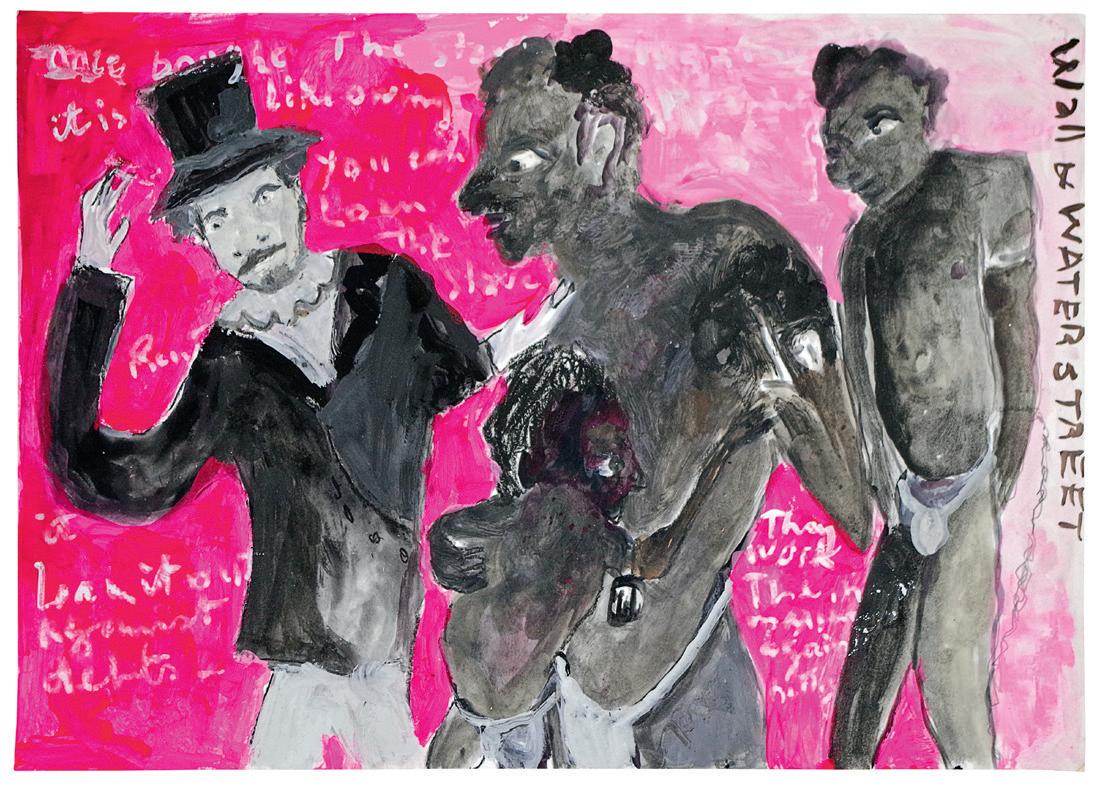
65 64
anna boghiguian
Plantationocene (the age of the plantation) to emphasize the responsibilities of colonialism in the current social and ecological crisis. Boghiguian’s work seems to corroborate this thesis. Indeed, before her work, the viewer is immersed in a story populated by enslaved West Africans deported to the New World to work on cotton (and other) plantations, those same plantations that
replaced indigenous forms of cultivation and circulation of products to make way for an extractive, profit-driven production model.
The dramatic stories of the enslaved are intertwined with those of European migrants. In fact, Boghiguian depicts a ship in the act of unloading its cargo of poor Europeans (such as the Irish forced to flee the Great Famine of 1845, which lasted until 1849)
landed in the United States to contribute to the formation of the great wealth of that nation that, as the artist points out, owes much to the cultivation of cotton and the fact that it was organized on the basis of chattel slavery.
A tireless traveler, Boghiguian trained between Egypt, Canada, and Mexico. Her art is a form of recording reality and context, but never with a detached gaze. On the contrary, this artist’s work is always positioned with respect to the social conditions of the present and often includes an interrogation of the historical events that produced them. At the same time, the artist’s great love for Symbolist painting –Gustave Moreau and William Blake, for example – emerges through a surreal vein that is an integral part of her poetics, deconstructing the official languages of power, desecrating their “sacred” representations: a hallucinated and ironic dream in which the artist moves her own poetic attack on absolute power and its incarnations.
 marco baravalle
watercolor paintings from Woven Winds − The Making of an Economy – Costly Commodities, 2016 Pencil and watercolor on paper. 18 pieces, 41,8 × 29,5 cm (each)
marco baravalle
watercolor paintings from Woven Winds − The Making of an Economy – Costly Commodities, 2016 Pencil and watercolor on paper. 18 pieces, 41,8 × 29,5 cm (each)
anne-marie schneider
From her first drawings in the 1980s, focused on the overflowing potential of writing and line to her later incursions into the planes of color and in the experience of a polychromy that is situated towards the sensitive, the stroke seems to be the element that gives unity to the deliberately fragmentary imaginary of Anne-Marie Schneider.
The artist explains that, while creating, she works with con-

67 66
Untitled (Blue Interior), 2012 Acrylic on paper, wood frame and plexiglass, 10 pieces, 30 × 30 cm (each)
sciousness and unconsciousness at the same time. In this way, the pieces selected for coreografias do impossível are a repository of mental images that are transfered to paper. Replete with biographical resonances and allusions to social issues, the artist tries to register –or choreograph – through them the tremor that is the self, but also, as that Rimbaudian aphorism pointed out, “is another”.1
In her works abound lonely characters or in disturbing relationships, distorted faces that are confused with their own masks, bodies that mutate and extend in the domestic space, emotional architectures where the boundary between person and structure is blurred. In the words of the critic Jean-François Chevrier, these bodies-house understand what surrounds them “as an unstable com-
plex worked out by the violence of affections”.2
The incongruous deformations make their way into a practice of their own that looks at both the grotesque and the fable; whether from the absurd, irony or criticism. Thus, the drawings and paintings of Anne-Marie Schneider sketch a self-constructed semblance: one that doesn’t stop recomposing itself through the recovery of gesture, of the remains and confusions of the speech, of the scenes that – as the referenced Virgina Woolf explained – produce a wave in the mind.4
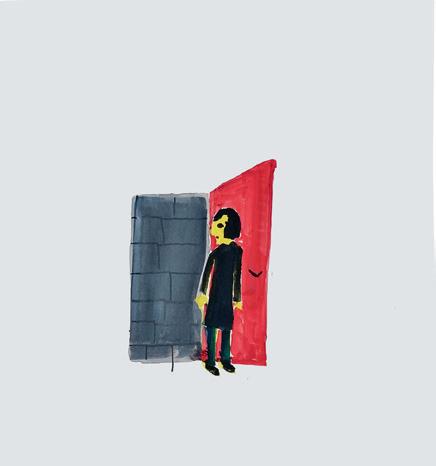
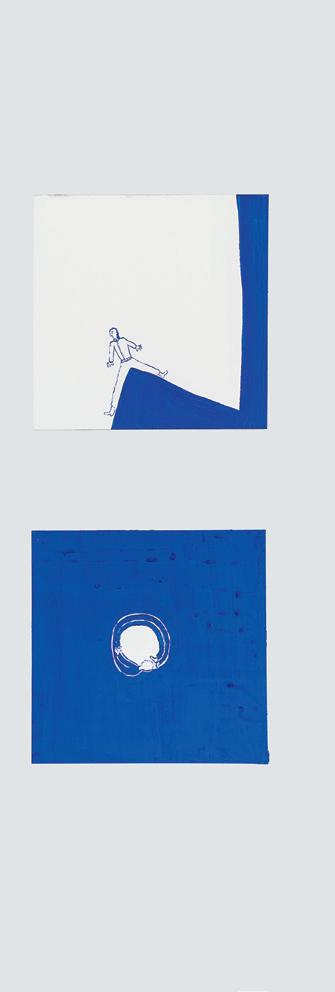
beatriz martínez hijazo
translated from Spanish by ana laura borro
1/ This phrase by French poet Arthur Rimbaud, “Je est un autre” appears in a letter from 13 May 1871, addressed to his professor Georges Izambard.
2/ Jean-François Chevrier, “Stroke film color” (Trazo película color). In Anne-Marie Schneider, Madrid: Museo Nacional Centro de Arte Reina Sofía and Éditions L’Arachnéen, 2016.
3/ Virginia Woolf, “A wave in the mind” [Letter to Vita Sackville-West], March 16, 1926. In Virginia Woolf. About writing (Sobre la escritura), ed. Federico Sabatini, Barcelona: Alba Editorial, 2015, p.34.
_
this participation is supported by: Institut français.
Untitled (Brick Door with Personage), 2019 Acrylic on paper, 46 × 42,3 cm
archivo de la memoria trans (amt)

The Archivo de la Memoria Trans [Trans Memory Archive] (AMT) seeks to protect, construct, and recover memories of the trans community through photographs, videos, and newspaper and magazine clippings. Created in Argentina and with a collection of approximately fifteen thousand pieces, the archive exists and grows daily through donations. Challenging prevailing narratives, the AMT serves
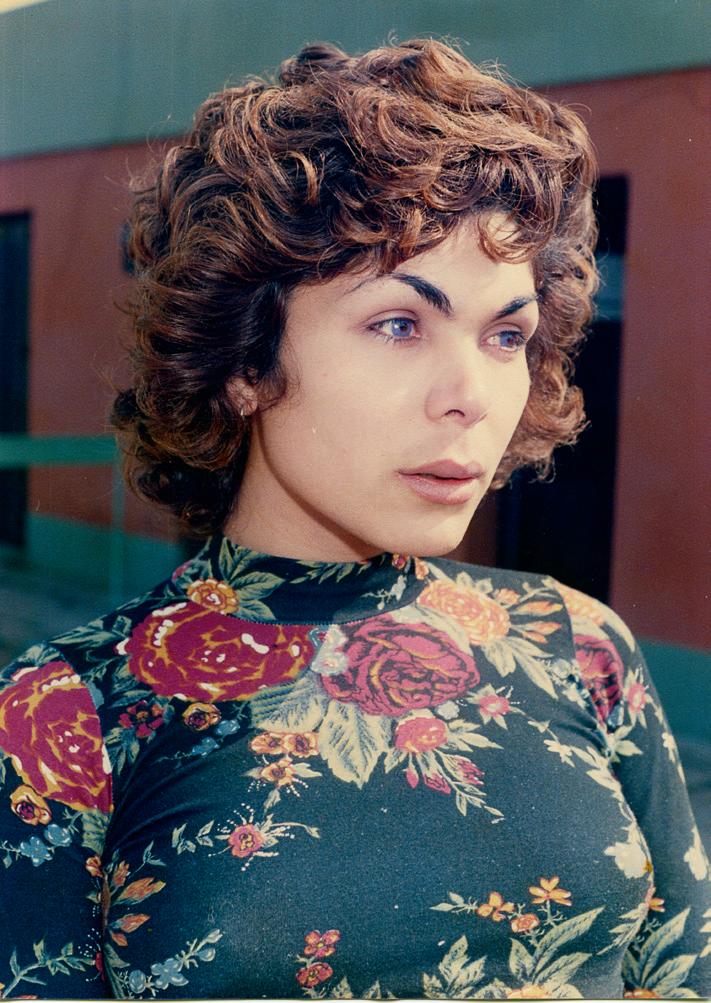
69 68
Fondo Documental [Fonds] Marcela Soldavini – La Rompecoche, c. 1985 Photography
Fondo Documental [Fonds] Malva Solís, c. 1965 Photography
as a depository for a deliberately erased collective memory, reminding society of the experiences of trans people, who have faced hostility and incomprehension in society and suffered from negligence of the state.
The archive arose out of the visionary ideas of activists María Belén Correa and Claudia Pía Baudracco. After Claudia’s death in 2012, María Belén started developing the project. She created a Facebook

group, Archivo de la Memoria Trans, to connect with people involved in this history of struggle. In 2018, the group had over a thousand trans women participants, Argentinan and otherwise. The initial idea was to gather the members, their memories, and their photographs, first, preserving that material in a library, and later in a virtual space. Before long, this objective expanded and soon transformed into a col-
lective effort to construct a common memory.
The AMT is hugely significant as a place of memory and preservation, as well as being another form of activism.1 It serves the double purpose of constructing an archive that sheds light on the lives and joys of trans people and also documents the challenges that community has faced in Argentina. The public can access its content through various online platforms, promoting an inclusive space for engagement, discussion, and action on identity and resistance. In preserving photo albums and so many other personal memories, the archive takes on the role of a kind of family reunion. These sets of images hold the visual narratives of an affective network based on support, protection, and the celebration of life, and preserve the memory of the friends who are no longer with us.
In the 35th Bienal de São Paulo, the archive takes on the form of a wall of memories, a collage of over three thousand pieces, including newspaper and magazine articles, personal photographs, images of intimate moments, and portraits of everyday life. Through this installation, these documents become windows into lives from a past that echoes strongly today. Each photograph holds a memory, and the mural transforms into a monument to struggle.
sylvia monasterios
translated from Portuguese by georgia fleury reynolds
_
1/ See Memorias reveladas, by Quentin Worthington (France, 2019, 23'), documentary on the creation of the amt.
Fondo Documental [Fonds] Vanesa Sander, c. 1990 Photography
the gaze that wishes to un-decree the ugliness assigned to madness, to madnesses, needs to be everything but clinical. it is a gaze that needs to reach everything, while carefully un-hitting targets (usually dark ones). and which requires a gesture that does not need to cover everything, away from the colonial delirium of conquest, of cataloging, of categorizing, which cannot listen to the voice of self-determination.
to this day, madness has been treated as an ugly wound shelved in walls higher than museums’ white pillars. thus, some museums take upon themselves the task of breaking the interdiction imposed when madness is called ugliness, when it is condemned to hiddenness, thus assigning programed unintelligibilities to it. still i wonder with which cloak was arthur bispo do rosário’s (1909 [1911]-1989) body buried after his
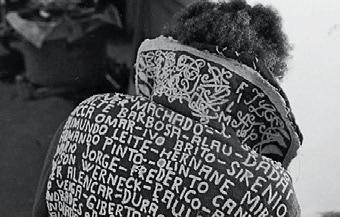


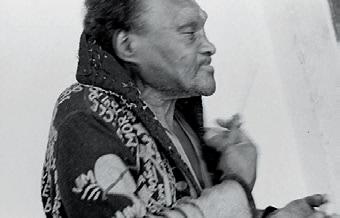
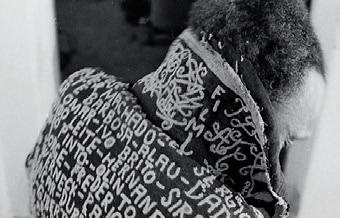

71 70
arthur bispo do rosário
passing; i wonder if any of the cloaks he made escaped the fate or fury of that, in the name of “the discovery of beauty”, had them removed from the psychiatric cubicles where the sailor, the boxer, the lame, was detained for being considered mad before being labeled an artist – a title he refused –, there where he wove them.

i wonder if any of the cloaks fulfilled the black prophet’s dream
of covering his body, and unveiling his soul, on his last judgment day? a day that ultimately has been being lived (or died) bit by bit, as each person (still) dies, even in present times, of massive black psychiatric incarceration.

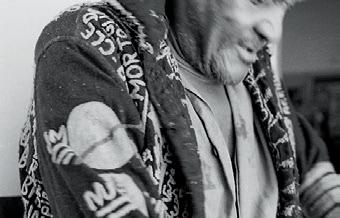
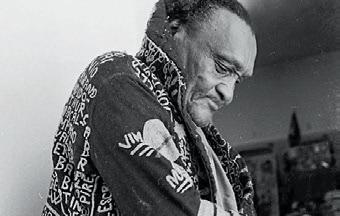
this is a rhetorical, dramatical, question. and as we move in our flesh, free for now from the last judgment, through the expographed, museological, perfectly
lit museum pieces, we walk a path over the silence of its nonanswer.
if there is beauty in the ugliness with which we over-look madness, when can we call it art? maybe it matters to say that the embroiderer died far, far away, from the museum; locked inside huge walls, deep inside the asylum. that even before dying, pretty locked inside there, he was already being separated from his cloaks, his banners, every cloth and vitrine he embroidered, sewed, wove, for not being an artist nor an atheist.
and bispo do rosário now is the name of a museum! covered in the invisible artist cloak he did not wove.
tatiana nascimento
translated from Portuguese by bruna barros and jess oliveira
Arthur Bispo do Rosário with the work Semblantes [Faces], undated
aurora cursino dos santos
how many stabs make up this sorrow? and how many strokes does it take to undo it? there are too many eyes, in the paintings, almost as many as there are – more, or less readable – words. the eyes seem to gaze from there, from before, when they were painted, in order to see if the present has brought something new, less stabbing, less bloodshed, less of this sorrow.

73 72
it’s a sorrow with many names: sexism, misogyny, patriarchy, oppression, abuse, disrespect, dehumanization… some of the pairs of eyes translate some of these names, if you pay attention, if you have the courage to look back there, into them, into the paintings, into the time that tried in so many ways, so many times, to silence Aurora (1896-1959).
prophecies, reveries, exorcisms, predictions. a desire: to predict
herself happy future. the art of escaping the destinies programmed for the end. for subjection. for violence. for sorrow.
right before the turn of the century, Aurora is born. categorization through so-called biology was even stricter then than it is now: and Aurora was born a girl. a girl daughter of a mother, and daughter of a father. and once this girl comes of age, father forces her to marry. but she
suffers from drapetomania! she is given to flights, to drifts, to the destinies reinscribed by desire’s very designs.1
Aurora runs away, gets divorced, tries everything in this life: including the arts, in the old world, for she dreams, and dreams get hungry too. and such a hunger is probably what led her to, as they say, the world’s oldest profession, right? as old as that sorrow? older? professions, subjections: wife, whore, maid. flaws: mad.
but this old Aurora, as her paintings tell us, was kind of predicting the world anew, despite all that debris, all the ruins of these so archaic worlds, so hard to get past, constantly trying to bury her:
maybe it is a reverie of mine, maybe it is just my desire, but it seems like, besides so many stabs, the so many eyes she painted seek a trace of this dream-world – where women, no matter the profession they have (or not), regardless of how hard the walls of the missus’ house or the asylum cells’ try to strangle, suffocate, silence… a world where any woman, no matter how indecent she may be considered, “amoral psychopath”, is able to predict herself happy future. & i dream along.
tatiana nascimento
translated from Portuguese by jess oliveira and bruna barros
1/ The few and uncertain biographical data about Aurora Cursino dos Santos are in her paintings and drawings, almost always self-referential, somewhere between memory and delusion. They are also in medical and psychiatric documents which, as in every archive of violence, exceed in their partiality and demand a critical and distrustful reading.[e.n.]
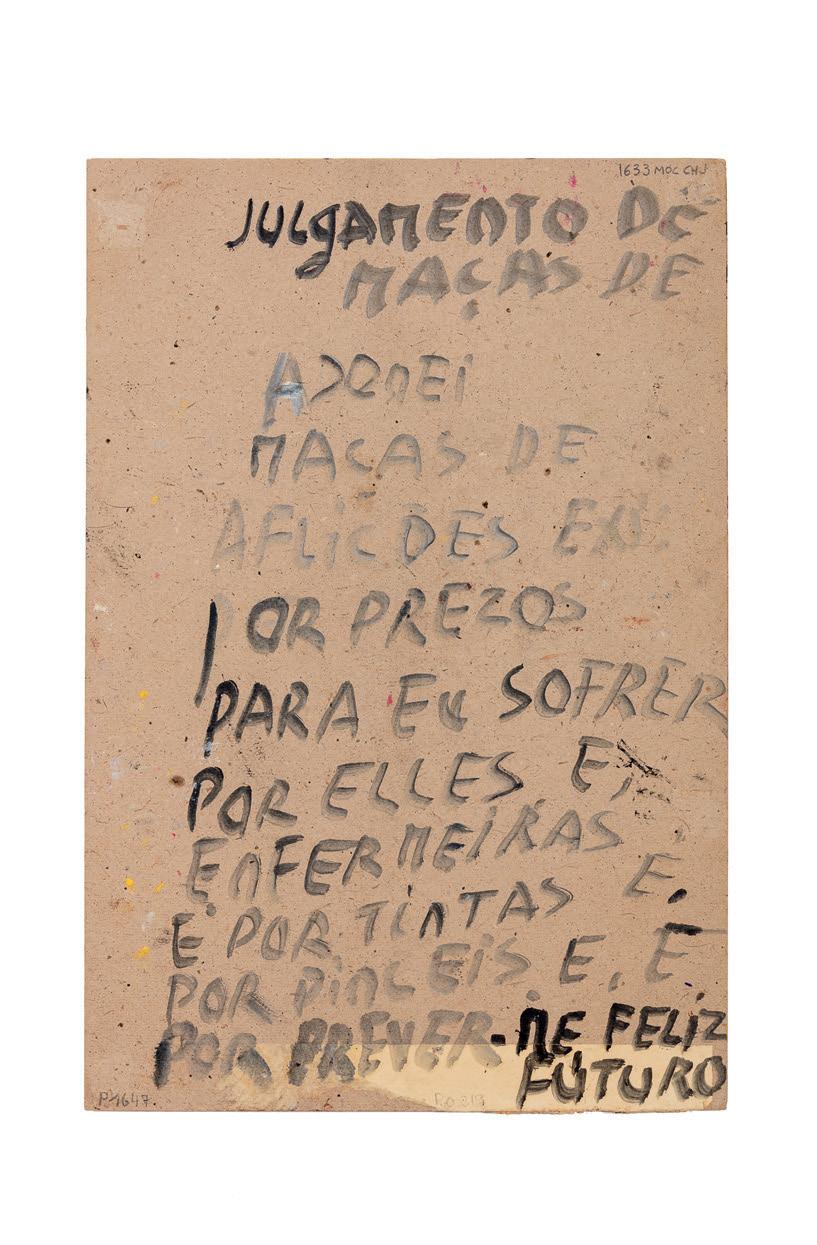 Untitled, undated (front and back) Oil on paper, 47,5 × 32 cm
Untitled, undated (front and back) Oil on paper, 47,5 × 32 cm
ayrson heráclito and tiganá santana

75 74
Agô!
Permission is asked to enter the sacred forest.
Populated by material lives, inanimate lives, or lives that have become ancestral, within it dwell various energies, which together form a forest of infinities.
Under the ever alert protection of caboclos, encantados, Oxóssi, and Mutalambô, Ayrson Heráclito
and Tiganá Santana, eyes that never sleep, fulfill a dream: a tribute to the forest, an offering to the forces of nature, praising the energy stored among plants and trees that make the existence of humanity possible.
From the projections that reflect multiple images, producing sounds and sensations that emerge in a cold and colorful forest, spring rivers, birds, and crumpled leaves

on which we walk. Flowers, tree frogs, insects, and other extinct biomes coexist with native ancestors, caboclos, Chico Mendes, Bruno and Dom, and mother Stella de Oxóssi. When this forest cries the pain of violence, colonialism, and destruction, it is Oyá, now guardian of all these Eguns, mother of all that was once alive, who invites you to dance joyfully and celebrate life that is preserved and renewed in nature.
The forest of infinities, installed in the center of the largest city in Latin America, is a feat of art, the fruit of a hunter’s courage. It is an impossible story materialized in the name of a political project that defends life and the preservation of nature, and which proposes a radical break with ignorance and extermination.
Agô, it is time to leave the forest. Let the forest return to its mysterious silence, with its encantados, rivers, and infinite life forms. With humans absent, bamboo trees sway again, signaling the restoration of balance. Invisible beings merge into a single vital power and are free again at dusk in the forests of Oxóssi and Mutalambô. Regarding the human visit, they ask themselves: will they learn that all life is sacred?
Agô.
The blessing. Olorum Modupé.
luciana brito
translated from Portuguese by philip somervell
Ayrson Heráclito and Tiganá Santana

77 76
benvenuto chavajay
I have been given the floor to speak about Benvenuto to all of you, the others. Here at the 35th Bienal de São Paulo, he, like some others, does not fit into the role of just an artist: he is a ritualist who summons worlds, underworlds, supra-worlds. Other possible worlds.
As, in the West, the action of someone hanging upside down is commonly related to the image of torture or execution, Chavajay’s

action disturbs us. However, in the Mayan world, people who let themselves fall upside down dancing have much more to do with fertility and the celebration of dignified life.
Benvenuto stands on his head with a rattle that calls souls: but he is framed in a frame so that rituality, to those of us on this side, “appears as art.” Here, then, all the questions arise about the limits between the paradigms that make other existences invisible, turning humans, animals and spirits into pure merchandise (the concepts in which we move daily, classifying reality under parameters imposed by fire) and that which resonates within us, still... and in spite of 500 years.
Chavajay also presents himself as the son of illiterate people; this means, in reality, that he is heir to a lineage of those who do not know the symbolic logic of colonial domination and extermination. A territory, a community, a language and a history of resistance dance with him.
Benvenuto claims it as much as the lost honor of stones, sacred elements in many cultures on the American continent. Therefore, his performative actions are of great generosity: he mobilizes forces not as an empty spectacle, not as an eccentricity, but as a small fire that will dissolve the soul of stones.
natalia arcos salvo
translated from Spanish by ana laura borro
Camino/en la grieta a Xibalbá, 2023 Path/of the entrance of Xibalba. Video stills. 2 channel videoinstallation; 6’, 7’
Choreography goes beyond the composition of movement in space, it involves working with time, with the voice, with the affections of those who watch, and with the invisibles that flit between the images in the form of words, memories or stealthy allusions. The choreographic can occur on stage, but also in a public space, or on a video screen that shows the action of a group of women in a desert.
The Corbeaux [Crows] choir is constituted by women of different ages and backgrounds, some of whom have been part since the beginning of Compagnie O. Fatna, Kabboura, Fatéma and Halima were already professionals before meeting Bouchra: they had worked as shikhat, dancers and singers who liven up parties and popular celebrations. If the function of the shikhat can be considered in itself
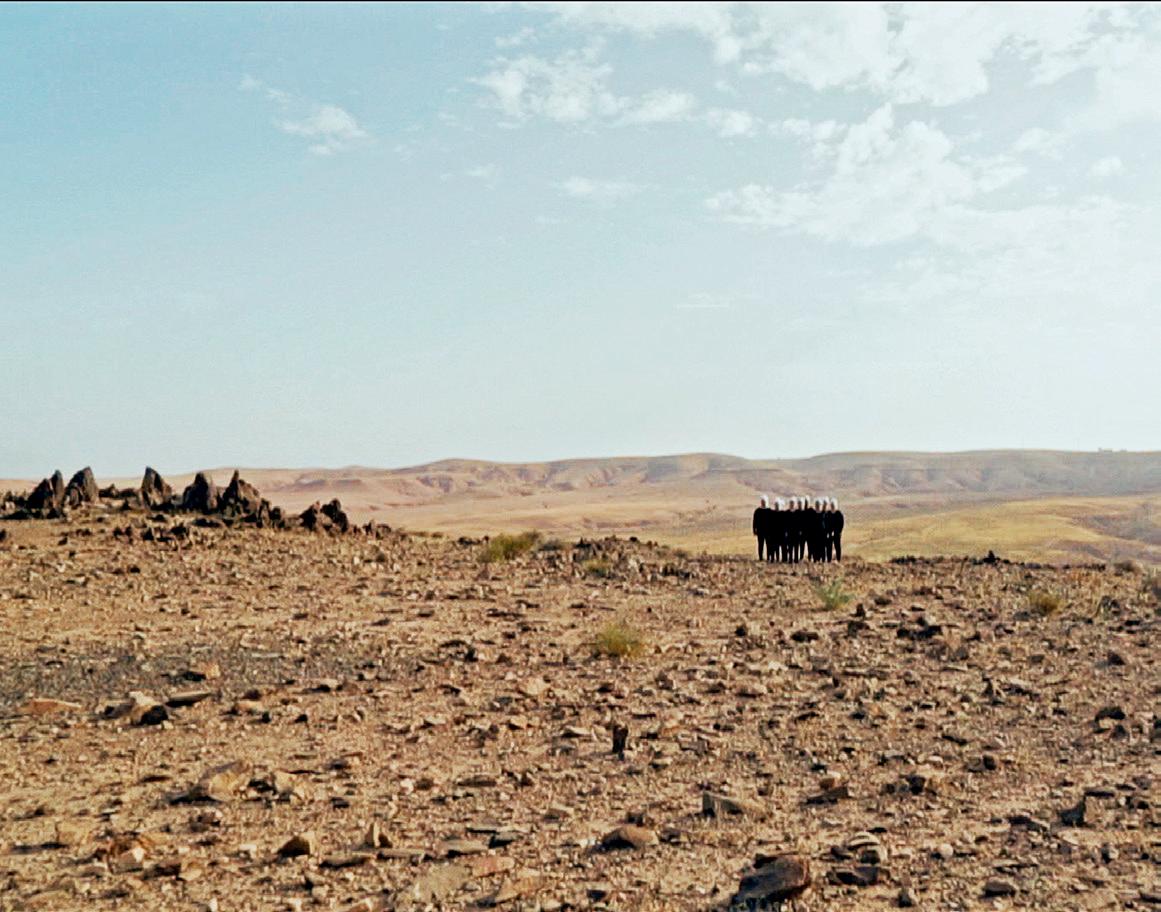
79 78
bouchra ouizguen
subversive, due to their freedom to address topics forbidden to women in public spaces, in their collaboration with Bouchra they shed the spectacular costumes and masks to expose their bodies, trained in the aita and in popular dance, and build situations of poetic sorority. With a simple gesture, Bouchra and Compagnie O produce a displacement with respect to the hegemonic modes of contemporary
dance, while avoiding the exoticization and domestication of the tradition which results of cultural and entertainment tourism.
In this singular choreographic proposal, classical Arabic poetry constitutes a mobilizing element, but it does not occupy a privileged position with respect to Berber singing, the creative force or the daily experiences of these actresses. That everyday life is what
is shown in Fatna, where Bouchra materializes the idea of a dance that can occur in any circumstance, while reading, cooking or leading the sheep. Its reverse is constituted by the collective, ritualized action, in an extended community that deeply affect the audience in their live performances, not only for their repeated gestures and vocal rhythms, but for the forcefulness with which they create that collective that, in its imperfect simultaneity, coexists with the affirmation of the uniqueness of each of the participants. This piece, between living sculpture and ritual at ground level, arose, according to Bouchra, from an impulse, affected by the bustling beauty of the Marrakech market. Flying into the desert, this flock of crows [corbeaux] shows all the beauty, at the same time sacred and playful, of the bodies [corps beaux] thanks to that camera that flies with them and settles on the detail as an incarnate vision.
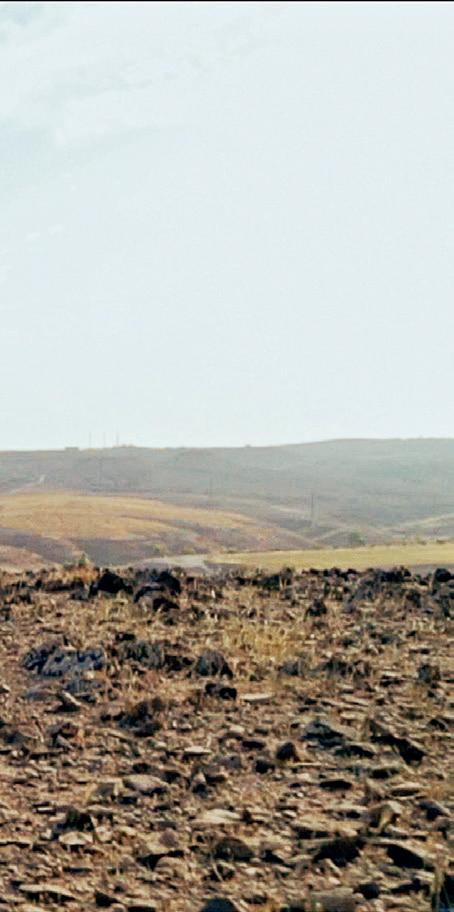 josé antonio sánchez
Corbeaux, 2017 Crows. Video still . Video; 8’
josé antonio sánchez
Corbeaux, 2017 Crows. Video still . Video; 8’
cabello/carceller
Since their emergence on the contemporary art scene in the mid1990s, the work of Helena Cabello and Ana Carceller has questioned the devices and conventions of the representation of sexualities and identities outside the norm.
In Una voz para Erauso. Un epílogo para un tiempo trans [A Voice for Erauso. An Epilogue for a Trans Time] (2021-2023), the artists bring the complex biography of
Antonio de Erauso to the present. Known as “The Nun Ensign,” he was a character from the Spanish colonial baroque famous for having managed to circumvent the gender binarism imposed on the bodies of the Empire.
The work develops in a game of distancing that weaves a queer and almost hauntological1 temporality. Four centuries later, three non-binary trans people question the
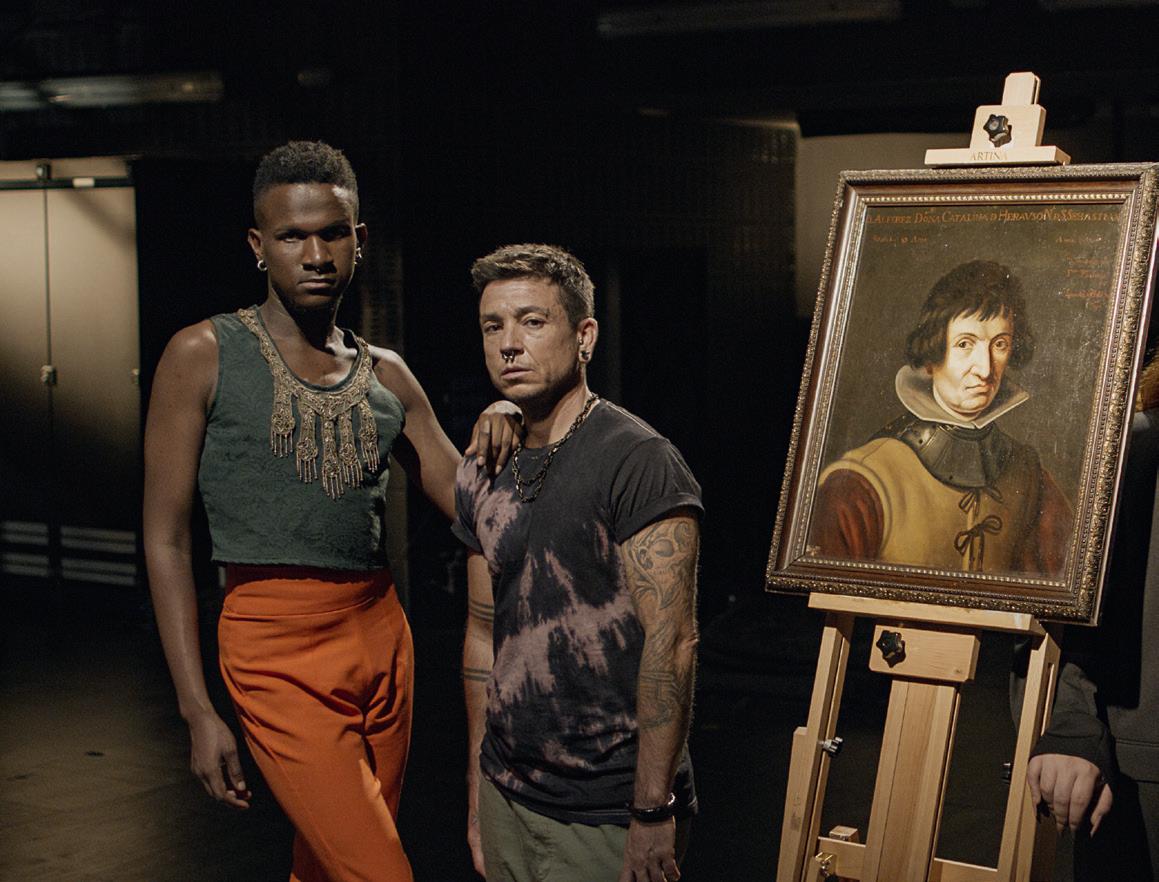
81 80
portrait of the ensign and, through it, unfold a fundamental issue: the right to be named. However, far from creating a new queer hagiography, the protagonists build up the narrative and expose its dark areas: Erauso’s confessed racism, his participation in the Mapuche genocide, the high levels of violence that permeate his history.
Thus, Cabello/Carceller expose a series of strategies that delve
into several key aspects. The first is that every portrait is always performative. The second, as Paul B. Preciado explains, is that the figure of Erauso is a discursive and visual territory in dispute, a place “where a multiplicity of conflicting identities is constructed and deconstructed”2.

In a historically dense queer gesture, Cabello/Carceller outlines dissident counter-images on
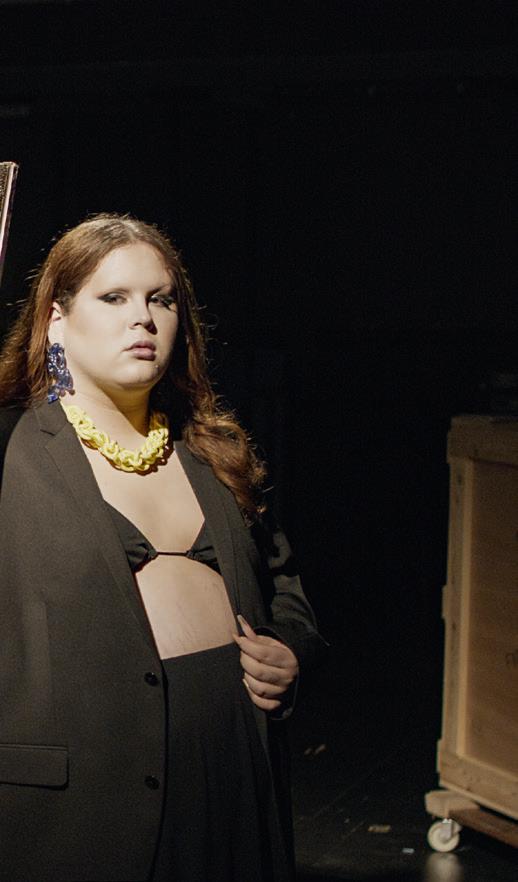
the margins. Whether at a glance or through connotations, these footnotes reveal elusive, discontinuous, and bastard genealogies. As another addition to van der Hamen’s oil painting, as an Una voz para Erauso. Un epílogo para un tiempo trans, Cabello/Carceller’s words and scenes challenge the integrity of the hegemonic and make art a tool to address the ever-flickering horizon of subjectivities that lie ahead.
beatriz martínez hijazo
translated from Spanish by ana laura borro
1/ In French hantologie, a concept created by Jacques Derrida in his book Espectres de Marx (1993), in which he unites the terms hanter [to haunt] and ontologie [ontology], referring to the persistent return to theories of the past. [e.n.]
2/ Paul B. Preciado, “Una voz para Erauso. Epílogo para un tiempo trans”, in Cabello/ Carceller. Una voz para Erauso. Epílogo para un tiempo trans. Exhibition catalog. Bilbao: Azkuna Zentroa – Alhóndiga Bilbao, 2022, p. 14. [e.n.]
_
A Voice for Erauso. An Epilogue for a Trans Time, 2021-2022
A Voice for Erauso. Epilogue for a trans time. Video stills. 4k video transferred to HD, color, sound; 28’15’’
carlos bunga When the subject of conversation is the scale of Carlos Bunga’s work, it will always be lively. Firstly, for an obvious reason, because the theme is common enough in the context of site-specific art and installation. But the real reason lies in the gravitational singularity of the bodies in question. For approximately two decades, Bunga has been building and destroying a work whose evanescent axes insist on mess-
ing up the notions of grandeur and measurement in space-time. The monumentality of color, for example. To go beyond painting and canvas, color will need a skin (Superfície cutânea [Cutaneous surface], 2015), and a poetics of explosion-expansion through the sensory continuum. Thus it is possible Habitar el color [Inhabit the color] (2015-ongoing), a work that spreads a huge area of paint on the

83 82
floor and invites the public to take off their shoes and walk into it, to see the color with their feet, to feel the skin on their own skin. If color was once eternal in the paintings of the great masters, in this work it is as splendidly able to rot as our flesh.
Elsewhere, Bunga will be seen working to erect grandiose structures using cardboard and tape as support in his installations, which
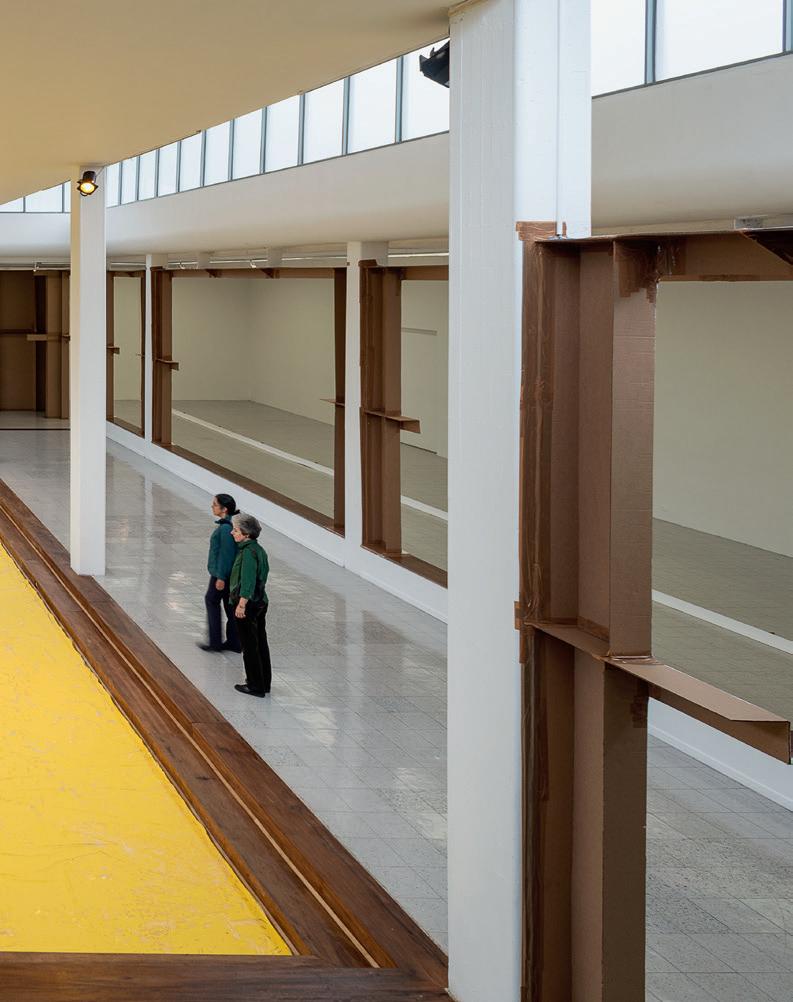
sometimes become a stage for dance performances (Occupy, 2020). He is interested in the shaky structure that clearly announces the choreography of its own ruin; to place assembly and disassembly in a feedback process. He is interested in those interstitial zones where measures escape Sumerian and Indo-Arabic rationality – the ten and the sixty, or even the eleven dimensions of contemporary
physics/mysticism. What systems will we have to resort to if we still want to insist on the task of narrating and retelling the Universe? Bunga’s steps – his dance –describe, if not answers, the courage to keep moving in the face of those three fundamental questions of our everlasting big bang: Who? From where? To where?
igor de albuquerque
translated from Portuguese by philip somervell
Reflejo, 2015
Reflexion. Installation view. Site-specific installation, Museo de Arte de la Universidad Nacional de Colombia, Bogotá (2015)
this participation is supported by: República Portuguesa – Cultura / Direção-Geral das Artes
carmézia emiliano
The vibrant colors of Carmézia Emiliano’s paintings bring to life the daily existence of the Macuxi peoples, their rites, myths, work, and nature. Her stylistic vigor affirms a unique culture that developed in the region of Monte Roraima and contrasts with the reality of its surroundings, marked by conflicts with mining and the explosion of migration. Carmézia grew up in the region of the Raposa Serra
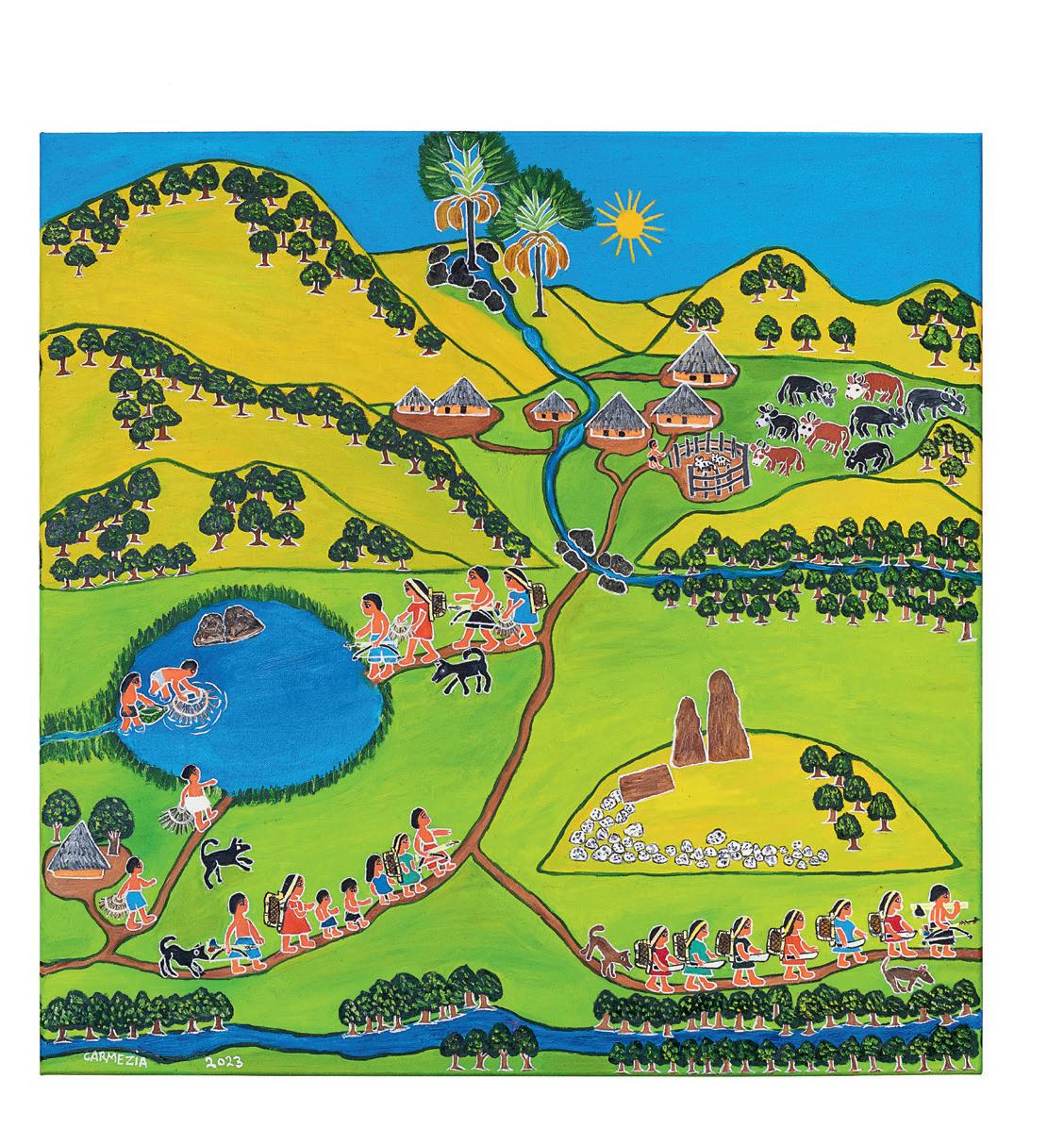
85 84
Lenda do casal americano, 2023
The American Couple Legend. Oil on canvas, 70 × 70 cm
do Sol Indigenous land. In the late 1980s, she moved to Boa Vista and began her painting practice. Her inspiration always comes from the memory of life in the community, continuously reinforcing her ties with her ancestry. The affirmation of her culture through her canvases is also a form of elaboration of the real and the imagined, in which she develops a poetics of everyday life. Indigenous women are the
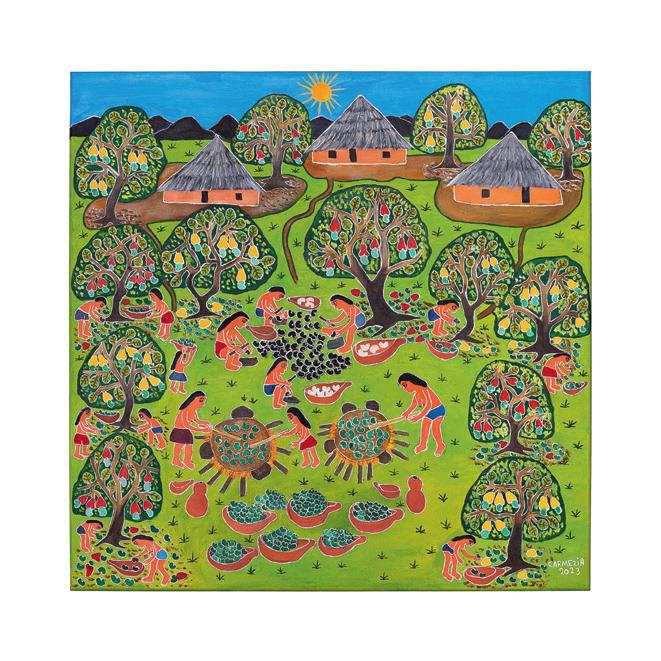

protagonists in most of Carmézia’s work, which ultimately displays their role and performance in all areas of Macuxi life, whether weaving, preparing beiju, harvesting, producing pottery, bathing in the river, or caring for children. Through her work, the artist thus presents both a commitment to indigenous struggle as well as highlighting the gender issue, stressing aspects that could go unnoticed in public debate.
When Carmézia paints scenes that evoke the cosmology of her people, she opens up space for the complexification of everyday life that she seeks to show. Good examples are the legend about Monte Roraima (which is said to have come from Wazaká, the Tree of Life) and the legend of Caracaranã, which takes us to the realm of the fantastic. The opening to imagination that the artist’s work provokes is a powerful political manifestation transmitted with subtlety, involving not only the Macuxi, but all native peoples.
pérola mathias
translated from Portuguese by philip somervell
Assando castanha de caju, 2023 Baking Cashew Nut. Oil on canvas, 70 × 70 cm
Buritizeiro no lavrado, 2023 Buriti Tree at the Cultivated Ground. Oil on canvas, 70 × 70 cm
What good is the insistence on pursuing the bankruptcy of blackness? What guarantee of belonging to humanity can be put to waste?
Castiel Vitorino Brasileiro’s work confronts the most well-established of modern-colonial fictions, race, tensing it as a tool that hierarchizes life on Earth.

Questions about the condition of de/humanity of racialized life, in general, are elaborated according
to the repertoire of what the artist defines as modernity’s mythology about race. Studying the implications of the racial mechanism, Brasileiro transmutes the meanings of the presence of dark corporeities based on the Bantu repertoire and on religiosities of African origin.
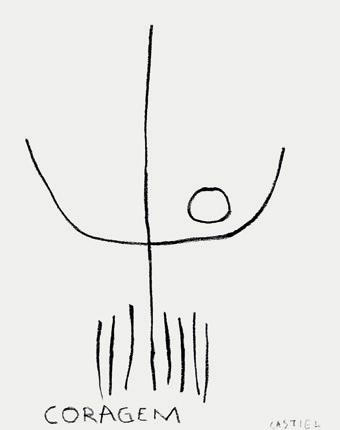
I thus highlight the torsion of the concept of freedom that, released from the modern-colonial conception of self-determination,
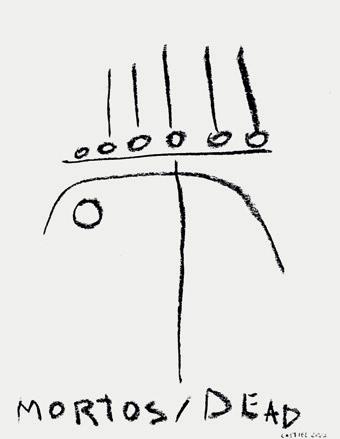
87 86
castiel vitorino brasileiro
A linguagem dos seres híbridos, 2023 The language of hybrid beings. Charcoal on paper
Untitled (Marrakesh), 2023 Digital photography
is experienced in the condition of impermanence. In the book Quando o Sol não mais aqui brilhar: a falência da negritude [When the Sun No Longer Shines Here: The Bankruptcy of Blackness] (2023), as well as in Montando a história da vida – Museu fictício dos objetos roubados pela polícia [Assembling the Story of Life – Fictitious Museum of Objects Stolen by the Police] (2023), freedom also
emerges as a radical practice of interspecific intimacy, grounded in the indistinction of what we consider biotic and abiotic.
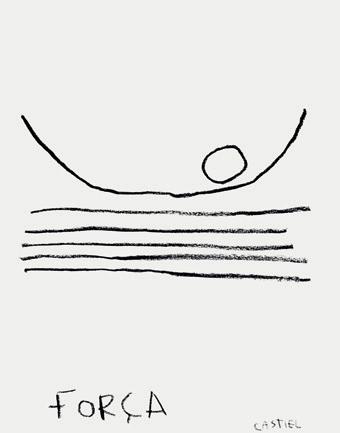
The ethical interventions demanded by Black and Indigenous arts are activated by the summoning of the memory and soul of the elements that compose the installation space. There is also an architectural thrust, present in Quarto de cura [Healing Room] (2018-22),
questioning the forms of inhabiting the planet.
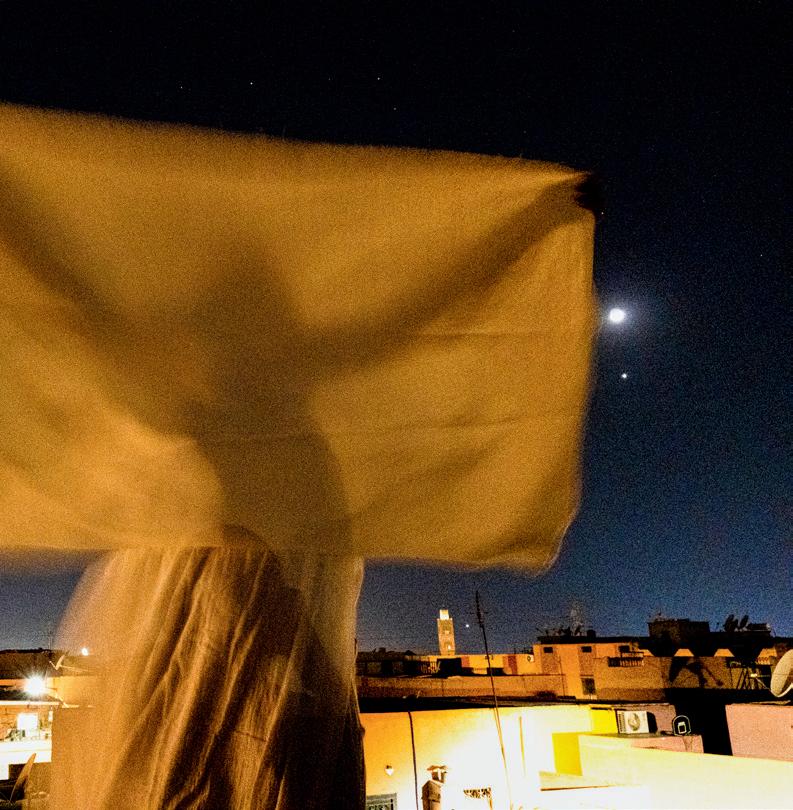
The ruined museum makes apparent the connection between biology and art history, and in the name of the work Castiel reminds us that the police is the one executing the scene in which the psychophysiological differences attributed to dark bodies justify the modern narrative of racial superiority. The murders of these bodies are performed as confirmation that there are types of people – a lie sustained by the privilege of the anthropological gaze that grounds the iconography of the arts and fuels the imaginary about the other-of-human, dictating who can and should be annihilated. As such, the work announces the end of the racial mechanism as a possibility of living infinitely.
translated from Portuguese by philip somervell
cíntia guedes

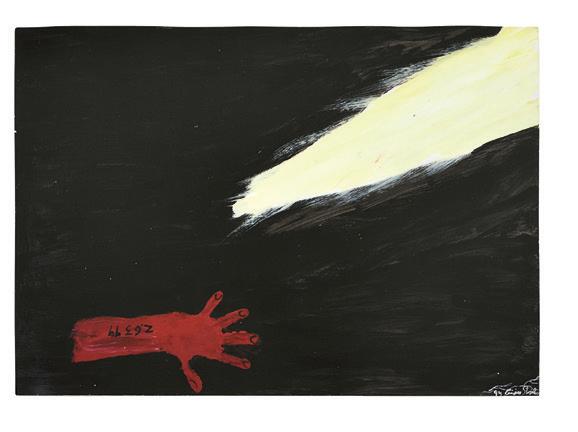
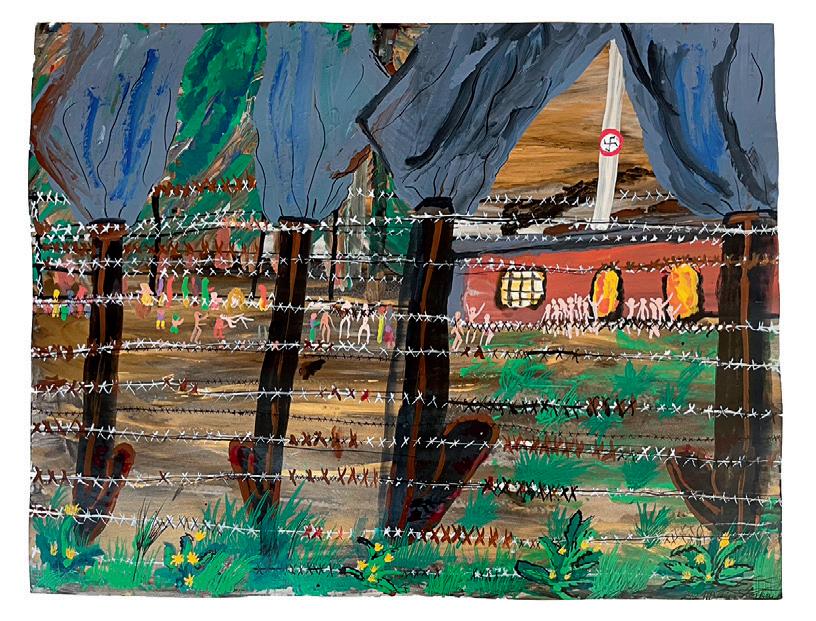
89 88 ceija stojka
Untitled, 1995 Acrylic on cardboard, 69 × 99 cm
Z6399, 1994 Acrylic on cardboard, 81 × 110,5 cm
Untitled, 1993 Acrylic on cardboard, 50 × 65 cm
It was only forty years after her deportation that Ceija Stojka (1933-2013) was able to resurrect from her hands the tragedy of her plunge, at age eleven, into the hell of genocide. Exhumed from the limbo of her memory, Nazi persecution and genocide were the raw material of her work, composed of drawings, paintings, and writings that are impressive for their intensity and extraordinary poetics.
Paradoxically, as part of the Roma people,1 Stojka is heir of an oral tradition. A real memorial and cultural handicap when it comes to accounting for the “forgotten genocide” her people were victims of. Her choice to “enter” painting, drawing, and writing was an act of radical rupture with her tradition. Connected, the three intersect and intertwine, without merging completely.
Many of her drawings and paintings are marked by words, signs, and brief phrases. A graphic melopeia unfolds in a work whose polychromy imparts a tragic intensity to the landscapes of disaster. Her works associate hallucinations, visual anticipations, and the signs of these territories of death and their protagonists. In her landscapes, the gazes of the pursuers and the killers flicker like prefigurations of the unnameable. Her drawings conjugate the sharp outlines of anonymous martyrs with the ghosts of those absent, already dissolved in death.
Her work oscillates from the lost paradise of life before the time of the hunt, to the moment when the cart gives way to the wagon of the “train of catastrophe”, and ends in this archipelago where “not even the dead will be safe”.2 She configures the tragic trajectory of these bodies stripped of their humanity and thrown into the hell of genocide. There is something of Dante’s Inferno. A great beauty transcends its “no savoir-faire” in quality.
philippe cyroulnik
translated from Portuguese by philip somervell
1/ Ceija Stojka belonged to a Lovara Roma family, a traditionally nomadic ethnic group currently living in different regions of Europe and speaking variations of the Romani language. [e.n.]
2/ Walter Benjamin, “On the concept of history –Thesis V” (1940).
Untitled, 1993
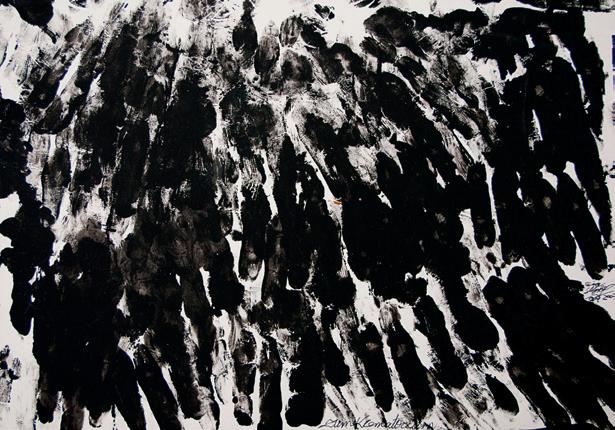
Ink on paper, 29 × 41 cm
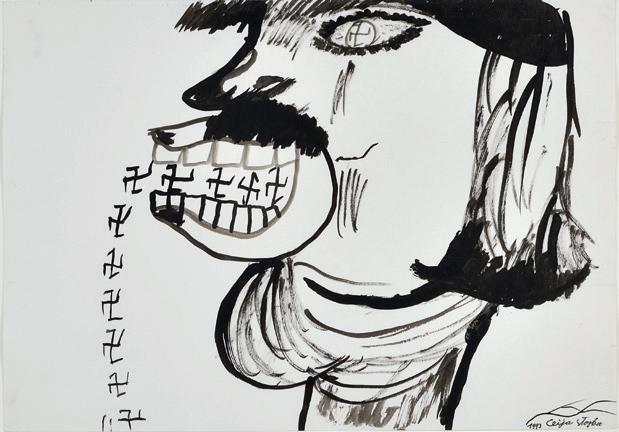
Zum
Krematorium, 2003
To the crematorium. Ink on paper, 30 × 42 cm
this participation is supported by: Phileas –The Austrian Office for Contemporary Art and Federal Ministry Republic of Austria –Arts, Culture, Civil Service and Sport.
Balinese artist Citra Sasmita uses the Kamasan style – a centuries-old type of painting – to produce art that acknowledges the beauty of traditions, but also critiques patriarchy and colonialism in her country’s culture. The traditional style was used by the older Indonesian peoples – in the 15th to 18th centuries – to represent calendars, and especially the supposedly heroic deeds of the traditional male elites,

91 90
citra sasmita
The Age of Fire, 2020 Acrylic on Kamasan canvas, 70 × 90 cm.
such as in wars and other acts of bravery. But in Sasmita’s artistic version, this iconography takes on a new meaning.
Through her hands and her artistic and political eye, Kamasan painting, also done on leather or fabric, features new characters as protagonists in her work. In her project Timur Merah [Red East], Indonesian women with long black hair braid their existence with
each other and with elements of nature. The red of blood and fire pours from their heads and their wombs; entire bodies are in flames or form an enclosure that covers them entirely.
With bodies that catch fire and are mutilated in suffering, Sasmita expresses the pain and oppression suffered under the patriarchy by these women, even though they are at the center of everything. Heads
cut themselves and are cut off. Yet, curiously, these women produce life, for from their wombs sprout trees, just as they also sprout from the heads of these figures. The branches, opening into green leaves, grow toward the sky.
These goddess women who constitute mythological female figures generally do not appear alone. Creating, procreating nature or in suffering, they bring pain and pleasure to each other; they are together, in one body, or undergo their experiences alongside each other. Several female heads populate the existence of one woman, demonstrating that they are part of a circular, collective experience.
Incomplete bodies and legs encapsulate the desire to escape. Rivers formed of women compose a riverside circle on their banks, reminding us of the mythology of traditional society, remembered through the artist’s feminist point of view. Women are goddesses of water and fire.
In Timur Merah, with the protagonism of mythological women, muses, goddesses, creatures part-human, part-beast, parttree, Sasmita finds possible forms through which impossible perspectives finally come to life. If this was not possible in traditional Kamasan art, centuries later the artist retells the story through art.
luciana brito
translated from Portuguese by philip somervell
Residency at the Australian Print Workshop, Melbourne (2019)

Whitenography I, 2018
After the image published in: Louis Dubroca, Vida de J. J. Dessalines, gefe de los negros de Santo Domingo. Mexico: M. de Zúñiga y Ontiveros, 1806. Printed image on cardboard and wood
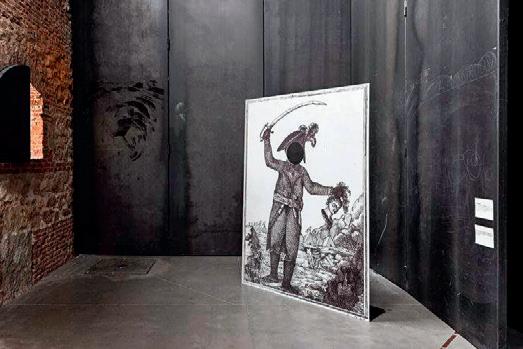
93 92 colectivo ayllu
Colectivo Ayllu, whose practice engages in collective modes of creation and criticism, and in the production of alternative epistemes to colonial modes of thought, proposes a collaborative investigation around love. At the 35th Bienal, on panels collectively created and manufactured by artists who are members of the collective – composed of Alex Aguirre Sanchez, Leticia/Kimy Rojas Miranda,
Francisco Godoy Vega, Lucrecia Masson Córdoba and Iki Yos Piña Narváez Funes – and collaborators selected by an open call, they write letters to past or future ancestors. To do this, they use various materials and fabrics brought in by the participants, in a form of writing that provides the transmission of a knowledge/feeling that occurs between the physical and the metaphysical. Beyond the political,
anthropocentric, and individualizing debates about love, they weave a portal of escape from everyday life, saturated by the capitalistic codification of relationships and the brutality of civilizing choreopolitics.
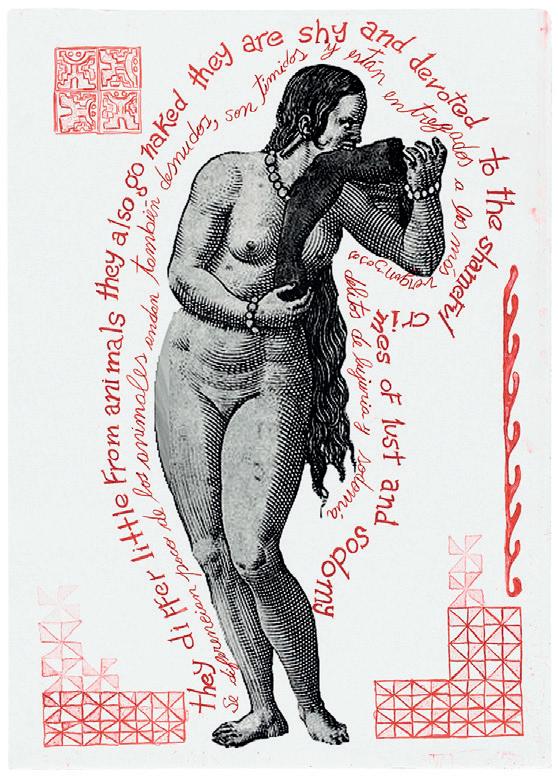
If the colonial wound that permeates and constitutes current geopolitical systems is widened and deepened through interpersonal relationships, turning intimacy into more of an access to violence than a tool for community strengthening, it is collective practice that makes the exercise of a non-conciliatory love possible. Unlike the aesthetic function that generates subjects who appreciate objects, unimplicit in their transparency, in this work it is the doing itself that constitutes the mode of operation of what is presented as a work and the kind of thinking that is made possible through this work. Thus, artists and collaborators evoke modes of existence that precede the subjectified (and racialized, and gendered) body, aiming at the resumption of a sensibility that does not distinguish body and surroundings, a way of being and feeling that is, at the same time, before and after the invention/theft of the body by colonial technologies.
miro spinelli
translated from Portuguese by philip
somervell
The Cannibal, 2019 Lithograph on paper, 101 × 68 cm
this participation is supported by: Acción Cultural Española (AC/E) and Embajada de España en Brasil.

95 94 cozinha ocupação 9 de julho – mstc
Born from the dynamic of a building occupied by almost five hundred people of the Movimento dos Sem Teto do Centro (MSTC) [Homeless Movement of the (City) Center], the Cozinha Ocupação 9 de Julho [Kitchen of the 9 de Julho Occupation] has been operating since 2017 through a wide multidisciplinary network, with redistribution policies, zero waste, and a deep concern for food security. It is a

space that goes beyond the preparation and consumption of meals. It represents the strength of solidarity and the power of collective work around issues such as the right to the full use of urban space. With regularly held lunches that are open to the public, the Kitchen has brought greater visibility to the struggle for housing in São Paulo. It promotes forms of social use of spaces relegated to real estate speculation and also acts as protection against eviction. The strategy of opening the movement reinforces the work of the Occupation and allows the social technology developed to be applied in other communities, other peripheries.
“Occupying is caring,” a phrase that is present in all the spaces of the Kitchen, is both a guideline for the MSTC’s relationships and the preparation of meals. Empathy and affection are the engines that drive the work.
The Kitchen works in partnership not only with other housing movements and social organizations, but also with the artistic class, becoming an important cultural center and an active meeting place for activists, intellectuals, artists, and political leaders. This new angle strengthens the MSTC’s connections with the city and provides a direct response to attacks by the media and established powers keen on criminalizing social struggle.
This way of choreographing survival strategies in a megalopolis like São Paulo is especially important for the 35th Bienal, which is inspired by the Kitchen and its always collective, horizontal form of organization, dreaming the impossible, creating bridges within the framework of im/possibilities.

sylvia monasterios
translated from Portuguese by philip somervell
Cozinha Ocupação 9 de Julho – MSTC
communal politics / communal institutions
In this text, I propose to think about Indigenous communal politics, considering the complex political amalgam that is produced by communal institutions, such as Indigenous mayors’ offices, water committees, improvement committees, brotherhoods, coordination bodies, victims’ committees, and organized women’s networks, among others.
These communal institutions are linked and distinguished from each other as autonomous segments that constitute a whole and that, at different levels, have been antagonistically related to the state government. This takes place in such a way that the Indigenous community is a historical project of government that today is recreated in the daily life of our peoples.
In their daily operations, these communal institutions produce social energy that prevents the totalization of the State and the capital as the only paradigms of social organization. The state response to this attempt at totalization will have two facets: Overt violence, that is state policy organized for the repression and extermination of Indigenous peoples. The second facet is the creation of a prebendal system, which would consist of population administration techniques by providing benefits that cause the fragmentation of Indigenous communities.
These complex social processes of linking and distinguishing the institutions of communal politics, in antagonism with state bodies at different levels, enable me to present a preliminary definition of Indigenous resistance.
For centuries, Indigenous resistance has created a communal system of political architecture that defends, recovers and governs their communal lands and common goods.1 By Indigenous community, we are to understand a political system that produces institutions and strategies of care and renewal in their forms of communal government in their territories and in the city; that sets a timeframe for replacing the political leadership of their government
structures; that produces deliberative practices in assemblies to decide matters of the common good. The backbone of this political system would be the extensive days of communal work to take care of the water, forest, festivities, mourning, and to lead, because leadership is also communal work. Having these elements, we can understand Indigenous communal politics.
community in territories and migration
Leadership change, deliberative assembly and community work are a fundamental part of the Indigenous community architecture. These institutions have managed to re-establish themselves beyond their territories, and especially outside the country, particularly in the United States, where hundreds of Indigenous communities have been displaced.
The reasons for Indigenous displacement can be understood in several historical layers. The first is the displacement of Indigenous communities who had to leave their territories because of the war. After the signing of the Peace Accords, new forms of dispossession and repression by the state were introduced. Most of the communities have been evicted because of land grabbing for monocultures, mining and hydroelectric plants. This structural condition of Guatemala, a country with an extractive economy, explains the high numbers of Indigenous people living in the United States today.
Therefore, nowadays, when we say Indigenous community, we are not only referring to the communities in the territories, but also to the hundreds of Indigenous peoples that have established themselves in the United States.
In the territories, it can no longer be said that the Kaqchikel live only in Sololá, in Guatemala. Today we know that there are Kaqchikel communities in Texas and Los Angeles, in the United States. Just like the K’iche’s of San Francisco El Alto and Totonicapán in Los Angeles, New York, Texas, and Boston. Or the Ixiles in Miami, Washington, D.C., or New York, and this same dynamic is found in Mayan, Garifuna and Xinka peoples, and extends throughout Mesoamerica.
97 96
1/ Gladys Tzul Tzul, Gobierno comunal indígenas y estado guatemalteco: Claves para comprender su tensa relación. Ciudad de Guatemala: Ediciones Bizarras, 2018.
indigenous community, a historic government project gladys tzul tzul — instituto amaq’
They are Indigenous people who work as a workforce in construction, gardening, food, care, sewing, among other services. Not only are they a workforce, but they developed a political infrastructure to give communal form to their lives. They are circuits of connection with their communities of origin. Virtual communication technology enables the flow of information between family networks. The workings of these dynamics have been documented by Mixtec journalist Kau Sirenio.2
The migrants have restarted and created their own communal political system in the United States, and it is through this that they organize the repatriation of the bodies of compatriots who have died in this country and who will be buried in their towns of origin, as well as organizing and collaborating in community festivities. However, they also create organizational networks to support their communities affected by hydroelectric and mining projects.
Institutions such as the Zoogochense Social Union, the Franciscan Emergency Committee and the Chuj Support Act3 are just three of the hundreds of community institutions that populate cities in the United States. These communities function with leaders in charge of organizing and managing bereavements and festivals, under guidelines of communal work situated to their living conditions. These communities are made up of networks of extended families, and under an ethic of obligatory work and support, they have managed to weave communal life in multiple ways.
Some institutions have been in existence for more than 50 years, such as the Zoogochense Social Union, made up of Zapotecs from the northern highlands, originally
from the town of San Bartolomé Zoogocho,4 in Mexico. This shows us multiple spheres of communal existence, created in North American cities.
The existence of Indigenous communities in the United States and their multiple forms of connection with their communities of origin broaden our notions of Indigenous politics and resistance. The capacity to govern, to recover and to defend the communities in Guatemala takes place in everyday life. In such a way that migrant labour and effort support the processes of communal reproduction; in fact, some trajectories of social development, of health and education improvement have been possible thanks to the remittance from community members who have migrated.
communal politics in the archipelago
According to Nina Pacari,5 Indigenous communities have been developed as a counter-power to the Latin American state. However, this counter-power is not a dispersed and formless force. They are communal political institutions, which, insofar as they oppose the state, have the capacity to deform it and shape it to Indigenous societies.
To analyze these antagonistic forms, we should keep in mind the moments of social breakdown that over the centuries have prevented the totalization of the Guatemalan state and of the capital in Indigenous territories. That is, the communal capacity for governance that Indigenous structures have had in managing the reconstruction of life after the open moments of war and violence.
In order to understand the community/state antagonism, it is necessary to analyze at least two ways in which these two systems oppose each other, which are: the pre-
2/ Kau Sirenio, Jornaleros migrantes: explotación transnacional. Mexico City: SUDEMIR; UNAM, 2021.
3/ The Zoogochense Social Union is a Zapotec organization from the northern highlands of Oaxaca, Mexico. The Franciscan Emergency Committee is one of multiple Mayan Q’iche’s institutions in San Francisco El Alto, Totonicapán, and the Chuj Support Act is made up of Chuj communities in San Mateo Ixtatán, Huehuetenango, Guatemala.
4/ In my recent research, I have documented the existence of these multiple institutions of communal politics in both California and New York. See more in Tzul Tzul. G. (2022). Indigenous communal politics in Los Angeles [Política comunal indígena en Los Ángeles]. Unpublished.
5/ Nina Pacari, “Reflexiones sobre el proyecto político de la CONAIE: logros y vigencia,” in Así encendimos la mecha! Treinta años del levantamiento indígena en Ecuador: una historia permanente, ed. Simbaña, F and Rodriguez, A. Quito: Abya Yala Editorial, 2018.
bend and the violence as the state’s tutelary relationship with the communities.
Prebends have had the effect of disciplining collective subjectivity, although never fully, but they have temporarily divided and fragmented it. One effect of a prebendal policy is clientelism, which modifies and refunctionalizes community systems. On the other hand, open violence: genocide, as a planned mechanism for the extermination of peoples, has had the effect of displacing them from their territories, persecuting their organizational structures, burning crops and killing domestic animals. However, the communities have rebuilt and restarted their communal world.
Faced with these forms of antagonism, the communities and their political systems have developed a profound degree of social fluidity to update themselves in the face of threats or transformations that are necessary for the preservation of life and have been able to deform the State.6
The antagonistic conditions mentioned above have in many ways been responded to in rebellions, and uprisings that linger in the memory of everyday life. About what was previously mentioned, I present three distinctions in order to understand the forms in which the structures of communal politics appear: a) Indigenous communal government that controls and defends its lands, for example, the 48 cantons of Totonicapán, the Indigenous municipality of Solalá, and others; b) Indigenous communal governments that are reconstituted at the same time as they recover land, for example, the Indigenous Mayor’s Office of Nebaj, Guatemala, and several Q’eqchi’ communities; c) Indigenous communal governments that are reestablishing themselves in the city, such as the innumerable Indigenous communities with their forms of organization in cities in the United States.
In light of the above classification, I propose the metaphor of the archipelago7, in order to think about the
6/ Gladys Tzul Tzul, Una forma ética de existencia. Montevideo: Minerva Ediciones, 2017.
7/ The idea of archipelago to think about the struggles in Indigenous communal politics for their communal lands dialogues with and is nourished by Raquel Gutiérrez Aguilar, who uses this notion to analyze the power and strength of the struggles that women are developing in contemporary times.
presence of communal government structures throughout Guatemala and also in the United States. Thinking about the existence of communities and their discontinuous political system enables an understanding of why they have historically had the capacity to prevent the totalization of the State. The notion of archipelago assumes the existence of communal territories limited by private and state territories. On the one hand, communal territories in their discontinuous existence in the republic establish levels of social order that can place the totality of the State and capital in crisis at different levels. That is, societies organized in a communal framework that seek to collectively manage life; they share and produce water sources, take care of forests, repair roads, zealously guard their landmarks. In other words, they do not live as the sum of small individual landowners. On the other hand, it is in the archipelago where the reactivation of Indigenous communal politics in the city happens, with its variants and different expressions that are taking on their communal structures for the support and management of festivities and mourning, the support of their families and the struggles in which their communities are involved. While archipelago is the geographical way of thinking about the singularity of communal existence in the territory, the notion of networks of assemblies allows us to think about spaces for deliberation and discussion, which gradually become interlinked. These networks of communal assemblies have had the safeguarding of communal lands at the centre of their interests, and from there, extensive communication networks flow between them.
Thus, communication, agreement and articulation of the communal governments are based on the logic of self-regulation, for example, the principle “no authority rules over another authority”, which means that no community rules over another community, thus showing the calidad autonómica situada [locally situated quality] of the processes of articulation and joint work.
Understanding communal politics and resistance in the light of the archipelago/networks of assemblies shows the vitality and strength of communal struggles that have at their core to control communal lands, while at the same time governing themselves according to their historical
99 98
process. In any case, they also show the architecture of the struggle, the densities, the ways of articulation. The process of resistance, then, is constituted from a communal political system.
According to Rivera Cusicanqui,8 thinking about resistance places us in multiple and unresolved layers of the undigested past, which emerge as accumulated fury, but also as baroque and subversive bricolage. My reading suggests that to understand the existence of these political systems, rather than thinking only that the state wants to suppress these political instances, one should think that the state in its local expressions has been deformed by the strength and insurgent capacity of communities. The archipelago figure of communal resistance would thus illuminate the functioning of communal politics.
final remarks
Communal work, political deliberation and the rotation of positions constitute the basis from which long-term political projects are produced, those that Indigenous peoples embody and live on a daily basis. However, it is an everyday life that is constituted in singularity, which is why the metaphor of the communal archipelago is central to understanding the continuity and discontinuity of their existence, but it also makes it possible to show the strength of their existence, as well as the unequal rhythms in which they exist.
Under the influence of the archipelago communities, a rich iconographic and image universe for symbolic realization has been produced. By this, I mean a part of the great communal production of aesthetics, enjoyment and pleasure in Indigenous societies, such as the festivals of the patron saints of the communities where economic processes and enjoyment are activated. It is not yet possible to calculate the number of huipiles [hand-woven clothes worn by Mayan women], fabrics and sashes that are bought and sold for the celebrations of the festivities. It can also be added the unclassifiable variety of foods in the festivi-
8/ Silvia Rivera Cusicanqui, Un mundo Ch’ixi es posible: Ensayos desde un presente en crisis. Buenos Aires: Tinta Limón, 2018.
ties, as well as the ordinary of the everyday, to those arts of making collective life.
In the same way, for more than two decades, commercialization circuits of fabrics, huipiles and other garments have been introduced in the United States. These expressions of communal culture that are reactivated in a scattered time and geography, and in different celebratory events, would be one of the many ways of communal expression of aesthetics.
If communal politics also produces this symbolic universe, which produces iconography, images, tastes and sounds that are created collectively, and if the communal is a historical project of government, then communal politics also governs with images.
Totonicapán, 1 July 2023.
references
Comunidades Indígenas en Liderazgo. Racismo y desplazamiento: Situación de la criminalización y violencia lingüística en Estados Unidos contra migrantes indígenas, ed. Tzul Tzul, G Partial report presented at a public hearing at the 186th Period of Hearings of the Inter-American Court of Human Rights. Los Angeles: 2023.
PACARI, Nina. “Reflexiones sobre el proyecto político de la CONAIE: logros y vigencia.” In: Así encendimos la mecha! Treinta años del levantamiento indígena en Ecuador: una historia permanente, ed. Simbaña, F and Rodriguez, A. Quito: Abya Yala Editorial, 2018.
RIVERA CUSICANQUI, Silvia. Sociología de la Imagen. Miradas Ch’xi’ desde la historia andina. Buenos Aires: Tinta Limón Ediciones, 2015.
_________. Un mundo Ch’ixi es posible. Ensayos desde un presente en crisis. Buenos Aires: Tinta Limón Ediciones, 2018.
SIRENIO, Kau. Jornaleros migrantes. Explotación transnacional Mexico City: SUDEMIR-UNAM, 2021.
TZUL TZUL, Gladys. Gobierno comunal indígenas y estado guatemalteco. Claves para comprender su tensa relación. Ciudad de Guatemala: Ediciones Bizarras, 2018.
TZUL TZUL, Gladys and RAMÓN, Simón Antonio. “Guatemala más allá de las elecciones”. Ojalá Journal, 10 May 2023.
daniel lie
On a visit to Daniel Lie’s studio in 2017, I sensed a strong aroma permeating the environment. The result of the decomposition of flowers, fruits, and vegetables kept in his studio, the odor was the manifestation of a universe of hidden beings that would give new directions to their artistic practice. The ongoing investigation focused on the effects of time and the action of microorganisms, such as fungi and bacteria, in the

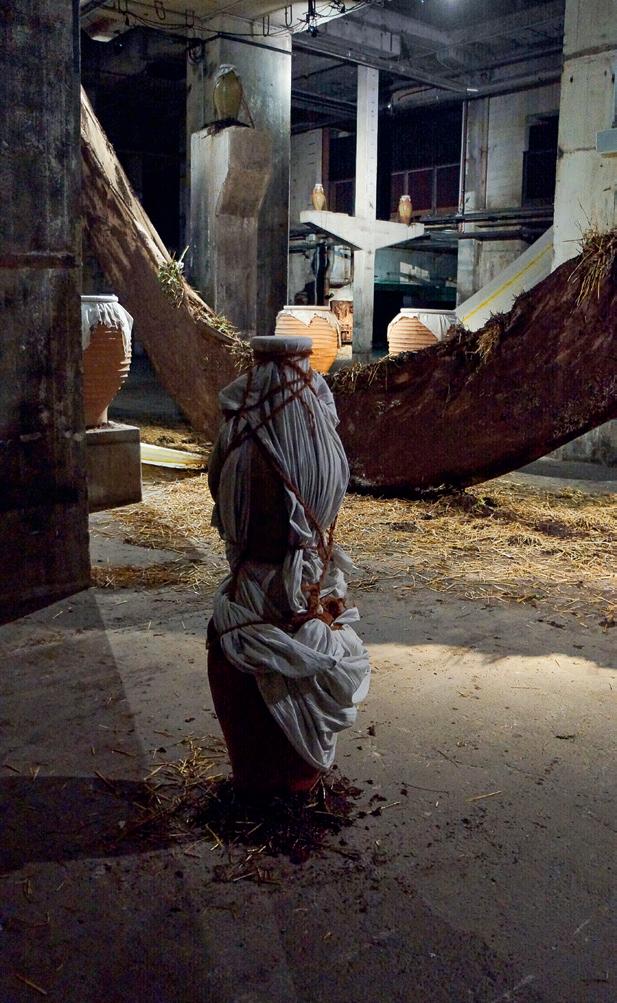
101 100
transmutation of organic matter. Witnessing the changes in the materiality of those elements, and following diverse natural cycles, enabled Lie to reflect on the complexities of interspecific relationships and their role in the generation and maintenance of life.
Lie has broadened their notions of temporality and has endeavored to find forms of collaboration that break the hierarchical notion
that places the human species at the top of the evolutionary scale. Since then, they have been developing “installations-entities”: large sculptures of organic materials, the result of the process of degradation/transformation of the elements that give them form. Although they respond to the context and place in which they are presented, in each of them, Lie resorts to new methods to create harmonious ecosys-
tems, where relationships between fungi, plants, animals, minerals, and other-than-humans can break with a binary reading of life and death.


For the 35th Bienal de São Paulo, Lie presents Outres [Others] (2023) and seeks to create a space where silence, not words, leads to relationships between those present. Outres is the result of the maturation of the techniques and methods of production developed over the last few years of their research. The immersive installation will consist of terracotta vases, columns, and arrangements of yellow and white chrysanthemums, as well as cotton fabrics dyed with turmeric. Added to the composition of the work are the effects of the passage of time on the materials and the eventual generation of new lives derived from the relationships established between the organic agents present in the environment.
thiago de paula souza
translated from Portuguese by philip somervell
Non-Negotiable Condition
, 2021 Installation view, Metabolic Rift, Berlin (2021)
daniel lind-ramos
In one way, Daniel Lind-Ramos’ work is fiercely local. His large assemblage sculptures stage an encounter with his hometown of Loíza, Puerto Rico, the area from which the found items that comprise the work are collected. His neighbors have watched him wander the streets and beaches of the town, collecting and fitting together pieces of their communal lives over decades. Fellow Loízans,

familiar with his always-open studio, bring him items they find interesting, from a nice-looking piece of pipe to kitchenware inherited from a beloved grandmother.
This geographic specificity is not insignificant. The town of Loíza is the celebrated center of AfroPuerto Rican life with the largest black population on the island. Founded in the 16th century by Africans who escaped the then
103 102
Spanish colony’s plantations, the town is the birthplace of the plena and bomba musical styles. It is wellknown for its street food, known locally as frituras, and its annual carnival distinguished by the traditional vejigante masks made from coconut shells. In this way, LindRamos’ practice is a kind of testament to the history and significance of Loíza, a foregrounding of Puerto Rico’s blackness. “To take care of
objects is to take care of memory,” Lind-Ramos tells us. He preserves the memory in these graters, brooms, calabash gourds, and cymbals; memories of joyous creation, of labor, of ancestry. Memories that might otherwise fade away or be erased.

That’s not the whole story though. Lind-Ramos has said of his work, “My intention was to find a language, find a process, find mate-
rials that establish the link between our collective experience…” The collective he speaks of here exceeds his hometown and state. Speaking of Los Angeles based, African American artists working in the 1960s and 1970s, art historian Kellie Jones has argued that “the aesthetic of assemblage” is one of “linkage and connection.”1 She further argues for the form’s history in African art, and its vernacular and quotidian aesthetics, which provide “a rationale for people of color to lay claim to assemblage techniques […], and to the mundane strategies of making beauty that were allowed to people on society’s margins”.2 This could not be more true of Lind-Ramos’ practice and it links his art to a broader field of Afrodiasporic strategy. His sculptures connect across time and space, much like the carnival procession that Con-Junto (The Ensemble) brings to mind. Carnival straddles Puerto Rico, Trinidad and Tobago, Brazil, New Orleans and so many other parts of the African Diaspora, themselves linked by a history of forced migration and violence, but also persistence, creativity and innovation. Both carnival and assemblage, beautifully fused here, are moments of a most exquisite making something from that which might have been condemned as nothing.
nicole smythe-johnson
1/ Kellie Jones, South of Pico: African American Artists in Los Angeles in the 1960s and 1970s Durham: Duke University Press, 2017, p. 69.
2/ Ibid., p. 71.
Con-Junto (The Ensemble), 2015 Assemblage, 289,6 x 304,8 x 121,9 cm
To speak of the output of Davi Pontes and Wallace Ferreira is, first of all, to recognize their encounter which, since 2018, has produced a series of works based on the identification and radical elaboration of their common experiences and research related to dance and the experience of the Black dissident body in the world. Among the works produced, such as Mata leão, morto vivo [Chokehold, Living


105 104
davi pontes and wallace ferreira
Dead] (2020), Delirar o racial [Racial Delirium] (2021), and the trilogy Repertório [Repertoire] (2018 – ongoing), the duo uses mimesis, repetition, and the rhythmic marking of the counterpoint, carried out with performers’ feet, as resources to dilate the perception of timespace. Starting from the question “How can a dance of self-defense be elaborated?”, Pontes and Ferreira experiment with symbolic
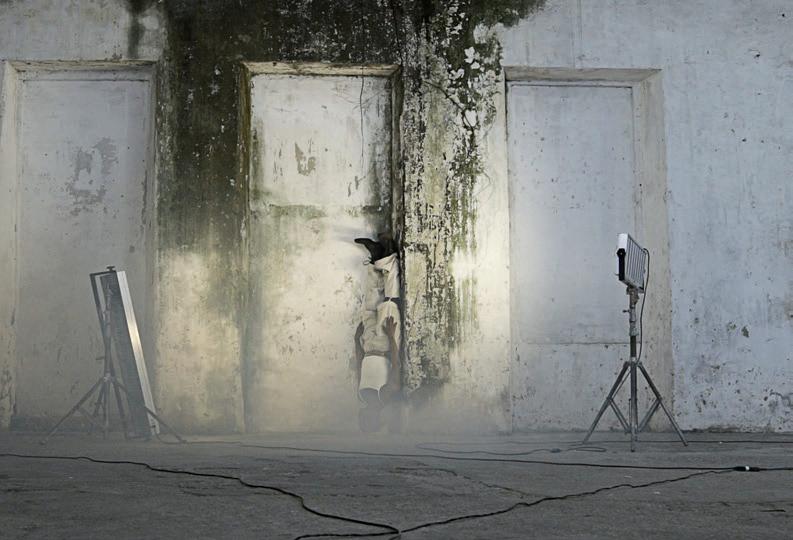
deviations from the violence programmed by the State and by institutions that ensure order through repression. With references to martial arts and capoeira, with the onto-epistemological critique of modern philosophy and the history of dance, they take the act of performative and visual creation as a possibility for activating and resignifying the collective mnemonic archives about these corpo-
realities. If the Black body at rest is suspicious and when in movement a threat, Pontes and Ferreira find within this choreographic act possible strategies to re-elaborate imaginaries, proposing changes in the symbolic meanings of the Black presence in a world that is not yet able to grant these lives existence and dignity. While modern dance has instructed the viewing public to expect impressive and grandiose events, repetition reinforces the expectation of the future and uncertainty breaks with predictability about dance. Upon making contact with the performance in progress, the audience finds itself immersed in the imprecision about beginning and end. It is possible to say that Pontes and Ferreira develop a countercolonial anti-choreography, which, in the practice of Black life can mean the recovery and foundation of strategic ways of moving towards self-defense in everyday life, deviating from racial violence, reworking the perception of self and time-space towards the end of the organization of the current world.
maria luiza meneses
translated from Portuguese by philip somervell
Delirar o racial, 2021 Racial Delirium. Video, color, sound. Video still
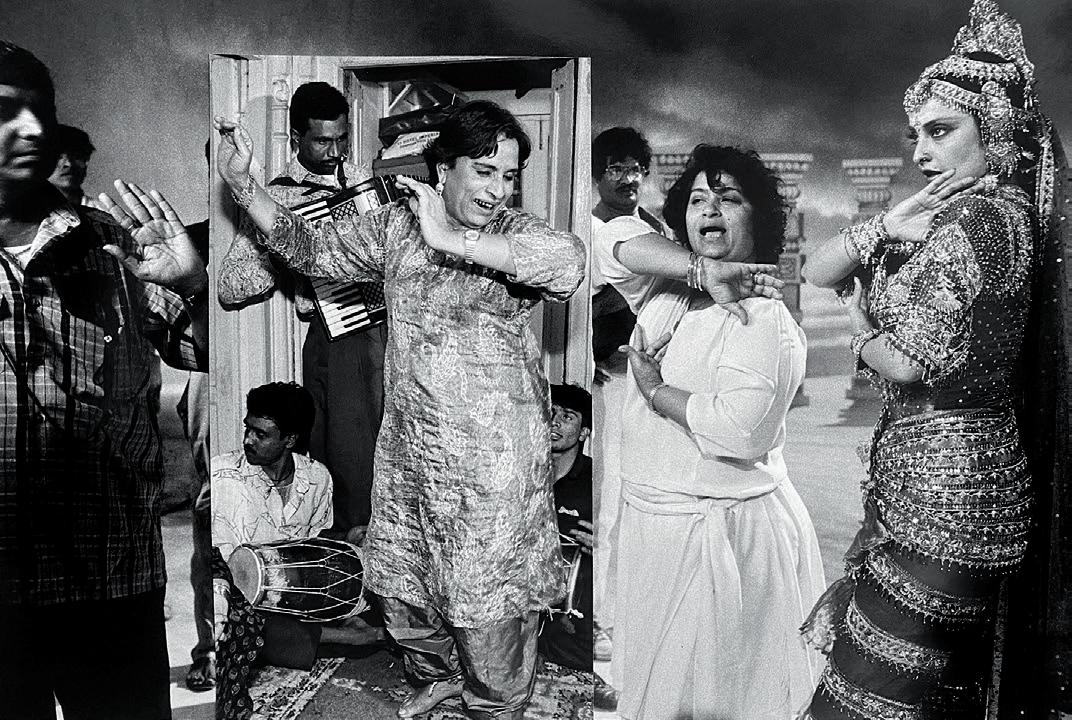
107 106 dayanita singh
Mona Montage, 2021
Gelatin silver and archival pigment print, 41,3 × 61,3 cm
The bringing together of photography and dance, by virtue of an ontological disparity between these media, produces an initial and immediate tension between movement and stillness. As if photography is always chasing the movement of dance, without ever being able to completely capture it.
Dayanita Singh’s practice emerges from and feeds on precisely this tension. Her interest in the mobility
of the photographic object when exhibited, present in the structures/ collections she calls museums, takes on even more complexity and nuance in the works presented at the 35th Bienal. In Museum of Dance (Mother Loves to Dance), not only are the photographic prints mobile in the exhibition space, but the subjects are also in movement, dancing. Among them, Mona Ahmed, Singh’s long-time friend
who also features in the other works on display, is notable for her recurrence.
According to Singh, in the Indian context, Ahmed was identified as a eunuch, or as a hijra. However, at a certain point she distanced herself from the eunuch community and began to question the expectation of femininity that was placed on her. “You really do not understand. I am the third sex, not a man trying to be a woman. It is your society’s problem that you only recognize two sexes.”1 Thus it is of little importance to “describe” Ahmed with identitarian precision, but it does matter to think about the endless movement that exceeds the binary gender system and that we can call transition Beyond a portrayal of transition as an allegory of aesthetic-political movements, as often occurs when produced through a cisnormative lens, the intimacy and the pact of trust established in the collaboration between Singh and Ahmed, by bypassing ethnographic unidirectionality (the “I” seeing/describing/ producing the “other”), allows something formidable to happen: the still image evokes and performs the uncapturable movement of transition.
miro spinelli
translated from Portuguese by philip
somervell
1/ Quote by Mona Ahmed extracted from the text on Dayanita Singh’s website about the book Myself Mona Ahmed. Zurich: Scalo Publishers, 2001. Available at: dayanitasingh.net/myself-mona-ahmed/. Accessed on: May 26, 2023.
deborah anzinger
I have always thought of Deborah Anzinger’s work as essentially about syntax. That is, the structure of language, both verbal and visual. Her work asks us to think about the relationships that produce language; the relationship between subject and object, self and other, masculine and feminine, natural and artificial; binaries that oppose and constitute each other. These concepts, here identified
by their verbal descriptors, are grounded in material in Anzinger’s work, and a rigorous materiality might be considered the second tenet around which her practice is organized.
Anzinger’s paintings refuse to stay on the wall, they will not surrender to painting’s purported two dimensionality. They insist on protruding, reflecting, growing and kinky-curling off the unstretched
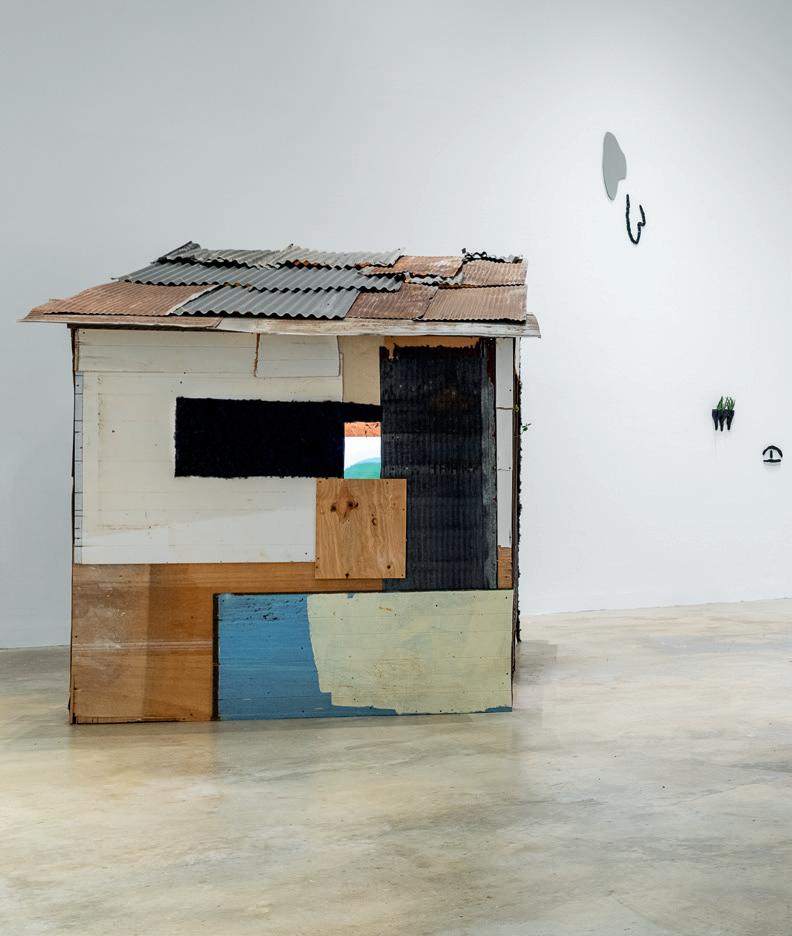
109 108
Deborah Anzinger: An Unlikely Birth Exhibition view, Institute of Contemporary Art, University of Pennsylvania, Philadelphia (2019)
canvases. In them we find handpainted lines and gradients so perfectly rendered they look digital, living plants growing from death-dealing synthetic Styrofoam, and mirrors that turn the viewer into the viewed. In Anzinger’s universe, line drawings and paint strokes become sculpture, irises become tongues. Where there should be a hole we get an unfurling. Anzinger’s work is always
forcing opposites together, destabilizing our binary thinking and taxonomizing, instead demanding the acknowledgement of a slippery, playful, sensual third way.
In this particular body of work, completed between 2016 and 2019, Anzinger’s focus is turned to reproductive labor; its sensuality, its fecundity, but also its violence. The synthetic kinky-curly hair in An Unlikely Birth (2018) is an unmis-
takable reference to Blackness, as well as the black line drawings that disrupt the abstracted landscape, which seems to be in the process of coming to being. As a Black woman, born into and making from the Caribbean, Anzinger is attentive to the ways that Blackness is often excised from, or suppressed into subservience in representations of the region. The painting disrupts the kind of palette we associate with the Caribbean –cheerful sky blues, the signature blue-green of the Caribbean Sea, and verdant greens – with scrawllike drawings of breasts, that ultimate symbol of nourishment and sexuality; and grasping hand-like leaves, reminding us that nature has her own subjectivity, an agency that takes, as hurricanes do every year in this region, as much as it gives. And then, of course, that lump of kinky-curly black hair. Not quite in the painting, it is a sort of excess wherein aloe vera plants, celebrated for their healing qualities, grow against all odds from the hostile polystyrene that chokes waterways and poisons fauna. This, I would argue, is Anzinger’s point, even in the most inhospitable conditions healing things grow, and even in places of awe-inspiring beauty violence lurks.
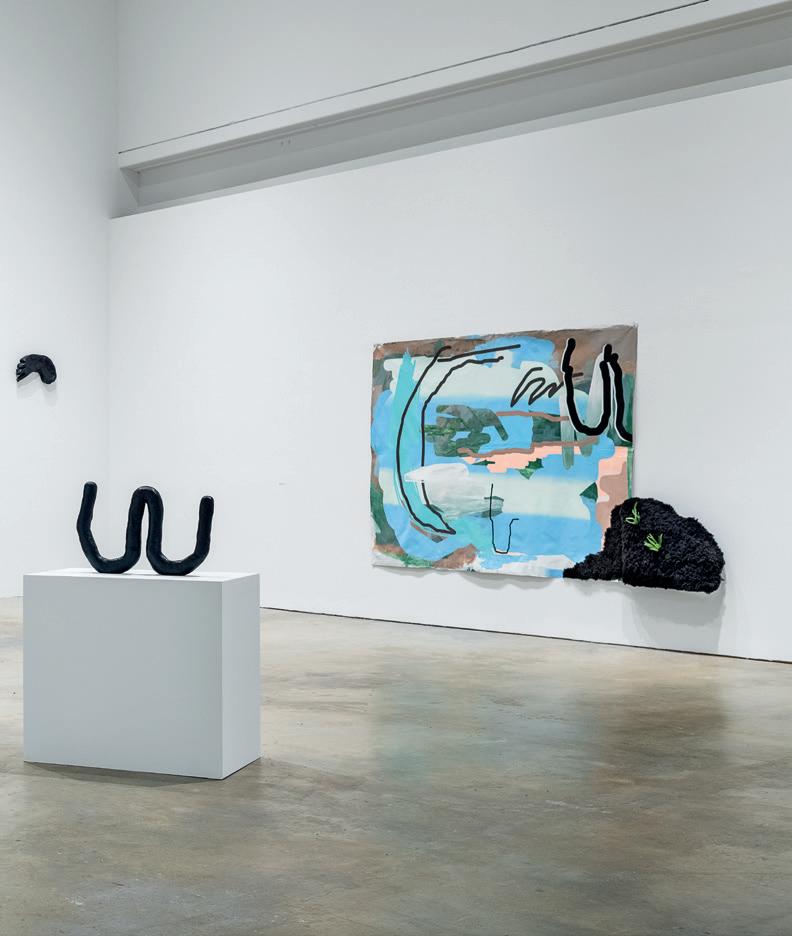 nicole smythe-johnson
nicole smythe-johnson
denilson baniwa

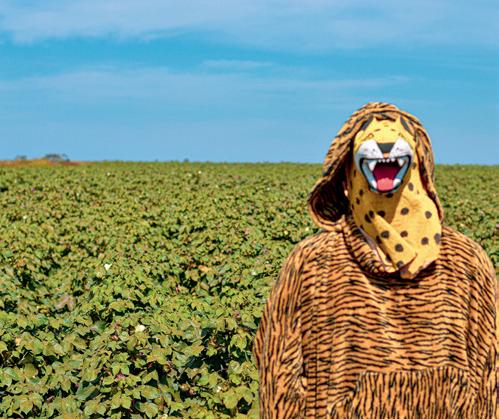
The linear organization of time as conceived by modern Europe, driven by the notions of progress and non-return, is incompatible with the conceptions of time among Amerindian cultures. Determined by the interaction between the body and nature, and organized through empirical observation of the transformations of the environment, the experience of indigenous time is generally based on mythical founda-
tions which are reinscribed in daily life through rites. Among these rites is the transmission of knowledge and the sharing of affections, which in the Western world we call education. It is from an understanding of education as a non-linear, procedural, and collective process that Denilson Baniwa has, in recent years, been investigating ways of introducing indigenous temporalities into non-indigenous artistic institutions.

111 110
One of the most prominent artists of his generation, Denilson Baniwa’s work proposes a reworking of the idea of the archive as a pedagogical tool for reflection and a factory of history. From his early works, which intervene in engravings produced in the context of the colonization of the Americas, to his most recent works, which are installation-based and participatory, Baniwa intrudes upon the archive with the aim
of stressing and weakening the accelerated time of conquest and colonization and bringing forth the time of reflection, waiting, and listening. In more recent works, such as Nada que é dourado permanece, hilo, amáka, terra preta de índio [Nothing that is golden remains, hilo, amáka, Indigenous dark earth] (2021), Ygapó – terra firme [Ygapó – Dry land] (2022) and Escola Panapaná [Panapaná
School] (2023), the artist commits to stimulating relationship and contact, rescuing the image of cultivating the fields and life in the forest as a metric of time and a metaphor for education.


In Kwema/Amanhecer [Kwema/ Dawn], Denilson Baniwa deepens his research on the integration between artwork and community, complexifies the technical procedures that allow the passage from the field of representation to that of experience, and reveals the possibility of harvesting and eating as the realization of the act of sharing and the reworking of memory.
renato menezes
translated from Portuguese by philip somervell

 Colheita maldita, 2022
Cursed Harvest. Digital photography
Colheita maldita, 2022
Cursed Harvest. Digital photography
denise ferreira da silva
A series of pyramids are scattered around the Bienal Pavilion, occasionally taking on new forms. Each is a tetrahedron, a Platonic solid representing fire and composing Denise Ferreira da Silva’s Metaphysics of the Elements − The Studio (2023).
Fire renews the exercise through which the artist aesthetically pursues a question recurrent in her artistic and philosophical work.
In its capacity for radical transformation and in the resignification of fire when combined with other elements, this form-concept represents the inauguration of a here-now for the end of the world as we know it. I see Metaphysics of the Elements – The Studio as a crack that intends to silently engulf the pavilion, the park, and the city… Not in some dramatic, apocalyptic scene but as a space where col-
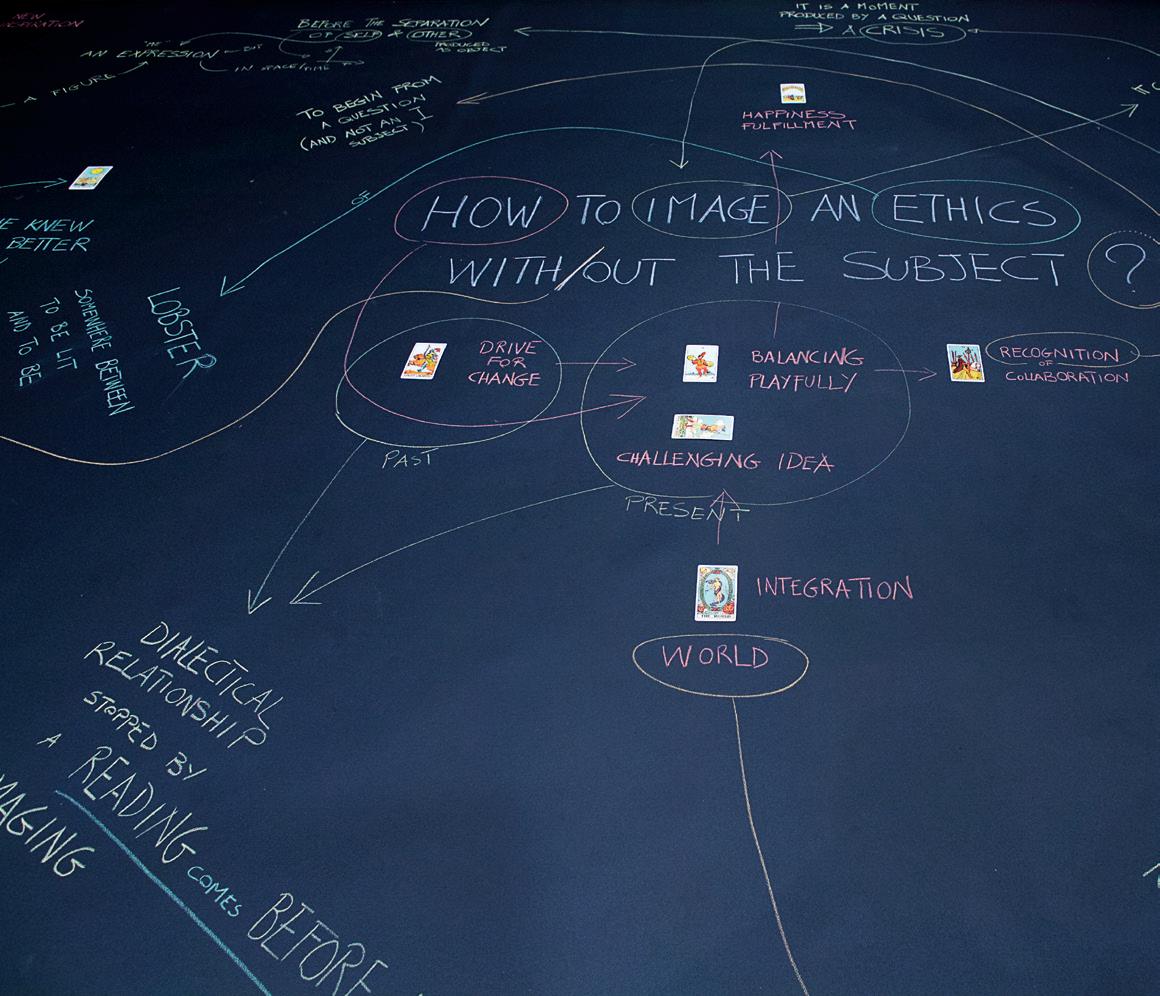
113 112
lectivities and imaginations can emerge, vibrating at ethically similar frequencies.
The end reintroduces a dispute and a need to abandon the tools of modern thought, which works towards an end goal of domination, calling on thought processes that constantly perform the end, because they would never start from the assumption that there is an ontological separation between humankind

and the other presences that inhabit the world.
When the structures of inseparability – the tetrahedrons – come together and transform into tables, benches, and grandstands, the studio acts as a platform for the emergence of meetings of Black, feminist intellectuals, artists, and social movements engaged in dismantling the anti-Black structures in the world, and in ecological
demands for the right to life, land, and territory.
The piece is a continuation of a series of works through which Denise Ferreira da Silva responds to the project of dealing with the world through elemental thinking, encouraging a rapid and necessary shift in decolonization projects that, in the Brazilian context, are still trapped in imagining the correction of institutions, which has failed to keep collapse from continuing to shape this territory.
cíntia guedes
translated from Portuguese by georgia fleury reynolds
view of Poetical Readings/Intuiting the Political, an open conversation with Denise Ferreira da Silva and Valentina Desideri on the 7th episode of Arika, We can’t live without our lives. Tamway. Glasgow, April 18, 2015
“Quero me acabar no sumidô.” [I want to end myself in the drain.]1 This popular saying can be traced back to a verse of a vissungo2 recorded in 1929 in Minas Gerais, and probably chanted throughout the territory where there were exploited Black people. To disappear as an opportunity to embark on a temporality in which the lambá – the disgrace of enslaved labor and its centuries-long enchaine-
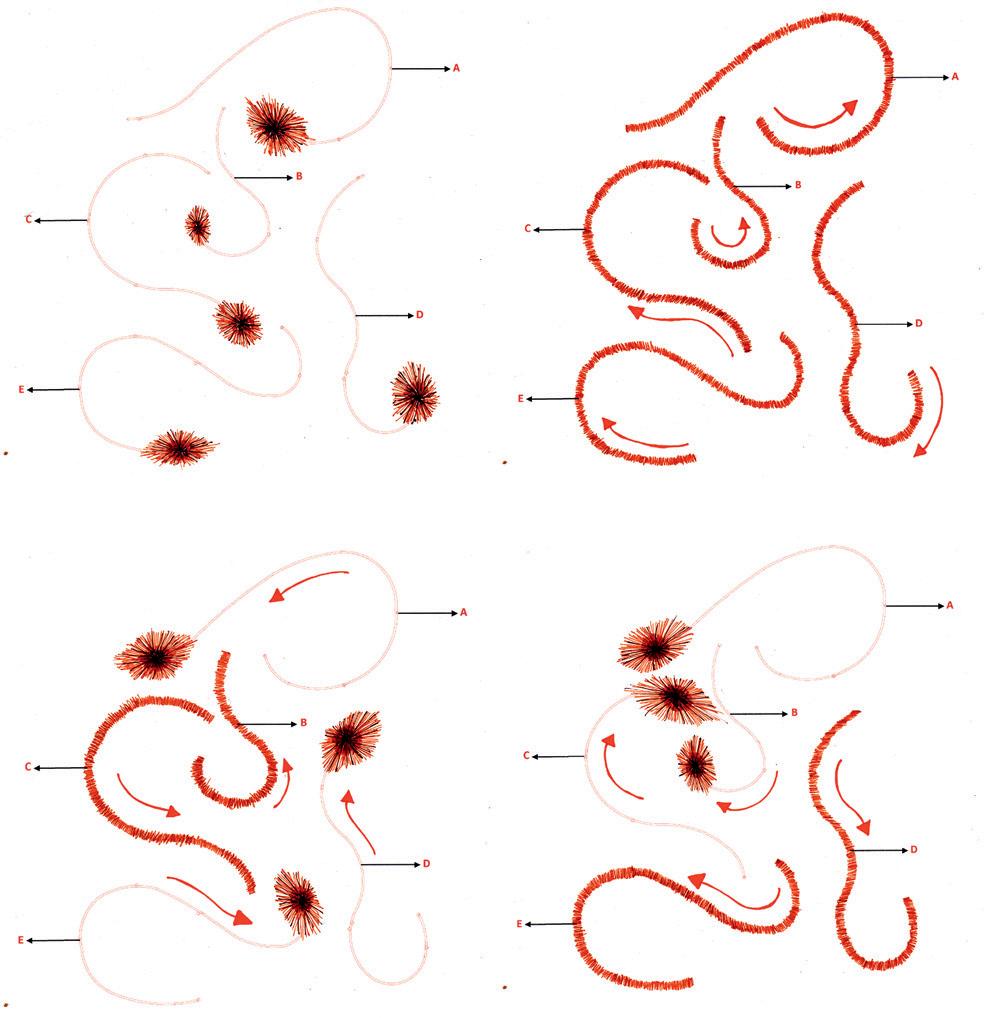
115 114
diego araúja and laís machado
ment – is not the only destiny of Black life. Singing for a productive disappearance relates life and death not as oppositions, but as the possibility of living life otherwise. It is in the wake of this chant that Sumidouro n. 2 – Diáspora fantasma [Ghost Diaspora] refuses to surrender itself to the gaze that reveals everything. Betting on the formal opacity of a monumental architecture, the work connects
to the ethical call of the collaborative work of Lais Machado and Diego Araúja by emerging as a platform and bringing together Afro-Atlantic artists. To be enchanted by Sumidouro n. 2 is the opportunity to be in the presence of works which, opposed to the colonial forces of disappearance, have never ceased to be realized in experimentations and languages of their own.
As in other visual art pieces by Araúja and Machado, this work retains scenic functions, this time in its scale, and in the spectatorial game played with straw, a material of liturgical, architectural, and handicraft purposes. Defined by the artists as an installation-performer, the phantasmagoria that is performed does not appear as a surrealist bid to reveal the unconscious, but rather as the possibility of dancing with all that which has been disappeared.
In movement, Sumidouro n. 2 promotes dis/appearances; what is to come is revealed in fragments, the housed works are offered to an integral and rhythmic, but not totalizing, apprehension. It is possible to just contemplate it, but to be in Sumidouro n. 2, a whole body with the qualities of alarinjo presence is required – which, in Yoruba, means a body that sings and dances while walking, implicated in the desire to re/un/know.3 It is a sinuous platform in which the collective pact, the intentionality of the rite, and the desire to intervene in the dynamics of disappearance stand out.
cíntia guedes
translated from Portuguese by philip somervell
1/ “Ei ê lambá / quero me acabá no sumidô / quero me acabá no sumidô / lamba de vinte dia / ei lambá / quero me acabar no sumidô / Ei ererê.” Vissungo documented in 1929 by the philologist and linguist Aires da Mata Machado Filho (1909-1985), in a study of the Bantu repertoire in Diamantina (MG), was re(en)chanted by the singer and composer Geraldo Filme (1927-1995) in the album O canto dos escravos, by Geraldo, Clementina de Jesus and Tia Doca, Eldorado Studio, 1982.
2/ Chant intoned by black slaves in the diamond fields of Diamantina (MG) with words in Portuguese and African languages. [E.N.]
3/ Alarinjo is also a term used by Lais Machado to define her performing arts practice.
Studies for Sumidouro n. 1, 2022
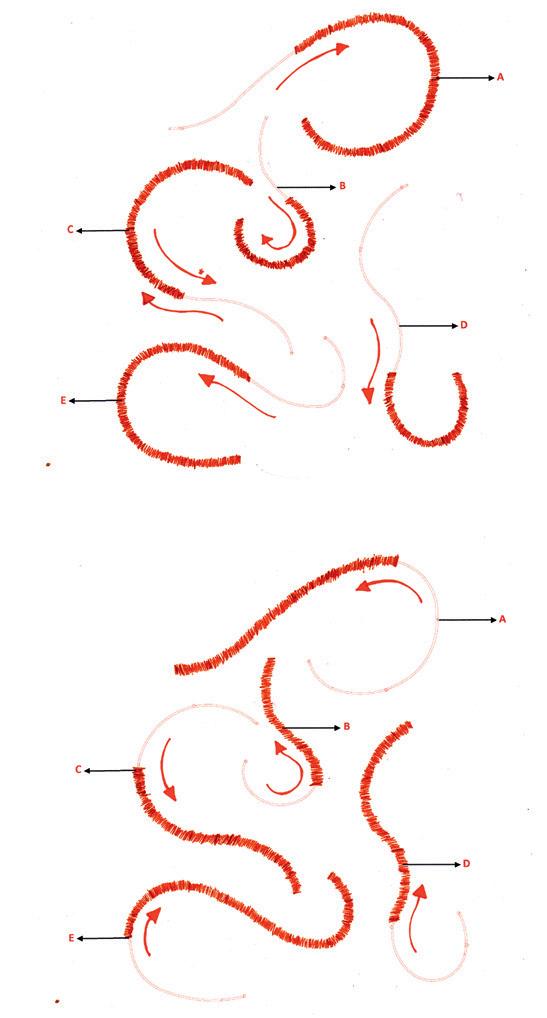 Palha da costa and sisal curtains in aluminum rails controlled by Arduino
Palha da costa and sisal curtains in aluminum rails controlled by Arduino
Duane Linklater’s works play with concepts of landscape. We know that this term carries the weight of a historical genre of painting, in addition to the complex implications present in one of its facets: the representations of dominated spaces produced by artists commissioned by colonizers. In the ever-present relationship between art and society, in these portrayals we can see, before our eyes, the
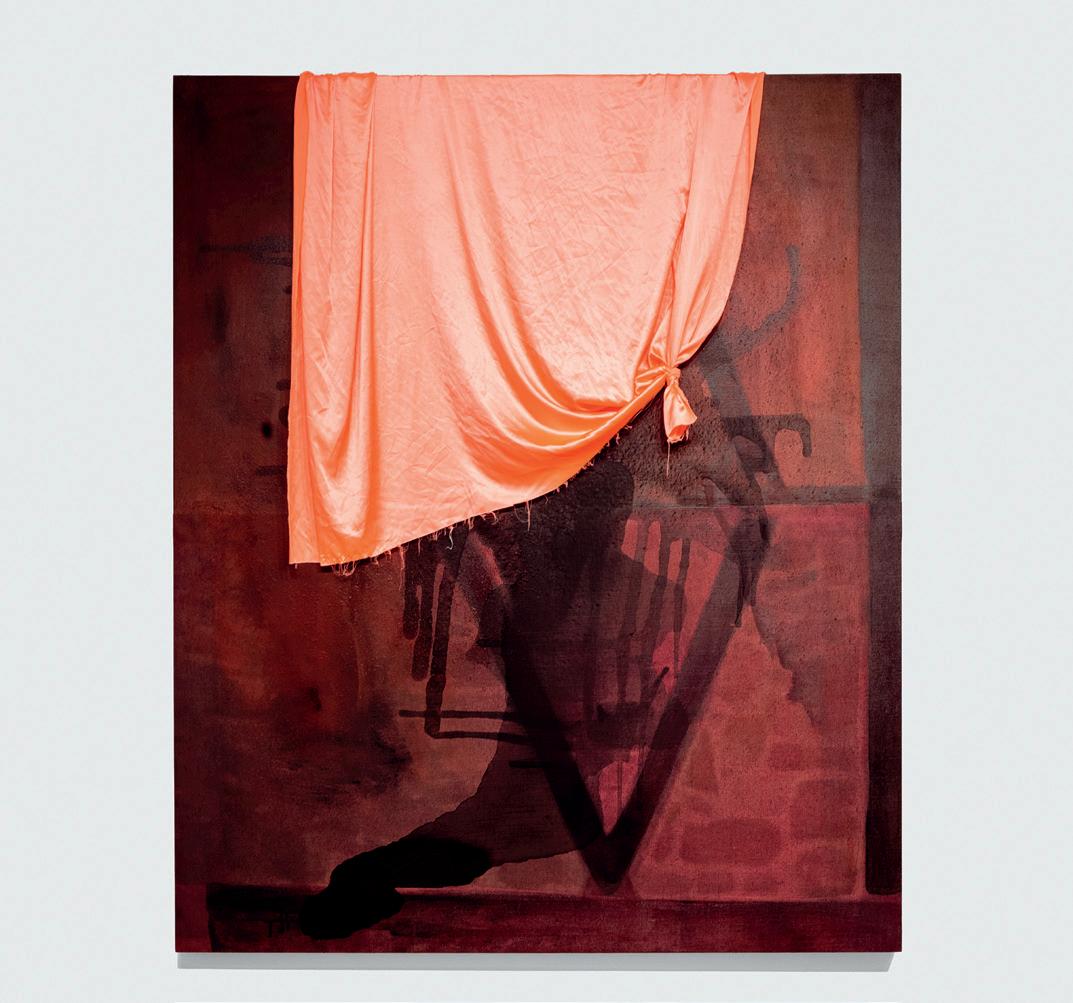
vast documentation of the processes of domination together with the symbolic and applied change to the uses of territories. I am not referring to every type of landscape, but to those that most genuinely present themselves as a field open to the reach of our vision, the violent representation of what is made possession.
Linklater proposes thinking of landscape as a perceptual experi-
117 116
duane linklater
ence of the manifestation of natural phenomena, as a physical and spiritual state of beings crossed by the forces of the world. But the reference and the weight of official history are important points to bear in mind, as the artist’s works shatter the often romanticized image, steeped in nostalgia, by questioning its original nature. They even seem to inhabit that fissure. Linklater appropriates elements of modern
and contemporary architecture and assimilates them into his work.
For the 35th Bienal, the artist presents a series of paintings that, through the play between form and matter, tension the nefarious legacies of school systems1 for indigenous children – in operation in Canada between 1880 and 1996. In the compositions that Linklater has been pursuing since 2015, when he began this research, he takes up the

geometries of the Bishop Fauquier chapel, built using the labor of children who attended the Shingwauk Indian Residential School (which operated from 1873 to 1970). In addition to being required to provide manual labor for the buildings, these children performed Lenten sacrifices related to Maple Syrup. As the project presented by the artist to the 35th Bienal reads, “The Anishinabek communities developed a specific methodology of maple syrup production with their intimate knowledge of the seasons, the land, and its processes. So not only were the children asked to forgo syrup consumption, but it created a symbolic disconnect with these community practices and methodologies.” Divided into nine parts, the geometries of the chapel are treated with other designs made from charcoal, cochineal, tea, tobacco, and other colorings that denote the work of the children who built the construction.
The paintings titled they have piled the stone / as they promised / without syrup continue to resound the artist’s questions: How can we, as indigenous peoples, live, make decisions, speak, dance, and move in such impossible contexts and places?
emanuel monteiro
translated from Portuguese by philip somervell
1/ The Residential School System in Canada was a violent and prolonged system imposed by the government and its attendant churches, created specifically so that indigenous children would be separated from their families, acculturated and colonized.
they have piled the stone / as they promised / without syrup, 2023 Exhibition view, Art Gallery of Hamilton (2023)

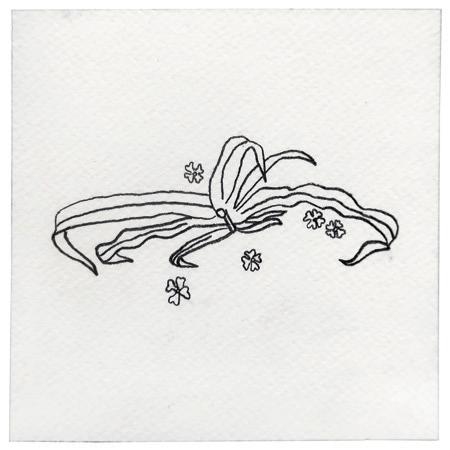
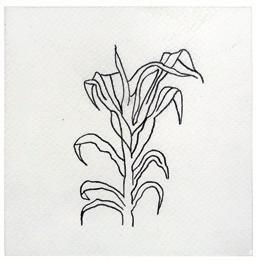
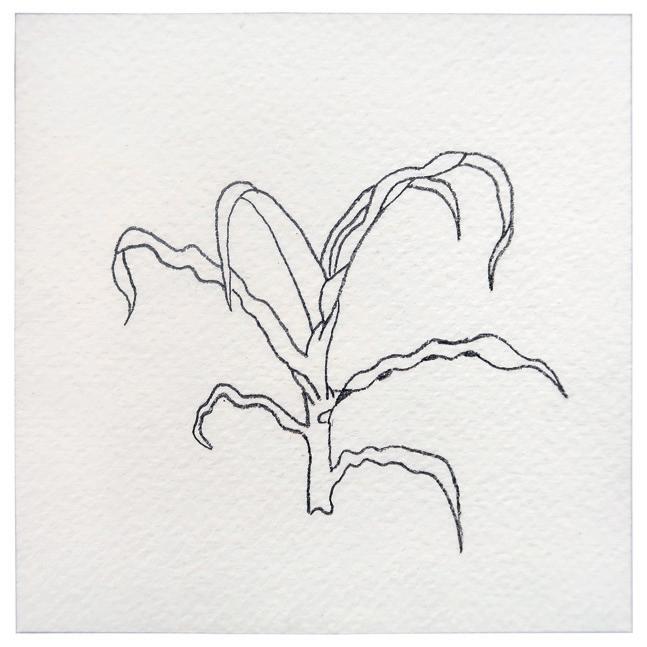
119 118 edgar calel
The jaguar is prominent in Mesoamerican cultures and appears in various kinds of representations. In Mayan culture and mythology, the jaguar has the ability to transcend space and time and to cross between the day and the spirit world to facilitate communications and connections between the ancestors and the living.
In Xar – Sueño de Obsidiana (2020), produced with Brazilian
filmmaker Fernando Pereira dos Santos inside the Ciccillo Matarazzo Pavilion of the Bienal de São Paulo during the first wave of the COVID-19 pandemic in Brazil, Mayan artist Edgar Calel wears the skin of a jaguar as he walks around the pavilion and seeks to see and understand how the site was originally used by the indigenous people who once inhabited that land. This is at once a transmutation
between human and non-human and a transcendence of space and time; and it is also an act of constructing solidarity or “practicing community.” Throughout the film Calel wears a blue sweatshirt embroidered with the names of the twenty-two Mayan languages as his voice is heard reciting the poem of the same name as the film but in the Kaqchikel language, written by Calel, and composed of his dreams in Brazil during the pandemic.
Sharing in community is a topic fundamental to Calel’s artistic production. Calel’s Guarani house installation for the 35th Bienal de Sao Paulo is a large immersive drawing on canvas of a Guarani house surrounded by embroidered Yucca plants. The drawing is an architectural image and simultaneously a representation of indigenous epistemology – a map of “practicing community” around a bonfire while sharing in storytelling, rituals, music, and meditation. The drawing reorients space from horizontal to vertical and invites the viewer to participate in the communal imaginary of indigeneity. The Guarani people are the largest indigenous group in Brazil whose surviving population is estimated at 51,000 people. Today, three Guarani villages with a combined population of approximately 700 people live in the Jaraguá district on the outskirts of São Paulo.
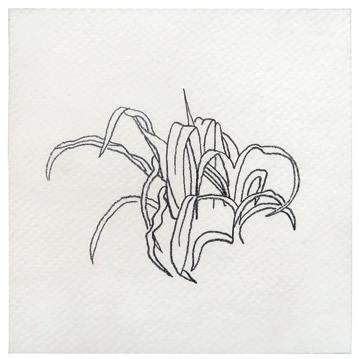

mario gooden
The Big Guarani House. Graphite on paper, 50 x 50 cm (each)
Sketches for Nimajay Guarani, 2023
elda cerrato
What are these strange shapes that vibrate, approach, assemble? Mutating mother cells? Fragments of celestial bodies? Instants of unknown life? Organic machines? Domestic or stellar landscapes? There seems to be no figuration or abstraction in the series of paintings that Elda Cerrato (1930-2023) created after the birth of her son in 1964, and which inspired the animated short film RF: Segmentos_CPV: Okidanokh
(1964-2022) – made together with Ramiro Larraín, Luis Zubillaga and Luciano Zubillaga. In fact, there is a rigorous invention of worlds. From her earliest works, she wonders about the mystery of life and the transformation of energy into the most unsuspected, unknown and secret forms. To some extent, those images function as explorations or hypotheses, speculations or hallucinations, and esoteric projections.
Algunas experiencias relativas al Okidanokh, from the series Producción de Energía, 1965 Some experiences related to the Okidanokh, from the series Energy Production. Oil on canvas, 115 × 145 cm
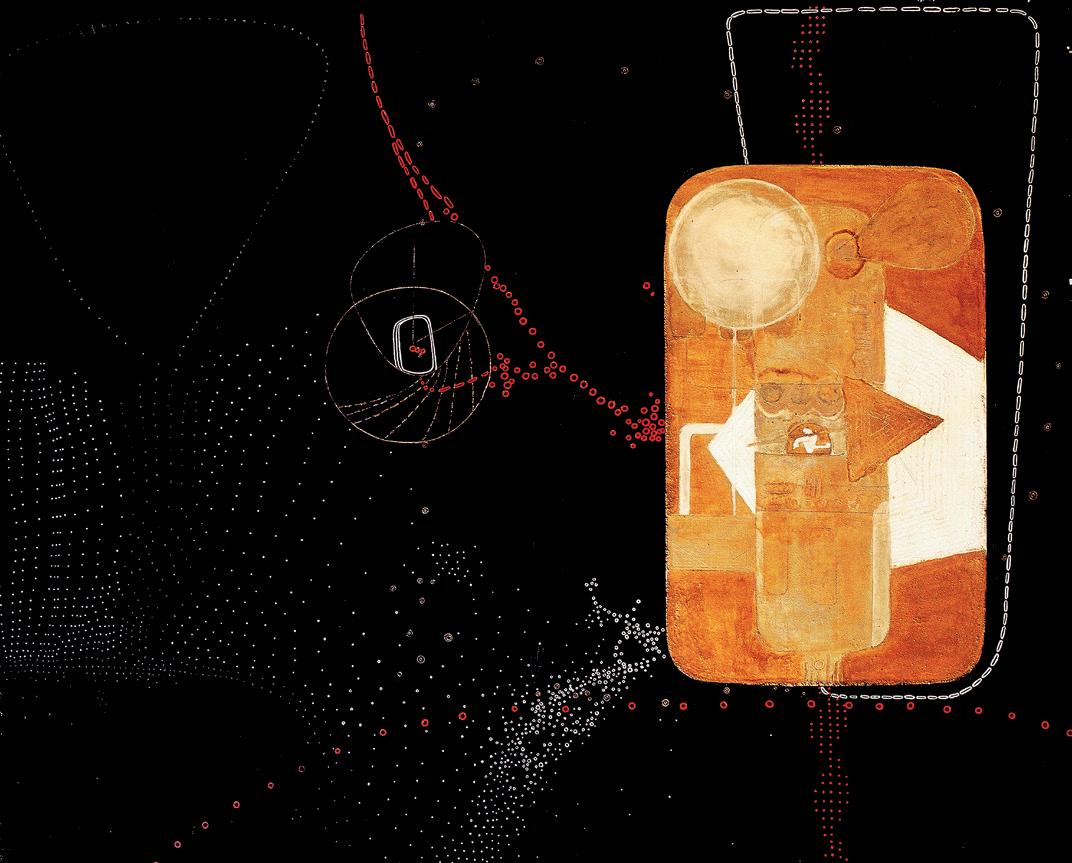
121 120
What if we managed to link together some clues that the artist leaves within our reach to work out her enigma? The titles provide clues (mentions of the Beta Being, the Laboratory of the Holy Source of Energy, Okidanokh) by referring to alternative worldviews such as the philosophy of the Fourth Way, founded by Georges Gurdjieff, of which both Elda Cerrato and her lifelong partner, the experimental
musician Luis Zubillaga, were active practitioners since the 1950s.
In addition to a spiritual quest materialized in images, we can note a precise knowledge of biochemistry (she studied the whole career) and a practice of observation under the microscope.
One should also address many of these images on an erotic note: imminent insertions between organs, encounters, fusion, assem-
bly, penetration, gestation. Flowing blood. Organs that beat.
These images can be understood as maps and diagrams of a stellar journey until landing on Earth, more precisely in a Latin America shaken by the political radicalization that ravaged the continent, where she places the series of paintings and heliographs she produced in the 1970s. From the Beta Being to the multitude in the streets: this is the transition that transfigures her gaze from an inner search to the world around her. The organicity of her maps is that of a living body, which changes without abandoning the traces already traveled, but taking them up again. “Worldviews as memories of other times”, says Cerrato.1 An exercise in memory and at the same time a projection to the future.
Her tenacious desire to not accept conventions and to learn by her own means is perhaps the main key to approaching a trajectory that lights up from the boundaries, her “being on the edges” concerning institutions or hegemonic artistic trends. It is this capacity to decenter and interweave that encourages us to continue searching for ways to work out the enigma that she bequeathed to us.
ana longoni
translated from Spanish by ana laura borro
1/ Elda Cerrato, La memoria en los bordes: entrevista, dibujos. Buenos Aires: Nobuko, 2011, p. 7.

123 122 elena asins
detail of Untitled (Offset Variations), 1975 Offset print on paper, 75 × 836 cm
In the late 1960s, Elena Asins (19402015) began drawing structures that unfold silently on a two-dimensional surface; at times the Spanish artist developed a modulated element based on a specific sequence and rhythm, requiring the viewer to make a mental reconstruction that stretched and expanded the limit of the paper ad infinitum. The line –the development of a point – discovers its dimensional potential by

turning, by pivoting: does it dance, does it sound? In fact, for Asins, what is drawn is as relevant as what is thought and not said, connected as it is to Wittgenstein’s thought.
She herself pointed out the crossover of her work with music (beyond the literalness of titles that evoke Mozart’s Prussian Quartets or the structure of Bach’s canon). According to Javier Maderuelo: “Her art is musical not only because
her plastic forms have a relationship of structural similarity with certain compositional developments in music, but also because, as music is immaterial, it is pure mental process.”1
If, at least since classical Greece, music has been written with signs to be interpreted – notes that are mute for the non-literate – literacy is superfluous in Asins’ work, as its signs lack a consensual code; its disciplined structures, developed with rigour, allow them to be translated into concept, thus expanding the authorship towards the reader. They are visual poems, or scores –conceived in a performative, open and sonorous sense that comes from Fluxus – in which space and time are made visible with very simple, almost slight linguistic signs, inscribed in black and white in a minimalist way: because nothing more is needed. In fact, in 2023, Cantos de Orfeo (1970), an unpublished score dedicated to the artist Eusebio Sempere, was performed for the first time in Spain by the Trío Poesía Acción H,GLAJERU;G and the CoroDelantal. Signs embodied in bodies that sound and move in space and time.
isabel tejeda
translated from Spanish by ana laura borro
1/ Javier Maderuelo, “Menhir dos”, in Elena Asins: Menhir dos. Ayuntamiento de Madrid, 1995.
this participation is supported by: Acción Cultural Española (AC/E) and Embajada de España en Brasil.
We are living in the Anthropocene – commonly understood as a new geological era overdetermined by human action. But it is important to reflect on this concept, which is uncertain and does not designate a single geological moment, nor does it refer to the generic human being. As such, it is essential to recognize the structures of white male supremacy as part of the predatory and accelerated trans-
formations of the geobiosphere, to contest its essence, which keeps the figure of the human at the center of the scene to the detriment of interspecies relations. It is therefore essential to experience the these artists works that, in the midst of racial and environmental violence, intersect fictions and realities with swamps, oceans, and racialized icons and symbols, leading to the construction of other
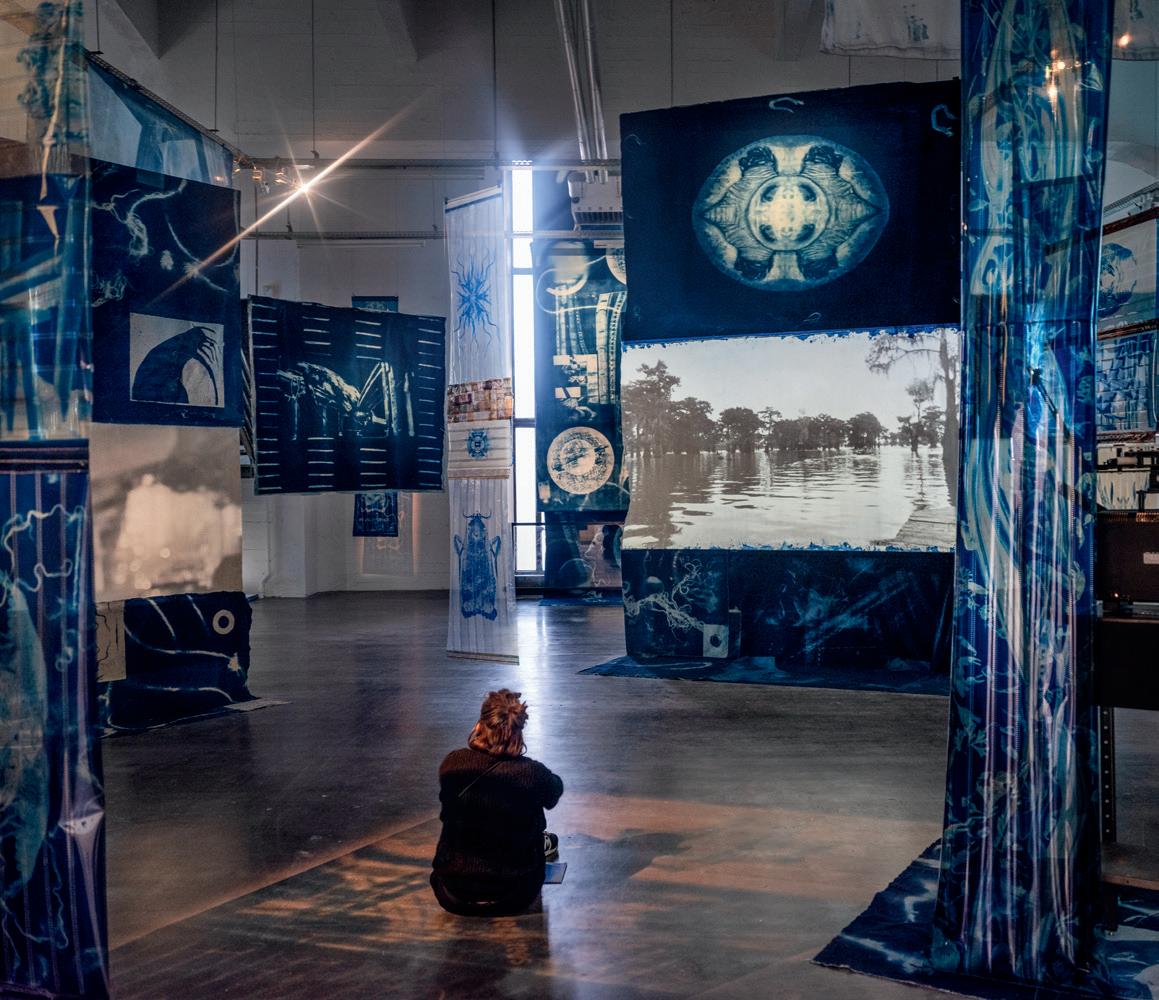
125 124
ellen gallagher and edgar cleijne
political and poetic landscapes for perceiving and narrating the multi-species world.
For it is in water and sea that these artists are anchored. Gallagher was born in Rhode Island, USA, and lives between Brooklyn, New York, and Rotterdam, Holland – cities with a significant role in the transatlantic slave trade. She has been collaborating with the Dutch artist Cleijne since 2024. Together,
they created the multimedia installation Highway Gothic (2017-2019), followed by Gallagher’s pictorial works Watery Ecstatic (2007, 2017, and 2021), Morphia (2008 and 2012), and Ecstatic Draught of Fishes (2019 and 2021). These works tension questions such as the legacy of colonialism, ecological impact, black displacement, and the paradigms of Eurocentric art in a process that involves

Afrofabulation1 and Afrofuturism combined with paintings, cyanotypes, film and sound installations (the music is mnemonic and countercultural), and theoretical works on the African diaspora, such as The Black Atlantic by writer Paul Gilroy.2 Through aquatic aesthetics, Gallagher and Cleijne propose an immersion into the depths of the oceans in a dialogue with the marine, biomorphic creatures, histories/stories, and myths that inhabit these depths. It is important to point out that, as a place of forgetting, the sea carries with it erasures that express expansionist colonial narratives. Thus, in their works, in becoming, the artists imagine life after the death of Atlantic traffic.
barbara copque
translated from Portuguese by philip somervell
1/ This is a term-concept used by authors such as Saidiya Hartman and Tavia Nyong’o.
2/ Paul Gilroy, The Black Atlantic: Modernity and Double Consciousness. Harvard University Press, 1993, reissue.
this participation is supported by: Mondriaan Fund.
_
Highway Gothic, 2017-2019
Installation view. Cyanotype, 70mm film and textile banners, cyanotype light boxes, 16mm film and cyanotype film projections, sound
emanoel araujo
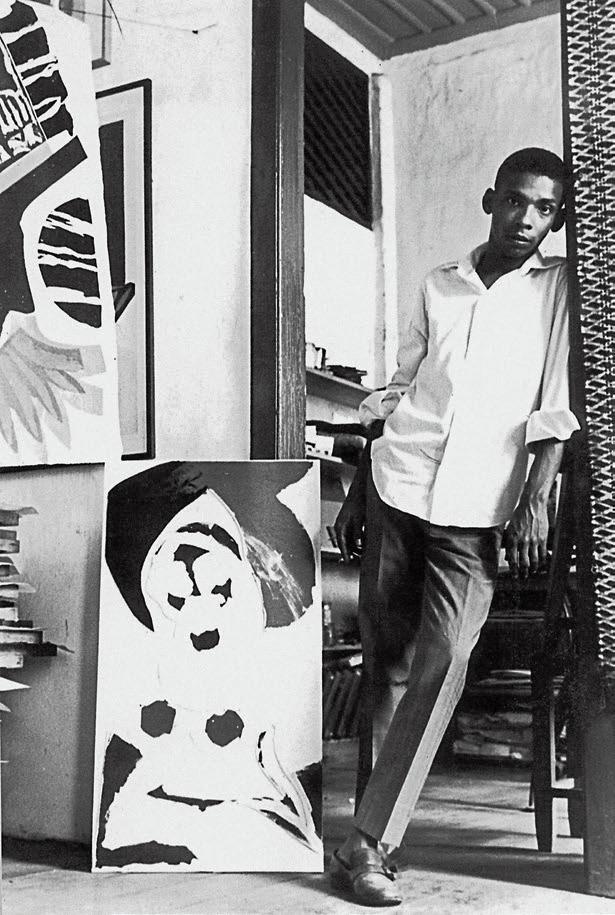
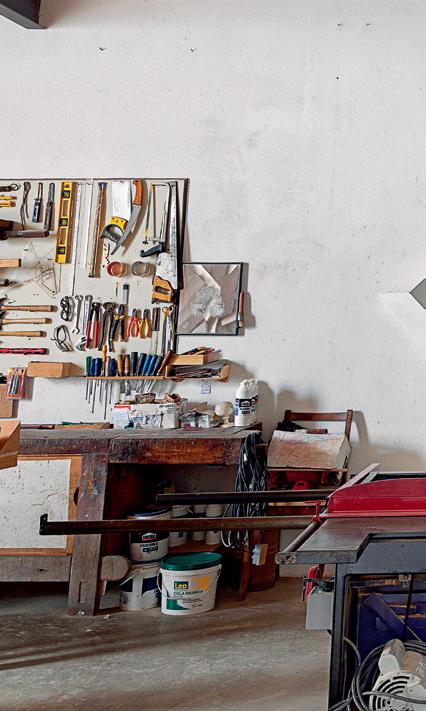
127 126
Emanoel Araujo at his studio at ladeira do Desterro, Salvador, undated
Emanoel Araujo (1940-2022) was a Brazilian artist and curator, renowned for his numerous contributions to the strengthening of Afro-Brazilian history and art. From a family of goldsmiths, Araujo had a diversified education, learning woodworking techniques which led him to refine, among other formal and aesthetic aspects, his practice as an engraver and sculptor.
Araujo began his career in Santo Amaro (in the state of Bahia) as a typographer and developed skills in engraving and sculpture while exploring geometric abstraction throughout his artistic career. As a sculptor, Araujo paid close attention to the selection of materials, incorporating elements from Amerindian, African, and Afro-Brazilian cultures into his works. His sculptures often allude
to ships, masks, and symbolic representations of the cosmogony of African and Afro-Brazilian religions.
In the work exhibited at the 35th Bienal, a monumental relief, one can see the way the artist builds rhythm and movement, creating pieces that convey a marked visual dynamism and sense of fluidity. Color also plays a fundamental role in his work; Araujo’s use of vibrant and contrasting colors conferred vitality and impact upon his sculptures – formal characteristics that help define the aesthetics and identity of his work.
Although the concept of the Brazilian riscadura [trace] is associated with the work of the Bahian artist Rubem Valentim, one can notice the reverberations of this concept in Araujo’s work, as acknowledged by the artist himself. His sculptures frequently address themes of Afro-Brazilian culture, incorporating symbols and motifs related to Afro-Brazilian traditions and spirituality.
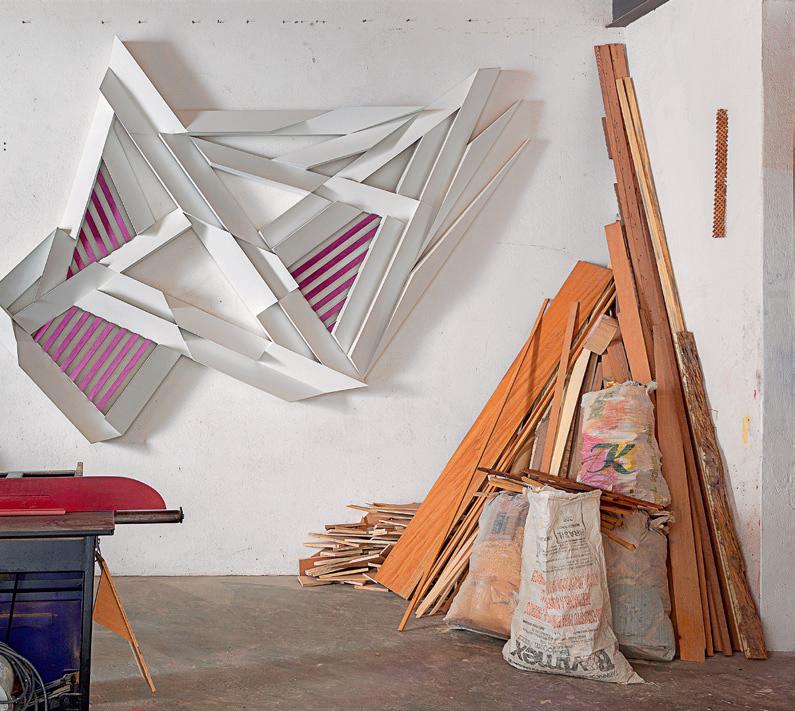
In addition to his artistic work, Araujo played an important role as a curator and cultural administrator. He ran exhibitions in Brazil and abroad, showing works by African and Afro-Brazilian artists, in addition to directing the Museu de Arte da Bahia, the Pinacoteca de São Paulo, and founding the Museu Afro Brasil. Araujo’s dedication to promoting Afro-Brazilian art and culture has had a significant impact on the recognition and appreciation of African heritage in the Brazilian and international art scenes. His influence helped shape the contemporary art scene in Brazil and abroad, making him an inspiring and influential figure to this day.
horrana de kássia santoz
translated from Portuguese by philip somervell
Emanoel Araujo’s São Paulo studio, with the work Espaço expandido [Expanded Space], 2017
eustáquio neves
Eustáquio Neves’ tenacity in observing and researching the rites and festivities of the remaining Black communities makes him a remarkable restorer of memories. The series Arturos (1993-1994) and the diptychs Encomendador de almas [Comissioner of Souls] (2006-2007), presented at the 35th Bienal, document a comprehensive view of the sacred, of hereditary education and of the daily life of these communities.
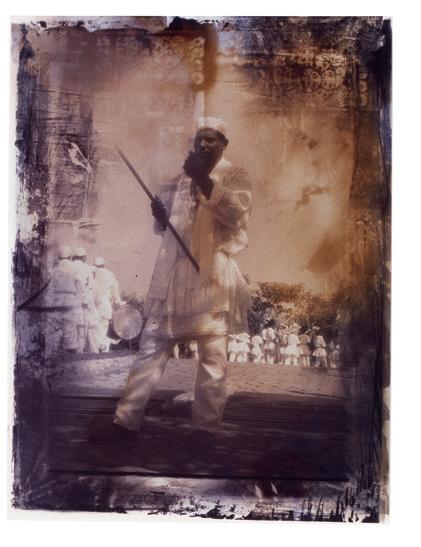
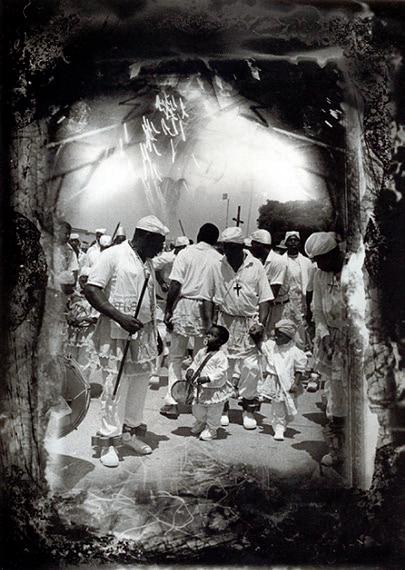
Thanks to his knowledge of chemical processes, acquired through his technical training, Neves manually interferes with the negatives of photographs to produce various effects. It is an enigmatic, almost Lomographic gesture that penetrates the workings of the equipment and exposes the indeterminable and choreographic character of the gaze that composes them.
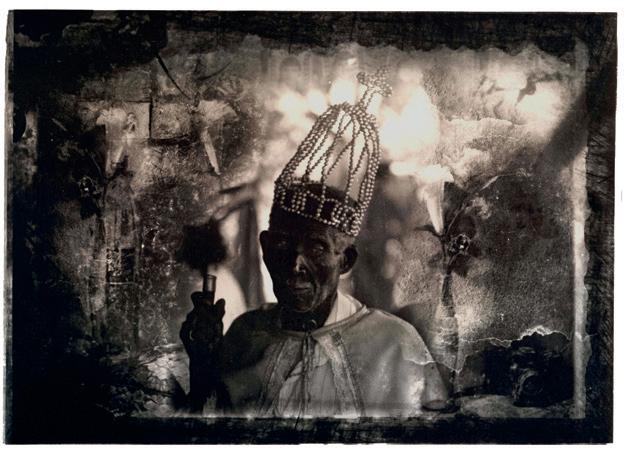
129 128
Untitled, from the series Arturos, 1993-1995 Photography on paper, Fine Art print
In the early 1990s, Neves produced the series Arturos, depicting a family group reminiscing about their oldest ancestor, Artur, in the municipality of Contagem, Minas Gerais. This group is characterized by its sacred practices, based on the intersection of Catholicism with religions of African origin, during the celebration of Our Lady of the Rosary, protector of Black brotherhoods in colonial Brazil. In the first
photo, there is a group of adults with children in the center, all elegantly dressed. The second photo depicts a man of the guard, in an upright and central position, and in the third, “The King,” framed in a bust, wears a crown and a cloak.
The second work presented is from the series Encomendador de almas and portrays the quilombola community in Ausente or Córrego do Ausente, located near the district
of Milho Verde, in the Vale do Jequitinhonha region. The encomendador de almas is a figure present in the festivities of Our Lady of the Rosary and is responsible for the work songs called vissungos. In the diptychs displayed at the Bienal, one of them shows Mr. Crispim, a very important person in the hierarchy of the catopê (the name given to the Congadas in the region of Minas Gerais), seated, wearing a light blouse and a cloak covering his shoulders, his hands joined over his legs. Next to him is a photo of a sword used to clear the way for the procession of Our Lady of the Rosary. In the second diptych, Mr. Antonio appears next to his house.
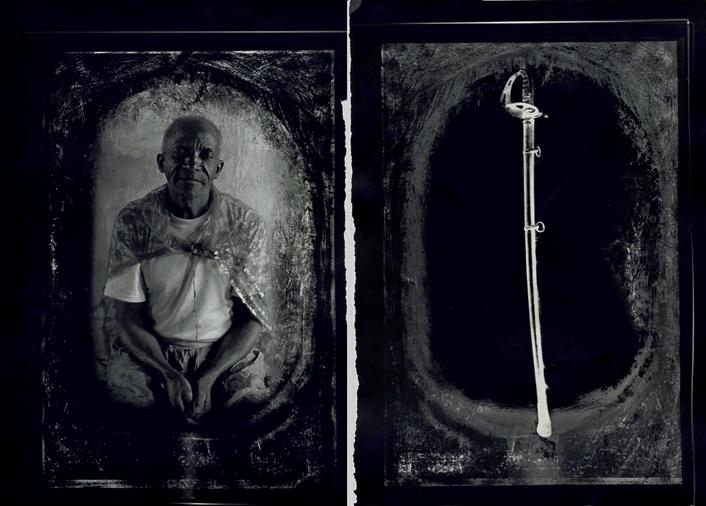
Neves’ images defy the technical limits of photography and perform “a reality that cannot be named,” as described by the authorial voice of the 35th Bienal’s educational publication 1 The remaining peoples are an extension of quilombismo and, by reconstituting time periods and characters in an apparently static memory, Neves signals a recovery of traditions and landscapes, as well as the very incongruity of the construction of memory.
horrana de kássia santoz
translated from Portuguese by mariana nacif mendes
1/ Reference to the phrase “a reality that I cannot name,” in “Correspondências entre vozes, uma carta para abrir conversas”, in Aqui, numa coreografia de retornos, dançar é inscrever no tempo: educational publication of the 35th Bienal de São Paulo – choreographies of the impossible São Paulo: Bienal, 2023, p. 15.
Untitled, from the series Crispim/Comendador, 2007-2008 Crispim/Commander Photography on paper, Fine Art print
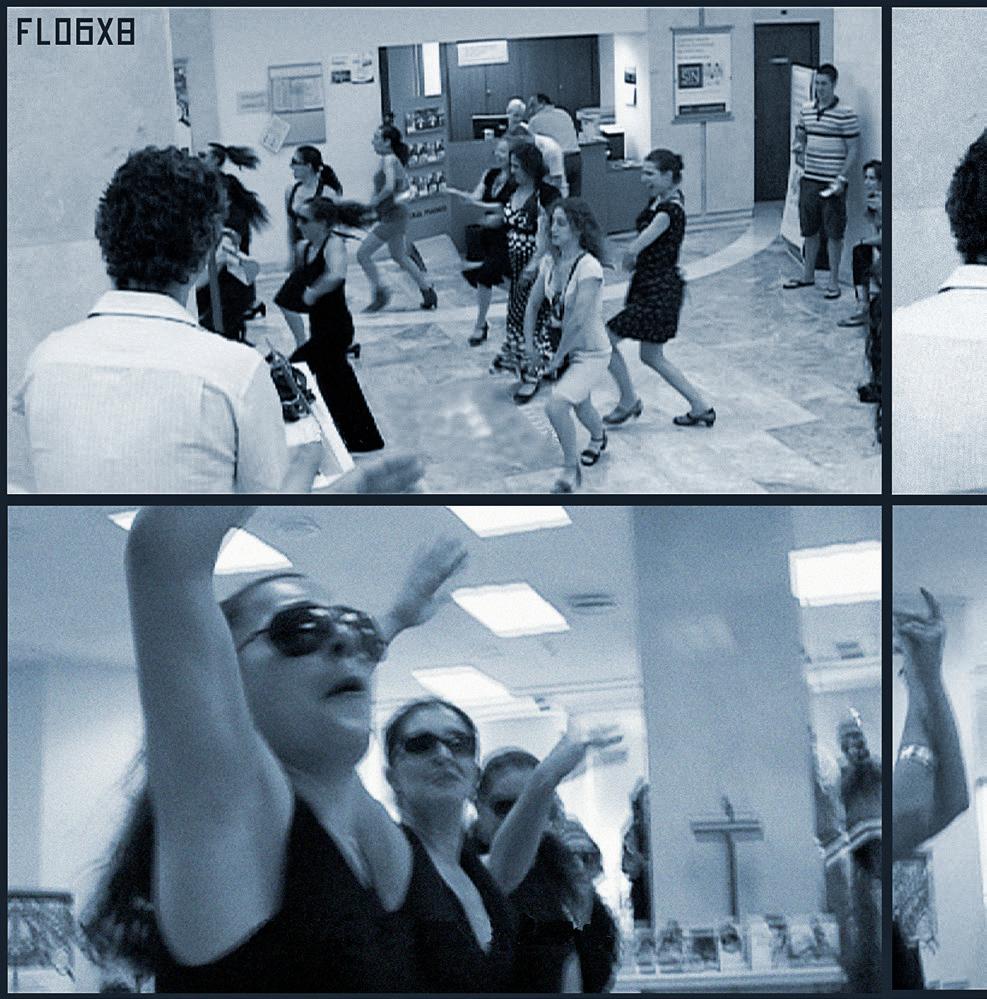
131 130 flo6x8
Only a short time after the collapse of Lehman Brothers, the “activist-artistic-situationist-performative-folkloric-nonviolent” collective flo6x8 emerged in the city of Seville, Spain, temporarily occupying multiples bank branches through dance and flamenco singing, tapping on the floor of those who cause to take away the sleep and the roof of the citizens, singing to the banking system its responsi-
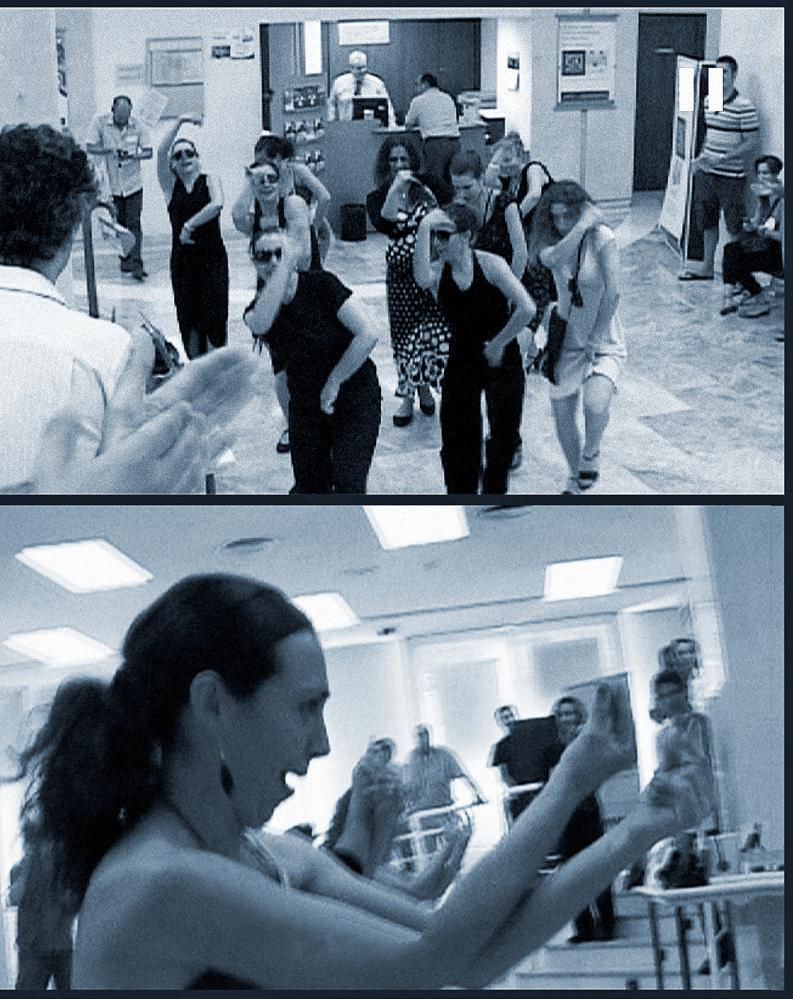
bility for the impoverishment of the population. The branches of fear and violence were transformed, at least for a while, into spaces of political and artistic potential to turn history upside down: “this isn’t crisis, it’s called capitalism.”
The video of one of these actions, called Flashmob Rumba Rave “banquero” and released in December 2010, spread across the internet and was used to call the
demonstration against social cuts that took place on 15 March 2011 – one of the many precedents for the 15-M movement.1 flo6x8 anticipated some of its political innovations: spontaneity in occupying space, radical transformation of the crisis narrative, subversive and inventive joy, contagious openness and porosity.
flo6x8 manages to move in the concatenation between art and revolution, where what matters is not so much what belongs to each field but how its components are choreographed in a localized way. Its actions make use of singing and dance to produce a smooth disobedience. It does not use the mechanisms of flamenco to be experienced in a passive manner, for this is the way to sustain a cry of outrage long enough to transgress the formal codes of political protest and enter a new terrain of uncertainty in which the public begins to doubt, to pay attention, in which the transgression penetrates much deeper into the body, until it hurts.
kike españa
translated from Spanish by ana laura borro
1/ 15-M is how the indignados [outraged] movement in Spain came to be known. On May 15 they occupied a large number of Spanish squares, protesting against the welfare cuts caused by the 2007 economic crisis. [e.n.]
Bankia, pulmones y branquias. Bankia sale a bolsa 2, 2012 Bankia, lungs and gills. Bankia goes public 2. Video stills
this participation is supported by: Acción Cultural Española (AC/E) and Embajada de España en Brasil.
Known for his works on paper, especially prints and paintings, Francisco Toledo (1940-2019) explored different mediums, such as collage, tapestry and ceramics, while maintaining a single vision: the construction of an artistic practice implicated in the cultural, traditional and political heritage of his community (Oaxaca, Mexico). In this extensive journey, Toledo, who was also known as El Maestro
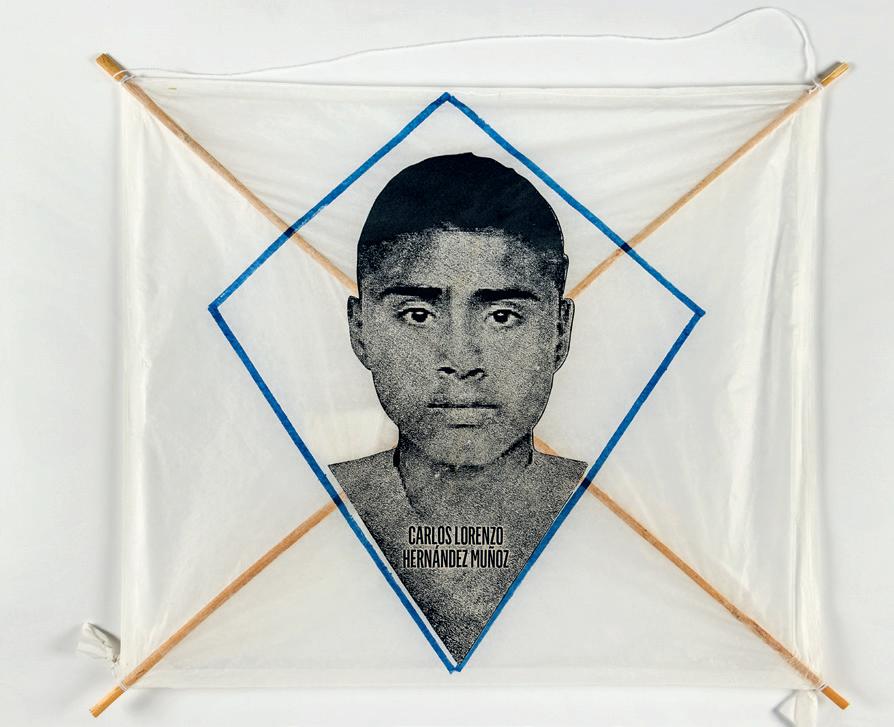
– the master and teacher – invested intensively in the implementation of projects dedicated to education and the maintenance of cultural practices in Mexico, such as the Contemporary Art Museum and the Graphic Arts Institute of Oaxaca.
Toledo’s work feeds on what the artist experiences in travel books and childhood memories, but above all on what he observes in his surroundings. The Zapotec cosmol-
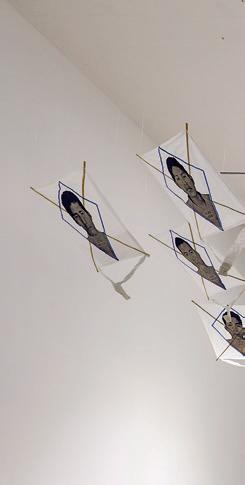
133 132
francisco toledo
detail of Papalotes de los desaparecidos, 2014 Kites of the missing. Chinese paper and reed frame with photographs printed on laser engraved wood, 43 pieces, 58,2 × 51 cm (each)
ogies of Juchitán, the pre-Hispanic cultural legacy and the dynamism and updating of traditional customs are some among many compasses that guide the practice of an artist who spent a significant part of his life-work flying papalotes (kites) as a form of political action.
A significant marker of his creative expression and social engagement emerges with Papalotes de los desaparecidos [Kites of the disap-
peared] (2014) – a project exhibited at the na 35th Bienal de São Paulo. In this work, the kites created in collaboration with participants of the Art and Paper Workshop of San Agustín Etla were meant to contribute to the many protests taking place in Mexico since 2014, when a group of 43 mostly indigenous high school students from the Normal Rural Raúl Isidro Burgos School, in Ayotzinapa, were kid-

napped by the municipal police of Iguala, Guerrero.
On the Day of the Dead, kites are flown because souls are believed to descend through the string down to earth to feed on the offerings; then, at the end of the festival, they fly again. As they had already searched for the Ayotzinapa students underground and, in the water, we sent the kites off to look for them in the sky.1
Since 2014, in addition to the many voices that came together to expose one of Mexico’s deepest wounds, the faces of the normalistas have continued to appear in various contexts, seeking to break the silence established by government institutions. To this day, the families of the disappeared seek to build a sense of justice, much like the slashes in the wind produced by Toledo’s kites.
tarcisio almeida
translated from Portuguese by mariana nacif mendes
Papalotes
1/ Statement by the artist published in several news outlets covering the protest-actions carried out by Francisco Toledo as of November 2014, when he initiated the work Papalotes de los desaparecidos (2014).
de los desaparecidos, 2014 Kites of the missing. Exhibition view. Museo Universitario Arte Contemporáneo, Mexico City (2018)
frente 3 de fevereiro
ONDE ESTÃO OS NEGROS?
Where are the Black People?
Brazil can be understood, from the point of view of blackness, as an anti-black project. on the other hand, we can understand blackness as the stubborn and tireless practice of trying to live when you were not supposed to have survived. Zumbi dos Palmares, constantly taken up again in the radical artistic work of the Frente 3 de Fevereiro, especially in Zumbi somos nós [We are Zumbi], appears here, then, as the mystery
Campeonato Brasileiro, Corinthians x Ponte Preta, Moisés Lucarelli stadium, Campinas, August 14th, 2005

135 134
that unites these two formulations, putting the world that produced them in check. these two formulations intersect with the history of the Frente, which emerges as a way to avenge the death-life of Flávio Ferreira Sant’Ana, a young black dentist cruelly murdered by military police officers in São Paulo in 2004. through a practice that merges direct action and aesthetics, moving between image, music, perfor-
mance, literature, and an infinity of forms, the Frente 3 de Fevereiro develops radical artistic practices of social intervention as a way to not only denounce the brutal situation faced by Black people in Brazil, but to promote their unpredictable force of creation and transmutation. For the choreographies of the impossible, using voice cloning and deep fake technologies against its own ends, the collective creates a com-
plex sonic-imagetic environment, reanimating the movements, gestures and sounds of Dona Marinete Lima (1942-2018), a member of the collective and ancestral matriarch. in addition to this animation, the video installation includes sound files and images of the collective, records of its radical interventions that both denounce the death plan as well as machinate the combination of life.
the experience of this video installation intersects past-present, life-death, revolt-joy, like a technological spell to avenge black life in its ungovernable performance of infinite resurrection.
abigail campos leal
translated from Portuguese by philip somervell
Zumbi are we
Campeonato Brasileiro, Corinthians x Internacional, Pacaembu stadium, São Paulo, November 20th, 2005
 ZUMBI SOMOS NÓS
ZUMBI SOMOS NÓS

137 136
gabriel gentil tukano
The finger of creation touches me and pulsates. Such is the light of the Yepá Mahsã, People of the Earth. Between the worlds they draw the mouth of time in seminal explosions and primordial spirals. My heart escapes and lives again. It stares at the unverifiable, inhabits the invisible. Everything happens in the instant now, half moving and in bursts. Body, drive, friction, union. It is the cosmos occurring fertile on earth’s health.
Here the body of the world is in gestation, transmuting and updating itself in each and every gaze that spies the presence, the writing, and the drawing of my kin Gabriel Gentil Tukano. It is a nod that happens. It is a warm breath. The sweltering of the forest speaks. Swirls draw the forewarning on the ground: there is not a square meter under our feet that is not the sacred creation of ancestral territory. What is created in lines is perpetual.
A body draws.
And the line is traced when the light reveals it. A light that walks between worlds creating other worlds in the center of the beginnings of all times, of the risks and the first rites. In the next light, my eyes will reach the hands of my kin, for the point is demarcated in both worlds, and the risk of our love is high, the stuff of strong medicine.
A body writes.
Letters are heaped drawings that become senses and bodies, but once organized on the basis of old-world universalizing thought, they operate an infertile, infantile, worn-out, poisonous, and cadaverous inhabitation.
Strong medicine will not cure a body that is born dead.
Gabriel Mira. He draws the aim. He aims and draws. He is the aim. His body is the drawing and the continuity of dreamed gestures here and now, it is in sight, it is in the very ancient visions and breaths. He continues to draw and aim at the connection of the ancestral bodies that are in the future of the world.
Reverence
These are living works!
Gabriel Gentil is the drawing taking place between worlds.
déba tacana
translated from Portuguese by philip somervell
Desenho / n. 18, c. 1970 Drawing / n. 18. Graphite and ballpoint pen on paper, 21 × 29,7 cm
Krazy Kat

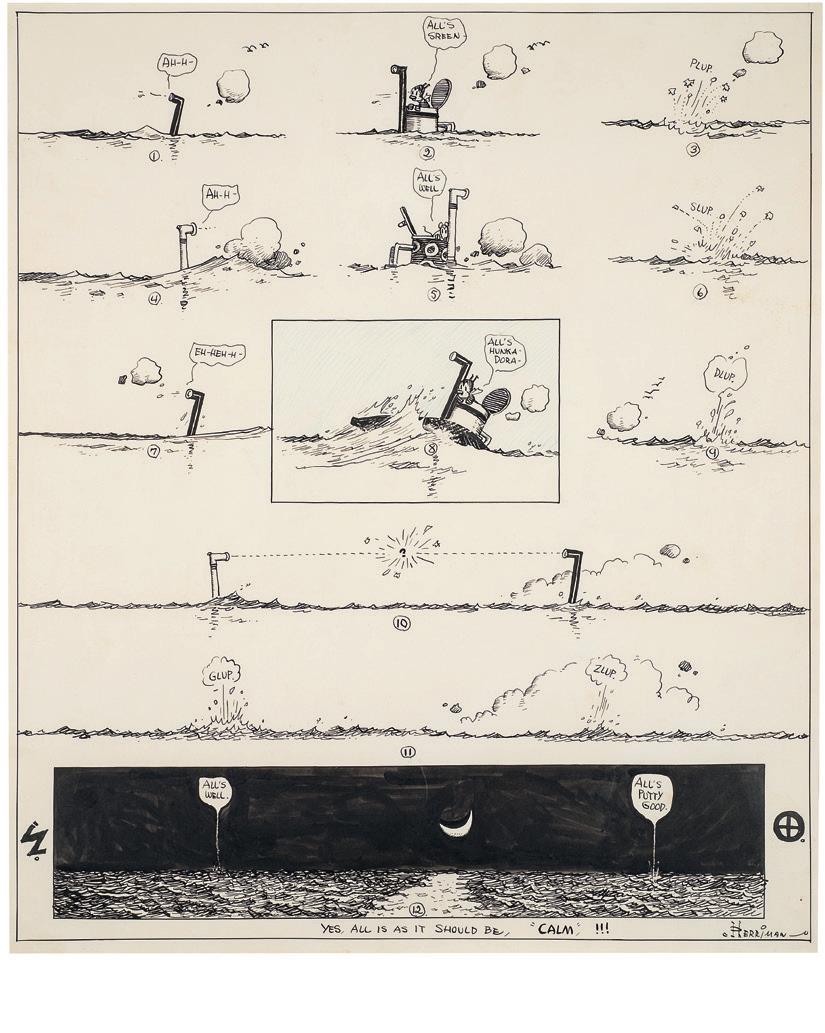
Original drawing for newspaper full page, May 8, 1917 Ink on paper, 55,8 × 48,2 cm
“[...] He is but a shadow himself, caught in the web of this mortal skein. We call him ‘Cat’, We call him ‘Crazy’ [...] Forgive him, for you will understand him no better than we, who linger on this side of the pale.”
139 138
george herriman
In these words, George Herriman (1880-1944) reflected on the inscrutable condition of Krazy Kat. In essence, the influential comic strip narrates the misadventures of Krazy, a gender-neutral cat – the ambiguity of his gender has never been clear – who is madly in love with Ignatz the mouse. This love is not reciprocated by Ignatz, whose constant aggressions towards the protagonist, throwing bricks at his
head, are misinterpreted by the feline, who sees them as signs of affection. In turn, Krazy has a secret admirer, the police dog Offissa Pupp, whose constant surveillance of the mouse is aimed at preventing such aggressions or imprisoning him when he succeeds in committing them.
Everything in Krazy Kat seems to want to overcome traditional impositions: the inversion of roles
between its main trio of characters, the non-binary nature of its protagonist, the continuous experimentation in the composition of its pages, the new forms of language created by the author, etc. What puts Herriman on either side of the fence? The tension in the plot of Krazy Kat has given rise to a multitude of readings, one of them being the author’s own biography through his own racialization. Some want to see in Krazy Kat a representation of George Herriman’s struggles with his own identity as a mixed-race man in an all-white world under Jim Crow’s segregationist laws.1 The ambiguity, not just of the cat, but of the whole comic series, could reveal the duality between being or not being a thing, which can be extrapolated to issues not only of race but also of gender and class.
Today, a reinterpretation of these works gives us a glimpse of Krazy Kat and George Herriman hopping and moving from one side of the fence to the other, breaking down the boundaries of that fence, and throwing Ignatz’s bricks like missiles to disarm and deactivate hierarchies and identities.
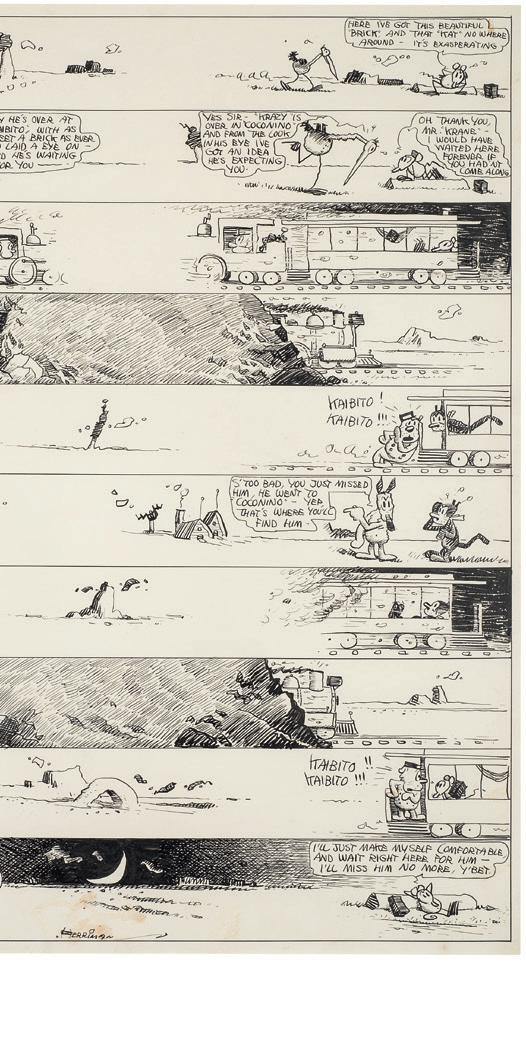
rafael garcía
translated from Spanish by ana laura borro
1/ Segregationist laws that were in effect in several southern states of the United States between the years 1877 and 1965. [e.n.]
Original drawing for newspaper full page, May 2, 1922
Ink on paper, 54,6 × 48,2 cm
Krazy Kat

141 140 geraldine javier
Geraldine Javier lives and works in the crucible of a climate crisis that makes guilt and extinction go hand in hand. In her work, the often pessimistic and nostalgic reactions to this necrospeculative economy are openly confronted with installations and paintings that present a self-mutating world of plants no longer recognizable. In Oblivious to Oblivion (2017), a large scale installation which forms a massive

suspended cloud, the threaded pictures of unlikely vegetables hang along mirrors. The fleeting reflections of spectators in the small mirrors further insist on an undifferentiated humanity, challenging its deeply rooted antagonism with the natural world.
The painterly effects resulting in free floating compositions recall cosmic arrangements that perfectly fit in the all-over composition
typical of modern painting. They invite an immersive experience that is consistent with the avoidance of a straight political engagement. As the titles of her more recent works state, she positions herself in the midst of uncertainty. Bouncing back between hope and despair her work still relies on a reparative horizon. Even though she has defined herself as an artist who does not tackle political things, the overall impression is that of an affirmative practice that avoids mourning and blaming.
Vis a vis processes of degradation, pollution and extinction, The Creatures in Search of Their Species (2012) assert themselves as an array of transformative beings. Rather than presenting a dead, fixed and lost world, as it is often the case of catastrophic and retrospective thinking, they bring forth a grammar for a regenerative future. Against the fate of destruction she opposes a politics of care that no longer resembles past forms of politics. Whereas her paintings come across as an individual practice, her installations involve a communal activity that reveals uneven sensibilities in the treatment of materials, an expression of interdependent life-forms and intergenerational cooperation.
carles guerra
eco printing of leaves from native trees on cotton fabric
gloria anzaldúa
The significance of Gloria Anzaldúa’s work lies in the radical nature of her contributions to critical thinking in decolonial, feminist, and sexuality studies, above all in including geography as a category of social difference. A teacher, writer, and activist, Anzaldúa condemns and questions the violence inflicted on people born in or inhabiting border territories and cultures,
especially women “of color”1 in the third world. Anzaldúa addresses the border that divides the United States and Mexico, now the state of Texas, a strip “bought” by the United States in 1848 through the Guadalupe Hidalgo Treaty. Born in this context, the author portrays the border as a geographical space in dispute and as a metaphor for the societal experiences of the people pressurized every day into
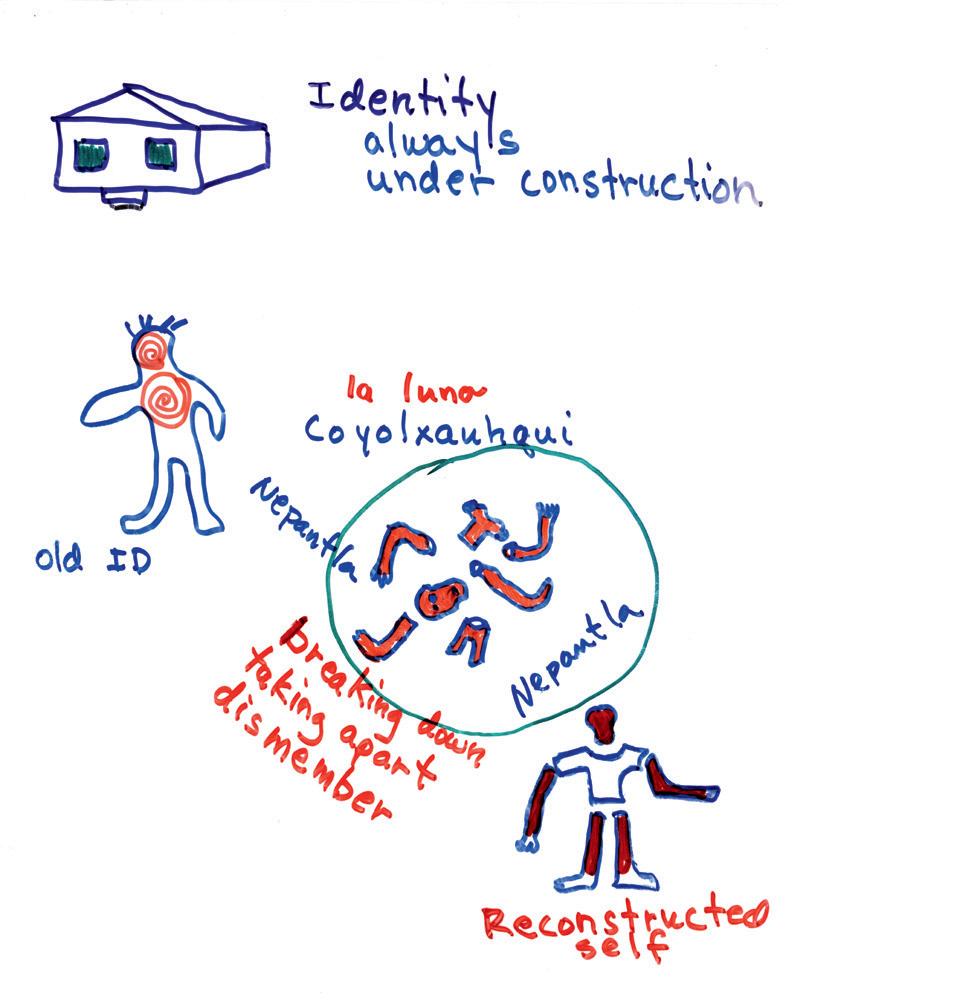
143 142
“Transparencies for Gigs”, drawing 13, undated Ink on paper, 21,6 × 27,9 cm
choosing a single identity, even when their realities are built on a meeting of cultures.
One of the drawings where Anzaldúa explores her theory in image form, exhibited in the 35th Bienal de São Paulo, portrays a purple, sinuous serpent with a huge mouth biting into an apple. Written in red beneath the drawing is the phrase, “O proibido [The Forbidden].” The scene immediately

recalls the most famous serpent scene in Western Christian history. However, here the forbidden fruit does not evoke the symbol of Christian repulsion and fear, but rather the most important symbol of pre-Columbian America – a serpent that, to Anzaldúa, is “the symbol of dark sexual impulse, the cthonic (the underworld), the feminine, the sinuous movement of sexuality and creativity, and the
basis of all energy and life.”2 The idea of putting thought into visual has Mexica origins, the indigenous culture of Anzaldúa’s ancestry, and an epistemological reference that “did not separate the artistic from the functional, the sacred from the secular, and art from daily life.”3
While writing this text, I saw the news4 that United States immigration officers are told to toss immigrant babies and children found at the border between Texas and Mexico into the river. While policies of surveillance and genocide either create or re-enact ways of maintaining violence and terror, Anzaldúa’s works remain evocative, current, and in action, reminding us that “[...] the war of independence is a constant.”5
maria luiza meneses
translated from Portuguese by georgia fleury reynolds
1/ See Cherrie Moraga and Gloria Alzandúa, This Bridge Called My Back: Writings by Radical Women of Color (1967), 4. ed. New York: State University of New York Press, 2015.
2/ Gloria Alzandúa, Borderlands/La Frontera: La nueva mestiza, translation by Carmen Valle Simón. Madrid: Capitán Swing, 2016, p. 80.
3/ Ibid., p. 120.
4/ “Agentes da imigração dos eua são orientados a empurrar crianças e bebês em rio na fronteira como México”, O Globo, 20 jul. 2023. Available at: oglobo.globo.com/mundo/noticia/2023/07/20/agentes-da-imigracao-dos-eua-sao-orientados-a- empurrar-criancas-e-bebes-em-rio-na-fronteira-com-o-mexico. ghtml. Accessed: 24 jul. 2023.
5/ Anzaldúa, 2016, op. cit., p. 55.
“Transparencies
_
for Gigs”, drawing 4, undated Ink on paper, 21,6 × 27,9 cm
grupo de investigación en arte y política (giap)
The Grupo de Investigación en Arte y Política (GIAP) [Art and Politics Research Group] was founded in 2013 in Mexico by Chilean theorist and curator Natalia Arcos Salvo and Italian sociologist Alessandro Zagato. It produces publications, exhibitions, and lectures on aesthetics and autonomy, and since 2017 it also organizes residencies for artists and academics in Chiapas.
The group’s focus of interest is the poetics that arise from social movements with indigenous roots. The militant research has focused on the devices that constitute the aesthetic deployment of the Zapatista Army of National Liberation, the EZLN, a corpus that is interpreted as a central element not only of the Zapatista ethics and political structure, but also of the autonomous praxis of its communities.

natalia arcos salvo
La danza del trabajo colectivo del maíz. Bases de apoyo del Ejército Zapatista de Liberación Nacional, 2016
The dance of the collective work of corn. Support bases of the Zapatista Army of National Liberation. Digital photography
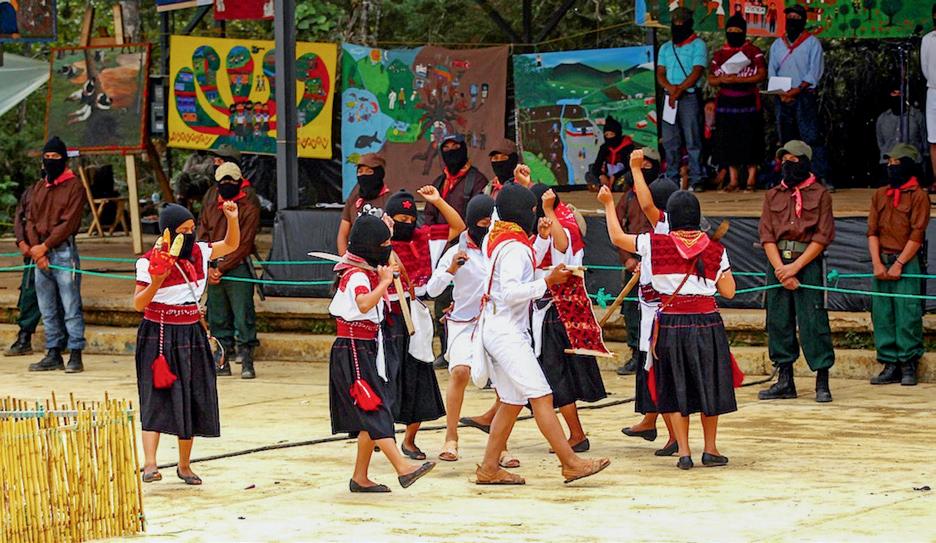
145 144
The EZLN is an indigenous guerrilla movement with a high global impact, and in deep consonance with ancestral uses and customs it defines communally the originality that distinguishes it: spokesmanship, communiqués, clothing, actions, words, and works of art configure an imagery that works as a weapon of mass seduction.
For the Zapatistas, aesthetics and poetics play an organic role
within the revolutionary politics of the movement. A fantastic example of this fusion is the great mass performance that took place on December 21, 2012, in which the Zapatistas mobilized 45,000 of their members, occupying by surprise and peacefully the same cities in Chiapas that they had taken by force in 1994. This staged event marked the reappearance of the EZLN in the media sphere,1 with the
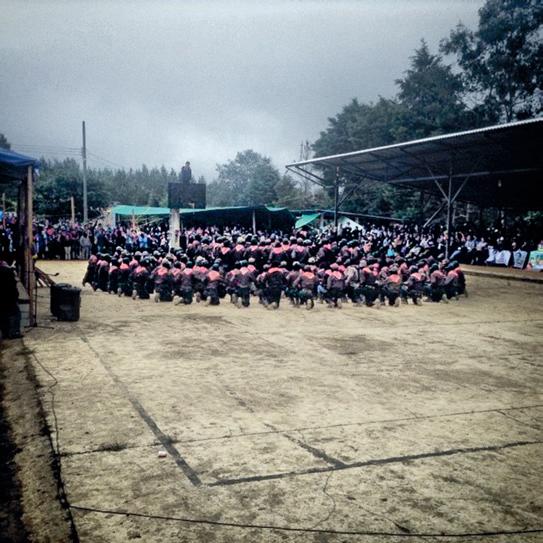
intention of showing us the broad definition of their Autonomy. This happened on the same day that was proclaimed by the media as the day of the “end of the world,” according to the Mayan calendar. But with this choreography, the Zapatistas announced at that moment the beginning of a new era for the oppressed peoples.2
GIAP has also brought for the first time, both to Brazil and South America, other Zapatista arts that narrate their processes of resistance and disseminate the practice of Autonomy, centered around the Caracoles, the Good-Government Councils, and the construction of this other possible world: embroidery, painting, dances, and militia actions. Because up there in the mountains of the Mexican Southeast, whales have been dancing for a long time.3
natalia arcos salvo
translated from Spanish by ana laura borro
1/ The Zapatistas had been in media silence since 2008, away from cameras and microphones, establishing the foundations of autonomous Good Government.
2/ The March of Silence had no speeches or proclamations. Only the day after a communiqué was released, in the form of a poem: did you hear it? / It is the sound of their world crumbling. / It is the sound of our world resurging. / The day that was day, was actually night. / And night shall be the day that will be day. / democracy! / freedom! / justice!
3/ Zapatista dance festival press release, Jan. 2017. Available at: enlacezapatista.ezln.org. mx/2019/12/15/baila-una-ballena/.
La marcha del silencio. Acción masiva de Bases de Apoyo del Ejército Zapatista de Liberación Nacional, 2012
The march of silence. Massive action of the Support Bases of the Zapatista Army of National Liberation. San Cristóbal de las Casas, Mexico. Video still, edited by Rompeviento TV
Ejercicio del caracol encadenado. Milicianos del Ejército Zapatista de Liberación Nacional, 2017 Exercise of the Chained Snail. Militiamen of the Zapatista Army of National Liberation. Digital photography
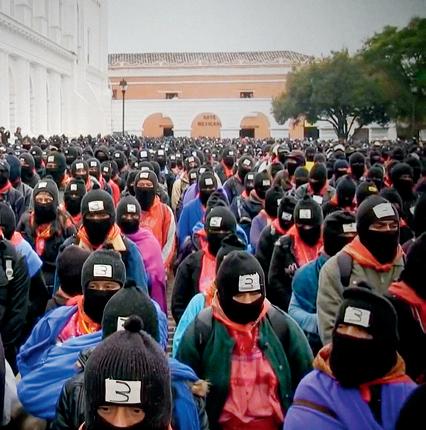
One of the narratives of Latin America today is the problem of migration. The most visible example is undoubtedly that of Mexico as a country of undocumented migrants and the encounters and misunderstandings when crossing the border with the United States. As a counterbalance, the artist Guadalupe Maravilla averts our gaze to a deeper and more unknown south, the so-called Northern
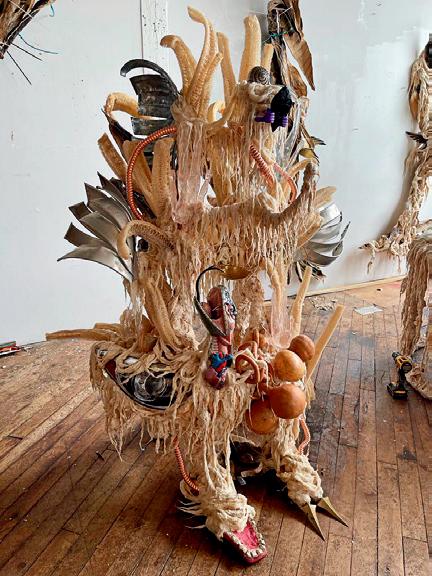
Triangle of Central America, comprising Guatemala, Honduras and his country of origin, El Salvador. During the 1980s, when El Salvador was at the height of the region’s counterinsurgency wars, the forced transit of people fleeing violence and seeking refuge was particularly extreme. Maravilla was one of the many undocumented children who made the journey to the border unaccompanied. Today, the artist
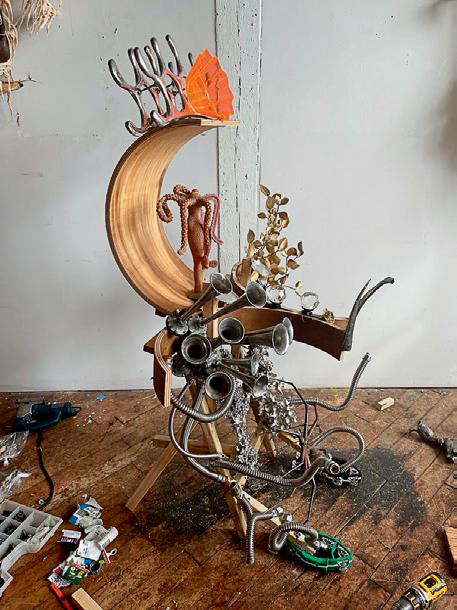
147 146
guadalupe maravilla
revisits this experience to develop a conceptual approach that alludes to the somatizations – in the broadest sense of the term – of what he saw and experienced during the crossing. Like an extraordinary sounding board, Maravilla’s projects tell his own story but also that of thousands of individuals who have been marked by this vast scar called the border.
As a result, his artistic proposals are multitudinous performances
and collaborations, scenographies overloaded with gestures, objects and mechanisms that are installed as altar pieces. In many of them, we find traces of the traditional children’s game known in El Salvador as Tripa Chuca, which results from connecting numbers to lines, as well as drawings taken from ancient codices and canvases with pictographic stories that refer to pre-Columbian communities, their
participation in the conquest, their knowledge networks, commercial traffic and resources. The whole is a map of displacements, miscegenation, syncretism, perseverance and forms of historical survival. At the center of this epic journey, the artist places large-scale sculptures entitled Disease Throwers (2019-ongoing). Their strange and organic shapes are assembled with moldable materials and musical instruments that, with a specific vibration, generate therapeutic spaces that invite resilience. Maravilla’s “healing machines” suggest the opening of portals to ancestors and the performance of a sound ceremony which, in this edition of the Bienal, is the possibility of celebrating a collective ritual to heal traumas and conditions of the body.
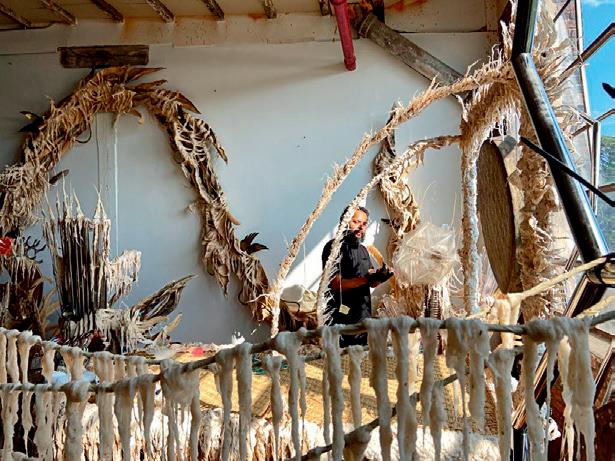
translated from Spanish by ana laura borro
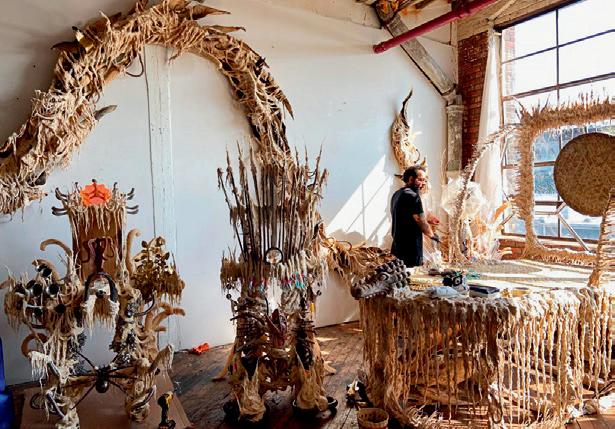 rossina cazali
works in progress in Guadalupe Maravilla’s studio
this participation is supported by: Y.ES Contemporary.
rossina cazali
works in progress in Guadalupe Maravilla’s studio
this participation is supported by: Y.ES Contemporary.
four theses on aesthetics rizvana bradley and denise ferreira da silva
Why rethink aesthetics now, when catastrophe has become the watchword of the day, and when all but the most restrictive pragmatism could easily be construed as little more than bourgeois frivolity? Is this not, after all, the age of Antonio Gramsci’s “morbid symptoms,” in which the many heads of fascism are rearing across the globe? Yet the fascism which liberal modernity and civil society have always required has never abided by this order’s mendacious separation of the political from the aesthetic. Genocide, now as before, is an aesthetic project. The question, then, should not be why rethink aesthetics now, but rather how do we survive the aesthetic regime that carves and encloses the very shape of our question? “The quest(ion) of blackness,” to draw my accomplice Denise Ferreira da Silva’s words from my own mouth, can only be enunciated through losing one’s voice, or rather through yielding to the polyvocality that is always already the condition of possibility of speech. Thus, in writing together, Da Silva and I have not so much pursued a theoretical synthesis as a reticulation, a raveling of the threads of our thoughts, which already twisted and frayed in one another’s text(ilic)s. Four theses, another declension from the Hegelian triad. Our open proposition.
rizvana bradley
A conversation can and usually is taken as an encounter, a convergence, but one that might just be — and the best conversations (which are also another name for collaborations) are — nothing more than that which takes place there, in that moment, under those circumstances, towards those particular ends. This conversation, our convergence, is not so much an offering as it is an invitation to the reader to join in and further it.
— denise ferreira da silva
149 148
infinity
The world, as the totalizing onto-epistemology that is modernity’s genesis, limit, and horizon, is a thoroughly aesthetic conceit. To toil within or rail against the field of representation is already to be enmeshed in the aesthetic, for it is by way of the aesthetic that the ontological ground on which we are said to stand becomes experience. In this register, Man — the transparent I, the universal subject who would make the world, if not just as he pleases — appears, apropos Sylvia Wynter, as none other than homo aestheticus
This is the ontological figure consolidated in post-Enlightenment European thought, whose presupposed capacity for self-determination and self-development is both indistinguishable from the expropriative displacement of ecological entanglement that animates (bio)history, and, further, tantamount to the capacity for aesthetic experience and judgement.
The Subject’s sensus communis, of course, only emerges through the constitutive excommunication of the Savage (the conquered), the Negro (the commodity), the Primitive (the other), and the Traditional (the underdeveloped) — figures who nevertheless come to haunt Man as the bearers of an ontological dissonance, an immanent declension, we might call blackness.
What else can be said about the conquered, the commodity, the other, and the underdeveloped, besides the fact that they apply to all who do not fall within the spatiotemporal borders of the post-Enlightenment figure of Man, that is, the transparent I? Not much, would be the appropriate answer, if all that is taken into account is what is offered by way of the constraints of dichotomist thinking. That is, if the question were not raised about the conditions under which the universal protective force held by the ethical would be extended to some humans (whether that force is bequeathed by the divine ruler or author, in their mastery of the transcendental form that is reason). If the question were not raised, that is, about why blackness is so “naturally” visited by total and symbolic violence.
When the categorial force of blackness is confronted with the total violence that its historical trajectory
cannot but recall, it cannot but refract and fracture the transparent shoal (the threshold of transparency) that protects the Subject’s onto-epistemology across his scientific and aesthetic moments. The total exposure of blackness both enables and extinguishes the force of the modern ethical program, insofar as the disruptive capacity of blackness is a quest(ion) toward the end of the world.
Blackness is a threat to sense, a radical questioning of what comes to be brought under the (terms of the) “common.” If the ordered world secures meaning because it is supposed to be knowable, and only by Man, if that world is all the common can comprehend, then blackness (re) turns existence to the expanse: in the wreckage of spacetime, corpus infinitum.
re/de/composition
Thinking the artwork as poethical, as “a composition which is always already a recomposition and a decomposition of prior and posterior compositions,” requires being poised for the advent of becoming as matter, and its immanent interrogation of the temporality of forms.1 In contradistinction to understandings of the artwork as an autonomous totality, or those that would consign the artwork to some iteration of Kant’s forma finalis — that is, the reductive ascription of a formal purposiveness to the object — a poethical reading stresses the provisional ground where questions of form, formlessness, and abstraction collide.
The artwork, a singular composite, need not simply anticipate or reiterate questions which presume the formal principles of external causation (causa efficalis), interior determination (causa finalis), or abstract perception (causa formalis). For these senses, calcified as the only tools for comprehending nature (the realm of objectivity) and world (the kingdom of subjectivity), have sustained the tautology of modern thinking precisely through being rendered axiomatic. Once released from the anticipation of order and the presumption of meaning, the artwork becomes liberated from its representational obligations to nature and world. As a poethical piece, the artwork extends the question(ing)s of causa materialis, the undeterminable of contemplation. (Re)turning in and as form(s), a poethical descriptor for existence presumes neither linearity nor its predicates, separability and determinacy. The reorientation poethical art invites expresses the infinite re/de/compositions that normative spacetime would foreclose.
The axial intensities of verticality and horizontality, the strict linearity, the primary coloring, that signal abstraction’s formal legacy, do not so much indicate a restrictive geometry or truncated chromaticity as an open set, where, for instance, even the fidelity of a line or the vertices of a square may be exacted with improvisatory
1/ Denise Ferreira da Silva, “In the Raw,” e-flux journal, no. 93, Sep. 2018. Available at: www.e-flux.com/journ al/93/215795/in-the-raw/. Accessed in: Sep. 2023.
emphasis. The poethical work deforms the teleological imperative of purposiveness, and the racial demarcation of the (in)capacity for aesthetic judgement this imperative necessarily (re)inscribes. The poethical work tends toward the revelation that such an effort to reduce, discipline, and contain the unwieldy materiality of the world is always already an exercise in futility.
We might think both of seriality and deformation not as formal deviations from the major paradigms of modernist art, but as aesthetic practices which enact the decomposition of the art historical canon, and of canonicity as such. Such decomposition is achieved not by a method of subversion, but by the accumulation of surreptitious (re)turns, which gather ruinously beneath the sign of the authoritative artwork. The serial proliferation of returns exposes the autonomous artwork as itself nothing more than a re/de/composition, a contaminated assemblage of citations and de/formations.
151 150
seriality
The perennial failure of homo aestheticus requires the perpetual renewal of the aesthetic, an operation which, irrespective of its beauties or horrors, cannot help but be the renewal of catastrophe. But this history of aesthetic revitalization is preceded and exceeded by another kind of innovation, which we may call aesthetic, even as the aesthetic can never account for it. What, then, might open and be opened by an inquiry into black practices of seriality? What takes form, or is deformed, in “the diffusion of terror and the violence perpetrated under the rubric of pleasure, paternalism, and property,” as Saidiya Hartman proffers?2 How to come to terms with such serial self-fashioning without recourse to an idea of the open in which boundlessness becomes only another name for frontier, which is to say an enclosure, an expropriation, a clearing?3 For the interminable historicity and impossible history of blackness has always come before the horizonality of Man’s freedom, as its effaced footing and ineluctable limit. How do we regard the insistent and ongoing re/de/composition of the (black) figure, in the midst of contemporary art’s simultaneous exaltation and reduction or relegation of the figural to the scene of racial representation? How do we comprehend such figurations as part of a suite of interventions — an epigraphic seriality, as Fred Moten might put it — which denotes not the refusal of serially imposed violence as political end, but rather the reanimate means through which any aesthetic inquiry into the social life of form must pass?4 We insist that, even as such means bear the terrible burden of diffusive terror and the terror of diffusion, black seriality cannot be thought of as reducible to separability, sequentiality, or the determinacy of individu-
2/ Saidiya V. Hartman, Scenes of Subjection: Terror, Slavery, and Self-Making in Nineteenth-Century America. Oxford: Oxford University Press, 1997, p. 4.
3/ Cf. Tiffany Jeannette (Lethabo) King, “In the Clearing: Black Female Bodies, Space and Settler Colonial Landscapes.” PhD diss. University of Maryland, College Park, 2013.
4/ Fred Moten, The Universal Machine. Durham: Duke University Press, 2018, p. 230.
ated forms and objects. In other words, our aesthetic thinking refuses to presume black seriality as wholly coterminous and coextensive with the serial imposition of antiblack violence that constitutes the modern field of representation and the history of form, as if the violent enumeration of black bodies were truly a ledger of or accounting for injury. Here, black art finds an anticipatory rapport with avant-garde art movements and their respective performances of refusal — the rejection of modernism’s gridded dispossession, for instance, which is also a cartography of disposability, disregard, abusive violation, cultural erasure, and social death. However, the very fact that these performances are both denied to and refused by blackness throws into sharp relief the radical disjuncture between these respective modalities and traditions of artistic labor. Black artistic labor, which takes the fabric and substance of social existence as an alternative means of production, refracts the conceptual legacies of the autonomous totality of the artwork, and wonders about the image left on the retina. Rather than thinking blackness as difference notwithstanding worldly violence, we regard the serial recomposition and decomposition of blackness as incitation to an utterly divergent gestic imagination. Our critical attentiveness to these incitements remains attuned to a gestural difference that is irreducible, both to the serial violence of the racial regime of representation and to the so-called “politics” that clamors for recognition within it.5
5/ David Lloyd, Under Representation: The Racial Regime of Aesthetics. New York: Fordham University Press, 2018.
generativity
If the poethical artwork is no longer preoccupied with the perils of departing from the onto-epistemology of modernity, and its rendering of existence through the certainties of being, then how might aesthetic considerations start from and stay with the “object” — which is at the same time “thing” as well as “commodity” and “other” — without returning to Man or the Subject, the Human or Humanity, the Ego or Subjectivity.
If our aesthetic thought begins with the “other” as commodity, as Hortense Spillers recalls, does it unavoidably (re)confront the violence that is modernity’s condition of possibility, devastating any solace that might be found through the figurations of the colonial, racial, and cis-heteropatriarchal matrix?6 Does such a thought inevitably reinscribe subjugation as origin and horizon? Or does the aesthetic, as thematized in and as black existence, as a radically disruptive ethical orientation, stage a devastating confrontation with modern philosophy that ultimately targets its aesthetic, theoretical, and ethical ground? What happens when blackness guides considerations of the aesthetic, the ethical, and the theoretical?
Here are two propositions: (a) Black Study recalls the sonic and mobilizes it against the discursive closure of blackness in pathology, and (b) in doing so, disarranges the post-Enlightenment onto-epistemological field. Blackness (as object) unsettles the (aesthetic) ground upon which the transparent I emerges. For this reason, the analysis and poiesis of Black Existence challenges the tenets of Social Theory and Aesthetic Theory alike precisely because, as a referent to total violence, it breaks through the enclosure that is discourse and exposes the limitations of both post-Enlightenment versions of modern ontology, the philosophical and the sociological.
Black Study reorients the conversation in the contemporary international art scene, as it introduces to the
6/ Hortense J. Spillers, “Mama’s Baby, Papa’s Maybe: An American Grammar Book,” Diacritics, v. 17, no. 2, Culture and Countermemory: The “American” Connection, pp. 64-81, Summer 1987.
critical tools of contemporary philosophy a set of concepts, formulations, and questions that bypass, without ignoring, what would have otherwise remained the latter’s undisturbed Eurocentric core. Black Aesthetics — that is, that which fosters, facilitates, and modulates “black enunciation” — signals an other site for the analysis of artistic creation, collective existence, and political practice. As such, it provides the basis for a project that militates against and serially undermines the modern liberal political architecture, in its violent post-Enlightenment configuration and operations, as well as the fascistic doubles that liberalism at once requires, solicits, and half-heartedly decries. Black Aesthetics is an utterance that, in its immanent derangement of modernity’s grammar, marks and is marked by the art of passage without coordinates or arrival, the art of life in departure.
153 152
The work of the alchemist has often been labeled “black work” referring to nigredo (“darkness” or “blackness” in Latin), the first step of the alchemical process, which means putrefaction or decomposition. Hence, the terms black work and blackness take on nihilistic implications. However, the alchemical processes of Ibrahim Mahama’s black work and blackness are about possibilism and the transmutation of coloniality.
Whether the colonial plantation, parliament hall, the railway, or other legacies of colonialism, the enclosures of coloniality are as systematic and interconnected. Mahama’s work sees possibilities in the material conditions of such enclosures and their abilities to tell stories and to connect moments in time along the extended arc from colonialism to globalization. These moments intersect with questions of labor, extraction, production,
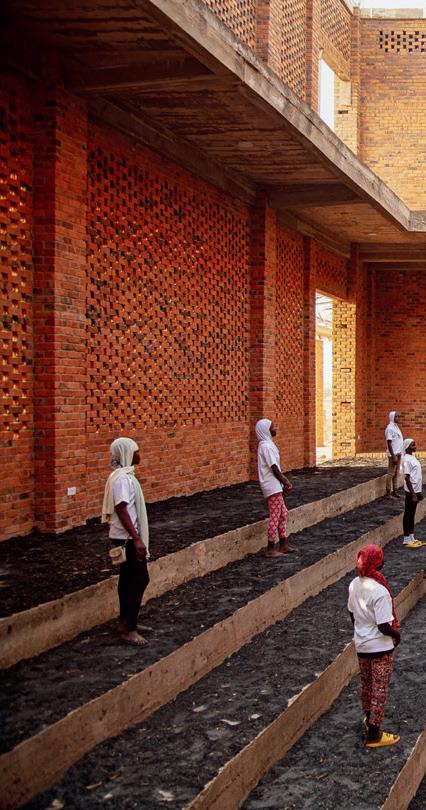


155 154
ibrahim mahama
exploitation, and justice. The materials of his practice are the unextraordinary evidentiary objects that reveal systems of crisis or failure; yet, the artist’s transmutations yield poetic conditions of assemblage, assembly, and collectivity.
In his 2017 installation NonOrientable Nkansa II, Mahama together with several collaborators produced hundreds of wooden “shoe-maker boxes” from scrap
materials found in Kumasi and Accra, Ghana, and used for polishing and repairing shoes. These boxes contained the tools of “shoeshine boys,” often impoverished youth who daily navigate the city to polish or clean shoes for money. Mahama gathers together and stacks these hundreds of boxes into a monumentally scaled wall where each box seems precarious yet impossibly held in place.
Parliament of Ghosts (2019) is an assemblage of discarded and lost objects brought together to form the setting for a parliamentary hall and to recall the history of Ghana Railway company. The objects included in the work are found elements related to the history of production and the crisis of industrialization in colonial territories. The objects include abandoned train seats and railway sleepers, government documents, objects from a locomotive workshop, journals, maps, books, and archival furniture.
In his latest work, Mahama creates a space of assembly that is in dialogue with his previous Parliament of Ghosts, yet transmuted to become a location for collective black work, cultural production, and discourse during the 35th Bienal de São Paulo. The space reproduces the red brick bleachers in the hall of his RED CLAY studio in Tamale, Ghana. The installation also includes a set of vases from Ghana, and railroad tracks which reference the geography of the north of Ghana where the studio is located.
mario gooden
 Parliament of Ghosts, 2019 Red Clay Studio, Tamale (2019)
Parliament of Ghosts, 2019 Red Clay Studio, Tamale (2019)
igshaan adams
The artistic output of Igshaan Adams consists in producing beauty from materials considered to be of little value, but which are deeply connected to the everyday life of the non-white working classes who still live in the so-called South African townships.1 His works materialize experimentations by working women and men, based on their tensioning agency of everyday life marked by racial segregation,

157 156
Kicking Dust, 2022 Installation view, Kunsthalle Zürich, (2022)
inequality, and poverty. Sharply demarcated urban lines weaken, bend, become sinuous, and defy straight, rigid lines imposed by the Apartheid regime and its reminiscences in contemporary times.
Bonteheuwel, founded in 1960, is the birthplace and setting of the artist’s childhood memories, who lived in a Muslim and Christian home influenced by multiple traditions. The lines that rigidly divide the two
sides of the city inspire Desire Lines (2022), a work that represents the shortcuts created by underprivileged workers who defy the harshness of urban layouts. Tapestry, a traditional South African craft, is the art through which Adams materializes these alternative paths, rivers, structures through which the city is (un)organized.
This tapestry is composed of ordinary objects, colored beads,
shells, whelks, wire, and colored fabrics tightly woven together, producing immense multicolored carpets. As well as tapestry, other works by Adams also show the efforts of working classes to adorn their daily lives, and, paradoxically, reaffirm and remind them of their social place, of joy or pain, of poverty and hope for better days.
It is in this somewhat dreamlike beauty, which reveals meanings both material and aesthetic, that the artist foregrounds the agency of the working classes. From these impoverished materials – regarded as worthless, commonplace, which, if they carried traces of the lives of the elites would be considered relics, museum pieces – Adams composes flowers, dust in the air resulting from people dancing who dress in ecumenical fabrics inspired by sacred objects. The domestic takes on sensitive and intimate meaning, surpassing reality and taking on unthought, almost impossible forms.

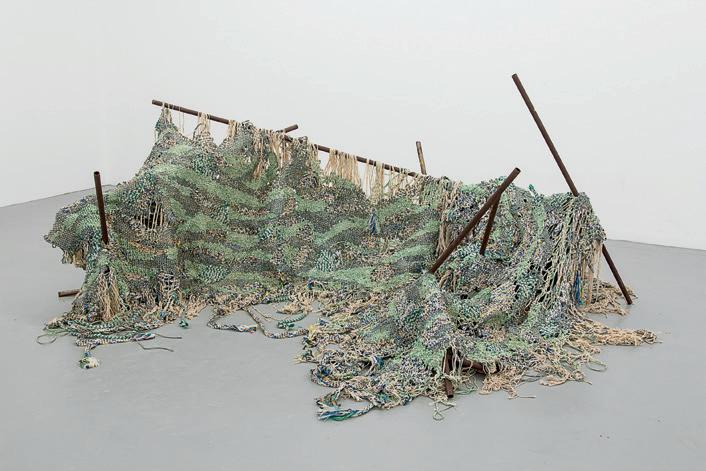 luciana brito
luciana brito
translated from Portuguese by philip somervell
1/ Areas created during Apartheid to confine black and mixed-race people.
Desire Lines, 2022 Installation view, The Art Institute of Chicago (2022)
Igshaan Adams in collaboration with Kyle Morland Stoflike oorskot, 2016 Dusty Residue. Woven nylon rope, string, and mild steel, 300 × 120 × 240 cm
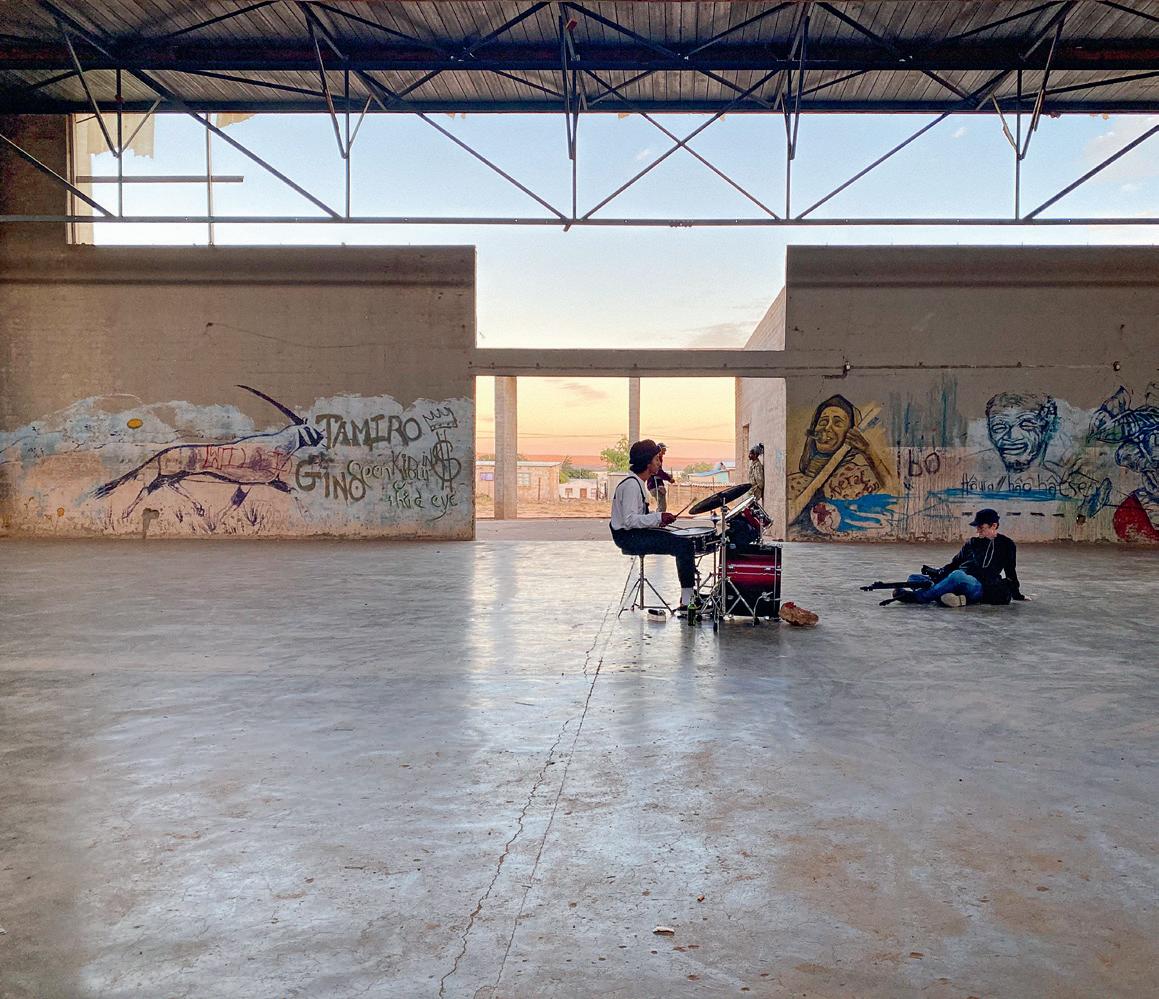
159 158 ilze wolff
A “practice of care” is a practice of refusal that engenders regard, generosity, and conviviality within and among conditions that would otherwise be represented as abject. Ilze Wolff’s practice of care begins with the recognition of spatial relationships followed by a process of revealing the unexpected and the uncanny among the residue, detritus, depleted conditions, exhausted resources, and overlooked details
and existences of daily life. This kind of care is a reclamation of history, self, epistemologies, and liberty that are a priori to European colonization and enlightenment. It is a cultural production of the previously unimaginable yet previously known that produces a poetry that is not romanticized, fetishized, or made sentimental.
In the late 1970s, the design and construction of the Steinkopf
Community Center was commissioned by the Anglo American company which mines platinum, copper, diamonds, thermal coal, and iron ore in South Africa. Steinkopf was founded as a religious mission in 1817 by the London Missionary Society among the San indigenous people of northwest South Africa. The population of the town at the time of the construction of the center was approximately 6,000 people most of whom were women and children; for most of the men lived and worked in the mining camps in the Western Cape. “The intention was to provide an inviting building, accommodating all the needs of the people and which also opens up more environmental options for the community. It is designed to serve the community and not the reverse.”1 The irony of this statement and the architectural design is not lost in Ilze Wolff’s Hophuis, an Afrikaans word that translates to “hop house”. Yet, using personal narrative; music and sound; photographic history, architectural representations, and elements of the area’s natural ecology, Wolff’s installation reveals a “choreography of care and conviviality” that survives the entanglements of religious suppression, systemic racism, and economic exploitation and extraction. Wolff uncovers how the building bears witness to the local indigenous knowledge, memories, stories of joy, liberation, mutual support, and solidarity of those people who used the center as a gathering space and a site of resistance.
mario gooden _
1/ Architecture SA, Spring 1980, p. 13.
 sounding the Steinkopf Community Centre with drummer Fernando Damon and Heinrich Wolff, 2020
sounding the Steinkopf Community Centre with drummer Fernando Damon and Heinrich Wolff, 2020
inaicyra falcão
The historical and artistic being of Inaicyra Falcão could constitute the transgression of concepts – such as erudite, lyrical – or of what is accepted as possible. Her ancestrality, as motor and inspiration, and the choreographies of her world – broad, transnational, and diasporic – break with the rigidity of academia and art. From her poetic voice, other sounds could emerge, but what blooms is an ancestral
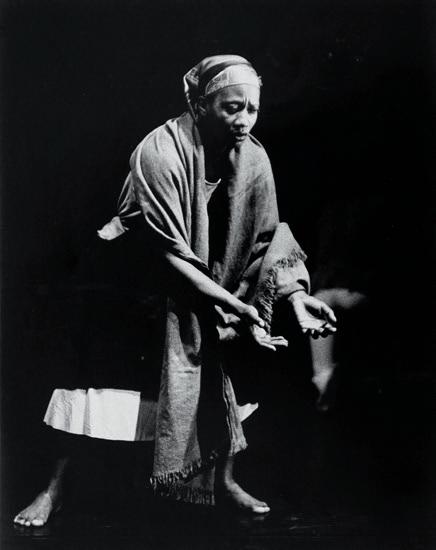
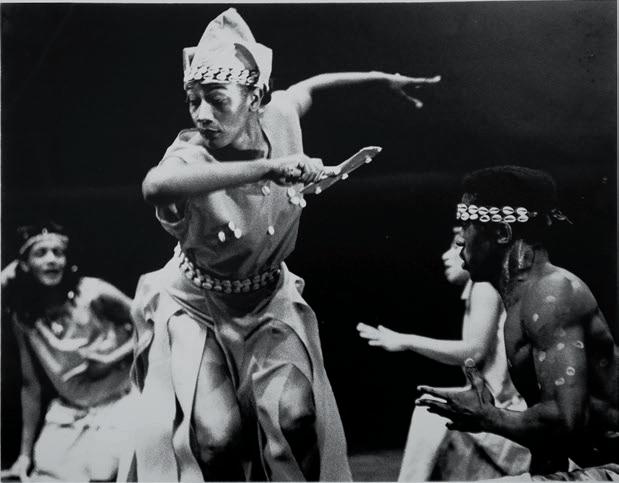

song. Loose and liberated, her body exhales memories of ancient and refined movements, repeated millennia ago in human daily life, and of sacred divinities, which can still be observed today, when they are on Earth.
As Inaicyra’s art shows, the impossible happens when the power of the body, of the physical explosion provoked by the need for movement, is present, even in sacred
161 160
Ebó Iyê, c. 1989
Dance group at the Universidade Federal da Bahia (UFBA), undated
deities. Therefore, for the artist, all bodies are endowed with memories, ancestral inscriptions, which reveal themselves in the body consciousness forged in tradition. This movement is cultural, collective memory, but, above all, it results from our personal histories and from crossings that inhabit the bodies of black people of the diaspora. Personal freedom, therefore, depends on this body being in movement.
From this perspective, education would be another path to autonomy, but, at this point, through dance. The recognition of each individual story, the embracing of conscious or dormant memories, would be part of this learning, which runs counter to the knowledge of repetitions, of what is considered harmonious or erudite. This was the path found by Inaicyra to bring African heritage into the curricula.
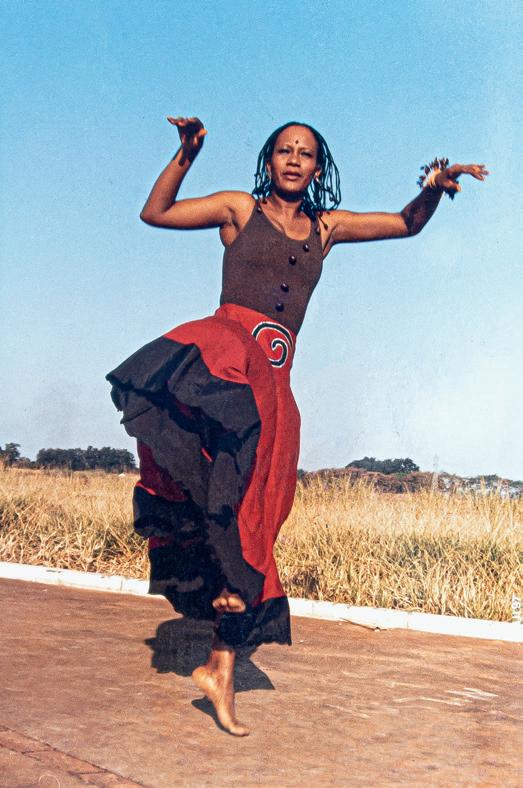
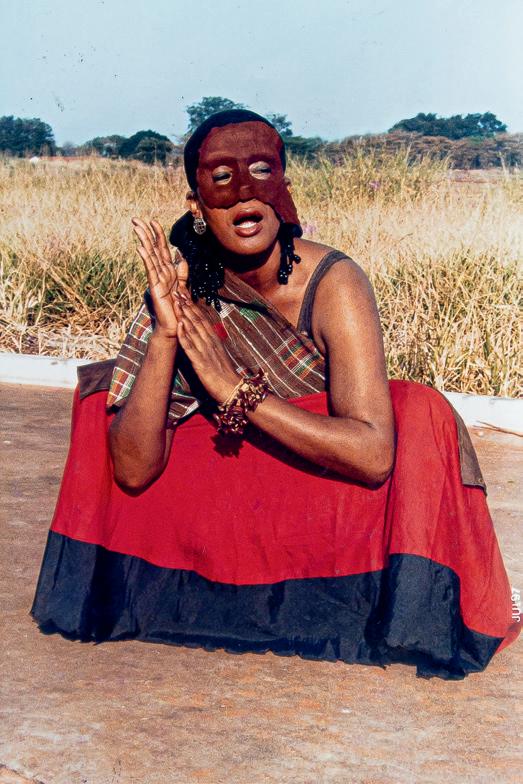
Far from meaning being stuck in a sealed past, her perception of the world and of art reveals change, dynamism, and constant transformation of ancestral movements and songs. Thus, Inaicyra Falcão defines herself as an “articulator of universes,” of multidimensional worlds, which she connects to the body and voice.
luciana brito
translated from Portuguese by philip somervell
Ayán – Símbolo do Fogo, undated Symbol of Fire
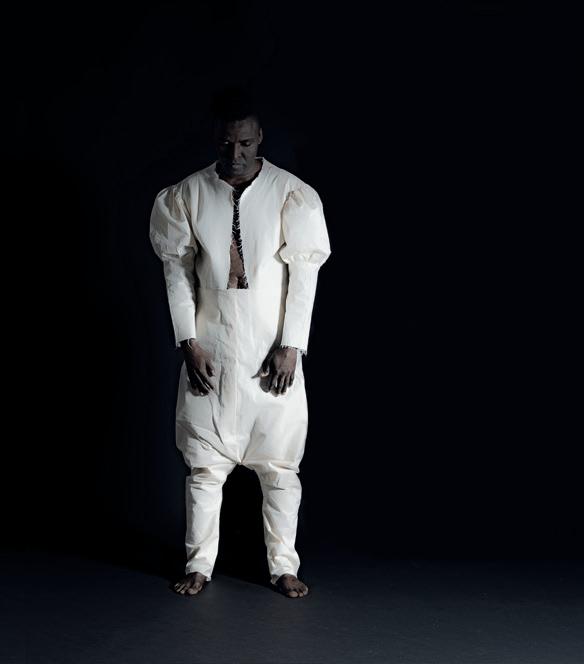




163 162 januário jano
In the photographic installation Baptism (2019), we observe a set of twenty photographs showing Januário Jano taking off white clothes. The exuberance of the image of the whole draws attention. However, in the research of the materials, any disinterested contemplation is dissolved: the white clothes are memories of the civilizing impositions of the Portuguese colonizers on Angolans. The fabric,
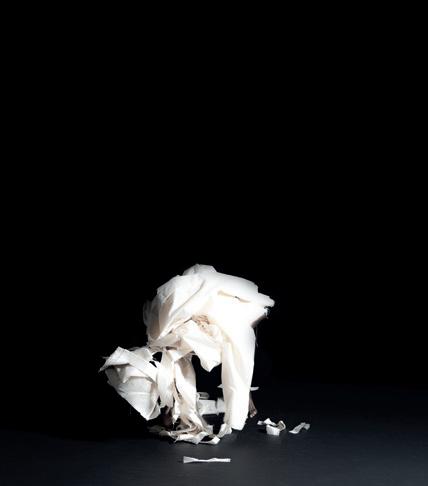

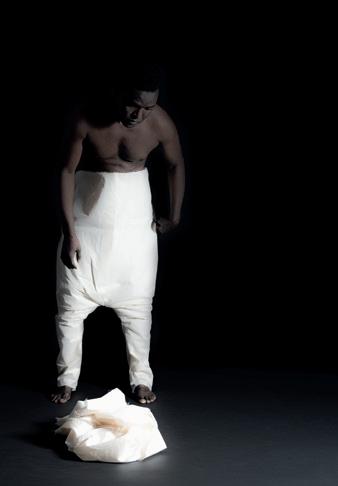
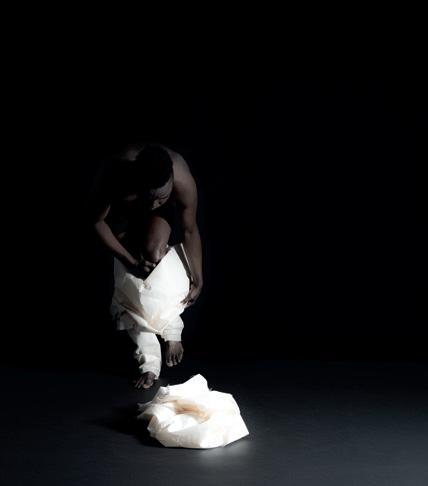
100% cotton, refers to the fields of Baixa do Cassange, where the massacre that ignited the struggle for Angola’s liberation took place in 1961. This dimension of violence – especially the response to it –emerges from a craftsmanship that understands research not as a stage to reach a product, but as the living matter to which the gaze must constantly return when it is willing to propose other worlds.
Video, sculpture, painting, photography, installation, sewing, or interdisciplinary art, if you will. The repertoire of languages that Jano uses to put his ideas into practice is vast, as is vast and unsettling the range of forces that underlie all artistic making as a consequence of history and culture. There are many media, layers, and themes that are in friction when considering the complexities of the field of cultural identities, a terrain in which he operates to instigate debate. From Luanda, in Portuguese, but also from the land of the Ambundu, in Kimbundu – Bantu language – or in English from London, where he trained and settled. The artist’s own biographical transits highlight the marks of colonization, a central theme in his work; also for this reason, it is before himself – the mirror, his history – that Jano finds the raw material that occasionally escapes his own life and ends up echoing in the words of a fellow countrywoman of his: “surviving our history is akin to surviving in an unforgiving city” – said Djaimilia Pereira de Almeida, as he might have said himself.1
igor de albuquerque
translated from Portuguese by philip somervell
1/ Djaimilia Pereira de Almeida, "Morrer de Nostalgia" in Revista Quatro cinco um, São Paulo, jun. 2023, p. 8.
Baptism, 2019 Edition 1/3 + 2 AP. Inkjet on 100% cotton fine art paper rag. 50 × 44 × 2 cm (20 pieces)
jesús ruiz durand
Between 1969-1974, Jesús Ruiz Durand produced a series of posters to publicize the Agrarian Reform initiated by the government of General Velasco Alvarado in Peru. Under the notion of pop achorado – an expression that means “rebellious, insolent, indignant, belligerent, vulgar, choleric, insurgent, insubordinate” – this graphic style took the pulse of an indigenous population that broke up with the slavish submission that, for centuries, had made the Peruvian plantation and the relationship between the pongos and the gamonales1 a hotbed of cruelty.
Through his work for the Land Reform Promotion and Diffusion Direction, Ruiz Durand travelled around the country, photographing and talking to Quechua-speaking peasants who were recovering lands. He developed a technique that consisted of fragmenting the image through a process of solarization (or sabattier effect), distributing flat colours by areas, reframing them like comic strips and printing them in offset in CMYK process. Experimenting with dots and patterns, he invested an outline of phosphorescence, vitality and optimism to the indigenous bodies that seemed to set foot outside the waiting room of history, incinerating the symbolic and material bases of servitude and dispossession in Peru.
Styling an old illustration from school books of the face of Tupac Amaru II, Ruiz Durand designed the logo of the Agrarian Reform, which was the central figure in two posters, one yellow and the other blue. Eclipsing the silhouette from the front and in profile, inserting it into geometric compositions and optical and chromatic reverberations, Ruiz Durand made the face of one of the leaders of the fiercest Andean insurgency of the
eighteenth century against the Spanish invasion more dynamic, giving it a vibrant physiognomy that could mutate, multiply and light up, through superimpositions and lighting effects. Through a kinetic formal synthesis, he synchronized the anti-colonial messianism of Tupac Amaru II with the revolution in progress.
But in the undulating and yellowish contours that envelop the peasant bodies holding tools or working the land, it is also possible to see the light of the eclipses, under which the inhabitants of the altiplano “walk full of foreboding,” as Arguedas writes. The Agrarian Reform, as a continuation of the anti-colonial war by other means, was and is an instant of danger. This flickering light anticipated, in its shadows, the murmur of violence that would come just a few years later, with the internal war between the Shining Path (Sendero Luminoso) and the Peruvian state. It retains the endless rage of the pongo, “that rage that burns in the seed of his heart, like a fire that will not go out.”2
fernanda carvajal
translated from Spanish by ana laura borro
1/
165 164
Pongos were the peasants and indigenous people who worked as servants on the plantations in Peru and gamonales were mainly landowners from the highlands, who exploited the labour power of the pongos in a regime of serfdom, very similar to the feudal form [NT].
2/ José María Arguedas, “Carta a Hugo Blanco-1969”, in Hugo Blanco (ed.), La verdadera historia de la Reforma Agraria. Lima: Ediciones Lucha Indígena, 2009.
from the series Reforma Agraria Peruana – Grandes cosas están pasando, 1970 Peruvian Agrarian Reform – Great Things Are Happening. Offset print on paper, 100 × 70 cm
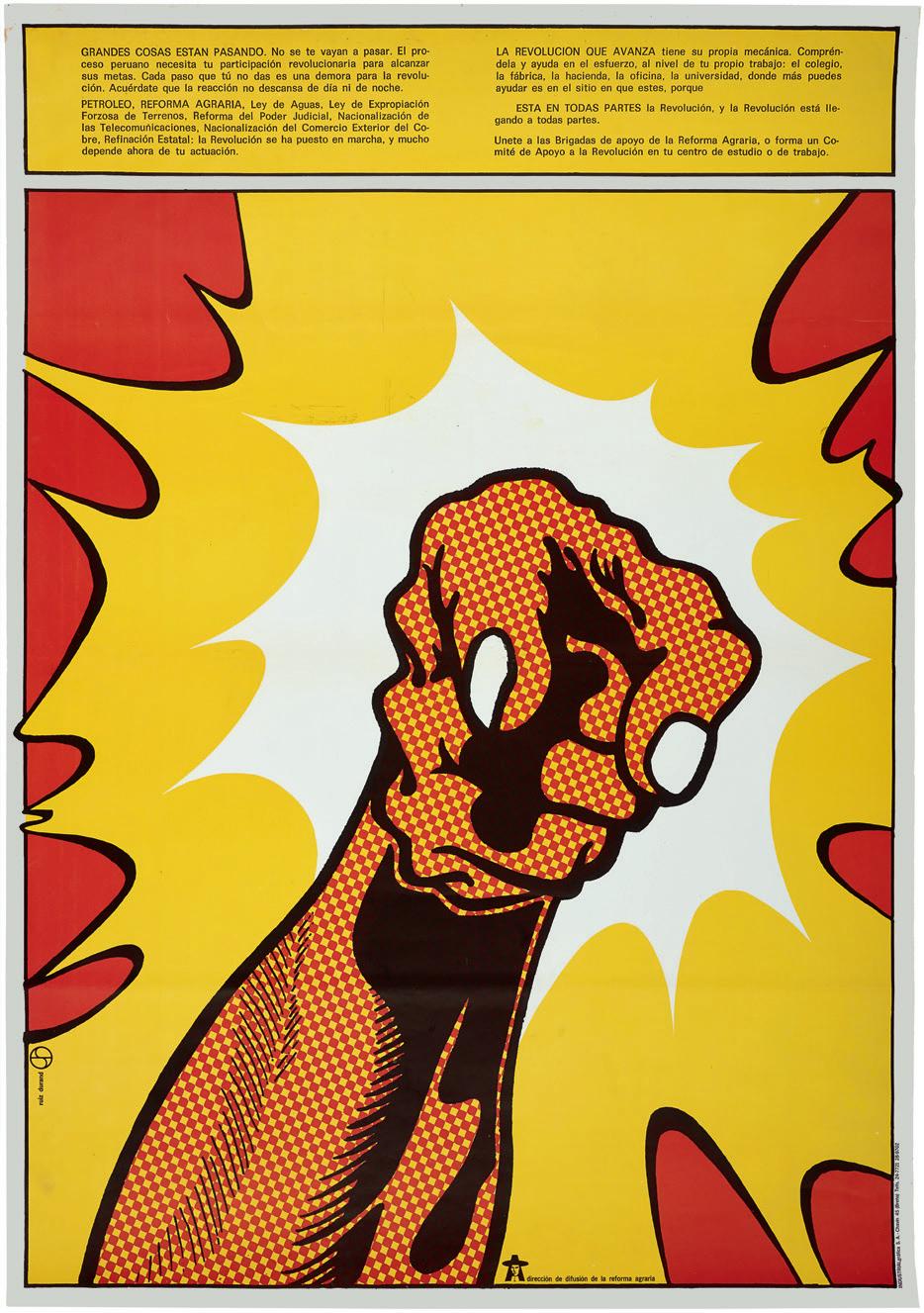
jorge ribalta Faute d’argent [Lack of Money] (2016-2020) is the third and final episode of an artistic and historical investigation by Jorge Ribalta on the final period of Charles V (15001558), King of Spain and Holy Roman Emperor. Under his reign, the shaping of an idea of nationhood ran parallel to the conquest and colonization of the West Indies, inherited as the grandson of the Catholic Monarchs. The approach is twofold: the man-
ifestation of Charles V as a key to interpreting the Western world in the era of the great economic recession that began in 2007; and an exercise in reviewing and mourning the Spanish/ imperial colonial past, resulting in a critical choreography of return.

The series is based on the “documentary idea”, which runs through all of Ribalta’s work, whether as a photographer, theoretician-researcher or curator, as he argues that photogra-


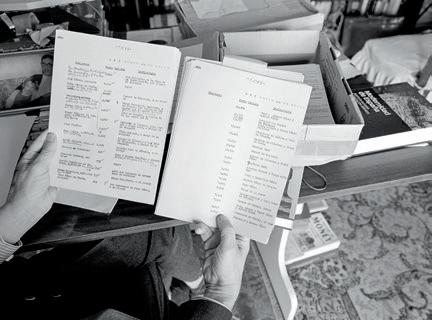
167 166
Seville, Emporium of the Indies (detail), from the series Faute d’argent (Eight Short Pieces), 2016-2020 Lack of Money. Gelatin silver prints
phy contributes to explaining social complexity – class relations and their conflicts, as well as the relationship of subjectivities with history – and not just representing it. In Faute d’argent, Ribalta questions both the history of the Spanish nation and the imperial-financial logic of capitalism since the early Modern Age in Europe, which spills over into a coloniality of power. Its title sums up the dialectical relationship between the Emperor in
decline and his bankers, the Fugger saga, that is, between necessity and the indebtedness that guaranteed imperial status in the 16th century, to the detriment of the nation (Castile) and the Indies, turned into mere instruments of an extractivist colonial policy. Having no metaphors, the episode is a tragicomedy made up of 76 photographs – rhythmized by the notes and quotations in the margins – that traces the names and geogra-
phy on which the Habsburg empire and the Spanish nation were built in order to subject them to a critique against the grain from the inherited discomforts. Thus, photography acts as a counter-discourse in revising one of the founding myths of the Spanish Empire and is an instrument from which to question European modernity from the perspective of coloniality in America. In this sense, the series searches for the spectre of those bankers today in the geographical axis Augsburg – Seville – Mexico, in its streets, chapels and churches, museums, libraries, mines and workshops, which are a transcript of the gold, silver and chocolate transformed into coins, ingots and grains.
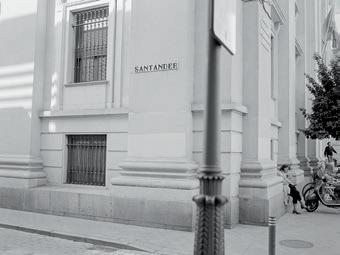
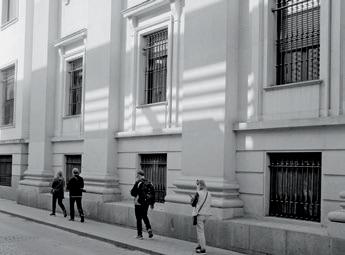
rocío robles tardío


translated from Spanish by ana laura borro
 this participation is supported by: Acción Cultural Española (AC/E) and Embajada de España en Brasil, and held in partnership with Institut Ramon Llull.
this participation is supported by: Acción Cultural Española (AC/E) and Embajada de España en Brasil, and held in partnership with Institut Ramon Llull.
josé guadalupe posada

Calavera oaxaqueña, calaveras rotas y garbanceras, undated Oaxacan Skeleton, broken Skeletons and Garbanceras Skeletons.

169 168
Zincography, 14,6 × 25,5 cm
Playing with death, be it tag, hideand-seek or, for the more cerebral, a game of chess. Just to kill time, our gravedigger. But not forgetting the materials needed to eternalize the encounter: stone, paper, scissors, pencils, inks, chisel... In the case of José Guadalupe Posada (1852-1913), lithography was chosen, because only then could his engravings become viral in prints, reprints, and reappropriations that
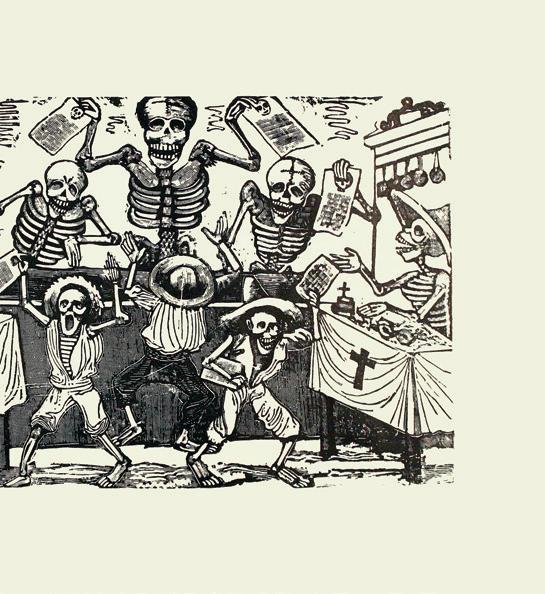
are repeated before the eyes of the living. A choral memento mori –works echoing in Latin the litany of “remember that you too will die”.
Posada belongs to that small group of artists whose works are automatically recognizable, even if you don’t know who they were authored by. His celebrated calaveras [skeletons] draw energy from the cheap pages for which they were intended and are part
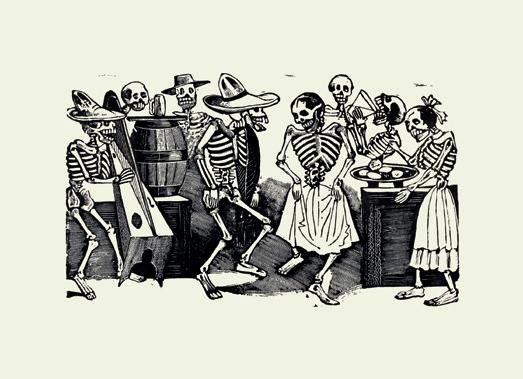
of Mexico’s living-dead history. The Gran calavera eléctrica (1907), La calavera oaxaqueña (1900), La calavera revolucionaria (c. 1910) and, above all, La calavera Catrina (1910/1913) are memento mori memes that predate the World Wide Web. At once a joke and a philosophical reflection, a celebration of death and cultural resistance to colonization. Interested in producing in the tradition of what has come to be called popular art – a questionable and ambiguous category – Posada’s reach extended to the illiterate (the majority of the population at the time) and increased throughout the 20th century in the context of an appreciation for indigenous, pre-Columbian, and contemporary cultures.
He produced caricatures and illustrations for several newspapers in circulation during the tumultuous late 19th century until 1913, when he died in anonymity. He was published in many pro working class newspapers, but his affiliation with revolutionary ideals is not settled. However, there remains one undeniable constant in his satirical verve: ridiculing the bourgeoisie that feeds off the exploitation of the people. This fact is present in the lines that go from the costumbrista phase to his late production, culminating in the hat on the skeleton of the socialite Catrina.
igor de albuquerque
translated from Portuguese by philip somervell
Calavera de muchachos papeleros, undated Newspaper Boys Skeletons. Zincography, 15,1 × 23,1 cm
El jarabe de ultratumba, undated Jarabe Dance after the Grave. Zincography, 28 × 43 cm
y león

171 170 juan
van der hamen
Between 1625 and 1628, after being absolved by the Pope and shortly before embarking on his return journey to the so-called New Spain, Antonio de Erauso was immortalized by Juan van der Hamen y León (Madrid, 1596-1631) in the Retrato de Doña Catalina de Erauso. La monja alferez [Portrait of Doña Catalina de Erauso. The Nun Ensign].
Erauso, also known as “the lieutenant nun”, was born as a woman
in 1592 and defied gender norms in the 17th century. Until not so long ago, many scholars, probably influenced by the reading of Erauso’s biography, considered the painting to be part of the Baroque tendency to represent “the monstrous”. This trend, which gave rise to a whole genre in itself, formed an amalgam that included bodies outside the norm and identities without a prefixed definition.
However, although such images were particularly abundant in the Spanish context in the first half of the 17th century, the Portrait of Doña Catalina de Erauso seems to question them on the basis of its own exceptionality. The particularity of the work makes even more sense when one considers that the writing that frames it – which establishes a clear dissonance between image and text, the reason why this anomaly was explained –was a later addition.
By reproducing the conventions of representation of “the masculine” of his time, Van Der Hamen’s composition of the character unwittingly contravenes the painting’s posthumous title. Dressed in military garb and holding a steady gaze, the image of the lieutenant unambiguously adheres to the dominant regime of visuality of the colonial era, with all its dictates around gender, sexuality, race, and class.
This constellation of interpretations, of visual and discursive appendices, has been recovered by Cabello/Carceller. In the exhibition Una voz para Erauso. Epílogo para un tiempo trans [A Voice for Erauso. Epilogue for a Trans Time], the work once again displays its mutable and exceptional character and, between past and present, confirms the performativity inherent in every portrait, every story, and every construction of identity.
beatriz martínez hijazo
translated from Spanish by ana laura borro
Retrato de Doña Catalina de Erauso. La Monja Alferez, c. 1625 Portrait of Doña Catalina de Erauso. The Nun Ensign. Oil on canvas, 57 × 46 cm
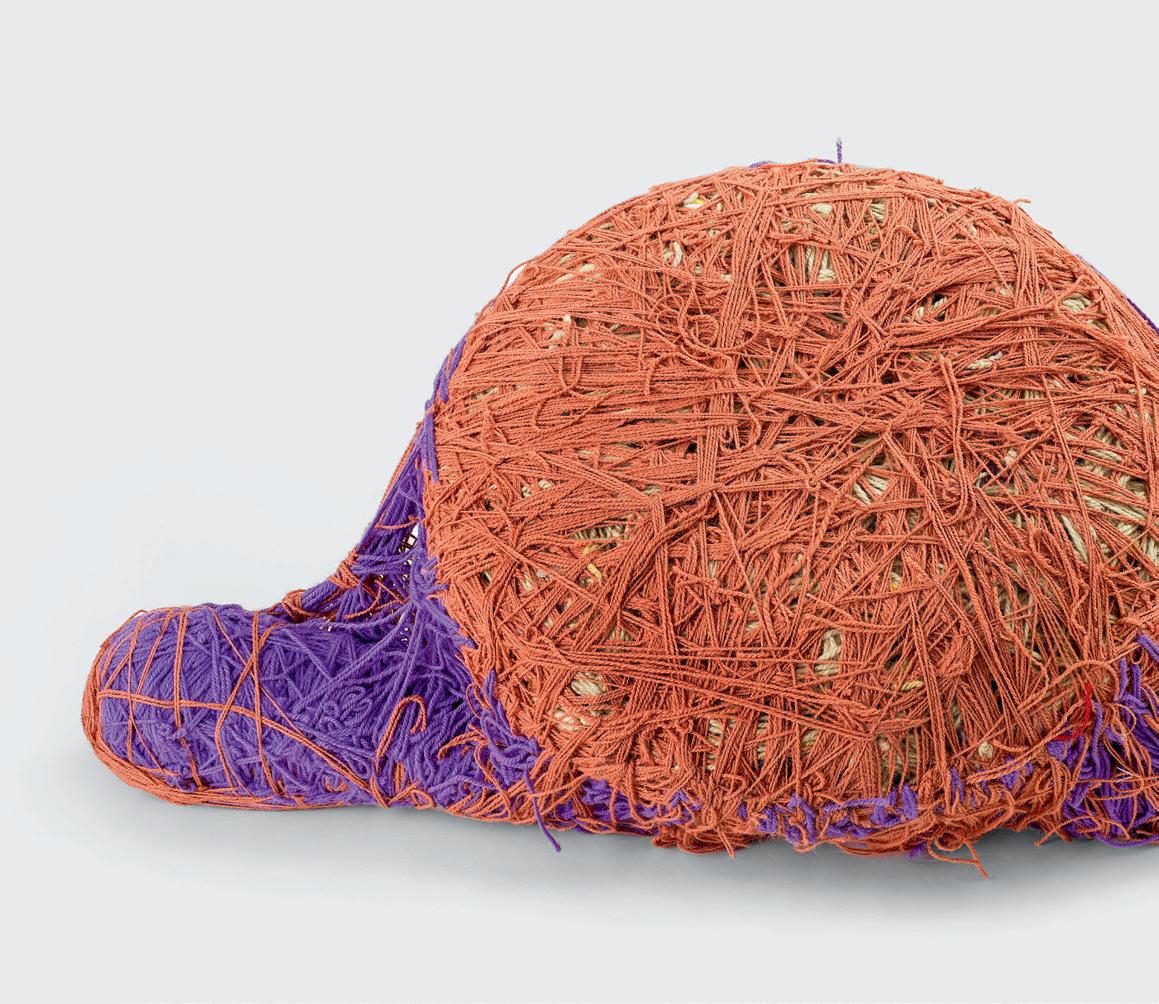
173 172 judith scott
Judith Scott (1943-2005) made her first sculptures in 1988. Although their forms became more complex over time, they all shared a similar principle: a nuclear structure of found objects wrapped in lattices of wool, fabric and other everyday items.
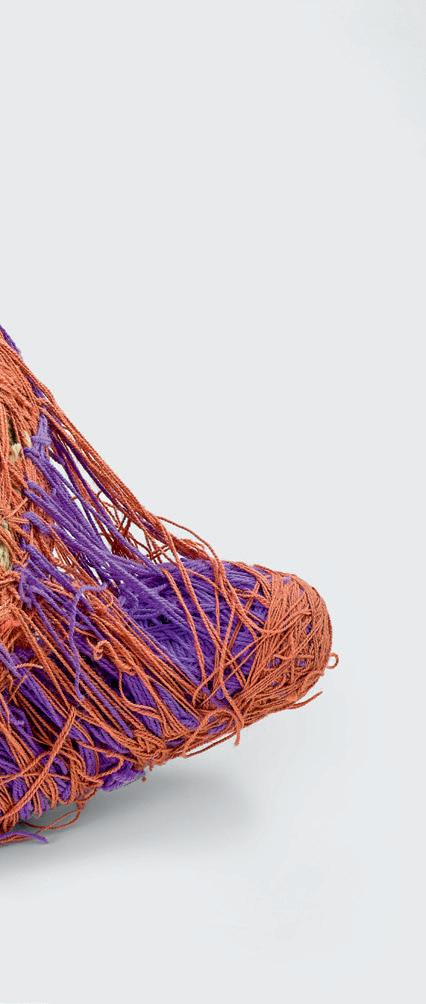
Sometimes, her colorful compositions are open structures, which reveal the myriad of material extensions that underlie its interior.
At other times, their threads are entangled in compact and labyrinthine frameworks, whose entrails can only be revealed through radiographic processes.
In more than a decade and a half of tireless production, the artist never titled her pieces. Nor did she indicate how they were to be exhibited or leave records of her thoughts about them. In the absence of a narrative, when Scott
began to attract critical attention, a number of labels and attempts at interpretation appeared around her work. Many of these arguments sought support outside the artistic element, in recourse to her elliptical biography or in the reduction of her practice to preconceived classifications.
However, precisely because they are inscrutable, her works –between the magical and the everyday, the real and the veiled – resist being classified. They are inscribed in the enigma, in those impossible choreographies that escape the rigidity of the univocal and remind us that the meaning of an artistic object always remains unfinished and incomplete: irreducible to a given discourse, imagination or system of mediation.
beatriz
translated from Spanish by ana laura borro
martínez hijazo
Untitled, 1993 Fabric and found objects, 91,4 × 50,8 × 25,4 cm
julien creuzet
Martinican thinker Edouard Glissant’s Poetics of Relation begins with “The Open Boat,” a short but weighty text that I have returned to again and again since I encountered it fifteen or so years ago. The essay closes with the following sentences: “…there is still something we now share: this murmur, cloud or rain or peaceful smoke. We know ourselves as part and as crowd, in an unknown that does not terrify. We cry our cry

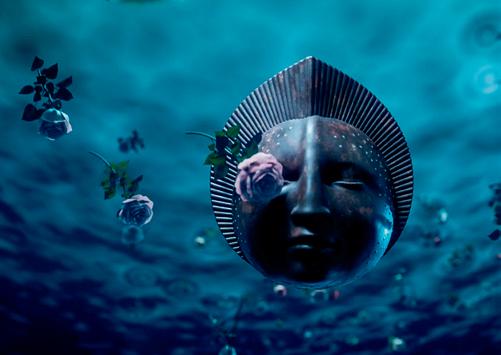
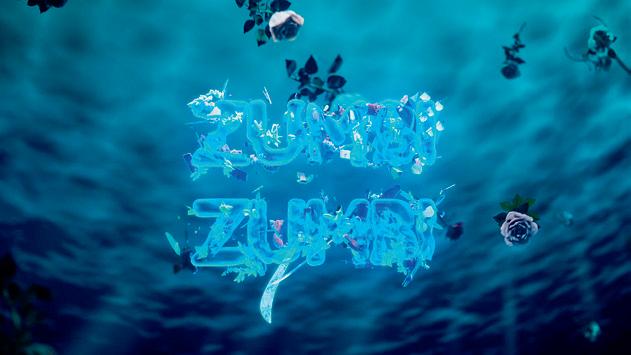
of poetry. Our boats are open, and we sail them for everyone.”1 Julien Creuzet’s artwork is, for me, that yawning, confounding, exciting open boat. To walk into one of Creuzet’s installations is to be overwhelmed by color and texture and line – fuzzy yarn, neon plastics, fishermen’s nets, shimmering metals, unidentified coloured liquids in water bottles suspended just so, and on and on. It is an assault, frightening in its

175 174
indecipherability, and scintillating in its sensuality. More a poem than an essay, we don’t have solid figures, only the outlines of things. Where objects are decipherable, as in his videos, they come together in unusual combinations, bouncing off each other, their meanings shifting, associations emerging and recalling Benitez-Rojo’s “soup of signs.”2
All of this is deliberate, of course. Creuzet is committed to an



endless chain of reference that conjures the “part and crowd” of PanAfricanist thought and experience. His work reminds us that much is shared across the African diaspora, but much is not. Negritude is related to, but not the same as Black Power. Is the Mami Wata of Haiti, the Mami Wata of Louisiana? Is Mami Wata Cuba’s Yemayá? Brazil’s Iemanjá? Is she Jamaica’s River Mumma? These recurring
water femmes with their fish tails, themselves a kind of syncretism, cluster like “cloud or rain or peaceful smoke,” droplets hanging in air, linked by some invisible, elusive but undeniably perceivable something. Creuzet would have it no other way. The demand for transparency is too often violent, why not revel in the opacity of the other, of the self? After all, if you could walk into Creuzet’s installation and know exactly what it was, consuming and digesting without event, would it be as good? Would you feel it as deeply? I think not. Better to linger, wander, let your thoughts double back on themselves, free associate, argue with a friend. Pleasures beyond what you can name await.
nicole smythe-johnson

_
1/ Édouard Glissant, Poetics of Relation. Translated by Betsy Wing. Ann Arbor, MI: University of Michigan Press, 1997.
2/ See Antonio Benitez-Rojo, The Repeating Island: the Caribbean and the Postmodern Perspective. Durham: Duke University Press, 1997.
this participation is supported by: Institut français.
ZUMBI ZUMBI ETERNO, 2023 Eternal Zumbi. Video stills. Video, color, sound
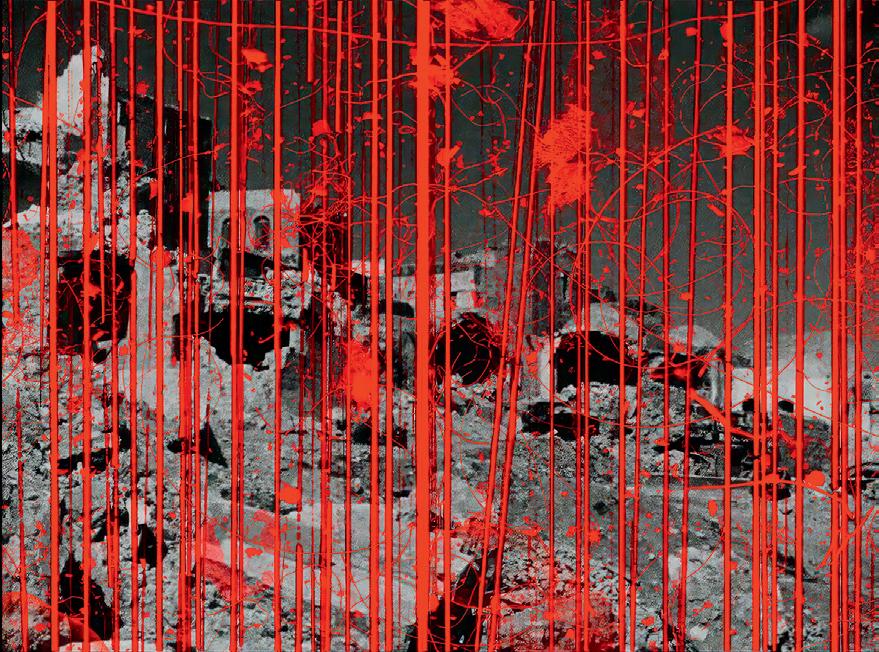

177 176 kamal aljafari
Kamal Aljafari’s work proceeds from a belief in and exploration of cinema’s power to bear witness. For a Palestinian artist working in the wake of the Nakba,1 this may sound like a paradoxical statement. In Israeli hands, cinema has consistently served as a tool of colonization, removing Palestinians from representations of their own landscapes and urban spaces. In that sense, as Aljafari observes,
Palestinian people have been doubly uprooted – in reality as well as in cinema.
But no dispossession is ever total. Like people, pixels also resist. In Recollection (2015), Aljafari engaged in a painstaking and brilliant effort to undo what he calls “cinematic occupation.” He mined three decades of Israeli fiction films shot in Jaffa, his hometown, for what their frames unwittingly
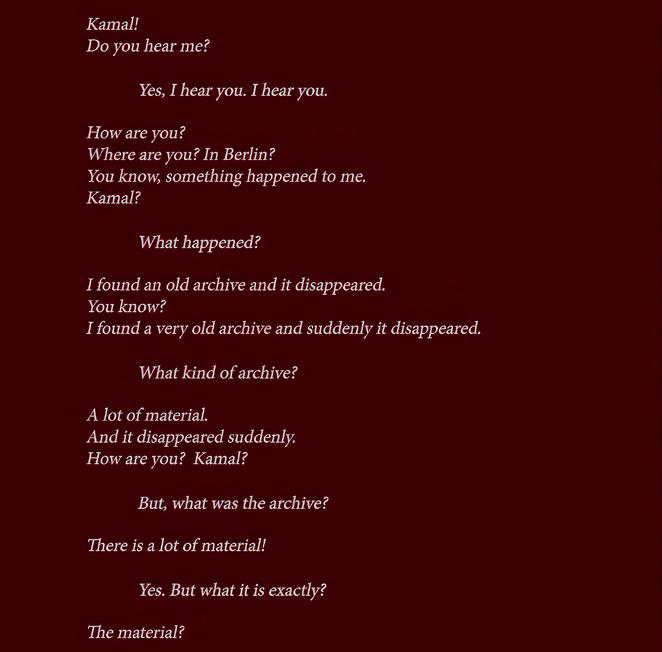
preserve: the image of the city’s architecture as it once was, and the images of many Palestinians, including his family members, who accidentally appear in the background because they happened to walk by when a scene was being shot. Armed with a trust in low resolution imagery, he uses montage and image manipulation as cine-choreographic tools to bring these silent ghosts back to the foreground, to make spectral representation emerge out of its own impossibility.
In other projects, like Port of Memory (2010), Aljafari focuses on familiar and familial spaces where, in a sort of suspended time, the repetition of daily rituals appears as a way to stave off looming catastrophe. In The Camera of the Dispossessed (2023), his project for the Bienal de São Paulo, he experiments with the installation format, using juxtaposition, montage and visual effects to critically re-appropriate historical footage looted from the Palestinian Research Center in Beirut by the Israeli army in 1982.
omar berrada
1/ The Arabic term Nakba means “catastrophe” or “disaster” in English, and refers to the Palestinian exodus of 1948, when more than 700,000 Palestinian Arabs, according to data from the United Nations (UN), fled or were expelled from their homes due to the civil war of 1947-1948 and the Arab-Israeli War of 1948. Source: Houaiss/Wikipedia. [e.n.]
A Fidai Film, 2023
Video stills
kapwani kiwanga complex and sensitive, Kapwani Kiwanga’s work constantly affects us through feelings of confusion. this affecting is not so much a method, but a path. through videos, sounds, performances, and installations, as well as through deep study, her art firstly confounds the rigid foundations of the modern-colonial world, especially its perverse binary logic. by shaking the binary rigidity of these structures, such as
truth/fiction, for example, Kiwanga activates not only a fertile work of destitution as decolonization, but, above all, invites us to imagine ways that are radically other of conceiving and involving ourselves – to recall Denise Ferreira da Silva – with the World we are. a world of intermingling, crossing and confusion.
For the 35th Bienal, Kiwanga presents pink-blue (2017), born out

179 178
of her research into total institutions – such as prisons and psychiatric institutions – and the impact of punitive design and architecture, and constant vigilance, on our carcasses. The installation brings to light the mechanisms that silently shape, regulate and predict modes of sociability. The color pink, especially Baker-Miller Pink, is used to calm aggressive instincts (rehabilitation or policy of control?),
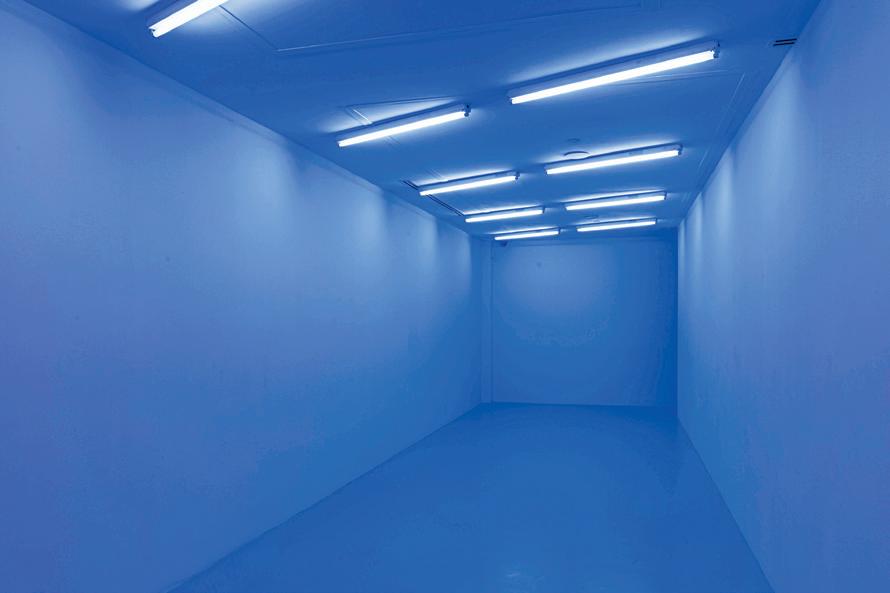
while blue (neon) makes it difficult to find veins, inhibiting intravenous drug users (damage prevention or increasing risks?).
In this work and its outcomes, we can also walk this path of confusion, imagination, and implication, through the battle against colonial time that exists in it, characterized by a rigid linearity between past, present, and future, and giving way to a technical complexity that
is no longer Eurocentric, through arranging colors (blue-pink, white) and shapes (entrance-exit, rectilinear-diagonal) in a direction opposite to that used to contain and repress. Perhaps there, when we move towards escape routes, we can invent a new dance of time. If we let ourselves become lost in the pink-blue passage, confused between entrance and exit, we can still think of this installation as a huge, strange magnifying glass –geometric, diagonal, and colorful – through which we can glimpse (and be a part of ) a non-linear time, entering and inventing spaces no longer commanded by the logic of colonial captivity.
abigail campos leal
translated from Portuguese by philip somervell and georgia fleury reynolds
pink-blue, 2017 Baker-Miller pink paint, white paint, white fluorescent lights, blue fluorescent lights. Installation view, Yuz Museum, Shanghai, China (2018)
Katherine Dunham’s (1909-2006) unique career as an anthropologist and dancer made it possible to imbue the black body with other meanings, to fissure colonial clichés and imaginaries about dances, bodies, and contexts of African origin, and to respond to the contingencies of her broader historical moment.
By furthering the conversation between anthropology and dance

in both unsuspected and groundbreaking ways, ethnographizing dances from the Caribbean and South America with vigorous and pioneering body play, she brought about the emergence of dance anthropology as a discipline, and subsequently built a dance technique and training school that are now key legacies.
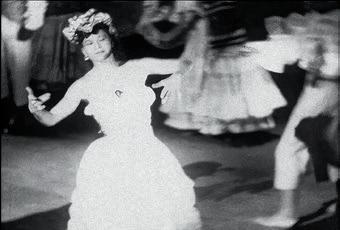
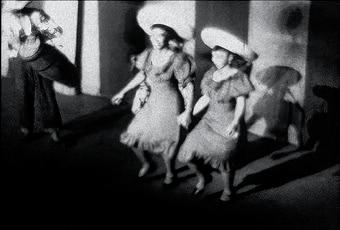
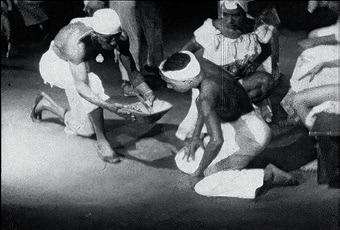
Rigorous in her creations and ideas, she linked elements of
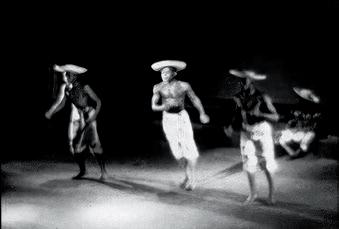
181 180
katherine dunham
Katherine Dunham shows, filmed in 1947 and 1956 Shango, Charm Dance from “L’Ag’Ya”, Ag’Ya Fight from “L’Ag’Ya” and Washerwoman Film stills
European classical ballet and Caribbean ritual dances, building a technique with lines, isolations, and undulations, as well as varieties of tempos and rhythms that were broader than the concert dance forms of the first half of the 20th century. By pointing to similarities, she also allowed differences to emerge, without fearing the inevitable contradictions of this movement, causing surprise
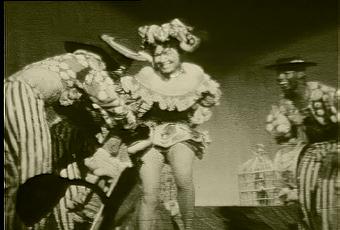
to Eurocentric eyes, all too convinced of the limitation of the body of Others.
Her performances sparked diasporic narratives illustrating rituals, dramatizations, spiritualities, and modes of daily life that were catalysts of community experience. Her foray into Caribbean realities became a way of establishing links with African memory and ancestry and of retrieving archives to recre-
ate them in the light of a perception that questioned colonial ways of seeing the Black world.
Her articulation of the Black diaspora in practical and conceptual terms was of such relevance that it may have anticipated the very idea of the Black Atlantic. Dunham envisioned the notion of the African diaspora in its intercultural and geographical dimension, further showing how Black dance modernism contributed to the expanded field of dance.

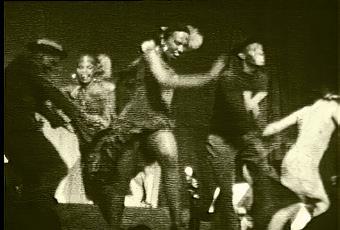

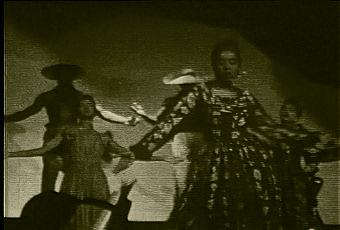
The choreographer’s work showed how dance could relate to issues that permeated social life. In 1950, during a tour of Brazil, she suffered a racial slur at the Alvorada Hotel in São Paulo, which triggered heated discussions in the field of race relations, culminating in the enactment of the Afonso Arinos Law (Law n. 1.390/1951), which considered racist practices to be a criminal offense. It is worth mentioning that at this same time the choreographer established contact with the Brazilian dancer Mercedes Baptista, who would later join her company in New York.
Dunham, through her choreographies and movements around the world, has imagined and circulated representations of what the Afrodiasporic body can be, and thereby disseminated knowledge of her own and of an entire community. Her humanistic vision and activism have contributed in a multidimensional way to the fields of arts, education, and the anti-racist struggle, intertwining artistic and academic spheres in a pertinent and necessary way.
luciane ramos silva
translated from Portuguese by philip somervell

183 182 kidlat tahimik
Indio Genius Brazil Remix, 2023 Digital collage
Better known as an independent filmmaker, Kidlat Tahimik is the author of massive installations too. His complex and gigantic scenographies unfold an indigenous storytelling confronting imperialism and colonial narratives. Mostly concerned about the extermination and destruction of genuine mythological figures, he recreates the cultural clashes with an epic overtone. The multiple stories and the many
scenes that will be shaped through wooden sculptures seem to come out of the mind of a Hollywood scriptwriter. In the final representation, real historical names often mingle with fiction characters by collapsing time, well established periods and distant geographies.
For the 35th Bienal de São Paulo installation, Kidlat Tahimik proposes an unlikely frieze that bings together Igpupiara and Syoykoy,
ancestral mythological figures of indigenous people in Brazil and Philippines respectively. This is but one chapter of the Magellans (14801521) circumnavigation journey in which the invasion triggers a necropolitics that extends well beyond humans. First monstrified and then exterminated, the Igpupiara and Syoykoy figures embody the killing of tribal imaginaries, a pervasive and relentless cultural genocide that amplifies its tragedy with racial-ecocidal capitalism. Helicopters, chainsaws and missiles fight an uneven battle against creatures half human half animal, altogether scenes that echo a cross-cultural theme park somehow inspired in the logic of the ninenteenth century exhibitions held by the colonial enterprise.
By messing up with the chronotopes inherited from modern discourses, the same ones that made plunder and extractivism legitimate forms of planetary government, the artist foregrounds yet another shade of violence. Undoing the imperial narratives through the degenerative logic of stories told once and again brings forth quite a strong counterimage of progress. In a postcolonial world the inventive capacities rely on twisting, blending and mixing the past regardless of the categories that kept apart forms of life, common imaginary constructions and knowledge. So much that approaching Kidlat Tahimik’s installations it’s like entering the junkyard left behind by all imperial regimes.
carles guerra
Rain Forest Manugal Jar
Digital collage
 , 2023
, 2023
In SHAKEDOWN (2018), time is a habitat, as stated by director Leilah Weinraub. For over ten years, between 2002 and 2014, Weinraub brought together an archive of interviews and videos of the Shakedown striptease club, by and for Black lesbians, in Los Angeles – by that time at the brink of gentrification and plagued by police brutality. Disrupting the linear and consecutive Western conception by evok-
ing temporalities and spatialities that intertwine past, present, and future, Weinraub presents a 72-minutes-long research-work disassembled in more than 400 hours of footage, flyers, and numerous photographs produced when the artist worked as a photographer and videolady at the club that lends the film its title. The result is an intimate, bold, and celebratory experience-film of African American lesbianity.

185 184
leilah weinraub
SHAKEDOWN, 2018 Film still; 60’22”
In 2020, SHAKEDOWN became the first non-pornographic film released on Pornhub. The film, which turns the stories of Ronnie-Ron and the Shakedown Angels − Egypt, Ms Mahogany, and Jazmyne − into a montage of new sensibilities, visualities, and temporalities, is a document in which many layers intersect, such as the indagations about what is work? and its connection to the individual as well as to privacy, money,

power, erotism, arousal, affection, intimacy, performative personas, illegality, fluid sexualities, families, the concepts of cinema and image, time, and the club as a haven and a possibility of being. To the unsuspecting, SHAKEDOWN could be understood as a documentary about the resistance of the underground scene in Los Angeles, a capital and a queer haven in the United States, but Weinraub resists the idea of
calling the film a documentary and defines it as being “its own capsule”, captured in a specific moment as a space for curiosity and fantasy. But, beyond all that, what Weinraub made in SHAKEDOWN was a visceral work of art.
barbara copque
translated from Portuguese by bruna barros and jess oliveira
The transmission of oral stories is one of the subjects of Luana Vitra’s research. Originally from Minas Gerais, she grew up listening to accounts from relatives involving everything from Afro-diasporic celebrations, knowledge, and technologies, to the traumas of the slave-owning past of the Ouro Preto region, where her family lives. A constant theme is the stories that involve the legacy of centuries of

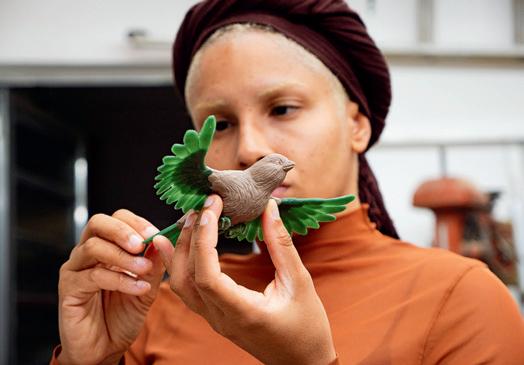
extractive economies that still promote the degradation of local ecosystems. Vitra remembers hearing about enslaved people who used to take canaries with them to work in gold mines. This bird, with its incessant singing and accelerated metabolism, was used as a sentinel. Its lungs reacted in an instant to the presence of toxic gasses emanating from mineral extraction, and its silence was the warning for miners

187 186
luana vitra
to open paths to escape the galleries, avoiding the dangers of lethal intoxication. The survival of those people meant the death of the birds, evincing how the regime of slavery not only devastated human lives, but extended its terror over other species.
The above narrative is the starting point of Luana Vitra’s work for the 35th Bienal de São Paulo. The installation’s main element is a
series of arrow-amulets intended for unblocking paths. Made of iron, a paradigmatic material and of recurrent use in her works, they act as conductors, pointing to places of prosperity where “possibility prevails.” At the center of the installation, one notices that some of them are grouped and positioned diagonally towards each other. For Vitra, this composition creates a path that spatializes the meanings and
possibilities that each grouping carries. Added to the composition of the work are copper gourds, birds bathed in silver and copper, metals of a highly conductive nature, and indigo powder, a substance often used for energy cleansing.

thiago de paula souza
translated from Portuguese by philip somervell
Production documentation of the work commissioned by Fundação Bienal de São Paulo for the 35th Bienal
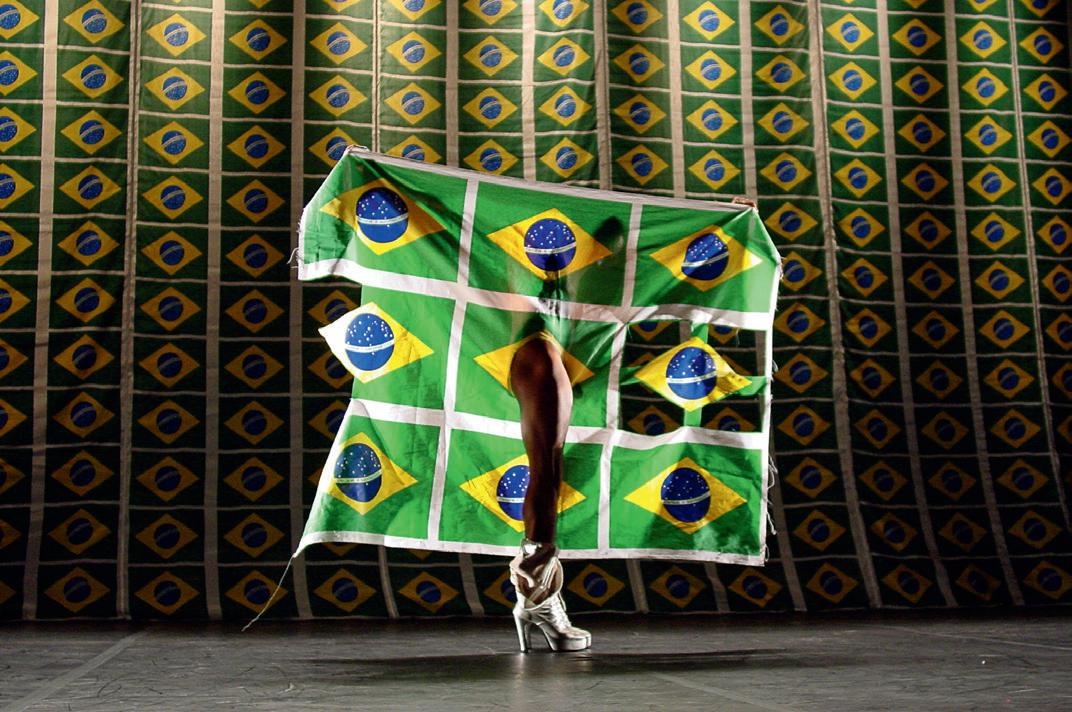
189 188 luiz de abreu
Luiz de Abreu’s research on dance and performance presents the black body in a state of denunciation. The videos that comprise the 35th Bienal are documents of Brazil from the mid-1990s to the mid-2000s. In them, the artist confronts the experience of a racism that resisted collective and institutional elaboration, but with poignant effects of racial subjugation on economic, sociopolitical,
and subjective levels. The choreographies presumed for Black people in the context of the myth of racial democracy are explored in the artist’s work, who employs his body to respond to the stereotypes that arise and confine the expected symbolic repertoire for black arts. The country is the presence that sustains and shapes the scenes, whether as the backdrop for the set in Black Fashion (2006), as the
flag that adorns the stage and the artist in Samba do crioulo doido (2004), or through classic themes of Brazilianness that form the soundtrack of the works. But, after all, how does a Black body dance? And what effects and affects can (or can’t) a question elaborated in these terms generate? Although the artist states that he does not create on the basis of genres,1 the audience’s white, cisgendered, and perverse laughter affirms comedy, as it is provoked in scenes that could cause deep discomfort if the audience were able to recognize the tragedy experienced by Black people. The performer’s laughter, on the other hand, enters and exits the scene showing choreographic marking; it is a joy that reveals its artificiality, because it is decomposed as gesture, just as all the qualities and movements attributed to the black body are. In Autópsia [Autopsy] (1997), the room for laughter has closed. In the unbearable reproduction of the horror of the reports of violence narrated off-screen, he opens a gregarious space for solidarity and for ritual, returning, perhaps, to the memory of a liturgical dimension that his dance, undoubtedly contemporary, has apprehended since the Umbanda terreiros.
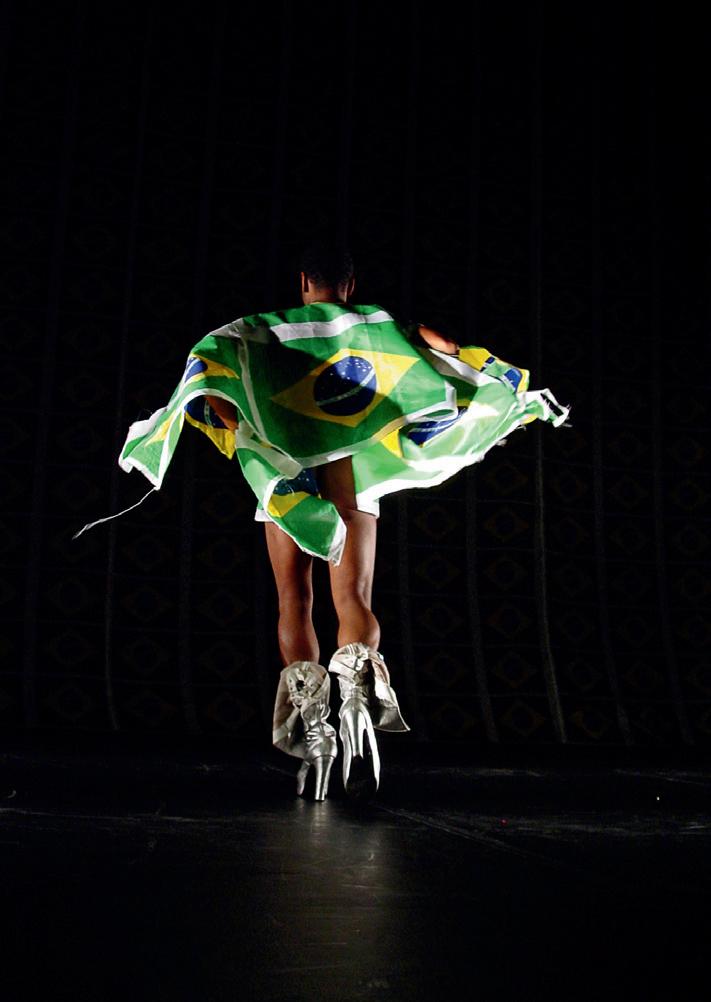
cíntia guedes
translated from Portuguese by philip somervell
1/ According to an interview given to Rádio França Internacional Brasil, on the program RFI Convida Luiz de Abreu, on March 13th, 2020. Available at: www.youtube.com/ watch?v=g0ALs1cTW0Q&ab_channel=RFIBrasil. Accessed on: May 18th, 2023.
Samba do crioulo doido, 2004 Performance documentation

191 190 m’barek
bouhchichi
The question of race is surprisingly absent from North African art production. For the last ten years, M’barek Bouhchichi has been elaborating forms and methods for tackling it. His point is not so much to confront the brutal reality of anti-Blackness racism. Rather, it is to reclaim the substance and rhythms of Black life which, for him, are primarily those of artisanal labor, most particularly in the
Moroccan South-East: the textures of what Black hands make, the texture of time spent with families of craftspeople, listening to their words, watching their ritual reiterations of ancient gestures and their ethics of patience in the face of discrimination.
For Bouhchichi, these potters and blacksmiths are poets (in the Greek sense of the verb poiein, meaning “to make”). They cre-
atively shape matter and breathe life into it. With their tactile mode of bearing witness to a history of racialization, they play a similar role as the Amazigh oral poets who, generation after generation, have consigned the lives of their communities in songs and recitations. Poetry is important to Bouhchichi’s practice. He has paid particular attention to M’barek Ben Zida, a Black poet-peasant who revolted against his status as a sharecropper in Southern Morocco. Bouhchichi has been collecting Ben Zida’s largely forgotten words and engraving them into sculptures.
For the Bienal de São Paulo, Bouhchichi brings poetry and pottery together while bridging geographical gaps that keep the African diaspora scattered. Inspired by the work of US-enslaved potter David Drake (c. 1800-1870), he makes a series of vessels inscribed with verses by Black North African, Afro-Brazilian, and African American poets – like a score for an alternative dance of emancipation that does away with national boundaries as it stages conversations between Black hands on both sides of the Atlantic. With this work, the artist pursues his unlearning of Western art hierarchies while gesturing toward a world structured not by reaction to oppression, but by an active, poetic weaving of relations across languages and geographies.
omar berrada
project for Nous sommes ce qui vous ne voulez pas voir, 2023 We Are the Ones That You Don’t Want to See. Ink, pencil and watercolor on paper
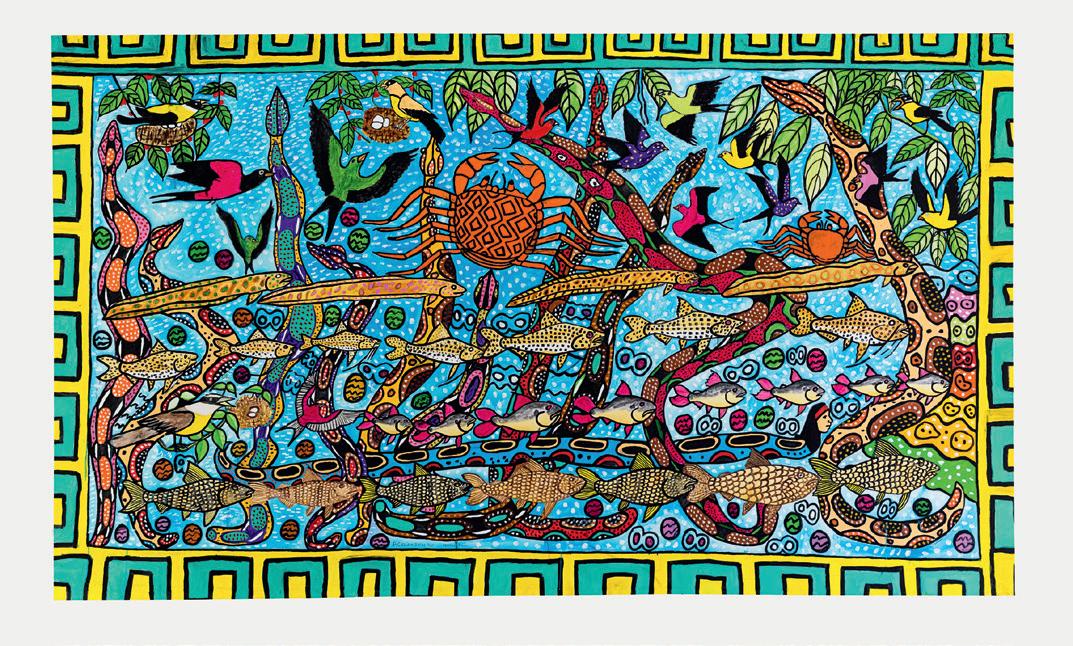
193 192 mahku
acelino sales tuin
Nahene Wakame, 2022
Acrylic on canvas, 163,5 × 260 cm
Since it was founded in 2013 by Isaías Sales (Ibã), Txaná of the Huni Meka chants, and his sons Acelino, Bane, and Maná, the Movimento dos Artistas Huni Kuin [Huni Kuin Artist Movement] has been establishing a unique iconography whose formal solutions can be swiftly identified. Characterized by the presence of human and non-human figures which are integrated by a complex graphic plot that
reflects the structure of body paintings while reserving small areas of intense colors, MAHKU painting dispenses with Western codifications: it renounces mimesis, perspective, the rules of proportion, and canonical technique, to commit itself solely to the forces of miração, the visionary experiences stimulated by the ingestion of ayahuasca during nixi pae rituals. The paintings may also present trans-
lations of mythical narratives and ancestral stories, described in the ritual chants, whose shared aspect is the living presence of the entities of nature and the relationship of continuity between them. The result of these procedures is a combination of forms and colors, which rekindles the problem of movement in painting, shifting it from the terrain of illustration to that of inner experience (which Ibã calls ‘spiritual art’), and seeks to account for the different rhythms of narration of the myths in the chants.
In Huni Kuin iconography, the area of imprecision between dream and myth is often indicated by a frame that adapts to the worked surface, granting the story autonomy and assuring its free manifestation. In the perimeter of miração, there are no hierarchies between the represented entities, and the fracture between abstraction and figuration loses all meaning. What we find is the result of an image-process, made by many hands, from the dialog and learning between those involved, whose ultimate goal is healing, both for those who made it and for the observer who accesses it, transforming it into a spiritual experience.
renato menezes
translated from Portuguese by philip somervell
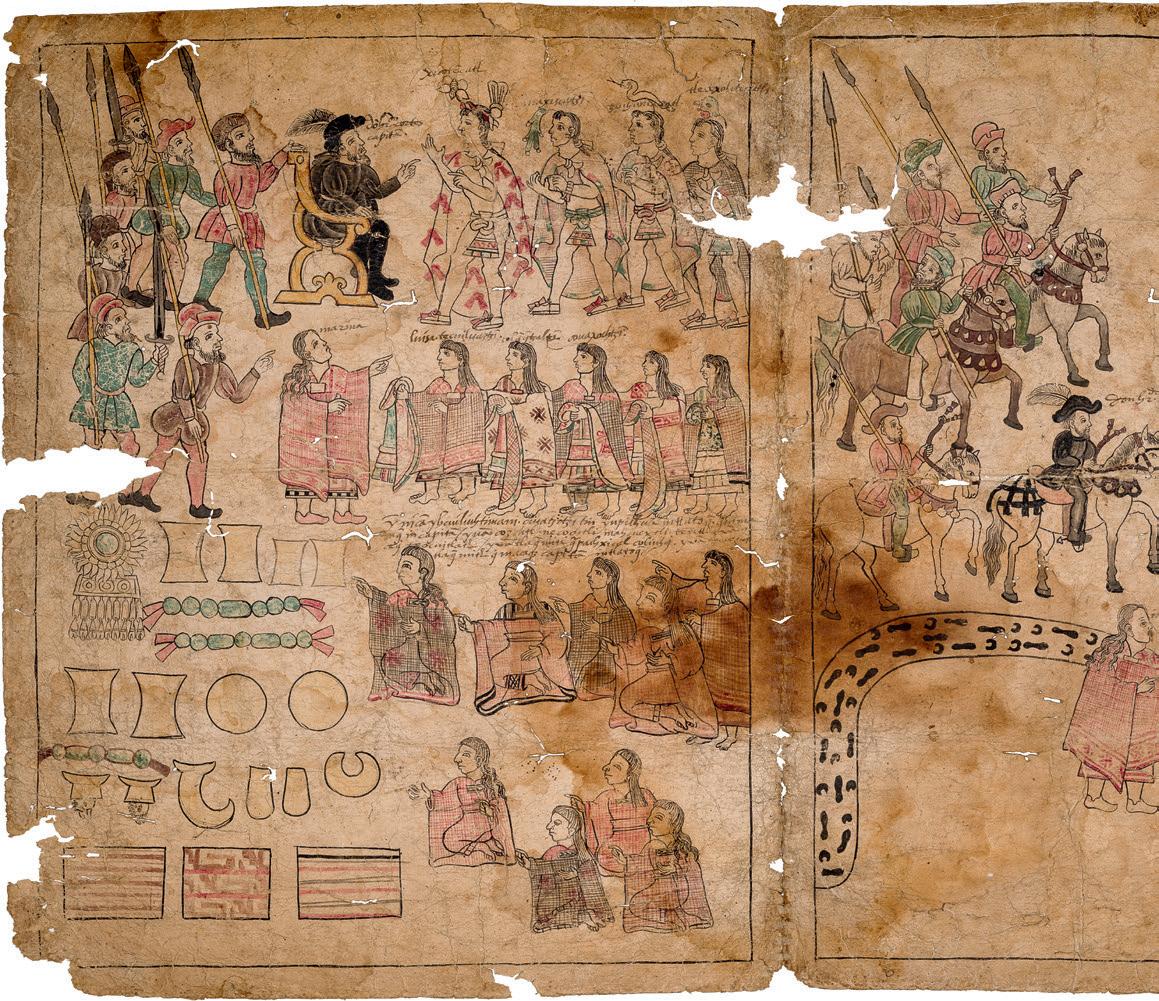
195 194 malinche
between the years 1500 and 1529, lived Malinche, a Nahua who was probably born on what we now call the coast of the Gulf of Mexico. Malinche is maybe the distorted form of Malintzin picked up by the Spanish ear, which is just another of the many names attributed to her, whose birth name is unknown.
in official historical records, Malinche is known for supposedly having acted as translator and
advisor to Hernán Cortés in the invasion and destruction of the Aztec Empire (1519-1521).
in Lienzo de Tlaxcala1 we come across the recreation of a historical moment whose poetic violence we can only envision: the brutal encounter between Tlaxcallans and Castillians. before this mysterious image, we are summoned to witness the unnameable: the deafening noise of muskets, chil-
dren crying before the corpse of their bloodied parents, huts set on fire, young women being raped by Spaniards, looting, destruction, Spanish soldiers murdered without even knowing where the arrow came from. but we can also ask ourselves: what stories do these strange spots hold? or what unpredictable events announce these slits?
Malintzin was known for being a collaborator of the Iberian invasion. however, we can ask ourselves: was she merely trying to survive the extermination that was coming? instead, was her silent work an internal attack, by means of sabotage and contagion? in any case, her remarkable linguistic abilities can serve us as a way to go beyond History, eroding its language. could it be that in Lienzo de Tlaxcala some clue is encrypted? perhaps there are elements contained therein for us to imagine another type of prophetic re-reading of the past. thus, this map does not indicate the coordinates for a geographical country, but for places long forgotten and yet to be imagined.
abigail campos leal
translated from Portuguese by mariana nacif mendes
1/ The Lienzo de Tlaxcala is a colonial codice painted around 1550. It tells the history of the conquest of Mexico from the perspective of the Tlaxcallans, a long-time enemy of the Aztec. Available at: nmdigital.unm.edu/digital/collection/achl/id/1609/. Accessed July 2023.
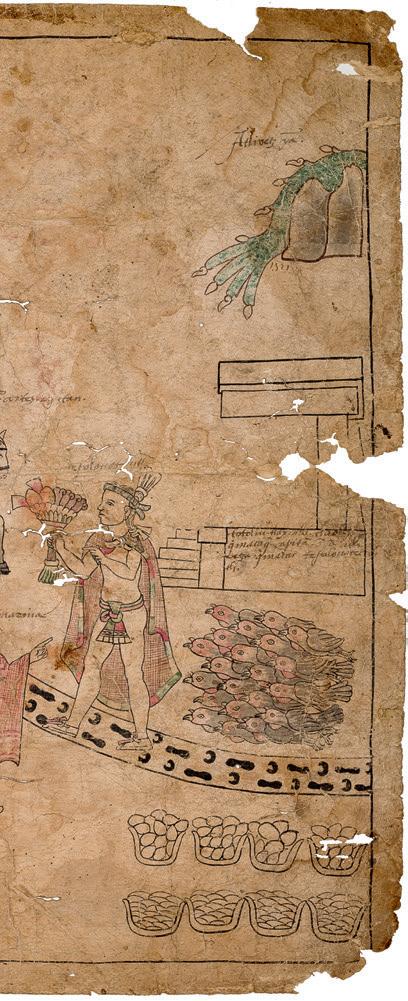 Lienzo de Tlaxcala, 1552
Tlaxcala's Fabric. Polychrome drawing on bark paper, 65 × 26,5 cm
Lienzo de Tlaxcala, 1552
Tlaxcala's Fabric. Polychrome drawing on bark paper, 65 × 26,5 cm
Lake Atitlán laps the shores of several villages in Sololá department, Guatemala. Protected by three gigantic volcanoes, it was formed by an eruption 84,000 years ago, and its shores are inhabited by descendants of the Cakchiquel and Tzutuhil communities. Manuel Chavajay, from San Pedro la Laguna, is one of them.
As an extension of this surprising place, his work explores it as a

197 196
manuel chavajay
sacred place, where his existence takes place and is intertwined with the knowledge of his ancestors. From a local perspective, Atitlán is an epicenter of tourism and a place that has nourished the idea of what constitutes national heritage. However, for Manuel Chavajay, the binding forces that arise from the experience of belonging to this place are greater than any cliché. We notice this in Oq Ximtali
(2017/2023), Manuel Chavajay’s video performance. This project is a record of community action. It arose from the artist’s concern with this location and from the invitation to a group of fishermen to tie up their traditional boats –known as cayucos – while they rowed in the translucent waters of the lake. The image, recorded by a drone, is an almost perfect circle of the twenty boats carrying
various resources and symbolic objects. Boats flow with the water currents or exert opposing forces. At the end of the action, the artist suggested to the participants that they could untie themselves, move according to their will or coordinate to return together to the shore, which led to a moment of confusion. Oq Ximtali, in Tzutuhil, means “they have us tied up” or “we are tied up”. This action explores or recovers the community dynamics that are crumbling and fading away due to the interference of opposing cultures. In Chavajay’s work, we always find reflections of an intense sense of historical pain that alternates with a sense of hope; a certain fear that emerges alongside resilience; the strength of labor on land and water merges with a great sense of vulnerability. In exceptional poetics, Oq Ximtali suggests this recurring feeling of impossibility that has become a prominent feature of the present and that threatens the balance of communities, human and interspecies relationships.
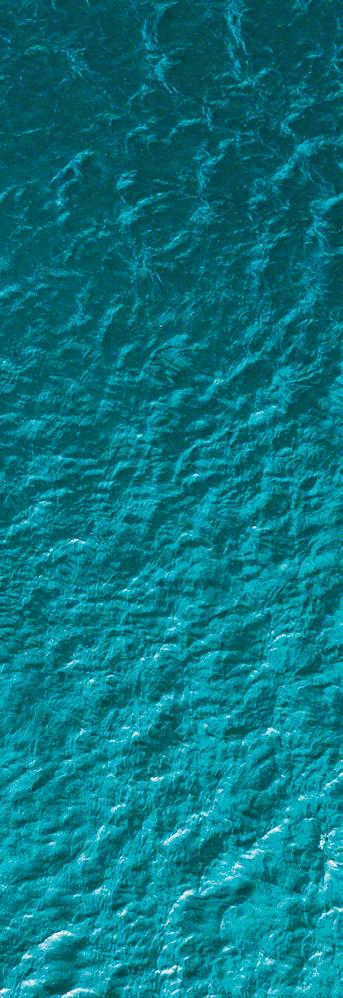
rossina cazali
translated from Spanish by ana laura borro
Oq Ximtali, (2017/2023) Digital photography, 91 × 61 cm

199 198 marilyn boror bor
For the Bienal de São Paulo, the Maya-Caqchiquel artist Marilyn Boror Bor presents two projects that explore her commitment to the counter-ethnographic gaze and the disarticulation of forms of coloniality. Following the models of the European monument and ethnographic museography, Bor’s objects and actions modify hegemonic perceptions and the view of a public conditioned by stereo-
types and prejudices. Monumento vivo [Live Monument] (2023) is an action in which the artist’s own body, dressed in her own Mayan costume, is placed on a base where her legs have been momentarily trapped in cement. Nos quitaron la montaña, nos devolvieron cemento [They Took the Mountain From Us, They Gave Us Back Cement] (2022), consists of a series of traditional objects made with cement. Like
small fictions, Marilyn replaces the corn of the food with cement and the clay of the pots with the weight of this material through which the original soul (cux, in Caqchiquel language) and symbolic value are lost. Both works of art are a response to the debates about the model of economic development in Guatemala and the ferocious extractivism that affects so many people on the continent and, in particular, in San Juan Sacatepéquez, where the artist was born. Both the monument and the objects are an act of enunciation of the conflicts generated by the implementation of an industry that is literally covering fertile fields, water sources and all living resources of the region with concrete dust.
There is no such word as art amongst native people. The use of these western elements associated with the art world is a strategy to reveal a plight but also to rescue the presence and reverberation of the original referents. Marilyn Boror Bor’s intention is to take advantage of certain features of these totalizing, institutionalized and academic languages in order to dismantle the common clichés that multiculturalism has provided. Her desire as a contemporary indigenous artist is to rescue cosmogonies that have been invisibilized and fragmented over the centuries.
rossina cazali
translated from Spanish by ana laura borro
Monumento vivo, 2021 Living Monument. Performance documentation, Bienal Sur, Ciudad de Guatemala


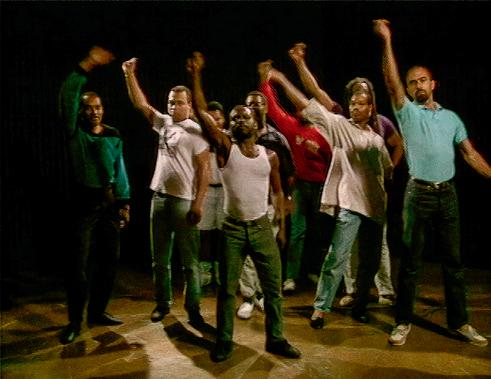
201 200 marlon riggs
Tongues Untied, 1989 Film stills
Since being reappraised by researchers, curators, and distributors,1 Marlon Riggs’ films have been frequently revered for their content and the potential for identification they generate. I propose, however, that we highlight his work as integral to a history of forms in the arts, particularly in film.
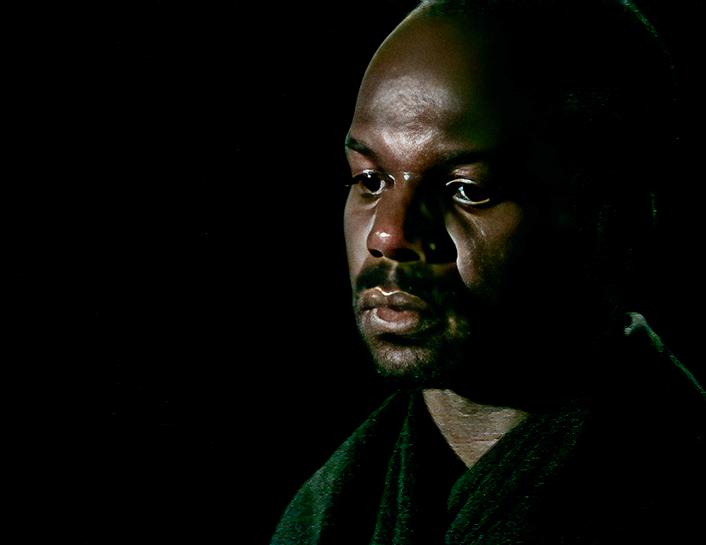
Riggs engages with an anti-silencing filmmaking practice, attributing to self-expression such
a value hitherto seen. Voice and rhythm are the main formal strategies of his work. It is no accident that poetry, with its infinite possibilities of sonic and elliptical arrangements, constitutes an unmistakable feature of his films.
Tongues Untied (1989) inaugurates the most inventive phase of Riggs’s career and combines the stylistic traits we usually associate with his work. Like many of his sub-
sequent films, Tongues Untied transitions from the radically personal – thus verging on the confessional –to the undoubtedly collective – thus espousing polyphony.
When speaking of Riggs one must recognize that the concept of the auteur theory – that is, to attribute what emanates from the mise-en-scène almost exclusively to the director – poses limitations. To better understand him, it would be useful to observe him as a creator in dialogue with a number of artistically brilliant and intellectually rigorous individuals: Black-gay activists, Black feminist scholars, and poets, such as Essex Hemphill.
Riggs’ films strove to make Black gay men both part of the Black experience and part of Americanness. Invested with a reconciliation of identities, his films sought a settling of scores toward a possible redemption with three structuring identities: Black, American, and gay.
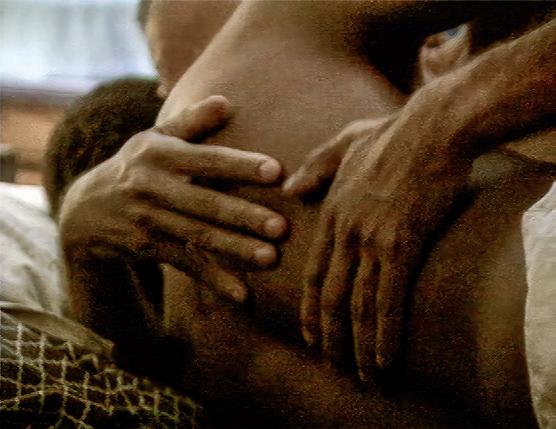
In Tongues Untied, Riggs posits this assertive reconciliation as an aesthetic and political project.
heitor augusto
translated from Portuguese by philip somervell
1/ Among them are Bruno F. Duarte, Cornelius Moore, Louis Massiah, and Rhea L. Combs, in addition to my own work as a curator and professor.
maya
Maya Deren’s main contribution to choreography is to conceive the camera itself as an integral part of the dynamic reality of dance. The camera is not only an instrument for registering a stage event in front of which it is placed, instead, it dances in a holistic structure. And with the camera, the one who holds it. Maya is interested in dance for its affinity with poetry and for its non-literal production of meaning;
the elusive fluidity of the movement is consistent with the idea of cinema as an art of time, and not of representation. Art is for her the formal production of an autonomous reality and experience. In her own performances, Maya immerses herself in a reality which is not given, but built through technical resources with which she never stops experimenting: invisible montage, slow motion, frozen frames,
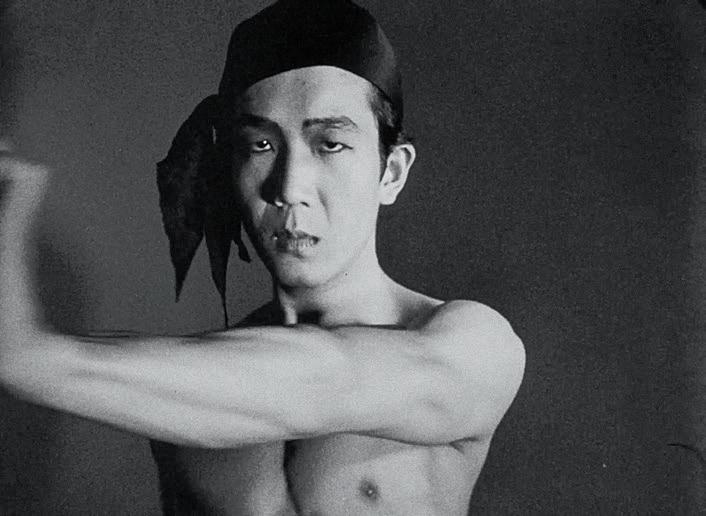
203 202
deren
the use of different lenses, backwards movement, dissociation of image and sound. And that double experience, of acting and registering, being inside and outside, both in the technical work and in the poetic creation, in the material world and in the transcendental, is revealed in Meditation on Violence. This film is the reverse of the possession rituals that so fascinated her (and that she herself practiced)
in Haiti. In contrast to these, the dance shown here is an exercise in self-control, shared by the camera, which assumes the dancer’s own gravity, that apparent weightlessness that is only achieved thanks to training and corporeal intelligence. The result is a film that can be considered perfect in its formal construction. Perfect in its precariousness: a set of photographic paper and a skillful handling of editing
allow it to transcend Maya’s plan and the singularity of Chao-Li Chi to produce a circular and infinite movement, the perfect form that contains all forms. The depersonalization of the dancer and the camera is close to the abandon typical of possession rituals, but here the violence is restrained, even muted, not to deny it, but precisely to show it in the distance, in its contiguity with beauty and with life. The distanced look brings us closer to the divine in a way almost contrary to that of the body in trance: here this is achieved thanks to the work with matter (body, paper, architecture, flute, drums) and form (movement, speed, framing, image and sound edition) as own means of the dance and the cinema.
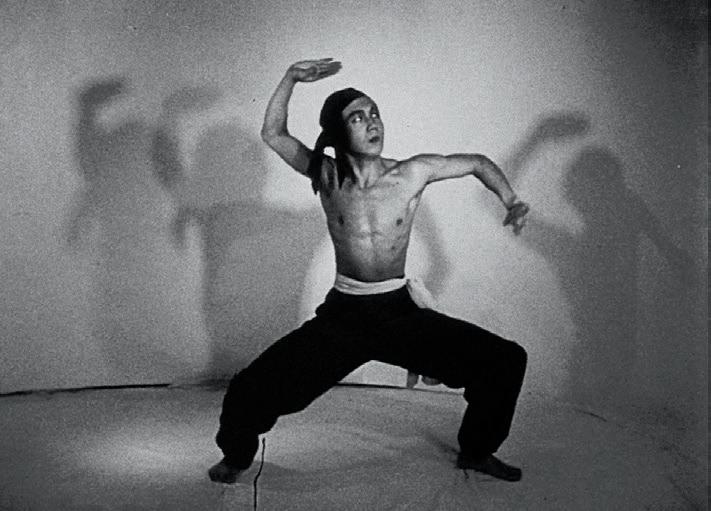 josé antonio sánchez
josé antonio sánchez
Meditation on Violence, 1948
Film stills. HD digital black and white film, sound (from original 16mm); 12’25’’
Although it was first shown almost a century later in 1991, the Álbum de paisajes, tipos humanos y costumbres [Album of landscapes, human types and costumes] was produced between 1841 and 1869, in the early days of the Republic of Bolivia. Going against the grain of traditional historiography and the prevailing neoclassical taste, Melchor María Mercado created other ways of “narrating the nation.”
The hundreds of watercolours that constitute the work trace a genealogy of their own through the different human groups, customs and regions of the country, in which the indigenous populations and the cholas play an undeniable leading role. However, at the same time as he captures Bolivian culture, architecture and nature, the artist also points out the fragility of political power (which he experienced first-
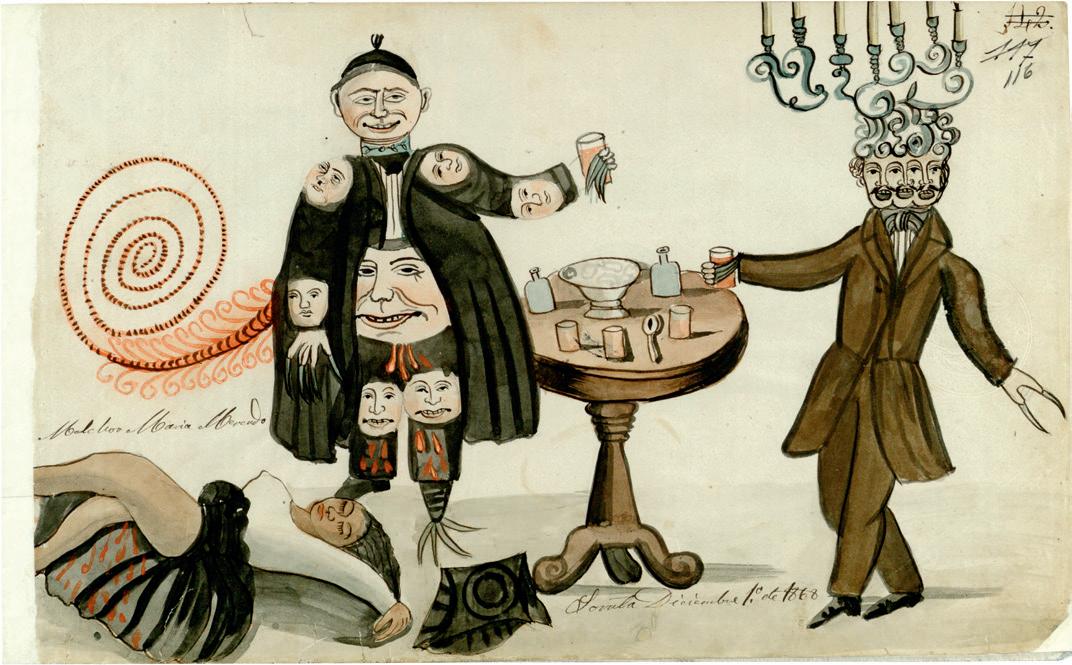
205 204
melchor maría mercado
Untitled (Los pecados capitales), 19th century The Capital Sins. Watercolor on paper, 20,5 × 33 cm
hand) and satirizes the corruption of the colonial elites.
In this way, in addition to an early attempt to unfold an Andean memory and episteme, the fractures and ambivalences that marked the period are also discernible: the marginalization of certain identities or social classes and a persistent colonial domination which was revealed as the other side of the celebrated triumph of the market and democracy.
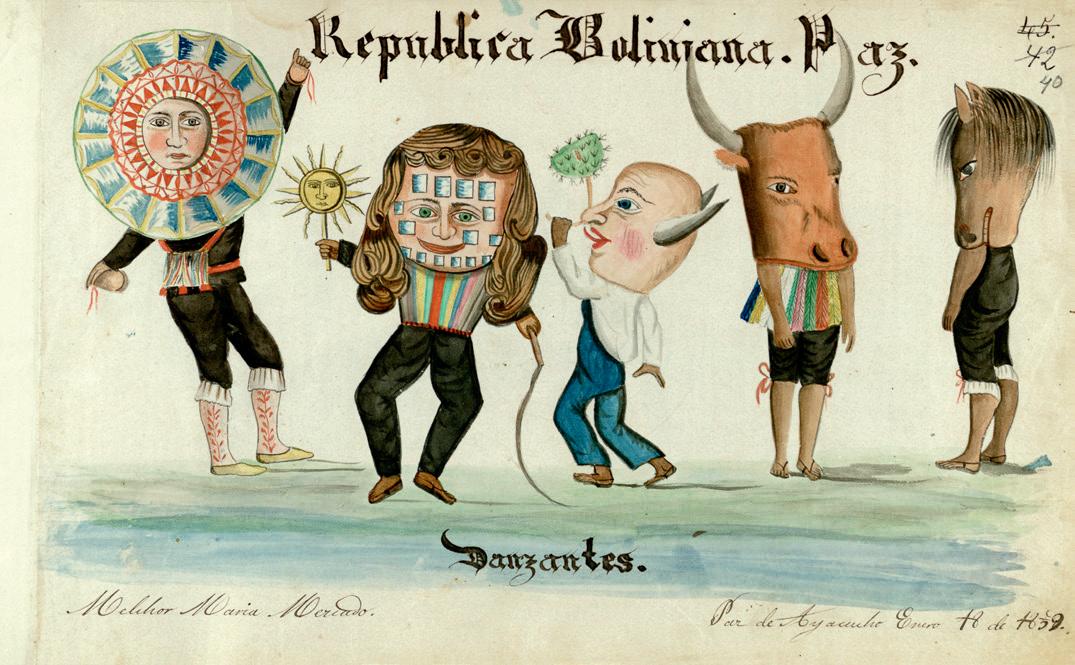
There is a particular way of approaching space and time in Álbum. Against the single, linear vision of written history, a sequential and dialogical format is proposed, where each picture is – in itself and in relation to others – a discursive sparkle.
The sociologist Silvia Rivera Cusicanqui, who studied the practice of her compatriot in detail, spoke of the homeland as a hand-
ful of beloved and contradictory images. Thus, far from prefiguring what would later be instituted as a map, Melchor María Mercado’s work suggests zones of encounter and conflict in an allegory between the lived and the signified.
beatriz martínez hijazo
translated from Spanish by ana laura borro
República Boliviana. Paz. Danzantes, 19th century Bolivian Republic. Peace. Dancing. Watercolor on paper, 20,5 × 33 cm
A person dressed in rags walks with difficulty. The modest clothing could in some way relate to The Madwoman of Chaillot. 1 The clumsy figure looks almost as though it is learning to walk, although what it is learning is not at all functional, and its way of relating to the world is nothing ordinary. But that difficulty results in a beauty of movement that transforms into something more beautiful than a simple

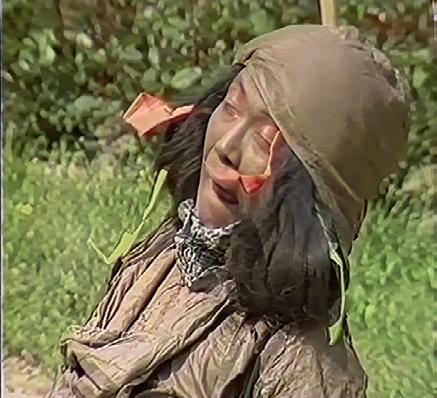
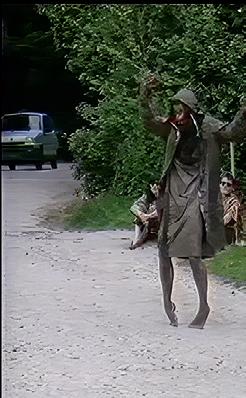
207 206
min tanaka and françois pain
sequence of steps: it is a dance. The different parts of the body act and interact with each other, though not in a way one would expect. Feet, legs, and arms move implausibly, creating unexpected correlations and reciprocities with everything that surrounds it, whether human or not. This performance was realized by dancer and actor (as he describes himself) Min Tanaka at the French clinic La Borde, where
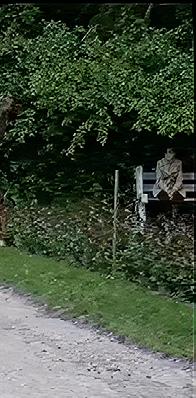
Félix Guattari spent some time working with Jean Oury, the clinic’s founder. Both psychoanalysts, Félix and Jean sought to create a space that would not reproduce hierarchical power relationships, a place of exchange between assistants and patients, between general staff and doctors. His way of relating to the La Borde patients evokes support, affection, and mutual learning. That is the choreographic element of
the impossible that permeates the work. Tanaka is a Japanese dancer who works against the grain of traditional dance. Since 1974, he has been developing a very specific performance model that breaks away from established disciplines and which he calls hiperdança, emphasizing the psychosocial unit of one body without organs or predetermined functions. Throughout his career, Tanaka has developed a practice that is impossible to classify. In his words: a dance with no name. He once said that together we incorporate a unique body that belongs to no one: a body of the earth. Min Tanaka à La Borde (1986) was directed by François Pain, a French filmmaker who worked with Félix Guattari at La Borde, and whose work focuses on issues of schizoanalysis and anti-psychiatry, understanding cinema as a machine for generating spaces of care.
sylvia monasterios and tarcisio almeida
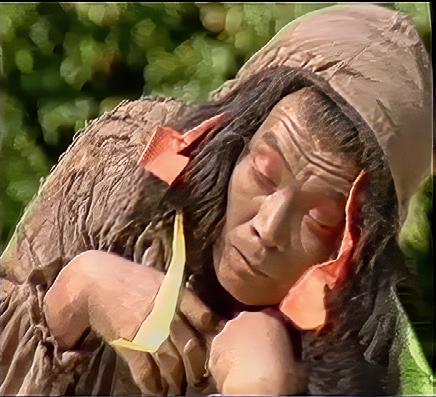 translated from Portuguese by georgia fleury reynolds
1/ Directed by Bryan Forbes, The Madwoman of Chaillot (1969) is a British-American dramatic comed based on the play La Folle de Chaillot, by Jean Giraudoux.
Min Tanaka à La Borde, 1986 Min Tanaka in La Borde. Video stills. Video, color, sound; 24’
translated from Portuguese by georgia fleury reynolds
1/ Directed by Bryan Forbes, The Madwoman of Chaillot (1969) is a British-American dramatic comed based on the play La Folle de Chaillot, by Jean Giraudoux.
Min Tanaka à La Borde, 1986 Min Tanaka in La Borde. Video stills. Video, color, sound; 24’
ɨramari

209 208 morzaniel
Mãri Hi, 2023
The Dream Tree. Video, color, sound; 17 ’ . Video still
We are in front of Watorikɨ – the house of the spirits – a rocky presence that non-indigenous people try to translate into the words mountain of the wind. But from now on, we will listen to the Yanomami language, along paths traced among the sounds of the forests. Paths that Morzaniel Ɨramari decides to follow, modulating perspectives based on his cosmosophy. Mãri Hi [The Dream Tree] (2023) and Urihi
Haromatimapë [Healers of the Forest Land] researches the reality of the dreams of the Yanomami, for whom the dimensions of the physical, oneiric, and spiritual worlds are intimately connected to each element of life in the forest. Or rather, the forest-land – as they usually call it –because they need to remind us that the forest is the same planet shared by all of us.
In this journey into the dream,
the guiding voice is breathed by Davi Kopenawa’s body. The discourse, then, infiltrates the gaps in the images and materializes zones of creation whose existence would be impossible in literal or ethnographic records. We see figures amidst the foliage, the lens does not focus on the obvious; an excessive brightness suddenly flickers; the sensation of Yãkoana dust. What do the Yanomami see in the dream? “Other things than you white people,” says Kopenawa.

If the logical smoke of colonization threatens the Yanomami – illegal mining, disease, and deforestation - it also turns against non-indigenous people, colonizing every inch of their lives, even the recondite regions of their dreams, quantifying and algorithmizing them in order to domesticate them in cities. Ɨramari’s filmography proposes visions of this same-otherworld that the rest of us earthlings insist on ignoring, like someone who shirks responsibility. At the end of Mãri Hi, the translatory efforts close off the escape routes with the following dream-speech by Kopenawa, who appears on the screen with notebook in hand: “these words have been translated into other languages of whites and now they are able to understand them. Let us share this thought so that together we become wiser.”
igor de albuquerque
translated from Portuguese by philip somervell
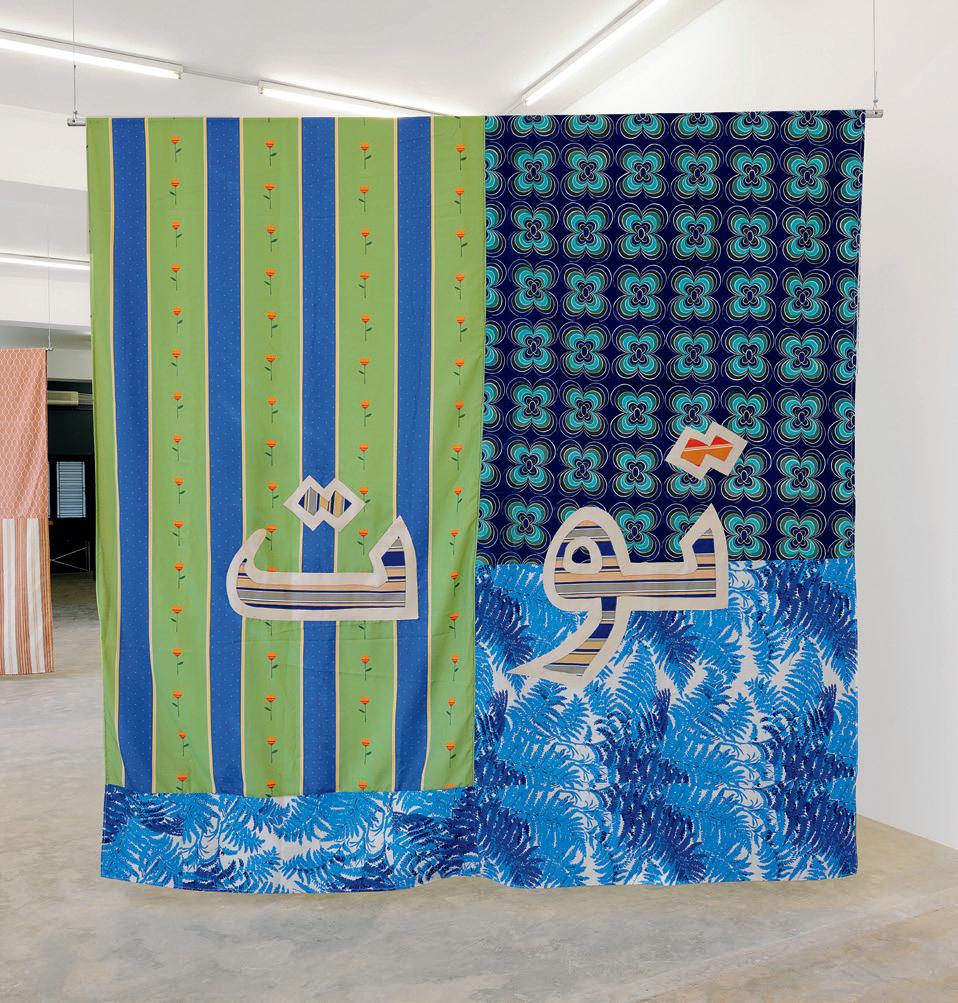

211 210 mounira al solh
The ongoing wars in Lebanon and Syria in recent decades loom large over the work of Mounira Al Solh. In contact with migrants and displaced people she responds with a frantic conversational practice that reconnects all those individuals who have acquired a diasporic status away from their homeland. Through those encounters, a demotic language that bears the traces of biographical experiences emerges as raw
material for the artist. So that the previously unified political body that might have represented the Arabic language breaks down into endless stories told by people scattered all over the world.
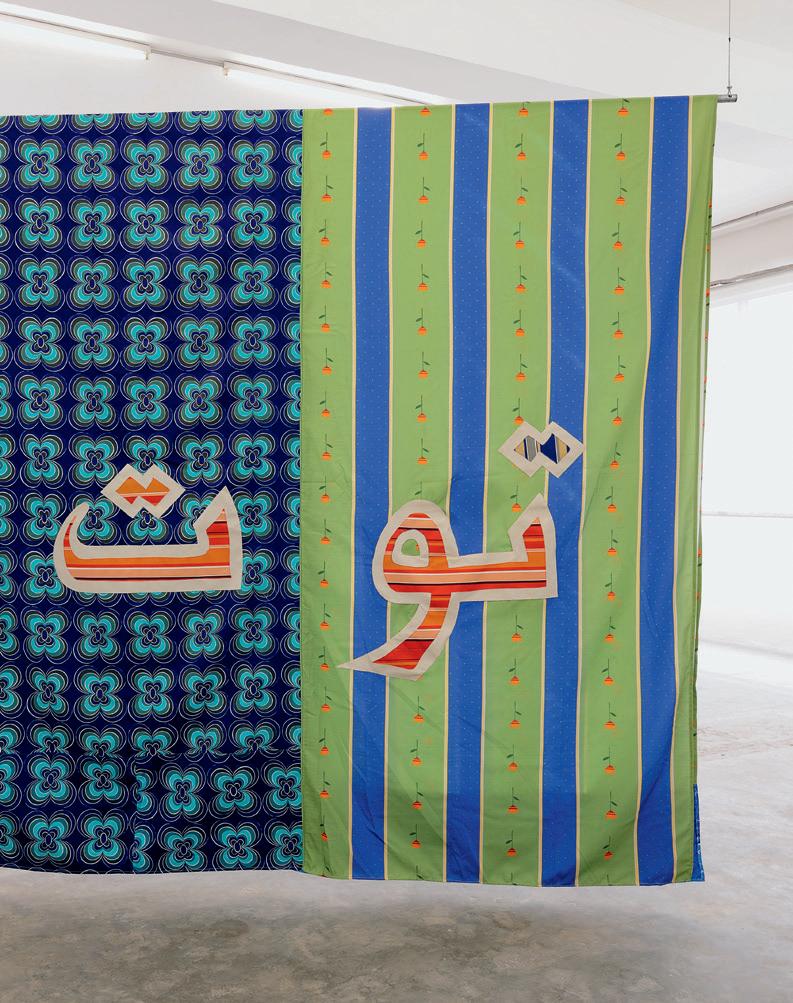
An undeclared pathology of exile exhales through every piece of this artist. Videos, patchworks and performances stitch together fragments collected during the interviews and through her own
nomadic experience. An emblematic example is Lackadaisical Sunset to Sunset (2022), a portable carpet that the artist dragged over time and in the different places she lived, gathering bits and remnants of a daily existence. Like in most of her works, the result is utterly therapeutic and insists on the pathological dimension and the condition of those representatives of a global citizenship marked by exclusion and precarious life. In series of patchworks like Sama’ / Ma’as (2014-2017) she introduces a radical arbitrariness that makes words function as polysemic signs by unsettling fixed meanings. The works from this series emphasize the phonetic – and thus performative and iterative –, as if a precarious life were a life to be experienced throughout mutating and heterogeneous identities. The longing for the collective and a Feminist agency often redeems the dramatic consequences brought by wars and exiles.
carles guerra
Sama’/Ma’as – (توت-توت) – (Berry/Horn), 2014 Double-sided patchwork textile curtain, 273 × 278 cm
The sentence in proverbial language, which holds a special place in the communication process, is the depuration of knowledge of the exchange of waves and radiations (minika ye minienie, in the African Kikongo language) in the act of uttering certain words (with past and present resonances of the ancestors for various circumstances). There is an energy (ngolo) that does not come from the sounding of words or signifiers, but one that evokes a particular way of referring to existence, an inherent cosmology and cosmogram (Dikenga dia Kongo) and, above all, the belief in an effective power of realization.1
There is also the awareness that this is a systemic principle, (de)codified only by those who share a certain way of experiencing language and being/living culturally, as underlined by the Congolese thinker Bunseki Fu-Kiau:
A systematic understanding therefore is possible only if one can taste and feel the radiation beauty [n’niènzi a minienie] of the language that generates that culture.2
In his book Self-Healing Power and Therapy: Old Teachings from Africa, the author states even more assertively: “Waves and radiations can change to forms and images that can speak.”3 Sentences in proverbial language, therefore, as a synthesis and header of existential narratives, are receivers (tambudi), with antennae (mièkese), so that waves and radiations can present ancestral contents and symbols. It is important to emphasize that, according to our interpretation of the Bantu-Kongo culture, based on what Bunseki Fu-Kiau states in his work, ancestry is not
1/ This text is part of Tiganá Santana’s essay, “Cosmologie en performance: sentences proverbiales africaines bantu,” originally published in Agnès Levécot and Ilda Mendes dos Santos (orgs.), Littératures Africaines d’Expression Portugaise, n. 21, Paris, Presses Sorbonne Nouvelle, pp. 93127, 2021.
2/ Kimbwandende kia Bunseki Fu-Kiau, African Cosmology of the Bantu-Kongo: Principles of Life and Living. 2. ed. New York: Athelia Henrietta Press, 2001a, p. 11. Cf. id., ibid.
3/ Id., Self-Healing Power and Therapy: Old Teachings from Africa. Clifton: African Tree Press, 2001b, p. 97.
something terminated, enclosed in a past within a definite time frame. It is constantly updated by an idea of origin, to which a Kongo (Mukongo) person must refer, once the (necessarily collective) meaning of his or her life is conferred. The ku mpemba, or unfathomable spiritual world, is a space-time from which derives the references to all that is experienced and imaginable, but it is, with each becoming, the proximity to the last future experienced in the ku nseke, or physical world. In the ku mpemba, the ancestral locus par excellence, one finds, as illustrated in the Dikenga dia Kongo (Kongo cosmogram),4 necessarily the Musoni and Luvemba stages of any existing being, that is, the invisible beginning and the visible end, of everything that exists and can be captured by the Kongo, or human experience. Thus, we come to what Jarbas Siqueira Ramos says regarding his research on performative action in the Congado:
Thus, the body-voice in performative action [...] does not limit itself to repeating a habit; as Martins (2003) suggests, but periodically institutes, interprets, revises, and re-actualizes the performative act itself, writing, recording, transmitting, and modifying memory as the action takes place.5
By analyzing aspects of the African Dogon epistemology (in the sense of “epistemology — and philosophy — of ancestry” coined by him), in dialogue with French anthropologists Marcel Griaule (1898-1956) and Germaine Dieterlen (1903-1999) — notable scholars of the Dogon cosmology, from Mali — the philosopher Eduardo Oliveira leads us to reflect on the concept (and experience) of vibration. This vibration animates existence, unfolding and radiating from
4/ Let’s remember, at this point, that the cosmogram, as we have stated in previous works, is an inscribed interpretation of the world that reads its logic from the perspective of events that are divided (and intersect) between stages (Musoni, Kala, Tukula and Luvemba) representing, respectively, the unseen, the emerging, the apex — ontological — and the dying.
5/ Jarbas Siqueira Ramos, “O corpo-encruzilhada como experiência performativa no ritual congadeiro.” Revista Brasileira de Estudos da Presença, Porto Alegre, v. 7, n. 2, pp. 296-315, maio/ago. 2017, p. 308.
213 212
philosophical thought, language and body-person in performance: cosmogram, vibrations and “vee” tiganá santana
the seminal human, as advocated by Fu-Kiau, in a similar understanding, in the context of the Bakongo. Oliveira states the following:
A tiny seed is at once the smallest part of the Universe and the entire Universe, given that it spreads all over the planet, germinating it. Unlike metaphysics, which sees the Being as a Monad, whether static or dialectical, the Dogon understand that what animates existence is a vibration 6 The Bantu, on the other hand — cf. Pe. Altuna — understand vital force as the energy that animates the world. If this is true in Southern Africa, it is also true in Northern Africa (for example, among the Dogon). Existence is thought of as starting from a vibration, from energy and emanation. The source of this metaphysics that is more of an infra-physics will allow us to list another fundamental principle of the African Cultural Form, namely: The Emanation Principle. 7
At this point, we would not put as contrastive the “vital force,” recovered by Oliveira from the author Raul Ruiz Altuna’s statement, and the “vibration” of the Dogon. The Bantu waves and radiations, from the ba-kongo, constitute such a force. The movement, the transmutations, what remains, what is unknown, what is experienced, what is virtualized, everything, substantiating and being substantiated by this force, happens in a vibratory way. Human beings (muntu) are the synthesis of this dynamic, because they experience-think it and emanate from it, as Oliveira notes in the Dogon example:
6/ The emphasis in this excerpt is by its author.
7/ Eduardo Oliveira, “Epistemologia da ancestralidade”, pp. 5-6. Available on: filosofia- africana.weebly.com/uploads/1/3/2/1/13213792/eduardo_oliveira_—_epistemologia_da_ancestralidade.pdf. Last access: 23 Jun. 2023.
Man is the synthesis of the germination process of the seed; the universe, a synthesis of human germination, and everything is a process initiated and conveyed by the vibration that animates both the small seed and the immensity of the universe. Each is a process in itself and a synthesis of the other. This whole dynamic is relational, processual, and its dynamic articulates the singularity of the existence territorialized as the cosmovision of the structuring culture. At the same time, each is entirely what is! What’s more, each is at the same time thing and symbol, sign and object, spark and darkness. At the same time, and enclosed in the same instant, each is process and event, event and past, event and future. Each is realization and possibility, deconstruction and construction, creativity and conservation.8
For the existing to fulfill its vocation for transmutation (nsoba) it must vibrate (tatala). Existing is part of the human, but it must expand into the extra-human, which often constitutes the generative anteriority of the human. A whole thread of memory can thus come before, even if through humans, to report to the “analytical category”9 of ancestry. Memory thrives in the present time — this is where the ancestor lives — like ntima, the same term in Kikongo for heart. In fact, just like in the Latin etymological drawings, in which cognoscere per cor is to know by heart. Vibratory memory is embodied by what pulsates in time, bleeds, expands, compresses, cannot stop, forming part of the most individualized interiorities and the same thing or principle in any person.
If we attempt a conceptual transposition (which does not seem odd to us), the thread of memory says of the planet we humanely inhabit, pointing us to the Solar System, which, derived from the Milky Way, leads us to 8/ Id., ibid., p.
7. 9/ Ibid.
perceive an unfolded ancestry, arriving at the unfathomable. The greatest of all ancestors is the unfathomable, what is unknown. Nzambi (or Kalunga) is, as far as we can get for the moment, a (verbal) be-ing existing from itself and from which derive all other things that are. All of this memorial communication resonates and resounds. Among the Bantu Zulu, to ratify this line of thought, the Swedish historian Bengt Sundkler (1909-1995), in his work Bantu Prophets in South Africa, 10 reminds us that the Supreme Being, uNkulunkulu, designates the ancient. Thus, in a context in which ancestry is the originary cavity, mystery is always the amorphous central body (re)fecundating what is.
Congolese writer-thinker Zamenga Batukezanga (1933-2000) stated:
[…] the entire body is both transmitter and receiver. What we are, our gestures, our vibration, influence our environment and operate like waves in the water, in the ocean. The shocks of our vibrations, i.e. our gestures and words, are transmitted over long distances, all the more so as they are charged with energetic power. Modern techniques and energies only serve to increase the natural energy in our bodies.11
Tangible bodies vibrate as much as the immaterial. Everything, as we see it, vibrates the previous, the present, and what is becoming. Everything is vibrating memory — a line of force that brings together all possible temporalities.
10/ Bengt G. M. Sundkler (1948), Bantu Prophets in South Africa. 2. ed. Oxford: Oxford University Press, 1961.
11/ Zamenga Batukezanga, Kindoki: source des philosophies et des religions africaines. Kinshasa: Zabat, 1996, p. 19. In the original French: “[...] le corps tout entier est à la fois émetteur et récepteur. Ce que nous sommes, nos gestes, notre vibration influent sur notre environnement et opèrent commes des vagues dans l’eau, dans l’océan. Les chocs de nos vibrations, c’est-à-dire, nos gestes, nos paroles se transmettent à de longues distances d’autant plus qu’ils sont chargés par une puissance énergétique. Les techniques et les énergies modernes ne nous servent qu’à augmenter celles naturelles disposées dans notre corps”.
The sentences in proverbial language are, by their vibration and uninterrupted memory, what the Angolan researcher Óscar Ribas (1909-2004) called “the spiritual heritage of a people — the wealth of tradition accumulated since the primitiveness of its consciousness;” or, as he later stated, “proverbs constitute the pinnacle of its wisdom. In the depth of the syntheses, as crystallizations of thought, lay the essence of life’s teachings.”12
Professor and researcher Maria Antonieta Antonacci, in turn, when revisiting Marcel Griaule and the encounters of this anthropologist “with the African sage Ogotemmêli,”13 recalls that he
had already emphasized, in relation to the Dogon, the degree of social cohesion achieved in traditional African societies, where the notion of person, inextricably linked to the word, connects to that of society, worldview, and divinity.14
According to our reflection, also among the Ba-kongo, the idea and experience that delineate the person (muntu) are linked to the word as experience. More specifically, with regard to the word incorporated in the proverbial sentence, Antonacci, now in dialogue with the French linguist Jean Cauvin, cites him saying that:
Dispelling prejudiced ideas toward African oral communities, Jean Cauvin, who spent eight years with the Minyanka (Mali), on the subject of proverbial living noted that: “The mynianka man ‘explains’ and ‘creates’ society through proverbs,” drawing attention to injunctions, imagery, and proverbial reality [Cauvin, 1977, p. 39]. According to this linguist, on the Ivory Coast not all “people speak via proverbs, but all are able to understand them. Proverbs form
12/ Óscar Ribas, Missosso I. Luanda: Ministério da Cultura, 1958, p. 154.
13/ Maria Antonieta Antonacci, Memórias ancoradas em corpos negros. 2. ed. São Paulo: EDUC, 2015, p. 354-55.
14/ Id., ibid. (Our emphasis.)
215 214
the armor and the fine basis of a broader type of communication: the language of images.” [Cauvin, 1981, p. 3].15
As an unfolding of what we are dealing with, regarding the word and its vectors of imagetic-material realization we must remember that, according to the Swiss thinker Paul Zumthor (1915-1995), in the first essay of his book Escritura e nomadismo [Writing and Nomadism], vocality — not only orality — is what can bring a “performant presentification” linked to reception. The “investment of bodily energy” that interferes with or even mediates the contact with a (poetic) text defines, according to Zumthor, what poetry is.16 Therefore, assuming the Zumthorian understanding, the sentences in proverbial language constitute a poetic realization; they require performance, in their original disposition (in the sense of what the scholar classified as a “complete performance”), just as they may require “performance that is at once truncated and interiorized” in the act of “visual and solitary reading.”17 Thus, Zumthor, in contrasting text and work, generates the following idea of performance:
• the text is the linguistic sequence that constitutes the message, and whose global meaning (we know) cannot be reduced to the sum of the particular effects of meaning produced by its successive components;
• the work is that which is poetically communicated, here and now: text, sounds, rhythms, visual and situational elements — the term encompasses the totality of factors in the performance, factors that together produce a global meaning, which is also not reducible to the sum of individual meanings. In this sense, the work is by nature theatrical; theater is its
15/ Id., ibid., p. 355.
16/ Paul Zumthor, Escritura e nomadismo, trad. Jerusa Pires Ferreira e Sônia Queiroz. Cotia: Ateliê Editorial, 2005.
17/ Ibid.
finished form, but every performance sustains it in some way.
• From the text, the voice that performs18 extracts the work. It submits itself to this end, by functionalizing all the elements that are apt to sustain it, to amplify it, to declare its authority, its action, its persuasive intention. It uses the very silence that it motivates and makes significant.19
There is a “voice that performs” that reads-enunciates-dislocates-translates, or tradiz [“transays”] (as conceived by Alexandre Nodari at the entrance to the book Algo infiel: corpo performance tradução [Something unfaithful: body performance translation]).20 The performer is not only the one who presents the work, the poiesis, to the world on the basis of being the original enunciator of a text. Whoever receives the work, and interprets it, generating new poetics, can vocalize it (considering the pauses and silences) and offer work to the world as well. It is their work deriving from others. Among the first essays in the aforementioned book, Guilherme Flores and Rodrigo Gonçalves state that:
In the gift of poetry there is something that is always exchanged, something that in its materiality refuses the parting of things, the easy merchandising of things; the exchange of poetry, an impossible exchange on some level, is based on commerce (Hermes, Mercury — god of the market, of thieves, of language, of hermeneutics, of trickery) and yet breaks it. The exchange of poetry could be an exchange of a promise: the poet, the aedo, the bard, the shaman, the èṣù, the performer delivers the work and in the work the promise of a world; in that promise the game
18/ Author’s emphasis.
19/ Paul Zumthor, op. cit., p. 142.
20/
Guilherme Gontijo Flores and Rodrigo Tadeu Gonçalves. Photographs Rafael Dabul. Algo infiel: corpo performance tradução. São Paulo: n-1 edições, 2017.
enacts casting worlds into the world, opening fissures in the given world; leaving it up to the reader, the listener, the body that plays, to make an endless counter promise: to interpret, in both senses of an interpretation, to play the game of hermeneutics, to found meaning in world promises, yes, to analyze, to describe, to think the world-work and its world-effect; but more, to incorporate the work into their own world, to give a body to the work, to give oneself to the work, to give one’s body to the work, in short, to assume the place of the poet, bard, shaman, as an interpreter (or inter-pres, inter-pretium21 — mediation, trade, message) of the music. This is the deepest potential of the world-promises at play in poetry: one performance demands another performance, because the gift is performative. “I give you this,” says the poet; and for the listener there is no easy answer, like “I do not want it”; the poet replies “I have already given it to you,” something has happened, performance has taken place in the moment of giving. “It has been given.”22
The orisha Èṣù [spelt Exu in Brazilian Portuguese], evoked by the authors, the spherical force of all mediations, according to the Yoruba African cosmology, in a syncretic-translational way, in Brazil, is associated with the image of the crossroads. This configuration is very dear to the Bantu-Kongo people. In fact, much like the yowa that synthesizes the cosmogram mentioned earlier in this essay. The crossroads (especially the four-way), thus speaks of things unseen, of things that ontically emerge, of things that reach the apex of achievement and things that disintegrate, like the sun at sunset.
In Afro-Brazilian spiritual practices, Èṣù — a force of communication, of movement and of syntheses — is also,
21/ All emphasis are by the authors of the excerpt. 22/ Guilherme Gontijo Flores and Rodrigo Tadeu Gonçalves, op. cit., pp. 23-24.
in another understanding and tradition, Nzila, meaning path. The path full of frequencies and intertemporal coexistences that are established between the performer-poet of a proverbial sentence and the active body-listener that performs and completes the poetic work of enunciation-act is the manifestation of this orisha or nkisi — based on the Bantu-Kongo traditions — in what we can coin as a Black ethics of speaking. Jarbas Siqueira Ramos, based on the idea of a crossroads culture, pointed out by Leda Maria Martins, presents us with the concept of a crossroads body: “Generally speaking, I understand the crossroads body as a metaphor that allows locating, in a performative body, the nodal point of intersections.”23
In conversation with Jarbas Siqueira Ramos, we can think that the body that performs the enunciation-act of sentences in proverbial language, at the same time that it establishes the mediation between distinct temporal universes (considering the existence of ancestral time and circumstantial space-time, which, in the present, indicates an abysmal becoming), delivers to others new possibilities of filling the relevant place occupied by sentences that come from afar and traverse time. Similarly, we could mention at this point, the (entirely corporal) saying of an oriki (Yoruba sacred poem) or the action of public chanting in terreiros (sacred spaces) of Candomblé, Umbanda, Quimbanda, Xambá, Xangô, Tambor de Mina, Batuque, among many others, as a poetics of realization based on corporal presences and on what is unseen/tangent. Note that the categorical bifurcation between artistic performances and cultural performances does not encompass what we bring in this essay. There are identified poetics (in the Greek sense of a set of feats) that can be interpreted as art-culture-philosophy-science all at once. The “unfinishedness” of Afro-diasporic artistic achievements, as discussed by the British thinker Paul Gilroy,24 a term we might replace in our analysis by openness, does not allow us to bring such performative events
23/ Jarbas Siqueira Ramos, op. cit., p. 310.
24/ Paul Gilroy, The Black Atlantic: Modernity and Double Consciousness Cambridge, MA: Harvard University Press, 1995.
217 216
into closed epistemologies; rather, into comprehensive and intersecting epistemologies, and, to follow a Bantu-Kongo image-concept brought by Bunseki Fu-Kiau in his work,25 that open in the shape of “V”.
means being (in its primarily verbal sense),28 embodies the stage at which this being as action becomes a visible entity. In a third stage we find Tukula (from the verb kula — to grow, mature, develop) with things and situations in their zenith state, of most active fruitfulness, of action itself. Finally, Luvemba29 configures the stage of physical disintegration, the dying, the end-beginning, the great transmutations of things that are; in other words, the disintegration of the tangible dimension and the movement to an unfathomable plane.
According to the cosmogram, we have four “Vs” graphically demarcated by the spaces between Musoni-Kala, Kala-Tukula, Tukula-Luvemba, Luvemba-Musoni. As previously stated, we thus emphasize, according to Fu-Kiau,30 one of the main Bantu-Kongo concepts, the Vee, disseminated to the world of readers for the first time by the thinker:
The Kongo cosmogram (Dikenga dia Kongo) can contribute to broadening the understanding of what concerns the utterance-act of sentences in proverbial language. Further following the logic of what Fu-Kiau explains,26 there is a first stage of being, Musoni (to guard the radical sona:27 to register, record, have the memory of), which is not seen in the physical world (ku nseke). Musoni is, broadly speaking, not yet being physical, tangible. Kala, which literally
25/ Kimbwandende kia Bunseki Fu-Kiau, 2001a, op. cit.
26/ Id., ibid.
27/ Cf. Wyatt Macgaffey, Religion and Society in Central Africa: the Bakongo of Lower Zaire. Chicago: University of Chicago Press, 1986. MacGaffey, regardingthe kongo − week divided into four days: nkandu, konzo, nkenge, nsona, notes that: “Nsona and nkandu were days of the ancestors and of resurrection, suitable for emerging from ritual seclusion (sona, ‘to make ritual markings on the body’)” (Id., ibid., p. 51.) In the original in English: “Nsona and nkandu were days of the ancestors and of resurrection, suitable for emerging from ritual seclusion (sona, ‘to make ritual markings on the body’)”.
It is at the feet of some of these underground masters that I learned not only about the “V” (the basis of all realities), but the foundation of the Bântu people system of thought as well, their cosmologies. No one can truly understand the “Vee” without any basic knowledge upon Bântu world view, or their cosmologies. Our own work, as would later write two American scholars, is the first on the subject…31
Still on the subject of Vee, Bunseki Fu-Kiau pointed out:
The “Vee” is the basis of all inspirational realities such as great ideas, images, illustrations,
28/ In Kikongo, “being”, as a noun, is often called kadi or be, in the sense of Bunseki Fu-Kiau. According to the Novo dicionário português-kikongo (compilation by Francisco Narciso Cobe. Luanda: Mayamba, 2010,) we also find, for “being,” in its substantive form, the terms vangwa, ma, kima, zingu e nkala
29/ Metaphorically, based on what Bunseki Fu-Kiau explains, MacGaffey (op. cit., p. 43), in the perspective of human life, reminds us that this stage, a “sunset,” is the one that “[…] signifies man’s death and its rising his rebirth, or the continuity of his life.”
30/ Kimbwandende kia Bunseki Fu-Kiau, 2001a, op. cit.
31/ Id., ibid. p. 129.
Tukula
Luvemba Kala
Musoni
inventions of all orders (including works of art), wars and conceptions, both biological and ideological as well. It is the process [dingo-dingo] of all changes, social and institutional; natural and unnatural; seen and unseen.
To talk about the “Vee” is to talk about realities, whether they are biological, inspirational or ideological, material or immaterial. They all pop into our minds in forms of the Vee (beam span of the Vee) inside us at the Musoni zone of the Kôngo cosmology. We seek for ideas and images through ‘the open beam of the Vee’ inside our mind and on the contrary we focus details under reverse beam of the “Vee.”32
Each stage that demarcates the Kongo cosmogram has its Vee, that is, its disposition to expand and retract, with specific denominations and meanings. The V of conception, emanated by Musoni, is called Vangama. The second V emerges at the ontological stage Kala and is called Vaika. The advent of Tukula makes itself known by the name Vanga, which, according to Bunseki Fu-Kiau, is a denomination “derived from the archaic word ‘ghânga’ — to perform, to do,”33 representing the crucial V of human life in the physical world. Vunda — to rest, extinguish; think, too, that the verb vonda means to kill — it is the Vee found in Luvemba, the last stage, whose “function is completed under the fwa, 34 die action.”35
Grounded in the “beams of the Vee” (present in the cosmogram), the body that enunciates kingana (proverbial sentence) presupposes stages of expansion and concentration, as suggested by the very shape of the V. Before a sentence in the Bantu-Kongo proverbial language, we
32/ Ibid., p. 130-31.
33/ Ibid. In the original: “[…] derived from the archaic word ‘ghânga’ to perform, to do.”
34/ Our emphasis.
35/ Kimbwandende kia Bunseki Fu-Kiau, 2001a, op. cit., p. 141. In the original: “function is completed under the fwa, die action.”
encounter a concentration of waves and radiations (minika ye minienie) of culture, thought, language, of narratives that rely on the ancestor (bakulu), that is, on the invisible world, ku mpemba. This entire concentrated record takes us back to the stage, in the process of enunciation and realization, of Musoni, as well as to the figuration of a sentence in proverbial language (kingana) that symbolizes the narrowing of an earlier, ancestral beam of expansion; or, if we like, of accumulated narratives about the world and a new starting point for expansions or displacements to come. This dynamic between what is concentrated in order to expand again, in a never-ending process of hermeneutic experiences and creation of the kongo (mukongo) person, we could call dingo-dingo — the process, in constant motion, of each thing, in order to become, necessarily, another thing, moving to another ontic state. There is a need, out of principle, to give due philosophical relevance to undoing. The body that utters-acts, in accordance with the proverbial sentences, reconciles constructions and disintegrations in the face of its presence and of other presences. It is life-death, kala-zima (turn on and off), emerging at once in a Black performative event, which, as we know, did not remain solely in the African continent.
The following are examples of sentences in proverbial language, even in the absence of the bodies enunciating them and the act of realizations-presence. The texts of other multidimensional realities are not enclosed between the walls of this essay fulfilling certain academic rites. They are:
Kutombi didi dia (ngolo za) zunga ko kwidi zungwa. Do not seek the regional center of driving forces; they are confining.
Nga nzenza muntu katunga fu kia bwala? Does an outsider make a system of their non-village?
Wampana nsengo, kunkambi kwe ngatu bwe isadila yo ko Give me a hoe, and I will know how to use it.
Kanda diasala nsang’a n’kento ka ditumbukanga ko. Community, by woman, is not extinguished.
219 218
Mbungi a kanda va kati kwa nsi ye yulu. The originating span of the community, at the center, between earth and sky.
Kanda kandu: ka kiloswa; ka kisambu. Community is taboo: you do not leave it; you do not worship it.
Kolo diakanga nganga, kutula nganga Kolo done and undone by nganga: every knot has its master.
Translated from Portuguese by Mariana Nacif Mendes
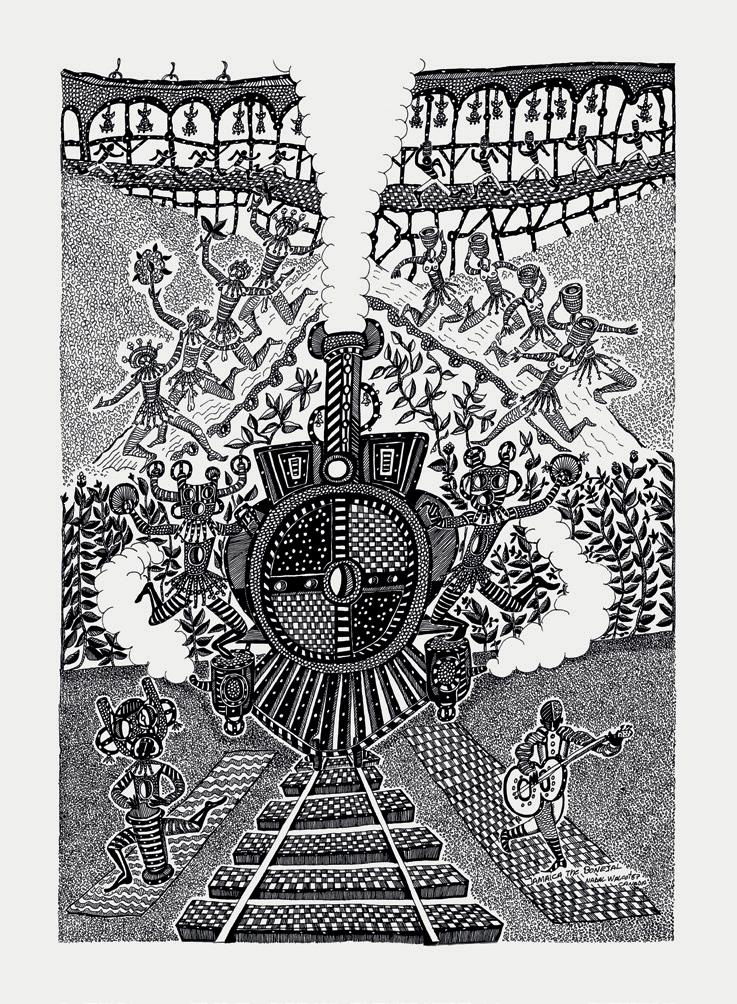
221 220
nadal walcot
Jamaica, 1986
Silkscreen print on paper, 54,5 × 36 cm
In the act of repetition lies the power of variation. In this theater of memory’s shadows, images come and go, but they are never the same, because, in detail, everything is something else. The grip that tilts the machete when cutting the millionth sugar cane, the hip spiraling in street dances, year after year, the hand bending to the imperious will of a drawing that demands more physical effort and more ink
on paper. Nobody does the same thing twice: that’s everyday life. In the cane fields, in the cities, or in the studios. The Dominican artist Nadal Walcot (1945-2021) was actively aware of this state of affairs – without concealing his debt to M.C. Escher. Walcot, who had learned many languages in his youthful trade as an interpreter, ended up operating another kind of translation: from everyday scenes
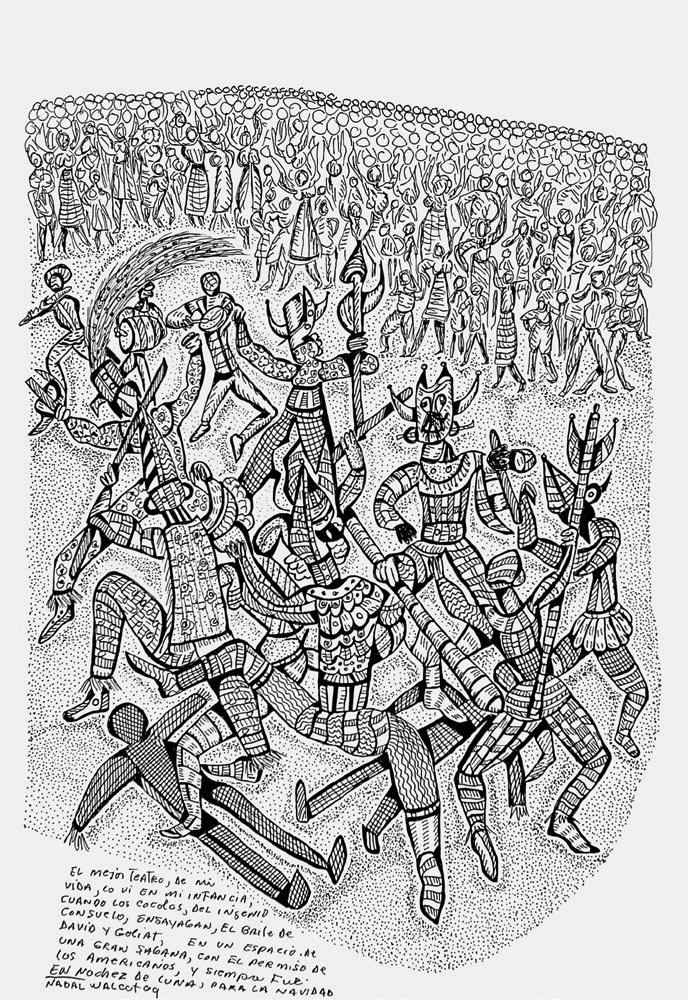
into the language of drawing. The smoking locomotives, the exploitation of labor in the sugar mills, the plotting and transactions of trade in the ports. The landscapes are always human, even if we only see the figure of a train. As a child, Walcot used to sneak into a wagon and spend days away from home, only to be flogged by his grandmother on his return.
In dance, too, the intelligence of his line is displayed, including when he incorporates and recreates the expressions of cocolo music and dances (a term used in the Dominican Republic to designate Spanish-speaking immigrants from various ethnic groups of African descent in the Caribbean). In these works, the lines of human figures are charged with the same energetic matrix of the cultures that make up the choreographies of personal and collective memory. Thus, from subjects – as well as form – emerge the strength of the contradictions underlying a historical reality, witnessed and modified by an artist who interprets colonial violence but also the euphoria of people at parties; who sees the advance of industrialization reaching only the powerful.
igor de albuquerque
translated from Portuguese by philip somervell
David & Goliath, 2010 Ink on paper, 53,3 × 44,5 cm
Every project by Soumeya Ait Ahmed and Nadir Bouhmouch is an attempt to carve collective spaces for making and sharing “from below.” In their view, art must stay connected to popular forms of culture and learn from ancestral modes of relation. They do not aim to represent a “national” culture, nor do they strive for “universality.” For them, such categories only serve to homogenize cultural

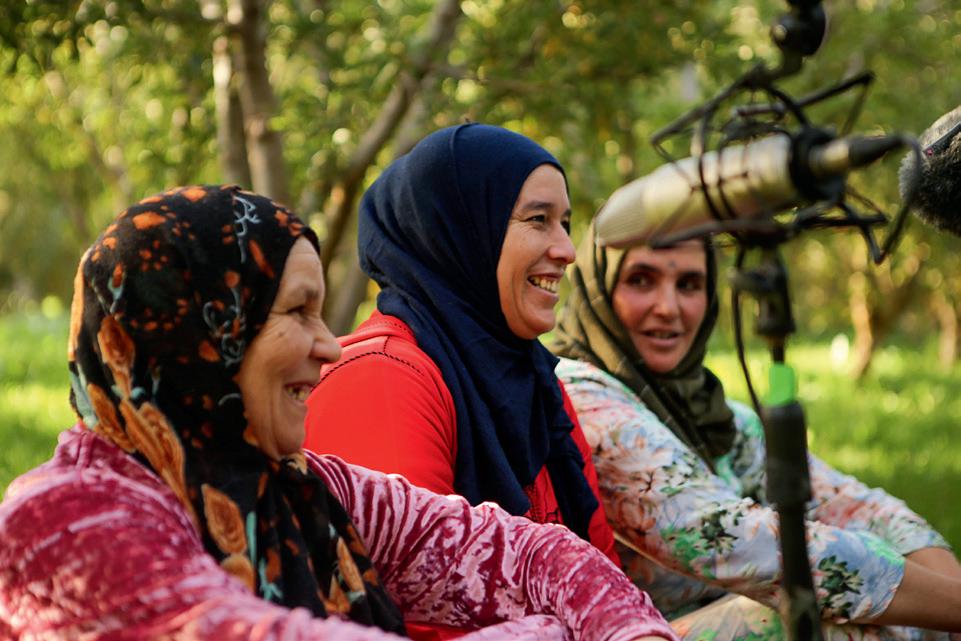
223 222
nadir bouhmouch and soumeya ait ahmed
Fadma Boutalaa, Zahra Hicham and Aicha Amoum in a song recording session in the apple orchards, 2022
production. On the contrary, they foreground specific, local traditions and strive to make them exist on a larger scale via forms of solidarity that extend beyond national borders.
This mode of thinking was obvious at Documenta 15, in the hospitality space offered by Le 18, a Marrakech collective of which Bouhmouch and Ait Ahmed are key members. It is also an essential
engine of their Awal project, which investigates ways of documenting traditional oral arts and decolonizing contemporary practices in the Atlas and Southeastern regions of Morocco.

Amussu (2019), a feature-length film directed by Bouhmouch, portrays a rural community’s resistance against the largest silver mine in Africa, which has appropriated and polluted their water, destroying
oases and almond groves. The film foregrounds the everyday lives and gestures of the villagers and their indigenous, creative modes of political organizing and memory-making (multigenerational speaking circles, oral poetry, etc.). The filmmaking process took a cue from these very modes: Bouhmouch actively collaborated with the community of villagers, who became the film’s producers.
Bouhmouch and Ait Ahmed’s project for the Bienal de São Paulo brings together the various formats of their work (video, publications, performances, gatherings) around one challenge: the exhibition space must aspire to be an assays, that is to say, a village square in the Amazigh tradition, an assembly space; as they declare in their proposal to the exhibition: “a technology in which orality produces horizontal mechanisms for popular decision-making, conflict resolution, artistic creation, knowledge exchange and agricultural production – all at once.”1
omar berrada
1/ Nadir Bouhmouch & Soumeya Ait Ahmed, from the proposal submitted to the 35th Bienal.
A picnic with Fadma by one of her fields, this time with the presence of Nabil Himich, visual artist and illustrator for the covers of the Against Monoculture publication series, 2023
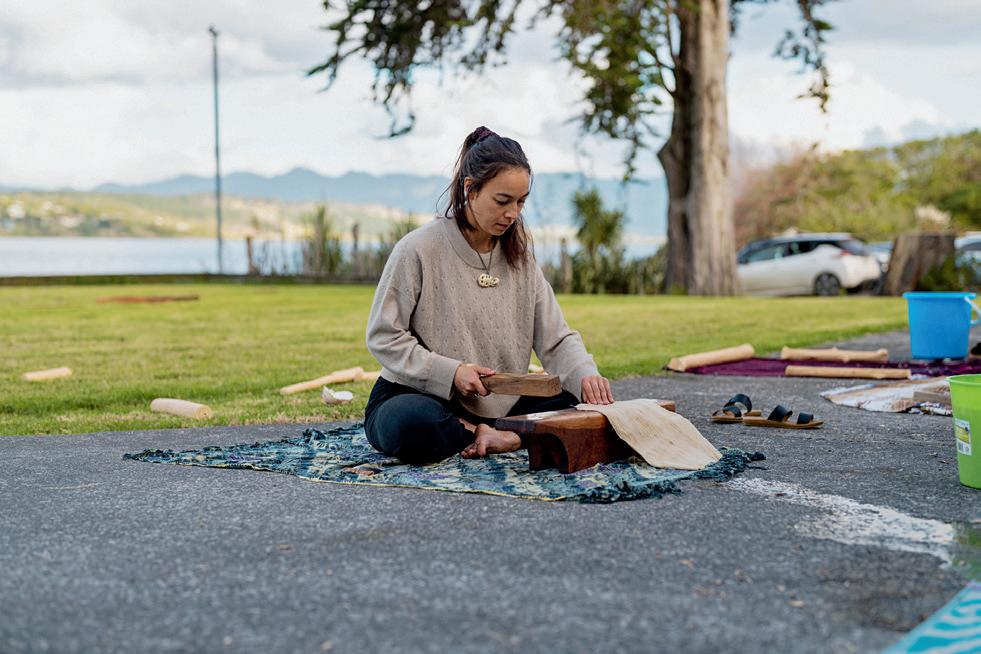
225 224 nikau hindin
Nikau Hindin applying the final wai tohu (embossed texture) to the aute fibre
Nikau Hindin recovers the traditional Maori practice – disappeared for more than a century – of making aute: a fabric obtained from a lengthy processing of mulberry bark. Hindin’s operations unfold in the transmission of this practice into collective actions, so that the entire knowledge system and worldview involved can be reborn and re-established today as a work of reconnection of those who are here with their ancestors.
From the creation and use of typical tools to produce incisions in the mulberry bark and open it up for utensils to beat and open the weave of the tree skin, soaked in water, dried again, and then soaked again, the raw material of this process is made of time, and it is in it and through it that the magical transformation of the material quality of the bark into fabric takes place.
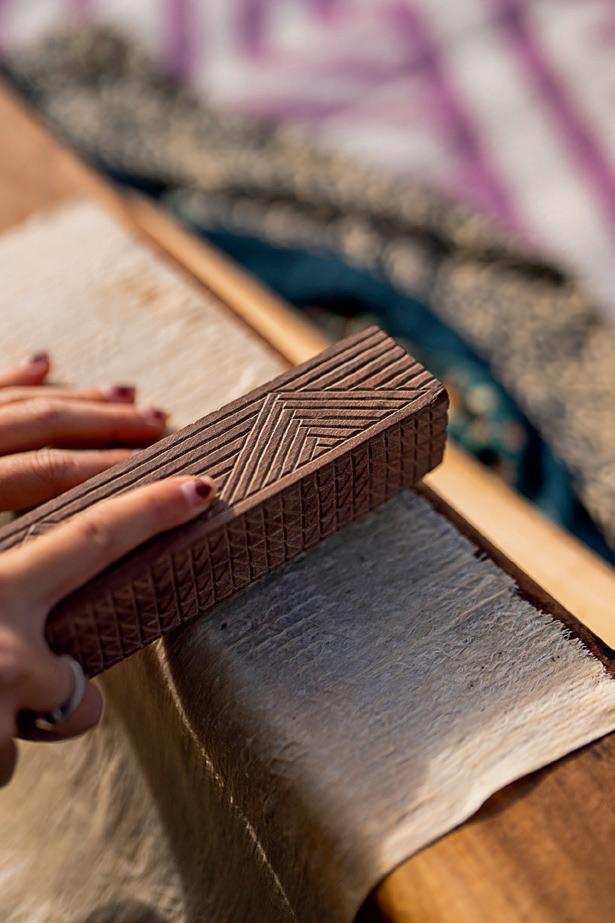
Both the bark and the material derived from plant fiber are a wrapping, a kind of skin. Poets know that house and body share the same nature. That the tree when standing makes us dream of the heights of heaven and that its roots take us to the depths of being. When lying down, reverie can easily turn it into a canoe. The images are rich in protection and potential movement.
The graphic system elaborated with earth-based pigments in Hindin’s paintings refers to star maps, the ancient Maori method of observing the shifts of the stars in the sky, as a form of navigation and life orientation in space and time. Lines and arrows produce dynamism in up and down movements, representing the oscillation of the stars, taking the horizon as a point of reference. His research encompasses a value system and calls us to carry out a genealogy of processes, a genealogy of memory, and to exercise respect for the cycles and patterns of nature, in a balance between water and time.
emanuel monteiro
translated from Portuguese by philip somervell
Nikau Hindin beating the bark cloth at her marae, Ngai Tūpoto ki Motukaraka in the far North of Aotearoa, New Zealand
niño de elche
El Niño de Elche, who identifies himself as “ex-flamenco”, shares with the “cinemista” (film-alchemist) Val del Omar a transcendental aim and an experimental disposition. His transcendental aim encourages him to take risks, in the edges of social and political reality, as an engaged singer, or in an experienced reality, deep in the flesh and the spirit. This second search, which for centuries has been the sphere of religion, can
come into conflict with the first, and produce ideological conflicts and personal tears. El Niño de Elche does not avoid them, the same as Val del Omar, who could not escape his context, in the darkest years of the Franco dictatorship, under the Falangist-inspired National-Catholic ideology. However, his poetic and technical practice does not respond to a political motivation, but to a visionary one. His was a quest for the
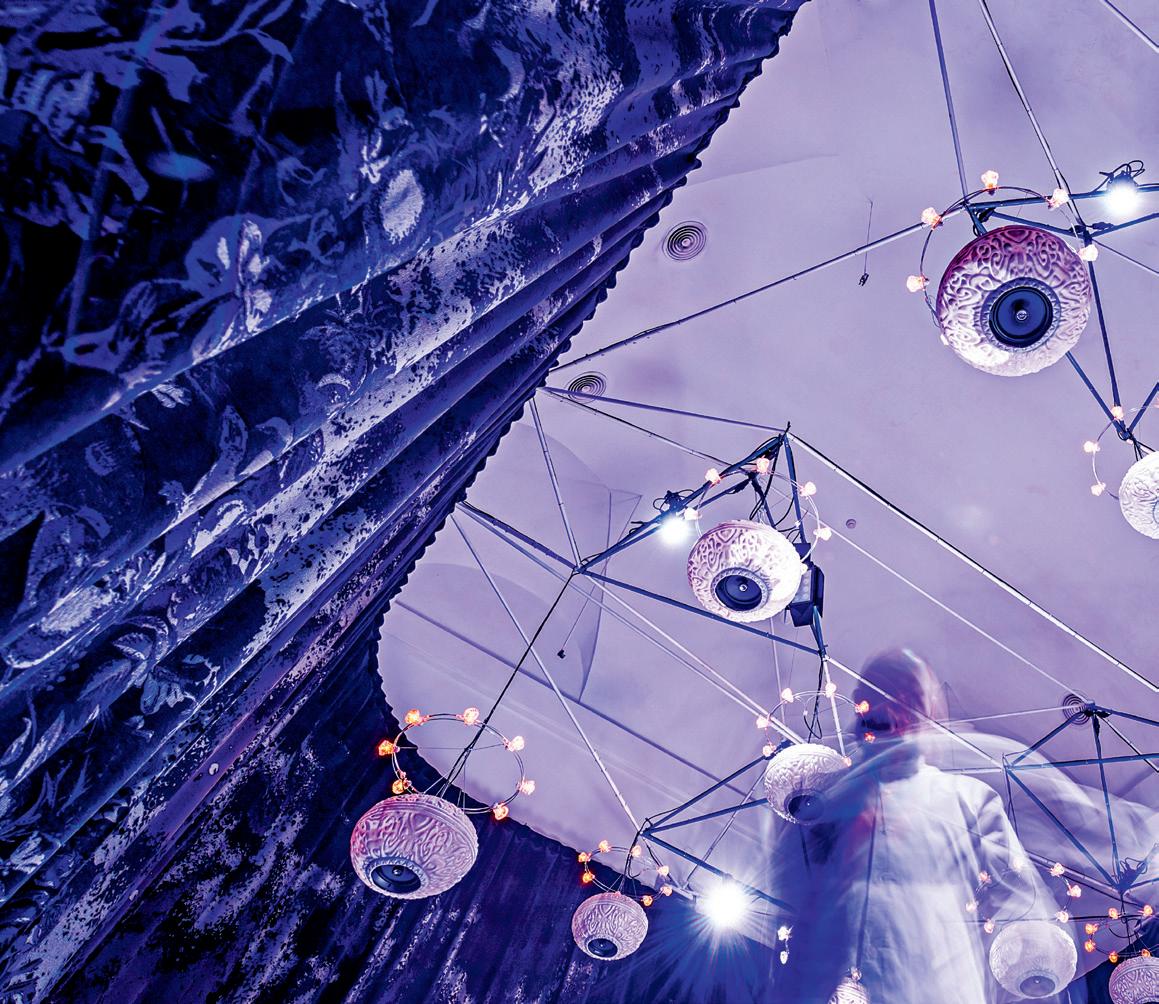
227 226
exhibition view: Auto Sacramental Invisible. Una representación sonora a partir de Val del Omar. Invisible Sacramental Play. A Sound Representation Based on Val del Omar. Museo Reina Sofía, Madrid (2020)
absolute, and this purpose mobilized him towards the production of a total cinema, which he called “mecamistics,” through a series of technical inventions that he patented and that led him to conceive an expansion of cinema through the apanoramic overflow, Diaphony, TactilVisión and others, in which he worked until his death in the PLAT Laboratory. The Auto Sacramental Invisible. Una representación sonora a partir de
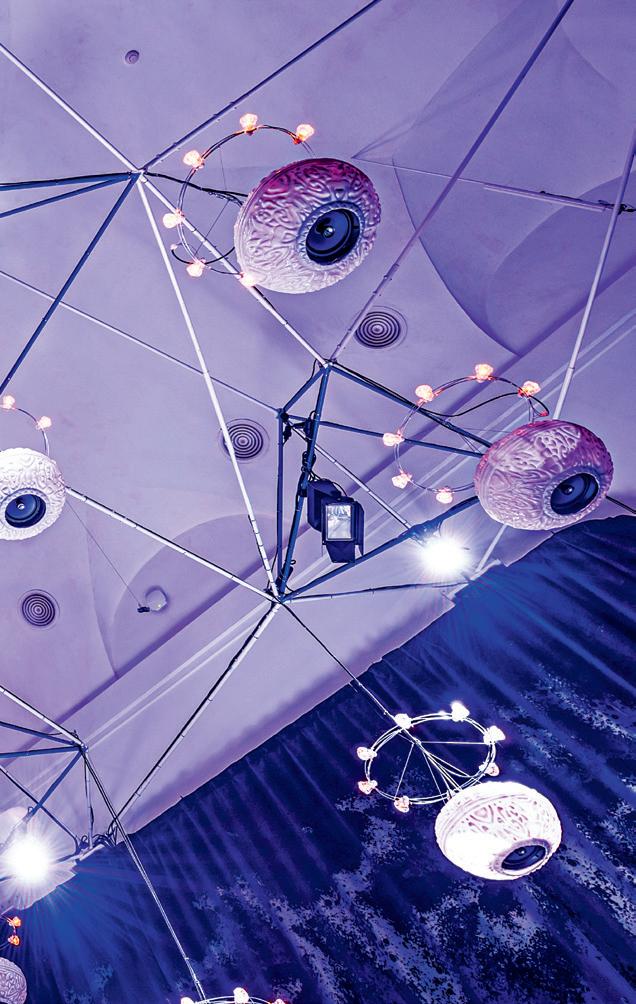
Val del Omar [Invisible Sacramental Play. A Sound Representation Based on Val del Omar] (2021) is a project that reveals Val del Omar’s devotion to acoustic experimentation. In its title and structure, it refers to the eucharistic plays, stage pieces with allegorical content, which he reinterpreted to capture his own obsessions: the water from the fountains, original sin, the atomic bomb, the experience of time without history,
Granada as a melting pot of cultures, among others. In its projected realization this Auto had the form of a sound installation; the “invisible” refers to the idea of a penumbra that favors listening in a space illuminated only by votive lamps. “Active listening” is Niño de Elche’s departing point: carefully reading the multiple versions of the script (its variations or differences) and stage instructions, and spending weeks listening the complete sound archive, made up of hundreds of magnetic tapes. The cinemista’s recordings pass through the ex-flamenco’s body in a kind of possession ritual. Vocal technique is at the service of this poetic and transcendental experience, which does not need to get rid of the material to reach the invisible. The flesh is also clay, the voice is also water, but its medium can be electronics. The song is transferred to the magnetic support (now digital), it becomes concrete, making real Manuel de Falla’s dream (who had speculated on mechanical music and recorded sound as means that make possible a music without performer). And the theatrical community disappears from the stage, but it manifests itself in the multitude of voices that make up the script-palimpsest, and the multitude of eyes and hands that have intervened over the years to make this installation possible. The theatrical is also realized in the invitation to the spectator to participate in that other non-spectacular choreography: the one that he composes with his movements in the active listening of a sound that is spatialized, always fleeting, like the lamps and the images that contribute to the invisibility.
josé antonio sánchez
this participation is supported by: Acción Cultural Española (AC/E) and Embajada de España en Brasil.
nontsikelelo mutiti
Throughout the Black diaspora we can marvel at the capacity of African peoples to affirm the strength of their traditions, their imagination, and their creative capacity. It is so striking, as well as intense and plastic, that African production has spread through various territories, resulting in a new and ancestral culture. In the diaspora, the beauty of permanences and rereadings gave birth to
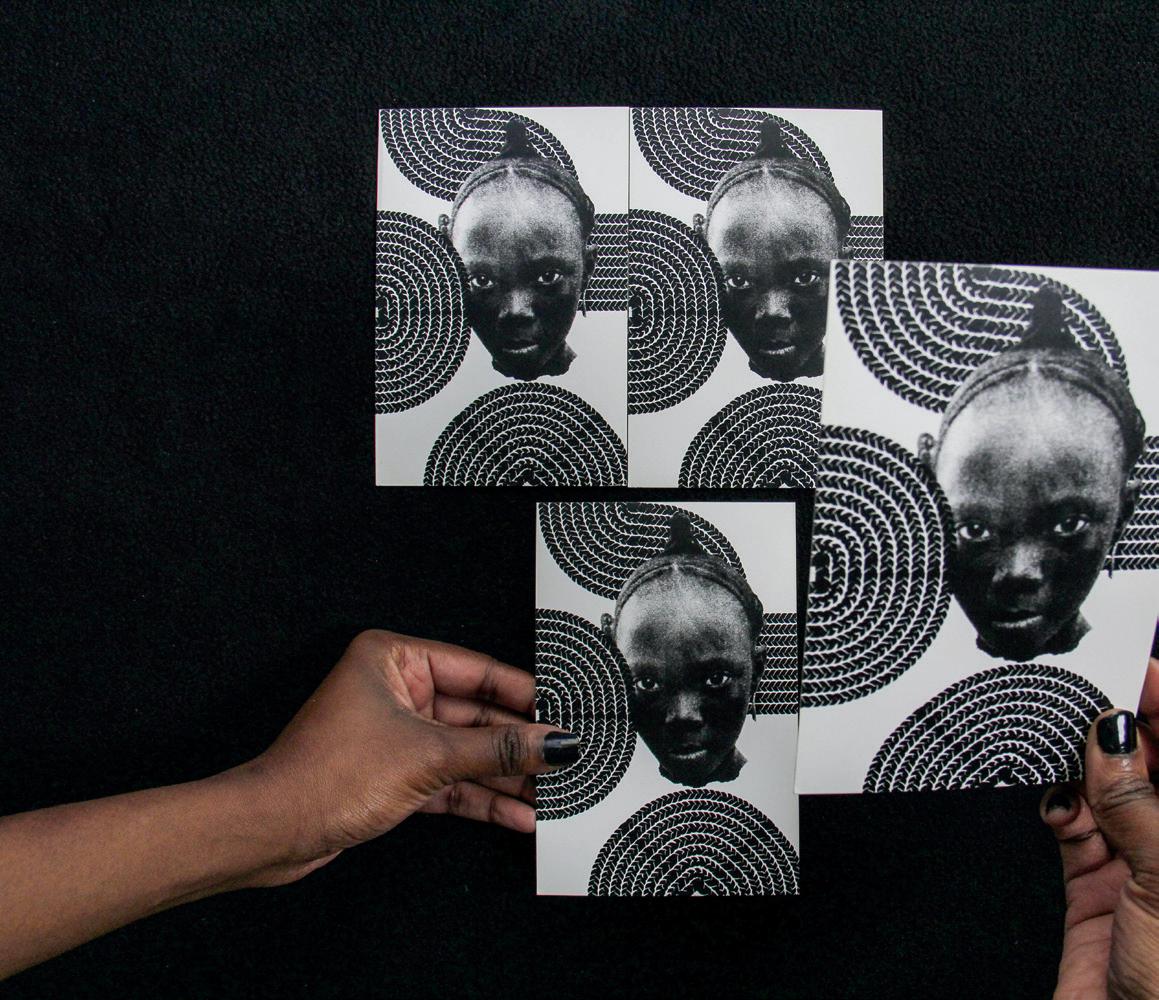

229 228
an Afro-American culture, attracting new symbols and meanings, especially aesthetic and political ones, the fruit of daily elements and experiences that constantly acquire new meanings.
The artistic production of Nontsikelo Mutiti, born in Zimbabwe, takes a plunge into the meanings of braids and hair as one of the elements of the African diaspora that carry not only political
and aesthetic but also subjective meanings, which say a lot about the daily life, experiences, and history of Black people in the diaspora. The ability to produce a technique and a visual culture that manifests itself in a certain type of braiding, whose repetitions, as a whole, produce a singular pattern, is considered by the artist a technique loaded with cultural meanings of intense political power.
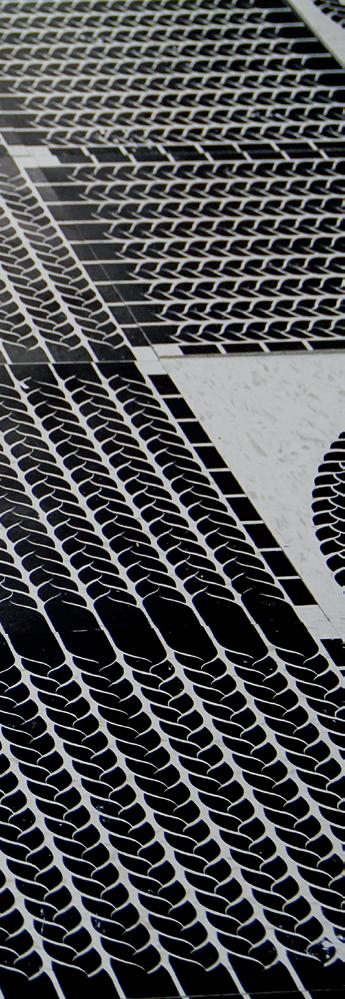
The weave of braids that adorn the Oris of black people, especially women, in addition to being directly linked to the desire to manifest beauty, has since the 1970s also been linked to the desire to affirm African ancestry. The body as a political instrument, which leaves messages wherever it goes, was skillfully used as a tool to demonstrate the beauty of and connection with the African continent, whether in the streets of Brazil, the United States, England, France, Colombia, Cuba, or throughout the African continent. Thus, an appropriation occurred that transformed into artistic-political-cultural that which before, perhaps, was artistic-cultural-ancestral.
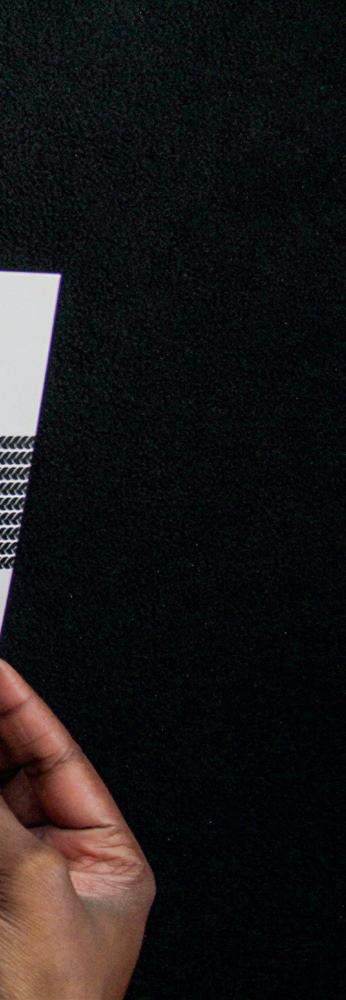
To dive into this universe of appropriations in the diaspora, Mutiti explored the space of Beauty Supply Stores, identifying aesthetic and visual elements that are recurrent and that demonstrate a longing for beauty and humanity, which manifest themselves through a particular grammar of the desires of Black people in the diaspora: African Pride, Africa’s Best, Dark and Lovely, Africare, Black Thang, expressions that before appearing on the packaging of beauty products were part of a political vocabulary. As fluid as the threads that cross the space between the teeth of the comb, for Mutiti, are the African and Afro-diasporic imagination and creative capacity.
luciana brito
translated from Portuguese by philip somervell
print
T(H)READ postcard, 2023 Digital
patricia gómez and maría jesús gonzález
1. our artists’ projects and interventions start from conflicting and residual spaces: gentrified neighborhoods, deactivated prisons, disused psychiatric hospitals or, as in À tous les clandestins [For all the clandestine] (2019), abandoned detention centers for immigrants.

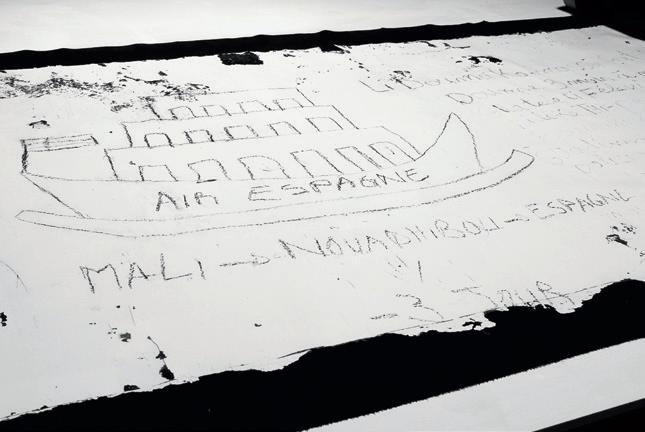
2. these peripheries of meaning articulate discourses of stress and semantic saturation which, alluding to the marginal, write the centrality of what we do not see because we do not wish to see it.
above, from left to right Celda 3-3. Centro de Retención de Migrantes de Nouadhibou, Mauritania, 2015 Please don’t paint the wall. CHARLIE-I. 1-d. CIE El Matorral, Fuerteventura, 2014 Please don’t paint the wall. CHA-D-1i-8689. CIE El Matorral, Fuerteventura, 2014 Mural print on canvas

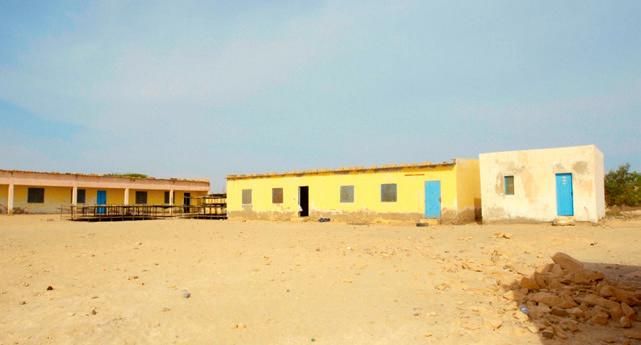
231 230
3. reading in the oblivion of these margins – in the degradation of these social residues – implies writing, from the ruins of silence, the core of a memory that is a superposition of texts.
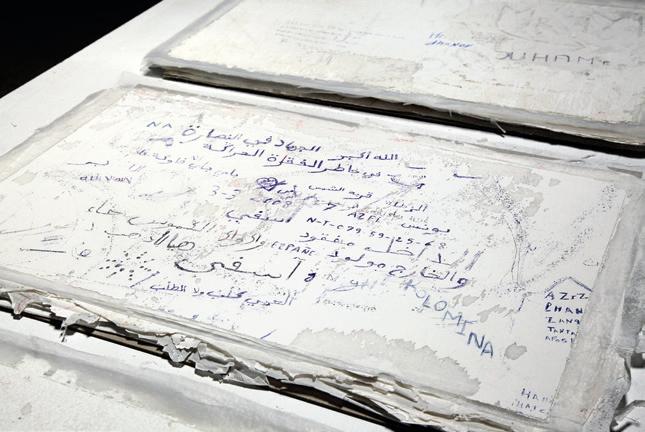
4. the Nouadhibou migrant detention center in Mauritania, created to control the movement of migrants by sea from Africa to the Canary Islands, responds to a physical reality and, therefore, to a simultaneous moral reality.

5. the proposal of María Jesús González and Patricia Gómez is basically in line with this physical reality. In fact, in this and other projects, they follow traditional artistic-technical guidelines: printmaking, engraving, removing murals, photography, and video. In addition, the exhibition of the works produced is also traditional. However, beyond the aesthetic, what is proposed does not place us in front of an object, but in front of a subject: an active subject that activates us and challenges us ethically.

6. the subject of this would seem to be narratively concerned with memory as all the interventions of these artists have an archaeological sense based on the systematic recovery of differentiated strata of signs. Despite this, such an archaeology is based neither on a restoration of the lived experience nor on its documentary rescue, but on making us experience a recuperation that escapes from the nostalgia of memory and its late-romantic drifts.
7. if this is so, the work shown is not a result, but the traces of a process: that of our experience as ethical subjects.
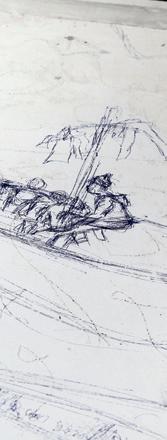
david pérez
translated from spanish by ana laura borro
this participation is supported by: Acción Cultural Española (AC/E) and Embajada de España en Brasil.
two images below, from left to right Le Centre, 2015-2023 The Center. Video stills. Video HD, color;
third image below Le processus, 2015-2023 The Process. Video still. Video HD, color
Walls, floors, fabrics, blinds, and glass. Light and smoke. Dark and opaque, matte, shiny, transparent or semi-reflective surfaces. Black boxes cropped by the frame of the camera’s glass eye, which also dances. Chains and wigs in unlikely places, colorful shoes, inverted, facing two directions at once. The front is the back is the front is the back. The editing comes and goes, sneakily, mirroring the timeline without ever

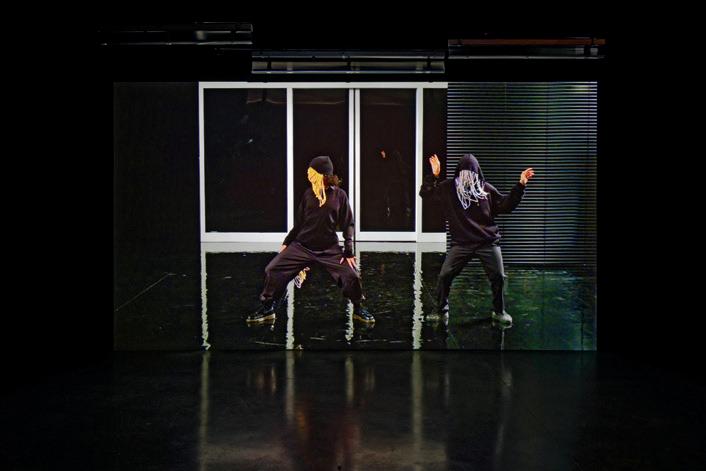
revealing its turning points. The end is the beginning is the end is the beginning. So is the choreographic displacement of these pieces: multidirectional. Exercises to throw off the gaze that, conditioned to linearity, expects to find progressive time and spatial continuity. Rehearsals for guerrilla warfare and escape on the portable dance floor that are the bodies. To remain in shadow by choice, to disappear. To turn the
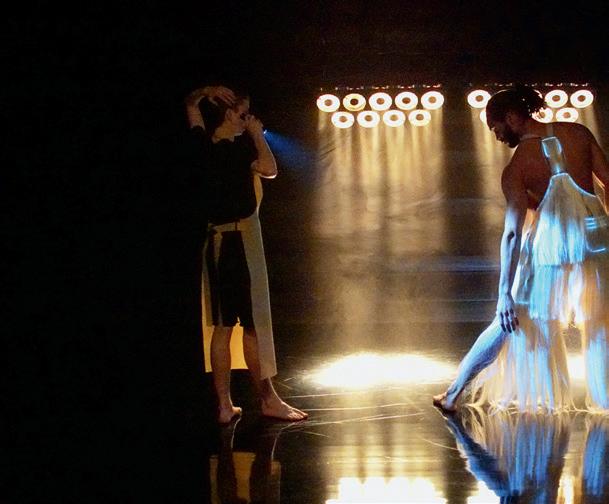
233 232
pauline boudry / renate lorenz
Les Gayrillères, 2022 2 channel video installation (projection and LED); 18’ (No) Time, 2020 Video installation with HD and 3 blinds; 20’
focus of light outward, to dazzle the eye of the beholder.
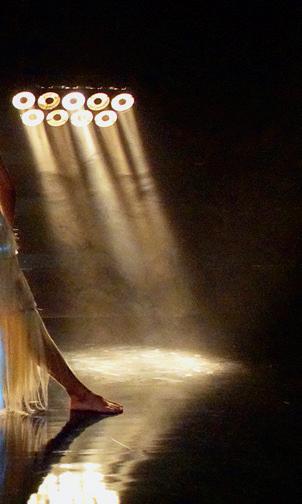
The video-installations presented by Pauline Boudry and Renate Lorenz experiment with space-temporalities not measurable by Newtonian physics. The progressive, hierarchical linearity (something is always behind, or below, or in the past) that governs the modern view on matter collapses. Both the movement of the
performers and the visual and filmic elements of the works are governed by paradoxes that are foundational in the lives of minorities: the congruence between hypervisibility and opacity, transparency and reflexivity. Here it is possible to move in more than one direction simultaneously. Filmic bodies and dancing bodies deconfigure the pre-established political-cultural conditionings and become similar
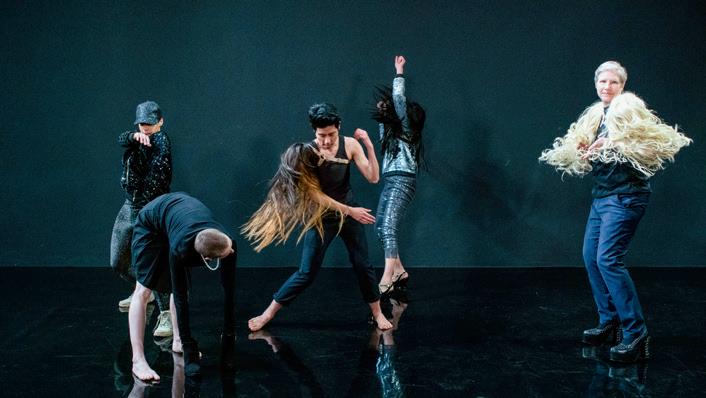
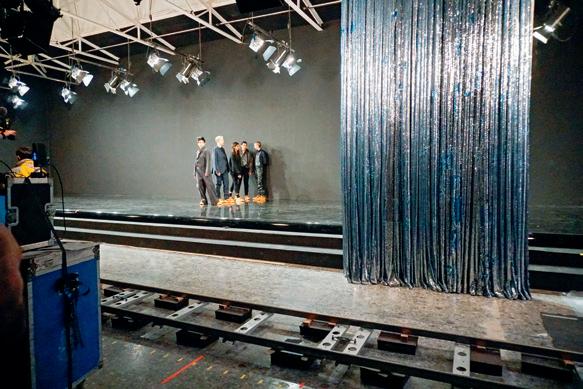
to the subatomic dynamics that also constitute them. We enter the quantum sphere, where everything exists in inexhaustible dimensions moving in infinite directions; where everything is essentially non-locatable and, therefore, uncapturable; where one can, finally freed from the bonds of time, imagine other worlds.
translated from Portuguese by philip somervell
miro spinelli
this participation is supported by: The Swiss Arts Council Pro Helvetia.
Moving Backwards, 2019 Video installation with HD; 23’
On the set of Moving Backwards, Swiss Pavilion, Venice, 2019.
philip rizk
Terrible Sounds (2022) is made up of a triptych video installed as a two channel projection accompanied by a series of prints.

Three conceptual elements inform the work.
The first takes us to 1922, the year the British alleged to give Egypt its independence. It was the same year that archaeologist Howard Carter (1874-1939) discovered the tomb of Tutankhamun, which would
spark a worldwide movement of Egyptomania. Following disagreements with local elites the British expedition is forced to abandon the site. The tomb, like all Egyptian antiquities, had served the British’s claim to greatness. Following the tomb’s closing, it was officially reopened in 1924 at the behest of King Fuad I as a symbol of the African state’s glorious past and its claim to national independence.
235 234
The second conceptual element is music, both as a liberating power, as well as its ties to colonialism and neocolonialism. In 1932, as part of a general move by elites anxious to earn recognition of Egypt as a participant in Western modernity, the Conference of Arab Music was organized with the intention of Westernizing it. In an accompanying text for Terrible Sounds Rizk asks some key questions, “How
would I move to the sounds of colonialism? How would I move to the sounds of neo-colonialism? But most important of all, how would I move to the sounds of neither?” The answer to the last question is suggested by the story of Hartmut Geerken (1939-2021), a German musician who, fascinated by Afro-American composer Sun Ra’s (1914-1993) Afrofuturism, settled in Cairo in 1967 where he co-founded
Egypt’s first Free Jazz ensemble. The second projection in the exhibition features a musical recording from 2021 in which Geerken along with Egyptian and Lebanese musicians counter the conference’s agenda of Westernizing Arab music into a European form, with a session of free musical improvisation.

The third conceptual element, which appears in the two films as well as in the exhibited prints, are allusions to peasant revolts that led the British to announce Egypt’s nominal independence in 1922.

In Terrible Sounds one can recognize some typical features of Rizk’s work, which masterfully uses archival materials, breaking chronological and spatial linearity, reorganizing a hegemonic narrative from a decolonial perspective.
marco baravalle
Terrible Sounds, 2022 Film stills
quilombo cafundó
On November 20th, 2009, President Luiz Inácio Lula da Silva decreed the recognition of the Quilombo Cafundó community as an area of social interest, although its history goes back much further, to at least 1887, when Joaquim and Ricarda Congo inherited their master’s land after obtaining their freedom. To this day their descendants inhabit the territory located in the rural area of Salto de Pirapora, twelve kilometers

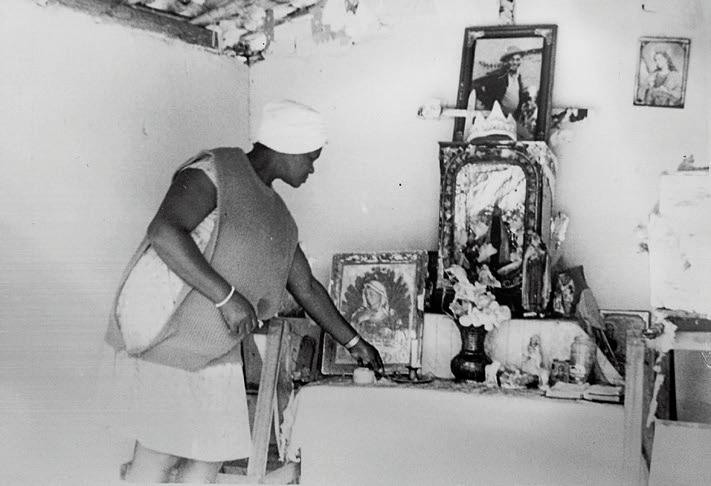
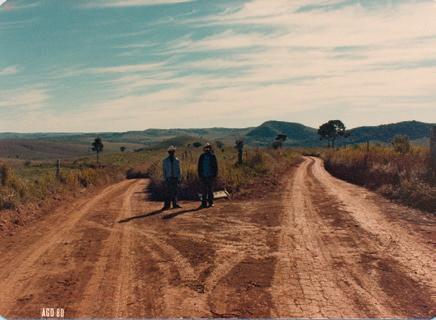
from the center of Sorocaba, in the state of São Paulo.
Mr. Otávio Caetano was a musician, a top accordion player, the host of the best parties, a storyteller, responsible for preserving and passing on the dialect1 to the younger generation. We are here thanks to the strategy of Mr. Otávio, a great master. In the mid-1970s, almost a century after Joaquim and Ricarda, the quilombos in the Sorocaba
237 236
Dona Cida, benzedeira, rezadeira, yá of the terreiro of Quilombo do Cafundó and community leader in the 1980s and 1990s, undated Quilombo Cafundó, 1978-1990s
Quilombo Cafundó, August 1980
region began to fall. The last to be extinguished was that of Caxambu, which was a sister quilombo. And witnessing these attacks, Otávio feared that the same would happen to Quilombo Cafundó, which at the time had been reduced to seven and a half bushels of land. And when these actions grew more violent, Mr. Otávio gathered his family and understood that the life of the Black man had no value. And that
if they wanted to stay alive, they needed to go after lives of value. So he goes to the center of Sorocaba and begins to cupopiar, that is, to speak in the dialect, which attracts so much attention, to the point that the Jornal Cruzeiro do Sul newspaper writes a report in which it states that in Cafundó, which at the time was still a neighborhood, there is a village where a “strange” language is spoken.
The news has a wide repercussion, attracting researchers, anthropologists, and linguists, who come to the quilombo and stay to study this dialect. And the presence of the academics inside Quilombo Cafundó made the attacks decrease. Those were the lives that mattered, that Mr. Otávio wanted so much to bring and brought to the community. And with these white and powerful people (orofombe, in cupópia) inside the community the conversation became different.
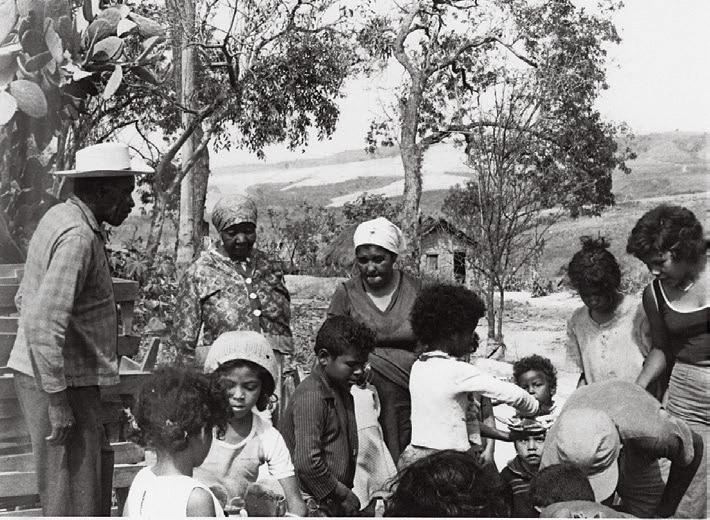

Otávio Caetano’s dream was to be able to read and write. He died without achieving this, but today we know that he mastered other knowledge that was little valued. Today we are sure that he was a man far beyond his time. His strategy greatly helped Cafundó in this process of resistance and survival.2
cintia delgado, one of the community leaders, in a conversation with sylvia monasterios
translated from Portuguese by philip somervell
1/ Cupópia is a language spoken in the Quilombo Cafundó in Salto de Pirapora, São Paulo, Brazil. The language combines the structure of Portuguese with words of African origin, especially Quimbundo.
2/ Mr. Otávio was also the one who filed a usucaption process, which secured the permanence of the quilombolas in Gleba A (the community’s remaining 7.5 bushels).
Mr. Jovenil holding the portrait of his uncle Otávio Caetano, master of cupópia and community festeiro, undated
Mr. Otávio Caetano, Ms. Dita Pires and other residents of Quilombo Cafundó, undated
In Rasura [Erasure] (2021), Raquel Lima revisits and reinvents a history permeated by trauma – intimate, social, and collective trauma. Between abandonment, ruins, layers of writing and habits, her poetry-performance transposes the many preceding centuries through reminiscences that subsist and return to the surface as if in an eternal cycle. It is not possible to interrupt the time that is running, but
Lima finds ways to cross it, shape it with her voice, and decipher it with her body in movement.

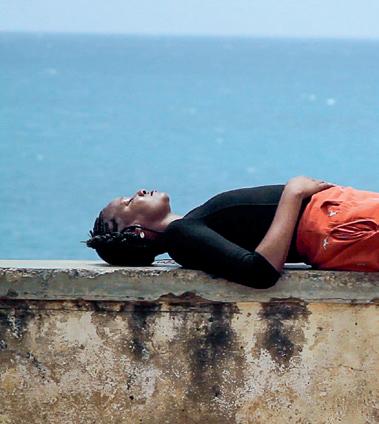
The word “erasure” (rasura) is used beyond its semantics, holding in it the key to decoding and translation. And if this word is not the starting point of her thought, it is certainly its point of arrival. In contrast to “deletion” (apagamento), the total annulment of an idea, an identity, or a history,
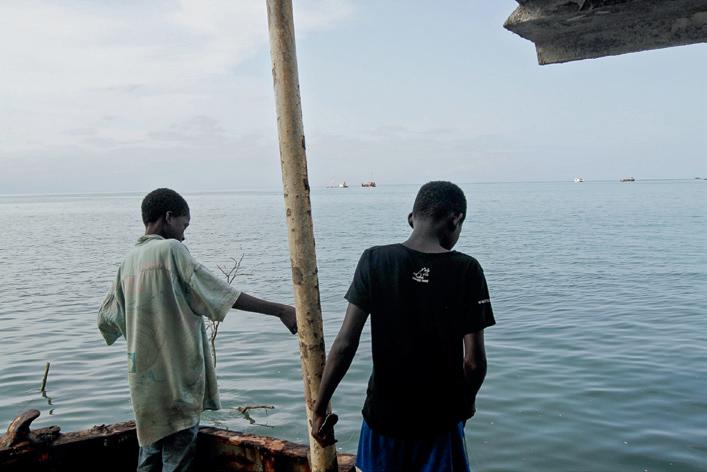
239 238
raquel lima
Rasura, 2021 Erasure. Video stills
“erasure” presupposes the error, or the intention to partially erase something, or to remake it without disguising it. In the work, “erasure” also means resistance.
From inside small abandoned boats, Lima has us look out of the window at the surrounding ocean where we see other abandoned boats adrift. More than life, there has been exploitation there, and something has collapsed – but it

has not been deleted. On the island of Saint Thomas in the Gulf of Guinea, São Tomé and Príncipe, the once-abandoned colonial houses bear cracks, haunting voids, walls with peeling paint, ruins upon ruins that are nevertheless inhabited in their precarious permanence. Those occupying this scene are Black bodies, part of the primordial history of the place to which their ancestors were taken as merchandise – the
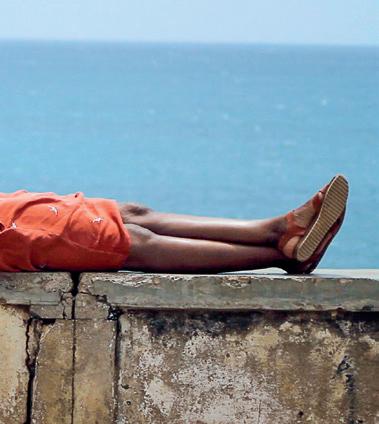
human made thing, erased but not deleted.
The trauma of centuries of slavery, whose consequences continue to have repercussions on the fate of Black populations, is carefully elaborated in the words with which the artist performatically-poetically-visually expresses herself. The words are inscribed in the “orature” – an ontological dimension that proposes other ways of narrating daily life and history; a cosmovision – that choreographs meanings in different times.
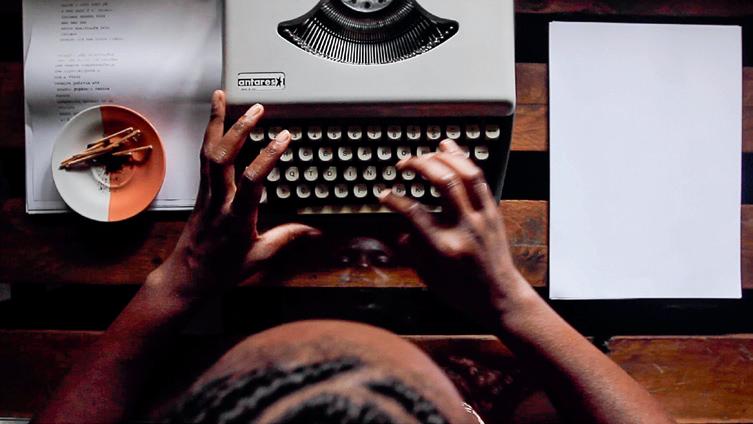
No past can be deleted, but its traces can be transmuted by art. At least by emancipatory art, a path crossed by conscious intersectionality, which is a path, a movement and which gives new possibilities to historical times.
pérola mathias
translated from Portuguese by philip somervell
this participation is supported by: República Portuguesa – Cultura / Direção-Geral das Artes.
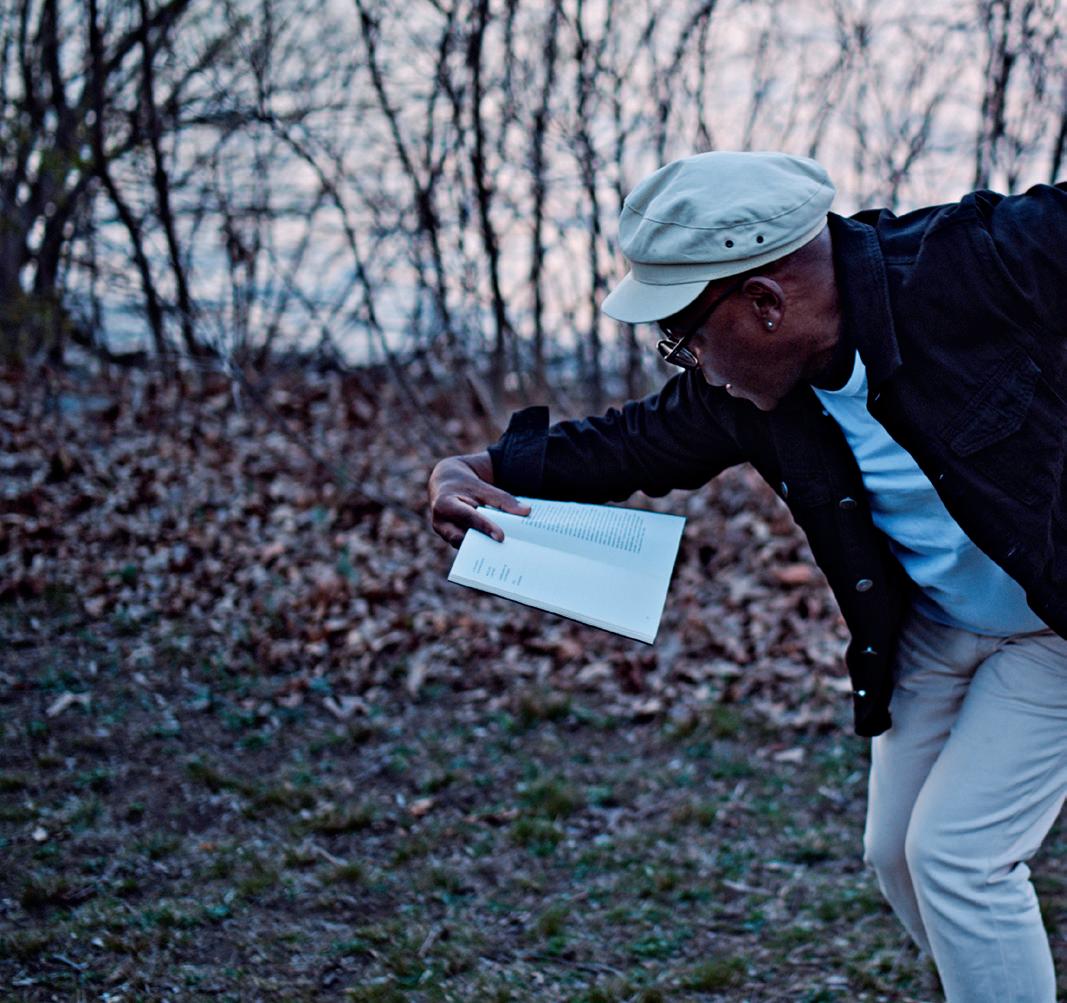
241 240 ricardo aleixo
Ricardo Aleixo composes poems, performs words, dances ideas, and vocalizes images. His work unravels the interrelationship of codes in the – not necessarily linear – processes of creation. However, the idea of codes is insufficient, because, before the word, the letter can express not one language, but several: the image, the vocalization, and its sound. In the poet’s own words, “listening to the letter and
writing the voice” is the synthesis of his work and artistic performance.
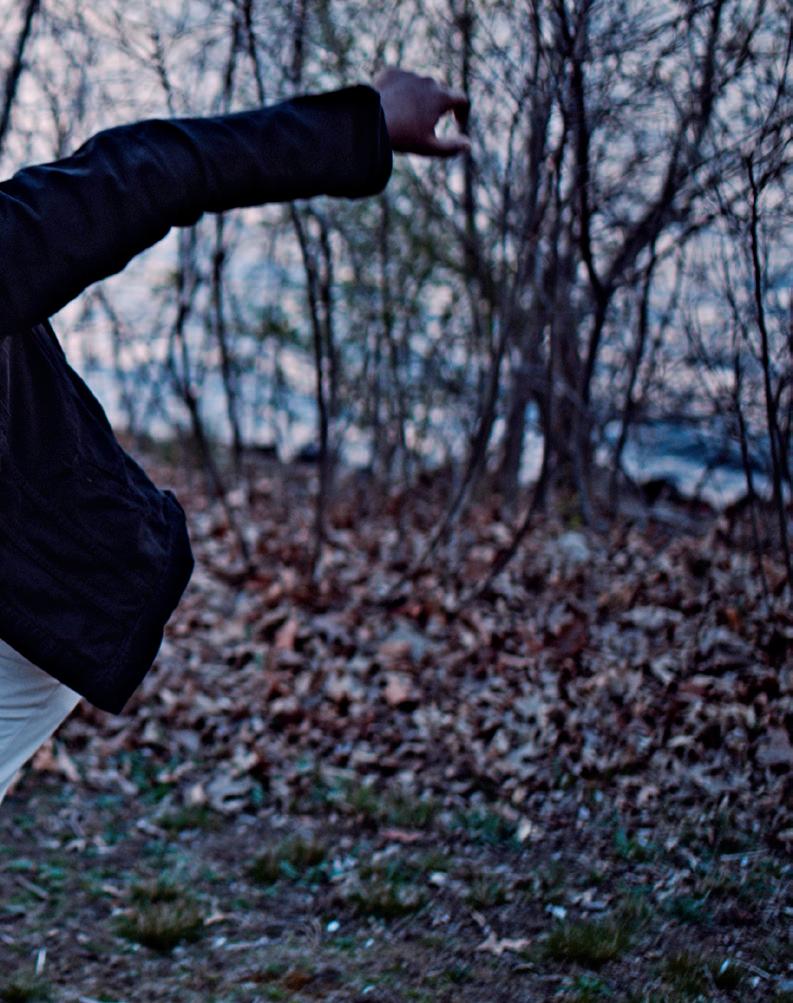
The poetry of Ricardo Aleixo, who has dedicated himself to the medium for over forty years, connects with everyday life, but not only that. It informs affections, but not only that. It is/can be the feeling itself; it can narrate a dream or be the dream itself. In Palavrear, he opens paths so that we can wander through the labyrinth that he knows “for having it / by heart at the tip of my feet”. In this journey, the landscape of his “compositions” is continuously altered by contexts, real and historical, which impose contingencies on the poet, the individual, the place where he lives and the language he speaks.
Aleixo updates the concept used by concrete poets based on the work of James Joyce and calls his poetry “reverbivocovisual”, working in the written, visual, and sound dimensions. The body is added to this as an instrument that emulates, incorporates, presents and even carries poetry. And in this poetic body everything is expression, as in the performances with the “poemanto,” a kind of parangolé1 with which he makes the “corpographies.”
pérola mathias
translated from Portuguese by philip somervell
Ricardo Aleixo: Afro-atlântico, 2023 Afro-Atlantic. Film still. Director: Rodrigo Lopes de Barros
rolando castellón
“My religion is nature and the museum is my church,” declares artist Rolando Castellón, one of the great references of art in Central America. Born in Nicaragua and with strong ties to Costa Rica, Castellón began his artistic life from a memory, that of his aunt Rosa, who used to draw with the tip of a broom on the floor of her house, after sweeping it and soaking it with water. Heir to that gesture,
over many years, Rolando Castellón formed his itinerary of rituals and poetics. Mud and every discarded inert object or living substance, of vegetable or animal origin, became his raw material. Walks on the beach or in the city, his acute observation, the collection of objects and undervalued elements taken to his studio, the effects of the climate, abandonment, darkness, the presence of vermin and the cycles of plants are

243 242
Dossier – Inventário abreviado, 1960-2010 Short Inventory. Artist’s book
the dynamics that he uses to shape performance strategies.
Given the impossibility of reducing his work to a single project, Rolando Castellón’s presence in this edition of the Bienal de São Paulo consists of a selection – or rather an inventory – of works. In the exhibition space are deposited only fragments of an extraordinary universe, which includes what he calls “found objects” as well as drawings made

with mud, images and compositions where the accidental prevails. But the whole is not something simple or merely naturalistic. Embedded in all of Castellón’s work are the irony and paradoxes of possible dialogues between industrial cultures and nature, pre-Columbian and post-Columbian history and contemporaneity. This corpus of multiple works also identifies an artistic production who has woven a work ethic based
on the peculiarity of materials, their visual harmony, their conceptual power and respect for the physical and natural context. As a keen observer of the micro, Rolando Castellón explores the plasticity and visual harmony of dry leaves, insect corpses, seeds or thorns, to reintroduce them into a symbolic and ritualistic regime.
rossina cazali
translated from Spanish by ana laura borro

245 244
rommulo vieira conceição
Milton Almeida dos Santos (1926-2001) was perhaps the most prominent and important Brazilian geographer of the 20th century who specialized in urban studies and who theorized the social and political conditions of Brazilian urbanization before post-colonial studies gained its academic foothold. In A natureza do espaço: Técnica e tempo. Razão e emoção
[The Nature of Space: Technique
and Time. Reason and Emotion] (1997) Santos states that today’s modern city is “luminous,” and the “naturalness” of technology and information results in a routine and mechanical condition of everyday life. Conversely, the spaces of the city occupied by the poor are “opaque” urban areas; yet, these are the spaces of approximation and creativity in opposition to the luminous zones and “espaços de
exatidão” [spaces of accuracy]. It is the inorganic spaces that are open and because such spaces escape hegemonic rationalities, the excluded and marginalized poor populations are the source of creativity and of future possibilities.

In his latest work, Rommulo Vieira Conceição draws upon the spatial theories of Santos as well as photographs of the everyday spatial conditions, architectural elements, and details of opaque marginalized spaces of Brazilian cities such as Favela Nova Jaguaré in São Paulo, Favela Santa Marta in Rio de Janeiro, and Bairro Humaitá in Porto Alegre. Within these opaque spaces that are sometimes under the duress of military police, Conceição explores the creative construction of situated experiences and their implicit critiques of the conflation of capitalism, colonialism, and power. In his sculptural installation for the 35th Bienal de São Paulo, Conceição constructs walls of building materials and details commonly used in the favelas and barrios such as tijolo de barro 6 furos (clay tile brick with six holes); ceramic tile; and colonial balusters. These walls and Greco-Roman Doric columns support neo-classical pediments that express socio-cultural and political values. These are juxtaposed by suspended military brigade shields with images of shock battalions that refer to windows or mirrors. Finally, an array of supermarket carts are arranged and scattered in the work that refer to capitalism and consumption but also to mobility which offers the possibility of encounters as well as the construction and redesign of values.
mario gooden
O espaço físico pode ser um lugar abstrato, complexo e em construção, 2021 Physical Space Can Be an Abstract Space, Complex and Under Construction Installation view, Instituto Inhotim, Brumadinho (2021). Metal, wood, resin, glass fiber, polypropylene, polyurethane, and automotive paint
rosa gauditano “subversives,” “communists,” “abnormal” people, and people with “deviant” behavior. As a result, black and LGBT1 people were persecuted, arbitrarily detained, assaulted or raped, and killed. At the same time, in counterpoint, lesbians created resistance movements. And one such action was the upkeep of places of socialization, such as bars and nightclubs. In 1979, Gauditano, hired by Veja
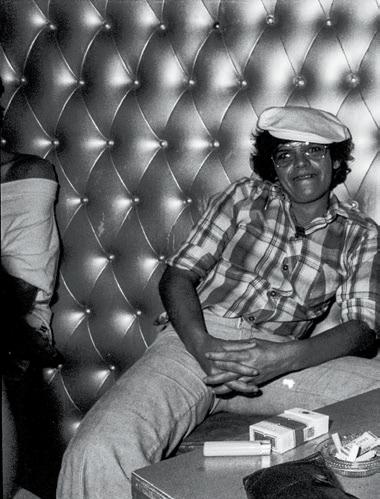
Photographs relate to time. And this experience is part of a dynamic of the gaze, which begins from a place in the past that points to another time that never ceases to reconfigure itself. This is how Rosa Gauditano’s photographs open time for us. It was Brazil in 1964, when the dictatorship intervened in customs seeking to moralize society. Repression was, explicitly and predominantly, directed against
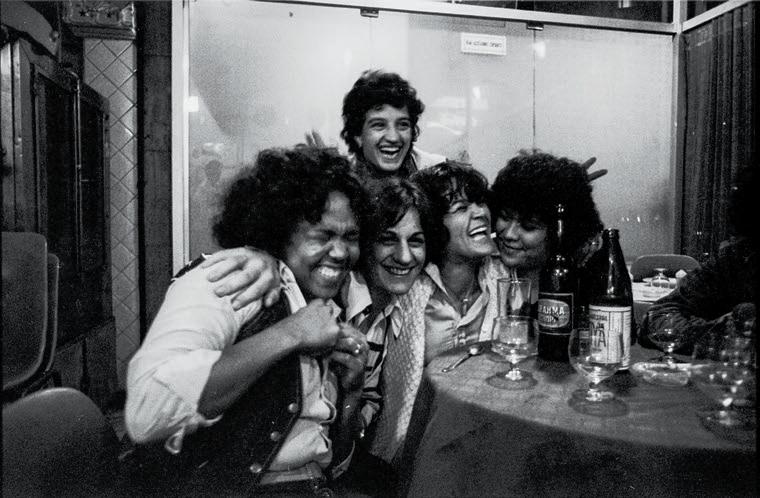
247 246
magazine and sensitive towards the political events, made visible the invisible by registering and celebrating lesbian bodies for two months at Ferro’s Bar, in São Paulo. These are records marked by a strong proximity between the photographer and the women who frequented the bar. These are images that, beyond the prevailing stigmatizations, narrated the intimacy of couples, the affective bonds established in the bar, new
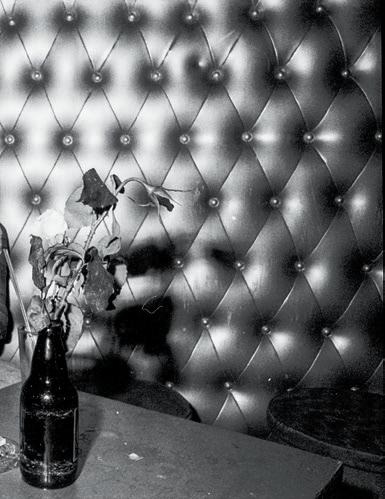
family configurations, and aesthetically exposed a political resistance. Although the essay was censored, the young photojournalist had no idea that her gaze would point to the future, a time when lesbian women of the present would occupy the same space as women of the past. As such, the scenes captured bring about new experiences, recreating memories and being renewed by them, because on August 19,
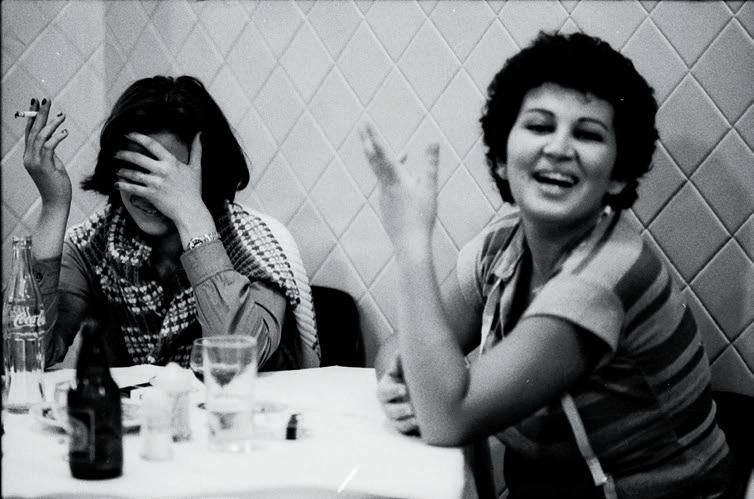
1983, the bar, which witnessed the process of political constitution of the Lesbian-Feminist group (LF), played a leading role in the Ferro’s Bar Uprising – the first demonstration organized by lesbians against discrimination and the silencing of sexuality among women. This date has, since 2008, been recognized in São Paulo as Lesbian Pride Day. And, in 2023, Rosa Gauditano’s Lésbicas [Lesbians] return to propose new reflections.
barbara copque
translated from Portuguese by philip somervell
_
1/ Here we have chosen to keep the spelling of the period.
Vidas proibidas, from the series Lésbicas, 1979 Forbidden Lives, from the series Lesbians. Gelatin silver print
Hypersexualization, menial work,1 and the Black mother. These are some of the stereotypes of Black women that exist in the Brazilian popular imagination. This objectivation and sexual appropriation of the body guides behaviors and constructs identities that are always harmful. They naturalize, reduce, and fix these bodies within a relationship of domination that crosses race, gender, and class, subjecting
Black women to positions of great social vulnerability.
In an act of protest that pervades her entire career, Rosana Paulino confronts this violence, deconstructing stereotypes and representations of the racialized female body, by stressing (or revealing) how scientific theories have founded the racial theories of official history. A Brazilian educator, researcher, and interpreter of
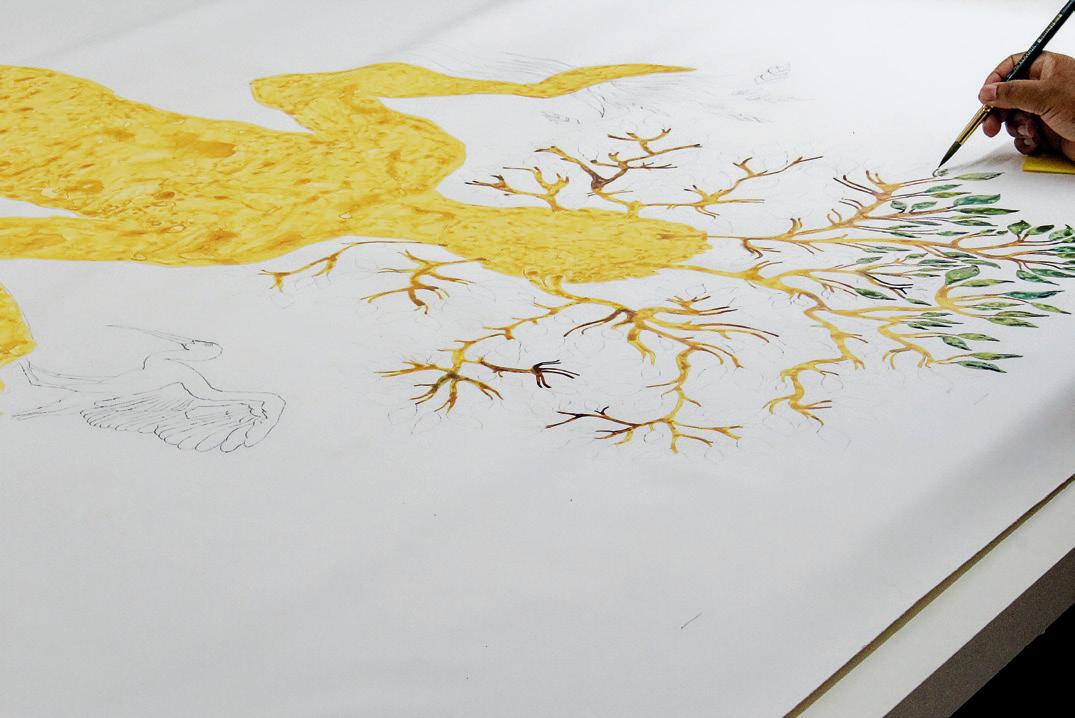
249 248
rosana paulino
Brazilian culture, with a doctorate in visual arts, Paulino turns the body into a place of memory; a body that generates thought and is filled with questions to be revisited. Speaking through and for this body, she weaves, destabilizes, and subverts the colonial certainties that run through us.
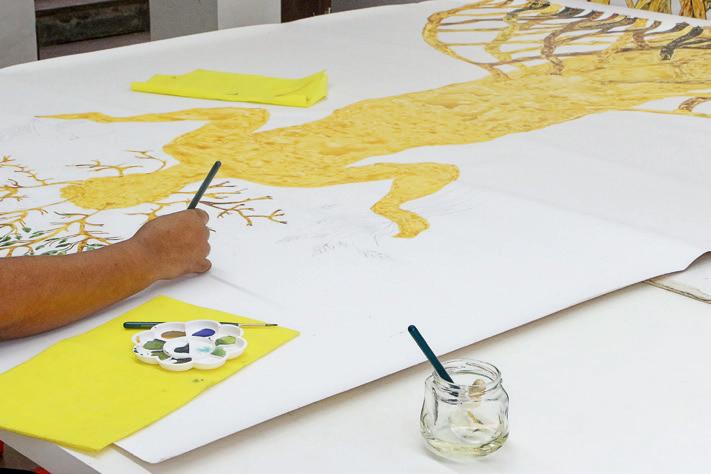
The artist’s body also carries time. A transformative time that interrupts violence and disturbs
the calm of the river, reshaping memories and weaving other narratives and mythologies. In the 2019 series Búfala, Senhora das plantas and Jatobá [Buffalow, Lady of the Plants and Jatobá], in questioning the construction of a subjectivity that does not consider the Black female, Paulino constructs other archetypes and reclaims expropriated psyches and affections, revealing the close-
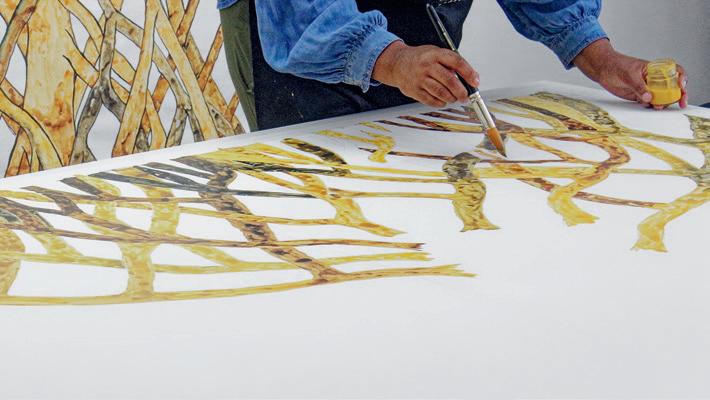
ness of these women with nature, their bodies merging with plants and animals, planting roots, growing branches and expanding the appreciation of other wisdoms, all entangled in ancestry.
And being entangled, in African and Afro-Brazilian religions, is to be a bit of things, or that is, in these religions, women are made of and make up nature. For example in the series Mulheres-Mangue [Mangrove-Women] (2022-2023), the grandmother of the grandmothers in the series Jatobá, which, with her aerial and connected roots – no longer necessary to hide – as in Afro-diasporic thought, enables exchanges and exists between worlds: she is life and death, beginning and end, land and water, sweet and salt, black and white, and the medium, like mud.
barbara copque
translated from Portuguese by georgia fleury reynolds
1/ “Trabalho servil,” in the original Portuguese, is a term used to describe work done by servants, which is low-paid, often domestic, sometimes enforced, and commonly likened to the work done by enslaved people in colonial Brazil, sometimes considered as a leftover from that period. [t.n.]
Rosana Paulino at her studio, São Paulo, 2023
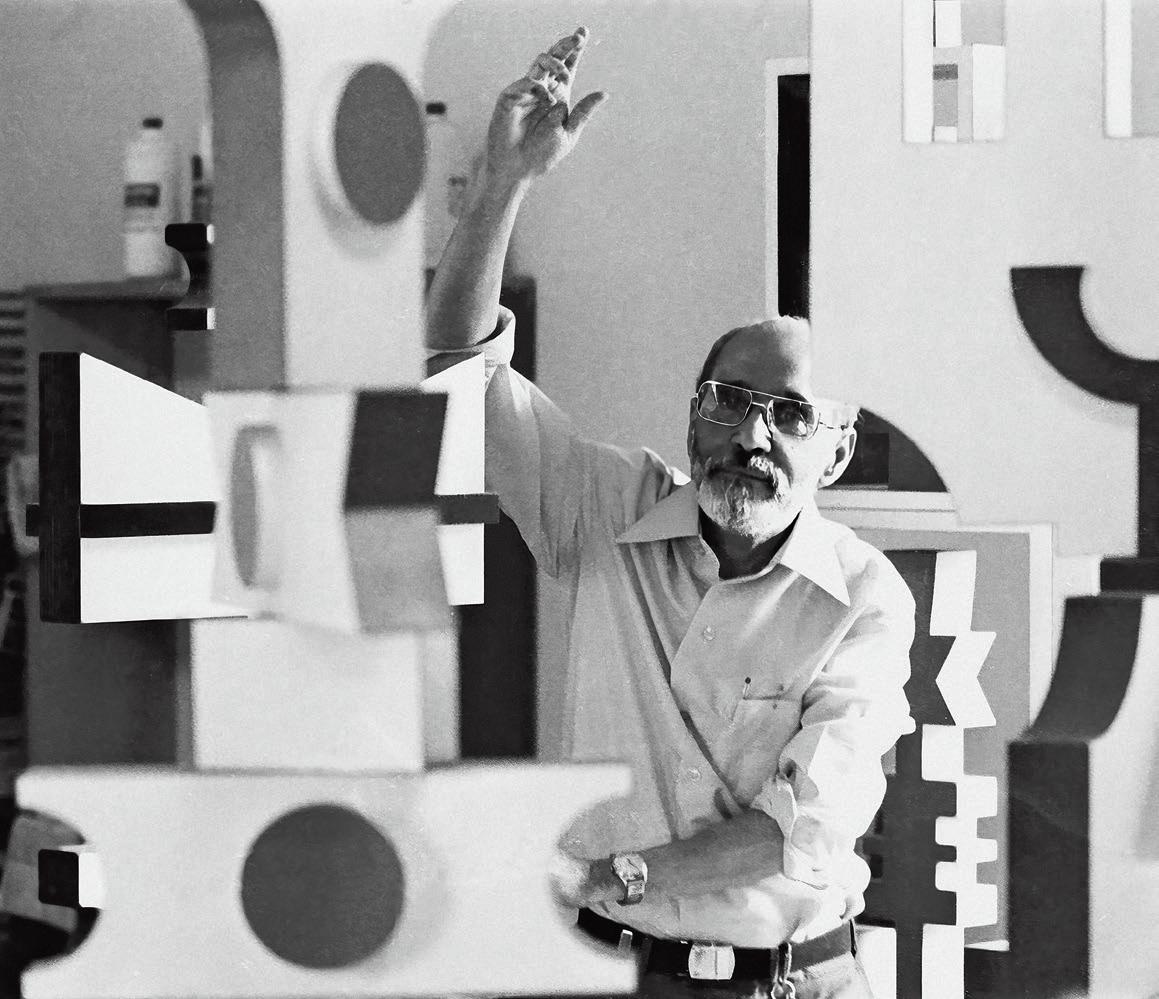
251 250 rubem valentim
The artist Rubem Valentim (1922-1991) combined elements of modernism and geometric abstraction with African and Afro-Brazilian cultures, and with various Eastern philosophical and mystical currents, always in search of a consciousness of the earth, of the people.
In a vigorous effort towards constituting a universal language, Valentim often incorporated symbols and motifs inspired by religious
rituals, originating from the cosmogony of candomblé, paving the way for a numinous and abstract geometry that impregnated his paintings, reliefs, and sculptures.
By means of circles, triangles, trapezoids, rectangles, and colors from the orisha pantheon, the artist created a new rhythm in each work. Rigorous and inventive, the artist achieved a balance between form and color, which can be seen in the monumentality of the set of sculptures and reliefs that make up the work Templo de Oxalá [Temple of Oxalá], partially exhibited for the first time in 1977 at the 14th Bienal de São Paulo.
Notably one of the fundamental texts for art historiography, it was with the emblematic “Manifesto ainda que tardio” [Manifesto albeit late] (1976) that Valentim declared his political and conceptual purpose, and laid the foundations for his radical aesthetic contribution to Brazilian and international art tradition. Thus, the integral presence of the Templo de Oxalá at the 35th Bienal de São Paulo undoubtedly materializes the artist’s thought and legacy. The temple is the celebration and manifestation of a Brazilian visual poetics that establishes the Brazilian riscadura [trace], an identity that mobilizes geometric insignia and symbolic elements to express its connections between the physical and the metaphysical. The temple is an act that cleaves time, it is like an arrow that never delays.
translated from Portuguese by philip somervell
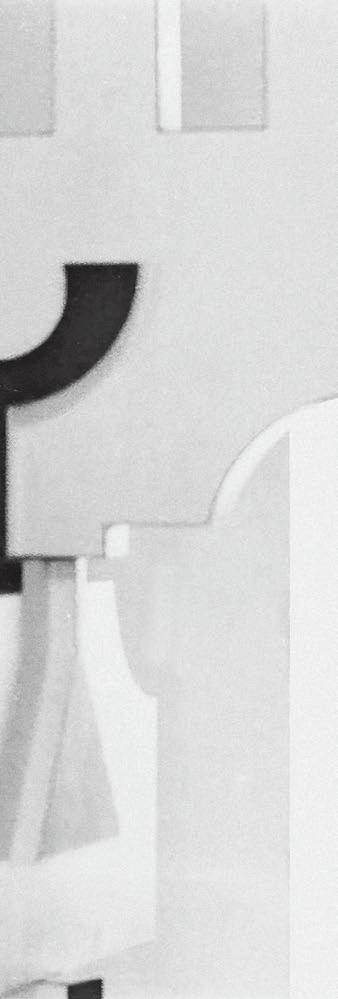 horrana de kássia santoz
Rubem Valentim in his studio, undated
horrana de kássia santoz
Rubem Valentim in his studio, undated
Insistently throwing a series of stones towards the ocean, investigating the body as a receptacle of the force of winds, performing displacements in synergy with the mineral kingdoms, stretching the time of writing in relation to the duration of plants, breathing memories from the sonic capacity to access immemorial times, sanding wood to excavate texts present in the skin itself, are some (among the
many) gestures that lend structure to the conceptual and transdisciplinary texture of Rubiane Maia.
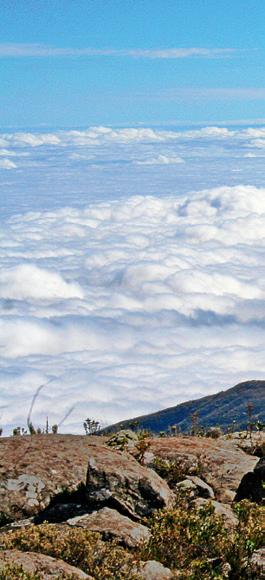
What is at play in the situations proposed by the artist, whose work is guided by a hybrid between performance, images, and writing, is always the construction of a state of perception that allows her own body (and the body of those affected by it) the possibility of widening and
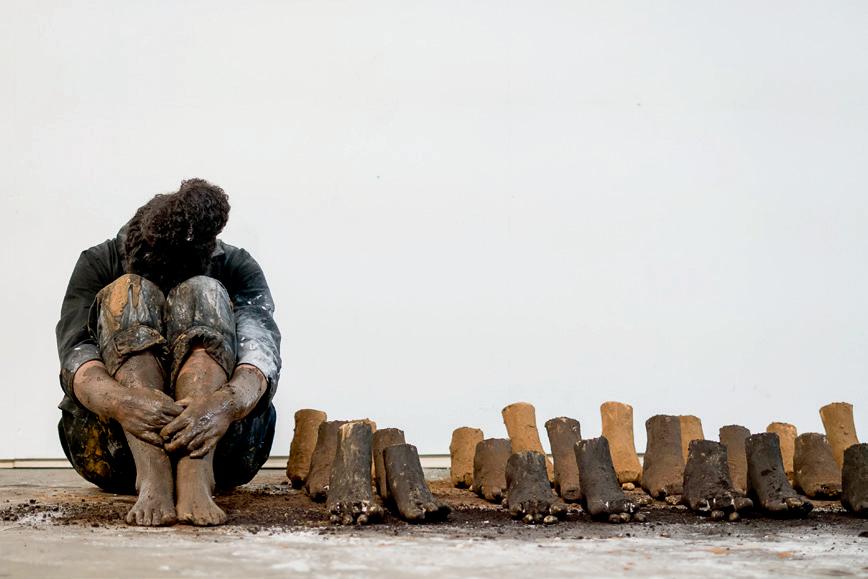
253 252
rubiane maia
Speirein, 2021
Spies. Performance documentation, PSX: a decade of performance art in the UK, London
transmuting what is inscribed in it over time.
A body that listens, feeds and multiplies the frequencies, voices, and cries that precede us. If each one of us is the condensation of lived history from birth and before, when a memory [or, a set of memories], is made actual through a performative action, it ceases
to be a memory or a ghost to become a collective perception, a constellation.1
In this sense, the body, in the contexts evoked by Maia, extrapolates (or even refuses) the biological-historical-Western conceptions attributed to it, becoming a set of forces in a state of differentiation capable of mobilizing new landscapes, exits, and health. Always
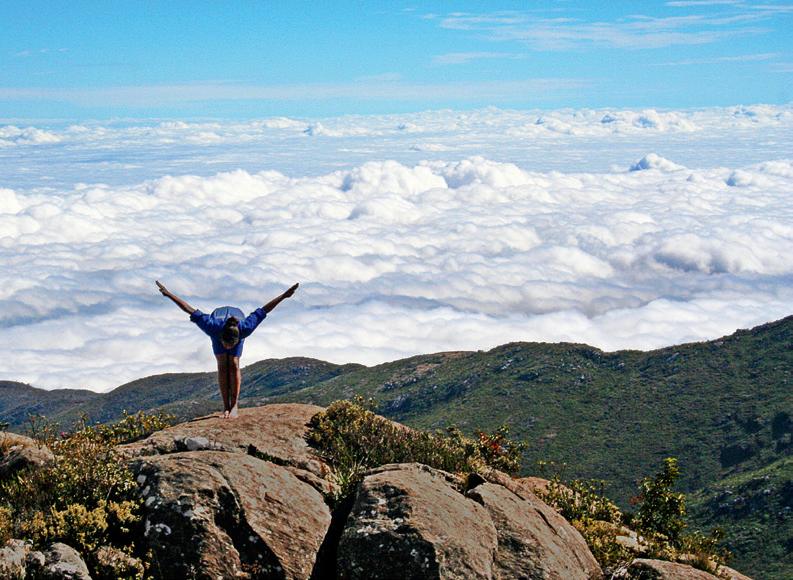
considering the landscape and the environment (especially the non-human one) as co-creators of her works, the artist [re]affirms her commitment to life in a game that involves both an exercise of critical (and clinical) fabulation and a sprouting of what we might call care. This care, however, rises, expands towards a collective state, carrying in itself a network of stories, relationships, and collective and individual perceptions.
In Book-Performance, a project under development and presented at the 35th Bienal de São Paulo, Rubiane Maia organizes a series of actions, conceived in response to autobiographical texts particularly influenced by traumatic transgenerational memories linked to gender and race issues. The artist elaborates through gesture and collaboration with other performers (always intersected by issues common to her history inscribed by migration, motherhood, and diasporic thinking) a text-body methodology that aims to “metabolize complex or indigestible memories in small doses of healing and freedom.”2
tarcisio almeida
translated from Portuguese by philip somervell
1/ Notes on the artist’s practice. See more at: www.rubianemaia.com/
2/ Ibid.
Preparation for Exercício aéreo, a montanha, 2016 Aerial Exercise, the Mountain. Rubiane Maia and Manuel Vason’s video still
creating trans-corporeal institutions: transfeminist choreographies for bodies and spaces ilenia caleo
a body is a body is a body / political choreographies
A body is close to a body that is close to a body. The body is always a body in a space. The environment is generated by the body: by the volume it occupies, the duration, its posture, the way it moves. Bodies are in relation not only to each other but also to the connective space that activates them. A body does not lie there, alone, it is not an isolated, hermetic object resting against the environment like against a lifeless backdrop. This space in-between is active matter; we can envision it as a flow both vibrant and viscous, a dwelling overrun with different and simultaneous temporalities, a unity brimming with affective qualities.
The body modifies the space around it and vice versa, and the relation created between bodies modifies the bodies and the space; while the space enables or disables the relation between the bodies modifying it in turn. In this force field, the traffic is multidirectional and influences reciprocal.
The boundaries between bodies, where one ends and another begins, cave in and intermediate zones emerge, which remain nameless. Neither one nor the other. These zones of subsidence are of particular interest to us, because here, in this contact, in this rubbing of surfaces, mixtures occur. The boundary of separate identities comes undone, matter blends. We cease to see bodies as sealed entities and a dimension of trans-corporeality emerges.1
The space in-between is governed by a series of conditions, sometimes explicit, more often implicit: the proximity bodies can maintain to one another, the possibility of contact, the freedom for one body to approach another, whether it can tilt, stretch, topple over or is forced into verticality, the allotted space for each body and whether it is the same for each, and so forth. This is the description of a choreographic process, but also of how a public space operates. Vectors, tensions, inclinations, movements: choreographies, in other words; a political writing of bodies.
Engaging not with objects but with movements, transitions and sequences, choreographic writing puts us in touch with the formless, with continuous variation, it trains our perception of them, our sensitivity towards them. In this sense, understood as a writing of bodies and of movement in space, choreography can be seen not so much as a discipline but as a way of thinking about problems, of composing new problems within the dimension of corporeality.2 Of all bodies, not just human bodies. An expanded idea of choreography.
hybrid bodies, artificial bodies
In the live arts, the co-presence of performer and spectator generates an artificial and transient space of commonality — and this artificiality offers us some very good exercises in political imagination. In performance, the conditions that make something visible, perceivable and legible are constantly changing, deviating from common sense. A short-circuit sometimes occurs: we are unable to immediately recognize a body on stage, or a movement or composition of bodies in space. This is when something is happening; when habitual perception falters, new bodily assemblages are created.
The artificiality proper to the arts, which in the performing arts involves living bodies, therefore provides an additional tool to help dismantle the nature-culture binarism, in alliance with feminist perspectives. Rather than analysis, here we are in the realm of experimentation: new organs of perception spring up and branch out, a whole unimagined mapping of the sensible emerges — the fictional scores of performance move the body between the natural, the cultural and the artificial, calling into question the very status of corporeality. By creating new assemblages, they produce effects of reality.
This is the way art generates zones of impurity, interstices between bodies with their own autonomy; ambiguous bodies, hybrid, unformed. It makes them
255 254
1/ Stacy. Alaimo, “Trans-Corporeal Feminisms and the Ethical Space of Nature”, in Stacy Alaimo and Susan Hekman (eds.), Material Feminisms Bloomington and Indianapolis: Indiana University Press, 2008, pp. 237-64.
2/ Bojana Cvejić. Choreographing Problems. Expressive Concepts in European Contemporary Dance and Performance. London: Palgrave Macmillan UK, 2015.
visible. Impossible, unreadable, unthinkable bodies can come to life on stage, even only in passing. Populated bodies, incorporations that suggest new mixtures, new composites. This mingled, impure, uncertain, transient, artificial living being is what we experience directly in the live arts. A shared experience that consolidates a common space of sensibility, intensifying and modifying systems of perception.3
We can recognize in art an ability to “anticipate” certain mutations — an anticipation not in the realm of intentional declaration, but which rather reveals itself as a glimmer, a flicker. It embodies a queer mode of vision, oblique and incomplete, which brings us close to utopia.4 An activity of prefiguration, an eminently political feature of the imagination.
bodies and institutions: scores
In the more heterodox tradition of Western political philosophy spanning from Hume to Deleuze, the relationship between artifice and institutions is foundational,5 and connects the political sphere to fantasy, imagination, and the capacity to elaborate associations. There is therefore a certain intimacy between art and institutions. Institutions are not a given of nature, they are an invention as well as a convention, and this is as true at the macro level of social life as it is at the level of bodily singularities: the body is constituted by forces both symbolic and material, it is the seat of fantasies, specters, images, memories, repositories, contracts, identifications. It is a battlefield. There is nothing natural about our bodies
It is in performativity, i.e. in behaviors, conduct, repertoires, and in the repetition of these given scores that
3/ Jacques Rancière. Le partage du sensible. Esthétique et politique. Paris: La Fabrique Éditions, 2000.
4/ José Esteban Muñoz, Cruising Utopia: The Then and There of Queer Futurity. New York: NYU Press, 2009.
5/ David Hume, A Treatise of Human Nature: Being an Attempt to Introduce the Experimental Method of Reasoning into Moral Subjects, 1739; Gilles Deleuze, Instincts et institutions. Paris; Hachette, 1953.
bodies become socially intelligible, legitimate, “straight.” But queer feminist thinking on the performative is not merely a tool for deconstructing and denaturalizing existing bodies, sexualities, identities and institutions, for showing their artificiality.6 Performativity is a form of action that modifies the world; it is also a transformative, subversive and instituting activity. Sara Ahmed opens a feminist reading of the proximity between corporeality and institutions. “Doing things” depends not so much on a capacity the subject possesses individually but on “the way in which the world is available as a space for action,”7 a plastic space where things may take place.
The institution is thus defined in material and spatial terms — a corporeal mode. It consists of models, prototypes, incorporated schemes of action. But also repertoires, scores, postures, gestures, behaviors. Choreographies and postural and gestural scores become so deeply ingrained in our bodies as to become automatic. How do bodies move in space? What scores do they follow? Can we name them? What is the history of a particular gesture of mine? How to free other scores, how to change given codifications, how to give body to subversive political choreographies?
It is within the heart of insurgences, social movements, self-regulated collective behaviors and non-normative or minoritarian forms of life that new institutions, new models of shared action, are invented. Not, therefore, only crystallized institutions and seats of power: instituting, generative and grassroots social processes are open practices that make the capacity to act possible, boosting it. They materially take shape in terms of bodily proximity, of tendencies: what we come into contact with shapes us, “bodies are hence shaped by contact with objects.”8 Building a common world around us.
6/ Judith Butler, Gender Trouble: Feminism and the Subversion of Identity New York: Routledge, 1990.
7/ Sara Ahmed, “A Phenomenology of Whiteness.” Feminist Theory, v. 8, no. 2, , pp. 149-168, 2007, p. 153.
8/ Ibid, p. 152.
the practices of new institutions: a positioning
I too am now speaking from a specific space, and from practices I personally experienced that have produced forms of collective thinking and knowledge, in particular the struggles of the commons and the queer feminist movements. With the financial crisis of 2008, as a reaction against the neoliberalist policies of privatizations and welfare cuts or as a demand for democratic inclusion in managing the crisis, social movements developed in southern Europe and around the Mediterranean basin that experimented radically with the theme of the institutions of the commons; in Italy the local movements for the commons and the battle for public water, which were followed by a string of cultural occupations,9 the 15-M and “Indignados” movements in Spain, but also the Gezi Park protests in Istanbul, which then spread across Turkey, the squares of the Arab revolutions in Tunisia, Egypt, and so forth.10 It is also in the light of a reaction to the strength of these mobilizations that we can read the sovereigntist and reactionary wave Europe is going through today, and the closure of spaces of political action in an authoritarian direction in Tunisia, Turkey or Egypt.
In those moments of insurgence, these movements gave rise to the designation of a political space that prefigured the Euro-Mediterranean. To bet, as Europeans, on the idea of an alternative federative Europe built from the bottom and alternative to the Europe of finance. A Southern Europe.
The struggles of the 2010s put the practice of occupying premises at the forefront, with various mani-
9/ Since 2011: Teatro Valle Occupato (Rome), Torre Galfa and Macao (Milan), L’Asilo Filangieri (Naples), Teatro Coppola (Catania), Teatro Garibaldi (Palermo), Teatro Rossi Aperto (Pisa), Sale Docks (Venice), La Cavallerizza (Turin), Cinema Palazzo and Cinema America (Rome). Further reading, Silvia Jop (ed.), Com’è bella l’imprudenza. Arti e teatri in rete: una cartografia dell’Italia che torna in scena: (“The Beauty of Audacity: An Arts and Theaters Network — Mapping Italy’s Return to the Stage.”), Il Lavoro Culturale, 21 Dec. 2012, available online www.lavoroculturale.org/imprudenza/ silvia- jop/. Accessed on: Jul. 2023.
10/ Sparks that found resonance in the #occupy movements in the US.
festations according to the context. The materiality of the corporeal and spatial dimensions was decisive. Public spaces, streets, squares, city parks were occupied, becoming arenas for gatherings, socialization, political organization, and collective care. But several existing institutions were hacked and re-signified in this way too: theaters and cultural spaces in Italy and Greece, for example, where precarious subjectivities from art and culture became actively involved; and in the specific case of Greece, the occupation and self-government of hospitals. The transnational dimension was extremely powerful: links and networks developed, contacts proliferated. Without there being a program or prior agreement, common words and practices resonated on the shores of the Mediterranean: occupation as a performative practice that mobilizes bodies in space and transforms the latter; self-governance as a practice of direct democracy; the commons as a challenge to property and as the invention of alternative institutions. The subjectivities that became active in these situations were the transversal, precarious ones, contingent workers, art and culture professionals, students and precarious university researchers, and citizens of all kinds: activists from social movements for the defense of local territories or for the right to the city and to housing. In this interweaving of unexpected subjectivities, conceiving the ongoing processes not as protest responses but as a matrix for new institutions strengthened action and experimentation.
commoning — an art of conflict
This sequence — occupation/self-government/commons — marks a vocation that goes beyond self-representation and results in immediate performative, i.e., productive, action involving the management of the means of production, the construction of informal economies and of new relational systems. An art of governing ourselves “otherwise.”
This political experience has taught me that taking into account the dimension of the body and of contact of the new institutions means putting into focus again and again the theme of conflict. Not surprisingly, the extensive practice of occupying involved wide margins of illegality.
257 256
Occupying as a mode of space creation, of world creation: the scenario does not involve claiming recognition from constituted or state institutions of any sort, it centers instead around a commoning that institutes otherwise, a reappropriation that turns into redistribution — of space, of economies, of relations, of power, of joy.
Commoning, as verb rather than noun, summons not the realm of the existing but of processes and actions. A shift that brings forth the performative and transformative quality of social cooperation, capable of self-regulation and of coming up with its own models. The focus shifts from ontology, which defines what common goods are “in themselves,” to the performativity itself of the commons, that is, the how of the practices and subjectivities they incarnate.11 To transform in order to re/create.
In Performing the Institution “As If It Were Possible,” Athena Atanasiou defines the “performative reconfiguration of institutions as an infinite and indeterminate sites of conflict.”12 — it is in this way that the practice of instituting otherwise becomes disengaged from processes of institutionalization and crystallization. Conceiving autonomous, communal, queer, feminist, decolonial institutions is to prefigure changing relational systems that leap out of the binary opposition between movement and institutions. Or, to put it in choreographic terms, between codification and improvisation.
for transcorporeal institutions
That space of imagination and alliances the movements of the 2010s opened up by has been demolished by the violence of the more recent migration policies and by the repressive outcome of the revolutions in North Africa. The Mediterranean is even more fractured today, a space of
11/ Michael Hardt and Antonio Negri, Commonwealth. Cambridge and London: Harvard University Press, 2009; Pierre Dardot and Christian Laval. Commun: Essai sur la révolution au XXIe siècle. Paris: Éditions La Découverte, 2014.
12/ Athena Athanasiou, “Performing the Institution ‘As If It Were Possible,’” in M. Hlavajova and S. Sheikh (eds.), Former West: Art and the Contemporary after 1989. Cambridge; London: The MIT Press, 2016, p. 684.
power dynamics and necropolitics13 — the idea of a Fortress Europe has succeeded in raising walls in the fluid body of water.
But before long, another cycle of struggles was sparked — the transfeminist tide of Ni Una Menos, spreading from Argentina to Chile, Mexico, and other Latin American territories, and which then reached Southern Europe, making its strongest impact in Italy and Spain and taking on a distinct form in Poland.14 New alliances, new threads. New resonances, new scores. It is from here, from the feminist perspectives generated by this most recent wave, that we can return to look at the relationship between bodies and institutions.15 The question of gender and male violence has forced us to focus on other areas of political activation: intimacy, sexuality, corporeality, affective and reproductive labor and care. And on the institutions governing all these things.
A body does not lie there alone, as we said: radical interdependence is a constitutive feature of lesbian, homo, trans, queer, women’s and/or racialized communities; of the most vulnerable subjectivities. It is not a minus but a political potential, and it prompts us to imagine other-institutions that will give texture to more informal relational systems, to networks of other intimacies.16 This is a point on which recent queer feminist movements in Italy and Spain have insisted a great deal: consolidating infrastructures of mutualism to build an alternative economy of intimacy, of affects, of caring for bodies, of dwelling. This
13/ The idea of a Black Mediterranean is being outlined in the work of decolonial researchers and activists.
14/ For an inside look at the movements, see Verónica Gago, La potencia feminista: O el deseo de cambiarlo todo. Buenos Aires: Tinta Limón, 2019.
15/ For a feminist perspective on the commons, see Federica Giardini, Politica dei beni comuni. Un aggiornamento DWF, no. 2, 2012; Id., “Beni comuni, una materia viva,” in Laboratorio Verlan (ed.), Dire, fare, pensare il presente. Macerata: Quodlibet, 2011; Silvia Federica, “Il femminismo e la politica dei beni comuni,” DEP. Deportate, esuli, profughe, no. 20, 2012.
16/ On the idea of queer infrastructures characterized by use and movement, see Laurent Berlant, “The Commons: Infrastructures for Troubling Times,” Environment and Planning D: Society and Space, 2016, v. 34, no. 3, pp. 393-419.
is how forms of collective care become authentic practices of self-defense, at the point where violence and precarity combine with a cumulative effect. It is a question of inventing new political choreographies to compose bodies, relationships and affects with the materiality and precarity of the most exposed lives. Tactile, tentacular, fluid, transcorporeal institutions. Even in art and cultural institutions there is a need for these sites of conflict and sets of models of communal action, of other forms of life, well beyond the labels Queering or Decolonizing, which are so in vogue in Europe but that leave the system unscathed. The question of vulnerability and interdependence emerged powerfully during the Covid-19 pandemic, occupying a central position in public discourse and politicizing, far beyond the sphere of feminist activism, the topic of care.17
for more-than-human policies of interdependence
Saying where one body ends and another begins, defining the inside and outside of living beings, whether it be the skin, the surface, or the exoskeleton, would seem so intuitive and evident. So clear-cut. Yet the Covid-19 virus has challenged the concept of a hermetic and self-sufficient, unified and homogeneous body — the virus is a body among bodies; tiny, invisible, yet an active agent. It disregards the boundaries established by the skin. In contagion it is worth thinking not in terms of individualized bodies but in terms of transcorporeality, of complex and interrelated systems. Other bodies already inhabit us; we are permeable. In managing the social and public health emergency, state rhetoric adopted the metaphors of war, the enemy, invasion, of immunity as the military defense for our bodies. Reinforcing borders, building walls, identifying an enemy — a lexicon of war that at the symbolic level readied us for actual war (in Ukraine). Transfeminist posi-
17/ The Care Collective, The Care Manifesto: The Politics of Interdependence. London; New York: Verso, 2020. For a mapping of self-organizational practices in the care crisis, see also Pirate Care Collective, Pirate Care Syllabus, 2020. Available at: syllabus.pirate.care. On racist violence and transformation, see also Grada Kilomba, Plantation Memories. Episodes of Everyday Racism, Münster: Unrast Verlag, 2008.
tions, on the other hand, offered us another vocabulary, other escape routes, seizing the opportunity to rethink the human and its hierarchies.
During the years of the pandemic, we learned to concretely recognize the widespread condition of interdependence — among bodies, among individuals, and also among causes in general. And we learned to identify different forms of vulnerability that would otherwise have remained invisibilized. Interdependence is a trajectory that draws hidden political maps, suggesting how to weave unforeseen alliances. Connecting different forms of precarity, multiple forms of violence.18 If the self-sufficiency of the individual is a liberal and patriarchal myth, so too is the separateness of bodies.
Remedying for the individualized, healing the cuts produced by the idea that self-sufficiency is synonymous with freedom.19 In this sense, the performative and transformative activity that shapes what surrounds us, that creative and instituting capacity, can be understood as a form of care; for neo-materialist feminist thinkers care is synonymous with re-creating, 20 remaking the world. Care is then no longer a mere maintenance activity, but transformation into a more-than-human world, an activity performed by an interweaving of human and non-human forces, entities and subjects.21 A collective doing that embraces
18/ Cartographies of violence and exploitation are needed for us to create other alliances. See Veronica Gago, op. cit. The struggles of delivery riders in Italy and Europe during the pandemic, when from a fragmented and violently precarized subjectivity they became part of a strategic sector in urban logistics, adopted the slogan: “not for us but for everyone.”
19/ For the concept of reparation, widely employed in discussions on the restitution of works of art in the context of colonial conquests, see K. Attia, La réparation c’est la conscience de la blessure, in L. Cukierman, G. Dambury, F. Vergès (sur la dir.), Décolonisons les arts!. Paris: L’Arche, 2018. 20/ Valeria Graziano, Recreation at Stake, in Ana Vujanović, Livia Andrea Piazza (eds.), A Live Gathering: Performance and Politics in Contemporary Europe. Berlin: b_books, 2019. For worlding, D. J. Haraway, Staying with the Trouble: Making Kin in the Chthulucene. Durham: Duke University Press, 2016.
21/ Maria Puig de la Bellacasa, “Matters of Care in Technoscience: Assembling Neglected Things,” Social Studies of Science, v. 41, no. 1, 2011, pp. 85-106.
259 258
mutual dependence, a kind of maintenance that is also a keeping-alive, a form of self-governance that resembles the regulatory capacity of an ecosystem. Recognizing the expressive and agentive capacity of the many forces at play beyond human ones has an immediate political fallout.22 And it returns us to a vision of a materiality that is vital but not harmonious, not pacified, made up of colliding forces, of choreographies of human and nonhuman bodies.
translated from Italian by gianmaria
senia
22/ This is a perspective we find in materialist new feminism, but one that the thought and cosmologies of indigenous and non-Eurocentric cultures have developed independently. Cf. Jane Bennett, Vibrant Matter. A Political Ecology of Things. Durham: Duke University Press, 2010, and Michel Serres (1977), Lucrezio e l’origine della fisica. Palermo: Sellerio, 2000.
sammy baloji
130 years ago, work on the Hotel Tassel was completed in Brussels, Belgium. Thus Art Nouveu was born. A style that celebrated modernity and its leading class, the industrial bourgeoisie that had amassed enormous wealth by intertwining its destiny with that of the colonial affair.
In Hobé’s Art Nouveau Forest and Its Lines of Color (2021), Sammy Baloji reproduces an Art Nouveau-style display, incorpo-
rating some patterns inspired by the Congolese textile tradition. Similar patterns, in fact, were once integrated into the design of the Royal Museum for Central Africa, in Tervuren, Belgium, not to mention that architecture and objects often made use of materials from the Congolese colony: copper, ivory, and wood. It is this connection between the floral style of Art Nouveau and colonial dispossession
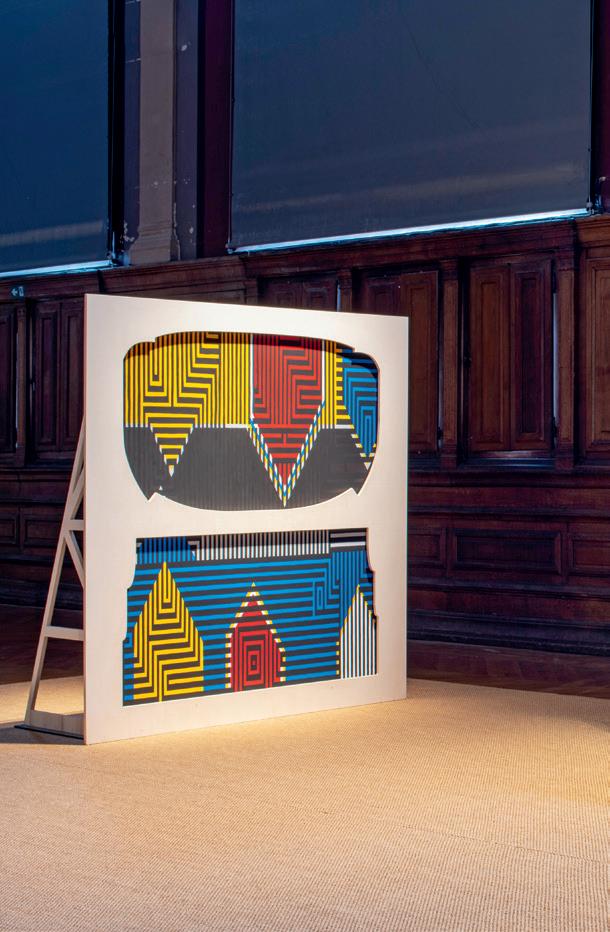
261 260
that Baloji emphasizes. Not only that, the colors the artist chooses are the same colors that writer and historian W.E.B Dubois had used for the diagrams exhibited at the Exhibit of American Negroes during the 1900 Universal Exhibition in Paris. This choice, according to the artist, alludes to the idea “to divert the ethnographic reading that one could have had of these works by emphasizing the modern aspect of
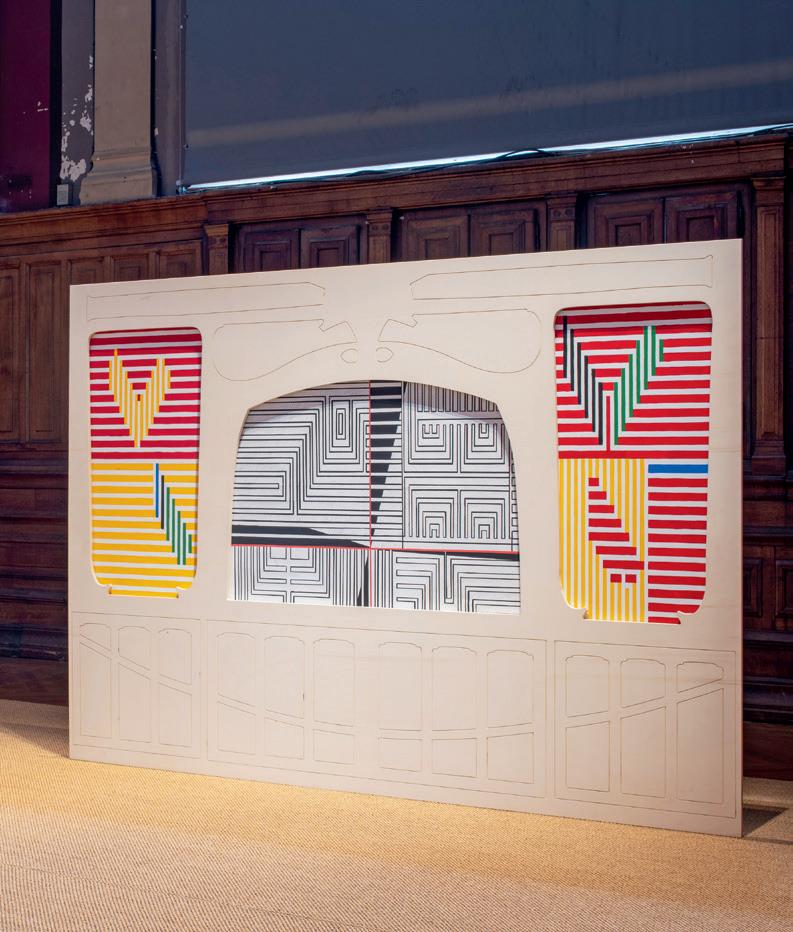
these ancient practices.”1 The colonial archive is probed to break the Western monopoly on modernity. Thus, two colonial liturgies, Christian mass and factory work, are featured in the film Tales of the Copper Crosses Garden: Episode I (2017). Here, images of a copper processing plant in Katanga province (Democratic Republic of Congo) are accompanied by a recording of colonial-era
Christian praises. The songs are sung by the Congolese choir of the Singers at The Copper Cross. In a black-and-white photograph that Baloji juxtaposes with the film, the aforementioned copper cross, also known as Katanga Cross, adorns the cassock robes of the choristers. That type of cross, however, was used as currency in the region as early as the 13th century. Detail that, once again, demonstrates the artist’s ability to lay bare the hidden nexuses of colonialism, this time those between religion, extractivism and economics.
marco baravalle
_
1/ Portfolio of the artist. Available at: imanefares.com/wp-content/uploads/2020/04/if-sammybaloji-portfolio-eng-1.pdf. Accessed on: July 2023.
Hobé’s Art Nouveau Forest and Its Lines of Color, 2021 Exhibition view, Beaux-Arts de Paris (2021)
santu mofokeng
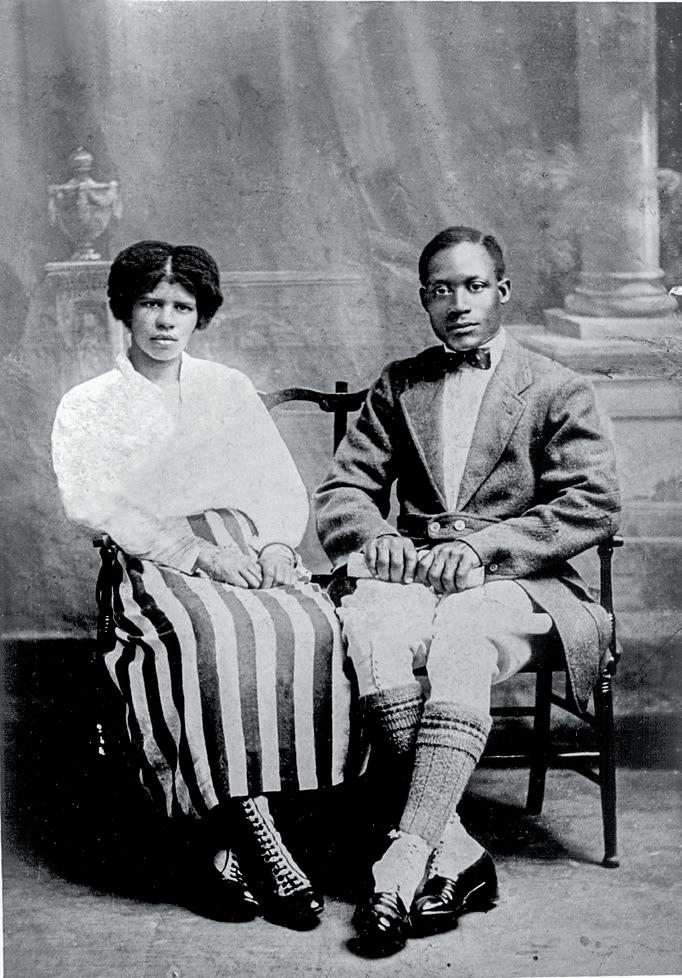
“Who were these people?
What were their aspirations?
What was the occasion?
Who is gazing?
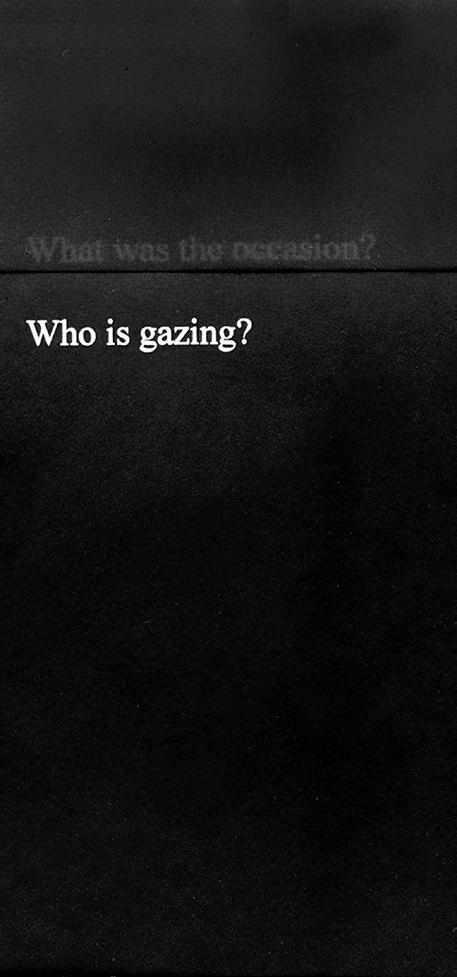
Look at me.”
These transfixing questions and provocations by the photographer Santu Mofokeng (1956-2020) appear interwoven between arresting portraits of black working- and middle-class families from an era where the world went to war twice and Apartheid took hold over the southern expanses of the African continent. Made in collaboration with ten families across the provinces of Gauteng, North West, and
263 262
Orange Free State (South Africa), The Black Photo Album / Look At Me: 1890-1950 is a monumental image text installation masquerading as a photo album slideshow. Unfolding over eighty slides (35 images and 45 texts), the work collides conceptual and vernacular forms; individual and collective subjects; spectral and material worlds. As a whole, The Black Photo Album / Look At Me: 1890-1950 is archive as assemblage,
a formulation that theorist Achille Mbembe considers “a story that acquires its coherence through the ability to craft links between the beginning and the end.”1
Straddling multiple moments in time, the piece took root during the fledgling years of South African democracy, when Mofokeng worked in the visual documentation department of the African Studies Institute at the University of the
Witwatersrand, in Johannesburg. While many were fixated on rendering the future of the public sphere in technicolor, Mofokeng turned inwards, orchestrating this in-depth research project rooted in the monochrome past. He has said “I was doing this project not to deny other stories, other narratives, but I was trying to insert this work within the body of knowledge of the past.”2 First presented at the 1997 Johannesburg Biennale, The Black Photo Album / Look At Me: 1890-1950 resounds even more powerfully now, in São Paulo, in the beginning of another century. It subverts the master narratives of the nation state by centering minor histories, through fraught forms of relation that can only be generated photographically.
oluremi onabanjo
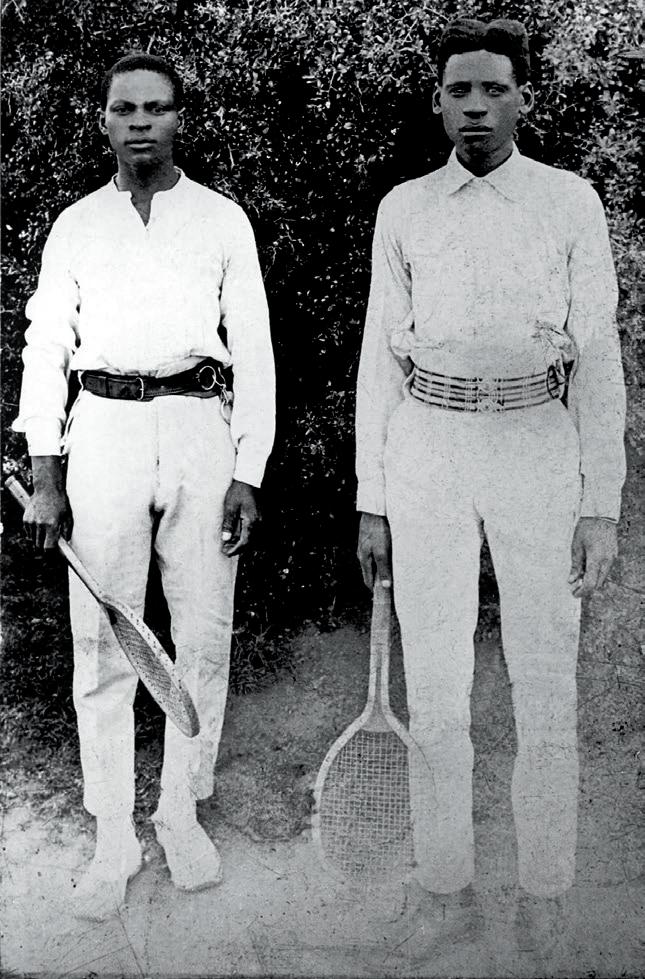

1/ Achille Mbembe, “The Power of the Archive and its Limits” in C. Hamilton et al. (ed.), Refiguring the Archive. Cape Town: David Philip, 2002, 21.
2/ Santu Mofokeng, quoted in interview with Tamar Garb. Figures and Fictions: Contemporary South African Photography. Göttingen: Steidl, 2011, 283.
_
The Black Photo Album / Look at me: 1890-1950,1997 35 mm slides

265 264 sarah maldoror
suzanne lipinska
Portrait of Sarah Maldoror in Guinee Bissau, c. 1970 Gelatin silver print
From the very choice of her name, taken from the songs of Lautréamont, Sarah Maldoror (1929-2020) always combined her vision as a poet with a political expression that rejects institutionalized narratives to compose each of her works: whether written or cinematographic, which add up to more than twenty productions between documentaries and feature films. Different facets of pan-African
thought and leading figures in processes of resistance are striking features in Maldoror’s work.
A French-Antillean in the Popular Movement for the Liberation of Angola, she filmed the colonial war through the eyes of a woman, in Sambizanga (1972) – a film being shown at the 35th Bienal – convinced that the struggle would be doomed to failure if it did not involve the entire population through actions in their daily lives and not merely as a military operation.
This work that reveals what has historically been invisibilized is also the artistic legacy built from the perspective of a person who, in Paris, 1956, was the only woman among the 63 delegates at the First Congress of Black Writers and Artists and contributed to the construction of a theater in which African presence supplanted servant characters, with the foundation of the company Les Griots.
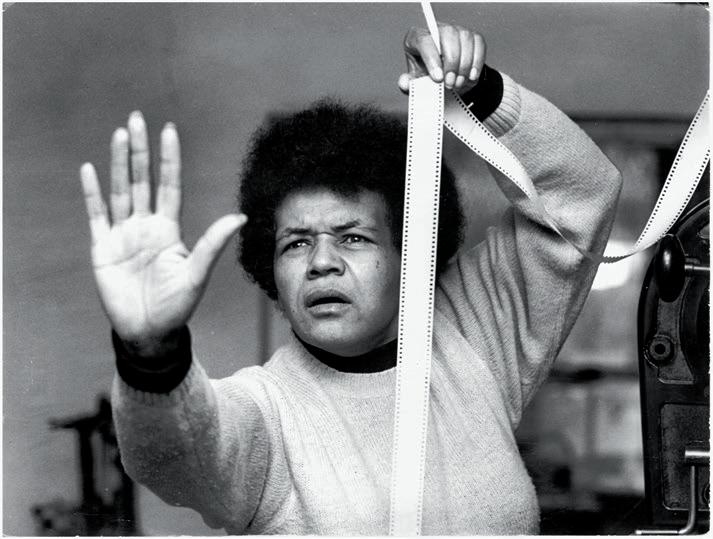
When dealing with the work of Sarah Maldoror, it becomes unavoidable to address what could not be achieved. All the confrontations, of gender and race, as well as the First-Third World dynamics – today Global North-South – the complexities of the nation-states that emerged as a result of African decolonization from the mid-1950s onward, are still expressed in projects and scripts that have never been filmed and are therefore also part of the choreographies of the impossible. The findings among her personal documents reinforce, above all, her poetic and singular project in favor of the collective.
heitor augusto
translated from Portuguese by mariana nacif mendes
Sarah Maldoror, 1974 Gelatin silver print
sauna lésbica
by malu avelar along with ana paula mathias, anna turra, bárbara esmenia and marta supernova
When asked about Sauna lésbica [Lesbian Sauna], Malu Avelar promptly answers that it is not possible to think about her work without understanding her body and the place where she came from. Reviewing questions that pervade her identity markers, Malu highlights the ways in which she reacts to a territory that structually brutalizes, most of the time in a silent way, everything that is

267 266
different from it. “Structured on a binary model of gender, this town forces people with other(ed) identities to live in a permanent state of alert and vulnerability.”1 This act of silently inhabiting imminent death, her questioning about gay saunas – “what if there was a lesbian sauna?”2 –, the encounters she had with other sapatão artists during the artistic residency PlusAfroT/ Germany,3 and her desire to settle
her body were factors that led the artist to create this work.
This artwork – whose first edition took place in 2019, at Valongo Festival, in Santos, São Paulo – is relational, installative, and unapologetically presents a neon sign with the words: Sauna lésbica. It is crucial to remember that lesbianity long lived on policies of forgetting and silencing, and has been reclaimed in a collective and polit-
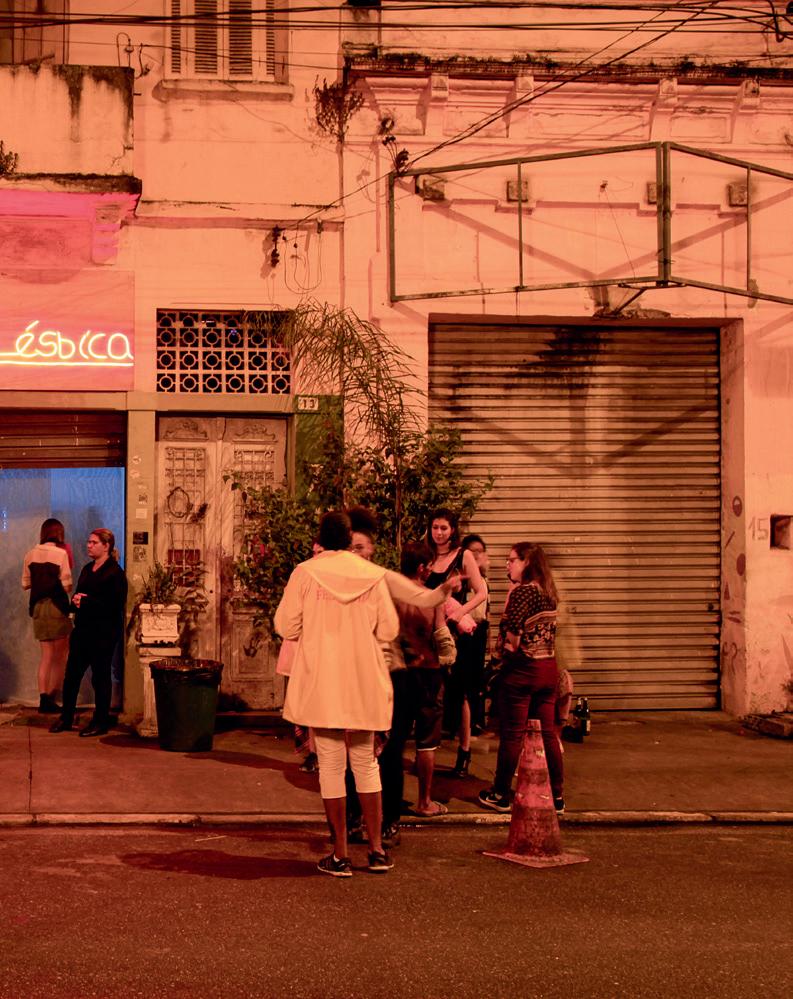
ical sense. Based on negotiations and provocative actions by invited artists, Malu Avelar, along with Ana Paula Mathias, Anna Turra, Bárbara Esmenia, and Marta Supernova propose a collective project and turn the artwork into a space that is nurtured by the choreography of those who occupy it. It is a space organized around the desire for encounters that cross the visible and invisible limitations hindering dissident existences and shaping stereotypes. Through an exercise of abstraction and radical imagination, the installation tensions the contradictions of the identitarian policies, at the same time as it celebrates the presence of Black lesbians and sapatonas;4 a space for listening, for fabulations, for the displacement of subjectivities, and for the performativity of the bodies in contact with the Sauna
barbara copque
translated from Portuguese by bruna barros and jess oliveira
1/ Malu Avelar in a conversation with the author.
2/ Ibid.
3/ Among the participants of the PlusAfroT residency are Grace Passô, Mahal Pitta, Ana Paula Mathias, Lenna Bahule, Malú Avelar, Iagor Peres, Guinho Nascimento, and Rebeca Carapiá. Available at: amlatina.contemporaryand.com/ pt/editorial/plusafrot/. Last accessed June 2023.
4/ Plural of sapatão: a Brazilian-specific identity in the lesbian spectrum of gender/ sexuality. See Barros, Bruna and Jess Oliveira. 2020. “Black Sapatão Translation Practices: Healing Ourselves a Word Choice at a Time”. Caribbean Review of Gender Studies, Issue 14: 43–52. [t.n.]
malu avelar
Sauna lésbica, 2019
Lesbian Sauna. View from the Festival do Valongo (2019)
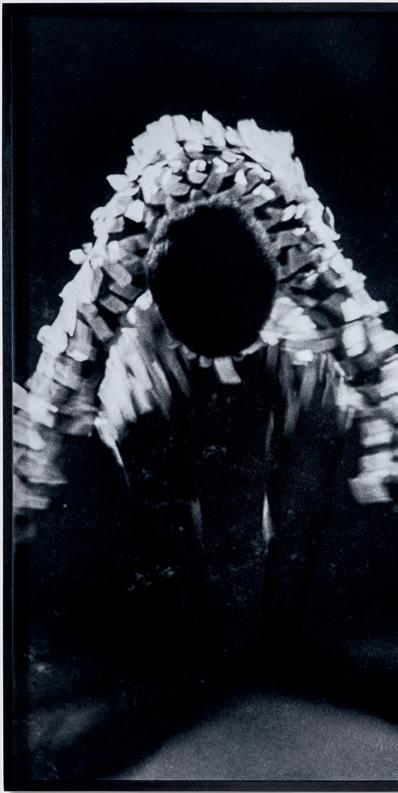
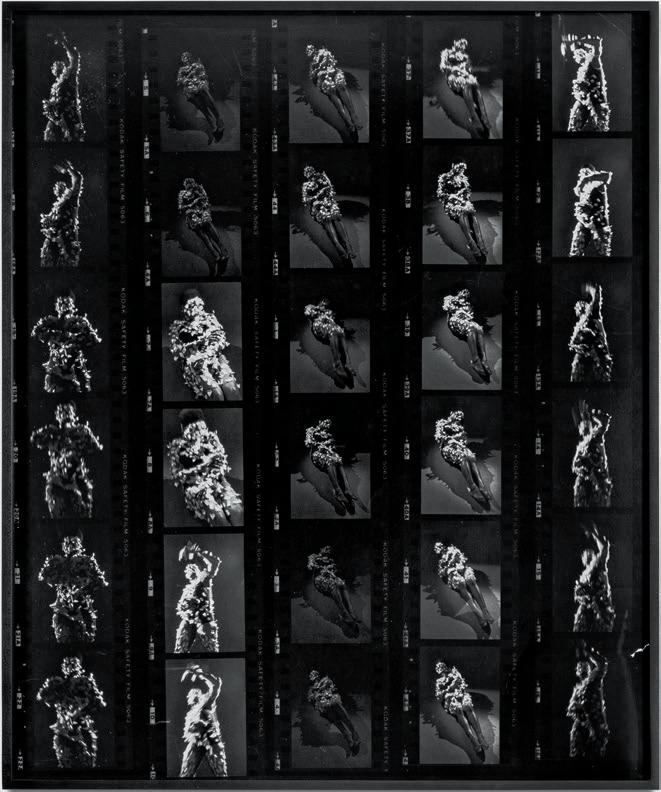
269 268 senga nengudi
It is from two works conceived in a period of almost thirty years, the triptych Masked Taping (19781979) and the video installation Warp Trance (2007), that Senga Nengudi responds to the curatorial provocation of the 35th Bienal –choreographies of the impossible. Of undeniable historical relevance, her works promote the radical re/ de/composition of the choreographies with which the implications

between visual arts and politics were elaborated. In the context of her early production, the artist’s dive into abstraction transcended the symbolic ecology that surrounded what was recognized as African-American art, and her gesture demanded that the arts environments be affected by what was presented outside the limits established by the categories of representation.
Nengudi invests in collective practices, engagement strategies, territorially situated aesthetic interventions and in what she defines as abstracted reflections of used bodies. 1 In her research into ephemeral materials that are deeply rooted in everyday use, such as the second-hand tights from the famous R.S.V.P. (1997/2003) installation, or the white adhesive tape with which the artist masks her body in Masked Taping, Nengudi works on the multiple uses of transformed matter. In the performance, the body in intimate movement with ordinary matter updates the dimension of the rite, and one perceives the Masked Taping triptych as the presentification of a trace of ancestral memory, the artist dancing to embody a transcultural heritage. In Warp Trance, the profound implication of the material used with the social field persists; this time, it is the machine that dances and operates the modification of matter. Designed on Jacquard cards, an invention that revolutionized the patterning of fabrics, the work opens a gap of images in initially noisy abstract compositions, which acquire rhythm, sonically packing the overlapping of textures and, finally, of colors. We experience the duration of the making of the thread into fabric, in poetic dimensions, as a kind of sensual reflection on time.
cíntia guedes
translated from Portuguese by philip somervell
1/ See this concept in “Statement On Nylon Mesh Works,” 1997, published in Senga Nengudi – Topologies. Exhibition catalog. Munich; São Paulo: Lenbachhaus; MASP, 2020, p. 117.
Masked Taping, 1978-1979
Contact sheet, gelatin silver print

_
sidney amaral
During the later years of his life, Sidney Amaral (1973-2017) kept his job as an art teacher in the public school system of the municipality of Mairiporã, in São Paulo. This experience, combined with his sensibility and his political-ideological project, ended up galvanizing work that highlighted a complexity that is often withheld from daily proletarian life. This is why elements of classical literature and
art are sometimes reinterpreted in his plastic narratives and incorporated into them, which equally do not exclude psychological aspects and biographical data of the author that, however disturbing, are as such confronted by him.
The amalgam of artist, researcher, and teacher resulted in the realization of a constellation of poetic propositions, which speculated densely on the languages of drawing, painting, sculpture, engraving, and installation.
In O estrangeiro [The Foreigner] (2011), the artist uses acrylic paint to create another of his characteristic self-portraits. In fact, in a recurring manner, Sidney Amaral presents his own body as a territory conflicted by the most introverted, intimate, and private expressions, and also those of an extroverted and social character.
In the work in question, Amaral assumes the role of Charon, a ferryman who in Greek mythology transports souls from the realm of the living to that of the dead. This crossing was also that of the artist, who faced the obstacles of a much less favorable time than today regarding the circulation of Afrodiasporic symbolic production. A foreigner in both realms of life and death, the artist and his work are the elements that connect disparate spheres. This painful journey was, of course, not his alone, and the artist understood this. It is very significant that, in its 35th edition, the Bienal de São Paulo inverts this equation and the work of Amaral, who died prematurely, is now enshrined in the Olympus that he once portrayed as an obstacle.
translated from Portuguese by philip somervell
271 270
claudinei roberto da silva
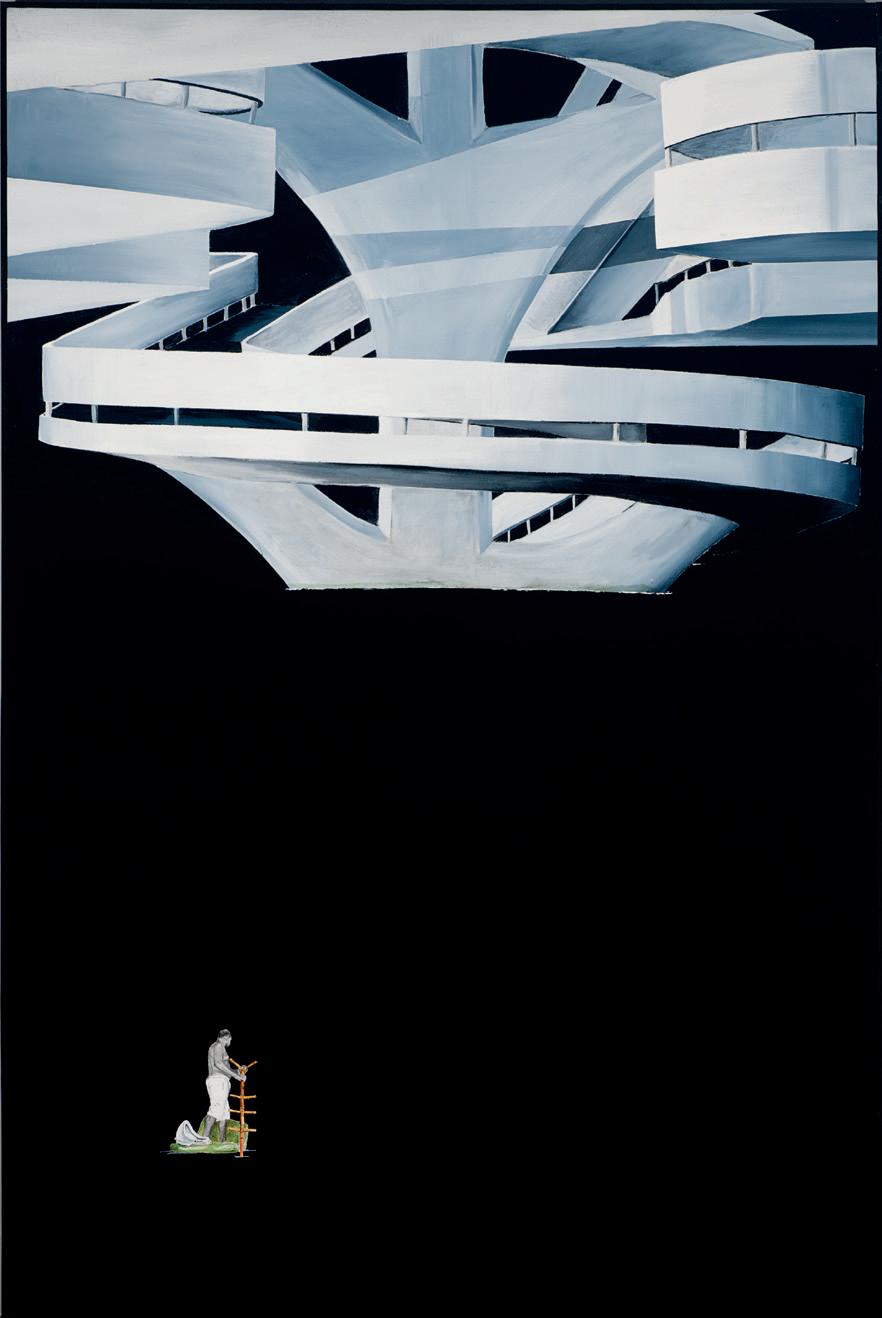 O estrangeiro, 2011
The Foreigner. Acrylic on canvas, 210 × 138 cm
O estrangeiro, 2011
The Foreigner. Acrylic on canvas, 210 × 138 cm
simone leigh and madeleine hunt-ehrlich
Simone Leigh and Madeleine HuntEhrlich have been working together for years as part of a loose group of largely Black, women artists, scholars and other cultural producers, several of whom make an appearance in Conspiracy (2022)

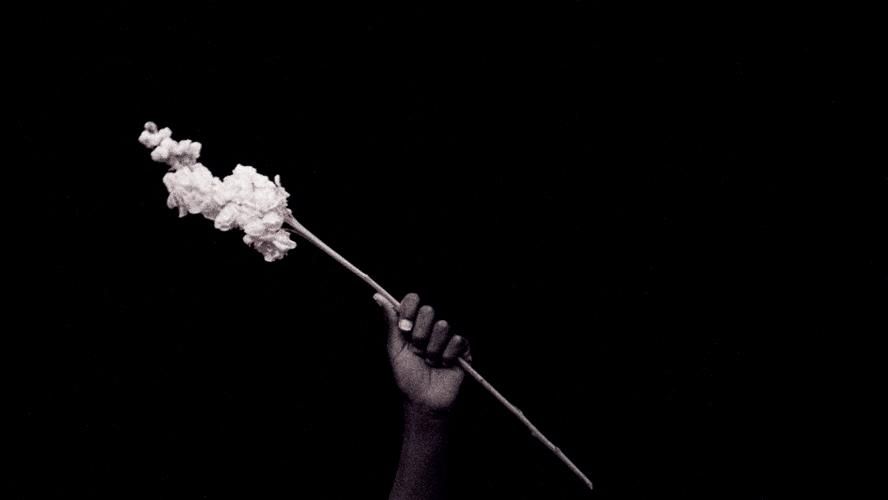
Prior to this project the two engaged in the archive of the United Order of Tents – the oldest African American women’s group in the United States, established by

formerly enslaved women in 1867. That involvement led to HuntEhrlich’s “surrealist documentary” Spit on the Broom (2019), which sought to earmark the significance of the order, without revealing the secrets that helped them survive for over a century. This concern – how to talk about a history that is secret, and derives its power from that secrecy – is central to both these artists practices.
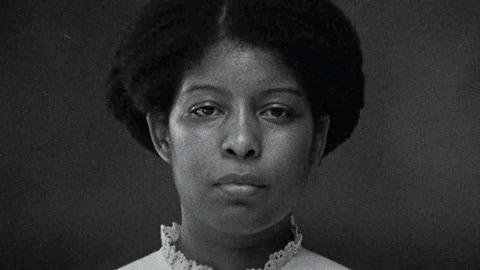
273 272
Conspiracy, 2022 Video still
In Conspiracy, Leigh and HuntEhrlich overlay beautifully rendered shots of the tools and processes of Leigh’s trade, with haunting vocalizations and narration drawn from Robert Farris Thompson’s Flash of the Spirit: African & Afro-American Art & Philosophy1 and Zora NealeHurston’s Tell My Horse. 2 The diasporic breadth of the artists’ interests are made clear with each text discussing traditional practices
in Central Africa and the Caribbean respectively. The voice of Deborah Anzinger, whose work is also featured in this exhibition, and canonical performance artist Lorraine O’Grady also make an appearance in the film.
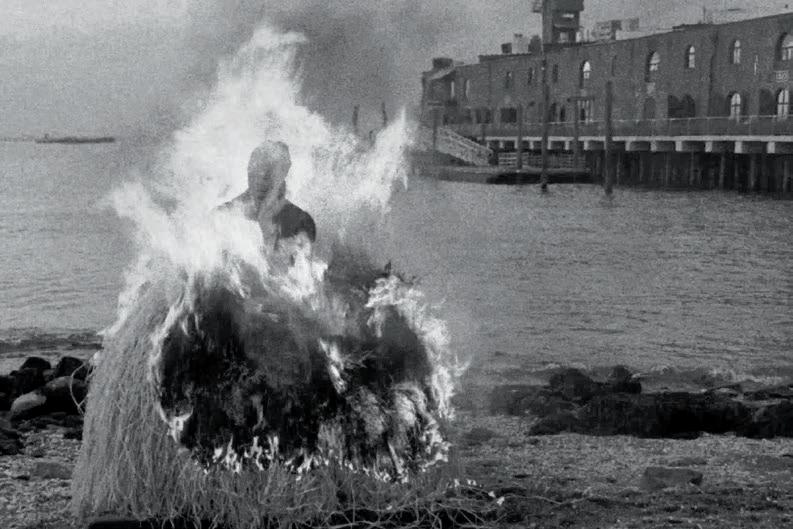

A full apprehension of this conspiracy requires that you know who O’Grady is, that you have some sense of her significance for art history, and Black women’s
place (or lack thereof) in it. You will also miss something if you don’t know about Ehrlich-Hunt’s ongoing exploration of Black women’s interiority and archives; her work on Martinican anti-colonial, feminist Suzanne Roussi-Césaire, for example. There is also something in Deborah Anzinger’s inclusion, her reading of Hurston, who was herself a diasporic lynchpin. If you recognize author Sharifa RhodesPitts, another long-time co-conspirator, and know enough of her work to ken the significance of her inclusion you’ll have understood a bit more. The film taunts us, as neither Anzinger nor Rhodes-Pitts’ names appear in the credits. It is a conspiracy after all, if you know, you know.
You may seek to enroll yourself in these goings-on by getting to know, as I did. For example, I sought out the 1974 album by Jeanne Lee for which the film was named. And boy am I happy I did. What awaits you there? I won’t say. I’ve already named too many names. What I can tell you is, there’s a reason this is a film about labor. Until then, sit and watch that thing that has been saddled with all the value, that object more exalted than its makers, burn.
nicole smythe-johnson
1/ Robert Farris Thompson, Flash of the spirit: arte e filosofia africana e afro-americana (1984). São Paulo: Museu Afro-Brasil, 2011.
2/ Zora Neale-Hurston, Tell my Horse (1938). New York: Harper Collins, 2008.
sonia gomes
“An invisible and tonic thread Patiently weaves the net Of our millenary resistance.” – conceição evaristo1
Materials ask from the artist that they be given another life. She then sews, twists, covers, ties, and transforms scraps, fabrics, threads, and wires into sculptural objects. Following this, the artist invites the viewer to move around, to see her creations with their bodies.
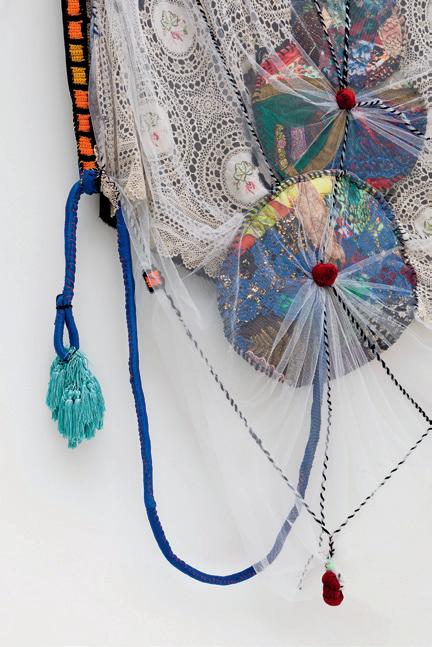

It is impossible to appreciate the work of Sonia Gomes with one’s eyes alone. Her creations invite us to move from a passive position

275 274
Véu de Maia, 2022 Maia’s Veil. Fabric, 203 × 265 cm
to that of an engaged spectator, who moves, bends, tilts their body, raises their head, gyrates, in a dance with the object, in order to perceive it from another angle, to discover and pay attention to the detail that is hidden in the next torsion, on the other side, down here or up there.
Her works are not figurative, and yet themes such as race, gender, and temporalities emerge in the
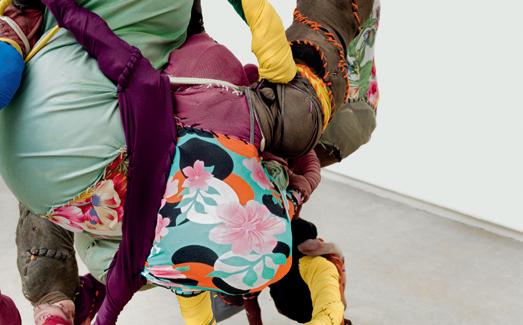
various critical readings of her artistic work. What are the stories, the memories, the affections stored in the fabrics and cloths used by Sonia Gomes? What are the origins of the materials and what paths will they still follow after this exhibition? From the time when these objects still had a utilitarian function – the wedding dress, party blouse, school uniform, tablecloth, protective cover, linen pants,
etc. – to a new time in which, tied, twisted, frayed, and sewn, they become sculptural objects.

The 35th Bienal de São Paulo presents dozens of works by the Minas Gerais artist, forming a robust and representative body of her poetics and trajectory. Wall works, hanging pieces, rods, and some pieces from the Torção [Torsion] series – Gomes’ trademark – will comprise the space. As such, the condensed, tonic time and entangled memories of the millenary resistance of black women takes shape and manifests itself in the choreographies of the impossible.
juliana de arruda sampaio
translated from Portuguese by philip somervell
1/ Conceição Evaristo, “A noite não adormece nos olhos das mulheres”, in Cadernos negros, vol 19, org. Márcio Barbosa, Sônia Fátima Conceição & Esmeralda Ribeiro. São Paulo: Quilombhoje; Ed. Anita, 1996.
_
Untitled, from the series Torção, 2004-2021 Torsion. Stitching, bindings, different fabrics and laces, 180 × 100 × 80 cm
277 276 stanley brouwn
stella do patrocínio
Since little is known about Stella do Patrocínio, the words we use to talk about her, ever elusive, must be fabulated from the choreographies of the impossible. This is also how falatório [chatter], her body-vocalic practice of the word, requires us to connect with it – closing our eyes to hear the collapse of boundaries.

In every minute that passes in the 1 hour, 39 minutes, and 15 seconds of these recordings, Patrocínio oper-
ates a new fold in time, making those horizontal lines curve – from those drawn by the psychiatric asylum to those of literature – that stole her body, that wanted to steal her word. This scramble, until recently echoed by degenerative disorders, eugenics, the fetish of madness, poetry!, is now shattered by a chatter that recasts the very arena of guerrilla warfare. And she affirms: in spite of Eco, these are my terms.
279 278
Echo, the nymph forced to repeat the words of others. Or even Echo –the white consensus. 1
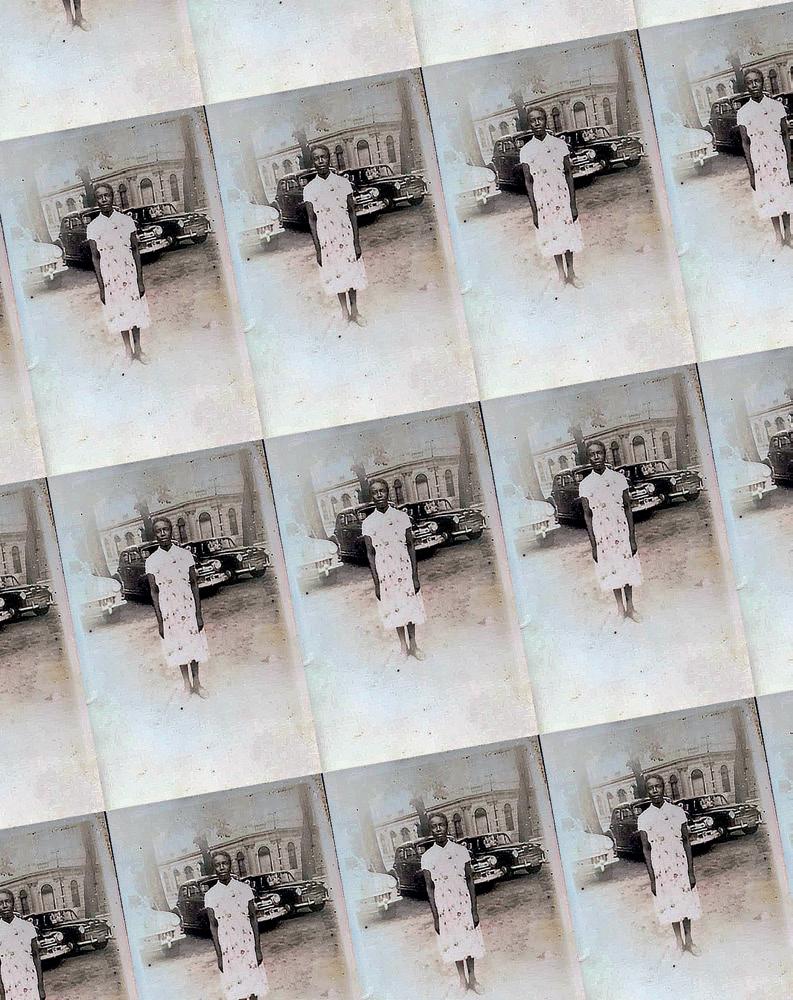
Exu, movement, life force – makes time and message circulate.
In the conclave between Echo and Exu, the score is not settled, nor is the debt; but time spirals:
crossed by forces of asphyxiation – the police, literature, domestic labor, electroshock therapy –, Stella do Patrocínio opens her Exurian chatter to the creation of escape routes and to retaliation, to aesthetic fabulation in the space of enclosure. And it is in this opacity that the chatter dances – not only poetry, nor testimony, nor any other classifications that, by themselves, are not enough:
If I tear that heavy one in half, from half to half, slam slam slam her on the floor, on the wall, throw her out, in the middle of the bush, or on the other side of the wall, it’s a malicious little pleasure [...] Kill the whole [scientist’s] family. Let them make a cart, dump them all dead and go far away.2
Stella claims to be from the time of captivity, because she understands the fantasy-machinery that lies behind the incarcerations of Black bodies since her great-grandmother’s time. She says aloud: Clarice, Celeste, Meritempe, Luzadia, Adelaide – names we may never know much about beyond the affection with which she utters them. In a language that wanders in a rhythmic pretuguês, 3 syncopating the repetition of differences, Stella dislodges previous notions of what time, space, home, family, science, the body and its study are – and proceeds as far as possible. Her vocals contain vertebrae, and she constructs worlds of language to cast an exu-chatter that tears through time and kills, today, the echoes of yesterday.
sara ramos
translated from Portuguese by philip somervell
1/ A reference to Grada Kilomba, Ilusões vol. I –Narciso e Eco. In Grada Kilomba: Desobediências poéticas. Exhibition catalog. São Paulo: Pinacoteca de São Paulo, 2019.
2/ CD2_01. Third part of testimonies/interviews/talks. 6’53”. In: Sara Martins Ramos, Stella do Patrocínio: entre a letra e a negra garganta de carne, 2022. Master’s Dissertation – 2022. Available at: dspace.unila.edu.br/handle/123456789/6465. Accessed on: Jun 2, 2023.
3/ A pun between the words “Black” and “Portuguese”. Reference to Lélia González, “Racismo e sexismo na cultura brasileira”. Revista Ciências Sociais Hoje, Anpocs, pp. 223-44, 1984.
Stella do Patrocínio before her forced hospitalization

281 280 tadáskía
Ave preta mística, 2022
Mystical Black Bird. Pencil, colored pencil, oil pastel and spray on paper, 65 × 50 cm
At the very beginning of Ave preta mística [Mystical Black Bird] (2022), Tadáskía’s first book of loose pages, the artist announces that the words that follow are dedicated to her allies. Guiding us through the flight, she presents herself as a sister and embodies the bird that addresses the members of her confraternity. She is among us, but the haughty vibration of her words surpasses her amiable tone and positions
her as the matriarch of the flock, “the mother of the house.” We join her in her dreamlike flight and, as if in prayer, with every turn of a page, with every beat of a wing, we realize in her verses that a life without ties is a constant and collective exercise.
The work is divided into bilingual texts, with references to the black feminist thinker Audre Lorde, and drawings of different colors and thicknesses, which look like “ruffled feathers.” The crooked and curved lines traced on those pages, whether in her verses or in her drawings, are the matrix gesture of Ave preta mística. The alternation between the writing and the pages with colored images provides the shape and rhythm of the narrative. Like the formation of a flock, each part of the book is a singular expression: they are elements that relate to each other and reconfigure themselves with each new passage.
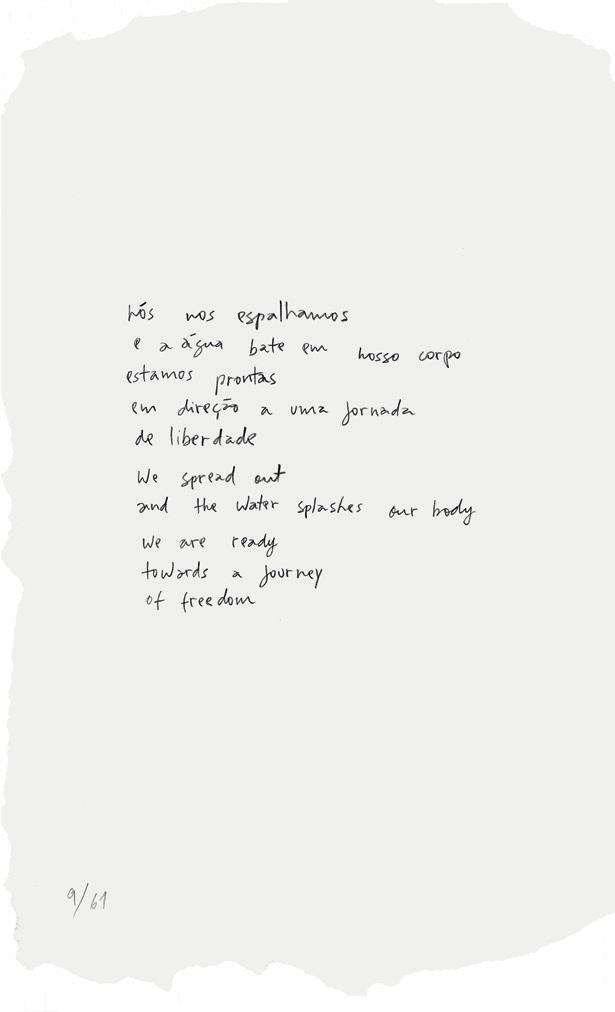
For the 35th Bienal de São Paulo, in addition to presenting the book’s pages spatialized in a room, Tadáskía will exhibit a set of works that derive from materials that are common in her output: three sculptures made of bamboo, straw, and cattail, similar in shape but with different elements at their base – in the first of them, a plate with sewn eggs; in the second, a selection of fruits that must be consumed by the public and the institution’s staff or be renewed before deteriorating; in the third, a quantity of face powder of different colors. On the inner wall of the room, Tadáskía will display a large-scale drawing made of dry pastels and charcoal.
translated from Portuguese by philip somervell
thiago de paula souza
taller 4 rojo
At the beginning of the 1970s, Taller 4 Rojo articulated a critical visuality and carried out actions directly and supporting social movements under the National Front governments. This Liberal and Conservative parties coalition resulted in one of the most authoritarian periods in Colombia, with open violation of human rights, as well as consolidated the armed conflict in the country.
In this context, the Taller 4 Rojo founded a popular school and carried out field work linking up with peasant and indigenous communities, trade unions and marginalized urban sectors, documenting their experiences. These records, together with images collected from the press, were the testimonial substance that they transfigured through operations taken from the graphics and the
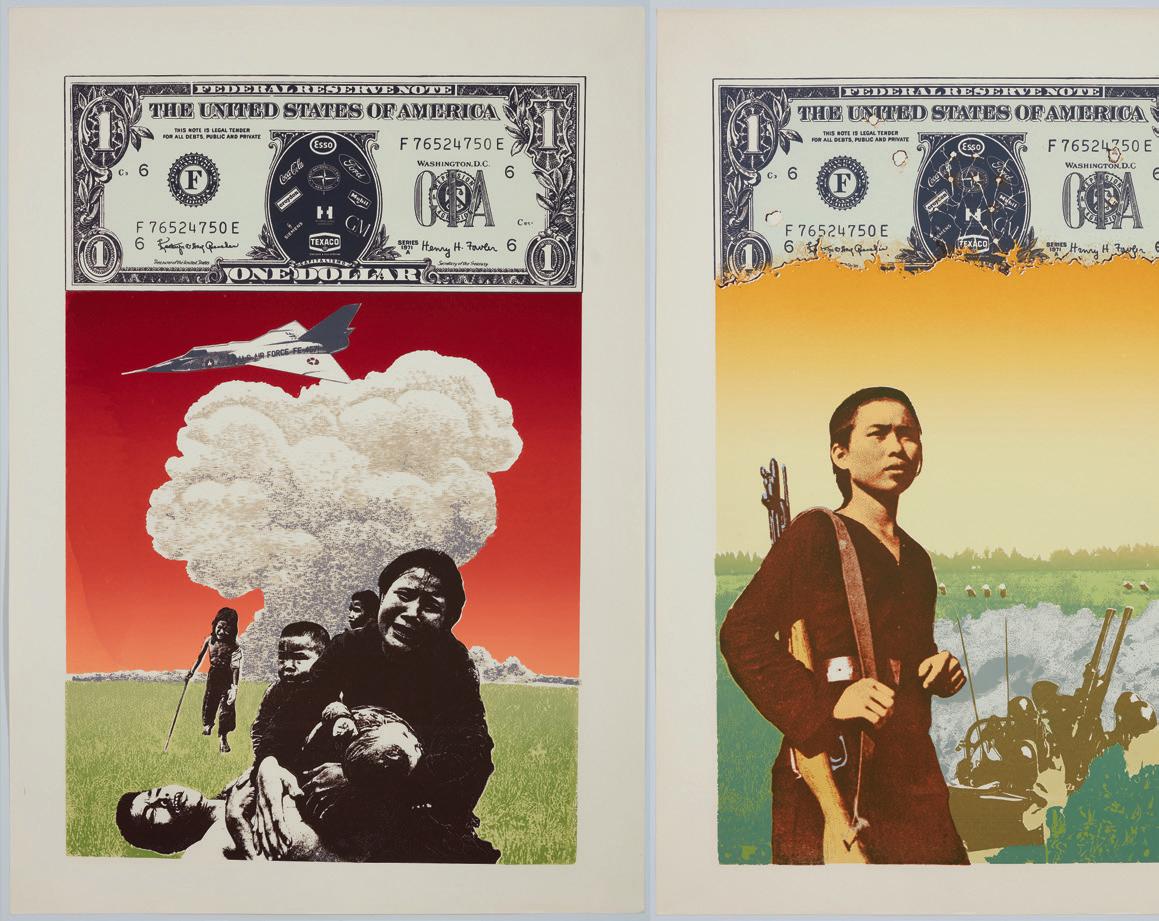
283 282
Latin American cinema of the time, such as montage, the production of series and sequences, the work with patterns and high contrast.
The visual grammar of Taller 4 Rojo wasn’t the result of an analytical distance, but was elaborated from the bodily experience of having walked with the communities that were soon brought into its images. Posters such as A la huelga 100 a la huelga 1000 [100 to
the Strike 1000 to the Strike] (1978) were made along several years of collaboration with independent trade unionism. The Testimonios [Testimonies] folder was an early evidence of the torture practised by the military forces amidst the persecution of dissident political movements throughout the country. The engravings show wounded and bound bodies, blindfolded or screaming in the middle of open
and inhabited landscapes. In the trilogy América II, montage and photo-serigraphy take over the tortured body, rewriting it in a more complex plot, which seems to point to the theological-political nature of the pacts of power as historical continuity.
The emblematic photo serigraph trilogy Agresión del imperialismo a los pueblos, A la agresión del imperialismo, guerra popular and Vietnam nos señala el camino [Imperialism’s Aggression Against Peoples, to Imperialism’s Aggression: People’s War, Vietnam Shows Us the Way] was made in 1971-1972 in solidarity with the popular resistance in Vietnam, but also with other processes of anti-imperialist struggle in Latin America and Africa.
What happens to us today, forty years later, when we see the sequence of the disintegrating dollar note and the war plane turned into pieces in a pasture? For a moment, these images seem to anticipate the moment when war and money change form, disintegrate to become a molecule and mutate, paving the way for the financing and technologization of the massacre. But this turning point is also a point of interruption to the totalizing impulses of the history of capital. Between the three images, it is also possible to retain the movement of the body of a peasant woman, which takes on different tonalities, gaining space and proximity, showing this other time of the bodies that don’t take their feet off the ground and regenerate themselves among the ruins left behind by commodities and necropower.
fernanda carvajal
translated from Spanish by ana laura borro
Agresión del imperialismo a los pueblos, A la agresión del imperialismo: guerra popular, Vietnam nos señala el caminho, 1971-1972 Imperialism’s Aggression Against Peoples, to Imperialism’s Aggression: People’s War, Vietnam Shows Us the Way. Silkscreen print, 100 × 216,6 cm

charles white elizabeth catlett
john woodrow wilson
leopoldo méndez margaret taylor goss burroughs
tive nature through meetings and assemblies, as can be seen in the photographs. In them they discussed what to represent, how to form the group of volunteers who would produce the image, taking care that the agent in charge was recognized, and at the same time, the collective exercise through the TGP’s distinctive seal/logo.
“I am black, a woman, a sculptor, and a printmaker. I am also married, the mother of three sons, and the grandmother of five little girls (now seven girls and one boy) [...] all of these states of being have influenced my work and made it what you see today”
Collaborative processes have a rich tradition in Mexico, and one of the initiatives whose imprint is widespread is that of the Taller de Gráfica Popular (People’s Graphic Workshop), better known as the TGP, which dates back to 1937. Several of the founding members came from another group called the Liga de Escritores y Artistas Revolucionarios (League of Revolutionary Writers and Artists). Reverberating precepts promoted by Muralism, they continued to encourage visual production committed to struggles and social justice, denouncing situations in which peasants and workers lived, and especially resisting and questioning messages, effects or practices linked to prevailing fascism.
The TGP’s graphics – in the spirit of agitation and propaganda – also circulated through posters, flyers and calendars, appealed to a visual militancy and also to a critique of production models focused on the individual artist.
The TGP promoted instead organizational resources of a collec-
In March 1938 the TGP approved a document which contained its interests and objectives, a kind of manifesto or statement in which they agreed to work in lithography, metal and wood printmaking and linoleum.
This workshop is created in order to stimulate the production graph in order to benefit the interests of the people of Mexico, and for that objective is proposed to bring together the largest number of artists through the method of collective production.1
Although this document was not published, years later, in March 1945, they published their Declaration of Principles in which they reaffirmed themselves as a center of collective work for functional promotion, as well as their vision of art at the service of the people, so that their production should reflect the social realities of their time.
Like other collective strategies over time, the TGP had various moments of cohesion and internal tension, its participants varied in number and geographical origin at different times. Among its members were artists such as Leopoldo Méndez, Pablo O’Higgins, Luis Arenal and Adolfo Mexiac, also had an important participation of women artists such as Mariana Yampolski, Rini Templeton, Elizabeth Catlett and Margaret Taylor, whose work, in the context of the new feminisms and the depa-
triarchalizing of history, is being revalued and situated.
Given the great artistic performance and the profuse political activity of the TGP, various foreign artists (mainly American) temporarily joined the workshop to contribute their work to the production of socio-political prints; these artists were called guest artists and some of them were: John Wilson, Hannes Meyer, Lena Bergner, Charles White, Eleanor Coen, Margaret Taylor Goss Burroughs, Rini Templeton, Elizabeth Catlett, among others. These links consolidated the international character of the TGP and in a way stimulated the development of other related projects such as Workshops of Graphic Art in Los Angeles, San Francisco and New York.2
285 284
– elizabeth catlett
_
1/ Humberto Musacchio, El Taller de Gráfica Popular. Mexico: FCE, 2007, 25.
2/ Alberto Hijar Serrano, Catálogo TGP 80 años. Taller de Gráfica Popular. Mexico City: Museo Nacional de la Revolucion, 2017, p. 39; Humberto Musacchio, op. cit., 30-60.
taller de gráfica popular
The production of Elizabeth Catlett (1915-2012) is distinguished by the determined and politicized visual representation of working women and other agents who challenged racism and the violence imposed on communities that have suffered violence, principally African-American and indigenous people. By 1946 Catlett won a Julius Rosenwald Fund grant and began work on a series inspired by the working
women of the Carver School, with which she was able to travel to Mexico accompanied by Charles White. Catlett stated that from the TGP she developed “a new understanding of how she wanted to work as an artist and what exactly it was that she wanted to fight for”3 by attending to a work for the Mexican people rather than framing it in gallery or museum circuits. Similarly, Catlett’s presence added new axes of work to the TGP, such as awareness of race and gender. One of her emblematic series is The Black Woman (1946), composed of 15 linoleum prints in which she installs a kind of protest about the oppression, resistance and survival of Black American women. After her time at the TGP, Catlett’s production continued to focus on African-American themes, producing works that became iconic in the movement for the civil rights of African-American citizens, such as Negro es bello [Black is Beautiful] (1969) and Malcolm X nos habla [Malcolm X Speaks to Us](1969).
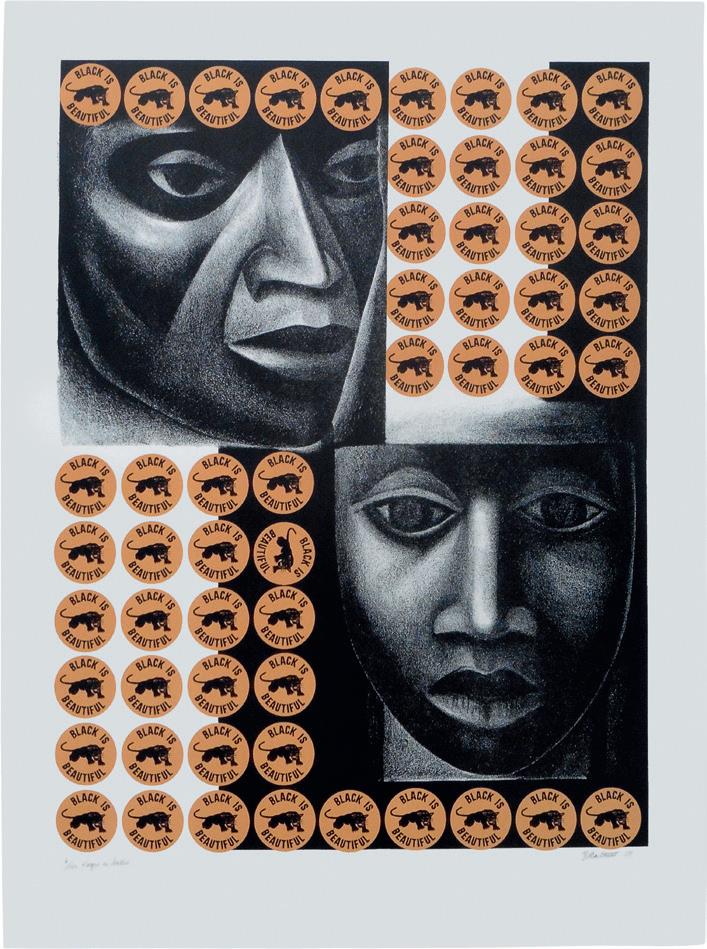 3/ Comisarenco, “Negro Woman y La Postmemoria de La Esclavitud En Elizabeth Catlett”.
elizabeth catlett Negro es bello II, 1969 Black is Beautiful. Lithograph, 78 × 57 cm
3/ Comisarenco, “Negro Woman y La Postmemoria de La Esclavitud En Elizabeth Catlett”.
elizabeth catlett Negro es bello II, 1969 Black is Beautiful. Lithograph, 78 × 57 cm
Another of the guest artists was Charles White (1918-1979), like Catlett of African-American origin, whose production was primarily focused on combating distortions and stereotypes about AfricanAmericans that were disseminated in popular visual culture. Over time, his interests became linked to political, trade union and gender realities. White traveled to Mexico in 1946, accompanied by Elizabeth

Catlett, and upon coming into contact with the TGP reaffirmed his interest in printmaking given the scope it could have due to the reproducibility, the diaspora or circulation that print runs allowed, and its low cost of production.
He returned to New York in 1949 and collaborated in the New York Graphic Workshop, which, like the Mexican TGP, would have an important effect on the dis-
semination of social graphic art, especially in defense of the rights of African-Americans. Some of his portraits stand out, such as that of Bessie Smith, the blues pioneer popularly known as the “empress of the blues,” who was buried in a grave without a headstone until Janis Joplin wrote the following epitaph: “The greatest blues singer in the whole world will never stop singing. Bessie Smith, 1895-1937” or the portrait of Frederick Douglass who was linked to various anti-slavery initiatives and who promoted abolitionism. Douglas was born into slavery and therefore developed critical perspectives on freedom and human rights mainly related to African-American communities who, like him, were subjected to enslavement. charles white Exodus, 1961 Linocut print on paper, 80 × 125 cm
287 286
In the case of John Woodrow Wilson (1922-2015), the AfricanAmerican artist went to Mexico with the interest of getting to know one of the main representatives of Mexican muralism, José Clemente Orozco, whose exhibitions he had visited and whose way of representing the situation of the oppressed classes in Mexico he identified with. Although Orozco had died, Wilson joined the TGP,
where he found a collective context of widely distributed image production through printmaking. At the TGP he coincided and produced concomitantly with Elizabeth Catlett and Charles White, with whom he shared an interest in making visible and working with and for the African-American community.
An example of this is the work The Trial (1951), a lithograph in which a young man of AfricanAmerican origin stands (proportionally diminished) before three white judges who loom menacingly over him, making visible the unequal and vertical treatment to which they were subjected. During his production in Mexico, Woodrow painted a mural that was later destroyed called The Incident (1952), which pictorially narrates the violence and terror of the lynching of an African American by the Ku Klux Klan. It seems that the title operates more as a terrible sarcasm in the face of normalized xenophobic and supremacist violence.
 john woodrow wilson
The Trial, 1951 Lithograph on cream-colored wove paper, 40,8 × 32,4 cm
john woodrow wilson
The Trial, 1951 Lithograph on cream-colored wove paper, 40,8 × 32,4 cm
In 1952, Margaret Taylor Goss Burroughs (1915-2010), an AfricanAmerican artist and poet, joined the TGP. Her interests were equally focused on expressing her racial and cultural identity and teaching art. She was involved in shaping important political projects in the visual arts, co-founded the Sur Side Community Art Center (1939), which included a gallery and studio space for African American art-

ists, and the DuSable Museum of African American History (1961), both in Chicago. During her time in Mexico she also painted a portrait of Bessie Smith, adding to the representation of significant figures of African-American origin in a temporal context where racism was widely and uncritically prevalent.
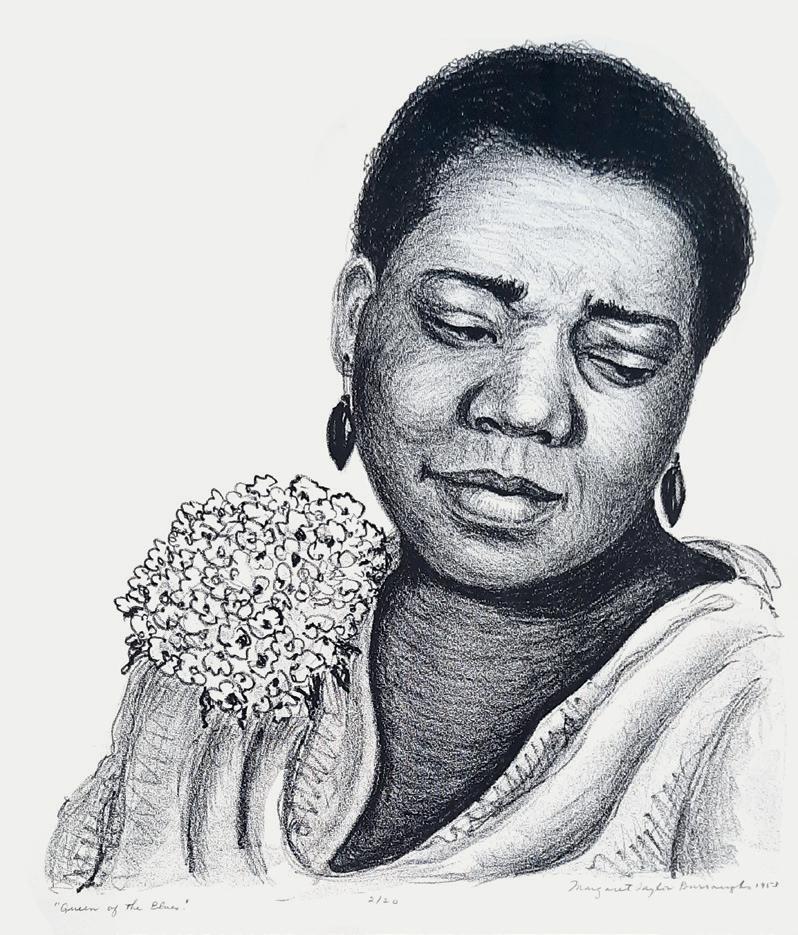
289 288
margaret taylor goss burroughs Bessie Smith, Queen of the Blues, 1953 Lithograph, 46,5 × 40 cm
Regarding the participation of the Mexican artist Leopoldo Méndez (1902-1969), considered one of the most important Mexican engravers, a social and collective perspective was reflected in the productions he made for various organizations such as the League of Revolutionary Writers and Artists, the Mexican Communist Party, the Popular Socialist Party of Mexico and the Confederation of Latin American

Workers. Méndez’s artistic production took shape when he joined the Estridentismo movement, and his work promoted leftist and post-revolutionary ideals that allowed him to generate a broad visual vocabulary linked to the socio-political history of Mexico, but also to criticize and denounce the violence promoted by fascist projects in Europe.
These works – which are pioneering for the conformation of
other subjectivities – far from operating on an exclusively retinal level, contributed to the insertion of other subjects of representation continually reviled in the tradition of artistic representation or, alternatively, repositioned and framed them in a dignified way and in another aesthetic-political-symbolic order that we can read today from a proto-decolonial perspective.
The validity of the TGP – in a present where rights are disputed, new turns of violence exist and where artistic production can go through the crossroads of art/politics thanks to graphic – asks us not only to reflect but also to permanently sustain points, representations and frameworks that incite us to read critically in and from the present.
getsemaní guevara and sol henaro
translated from Spanish by ana laura borro
leopoldo méndez
Fusilado (para la película Un día de vida), 1950 Shot to Death (for the film Um dia de vida). Linocut print on paper, 47,7 × 58,8 cm
Printed in Lima in 1988, Carpeta negra [Black Folder], by art collective Taller NN, was, at the time of its publication, an unbearable visual and textual device for both the official culture and the leftist Peruvian culture. Its pages dared to touch the untouchable, staining with a monstrously seductive chromatic make-up the mythical faces of the revolution in a wide left-wing political spectrum, from Mao Zedong to José Carlos Mariátegui, from José María Arguedas to Edith Lagos or Che Guevara. A barcode was printed on them, showing the enigmatic number 424242 (in reference to the telephone number the population was encouraged to dial in order to make anonymous denunciations of people suspected of terrorism). The image of the student Javier Arrasco Catpo, killed by the civil guard during a protest in 1988, is the hinge to another group of images, showing different massacres – Guragay, El Sexto, Pucayacu, Uchuraccay, and El Frontón – and the word “Peru” is printed on them as a country-brand. Images of mass graves or corpses of journalists in rubbish bags, taken from the anesthetized mass media, are also colored as a way of giving them back the ability to scream. Both series, the faces of the revolution and the anonymous bodies of the massacres, are marked by
the capital, which inscribes its signs on them – the barcode, the logo – perhaps as a password to the ancient knot between money and coloniality, which precedes and exceeds the chronology of Carpeta negra.
Carpeta negra creates a mobile device of partial and precarious memory of the years that turned Peru into a deposit of open-air horror, working as a key to the new phase of capital accumulation on a global scale. But in its audacity full of antidogmatic irony, without a state or a party as interlocutor, the Taller NN generated a device capable of constructing an interrelation with time, in every time. What happens when these images look back and get in contact with the previous period of the Agrarian Reform (1969-1975)? Or what image does Carpeta negra give back to Peru today, in the revolts that broke out in a decentralized way among the mainly Indigenous and peasant population in December 2022, and which once again show a colonial wound, impossible to suture?
fernanda carvajal
translated from Spanish by ana laura borro
291 290 taller nn
NN Perú (Carpeta negra), 1988
NN Peru (Black Folder). Screen print and photocopy on paper, 43 × 30 cm
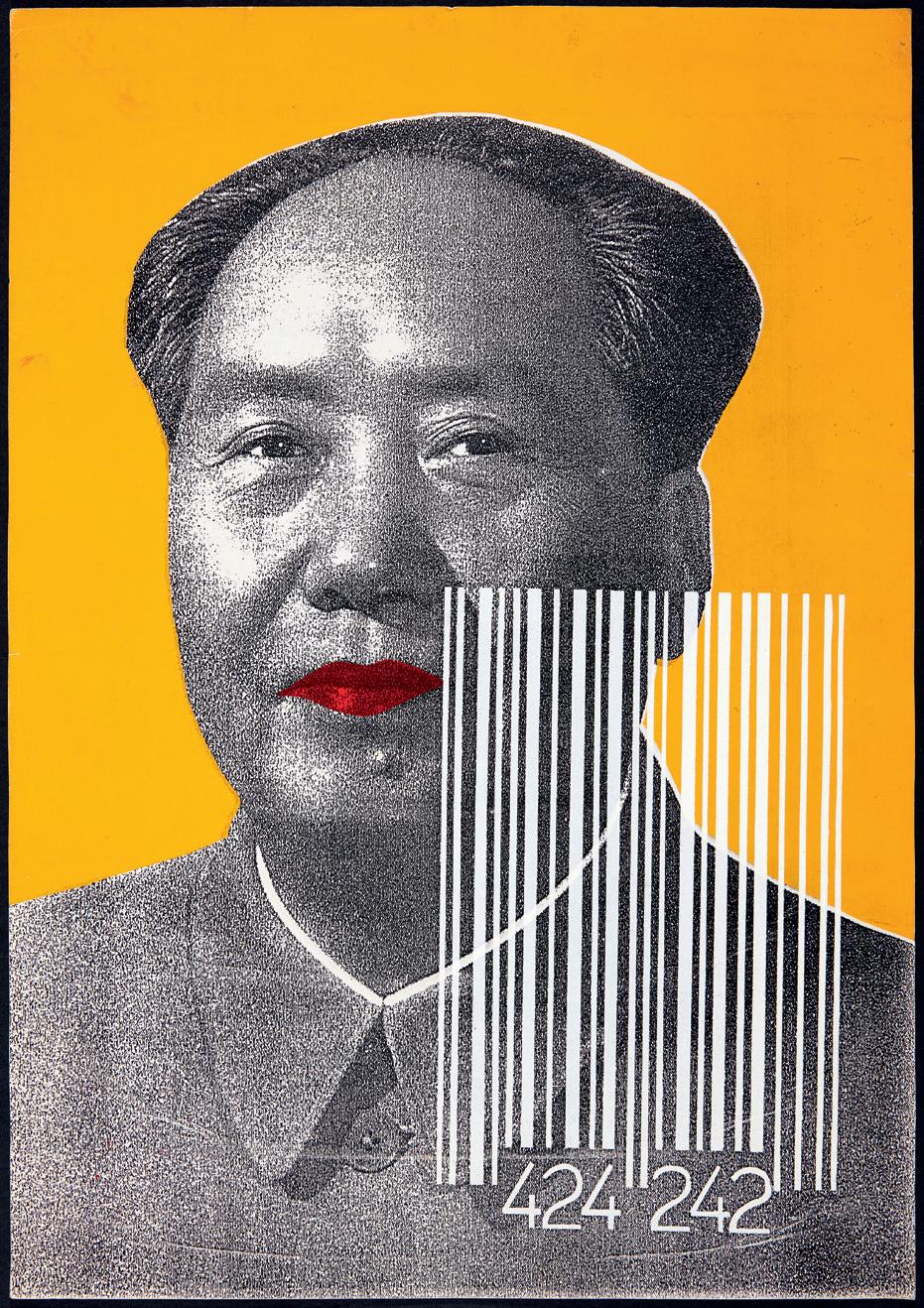


293 292 tejal shah
Tejal Shah’s installation Between the Waves evokes landscapes that seem to be simultaneously extraterrestrial and too terrestrial. One can recognize the desert, the balcony, the mangrove, the city, the landfill site, the sea or the swimming pool as ordinary locations, common places on the planet. At the same time, the performers’ clothing and the type of relationship they establish with each other and their
surroundings produce an exciting strangeness. Sensuality governs contact between bodies – be they plant, animal or mineral, raw or manufactured materials – as well as the way they are portrayed: intricately. Colors, textures, and sounds of this equally raw and imagined universe are not differentiated or organized by taxonomic hierarchies. In this sensory horizontalization, a central element of modern
and universalizing discourses is betrayed: the subject that produces itself as human through the separation, classification, and consequent possession of things in the world. In this work, everything is touched and portrayed as a sensitive, excitable surface, inseparable from everything else.
The head ornaments are notable for the contrast of white and the verticality through which they cut the image, a phallic aspect with no necessary genital correspondence. Although they assume a penetrative function in the more explicit scenes, they also pass for horn, fin, funnel, or cone, conferring a kind of animality and objectuality to the moving bodies. Apart from these contrassexual prostheses,1 there is another element whose symbolic and performative charge is worth noting: the arrangement of artificial flowers, bath sponges, and other colorful objects carefully deposited at the bottom of a pool, with the performers swimming around it, like fish around marine corals. There is no contradiction between nature and artifice, there is only brilliance and beauty, and among the waves, the bodies orbit their surroundings.
miro spinelli
translated from Portuguese by philip somervell
1/ On the notions of contrassexuality and prosthesis, see Paul B. Preciado, Manifesto contrassexual. São Paulo: n-1, 2014. In this book, the author reminds us that the phallus is not a substitution for the penis, but the opposite, and that the penis, in turn, is nothing but a dildo of flesh.
Between the Waves, 2012
 Video stills. 5 channel video installation, color & black and white, multi-channel sound; 85’25’’
Video stills. 5 channel video installation, color & black and white, multi-channel sound; 85’25’’
the living and the dead ensemble
A spiral is the image that opens Ouvertures (2019), the first film by the transnational collective The Living and The Dead Ensemble. The image is the synthesis of what moves the group’s creative process: a sinuous line in a continuous movement of approach/departure, from inward/outward, without beginning or end. In the films and installations of this collective, creating is a matter of traveling, displace-
ment – Haiti-France, forest-beach, past-future, revolution-crisis. Poetry, performance, film, music, and theater are merged with varying and blurred intensities – as in The Wake (2019-ongoing), the group’s second work, which is at once a multichannel installation, a play, a film, and a radical Black manifesto.


The spiral shapes the creative process that is built in act, in incarnation, and in evocation of
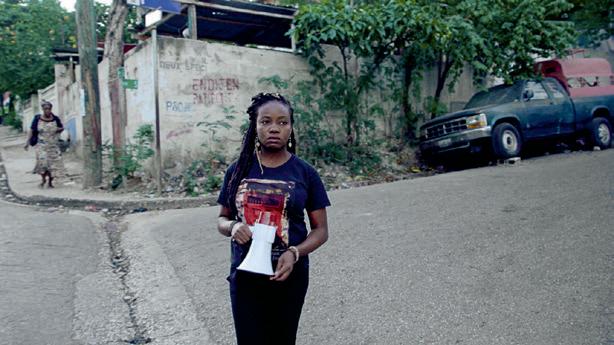
295 294
The Wake, 2021 Video stills. 3 channel video installation, full HD, color, sound; 35’
ghosts – making visible and alive those and that which never ceased to be there. Thus, to the rhythm of the créole, poets and revolutionaries from different eras meet and converse through processes of fabulation and activation. Speech blurs the boundaries between the dead and the living – as the group’s name states. Frankétienne, Toussaint Louverture, Édouard Glissant, Patrick Chamoiseau and
so many other artists/intellectuals/ revolutionaries confabulate in the proposition of a Caribbean imagination that is utopian, urgent, and timeless.
In this sinuosity, the voices – of ghosts, revolutionaries, and members of the collective – overlap in images multiplied on simultaneous screens or in sounds that are echoed by the members of the group that are on a stage. In this

amalgam proposed by the creations, raps, speeches, narratives of Black revolts, a cacophonous chorus is formed in which the chaotic materiality of sounds and stories is intrinsic to the senses of the works. And fire (a recurring element of these productions) blazes on the nights when revolutions are dreamt of and remembered. The flames destroy and transform – also in continuous movement. Following this displacement in between (worlds, times, countries), the music and dance performed by the collective members summon the body to burn also, and invite those who watch to glimpse (im)possible utopias in the flesh of the works.
kênia freitas
translated from Portuguese by philip somervell

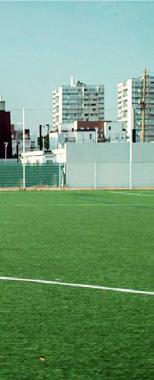
torkwase dyson
When asked in the March 1982 issue of the architectural journal Skyline whether any particular architecture of the past or present act as forces of liberation or resistance, the French theorist Michel Foucault states that “no matter how terrifying a given system may be, there always remain the possibilities of resistance, disobedience, and oppositional groupings […] Liberty is a practice […] liberty is what must be exercised.”
However, the exercise of liberty understood in relationship to space, time, and being leads to an understanding that liberation is a spatial practice. Key to this understanding is the interrogation of situated conditions and the relationships of power to space, the body to autonomy, and subjectivity to perception.
European perspectival construction is predicated upon a subject in the guise of the Vitruvian ideal
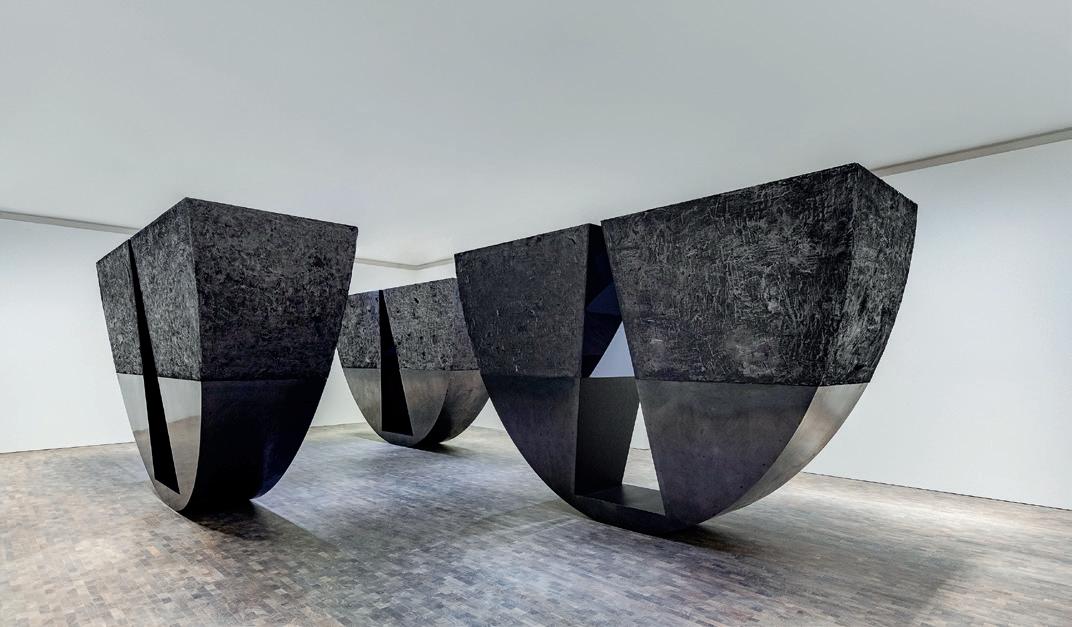
297 296
Liquid a Place, 2021 Steel, painted brass, mirror and graphite, 3 pieces, 243,8 × 365,8 × 121,9 cm (each)
“man” whose eyes are the origin of a line of sight along the center of view that designates all knowledge to be comprehended. Furthermore, perspectival painting and drawing position this ideal man at a station point with a 60 degree cone of vision towards a horizon line that exists at infinity. Understanding the spatial practice of liberation challenges the notion of universalism and the ideal subject whose gaze
surveilles, objectifies, and seeks to subsume the world within European epistemology and colonialism.
In her work exploring the architectural space-making of Black compositional thought, artist Torkwase Dyson asks: What was the ocular experience of Black and Brown people in the slave ship hold? In the self-emancipatory spaces of the garret or crate? Or under the Medieval architecture
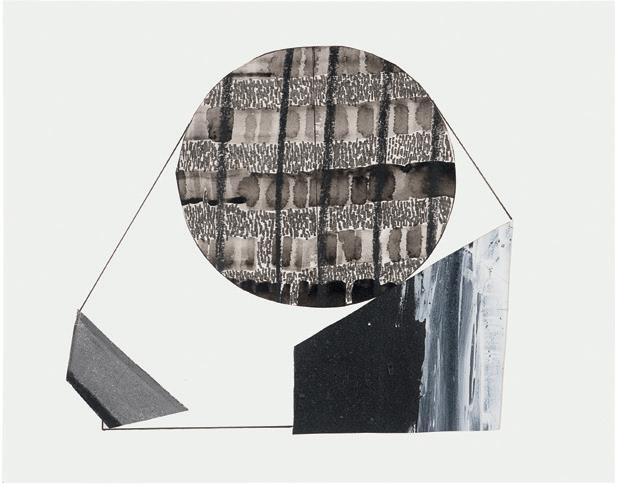

of the slave castle? Or under the conditions of racial capitalism, slavery, imperialism, colonization and all forms of terror, occupation and enclosure?
In the work On Ocular Brutality (2023), with specific reference to Castelo de Garcia d’Ávila / Forte de Garcia d’Ávila in Mata de São João, Bahia, Dyson asks: How did looking become extraordinary? In this 16th century castle, that at its exterior overlooked the Atlantic Ocean and the sugar cane plantations of enslaved indigenous peoples, and at its interior housed a double torture chamber whereby an imprisoned runaway slave would be subjected to the terror and death by a captured and starved animal, Dyson explores the ocular work of the hidden, obscured, concealed, or untraceable body. Dyson’s sculptures are instruments for new and yet unknown ways of seeing and tools to think about the “liveness” of those who died in captivity.
mario gooden
Force Multiplier 2 (Bird and Lava), 2020 Graphite, acrylic, and ink on paper, 27,9 × 35,6 cm
Force Multiplier 1 (Bird and Lava), 2020 Graphite, acrylic, and ink on paper, 27,9 × 35,6 cm
trinh t. minh-ha
From the most elementary unit of film – the gaze – towards the unknown until the final consequences, back to the gaze. Questioned, expanded, cut out, turned over, this driving force constantly pulses in Trinh T. Minhha’s work. It is a work that flows – like the water of Surname Viet Given Name Nam (1989) – along the paths of cinema, anthropology, post-colonialism, music, and liter-

ary theory, areas in which the artist has been intensely producing since the 1980s.
The gaze in check: filmmaking, observing the other, the interstitial regions that make us as individuals and groups. “What I see is life looking at me,” as Minh-ha’s voiceover says in Reassemblage, a film essay that questions the idea of an ethnography founded in scientific objectivity and the anxiety of a
299 298
comprehensive record of the real. This questioning is materialized above all in the form, language, and craftsmanship of those who, rather than thinking in the binomial “form-content,” take into account everything that escapes control when considering the politics of “forms and forces” resistant to the unifying logic of genders (according to the theoretical texts of Minh-ha herself ). Thus, they feed
back on themselves endlessly: Who is looking? Who is looking at who or what? Who is looking back? Who will look at who was looking back at who was looking? And the spiral can keep going round and round indefinitely.
The interests and cultures that engage the artist are as dynamic and complex as the abstractions of force-form: Senegal, China, the experimental music of The
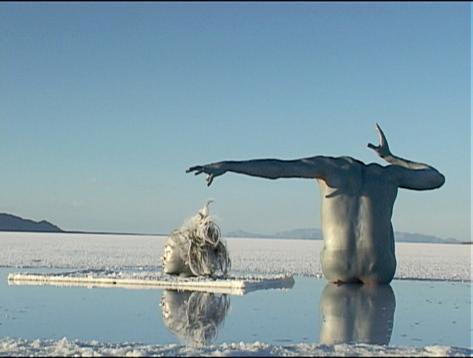
Construction of Ruins band, Japan, Togo, Vietnam… Then there are the mountains and deserts (The Desert is Watching, 2003), and Bodies of the Desert, 2005), where the transportation and journeys of the gaze reflect on the fleeting human presence in the geological context of this planet, whose rhythm and dance — through the in-between place that Minh-ha founded – no longer allows any disinterested contemplation.
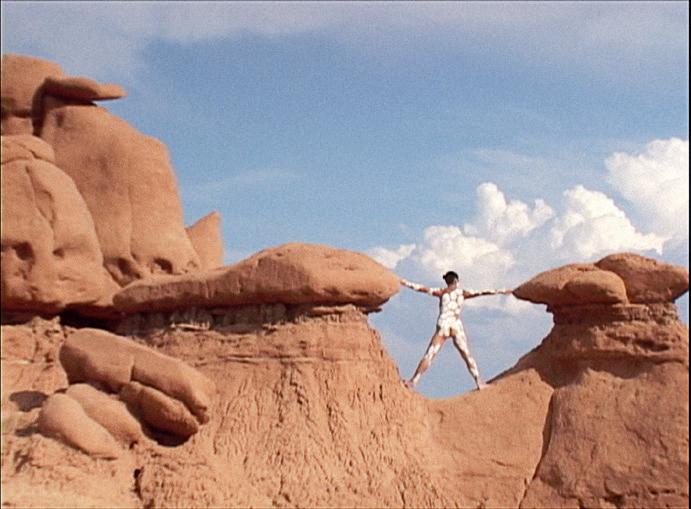
igor de albuquerque
translated from Portuguese by georgia fleury reynolds
Bodies of the Desert, 2005 Video; 20’
ubirajara ferreira braga
“the most fruitful plastic artist in the colony”: almost 3 thousand paintings.
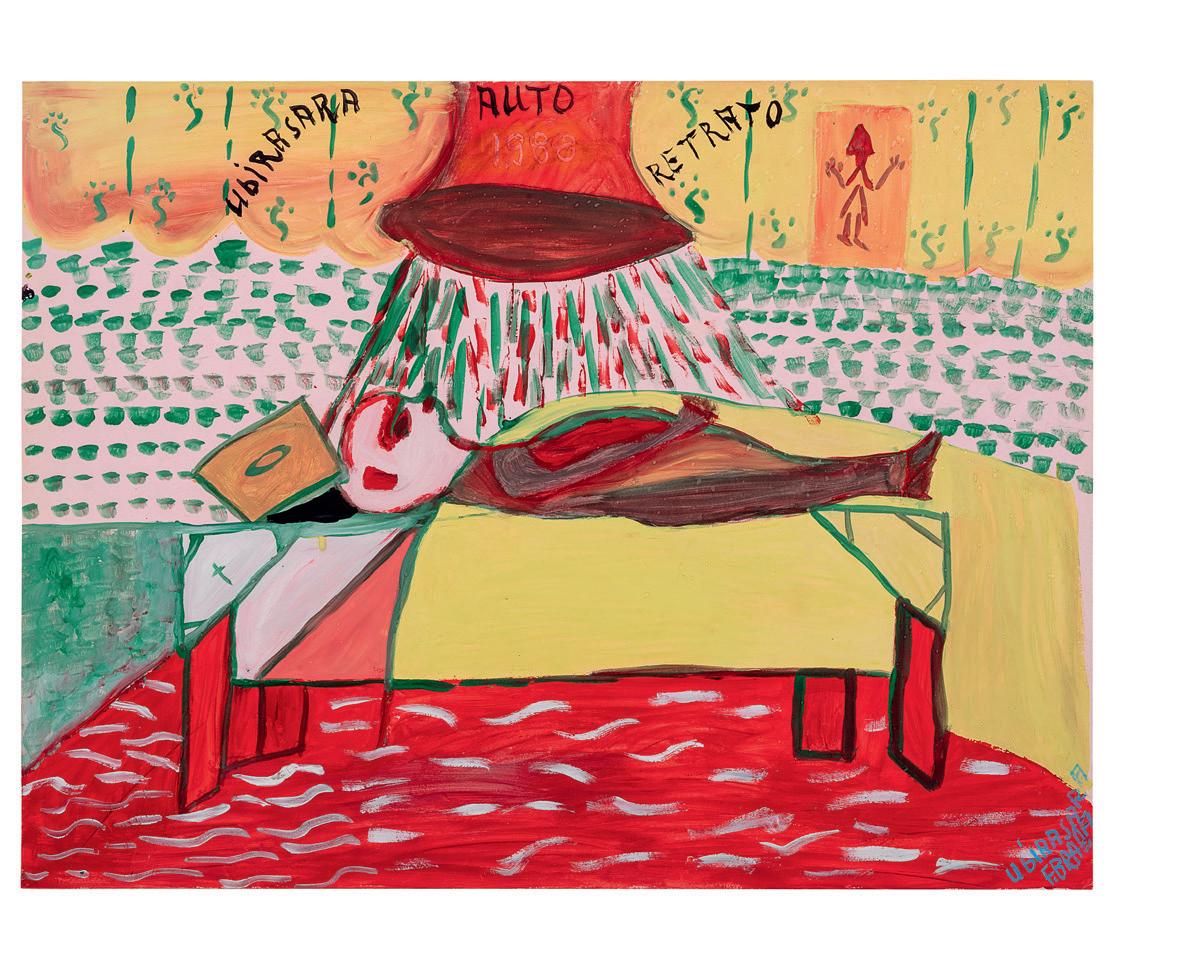
301 300
Autorretrato, 1987 Self-portrait. Gouache on paper, 66,5 × 50 cm
from the nearly 60 years old almost until his death, in the year 2000 (when the Y2K did not bug, unlike the psyche), Ubirajara Ferreira Braga (1928-2000) painted thousands of canvases.
he also printed a business card, in which he proudly showcased his profession: “plastic artist”. a movie telling of his diagnostic sheet paints him as a “calm, conscious resident” of the Juquery (psy-chi-a-tric) colony.
and the public archive stored by the world wide web documented that he was, also, for a brief moment, dealer of his own artworks. this occurred within a unique dwelling that was, in fact, an asylum, that has gone down in history as the “city of the mad,” situated in the city of franco da rocha. the asylum had strict regulations concerning the external circulation of artworks created by its residents.
another account, passed down through word-of-mouth by those who fight for justice, also refer to that city as the “city of the dead”: 50 thousands.
well, on that frank rock1 over which this ambiguous city – both known as the city of the mad and city of the dead – was constructed, Ubirajara Ferreira Braga, with his tupi name, meaning The Lord of the Spear reveals so much about his history, painted his almost 3 thousand paintings.
in these etymo-geographic twists, something resides between Ògún, the blacksmith (as in the painter’s surname;2 God of the forge, of survival technologies), Ṣàngó of truth, who – always embodies – a type of justice (and of quarry, like the one that housed the city of the city of the mad), and, of course – this is where these words wanted to land, since the beginning – Òṣósi: hunter, spearman, maddened, maddening. dweller of the forest.
there is a legend that narrates how Òṣósi, driven to madness (perhaps by love?) ventured deep into the heart of the forest, seeking solace away from the world. only his beloved daughter, Ọya, danced his death, for many nights and days, allowing his spirit to get to Orun, another sort of heaven. another sort of dwelling. maybe a calm one. where maybe Ubirajara now lives. without as much red, as i have seen in the works he painted inside Juquery’s walls.
tatiana nascimento
translated from Portuguese by bruna barros and jess oliveira
1/ “frank rock” [rocha franca] refers to the city name “Franco da Rocha.” [t.n.]
2/ “ferreira” means blacksmith in Portuguese. [t.n.]
Artistas-pacientes, 1987
Artists-Patients. Gouache on paper, 66,5 × 50 cm

_
It is a late afternoon on a sunny Sunday. In a residential neighborhood, children are playing on the sidewalk, some with a ball, others with rope, some at home on their cell phones. There are men and women in front of the houses, talking and looking at their children, daughters, nieces. In one of the houses music is playing as the barbecue edges into the early evening. At one point, a child points to the sky and
announces: “Mom, Dad, come here, quick! What’s that? Is it flying?”
Gradually, everyone begins to look in the indicated direction. Blinded by a radiant glow, they see a beautiful figure approaching, bright and golden, shining like the sun, gliding through mist towards the ground. The child approaches it and asks: “Are you God?” and the answer is clear: “You can call me Deize, I have something to tell you.1”

303 302
ventura profana
RESPLANDECENTE, 2019 Resplendent. Videoclip; 5’20’’
Ventura Profana is an artist with several practices, a glorious prophet, a pastor in her divine capacity. By producing music, video clips, digital collages, installations, and photographs, she creates visualities and life performances that build new imaginaries about religion and faith. In these imaginaries, existences that escape the traditional controls of gender and sexuality are possible. The existences to which
the artist refers are the transvestilities, guardians of the sources of life, forests, and mangroves, those who make themselves alive in the midst of the Dead Sea, who are like the mountains of Zion that do not shake, guardians of ecosystems and sacred life. In her work it is possible to recognize dissident corporealities as a point of torsion between an inflexible tradition and the creation of other emancipatory perspectives.
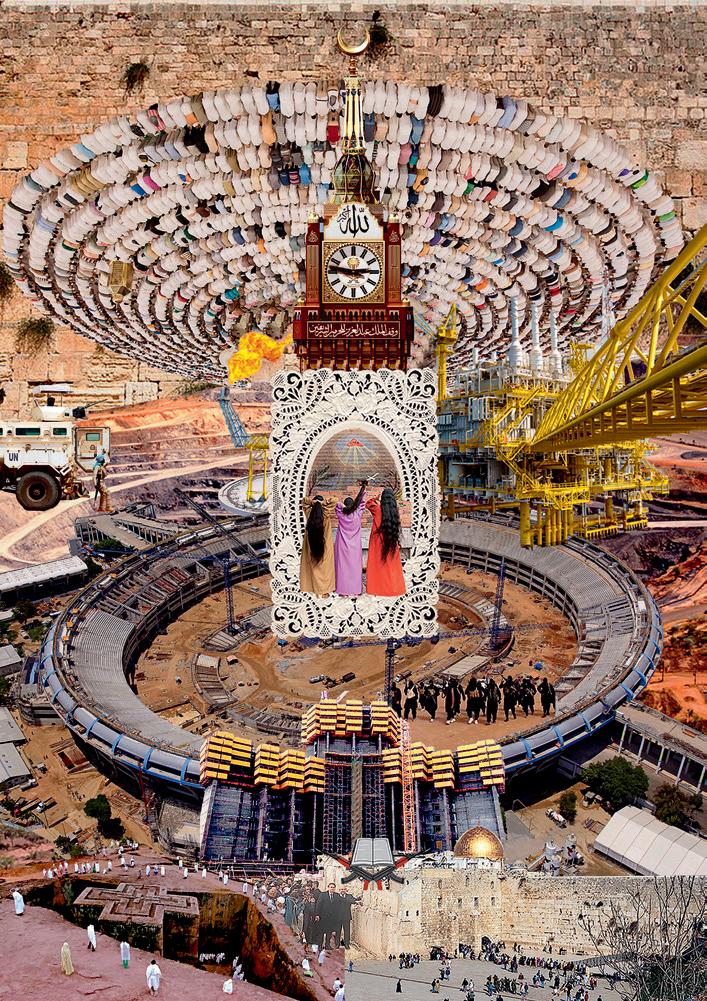
In other words, her production elaborates modes of epistemology that critique conservative and colonial systems of truths and beliefs. To this end, Profana performs inversions and insertions in the neo-Pentecostal linguistic, visual, and performative resources inherited from the familial context. Among some of her interventions in the order of discourse, by replacing Lord with the transvestite, the artist places this mode of existence as a central and disruptive element of traditional thought, elaborating a discourse without Lord, weaving a critique of neo-Pentecostal dogmas, as well as being anti-patriarchal and anti-militaristic. It is thus possible to recognize that Ventura Profana’s output cries out for life in abundance, herself the missionary body that prophesies and praises for health, love, and freedom for all transvestites. At its limit, her artistic production broadens the perception that, by founding a world in which transvestite life is possible, all lives will be possible, immersed in power and glory.
translated from Portuguese by philip somervell
maria luiza meneses
1/ Author’s fabulation of what Deize’s descent to Earth might look like, based on the artist’s visual references. [E.N.]
CONCÍLIO DAS LAMENTAÇÕES, 2020 Council of the Lamentations. Pigment print on Photo Matt Fibre 200g, 140 × 100 cm
Cuban artist Wifredo Lam (19021982) produced the illustrations for French writer André Breton’s Fata Morgana (1941)1 in the context of political refuge and an imminent transatlantic journey. The drawings include the signature imagery he developed in subsequent work: horned creatures, quadrilateral heads, crescent moons with eyes, and the horse-like figure that became his celebrated inter-spe-
cies femme-cheval, as seen in Mujer sentada [Seated woman] (1949). In his art Lam centers Black culture through visual synecdoche on Santería (also known as Regla de Ocha and Lucumí), an Africandiasporic religion largely based on Yoruba beliefs and traditions, peppered with aspects of Catholicism. Titles such as Le Sombre Malembo, Dieu du carrefour [Dark Malembo, God of the Crossroads] (1943)
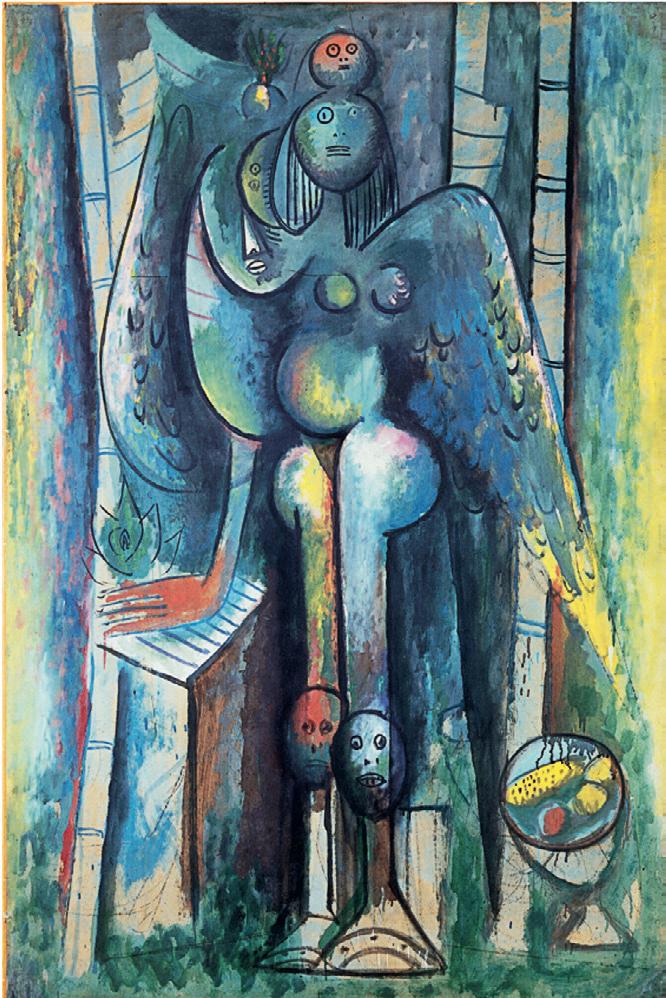
305 304
wifredo lam
Le Matin vert, 1943
The Green Morning. Oil on paper mounted on canvas, 186,7 × 123,8 cm
identify Malembo, a slave trade station in West Africa, and Eleguá, an orisha or Yoruban deity who is the guardian of the crossroads, and is represented by Lam with a horned head and circular eyes. Here the “crossroads” might refer to the Middle Passage as well as to Lam’s own transatlantic journey back home to Cuba. Key to such work is how Lam decolonizes representational codes: hybrid figures
displace distinctions between male/female, human/animal, animal/plant, challenging dominant Western classificatory systems and ontological separations.
Lam also bodies forth such displacements through his painterly transmutations that work at the level of material application, whereby, for example, the thinned paint in Omni Obini (1943), and its ensuing watercolor effect, intensify
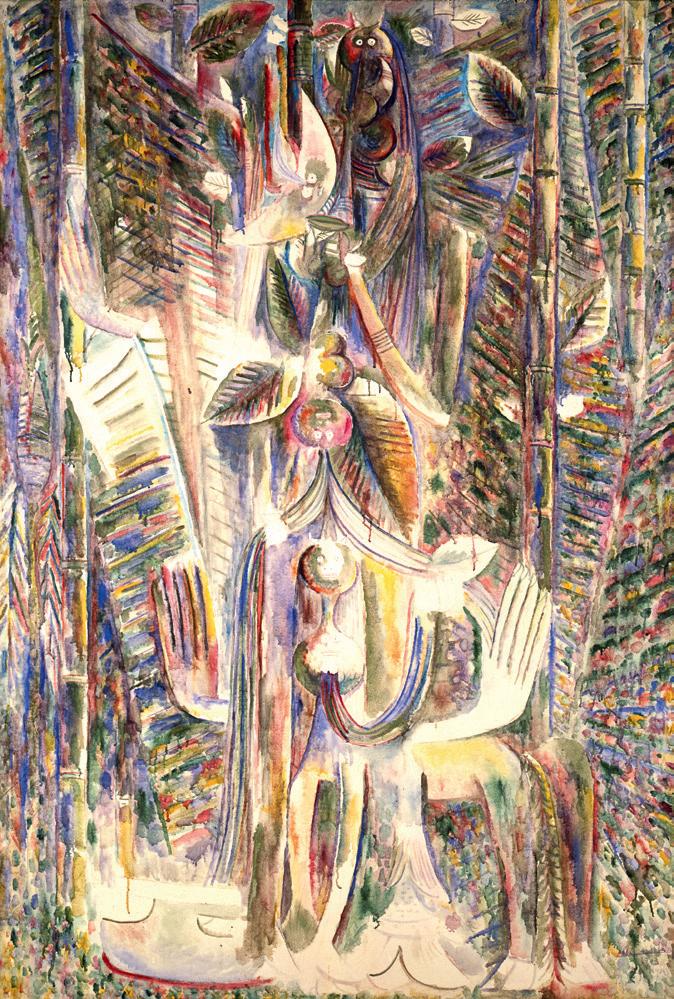
Lam’s purposeful delocalization of color – blues and greens with passages of reds, oranges, and yellows – to further animate the relations among the elements in his painted worlds. In doing so, Lam harnesses the orishas’ life forces, their aché, as a decolonial method that flows across the human, animal, and vegetal and that he visually translates not only as hybrid beings but also through their entwinement with the surroundings through the interpenetration of figure and ground. His purposeful entanglement of oppositions also suggest how different entities might interlock in nonhierarchical ways to be mutually transformative. At the center of what I call Lam’s “aché modernism” is thus the shifting nature of identity and embodiment, whereby ontological crossings and relational openness draw attention to the liveliness of the relations between material and immaterial worlds.
kaira cabañas
1/ The edition presented at the 35th Bienal is: André Breton, Fata Morgana. Illustrated by Wifredo Lam. Buenos Aires: Éditions des Lettres Françaises, 1942.
Omi Obini, 1943 Oil on canvas, 178 × 126 cm
this participation is supported by: Institut français.
The artistic practice of choreographer, dancer, writer, and teacher Will Rawls investigates Black poetics, addresses the limits and encounters between dance and language, explores ambiguities, and questions notions of power and form.

Moving our bodies, dancing with letters, (de)constructing and playing with words and phrases, saying the chosen letter out loud, arranging, rearranging, arranging differently,
in an open choreography under construction. PELE is the version for the Bienal de São Paulo’s audience of Uncle Rebus, a performance previously held in other spaces.

The dynamic of the performance itself invites spectators to read the words formed, which transform into others throughout the activation.
In Uncle Rebus, the text on which the action is based is the Brer Rabbit set of fables, narrated by
307 306
will rawls
Uncle Remus and written by folklorist Joel Chandler Harris, a white man from the American South. Uncle Remus is a kind of composite identity created from the stories of plantation oral culture to which Harris had access. Full of linguistic bias, the stories are written in what the author interprets to be the dialect of Southern Blacks at the time.
By manipulating the available letters, the performers are at the
same time spelling aloud parts of the text, destabilizing the author’s fictionalized dialects, exploring the limits of linguistic normativity and written discourse.
In the version of the performance for the 35th Bienal de São Paulo, a different text will serve as the basis for the activation of the work. We can expect the formation of both familiar and unusual words. The invitation is to open up
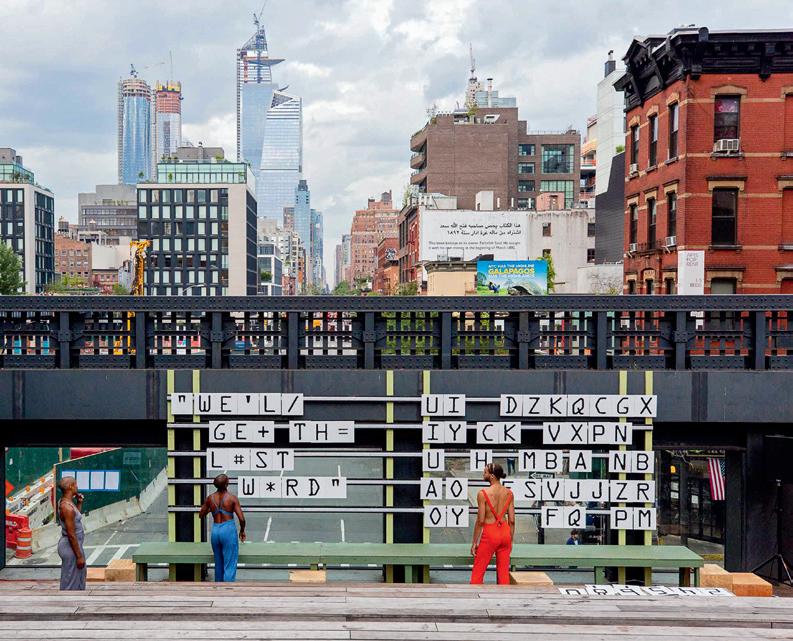
and recognize different accents and stresses, for the collective and interactive formation of words that generate thought.
PELE/ LEPE/ EPLE/ PEL/ PLE/ ELP/ ELE/ EE…
juliana de arruda sampaio translated from Portuguese by philip somervell
Uncle Rebus, 2018 Performance documentation. High Line at 17th Street, New York (2018)
xica manicongo
this document should enable us to imagine a face, but we are presented only with a tomb. it is History that lies in the tomb. the archive of the history of transatlantic slavery is the record of a disappearance. these documents are therefore nothing more than ashes. why choose to preserve the account of a European colonizer, and not the life of a Black star? the answer to this question is irrelevant.
the damage has already been done. we are too late.
what matters, however, is that after more than four hundred years, we don’t even know the name of the man.... but we remember with great fondness the name of Xica Manicongo, a name that is also a fable. Manicongo is a distorted way of saying Mwene Kongo, lord of the Congo; Xica was a way that gender dissidents, especially Black women,
309 308
used to rescue her from a violent naming that the world of slavery had addressed to her: Francisco. thus, Xica Manicongo is a way of fabulating the sonic signature of this creature whose unfathomable beauty we will never know.
Xica was forcibly brought to Salvador at the end of the 16th century. according to reports, a man named..., a man... was reportedly disturbed by Xica’s radically
free gender and sexuality performativity, denouncing her to the Holy Inquisition. Xica defended her refusal, choosing to remain free. finally, to avoid death, she decided to retreat, to deceive the usurpers using her man costumes. would this have been the first record of a Drag King in the history of the invaded territory called Brazil? what can we imagine before these crooked letters arranged on
this moldy paper? a memory. the memory that even oblivion is never absolute. the memory of unpredictability, in which what should have been annihilated resurfaces in another way, in another place: Sertransneja, Coletiva Xica Manicongo, Jaqueline Gomes de Jesus, Bixarte, Xica a peça, Xica Manicongo... the memory of the loud laugh, the serene gingado, the brute force and the indomitable courage of the one we now call Xica Manicongo.
ashes have long been used in Africa and Abya Yala as a component of soil fertilization. there, then, we are summoned to imagine, before this tomb, new wild fruits of the African diaspora in Brazil that erupt and stir a different way of writing to traverse time.
abigail campos leal
translated from Portuguese by mariana nacif mendes
Yto Barrada takes play seriously. For this perpetual learner, play is a powerful educational tool that appeals to the senses as much as to the intellect. For instance, Land and Water Forms (2019), a set of acrylic and gesso works on cardboard, displays a grammar of natural shapes adapted from Montessori molded trays. Conversely, educational play is an ideal framework for artistic experimentation – the joy of making
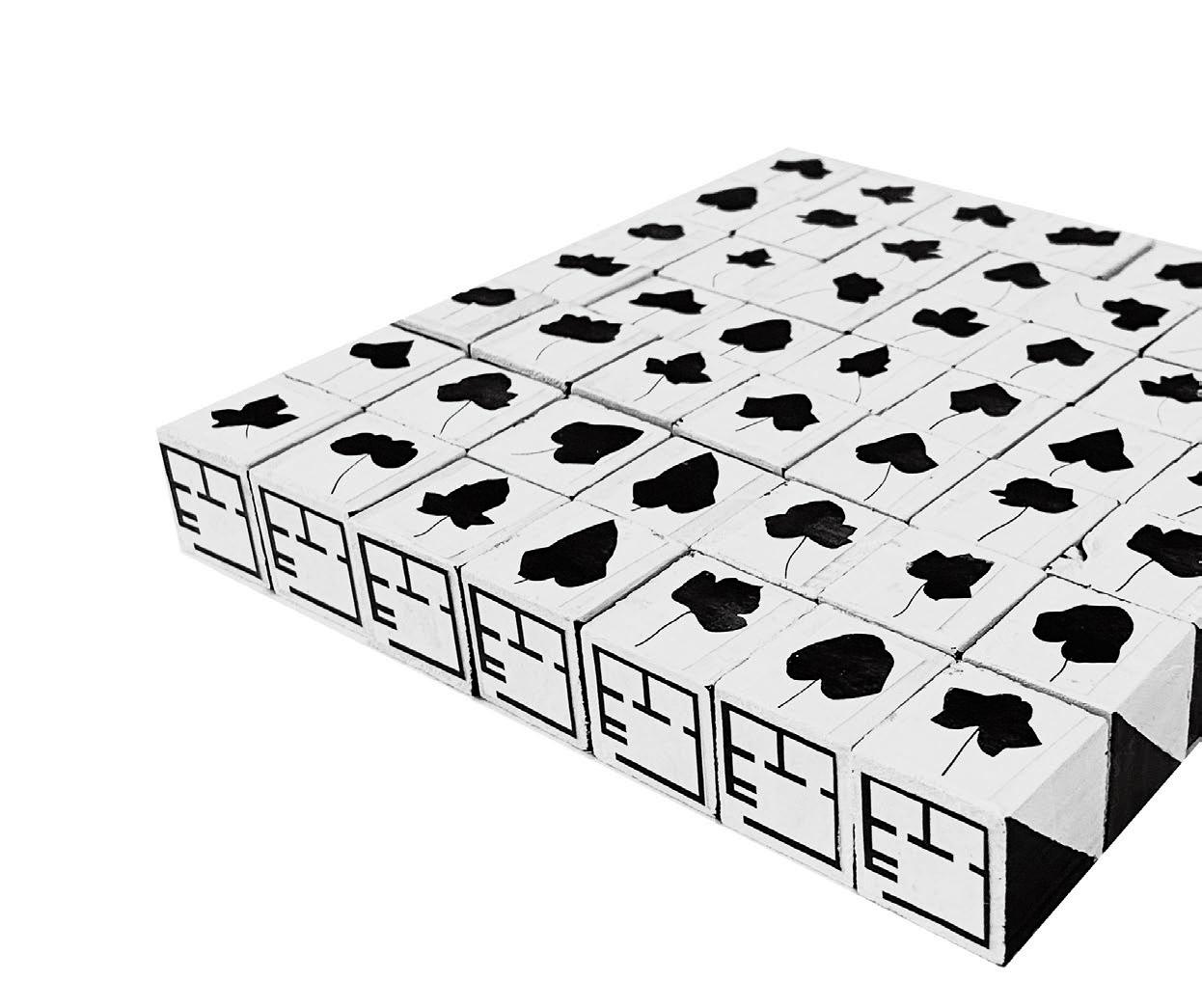
311 310
yto barrada
and breaking rules. The video Tree Identification for Beginners (2017) tells the story of the artist’s mother’s first trip to the USA – and larger stories of the Cold war and civil rights activism – through a captivating and hilarious montage of voice over, Foley sounds, and animated Montessori toys.
A historian by training, Barrada is interested in the myriad ways in which historical events and the
social fabric constitute each other. As an artist, she is constantly on the lookout for forms that might translate the complexity of those relations. Politics pervades her work, but always obliquely, as serious questions are best tackled with humor. See the levity of her posters’ wordplay (“I am not exotic I am exhausted”; “Sheikh Spear is Arab”…) or the satirical text “A Modest Proposal to
Modernize Morocco and Maximize its Resources and Efficiency” (2010), attributed to a fictional character whose name, Yahia Sari, is an Arabic adaptation of Jonathan Swift.
Many real characters have also come to populate her photo and video work over the years. The Sleepers (2006), The Smuggler (2006), and The Magician (2003) are beautiful marginals who find creative ways of resisting the chokehold of neoliberal domination. In addition, some historical characters recur, chief among them is Hubert Lyautey, the first French Resident General in Morocco (1912-1925), a brutal colonizer admired by some for his introduction of modernist urbanism and his (selective) preservation of local craft traditions. Beyond the surface affect, Barrada exposes the figure of Lyautey, playing with his well-known quotes and famous moustache in posters and collages, or offering his name up as a (de)construction game in the various versions of her Lyautey Unit Blocks. Here, as in most of her work, politics and play, seriousness and irreverence go hand in hand.
omar berrada
Model for Untitled (Casablanca Unit Blocks-with Bettina), 2023
Commissioned by Fundação Bienal de São Paulo for the 35th Bienal
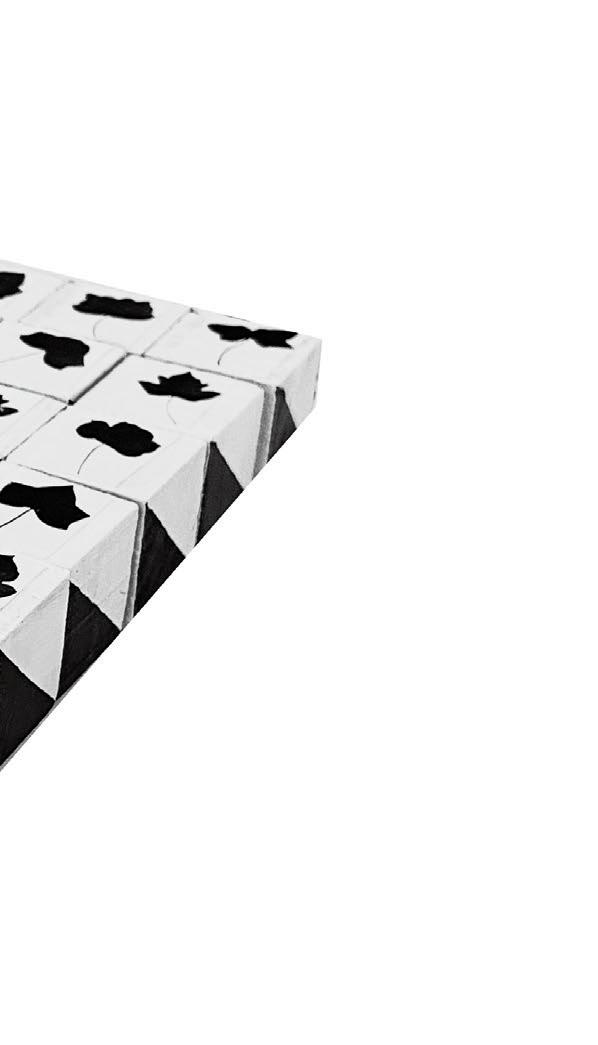
Olodum Carnival Parade, with the theme “The Treasures of Tutankhamun”, Pelourinho square, Salvador, BA, 1993 Digital transfer film photography, 70 × 105 cm
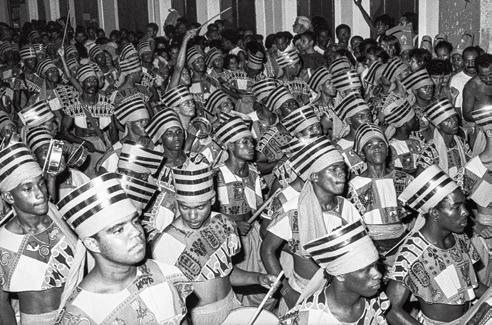
What does it mean to constitute a photographic archive of, through, and for Afro-Brazilian life? Zumví Arquivo Afro Fotográfico [Zumví Afro Photographic Archive] is the closest answer we have. Founded in 1990 by Lázaro Roberto, Ademar Marques, and Raimundo Monteiro, and physically housed between Pelourinho and Fazenda Grande in Salvador, Bahia, Zumví archive houses 30,000 photographs (as

Rosário dos Pretos Sisterhood protest at the Pelourinho Square, during the celebrations of Bahia Independence, in the 2nd of July, 2012 Digital transfer film photography, 80 × 120 cm
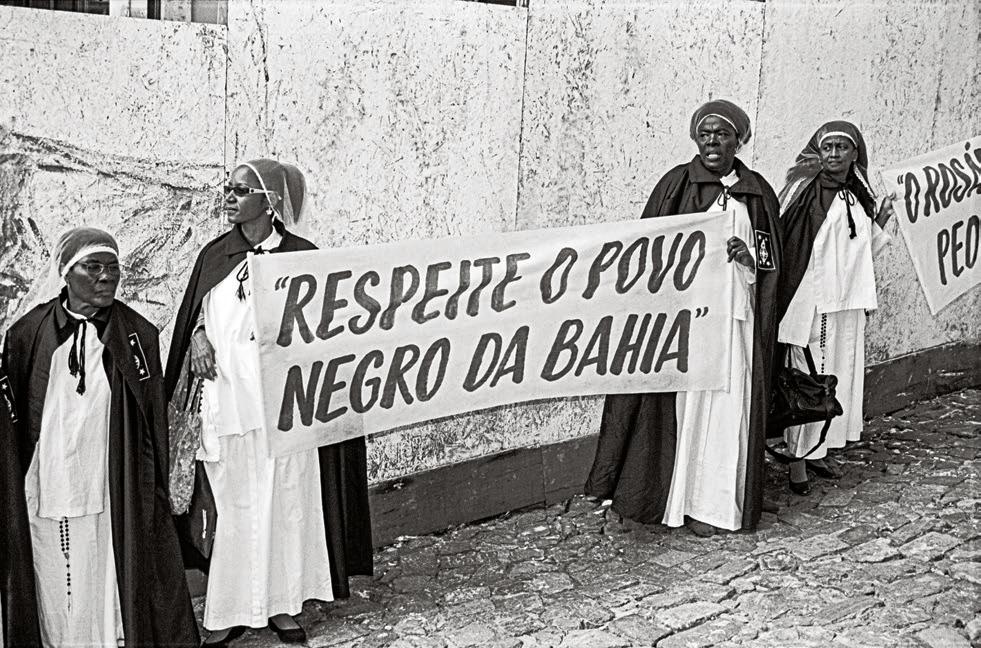
313 312
zumví arquivo afro fotográfico
well as personal documents, posters, postcards, and various documents) spanning three decades. It is a community archive to the core, without institutional support nor bureaucratic bluster. Its vast cache of images aligns sights and routes of protest alongside everyday street scenes – shaping a visual space that reveals precisely how spheres of social and political life unfolded in Bahia during the final decades
of the twentieth century. Engaging various photographic perspectives, these pictures grasp the pain and pride, love and insistent possibility embodied in the condition of Blackness.
As a whole, Zumví Arquivo Afro Fotográfico is an assertion of AfroBrazilian existence and autonomy, articulated through the notion of aquilombamento. Functioning as more than an accretion of represen-
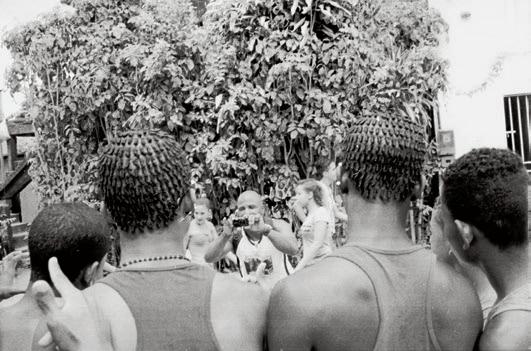
tations, the political clarity of the archive’s purpose is immediately legible in its name: a simultaneous contraction of “zum–vi”1 and an invocation of Zumbi, the leader of Palmares, a monumental community of quilombos that resisted the Portuguese and Dutch for a full century (1595-1695). Through the ongoing efforts of Lázaro Roberto and his nephew José Carlos, Zumvi’s spirit of self-determination integrates the photograph as a site of sociopolitical struggle, a place where movement work can happen. If we take seriously scholar and activist from Sergipe Beatriz Nascimento’s argument that “quilombo is fundamentally a social condition, a place where liberty is practiced, [it is] the acceptance of Black culture,”2 we might then consider this archive as a pictorial extension of this social condition. Zumví is a fugitive passageway made photographic, a place where Black consciousness is cultivated in the fix and expands beyond the frame.
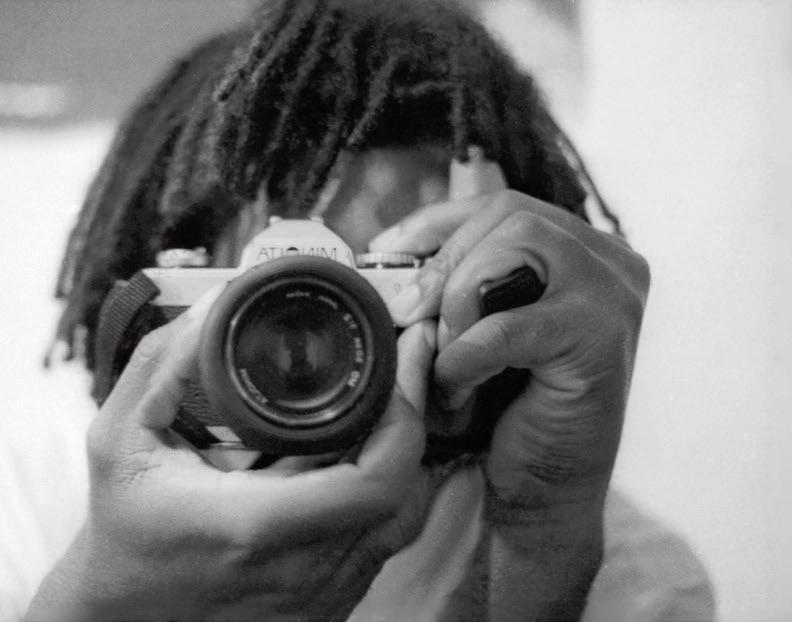
oluremi onabanjo
1/ “Zum” sounds as zoom (of photographic lenses), and “vi” translates as “saw”. [e.n.]
2/ Beatriz Nascimento, “O conceito de quilombola e a resistência afro-brasileira.” Afrodiáspora, n. 6-7, 1985, pp. 41-49.
Photographer Lázaro Roberto self-portrait, 1980 Digital transfer film photography, 50 × 75 cm
Capoeira Circle at the Black Awareness Day, São Bartolomeu Park, Subúrbio Ferroviário neighborhood, Salvador, BA, 2013 Digital transfer film photography, 70 × 105 cm
performances of oralitura: the body as a place of memory leda maria martins
“Between silence and sound drums and shadows laugh. Children created memory before creating hair.”
edimilson de almeida pereira, Nós, os Bianos [We, the Bianos], 1996
“To start from a word. To start with a word. Text, a place of encounter.”
− ruy duarte de carvalho, Hábito da terra [Earth habit], 1988
While observing the beautiful program of this event,1 one notes the repeated use of the signifier “memory,” orchestrated in one of its places of recognition: writing. The present text comes as an invitation to think about memory in another context, in which it is also inscribed, spelt and postulated: the voice and the body, expressed in the spheres of oral performances and ritual practices.2
In Brazil’s written literature, the predominant legacy is that of textual archives and the European narrative tradition. Even the discourses that emerged as founders of Brazil’s literary legacy in the 19th century had as their anchor and basis of literary creation the Occidental literary style and form. The textuality of African and indigenous peoples — their narrative and poetic repertoires, domains of language and ways of apprehending and figuring the real, left on the sidelines — did not reverberate in our written words. This was observed by [Roger] Bastide and reiterated by Risério:
When Europeans began to produce texts in what is now Brazilian territory, the native peoples
1/ Lecture given at the XXXI Semana de Letras — VII International Seminar on Language and Literature promoted jointly by the Literature department and the Graduate Program of the Federal University of Santa Maria (UFSM) in October 2002.
2/ Originally published in Língua e Literatura: Limites e Fronteiras, Santa Maria (RS), n. 26, pp. 61-81, jun. 2003.
had already been producing their own for some time. And just as Europeans transported here a vast and fruitful textual repertoire, Africans, forcibly engaged in the greatest migratory process in the history of mankind, brought their creative verbal forms to the other side of the Atlantic. Thus, in turning first to the history of the creative text in our geographical region, Romanticism was to be confronted, in theory, with the ensembles formed by Amerindian and African texts. In theory. In fact, this is not quite what happened. [...] The African creative text has invariably been sidelined or ignored in our setting. [...] In other words, Black words drifted by in white clouds.3
In this sense, the mastery of writing becomes a metaphor for an almost exclusive idea of the nature of knowledge; centered around the elevation of vision, imprinted in the optical field by the perception of the letter. Memory, inscribed as spelling by the written word, is thus articulated to the field and process of vision mapped by the gaze, apprehended as a window of knowledge. Everything that escapes the apprehension of the gaze — a privileged principle of cognition — or that is not circumscribed in it, is therefore “ex-otic” to us. It is outside our field of perception, distant from our optics of understanding, exiled and alienated from our contemplation, from our knowledge. Indeed, we are fertile in the resources for safeguarding this memory: our books, archives, libraries, monuments, theme parks and, more recently, technological advances, such as increasingly sophisticated hardware and software. Mnemosyne, the muse of memories, is certainly uneasy about this. In the mythical narrative, all knowledge that wants to be reminiscent cannot do without Lesmosyne, forgetfulness — a forgetfulness that is inscribed in every spelling, every trace that, as a signifier, brings in itself the lacunae and erasures of knowledge itself. In this perspective, the Greek graph is much more expansive and
315 314
3/ Antônio Risério, Textos e tribos. Rio de Janeiro: Imago, 1993, pp. 69-70.
inclusive than the secular semantic selections elected by the West would have us believe. The places of memory are not restricted, in the very genealogy of the term, to its aspect of alphabetic inscription, to writing. The term refers us to many other forms and procedures of inscription and spellings, among them to which the body, as a portal of alterities, dionysically refers us.
In the twists and turns of etymologies, let us try another approach. In one of the Bantu languages of the Congo, two verbs derive from the root word ntanga: write and dance. These verbs highlight variant shifting meanings, which refer us to other possible sources for the inscription, safeguarding, transmission and transcreation of knowledge, practices, procedures, anchored in and by the body in performance. But what is performance?
By the various prisms of its conceptual and methodological use, as well as by the scope and perhaps disproportionate amplitude, the term performance, according to Richard Schechner,4 is inclusive. Performance can be approached both as a hand fan and as a net. As a fan it includes — by modal adherence — rites, everyday performances, family scenes, playful activities, theater, dance, processes of artistic making, as well as, among other practices, performances of great magnitude. In the fan, all these practices, with their specific modes and conventions, are arranged as non-hierarchical settings, in a horizontilinear landscape, proceeding as a continuum. When thought of as a net, in a different design and epistemological perspective, this system is organized more dynamically, no longer by the relations of disposition in the continuum, but above all by the interactions processed there.
Schechner’s theory — which embraces and takes as its object both experimental theatrical performances (in the strict sense of theatrical action) and the liturgical ceremonies of predominantly ritualistic cultures — is developed in the very liminality of the relations between theatrical practice and anthropology. Hence its scope, and the unique possibilities it offers us in macroscopic terms,
to think about the spheres of performance theories and the thematic, conceptual and methodological adjunctions that derive from it. In this respect, the term performance can be accommodated in the context of, for example, theater or oral narratives, as it escapes a synonymic collage with the term’s representation and staging, which are also inflated and semantically saturated. All of these practices, however, ostensibly reveal what Schechner calls “deep structures,” which connect them performatically, by modulations or qualities (repetitiveness, provisionality, incompleteness, transience, modes of duration and consignment of space, etc.); by techniques and procedures; by the relations between performers and their audience, real or virtual; by the inclusion or exclusion of pre- and post-performance activities that, in many practices, constitute the performance itself; by their immediate and/or extensive effects in historical, cultural and social terms.
Each of these practices (theater, dance, ritual, sport, play, games, collective enactments, artistic acts, and even emotive pulsive expressions) are subjunctive, liminal modes, performative genres whose conventions, procedures, and processes are not only a means of symbolic expression, but constitute in themselves what institutes the performance itself. In a performance of orality, for example, the gesture is not only a mimetic representation of a possible meaning conveyed by the performance, it institutes and establishes the performance itself. Or rather, the gesture is not simply narrative or descriptive, but performative. Performative practices are not to be confused with ordinary experience. They are always provisional and inaugural, even when they rely on deeply rooted and traditional modes and methods of transmission. They always rely on conventions, styles and spatial and temporal frames, even if slippery (for example, the constitution and designation of space, be it the theater-building, the street, an alley, a public square, a church, an auditorium; or even the modulation of temporal duration in hours, days, years).
To think a poetics of performance would thus require us to consider not only the mode, scope, size and duration of the performance, but also its displacement and “extension across cultural boundaries and its penetration into
4/ Richard Schechner, Performance Theory. Revised and expanded edition. New York and London: Routledge, 1988, pp. xii e xiii.
the deepest strata of historical, personal and neurological human experience.”5
This inclusive way of thinking about performance, both as a contingent quality and as an attribute of certain artistic and cultural practices, as well as a possible system of universals that finds its particular modes and conventions culturally, does not find an easy definition. The term is used by Schechner6 in the sense of restored behavior conditioned/permeated by play or twice-behaved behavior, that is, as a double repetition of an already repeated action, a provisional repetition, which is always subject to revision, always subject to reinvention; a repetition that never offers itself in the same way, even when sustained by the constancy of its transmission.
Exploring the rich archaeology of the term and the relationships between performance and memory, body and knowledge, Joseph Roach proposes thinking about the genealogies of performance through three basic principles: kinesthetic imagination, vortices of behavior (habits) and displaced transmission:
Performance genealogies draw on the idea of expressive movements as mnemonic reserves, including patterned movements made and remembered by bodies, residual movements retained implicitly in images or words (or in the silences between them), and imaginary movements dreamed in minds, not prior to language but constitutive of it, a psychic rehearsal for physical actions drawn from a repertoire that culture provides.7
It is within this broad epistemological spectrum that I am currently developing my research, which focuses on per -
5/ Richard Schechner, 1988, op. cit., p. 283.
6/ Idem, 1988, op. cit., p. 95. See also Richard Schechner, “O que é performance?”, Percevejo. Revista de Teatro, Crítica e Estética, ano 11, n. 12, 2003, p. 34.
7/ Joseph Roach, Cities of the Dead: Circum-Atlantic Performance. New York: Columbia University Press, 1996, p. 26.
formance and ritual scenes, through which I think of the body and the voice as portals for inscribing knowledge of various kinds. My theory is that the body in performance is not only an expression or representation of an action, which symbolically refers us to a meaning, but above all a place for the inscription of knowledge, a knowledge that is written in gesture, movement, choreography; in the solfège of vocality, as well as in the adornments that performatively cover it. In this sense, what is repeated in the body is not only repeated as a habit, but as a technique and procedure for inscribing, recreating, transmitting and revising the memory of knowledge, be it aesthetic, philosophical, metaphysical, scientific, technological, etc. In the context of Afro-Brazilian rituals (and also those of indigenous origin), for example, this conception of performance allows us to grasp the complex plethora of African knowledge and know-how that is restored and reinscribed in the Americas, recreating a diverse gnosis and episteme. In this perspective and sense, as Roach further states, “performances reveal what texts hide.” 8 After all, as Pierre Nora also warns us, 9 the memory of knowledge is not only kept in “places of memory” (lieux de mémoire), libraries, museums, archives, official monuments, theme parks, etc, but it is constantly recreated and transmitted through “environments of memory” (milieux de mémoire), i.e. through oral and bodily repertoires, gestures, habits, whose transmission techniques and procedures are means of creating, passing on, reproducing and preserving knowledge. Ritual performances, ceremonies and festivities, for example, are fertile environments of memory for the vast repertoires of mnemonic reserves, kineshetic actions, patterns, techniques and residual cultural procedures recreated, restituted and expressed in and by the body. Among other things, rites transmit and institute aesthetic, philosophical and metaphysical knowledge, as well as procedures and techniques,
8/ Ibid., p. 61.
9/ Pierre Nora, “Between Memory and History: Les Lieux de memoire”, in Geneviève Fabre e Robert O’Meally (ed.), History and Memory in African-American Culture. New York: Oxford: Oxford University Press,1994.
317 316
whether in their symbolic framework, in their modes of enunciation, or in the apparatuses and conventions that sculpt their performance.
In the context of Afro-Brazilian rituals, the sung and vocalized poetic word resonates as an effect of a pulsional and mimetic language of the body, inscribing the issuing subject, who conveys it, and the receiver, whom it also circumscribes, in a given circuit of expression, potency and power. As murmur, breath, diction and performative event, the spoken and sung word is recorded in the performance of the body, the portal of wisdom. As an index of knowledge, the word is not calcified in a static deposit or archive, but is essentially kinesthetic, dynamic movement, and requires attentive listening, as it refers us to a whole poiesis of the performative memory of sacred songs and sayings in the context of rituals. The study of this textuality highlights the inscription of African memory in Brazil in various domains: in the array of poetic and rhythmic forms and aesthetic and cognitive procedures based on other modulations of creative experience; in the techniques and genres of textual composition; in the methods and processes of safeguarding and transmitting knowledge; in the attributes and instrumental properties of performances, in which the body that dances, vocalizes, performs, writes. Among this formal and procedural repertoire, Antônio Risério highlights the oriki, a Nagô-Yoruba poetic form, as one of the many arts of the word transplanted from Africa:
The oriki is born within the rich fabric of verbal games, of ludi linguae, which are woven into Yoruba daily life. [...] The expansion of a verbal unit is a common phenomenon in the world of texts. Joles speaks of proverbs that expand into long proverbial poems. A similar thing happens between the oriki-name and the oriki-poem, with the attributive name expanding verbally towards the ideal constitution of a signic body clearly perceived and defined as “poetic.” [...] In fact, the expression “oriki” refers to names, epithets, poems. It therefore
covers the spectrum of oral creation on a poetic level from one end to the other.10
In the oriki-poem, for example, Risério observes the expansion of a minimal thematic unit that unfolds and expands, “adding other units that are linked to it by ties of linguistic kinship, or by syntactic affinities”; “the hyperbolic spin of the word”; “broad, coruscating and blunt” images; the unusual metaphors, the chained nomination “of a series of syntagms that, arranged in sequence or juxtaposed, revise a paradigm of excess,” configuring the physiognomy of the recreated object; the technique of linking and the play of decentralized intertextualities, aspects that, in summary, make the oriki an “intertextual phanomelopoeia.”
In the textual landscape of Bantu reminiscence, other poetic forms not only recreate, in the order of enunciations, the memory of African diasporas in Brazil, but also inscribe it, as responsos, in the techniques and performances of many narrative genres, in the lattices of the creative enunciation of the word and the poetic games of language, transcribing the memory of many wisdoms, of other diction and phrasing, of other poetic veins, thus manifest and vibrant in this beautiful song, performed in various vocal and rhythmic timbres, in the rituals of Congados:
Zum, zum zum
In the middle of the sea Zum, zum, zum In the middle of the sea
It is the siren’s song
That makes me sad It seems she knows what is to come
Help me, queen of the sea
Help me, queen of the sea Who rules the earth
Who rules the air
Help me, queen of the sea
10/ Antônio Risério, Oriki orixá. São Paulo: Perspectiva, 1996, p. 35.
Zum, zum zum
In the middle of the sea Zum, zum, zum
In the middle of the sea
It is the siren’s song
And her cries much more In that deep sea Farewell, Minas Gerais.
Help me, queen of the sea… (Song of the Congados Mineiros)
Zum, zum zum
Lá no meio do mar
Zum, zum, zum
Lá no meio do mar
É o canto da sereia
Que me faz entristecer Parece que ela adivinha O que vai acontecer
Ajudai-me, rainha do mar
Ajudai-me, rainha do mar Que manda na terra Que manda no ar
Ajudai-me, rainha do mar
Zum, zum zum
Lá no meio do mar Zum, zum, zum
Lá no meio do mar
É o canto da sereia
E seus prantos muito mais Naquele mar profundo Adeus, minas gerais.
Ajudai-me, rainha do mar... (Cântico dos Congados Mineiros)
Black culture in the Americas has a double face, a double voice, and expresses, in its foundational constitutive modes, the disjunction between what the social system
assumed subjects should say and do and what, through countless practices, they actually said and did. In this operation of asymmetrical balance, displacement, metamorphosis and concealment are some of the basic operating principles and tactics of Afro-American cultural formation, which the study of performative practices reiterates and reveals. In the Americas, African arts, crafts and knowledge took on new and ingenious forms. As stated by Soyinka,11 under adverse conditions, cultural forms transform to ensure their survival. Or as Roach argues:
In the life of a community, the process of surrogation does not begin or end but continues as actual or perceived vacancies occur in the network of relations that constitutes the social fabric. Into the cavities created by loss through death or other forms of departure, I hypothesize, survivors attempt to fit satisfactory alternates.12
Black culture is also, epistemologically, a place of intersections. The Brazilian cultural fabric, for example, derives from the intersection of different cultures and symbolic systems — African, European, indigenous and, more recently, from the Orient. From these processes of transnational, multiethnic and multilingual intersections, varied vernacular formations emerge; some wearing new guises, others mimicking, with subtle differences, old styles. In an attempt to better apprehend the dynamic variety of these processes of transit, interactions and intersections of signs, I use the term crossroads as a theoretical key that allows us to cleave some of the forms and constructs that emerge from it.13 The notion of crossroads, used as a conceptual operator, offers us the possibility of interpreting the systemic and epistemic transit that emerges from intercultural and transcultural processes, in which performative
11/ Wole Soyinka, “Theatre in African Traditional Cultures: Survival Patterns”, in Michael Huxley e Noel Witts (ed.). The Twentieth-Century Performance Reader. London: Routledge, 1996, p. 342.
12/ Joseph Roach, 1996, op. cit., p. 2.
13/ Leda Maria Martins, A cena em sombras. São Paulo: Perspectiva, 1995.
319 318
practices, conceptions and cosmovisions, philosophical and metaphysical principles, various knowledges, etc., are confronted and intersected, not always amicably.
In the Nagô/Yoruba philosophical conception, as well as in the worldview of Bantu cultures, the crossroads is the sacred place of intermediaries between different systems and instances of knowledge. It is often translated by a cosmogram that points to the circular movement of the cosmos and the human spirit that gravitate in the circumference of their intersecting lines.14 In the sphere of the rite, and therefore of performance, the crossroads is a radial place of centering and decentering, intersections and deviations, text and translations, confluences and alterations, influences and divergences, fusions and ruptures, multiplicity and convergence, unity and plurality, origin and dissemination. An operator of languages and discourses, the crossroads, as a third place, is the generator of a diversified production of signs and, therefore, of plural meanings. In this conception of a discursive intersection, the kinesthetic and sliding nature of this enunciative instance and the knowledge instituted therein is also highlighted.15
In the context of the crossroads, the very notion of center is disseminated, as it displaces itself — or rather, is displaced — by improvisation. Just as jazz players retrace secular rhythms, dialectically transcribing them in a dynamic, retrospective and prospective relationship, Black cultures, in their varied modes of assertion, are dialogically founded in relation to the archives and repertoires of African, European and indigenous traditions, in the movements of languages, in rites and in many other performative practices that they establish. In this environment of reminiscences, the Black Congados and Reinados, for example, deserve special attention. In addition to a whole representational apparatus of the sacred that the liturgi-
14/ Cf. Robert Farris Thompson, Flash of the Spirit, African and African: American Art and Philosophy. New York: Vintage Books, 1984; Leda Maria Martins, Afrografias da memória, o reinado do rosário no Jatobá. São Paulo: Belo Horizonte: Perspectiva; Mazza, 1997.
15/ Leda Maria Martins, ibid., pp. 25-6.
cal ceremonies of the Congados restore (already revisited by me in Afrografias da memória: o reinado do rosário no Jatobá),16 one must emphasize in the Congados performances a whole plethora of mnemonic procedures and stylistic techniques by means of which some of the most cherished African philosophical principles are reprocessed and inscribed in the Brazilian ethno-cultural formation, as true vehicles of civilization; among them, the principles of ancestry, that is, of celebration of ancestors and that of an alternate and alternative conception of time.
Congados, or Reinados, is an alternate religious system established at the very crossroads between the Christians religious systems and the African ones, of Bantu origin, through which devotion to certain Catholic saints — Our Lady of the Rosary, Saint Benedict, Saint Iphigenia and Our Lady of Mercy — is processed through African-style ritual performances, in their metaphysical symbolism, conventions, choreography, structure, values, aesthetic conceptions and in the very worldview that establishes them. Performed through a complex symbolic and liturgical structure, the rites include the participation of distinct groups, called guardas, and the installation of a Império negro [Black empire], in the context of which dramatic autos and dances, coronation of kings and queens, embaixadas [embassies] liturgical, ceremonial and scenic acts, create a mythopoetic performance that reinterprets the crossing of Blacks from Africa to the Americas. Travelers’ accounts and other oral and written records map its existence since the 17th century, in Recife, and its spread to other regions of the Brazilian territory, in many cases linked to the Irmandades dos Pretos [Brotherhoods of the Blacks].
In its structure, the festivities of the Congados are rites of affliction and reconnection founded by a cosmogonic narrative that develops through an elaborate symbolic structure; a theater of the sacred, whose festive performance brings us back to the setting of the ritual, conceived by Turner17 as an orchestration of actions, symbolic
16/ Id., ibid.
17/ Victor Turner, From Ritual To Theatre, the Human Seriousness of Play New York: PAJ Publications, 1982, p. 109.
objects and sensory, visual, auditory, kinesthetic, olfactory, gustatory codes, full of music and dance. As such, they carry aesthetic and cognitive value, transcribed by means of strategies of concealment and visibility, procedures and techniques of expression which, kinesthetically and dynamically, modify, amplify and recreate the cultural codes interwoven in the performance and in the sphere of the rite, in whose context everyday reality, however oppressive, is replaced and altered, in the symbolic order and even in the historical-social series.
All ritual acts emerge from a narrative of origin, which narrates the removal of the image of Our Lady of the Rosary from the waters. The summary of one of the versions tells us that in the days of slavery an image of Our Lady of the Rosary appeared in the sea. The enslaved saw the saint in the water, with a crown whose brilliance outshone the sun. They called the landowner and asked him to let them pull the lady out of the water. The farmer did not allow it but ordered them to build a chapel for her and fill it with adornments. After the chapel was built, the sinhô gathered his White peers, pulled the image out of the sea and placed it on an altar. The next day, the chapel was empty, and the saint was floating in the water again. After several failed attempts to keep the deity in the chapel, the White man allowed the slaves to try to retrieve her. The first Blacks to head out to sea were a group of Congo. They adorned themselves in bright colors and, with their lively dances, tried to attract the saint. She found their singing and dancing very beautiful, rose from the waters, but did not follow them. Then, the older Blacks, who were very poor, went into the woods, chopped wood, made three drums from tree trunks, the sacred candombes, and covered them with yam leaves. They gathered the group and, singing and dancing, entered the waters. With their rhythmic, muted drumming, their earthly dance and their hymns of strong African tones, they captivated the saint who sat on one of their drums and accompanied them to the chapel, where everyone, Black and White, sang and danced to celebrate her.
During festivities, this founding myth is recreated and alluded to in processions, statements, songs, dances and fabulations, in a multifaceted narrative, in whose
development the mystical and the mythical interact with other themes and narratives that recreate the story of the crossing of Black Africans and their Brazilian descendants. The protagonists of the event are many, depending on the region and communities. The ritual festivities present a complex structure, including novenas, raising of masts, processions, dramatic dances, banquets, embaixadas, fulfillment of promises, under the baton of the Congo kings. In Minas Gerais, the diversity of guardas18 includes, among others, Congos, Moçambiques, Marujos, Catopés, Vilões and Caboclos. Among these, however, two groups stand out: the Congo and the Moçambique, who arranged for the removal of the saint from the water. Both dress in white pants and shirts. The Congos, meanwhile, in addition to skirts, usually pink or blue, wear flashy helmets decorated with flowers, mirrors and colored ribbons. They move in two sections, in the middle of which stand the masters, the soloists, and perform choreographies of fast, leaping movements, sometimes with a warlike staging and a fast pace. The group of Congos represents the vanguard, the ones who start the processions and clear the way, breaking through barriers with their swords and/or long colored staffs. The terno de Moçambique, which most closely resembles the original sound of the candombes, is generally clad in blue, white or pink skirts over all-white clothing, turbans on their heads, gungas (rattles) on their ankles, carrying larger drums, with more muted, bass sounds. They dance in groups, without any choreographed steps. Their movement is slow and from their drums echoes a vibrant, syncopated rhythm. The moçambiqueiros’ feet never stray far from the ground and their dance, which vibrates throughout the body, is strongly expressed in the curved shoulders, torso and feet. The terno de Moçambique is the guardian of the majesties, which represents the greater spiritual power and the earthly power of the ances-
18/ In the congadeiros’ own lexicon, the term “guarda” or “terno” designates a specific group of dancers with their own vestments, liturgical functions and characteristics. Other variations of the narrative, as well as a more detailed study of the Congados, can be found in my book Afrografias da memória: o reinado do rosário no Jatobá, op. cit.
321 320
tors, which emanate from the sacred drums and guide the community rite. Their songs accentuate, in lyrical and rhythmic enunciation, the slow pulse of their movements and the mysteries of the sacred.
All the versions of the story, in the most varied regions of Brazil, make it possible to underline the common narrative element through which this re-engineering of knowledge and power takes place in the structure of the Black Reinados. There are, basically, in the dramatizations and performances, three elements that insist in the enunciation network and in the construction of its enunciation: 1st) the description of a situation of repression experienced by the Black slave; 2nd) the symbolic reversal of this situation with the removal of the saint from the water, the singing and dancing being governed by the drums; 3rd) the institution of a hierarchy and of another power, the African one, founded by the mythical and mystical framework.
By removing the saint from the water and giving it movement, the Black slave performs an act of appropriation and reconfiguration, inverting, in the diction of the sacred, the positions of power between Whites and Blacks. The sound of the drums, invested with a divine ethos sets song and dance in motion and, in an oracular way, foreshadows a subversion of the social order, slave hierarchies and hegemonic knowledge. This displacement interferes with the syntax of the Catholic text, now pregnant with an alternative language that, like a style and a stylus, is written and pulsates in the conjugation of the sound of drums, singing and dancing, intertwined in the articulation of speech and voice of African timbres. The very foundation of the Catholic mythical text is erased, and African deities are introduced into it like a palimpsest. Thus, the saint of the Rosary also evokes, by displacement, the great African chthonic mothers, ladies of the waters, the earth and the air.
In a perspective that transcends the symbolic-religious context, this act of displacement and repossession induces the possibility of reversibility and transformation of the power relations of the adverse historical-social context. It is therefore increasingly significant that the narratives and performances emphasize the coming together of different African nations and ethnicities, overriding his-
torical ethnic and linguistic differences and rivalries. The collective is therefore superimposed on the singular, as an operator of forms of social and cultural resistance that reactivate, restore and reterritorialize, through emblematic metamorphoses, an alternative knowledge, embodied in the memory of the body and the voice. Both in the enunciation of the mythical narration and in the dramatic performance that scenically represents it, the partial overcoming of ethnic diversities recreates the common ethos and the Black collective act as strategies for replacing and reorganizing the fractures of knowledge. It is thus possible to read between the lines of the fabular enunciation the pendulum gesture: they sing in favor of divinity and celebrate the Black majesties and, simultaneously, sing and dance against the seizure of freedom and against oppression, be it slavery in the past or in the present.
From this gesture emerges the second movement dramatized in the narratives: the establishment of an alternative power structure that reorganizes Black ethnic relations and the strategic positions imbricated therein. The Congo guardas open the processions and clear the paths, like a vanguard warrior force. The Moçambique, chosen as the leader of sacred rites and guardian of the crowns that represent the African nations and the Lady of the Rosary, leads kings and queens. The sound of its drums represents, in a specular relationship engendered by the fable, the most genuinely African voice, the reminiscence of the origin that, iconically, translates the memory of Africa. Lord of the crowns and guardian of mysteries, the Moçambique is the earthly and warlike power that manages the African continuum reorganizing the not always friendly power relations between the Black peoples scattered throughout the Diaspora. Consequently, new hierarchies are established in the parallel structure of spatial relations of the Black Reinados, founding the social microsystem, which operationalize the communication networks and power relations between the Blacks themselves, and between Blacks and Whites.
The myth also reveals a process of substitution in the production of ritual objects and adornments and the re-signification of the geographical and symbolic setting.
Slaves produced their sacred drums from logs, leaves and vines, and used the tear beads and materials available in the American geography in place of opals and other embellishments. It is important to note that in Africa, as well as in African cultures of the Americas, one of the ways in which the body writes is through the use of shells, seeds and other concave objects, in varying sizes and colors, for the making of necklaces, bracelets and other adornments that cover the subject, in addition to other arabesques that adorn their skin and hair. Arranged in a given position and order, the beads, seeds and shells, as well as certain drawings, function as morphemes that form words, words that form sentences and sentences that form texts, making the body’s surface a text, and the subject a sign, interpreter and interpretant, simultaneously. Written in and through the adornments, “the person emerges from these writings, woven of memory and making memory.”19
The entire history of the constitution of the Congados (violently repressed and persecuted from the second half of the 19th century to the mid-20th century), and of Black cultures in general, seems to reveal the primacy of these processes of displacement, substitution and resemanticization, suturing the voids and cavities originated by the losses. The institution of this alternative power, which is still fermenting today in several Black communities, prefigures the strategies of cultural and social resistance that drove the slave revolts, the effective action of the quilombolas and several other Black organizations against the slave system. As the famous saying goes, “the beads of my rosary are artillery shells.” Or as Roach puts it, “texts can obscure what performance tends to reveal: memory challenges history in the making of circum-Atlantic cultures and revises the unwritten epic of their fabulous co-creation.”20
In the mythopoetic narrative — in the songs, gestures, dances and in all the liturgical derivations of the
19/ Mary N. Roberts e Allen F. Roberts, “Body Memory. Part. 1: Defining the Person”, in Mary N. Roberts and Allen F. Roberts (ed.), Memory, Luba Art and the Making of History. New York; Munich: The Museum for African Art; Prestei, 1996, p. 86.
20/ Joseph Roach, 1995, op. cit, p. 61.
ceremonial Reinado — the congadeiro sings and dances the Catholic divinity and, with it, the nanãs of the African waters, Zâmbi, the supreme Bantu God, the ancestors and all the sophisticated African gnosis resulting from an earthly philosophy that recognizes in nature a certain degree of the human, not in an animistic way, but as an expression of a necessary cosmic complementarity, which does not elide the divine breath and matter, in all the forms and elements of cosmic physis
The myth, therefore, configures the rite of passage from a situation of distress, fragmentation and disorder to a new social, political, artistic and philosophical order that reconfigures the cultural corpus subverts the dominator/ dominated relationship and inseminates the Catholic religious fabric with the earthly African theology.
All the memory of this knowledge is instituted in and by the ritual performance of the Congados, through techniques and performative procedures conveyed by the body, in several of its attributes, among them the voice, in a refined aesthetic and artisanal stylization. The universe of cognition expressed in the rituals of the Congados transcends, in the Americas, African artistic styles, ways of living and belonging, a distinct perception and understanding of the cosmos, as well as a singular reflection on the sacred that transcends Western metaphysical languages. Knowledge, therefore, conveyed by the spoken and sung word, and by music, choreographed in dance. According to the philosopher Bunseki Fu-Kiau, Africa is the “dancing continent,” in that music and dance permeate every activity, being a form of inscription and transmission of knowledge and values. Every sound, every gesture, in Africa, has meaning, which leads Robert Farris Thompson to say that “Africa introduces a different history of art — the history of a dancing art.”21
In the context of the Congado performance, for example, in its apparatus — songs, dances, costumes, adornments, ceremonial objects, settings, parades and festivities — and in its philosophical and religious cosmovision, the textual, historical, sensorial, organic and
323 322
21/ Robert Farris Thompson, African Art in Motion: Icon and Act. Los Angeles: University of California Press, 1979, p. xii.
conceptual repertoires of distant Africa are reorganized, the scores of their knowledge and know-how, the alternate body of recreated identities, memories and reminiscences, the corpus, in short, of memory that cleaves and crosses the voids and gaps resulting from diasporas. Rites thus fulfill an exemplary paradigmatic pedagogical function, as a model and index of change and displacement, since, according to Turner, “as a model for, the ritual can anticipate, even generate, change; as a model of, it can inscribe order in the minds, hearts, and will of its participants.”22 This process of intervention in the environment and this potential for formal and conceptual reconfiguration make rituals an effective way of transmitting and reterritorializing a complex plethora of knowledge, among them an instigating conception of chronos, time. In the Brazilian case, rites of African descent, both religious and secular, reterritorialize one of the most important African philosophical and metaphysical conceptions, that of ancestry which
constitutes the essence of a vision that theorists of African cultures call the Africentric worldview. This force causes the living, the dead, the natural and the supernatural, the cosmic and the social elements to interact, forming the links of a single, indissoluble chain of meaning....23
The African ancestral conception includes, in the same phenomenological circuit, divinities, cosmic nature, fauna, flora, physical elements, the dead, the living and those yet to be born, conceived as rings of a necessary complementarity, in a continuous process of transformation and becoming. According to Ngũgĩ wa Thiong’o, in the African cosmology, we who are in the present are all, potentially, mothers and fathers of those who will come after. To revere the ancestors really means to revere life, its continuity and change. We are
22/ Victor Turner, op. cit., p. 82.
the children of those who were here before us, but we are not their identical twins, just as we will not engender beings identical to ourselves. [...] In this way, the past becomes our source of inspiration; the present, an arena for breathing; and the future, our collective aspiration.24
This cosmic and philosophical perception interweaves, in the same circuit of significance, time, ancestry and death. The primacy of ancestral movement, as a source of inspiration, softens the curves of a spiral temporality, in which events, stripped of a linear chronology, are in the process of perpetual transformation. Birth, maturity and death become, therefore, natural contingencies, necessary in the mutational and regenerative dynamics of all vital and existential cycles. In the spirals of time, everything goes, and everything returns. For Bunseki Fu-Kiau,25 in Nicongo societies, experiencing time means inhabiting a curvilinear temporality, conceived as a scroll that simultaneously seals and reveals, rolls up and unrolls the temporal instances that constitute the subject. The Kicongo aphorism, “Ma’kwenda! Ma’kwisa!, what happens now will resume later” tastefully translates the idea that what flows in cyclical motion will remain in motion. This same idea is spelled out in one of the most important African inscriptions, transcribed in various ways in Afro-Brazilian religions, the cosmograms, signs of the cosmos and the continuity of existence, also present in the choreographies of the Congos. In this synchrony, the past can be defined as the place of an accumulative knowledge and experience, which inhabits the present and the future, and is also inhabited by them.
The mediation of ancestors, manifested in the Congados by the power (axé) of the candombes (the sacred
24/ Ngũgĩ Ngugi wa Thlong’o, Writers in Politics: a Re-engagement with Issues of Literature and Society. A revised and enlarged edition. Oxford; Nairobi; Ports Mouth: James Currey; EAEP; Heineman, 1997, p. 139.
25/ K. K. Bunseki Fu-Kiau, “Ntangu-Tandu-Kolo: The Bantu-Kongo Concept of Time”, in Joseph K. Adjaye (ed.), Time in the Black Experience Westport; London: Greenwood Press, 1994, p. 33.
23/ Laura Cavalcante Padilha, Entre voz e letra: o lugar da ancestralidade na ficção angolana do séc. XX. Niterói: EDUFF, 1995, p. 10.
drums), is the master key of the rites and it is from it that comes the power of the spoken word and the bodily gestus, instruments of inscription and retransmission of ancestral legacy. In the ritual performance, the congadeiro simultaneously mirrors the traces marked by ancestors, reifying them, but also distances himself from them, imprinting, as in melodic improvisation, his own tones and style. In the rituals, “each repetition is to some extent original, but at the same time it is never entirely new.”26 This pendular process between tradition and its transmission establishes a curvilinear, reactivating and prospective movement that synchronically integrates, in the moment of the performed act, the present of the past and the future. As a logos in movement from the ancestor to the performer and from the latter to the ancestor and the infans, each ritual performance recreates, restores and revises a phenomenological circle in which pulsates, in the same contemporaneity, the action of a continuous past, synchronized in a present temporality that attracts to itself the past and the future and also spreads itself in them, abolishing not time, but its linear and consecutive conception. Thus, the idea of temporal successivity is obliterated by the reactivation and updating of the action, similar and different, already performed both before and after the instant that restores it, in an event.
In the performative genealogy of the Congados, the spoken word resonates as the effect of a pulsional language of the body, inscribing the issuing subject in a given circuit of expression, potency and power. As murmur, breath, diction and event, the spoken word is spelled in the performance of the body, a place of wisdom. For this reason, the word, the index of knowledge, is not confined to an immobile deposit or archive, but is conceived kinesthetically. As such, the word echoes in the performative reminiscence of the body, resonating as a singing and dancing voice, in a contiguous expressive syntax that fertilizes the kinship between the living, the ancestors and those yet to be born. Dynamic force and principle, the word becomes
language “because it expresses and externalizes a process of synthesis in which all the elements that constitute the subject intervene.”27 That is why it needs music, dance, rhythm, colors, performative gestus and adaptation for its realization. Hence the numinous nature of the voice and the auratic power of the body in Afro-Brazilian religions, resonances of their Africanity. According to Sodré, along with words, along with sound, there must be the concrete presence of a human body, capable of speaking and listening, giving and receiving, in an ever-reversible movement.”28 Thus, “to sing/dance, to enter into the rhythm, is like listening to the beating of one’s own heart — it is to feel life without ceasing to inscribe death in it,”29 the rhythm itself being the movement “of the impulse that leads the body to search for the absence.”30
For the congadeiro, this knowledge is also established spatially. Visited space is a consecrated, reterritorialized site. The processions and walks revisit recognized places, retrace the circles around masts, crosses and churches, travel paths previously cleared by ancestors, and pave new roads. The choreographies of the dances mimic this spiral circularity, both in the movement of the body and in the spatial occupation that the body draws around itself. Through this constitutive evocation, the gesture and voice of ancestry embody the present event, prefiguring the becoming, in a curvilinear genealogical conception, articulated by performance. In this, the choreographic movement occupies the space in unfolded circles, figuring the ex-centric notion of time. In other words: time, in its spiral dynamics, can only be conceived through space or in the spatiality of the gap that the revolving body occupies. Time and space thus become mutually reflected images. This enunciative temporality does not conceive of the present as “the present of the very being that is delimited,
27/ Juana Elbein dos Santos, Os nagô e a morte: Pàde, Àsese e o culto Egum na Bahia, 5. ed. Petrópolis: Vozes, 1988, p. 49.
28/ Muniz Sodré, Samba, o dono do corpo, 2. ed. Rio de Janeiro: Mauad, 1998, p. 67.
29/ Id., ibid., p. 23.
30/ Ibid., p. 68.
325 324
26/ Margaret Thompson Drewal, Yoruba Ritual, Performers, Play, Agency Bloomington; Indianapolis: Indiana University Press, 1992, p. 1.
by internal reference, between what is going to become present and what is no longer present.”31
On the contrary. In the context of the spiral time, the body in performance, in the Congados, is the place of what curvilinearly still and already is, of what could and can become, for being it in the simultaneity of presence and belonging. The event staged in and by the body inscribes the subject and culture in a discontinuous spatiality that engenders a cumulative and accumulative temporality, both compact and fluid. As such, the performance updates the tuning forks of memory, memories slipped into oblivion, braids ringed in improvisation that embroiders African remains, residues and traces into new expressive forms. Thus, the representation theatricalized by ritual performance, in its ingenious craftsmanship, can be read as a supplement that covers the many gaps and voids created by the oceanic and territorial diasporas of Blacks, something that stands in place of something inexorably submerged in the crossings, but perennially transcribed, reincorporated and restored in its otherness, under the sign of reminiscence. A knowledge, a sapience.
These gestures, these inscriptions and performative palimpsests, spelled out by the voice and the body, I have called oralitura, nuancing in the concept of this term the singular cultural inscription that, as a letter (littera) cleaves the enunciation of the subject and its collectivity, also underlining in the term its value of /litura, erasure of language, significant alteration, constitutive of the alterity of subjects, cultures and their symbolic representations.32 The signifier oralitura, as I present it, does not refer us univocally to the repertoire of forms and cultural procedures of the verbal tradition; but, specifically, to what in its performance indicates the presence of a residual, stylistic, mnemonic, culturally constitutive trace, inscribed in the spelling of the body in movement and in vocality. Like a stylus, this kinetic trace inscribes knowledge, values, concepts, worldviews and styles. Oralitura is of the realm of perfor-
31/ Émile Benveniste, Problemas de linguística geral, trad. Eduardo Guimarães et al. São Paulo: Pontes, 1989, v. II, pp. 85-6.
32/ Cf. Leda Maria Martins, 1997, op. cit., p. 21.
mance, its anchor; a spelling, a language, whether drawn in the performative letter of the word or in the movements of the body. As we have already emphasized, in one of the Bantu languages of the Congo, the same verb, tanga, designates the acts of writing and dancing, from whose root the noun ntangu, one of the designations of time, a plurisignificant correlation, insinuating that the memory of knowledge is inscribed, without illusory hierarchies, both in the handwriting on paper and in the body in performance. In this perspective we can think, after all, that there are no agraphic cultures, because not all societies confine their knowledge only in books, archives, museums and libraries, but safeguard, nurture and convey their repertoires in other memory environments, their performative practices.
In Brazilian ritual dances, be they of Bantu or NagôYoruba descent, the concave and convex choreographies that create a space of circumscription of the subject and the cosmos refer us not only to the semantic and symbolic universe of the action re-presented there but constitute in themselves the very action instituted and constituted by the performance of the body. To dance is to perform, to inscribe. Ritual performance is thus an act of inscription. In predominantly oral and gestural cultures, such as African and indigenous ones, for example, the body is, par excellence, the site of memory, the body in performance, the body that is performance. As such this body/corpus not only repeats a habit, but also institutes, interprets and revises the re-enacted act. Hence the importance of emphasizing in the performative traditions their metaconstitutive nature, in which doing does not elide the act of reflection; the content is imbricated in the form, the memory is written on the body, which records, transmits and dynamically modifies it. The body, in these traditions, is therefore not only the extension of a re-presented knowledge, nor the archive of a static crystallization. It is the site of a knowledge in continuous movement of formal recreation, remission and perennial transformations of the cultural corpus. In Afro-Brazilian ritual traditions, harlequinized by their various constitutive symbolic intersections, the body is a body of props: movements, voice, choreography, language properties, costumes, drawings on the skin and hair, adornments and props graph
this body/corpus, stylistically and metonymically as a locus and environment of knowledge and memory. The subjects and their artistic forms that emerge from it are woven of memory; they write history.
The body in performance restores, expresses and, simultaneously, produces this knowledge, written in the memory of the gesture. Performing, in this sense, means inscribing, repeating transcribing, revising and represents “a potentially alternative and contesting form of knowledge.”33 The memory of knowledge is disseminated through countless acts of performance, beyond what is recorded by the alphabetic letter; through bodily performance — movements, gestures, dances, mime, dramatizations, celebratory ceremonies, rituals, etc. — the selective memory of prior knowledge is instituted and maintained in the social and cultural spheres. Thus, in the oralitura of the Congados, the body is a portal that simultaneously inscribes and interprets, signifies and is signified, being projected as continent and content, place, environment and vehicle of memory, “a place of transference, [...] a mirror that contains the gaze of the observer and the object of the gaze, mutually reflecting each other.”34
It is said that, long ago, African enslaved in the Americas drew on the shell of sea turtles and on the plumage of certain birds cosmograms of, their cultures of origin, to communicate to their ancestors, who rested in Africa, their stops in the distant landscapes of the Americas. In the poetic forms that sustain us, in response to the gestures of ancestry, we can echo the Angolan poet Ruy Duarte de Carvalho:
There is no place found with no place lost.
The lines of a place are married together, in the meeting of memory with the matrix.35
33/ Joseph Roach, op. cit., pp. 46-7.
34/ Mary N. Roberts e Allen F. Roberts, op. cit., p. 86.
35/ Ruy Duarte Carvalho, Lavra: poesia reunida 1970-2000. Lisboa: Cotovia, 2005, p. 231.
The Congados testify that, just as there is no total, absolute and eternal reminiscence, forgetting is also of the order of incompleteness. In the genealogies of their performance, the congadeiros irrigate the scrolls of history and give us back a subject who, cleaved by memory, maps, with its harlequined Black body, the many shades of Brazilian culture and American territories. After all, the numinosity of the voice, as alethéa, apparition, and the body, domus of knowledge, confirm to the eye and ear the courses of sounds, of gestures, bringing with them the beings and the spheres in which they are, recreating another arkhé, another axé, mirror of another logos. As the poet Edimilson says:36
Family Place
A river does not divide two banks. What is planted on the sides
is what separates it. ....................
For the devout everything is many things. A ravine of water that surrounds living and dead. ....................
We Bianos have solved the riddle. The pond where we are thinks itself river.
Here and there are parts of eyes in motion. As they are in their difference the same God and Zambiapungo.
Família Lugar
Um rio não divide duas margens. O que se planta nos lados é que o separa.
327 326
36/ Edimilson de Almeida Pereira, op. cit.
Para um devoto tudo é muitas coisas. Uma ravina de águas que envolve vivos e mortos.
Estamos nós, os Bianos, de enigma resolvido. A lagoa onde somos tem ideias de rio.
Aqui e lá são peças dos olhos em movimento. Como são na diferença os mesmos Deus e Zambiapungo.
The Afro-Brazilian textuality and the performances of orality offer us a wide range of possibilities of perception, writing the history and memory of Blacks. This memory of knowledge is also written as vermicelli on the staves of paper and of body. A knowledge that is embroidered by the thin blade of the word or in the delicate gesture. Littera and litura. Engravings of the letter, the body and the voice.
Translated from Portuguese by Mariana Nacif Mendes
references
BENVENISTE, Émile. Problemas de linguística geral Trans. Eduardo Guimarães et al. São Paulo: Pontes, 1989, v. II.
CONNERTON, Paul. How Societies Remember. Cambrigde: Cambridge University Press, 1989.
DREWAL, Margaret Thompson. Yoruba Ritual, Performers, Play, Agency Bloomington; Indianapolis: Indiana University Press, 1992.
FU-KIAU, K. K. Bunseki. “Ntangu-Tandu-Kolo: The Bantu-Kongo Concept of Time” In: Joseph K. Adjaye (ed.). Time in the Black Experience. Westport, CT: Greenwood Press, 1994.
MARTINS, Leda Maria. A cena em sombras. São Paulo: Perspectiva, 1995. . Afrografias da memória: o reinado do rosário no Jatobá. São Paulo: Belo Horizonte: Perspectiva; Mazza, 1997.
NORA, Pierre. “Between Memory and History: Les Lieux de memoire”. In: FABRE, Geneviève; O’MEALLY, Robert (ed.). History and Memory in African: American Culture. New York; Oxford: Oxford University Press,1994.
PADILHA, Laura Cavalcante. Entre voz e letra: o lugar da ancestralidade na ficção angolana do séc. XX. Niterói: EDUFF, 1995.
PEREIRA, Edimilson de Almeida. Nós, os Bianos. Belo Horizonte: Mazza, 1996. RISÉRIO, Antônio. Oriki orixá São Paulo: Perspectiva,1996. . Textos e tribos. Rio de Janeiro: Imago, 1993.
ROACH, Joseph. Culture and Performance in the Circum-Atlantic World. In: PARKER, Andrew; SEDGWICK, Eve (ed.). Performativity and Performance. Nova York; London: Routledge, 1995.
Cities of the Dead: Circum-Atlantic Performance. New York: Columbia University Press, 1996.
ROBERTS, Mary N.; ROBERTS, Allen F. “Body Memory. Part. 1: Deftning the person”. In: ROBERTS, Mary N.; ROBERTS, Allen F. (ed.). Memory, Luba Art and the Making of History New York; Munich: The Museum for African Art; Prestei, 1996.
SANTOS, Juana Elbein dos. Os nagô e a morte: Pàde, Àsese e o culto Egum na Bahia. 5. ed. Petrópolis: Vozes, 1988.
SCHECHNER, Richard. Between Theater and Anthropology Philadelphia: University of Pennsylvania Press, 1985.
. “The Fun and the Web”, in Performance Theory Revised and Expanded Edition. New York; London:,Routledge, 1988.
SODRÉ, Muniz. Samba, o dono do corpo. 2. ed. Rio de Janeiro: Mauad, 1998.
SOYINKA, Wole. “Theatre in African Traditional Cultures: Survival Patterns”. In: HUXLEY, Michael; WITTS, Noel (ed.). The Twentieth-Century Performance Reader. London: Routledge, 1996.
THIONG’O, Ngũgĩ wa. Writers in Politics, a Re-engagement with Issues of Literature and Society. A revised and enlarged edition. Oxford; Nairobi; Ports Mouth: James Currey; EAEP; Heineman, 1997.
THOMPSON, Robert Farris. Flash of the Spirit, African and African: American Art and Philosophy. New York: Vintage Books, 1984.
African Art in Motion: Icon and Act. Los Angeles: University of California Press, 1979.
TURNER, Victor. From Ritual to Theatre, the Human Seriousness of Play. New York: PAJ Publications, 1982.
ZUMTHOR, Paul. A letra e a voz: a “literatura” medieval. Trans. Amálio Pinheiro and Jerusa Pires Ferreira. São Paulo: Companhia das Letras, 1993.
essays and collaborations
diane lima is an independent curator, writer, researcher and a key Black feminist voice in Brazilian contemporary art. In 2021 she was awarded the Ford Foundation Global Fellowship program that celebrates the next generation of social justice leaders around the world. Its trajectory made up of projects that challenge institutional and curatorial practices resulted in the organization of the book Negros na Piscina: contemporary art, curatorship and education (2023) and Textes à lire à voix haute (2022). Other recent projects include the exhibitions Paulo Nazareth: Vuadora (Pivô, São Paulo, 2022); Antônio Obá: Path (Oude Kerk, Amsterdam, 2022) and Frestas – 3rd Sesc-SP Art Triennial – The river is a serpent (Sesc Sorocaba, São Paulo, 2020-21). Master in communication and semiotics from PUC-SP, her lectures and texts have resonated in several institutions and international publications.
grada kilomba is an interdisciplinary artist, writer and holder of a PhD in philosophy from the Free University of Berlin (Germany). She has taught at several international universities, such as the University of Arts in Vienna, Austria. Her work raises questions around knowledge, power and cyclic violence, and has been exhibited at significant events such as the 10th Berlin Biennale; Documenta 14; La Biennale de Lubumbashi VI; and 32nd Bienal de São Paulo; as well as numerous international museums and theaters. Kilomba works across various mediums such as performance, scenic reading, texts, video and installation, focusing on memory, trauma, gender and post-colonialism. Her works feature in public and private collections including Tate Modern (England).
hélio menezes is an anthropologist and internationalist at the Universidade de São Paulo (USP) and an affiliated scholar at the BrazilLab at Princeton University. He was curator of contemporary art at Centro Cultural São Paulo from 2019 to 2021, where he also served as curator of literature between March and October 2019, and international coordinator of the World Social Forum in Belém (2009), Dakar (2011) and Tunis (2013). Some of his most recent works are Carolina Maria de Jesus: A Brazil for Brazilians (ims Paulista), Histórias Afro-Atlânticas (masp and Instituto Tomie Ohtake) and dos brasis (Sesc). In 2021, he was acknowledged by ArtReview as one of the 100 most important people in the contemporary art world.
manuel borja-villel is PhD in art history from the City University of New York and he was director of the Museo Reina Sofía (Spain), responsible for the development and the profound reinterpretation of the museum’s collection. In recent years, Reina Sofía has strengthened its position as a reference for cultural production through the work carried out with an asymmetrical network of institutions that includes, among others, museums, universities and independent institutions. He directed the Fundación Antoni Tàpies (Spain) from its creation in 1990 until 1998, and made the foundation an experimental institution with a program centered on institutional criticism. Already at the head of the Museu d’Art Contemporani de Barcelona from 1998 to 2008, he placed public management at the service of the citizen’s agenda, creating a place of dissent through radical pedagogy, criticism and institutional experimentation. He reflects on these and other themes in his latest book: Campos magnéticos: Escritos de arte y Política (2020).
331 330
essays
denise ferreira da silva is an artist, philosopher, professor, and director of The Social Justice Institute-GRSJ at the University of British Columbia (Canada). Among her works are the films Serpent Rain (2016), 4 Waters: Deep Implicancy (2018), and Soot Breath/Corpus Infinitum (2020), the latter in collaboration with Arjuna Neuman.
gladys tzul tzul, of the Maya K’iche’ people, is a PhD in sociology and author of essays books. She has worked as an expert witness in Guatemalan courts, in defense of imprisoned community members, and in Honduras she presented her gender expertise in the trial for the murder of the environmental activist Berta Cáceres.
hagar kotef is a professor of political theory in the Department of Politics and International Studies of SOAS University of London (UK). She is the author of The Colonizing Self: Or Home and Homelessness in Israel/ Palestine (2020) and Movement and the Ordering of Freedom: On Liberal Governances of Mobility (2015).
ilenia caleo is a performer, activist, and researcher. With a master’s degree in contemporary philosophy, she is a researcher at Università Iuav di Venezia and co-founder of the masters program in gender studies and politics at Università Roma Tre (Italy). Her research focuses on bodies, feminist epistemologies, experimental performing arts, and new cultural institutions.
leda maria martins is a poet, essayist, playwright, and teacher. She published, among others, Afrografias da memória: O reinado do Rosário no Jatobá (2021) and Performances do tempo espiralar: Poéticas do corpo-tela (2021).
rizvana bradley is an assistant professor of film and media at the University of California, Berkeley (USA). Her research and essays on contemporary art, film, and media have been published in several journals and offer a critical examination of the Black body in a range of experimental artistic practices.
tiganá santana is a composer, poet, multi-artist, translator, and researcher, and also professor of arts at the Universidade Federal da Bahia (UFBA) and at the Instituto de Estudos Brasileiros of the Universidade de São Paulo (IEB-USP) (Brazil). He was the first composer in Brazil to present an album with songs in African languages.
collaborations
abigail campos leal moves between art and philosophy to create anti-colonial poetics. She is a professor of the specialization course in Human Sciences and Decolonial Thinking at PUC-SP. She presented performances at the Museu da Imagem e do Som do Ceará and at Itaú Cultural (São Paulo, Brazil), and published, among others, ex/orbitâncias: os caminhos da deserção de gênero (2021).
ana longoni is a writer, curator, researcher, and professor at the Universidad de Buenos Aires (UBA) (Argentina). She studies the intersections between art and politics in Argentina and Latin America from the mid-20th century to present days and is the author of Parir/Partir (2022), among other books.
barbara copque is a professor at the Universidade do Estado do Rio de Janeiro (UERJ) (Brazil), anthropologist-who-photographs, member of the Visual Anthropology Committee of the Brazilian Association of Anthropology and advisor to the Museu Afrodigital Rio de Janeiro. She takes part in the Afrovisualidades group, in the project Mapeando Arte e Cultura Visual Periférica [Mapping Art and Visual Culture in the Outskirts] and has works in the collection of the Museu de Arte do Rio.
beatriz martínez hijazo is a researcher. She holds a master’s degree in contemporary art history and visual culture from the Universidad Complutense de Madrid and was the cocurator of the exhibition Un ato de ver que se despliega –Colección Susana y Ricardo Steinbruch (2022) at the Museo Reina Sofía (Spain).
carles guerra is an artist, writer, and independent researcher. He was the director of La Virreina Centre de la Imatge, chief curator at the Museo de Arte Contemporáneo de Barcelona (MACBA) and, between 2015 and 2020, executive director at Fundació Antoni Tàpies (Spain). He was the curator of the exhibition Francesc Tosquelles: Like a Sewing Machine in a Wheat Field (2022) at the Museo Reina Sofía (Spain).
cíntia guedes is an multidisciplinary artist, researcher, and professor. She has a PhD in communication from the Universidade Federal do Rio de Janeiro (UFRJ), with an emphasis on racial relations and the coloniality of power and the production of subjectivity.
claudinei roberto da silva is a guest curator at the Museu Afro Brasil Emanoel Araujo. He curated the exhibitions Sidney Amaral: O banzo, o amor e a cozinha (2015), at the Museu Afro Brasil Emanoel Araujo, 13ª Bienal Naïfs do Brasil (2016), at Sesc, and 37º Panorama da Arte Brasileira: Sob as cinzas, brasa (2022), at the Museu de Arte Moderna de São Paulo (MAM-SP) (Brazil).
david pérez is a professor of keys of artistic speech at the Universitat Politècnica de València and member of the Centro de Investigación Arte y Entorno, in the same university (Spain). He is also the author of several essays on art, aesthetics, and thought.
déba tacana is a visual artist, researcher, and professor of visual arts at the Universidade Federal do Acre (UFAC) (Brazil). She develops a poetic investigation of the visible and invisible dimensions through matter: ceramic body × Indigenous body × territory-body, in dialogue with transformations of borders and landscapes of wars in Abya Yala. emanuel monteiro is an artist and professor of visual arts at the Universidade Federal do Paraná (UFPR) (Brazil). His research focus on the languages of drawing and painting.
fernanda carvajal is a sociologist and works on the intersections between art, sexuality, and politics. She is currently a researcher at the Consejo Nacional de Investigaciones Científicas y Técnicas (Conicet) (Argentina) and a member of the Red Conceptualismos del Sur (RedCSur).
333 332
getsemaní guevara romero is an art historian, archivist, and curator. She works at Centro de Documentación Arkheia, part of Museo Universitario Arte Contemporáneo MUAC (Mexico). Her research focus on feminisms, memory, and archives.
heitor augusto works on the intersections between film curatorship and programming, research, writing, and teaching in the field of cinema. He works as the head of programming for Instituto Nicho 54 (Brazil).
horrana de kássia santoz is a curator and educator, and conducted the curatorial research for the exhibitions 40 anos do Videobrasil, of the Associação Cultural Videobrasil, and Zonas de sombra, at Pinacoteca de São Bernardo do Campo (Brazil). Since 2007, she has been working in the development of new educational practices in museums and cultural institutions.
igor de albuquerque is an editor, translator, and essayist. He worked as the editor of Revista Barril and today is the editor of Revista Canarana. In 2022 he won the Serrote essay award. He published -13, -38: Amanhã de novo (2019) and is now a PhD candidate in art and philosophy at the Universidade de São Paulo (USP) (Brazil), studying the work of Carlo Michelstaedter.
isabel tejeda is a professor at the Universidad de Murcia (Spain). She has curated more than eighty exhibitions in Spain, Italy, Morocco, France, United Kingdom, Puerto Rico, and Argentina. She specializes in feminisms and modern and contemporary artists.
josé antonio sánchez is the author of Brecht y el expresionismo (1992), Dramaturgias de la imagen (1994), Prácticas de lo real en la escena contemporánea (2007) and Cuerpos ajenos (2017). He is a professor at the Universidad de Castilla-La Mancha (UCLM) and founder of the research group ARTEA (Spain). He has recently worked in exhibitions and public programs of several museums in Spain, México, and Colombia.
juliana de arruda sampaio is an anthropologist and works as a researcher and curatorial assistant. She holds a master’s degree in social anthropology from the Universidade de São Paulo (USP) (Brazil) and her research focus on visual arts, Black feminism, and curatorship.
kaira cabañas is the associate director for Academic Programs and Publications at the Center for Advanced Study in the Visual Arts (The Center) at the National Gallery of Art, Washington, D.C. (USA). She is the author of many books, such as Immanent Vitalities: Meaning and Materiality in Modern and Contemporary Art (2021) and Learning from Madness: Brazilian Modernism and Global Contemporary Art (2018), which will be published in Brazil in 2023.
kênia freitas is a curator and programmer at Cinema do Dragão (Brazil). She has a PhD in communication and culture from the Universidade Federal do Rio de Janeiro (UFRJ) and, as an independent researcher, she focus on afrofuturism, Black cinema, and film curatorship and criticism. She is also a member of FICINE – Itinerant Black Cinema Forum (Brazil).
kike españa is an researcher and activist based in Málaga. He works as the editor of the publishing house Subtextos, and also takes part in the collective bookshop Suburbia and the social and cultural center La Casa Invisible (Spain).
luciana brito is a historian and a professor at the Universidade Federal do Recôncavo da Bahia (UFRB) (Brazil). She is the author of Temores da África: Segurança, legislação e população africana na Bahia oitocentista (Thomas Skidmore award, 2019) and also a columnist at Nexo Jornal
luciane ramos silva is a dance artist, anthropologist, and educator. She has a PhD in performing arts and a master’s degree in anthropology from Universidade Estadual de Campinas (Unicamp) (Brazil), and researches afro-diasporic and African corporeities, articulating the ideas of plurality, transformation, and counter-hegemonic writings. She is also co-editor of the magazine O Menelick 2o Ato
marco baravalle is a researcher, activist, and curator. He is a member of Sale Docks, a collective and self-managed space for visual arts and activism in Venice, and takes part in the Institute of Radical Imagination (IRI). A research fellow at Università Iuav di Venezia (Italy), he is the author of L’autunno caldo del curatore: Arte, neoliberismo, pandemia (2021) and co-editor of Art for UBI (Manifesto) (2022).
maria luiza meneses is an independent curator. She studies art history at the Universidade Federal de São Paulo (Unifesp) and is a member of the collectives Red LEHA, Nacional Trovoa, and Rede Graffiteiras Negras. She carries out the Pinacoteca Digital Mauá project and was the curator of the exhibition Travessias do moderno em Mauá.
mario gooden is a cultural practice architect and director of Mario Gooden Studio: Architecture + Design. His practice involves the cultural landscape and the intersectionality between architecture, race, gender, sexuality, and technology. Gooden is also a professor at the Graduate School of Architecture, Planning and Preservation (GSAPP) of Columbia University, where he is the director of the master of architecture program and co-director of the Global Africa Lab (GAL) (USA). He is the author of Dark Space: Architecture, Representation, Black Identity (2016).
miro spinelli is an artist and researcher. He is a PhD candidate in performance studies at New York University (NYU) (USA) and works in the overlapping between performance, writing, visual arts, and theory. His artistic and intellectual practice is engaged in anti-colonial strategies created through a radical union with things, materials, and the invisible produced in the relations with and between them.
natalia arcos salvo is a curator, researcher, and art theorist. She is a founding member of the Grupo de Investigación en Arte y Política (GIAP), based in Chiapas (Mexico), where she also runs the center for artistic residencies since 2013.
nicole smythe-johnson is a writer and independent curator from Kingston (Jamaica). She is currently a PhD candidate in the Department of Art and Art History at the University of Texas at Austin (USA). She curated If we are here… (2023-2024) at the Visual Arts Center at UT Austin and worked at the 2022 Kingston Biennial and at the exhibition John Dunkley: Neither Day Nor Night (2017-2018), in the Pérez Art Museum Miami.
oluremi onabanjo works as an associate curator in the Department of Photography at the Museum of Modern Art (MoMA) and is a PhD candidate in the Department of Art History and Archeology at Columbia University.
omar berrada is a Moroccan writer and curator whose work focuses on the politics of translation and intergenerational transmission. He is the author the poetry collection Clonal Hum and is currently studying racial dynamics in North Africa.
pérola mathias is a sociologist, researcher of contemporary Brazilian music, and works as a journalist.
philippe cyroulnik was the director of Le Crédac and Le 19, Crac (France). He was curator of solo and group exhibitions and wrote essays on Magdalena Jitrik, Martin Reyna, Ceija Stojka, Alain Clément, Jean-Louis Delbes, Joël Kermarrec, among others.
rafael garcía has been part of the Temporary Exhibitions Department of the Museo Reina Sofía (Spain) since 2003, and was responsible for the coordination and management of more than forty exhibitions, several of them organised with museums such as The Museum of Modern Art, MoMA (USA) and Pinacoteca de São Paulo (Brazil).
335 334
renato menezes is a PhD candidate in art history and theory at the École des Hautes Études en Sciences Sociales (France). He is coeditor of França Antártica: Ensaios interdisciplinares (2020) and currently works as a curator at the Pinacoteca de São Paulo (Brazil).
rocío robles tardío has a PhD in art history and is an assistant professor in the Department of Art History at the Universidad Complutense Madrid. She works as a curator for several institutions (Museo Reina Sofía, Artium Museoa) and is a researcher in national/ international projects, having authored many essays and books such as Dora Maar: código documental para la serie fotográfica “Guernica” de Picasso (2023) and Informe “Guernica”: Sobre el lienzo de Picasso y su imagen (2019).
rossina cazali is an independent curator and researcher. She received the John Guggenheim Fellowship and the Prince Claus Award for her work. She has curated contemporary art exhibitions from Guatemala in museums such as Museo Universitario Arte Contemporáneo (MUAC) (Mexico), Museo de Arte y Diseño Contemporáneo (MADC) (Costa Rica) and Museo Reina Sofía (Spain). She currently heads LABORAL project and is a co-founder of the LAICA project for research and experimentation in contemporary art and design.
sara ramos is a researcher, editor, translator, and poet from Tocantins (Brazil). She has a master’s degree in comparative literature at the Universidade Federal da Integração Latino-Americana (UNILA) (Brazil) and is the author of pequeno manual da fúria (2022).
sol henaro is a curator specializing in memory(s) policies and a member of Red Conceptualismos del Sur (RedCSur) since 2010. She is the curator of the Documental Collection and responsible for the Centro de Documentación Arkheia of the Museo Universitario Arte Contemporáneo (MUAC) (Mexico).
sylvia monasterios is a Venezuelan curator, cultural manager, and translator. She has a master’s degree in art, education, and cultural history, and was the curator of Núcleo de Artes Visuais do Centro Cultural São Paulo and a programmer at Secretaria Municipal de Cultura de São Paulo (Brazil).
tarcisio almeida is an independent curator and researcher. A PhD candidate in Núcleo de Estudos da Cultura Contemporânea at the Universidade Federal de Mato Grosso (UFMT) (Brazil), he has a master’s degree in clinical psychology at the Center for Subjective Studies (PUC-SP) and currently focus his research on artistic experiments and modes of creation based on liberation, freedom, and cognitive justice from the field of visual arts.
tatiana nascimento is an artist and researcher in sexual-dissident Black poetics. She published, among others books, Palavra preta (2021), Lundu (2016), Oriki de amor selvagem (2018) and Leve sua culpa branca pra terapia (2019).
thiago de paula souza is a curator, educator, and researcher. A PhD candidate at HDK-Valand – Academy of Art and Design at the University of Gothenburg (Sweden), he is responsible for co-curating the Nomadic Program 2022/2023 at the Vleeshal Center for Contemporary Art (Netherlands) and is a member of the Nesr Art Foundation artistic committee (Angola).
Every two years, the Ciccillo Matarazzo Pavilion becomes a stage for the most relevant works and themes in the art world at the time. Visitors walking among the paintings, sculptures, drawings, research, installations, and so many other languages in constant transformation, and realized by artists from the most diverse settings, can imagine the effort that goes into each part of the exhibition. The task of orchestrating a show on the scale of the Bienal de São Paulo, and with the degree of excellence that it demands, is only possible thanks to the collective work of professionals from the most varied specializations.
Everything begins with the choice of a curatorial proposal, which is always new, always innovative. From that moment, the preparations begin, only ending when the exhibition closes. The endless meetings and difficult decisions, messages exchanged and contracts needing signing, schedules and their multiple revisions, budget and fundraising, and strengthening ties with public authorities and private initiatives in a network of sponsors, supporters, and partnerships. Everything needs to be negotiated with transparency and designed in a way that respects the conservation of the pavilion itself — a jewel of modern architecture — as well as the environment, according to the institutional guidelines that include mitigating the event’s carbon footprint.
The production team transforms the abstract into concrete: building bridges between the collections, working alongside suppliers of the most varied trades, arranging transport, dealing with programming, and creating the conditions necessary for the works to be included in the exhibition with the utmost care, safety, and creativity. The education team offers formation courses for educators, sets up outreach programs in schools and research centers, produces educational publications, their tools of the trade, and mediates the relationship between the works and visitors interested in creating new connections between their experiences and the art exhibited in the show. The communication team, in turn, delivers news and announces the exhibition contents to a captive and demanding Bienal public while simultaneously inviting people who have never had the chance to see the exhibition up close. It is also down to them to coordinate publications, signpost
the space, and tie together texts and images. In keeping with the financial and administrative health of the event, together, these teams provide the environment needed to host the Bienal.
The installations happen with tight deadlines, and each step in this phase must be studied and measured beforehand. First, the walls are erected and the architecture starts to take shape. The pavilion is overtaken by construction workers, wood, plaster, and iron. Once the building has been prepared, it is time to welcome the artworks and the boxes they are packaged in, which are unpacked so the installers can mount the works with care and precision. In an ocean of details and finishings, the text panels are mounted, the lights turn on, visitor guides take their places, and another Bienal opens its doors.
For the 35th Bienal de São Paulo, the curatorial collective formed of Diane Lima, Grada Kilomba, Hélio Menezes, and Manuel Borja-Villel, selected over a hundred participants who, in incalculable ways, choreographed the impossible. The Fundação Bienal de São Paulo is proud to hold this exhibition and, in its own way, to play a part in this impossible choreography, orchestrated by collective work.
337 336
josé olympio da veiga pereira president – fundação bienal de são paulo
margareth menezes minister of culture of brazil
Sharing the historic mission of the Ministry of Culture of the Federal Government to promote the growth of the cultural field and make it more accessible, in addition to fostering the creative economy, the Bienal de São Paulo now reaches its 35th edition with yet another innovative curatorial project in tune with the most urgent issues of our time. This is a milestone in the history of this event, whose goal has always been to welcome a wide audience and showcase the latest in the art world, while promoting sustainability and human rights, which are essential for strengthening an increasing civic culture.
Since its first edition in 1951, the Bienal de São Paulo has occupied a prestigious place in national culture that goes far beyond its exhibitions. Its consistent continuity over the years has been responsible for forming and training cultural workers in the most varied fields, such as educators, art critics, assemblers, architects, producers, editors, communicators, designers and many other trades, with each project directly and indirectly impacting an extraordinary number of individuals, families and lives. Among the impacts of the exhibition, it is important to highlight the impeccable educational activity of the Bienal. Each of its editions creates the necessary conditions to reach new audiences and foster the critical knowledge of new visitors of all ages. With a permanent education team, the Fundação Bienal de São Paulo develops free courses, facilitation initiatives and training programs for educators and facilitators, in addition to producing educational publications, essential working tools for artistic-pedagogical projects.
In the colorful and multiple framework of the Bienal de São Paulo, opportunities are created to learn more about ourselves, appreciate the diversity of the world and celebrate culture. For the Federal Government, represented here by the Ministry of Culture, there is no national unity without art, and no art without democracy. Let’s celebrate another Bienal de São Paulo. Long live art!
In its 35-year history, Itaú Cultural (IC) has played a fundamental role in supporting art and culture in its most diverse languages and manifestations. This is achieved through research, content production, mapping, incentives, and dissemination, but also through partnerships with agents who are aligned with our values, such as the Fundação Bienal de São Paulo.
Support for the Bienal de São Paulo – an important space of encounter and exchange between artists, curators, critics, and the public – reaffirms IC’s commitment to promoting the visual arts and their transformative role. Within this area, the organization is coordinating various actions, both physical and virtual exhibitions, as well as educational activities.
Among recent exhibitions, Um século de agora [A Century From Now] presented an overview of art and culture currently produced in Brazil, jointly curated by Júlia Rebouças, Luciara Ribeiro, and Naine Terena. Urban art also had its space, with Além das ruas: histórias do graffiti [Beyond the Streets: Graffiti Stories], running until the end of July. On itaucultural.org.br, the public can find the virtual exhibitions Filmes e vídeos de artistas [Films and Videos by Artists], which features audiovisual works of an experimental nature, and Livros de Artista na Coleção Itaú Cultural [Artist Books in the Itaú Cultural Collection], whose immersive and interactive resources allow for a detailed appreciation.
In the area of education, the Entreolhares program offers courses and workshops aimed at developing those who will work professionally in the field of the visual arts. These and other courses are available at Escola Itaú Cultural (escola.itaucultural.org.br). The Enciclopédia Itaú Cultural (enciclopedia.itaucultural.org.br) is an important tool for sharing knowledge, offering access to entries on characters, works, and events in the visual arts.
Instituto Cultural Vale is delighted to be a part of the 35th Bienal de São Paulo – Choreographies of the Impossible, and its educational program, which is exploring new formats and approaches this year.
Given the curatorial proposal to create a “space for experimentation, open to the dances of the unimaginable”, as defined by the curators, we have joined this initiative that connects art and education, expands access to culture and brings students, teachers and families closer to interdisciplinary experiences.
With a joint, horizontal and diverse curatorship, the Bienal – the largest contemporary art exhibition in the Southern Hemisphere – invites us to think of art as an exercise in dialogue, as an opening to new narratives and as a space for learning.
It is, in this regard, also connected to the purpose of the Instituto Cultural Vale: to expand opportunities for learning, reflecting, developing new visions and sharing art, culture and education inside and outside museums throughout Brazil.
339 338 itaú cultural
instituto cultural vale
Bloomberg is proud to sponsor Choreographies of the Impossible, the 35th edition of the Bienal de São Paulo
For more than a decade we have supported the Bienal’s exceptional contemporary art exhibitions in the stunning Ciccillo Matarazzo Pavilion in Ibirapuera Park and around Brazil, through our partnership with Fundação Bienal. This year’s edition continues the tradition of presenting captivating and thought-provoking art installations that are free and open to the public.
Every day, Bloomberg connects influential decision makers to a dynamic network of information, people, and ideas. With more than 19,000 employees in 176 offices, Bloomberg delivers business and financial information, news and insight around the world. Our dedication to innovation and new ideas extends to our longstanding support of arts, which we believe are a valuable way to engage citizens and strengthen communities. Through our funding, we help increase access to culture and empower artists and cultural organizations to reach broader audiences.
Confronted with the incessant problems of humanity, perhaps it is worth dwelling a little longer on some open questions, taking sustenance from resources that allow us to dig and build answers procedurally. In this sense, art, in its many guises, offers fertile ground for critical elaborations about the world and ourselves.
The meeting of art and education — both understood as fields of knowledge — enables the torsion of time and space: it becomes possible, thus, to suspend neutralities and dilate what is precipitated in structures. How far is this approach able to infer the real and interfere in it? It allows us to (re)populate imaginaries, to unpick the universalizing statute attributed to concepts, practices and people, and thus to carve out reality with narratives that articulate the individual and the collective, in a procedural and coherent manner regarding the issues that permeate existence.
It is according to this panorama that Sesc São Paulo and the Fundação Bienal, through the 35th Bienal de São Paulo, reiterate their long-standing partnership, a mutual commitment to fostering experiences of coexistence with the visual arts, expanding access to cultural actions and the exercise of otherness.
This partnership, which has been established and renewed for over a decade, has led to the promotion of projects such as simultaneous exhibitions, public meetings, seminars and training for educators, as well as the consolidated itinerant exhibition with excerpts from the Bienal in Sesc units in the wider state of São Paulo. The confluence of choices and propositions is part of the institutional perspective of culture as a right, and conceives, together with one of the largest exhibitions in the country, an accessible horizon for contemporary art in Brazil.
bloomberg
sesc são paulo
fundação bienal de são paulo
Founder
Francisco Matarazzo Sobrinho · 1898 –1977 chairman e meritus
Governing board
Eduardo Saron · president
Ana Helena Godoy Pereira de Almeida Pires · vice president
Lifetime members
Adolpho Leirner
Beno Suchodolski
Carlos Francisco Bandeira Lins
Cesar Giobbi
Elizabeth Machado
Jens Olesen
Julio Landmann
Marcos Arbaitman
Maria Ignez Corrêa da Costa Barbosa
Pedro Aranha Corrêa do Lago
Pedro Paulo de Sena Madureira
Roberto Muylaert
Rubens José Mattos Cunha Lima
Members
Alberto Emmanuel Whitaker
Alfredo Egydio Setubal
Ana Helena Godoy Pereira de Almeida Pires
Angelo Andrea Matarazzo
Antonio Henrique Cunha Bueno
Beatriz Yunes Guarita
Camila Appel
Carlos Alberto Frederico
Carlos Augusto Calil
Carlos Jereissati
Claudio Thomaz Lobo Sonder
Daniela Montingelli Villela
Danilo Santos de Miranda
Eduardo Saron
Fábio Magalhães
Felippe Crescenti
Flavia Buarque de Almeida
Flávia Cipovicci Berenguer
Flavia Regina de Souza Oliveira
Flávio Moura
Francisco Alambert
Gustavo Ioschpe
Heitor Martins
Helio Seibel
Isay Weinfeld
Jackson Schneider
Joaquim de Arruda Falcão Neto
José Olympio da Veiga Pereira (on leave)
Kelly de Amorim
Ligia Fonseca Ferreira
Lucio Gomes Machado
Luis Terepins
Maguy Etlin
Manoela Queiroz Bacelar
Marcelo Mattos Araujo (on leave)
Miguel Wady Chaia
Neide Helena de Moraes
Octavio Manoel Rodrigues de Barros
Rodrigo Bresser Pereira
Ronaldo Cezar Coelho
Rosiane Pecora
Sérgio Spinelli Silva Jr.
Susana Leirner Steinbruch
Tito Enrique da Silva Neto
Victor Pardini
Audit board
Edna Sousa de Holanda
Flávio Moura
Octavio Manoel Rodrigues de Barros
International Advisory Board
Maguy Etlin · president
Pedro Aranha Corrêa do Lago · vice president
Andrea de Botton Dreesmann and Quinten Dreesmann
Barbara Sobel
Catherine Petitgas
Frances Reynolds
Mariana A. Teixeira de Carvalho
Mélanie Berghmans
Miwa Taguchi-Sugiyama
Paula Macedo Weiss and Daniel Weiss
Sandra Hegedüs
Board of directors
José Olympio da Veiga Pereira · president
Marcelo Mattos Araujo · first vice president
Andrea Pinheiro · second vice-president
Ana Paula Martinez
Daniel Sonder
Francisco J. Pinheiro Guimarães
Luiz Lara
Maria Rita Drummond
341 340
Superintendencies
Antonio Thomaz Lessa Garcia · chief operating officer
Felipe Isola · chief projects officer
Joaquim Millan · chief projects officer
Caroline Carrion · chief communications officer
Executive Superintendency
Giovanna Querido
Marcella Batista
Institutional Relations and Partnerships
Irina Cypel · manager
Deborah Moreira
Laura Caldas
Marjorie Faria
Raquel Silva
Viviane Teixeira
Projects Superintendency
Production
Dorinha Santos · production coordinator
Ariel Rosa Grininger
Bernard Lemos Tjabbes
Camila Cadette Ferreira
Camilla Ayla
Carolina da Costa Angelo
Manoel Borba
Nuno Holanda de Sá do Espírito Santo
Tatiana Oliveira de Farias
Education
Simone Lopes de Lira · production coordinator
Thiago Gil de Oliveira Virava · content coordinator
André Leitão
Danilo Pera
Diana Dobránszky
Giovanna Endrigo
Regiane Ishii
Renato Lopes
Communications Superintendency
Ana Elisa de Carvalho Price · coordinator – design
Adriano Campos
Eduardo Lirani
Felipe de Melo Gomes
Francisco Belle Bresolin
Julia Bolliger Murari
Luciana Araujo Marques
Marina Fonseca
Rafael Falasco
Bienal Archive
Ana Luiza de Oliveira Mattos · manager
Laís Barbudo Carrasco · manager
Amanda Pereira Siqueira
Ana Helena Grizotto Custódio
Anna Beatriz Corrêa Bortoletto
Antonio Paulo Carretta
Daniel Malva Ribeiro
Kleber Costa Timoteo
Marcele Souto Yakabi
Melânie Vargas de Araujo
Pedro Ivo Trasferetti von Ah
Raquel Coelho Moliterno
Sheila Virginia Rocha de Oliveira Castro
Leandro Melo · conservation advisor
Aila Passeto Castro de Sousa · intern
Fernanda Lustosa · intern
Júlia Maia Lisboa · intern
Julia Schettini Alves · intern
Milena Ondichiatti Bessan · intern
Financial and administrative
Finances
Amarildo Firmino Gomes · manager
Edson Pereira de Carvalho
Fábio Kato
Silvia Andrade Simões Branco
Materials and property
Valdomiro Rodrigues da Silva Neto · manager
Larissa Di Ciero Ferradas · coordinator
Angélica de Oliveira Divino
Daniel Pereira
Victor Senciel
Vinícius Robson da Silva Araújo
Wagner Pereira de Andrade
Planning and operations
Rone Amabile
Vera Lucia Kogan
Human resources
Higor Tocchio
Juarez Fonseca dos Reis Junior
Matheus Andrade Sartori
Information technology
Ricardo Bellucci
Jhones Alves do Nascimento
Matheus Lourenço
Team
35th Bienal de São Paulo –choreographies of the impossible
Curatorship
Diane Lima
Grada Kilomba
Hélio Menezes
Manuel Borja-Villel
Sylvia Monasterios · curatorial assistance
Tarcisio Almeida · curatorial assistance
Matilde Outeiro · curatorial assistance 2022
Curatorial Council
Omar Berrada
Sandra Benites
Sol Henaro
Thomas Jean Lax
Architecture and Exhibition Design
Vão – Authorship
Anna Juni
Enk te Winkel
Gustavo Delonero
Team
Luiza Souza
Gabriela Rochitte
Luisa Barone
Visual Identity
Nontsikelelo Mutiti
Accessibility Consulting
Mais Diferenças
Acoustic Consulting
João Miguel Torres Galindo
Advertising Agency
DOJO
Advisor for Public Program
Dora Silveira Corrêa
Ambulance and Medical Station
Premium Serviços Médicos Ltda.
Assembly
Gala Art Installation
Audiovisual
Maxi
Mit Arte · AV advisory
AV content and photographic documentation
Bruno Fernandes
Danilo Komniski
Freddy Leal
Leo Eloy
Levi Fanan
Carriers
Alves Tegam
Millenium
Cleaning
MF Produção e Eventos e Serviços Ltda.
Conservation
Alice Gontijo
Camila Marchiori
Carolina Lewandowski
Daniel Mussi
Luanda Andrade
Patrícia Reis
Pollynne Santana
Design
Tamara Lichtenstein · design assistance
Editorial
Cristina Fino · editorial coordination
Igor de Albuquerque · research and content
Mariana Leme · editorial assistance
Pérola Mathias · research and content
Education
Bruna de Jesus Silva · advisory
Tailicie Paloma Paranhos do Nascimento · advisory
Guilherme Batista Leite · auxiliary
Maria Eduarda Sacramento de Sousa · auxiliary
Education · internship
Amira Rodrigues Varteresian
Ana Beatriz de Andrade
Cangussu Lima
Ana Beatriz Nascimento Pazetto
Beatriz Soares Rodrigues
Beatriz Teles
Bruno Felipe Tavares Corrêa
Caroline de Alencar Goncalves
Eduardo André
Gal Rodrigues
Gladys UJU Balbino Agbanusi
Gustavo Albanese Pose Ribeiro da Fonseca
Hellen Nicolau
Henrique Camargo Vidigal
Larissa Morales
Maria Giovana de Lira Pereira
Marina Akemi Fukumoto
Rafael Santos Silva
Rafael Tae Hyun Kim
Tuca Palhares de Macedo
Education · mediation
Ana Krein
Anali Dupré
Andre Pereira de Almeida
Ânella Fyama de Sousa Barbosa
Bruno Costa dos Santos
Caio de Sousa Feitosa
Camila Aparecida Padilha Gomes
Caroline Luz
Cristina Alejandra Mena Bastidas
Dandara Kuntê
Dani Silva
Dilma Ângela da Silva
Fauston Henrique Della Flora
Zandona
Gabri Gregório Floriano
Giuliana Takahira
Iberê Terra de Souza Oliveira
Jacob Alves Bezerra Junior
Janaina Eleuterio
Jhow Carvalho
Júlia Iwanaga
Kennedy Maciel da Silva
Leonel Vicente Mendes
Lia Cazumi Yokoyama Emi
Lua
Luis Carlos Batista
Luiz Fernando Dias Diogo
Malu Bandeira
Maria Trindade
Mario Tadeo Urzagaste Galarza
Mira Lima
Mohamed de Azambuja de Ávila
Natália Dias da Mota Santos
Nivea Matias Silva
Pietra de Ofa Cunha Serra
Rafaella Canuto
342
343
Ricarda Wapichana
Roberta Uiop
Rose Mara Kielela
Selva Campos
Sonia Cristina Guirado Cardoso
Stephanie Oliveira da Silva
Tui Xavier Isnard
Vinícius Quintas Massimino
Yurungai
Electrical Distribution
AGR Elétrica Ltda.
Exhibition Management
Danilo Lorena Garcia
Sergio Faria Lima · assistance
External Area Development
Movediça + Junta · Architecture
Sagaz Esportes · Production
Firefighter
Local Serviços Especializados Ltda. – ME
Insurance
Geco corretora de seguros
Chubb
Liberty
International Guest Relations
Janaina Fainer
Internet wi-fi
ITS Online
Light Design
Fernanda Carvalho
Emília Ramos
Luana Alves
Cristina Souto
Press Office
Index · National Press Office
Sutton PR · International Press Office
Scenography
Cinestand
Metro Cenografia
Security
Prevenção Vigilância e Segurança Ltda.
Transportation Logistics
Luiz Santório · International
Nilson Lopes · National
Website
Namibia Chroma and Fluxo
acknowledgements
Cleusa Garfinkel
Dalton Paula
Dandara Queiroz
Daniel Rangel
Daniella Conceição Mattos Araújo
Danielle Freire
David de Jesus Nascimento
Djamila Ribeiro
Douglas Rodrigues
Eduardo F. Costantini
Eduardo Guzman Cordero
Elielton Ribeiro
Elisa Salazar y Jaime Soubrie
Emilio Payán
Emily Epelbaum-Bush
Eskil Lam
individual
Adele Nelson
Agar Ledo
Alba Sagols
Alberto Cruz
Alice Olausson
Alicia Pinteño
Aline Torres
Almudena Díez García
Amanda Carneiro
Ana Carolina Ralston
Ana Hikari
Ana Longoni
Ana Roman
Ana Tomé
Andrea Meneghelli
Anielle Franco
Annabelle Birchenough
Annouchka de Andrade
Antoine Frerot
Aquiles Coelho Silva
Astrid Fontenelle
Audrey Hörmann
Augusto Luitgards
Barbara Alves
Beatriz Martínez Hijazo
Benedita Aparecida da Silva
Betty Rudman
Bruce Brouwn
Bruno Duarte
Camila and Francisco Horta
Calixto Neto
Carina Kurta
Carla Guagliardi
Carlos Vogt
Carmen Accaputo
Carmen Silva
Carmo Jonhson
Carolina González
Caroline Bourgeois
Caroline Thompson & Jean-Pierre Weill
Cecilia Sicupira
Cécile Zoonens
Chantal Wong
Charlene Vollenhoven
Charles Esche
Chema González
Christophe Cherix
Chia Lee
Cintia Delgado
Claudia Marchetti
Facundo Guerra
Fernanda Simon
Florencia Malbran
Francis Djiwornu
Françoise Vergès
Gabril Planella
Gabriel Calparsoro
Garry Trudeau
Geni Núñez
Geraldo Sena
Gilson Rodrigues
Gustavo and Cristina Penna
Hacco de Ridder
Henda Ducados
Henilton Parente de Menezes
Henry Jackman
Hilde Koch-Ockier & Rudy Koch-Ockier
Holly Bynoe
Igi Ayedun
Irene Larraza Aizpurua
Iris Fabre
Isaac Rudman
Isaac Silva
Isabel de Naverán
Isabel Izquierdo
Janaron Uhãy Pataxó
Jardis Volpe
Javier Mora
João Fernandes
João Paulo Quintella
Johanna Stein
Jorge Fernández
José Andrés Torres Mora
José Antonio Sánchez
José Carlos Ferreira
José Paulo Agrello
Juan Manuel Casado
Julia Borja
Juliana de Arruda Sampaio
Julie Ludwig
Justo Navarro
Kananda Eller
Kathleen Fuld
Kevin David
Kim Dang
Laís Franklin
Léa Chikhani
Leon Macedo Weiss
Letícia Velozo
Lluís Alexandre Casanovas
Lorraine Leu
Lourdes Fernández
Luanda Vieira
Luciano Zubillaga
Lucimery Ribeiro
Luísa Matsushita
Luiza Adas
Mabel Tapia
Mami Kataoka
Manuel B. Burbano
Manuela Gómez
Mara e Marcio Fainziliber
Marcelo Expósito
Márcia e Marcus Martins
Marco Antonio Nakata
Marco Túlio e Vanessa Gomes
Margareth Menezes
Margherita Belcredi
Mari Stokler
María Amalia García
María Amalia León de Jorge
Maria Aparecida Weiss
Maria Carolina Casati
Maria Elena Ortiz
Maria Lucia Veríssimo
Maria Luisa Marinho
Maria Luiza Meneses
Maria Prata
Marie-Ann Yemsi
Marie-Christine Dunham Pratt
Mario Cader-Frech
Marjolaine Calipel
Marta Rincón
Max Levai
Mercedes Vilardell
Mel Duarte
Michelle Louise
Miguel López
Mira Bernabeu
Monique du Plessis
Naine Terena
Natalia Delgado
Nesrine Miloudi
Nicola Liucci-Goutinkov Pompidou
Nicola Wohlfarth
Noëlig Le Roux
O'Neil Lawrence
Pamela Joyner
Patrice Pauc
Paula Alves de Souza
Paulo Borges
Paulo Petrarca
Philip Berg
Philippe Gellman
Rachel Maia
Rafael García Horrillo
Rania Moussa Morin
Raphaële Bianchi
Regina Casé
Regina Pereira
Renan Quinalha
Ricardo Resende
Rita Carreira
Rodrigo Toledo
Roger Buergel
Roland Groenenboom
Rolando Ignacio Bulacios
Rongomai Kapiri-Marama
Rosario Peiró
Ruli Moretti
Ryan Lynch
Sabina Sabolovic
Sabrina Fidalgo
Saidiya Hartman
Sam Krack
Sandra Birmaher
345 344
Santiago Herrero Amigo
Sasha-Kay Nicole
Sepake Angiama
Simone Leigh
Soledad Liaño
Sônia Guajajara
Sonia Sassi
Stefano Carta
Stephanie Ribeiro
Stuart Bernstein
Sueli Carneiro
Suely Rolnik
Teresa Carvalho
Teresa Velázquez
Thai de Melo
Thais Blucher
Thiago Baron
Tony Webster
Valeria Intrieri
Vasif Kortoun
Victoria Fernández-Layos
Vivi Villanova
Yann Mazéas
Yina Jiménez Suriel
Yolanda Romero
Yvette Mutumba
Zoe B. Martínez
institutions
1 Mira Madrid
A Gentil Carioca
Acervo Centro Cultural São Paulo
Agência Nacional do Cinema – Ancine
Agência Solano Trindade
Alexandra Mollof Fine Art
Arario Gallery
Archivo y Biblioteca Nacionales de Bolivia
Arsenal – Institut für Film und Videokunst
Arte1
ARTINGENIUM
Aruac Filmes
Banco de España
Banco Itaú S.A
Band
Benson Latin American Collection, LLILAS
Benson Latin American Studies and Collections, The University of Texas at Austin
Brooklyn Museum
Catriona Jeffries
CBN
Ceija Stojka International Fund
Central Galeria
Centre Pompidou – Musée national d’art moderne
Centro de Documentação Cultural
“Alexandre Eulalio"
Centro de Documentación Arkheia, MUAC (DiGAV, UNAM)
Centro de Educação Tecnológica Centro
Paula Souza, Governo do Estado de São Paulo
Cineteca di Bologna
CNN
Colección Art Situacions
Colección Carla Barbero
Colección Mariano Yera Areyhold
Colección Patricio Supervielle
Collection Antoine de Galbert, Paris
Collection Prignitz, Berlin
Conselho de Defesa do Patrimônio Histórico, Arqueológico, Artístico e Turístico do Estado de São Paulo –Condephaat
Conselho Municipal de Preservação do Patrimônio Histórico, Cultural e Ambiental da Cidade de São Paulo –Conpresp
Consulado General y Centro de Promoción de la República Argentina en San Pablo Consulado Geral da Bolívia em São Paulo
Consulado Geral da França em São Paulo
Consulado Geral da República Dominicana em São Paulo
Consulado Geral da República Federal da Alemanha em São Paulo
Consulado Geral do Reino dos Países Baixos em São Paulo
Contemporary & Creative Growth Art Center
Cultura
E. Righi Collection
Edições Globo Condé Nast
Editora Abril
Embaixada da Bolívia no Brasil Embaixada do Brasil em La Paz
Ensatt
Escola Superior de Propaganda e Marketing
Estadão
Etxepare Basque Institute
Fábricas de Cultura
Folha de São Paulo
Fonds Kervahut / Collection Laurent Fiévet
Fundação Nacional de Artes – Funarte
Fundação Roberto Marinho
Fundación Cultural Banco Central de Bolivia
Fundación Kutxa
Fundación Mapfre
Galeria Simões Assis
Galerie Christophe Gaillard
Galerie Imane Farès
Globo
Governo do Estado Plurinacional da Bolivia
Hutukara Associação Yanomami
Imec
Infoglobo
Instituto Arte na Escola
Instituto Brasileiro de Museus – Ibram
Instituto do Patrimonio Histórico e Artístico Nacional – Iphan
Instituto Guimarães Rosa
Instituto Inhotim
Instituto Prebisteriano Mackenzie
Jan Mot
JCDecaux
Joven Pan
Konrad Fischer Galerie
Kunstinstituut Melly
KW Contemporary Art
Light Cone (Paris)
LUMA Arles
Malba – Museo de Arte Latinoamericano de Buenos Aires
Marcelle Alix, Paris
Marcus Meier Collection
Mario Cader Collection
Matthew Marks Gallery
Meio e Mensagem
Mendes Wood DM
Michel Rein Brussels
Ministério da Cultura
Ministério da Educação
Ministério da Igualdade Racial
Ministério das Relações Exteriores
Ministerio de Culturas, Descolonización y Despatriarcalización de Bolivia
Ministerio de las Culturas, las Artes y el Patrimonio – Gobierno de Chile
Ministerio de Relaciones Exteriores de Bolivia
Ministério do Meio Ambiente
Ministério do Turismo
Ministério dos Direitos Humanos e da Cidadania
Ministério dos Povos Indígenas
Mitre Galeria
MO.CO. Esba
Museo de Teruel
Museo del Estanquillo
Museo Nacional Centro de Arte Reina Sofía
Museo Nacional de la Estampa
Museu Afro Brasil
Museu Amazônico – Universidade Federal do Amazonas (UFAM)
Museu Bispo do Rosário Arte Contemporânea – Coleção PCRJ
Museu de Arte do Rio de Janeiro – MAR
Museu de Arte Osório Cesar
National Center for Art Research, Japan
New Local Space – NLS
P·P·O·W
Peter Freeman, Inc.
Pinacoteca do Estado de São Paulo
Pinault Colletion
Practicing Refusal Collective
R/E Collection
Record
Rede TV
Samdani Art Foundation
Santu Mofokeng Foundation
Scott Mueller Collection
Secretaria de Economia Criativa e Fomento Cultural do Governo Federal
Secretaria de Formação, Livro e Leitura do Governo Federal
Secretaria Especial de Cultura do Governo Federal
Secretaria Estadual de Educação de São Paulo
Secretaria Municipal de Educação de São Paulo
Sertão Negro Ateliê e Escola de Artes
Sharjah Art Foundation
Sprüth Magers Gallery
Terremoto
The Charles White Archives
The Elizabeth Catlett Mora Family Living Trust
The Gloria E. Anzaldúa Literary Trust
The Museum of Fine Arts, Houston
Tumurun Museum Collection
Van Abbemuseum
Villa Arson
master sponsorship
sponsorship
international support
media support
support official agency
cultural
partnership
realization
image credits
aida harika yanomami, edmar tokorino yanomami and roseane yariana yanomami [left]
Photo: Roseane Yariana Yanomami [all images] Courtesy: Aruac Filmes
amador e jr. segurança patrimonial ltda.
[right] Photo: Mônica Coster
amos gitaï
Collection: Museo Nacional Centro de Arte Reina Sofía, Madri
Gift: Amos Gitaï, 2015
Photo: Archivo Fotográfico Museo Nacional Centro de Arte Reina Sofía
anna boghiguian
Collection: E. Righi
anne-marie schneider
[left] Photo: Vincent Everarts [all images] Courtesy of the artist and Michel Rein, Paris/Brussels
archivo de la memoria trans (amt)
Collection: Archivo de la Memoria Trans
arthur bispo do rosário
Photo: Hugo Denizart
Courtesy: PCRJ/SMS/IMAS-JM/ Museu Bispo do Rosário Arte Contemporânea
aurora cursino dos santos
Collection: Museu de Arte Osório
Cesar, Franco da Rocha
Photo: Everton Ballardin / Fundação
Bienal de São Paulo
ayrson heráclito and tiganá santana
Photo: Leo Monteiro / Fundação Bienal de São Paulo
bouchra ouizguen
© Compagnie O; Production Association Rokya / Association Originale; Co-production MuCEM / Festival de Marseille
carmézia emiliano
Photo: Abreu Mubarac
Courtesy: Central Galeria, São Paulo
castiel vitorino brasileiro
Photo of Untitled (Marrakesh): Rodrigo Jesus
ceija stojka [left – right]
Pinault Collection, Paris. Photo: Rebecca Fanuele
Photo: Rebecca Fanuele. Courtesy: Galerie Christophe Gaillard, Paris
Collection: Marcus Meier
Photo: Rebecca Fanuele. Courtesy: Galerie Christophe Gaillard, Paris
Collection: Antoine de Galbert, Paris
Photo: Diego Cestellano Cano
citra sasmita
Photo: Yeo Workshop
colectivo ayllu
[right] Edition of 10 copies, produced in collaboration with Australian Print Workshop
Collection: Museo Reina Sofía e CA2M, Madrid
cozinha ocupação 9 de julho – mstc
Photo: Edouard Fraipont
daniel lie
Commissioned by Berlin Atonal
Photo: Savannah van der Niet
Studio Dan Lie project manager: Ruli Moretti
daniel lind-ramos
Photo: Field Studios Photography
Courtesy of the artist and The Ranch, Montauk
dayanita singh
© Dayanita Singh
Courtesy of the artist and Frith Street Gallery, London
deborah anzinger
Photo: Constance Mensh
denilson baniwa
Photo: Jamille Pinheiro
denise ferreira da silva
Photo: Alex Woodward
diego araúja and laís machado Commissioned and co-produced by Sesc São Paulo and SAVVY
Contemporary
349 348
duane linklater
Courtesy of the artist and Art Gallery of Hamilton
edgar calel
Photo: Julio Calel
Courtesy of the artist and Proyectos Ultravioleta
elda cerrato
Collection: Archivo Elda Cerrato (ECET)
Photo: Luciano Zubillaga
elena asins
Collection: Museo Nacional Centro de Arte Reina Sofía, Madrid
Gift of the artist, 2012
Photo: Archivo Fotográfico Museo Nacional Centro de Arte Reina Sofía
ellen gallagher and edgar cleijne
Collection of the artists
Choreography/performance: Harry Alexander, Julie Cunningham, Werner Hirsch, Nach, Joy Alpuerto Ritter and Aaliyah Tanisha
Courtesy: Ellen de Bruijne Projects, Amsterdam, and Marcelle Alix, Paris
emanoel araujo
Courtesy: Simões de Assis, São Paulo / Curitiba
eustáquio neves
[left] Collection: Museu Afro Brasil, São Paulo, and collection of the artist [right] Collecton: Ivory Press, London, and collection of the artist
francisco toledo
Collection: “Visualidades y Movilización Social”, Centro de Documentación Arkheia, Museo Universitario Arte Contemporáneo, MUAC (DiGAV-UNAM), Mexico City
Gift: Amigos del Instituto de Artes Gráficas Oaxaca, IAGO [installation view] Photo: Oliver Santana
gabriel gentil tukano
Collection: Museu Amazônico - UFAM, Manaus
george herriman [all images] Collection: Garry Trudeau, New York
gloria anzaldúa
Collection: The Nettie Lee Benson Latin American Collection
Courtesy: The Gloria E. Anzaldúa Literary Trust & Benson Latin American Collection, LLILAS Benson Latin American Studies and Collections, The University of Texas at Austin
guadalupe maravilla
Photo: Maxwell Runko
Courtesy: Guadalupe Maravilla and P·P·O·W, New York
igshaan adams [left]
Photo: Annik Wetter
Courtesy of the artist and Kunsthalle Zürich, © Igshaan Adams [right above]
Private collection
Photo: Kyle Morland
Courtesy of the artist and blank projects, Cape Town © Igshaan Adams [right below]
Courtesy of the artist and The Art Institute of Chicago © Igshaan Adams
jesús ruiz durand
Collection: Museo Nacional Centro de Arte Reina Sofía, Madrid
Long-term loan of Fundación Museo Reina Sofía, 2017
Photo: Archivo Fotográfico Museo Nacional Centro de Arte Reina Sofía
jorge ibalta
Produced with the support of Fundación MAPFRE, Madrid
josé guadalupe posada
Collection: Museo Nacional de la Estampa, Cidade do México
juan van der hamen y léon
Collection: Kutxa Fundazioa, San Sebastián
Photo: Juantxo Egaña
judith scott
Collection and photo: Creative Growth Art Center, Oakland
kapwani kiwanga
Courtesy of the artist, Gucci and Goodman Gallery, Cape Town, Johannesburg, London / Galerie Poggi, Paris / Galerie Tanja Wagner, Berlin
katherine dunham
Collection: Library of Congress, Washington, D.C.
Courtesy: Marie-Christine Dunham Pratt
kidlat tahimik
[left] Image: Kabunyan de Guia
[right] Image: Kabunyan de Guia and Nona Garcia
luana vitra
Photo: Victor Galvão
luiz de abreu
Photo: Gil Grossi / Instituto Itaú Cultural, São Paulo
malinche
Collection:The Nettie Lee Benson Latin American Collection, LLILAS Benson Latin American Studies and Collections, The University of Texas at Austin
Exhibition copy
marilyn boror bor
Photo: José Oquendo
Courtesy of the artist and José Oquendo
marlon riggs
Photo: Signifyin’ Works
maya deren
© All rights reserved by the artists
Courtesy: Light Cone
melchor maría mercado
Collection: Archivo y Biblioteca Nacionales de Bolivia
morzaniel ɨramari
Courtesy: Aruac Filmes
mounira al solh
Courtesy of the artist and Sfeir-Semler
Gallery Beirut / Hamburg
nadal walcot
Private collection
nadir bouhmouch and soumeya ait ahmed
[left] Photo: Soumeya Ait Ahmed & Nadir Bouhmouch
[right] Photo: Basma Rkioui
niño de elche
Photo: Juan Carlos Quindós
patricia gómez and maria jesús gonzález
[wall] Photo: Patricia Gómez & María Jesús González
[stills] Photo: Fran Condor
pauline boudry / renate lorenz
[all images]
Courtesy: Ellen de Bruijne Projects, Amsterdã e Marcelle Alix, Paris choreography/performance: Harry Alexander, Julie Cunningham, Werner Hirsch, Nach, Joy Alpuerto Ritter, Aaliyah Tanisha (Les Gayrillères); Julie Cunningham, Werner Hirsch, Latifa Laâbissi, Marbles Jumbo Radio, Nach (Moving Backwards); Julie Cunningham, Werner Hirsch, Joy Alpuerto Ritter, Aaliyah Thanisha (No) Time)
quilombo cafundó
Courtesy: CEDAE - Centro de Documentação Cultural Alexandre Eulálio, Universidade Estadual de Campinas
raquel lima
Creation: Raquel Lima
Direction: Lubanzadyo Mpemba and Raquel Lima
ricardo aleixo
Photo: Rodrigo Lopes de Barros
rommulo vieira conceição
Commissioned by Instituto Inhotim, Brumadinho
Photo: Rafael Muniz
rosana paulino
Photo: Ricardo Paulino
rubem valentim
Courtesy: Instituto Rubem Valentim, São Paulo
rubiane maia
[left] Photo: Fenia Kotsopoulou
sammy baloji
Photo: Martin Argyroglo
santu mofokeng
Collection: Santu Mofokeng
Foundation © Santu Mofokeng
Foundation
Courtesy: Lunetta Bartz, MAKER, Johannesburg
sarah maldoror
[left] © Suzanne Lipinska
[right] © Bildtjänst H. Nicolaisen
[all images] Courtesy: Annouchka de Andrade & Henda Ducados
sauna lésbica by malu avelar with ana paula mathias, anna turra, bárbara esmenia and marta supernova
Photo: Marina Lima
senga nengudi
Photo: Adam Avila
© Senga Nengudi, 2023
Courtesy: Sprüth Magers and Thomas Erben Gallery, New York
sidney amaral
Collection: Banco Itaú, São Paulo
Photo: João Liberato
sonia gomes
[right] Photo: Bruno Leão
[all images] Courtesy of the artist and Mendes Wood DM, São Paulo, New York, Brussels
351 350
stanley brouwn
in compliance with the artist’s wish, no biographical data, no images, nor text are reproduced.
this participation is supported by the Consulado Geral do Reino dos Países Baixos em São Paulo.
stella do patrocínio
Do Patrocínio’s nephew personal archive, granted to the researcher Anna Carolina Vicentini Zacharias
taller 4 rojo
Collection: Museo Nacional Centro de Arte Reina Sofía, Madrid
Gift: Fundación Proyecto Bachué (José Darío Gutiérrez and María Victoria Turbay), 2021
Photo: Archivo Fotográfico Museo Nacional Centro de Arte Reina Sofía
taller de gráfica popular charles white: Collection: The Charles White Archives
elizabeth catlett: Collection: The Elizabeth Catlett Mora Family Living Trust
john woodrow wilson: Collection: Brooklyn Museum, Emily Winthrop Miles Fund, 1996.47.3 © John Wilson / AUTVIS, Brasil, 2023
leopoldo méndez: Collection: Carlos Monsiváis, Museo del Estanquillo, Mexico City
margaret taylor goss burroughs: Collection Prignitz, Berlin
Photo © Prignitz
taller nn
Collection: Museo Nacional Centro de Arte Reina Sofía, Madrid
Long-term loan of the Fundación
Museo Reina Sofía, 2017
Gift: Mirko Lauer Holoubek and Juan Carlos Verme, Lima, Peru
Photo: Archivo Fotográfico Museo
Nacional Centro de Arte Reina Sofía
tejal shah
Courtesy of the artist, Barbara Gross Galerie, Munich, and Project 88, Bombay
torkwase dyson
[left] Photo: Damian Griffiths
[right above and below] Photo: Rich Lee
[all images] Courtesy: Pace Gallery, London
trinh t. minh-ha
Body Art and Land Art: Jean-Paul Bourdier
© Moongift Films
ubirajara ferreira braga
Collection: Museu de Arte Osório Cesar, Franco da Rocha
Photo: Everton Ballardin / Fundação Bienal de São Paulo
ventura profana
[left] Composition: Ventura Profana, podeserdesligado, Rainha F., Davi de Jesus do Nascimento, Davi Nascimento, Vedroso, Antoine Golay and Carlos Queirozi
[right] Commissioned by Instituto Moreira Salles, São Paulo Collection: Pinacoteca de São Paulo
wifredo lam
[left] Collection: Museo de Arte Latino Americano de Buenos Aires; Fundación Costantini 43.10
[right] Collection: Eduardo F. Costantini
[all images] © Lam, Wifredo/ AUTVIS, Brasil, 2023
will rawls
Photo: Liz Ligon
Commissioned by High Line, New York
yto barrada
Production Manager Yto Barrada
Studio: Ragini Bhow
publication credits
Edited by
Diane Lima
Grada Kilomba
Hélio Menezes
Manuel Borja-Villel
Sylvia Monasterios · curatorial assistance
Tarcisio Almeida · curatorial assistance
Editorial coordination
Cristina Fino
Communication team of Fundação
Bienal de São Paulo
Editorial assistance
Mariana Leme
Graphic design and layout
Communication team of Fundação
Bienal de São Paulo
Tamara Lichtenstein · assistant
Copyediting and proofreading
Sandra Brazil
Tatiana Allegro
Translation
Ana Laura Borro
Bruna Barros and Jess Oliveira
Georgia Fleury Reynolds
Giaanmaria Senia
Mariana Nacif Mendes
Philip Somervell
Graphic production
Márcia Signorini
Communication team of Fundação
Bienal de São Paulo
Font families
LL Circular and Bagatela
Dados Internacionais de Catalogação na Publicação (CIP) (Câmara Brasileira do Livro, SP, Brasil)
35th Bienal de São Paulo : choreographies of the impossible : catalogue
São Paulo : Bienal de São Paulo, 2023.
Vários autores.
ISBN 978-85-85298-86-9
1. Arte - São Paulo (SP) - Exposições
2. Bienal de São Paulo (SP)
23-166964
Índices para catálogo sistemático:
1. Bienais de arte : São Paulo : Cidade
2. São Paulo : Cidade : Bienais de arte
CDD-709.8161
Printing
Ipsis
© Publication Copyright: Fundação Bienal de São Paulo. All rights reserved.
Images and texts reproduced in this publication were granted by permission from the artists, photographers, writers or their legal representatives, and are protected by law and licence agreements. Any use is prohibited without the permission of the Bienal de São Paulo, the artists and the photographers. All efforts have been made to find the copyright owners of materials reproduced here. We will be happy to correct any omission in case it comes to our knowledge.
Eliane de Freitas Leite Bibliotecária CRB
This catalogue was published in Sept. 2023, as part of the project of the 35th Bienal de São Paulo – choreographies of the impossible
709.8161
709.8161
8/8415
The Ministry of Culture, São Paulo State Government, through the Secretary of Culture, Creative Economy and Industry, the Municipal Secretary of Culture, Fundação Bienal de São Paulo and Itaú present
978-85-85298-86-9





 Sketch. Suggestion of visitation route, inversion of the second / third floor. Image: Vão Arquitetura
Sketch. Suggestion of visitation route, inversion of the second / third floor. Image: Vão Arquitetura









 igor de albuquerque
Nada! Artes aquáticas, 2019 Swim! Aquatic Arts. Performance documentation, Centro Esportivo e Educacional Golfinhos da Baixada, Queimados (2019)
igor de albuquerque
Nada! Artes aquáticas, 2019 Swim! Aquatic Arts. Performance documentation, Centro Esportivo e Educacional Golfinhos da Baixada, Queimados (2019)










 marco baravalle
watercolor paintings from Woven Winds − The Making of an Economy – Costly Commodities, 2016 Pencil and watercolor on paper. 18 pieces, 41,8 × 29,5 cm (each)
marco baravalle
watercolor paintings from Woven Winds − The Making of an Economy – Costly Commodities, 2016 Pencil and watercolor on paper. 18 pieces, 41,8 × 29,5 cm (each)

















 Untitled, undated (front and back) Oil on paper, 47,5 × 32 cm
Untitled, undated (front and back) Oil on paper, 47,5 × 32 cm





 josé antonio sánchez
Corbeaux, 2017 Crows. Video still . Video; 8’
josé antonio sánchez
Corbeaux, 2017 Crows. Video still . Video; 8’




































 nicole smythe-johnson
nicole smythe-johnson






 Colheita maldita, 2022
Cursed Harvest. Digital photography
Colheita maldita, 2022
Cursed Harvest. Digital photography



 Palha da costa and sisal curtains in aluminum rails controlled by Arduino
Palha da costa and sisal curtains in aluminum rails controlled by Arduino


























 ZUMBI SOMOS NÓS
ZUMBI SOMOS NÓS















 rossina cazali
works in progress in Guadalupe Maravilla’s studio
this participation is supported by: Y.ES Contemporary.
rossina cazali
works in progress in Guadalupe Maravilla’s studio
this participation is supported by: Y.ES Contemporary.



 Parliament of Ghosts, 2019 Red Clay Studio, Tamale (2019)
Parliament of Ghosts, 2019 Red Clay Studio, Tamale (2019)


 luciana brito
luciana brito

 sounding the Steinkopf Community Centre with drummer Fernando Damon and Heinrich Wolff, 2020
sounding the Steinkopf Community Centre with drummer Fernando Damon and Heinrich Wolff, 2020























 this participation is supported by: Acción Cultural Española (AC/E) and Embajada de España en Brasil, and held in partnership with Institut Ramon Llull.
this participation is supported by: Acción Cultural Española (AC/E) and Embajada de España en Brasil, and held in partnership with Institut Ramon Llull.































 , 2023
, 2023











 Lienzo de Tlaxcala, 1552
Tlaxcala's Fabric. Polychrome drawing on bark paper, 65 × 26,5 cm
Lienzo de Tlaxcala, 1552
Tlaxcala's Fabric. Polychrome drawing on bark paper, 65 × 26,5 cm









 josé antonio sánchez
josé antonio sánchez






 translated from Portuguese by georgia fleury reynolds
1/ Directed by Bryan Forbes, The Madwoman of Chaillot (1969) is a British-American dramatic comed based on the play La Folle de Chaillot, by Jean Giraudoux.
Min Tanaka à La Borde, 1986 Min Tanaka in La Borde. Video stills. Video, color, sound; 24’
translated from Portuguese by georgia fleury reynolds
1/ Directed by Bryan Forbes, The Madwoman of Chaillot (1969) is a British-American dramatic comed based on the play La Folle de Chaillot, by Jean Giraudoux.
Min Tanaka à La Borde, 1986 Min Tanaka in La Borde. Video stills. Video, color, sound; 24’




























































 horrana de kássia santoz
Rubem Valentim in his studio, undated
horrana de kássia santoz
Rubem Valentim in his studio, undated

















 O estrangeiro, 2011
The Foreigner. Acrylic on canvas, 210 × 138 cm
O estrangeiro, 2011
The Foreigner. Acrylic on canvas, 210 × 138 cm

















 3/ Comisarenco, “Negro Woman y La Postmemoria de La Esclavitud En Elizabeth Catlett”.
elizabeth catlett Negro es bello II, 1969 Black is Beautiful. Lithograph, 78 × 57 cm
3/ Comisarenco, “Negro Woman y La Postmemoria de La Esclavitud En Elizabeth Catlett”.
elizabeth catlett Negro es bello II, 1969 Black is Beautiful. Lithograph, 78 × 57 cm

 john woodrow wilson
The Trial, 1951 Lithograph on cream-colored wove paper, 40,8 × 32,4 cm
john woodrow wilson
The Trial, 1951 Lithograph on cream-colored wove paper, 40,8 × 32,4 cm






 Video stills. 5 channel video installation, color & black and white, multi-channel sound; 85’25’’
Video stills. 5 channel video installation, color & black and white, multi-channel sound; 85’25’’



























